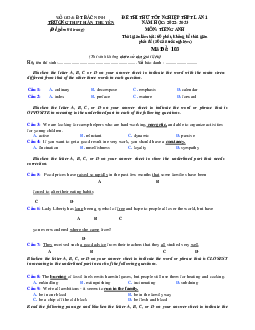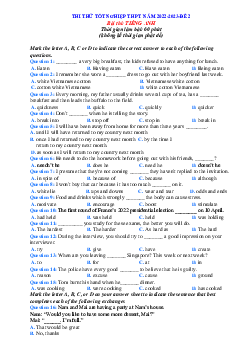
Page 1
SỞ GD & ĐT THÁI NGUYÊN ĐỀ THI THỬ THPT QUỐC GIA LẦN 1
TRƯỜNG THPT CHUYÊN Môn thi: Tiếng Anh
Thời gian làm bài: 60 phút (không kể thời gian phát đề)
Mã đề 519
Họ, tên thí sinh: .............................................. Số báo danh: ..............................................
Read the following passage and mark the letter A, B, C, or D on your answer sheet to indicate the
correct word or phrase that best fits each of the numbered blanks
HOME LIFE
"Parents today want their kids spending time on things that can bring them success, but
(1) , we've stopped doing one thing that's actually been a proven predictor of success-and
that's household chores," says Richard Rende, a (2) psychologist in Paradise Valley,
Ariz, and co-author of forthcoming book “Raising Can-Do Kids." Decades of studies show the
benefits of chores-academically, emotionally and even professionally. Giving children household
chores at an early age (3) to build a lasting sense of mastery, responsibility and self-
reliance, according to research by Marty Rossmann, professor emeritus at the University of
Minnesota. In 2002, Dr. Rossmann analyzed data from a longitudinal study (4) followed 84
children across four periods in their lives-in preschool, around ages 10 and 15, and in their mid-20s.
She found that young adults who began chores at ages 3 and 4 were more likely to have good
relationships with family and friends, to achieve academic and early career success and to be self-
sufficient, as (5) with those who didn't have chores or who started them as teens. Chores
also teach children how to be empathetic and responsive to others' needs, notes psychologist
Richard Weissbourd of the Harvard Graduate School of Education.
(Adapted from http://www.wsj.com/articles/why-children-need-chores)
Question 1. A. ironically
B. especially
C. brutally
D. bitterly
Question 2. A. develop
Question 3. A. help
Question 4. A. whom
Question 5. A. compared
B. developing
B. helps
B. that
B. compare
C. developed
C. helped
C. what
C. comparing
D. developmental
D. has helped
D. when
D. to compare
Mark the letter A, B, C, or D on your answer sheet to indicate the word whose underlined part
differs from the other three in pronunciation in each of the following questions.
Question 6. A. link
B. handkerchief
C. donkey
D. handful
Question 7. A. mineral
B. miniature
C. minor
D. minimum
Mark the letter A, B, C, or D on your answer sheet to indicate the word that differs from the other
three in the position of primary stress in each of the following questions.
Question 8. A. impatient
B. arrogant
C. familiar
D. uncertain
Question 9. A. forgettable
B. philosophy
C. humanism
D. objectively
Mark the letter A, B, C, or D on your answer sheet to indicate the correct answer to each of the
following questions.
Question 10. In most developed countries, up to 50% of population enters
higher education at some time in their lives.
A. the – Ø B. Ø – the C. Ø – Ø D. the-a
Question 11. The launch of the first liquid-fuelled rocket in 1926 by flight historians
as significant as the Wright Brothers' flight.
A. has considered/ to have been B. was considered/ being
C. is considered/ to be D. is considered/ to have been
Question 12. Only three of the students in my class are girls; are all boys.
A. the others B. other student C. others D. the other
Question 13. Although _ , he has been to more than 30 countries in the world and gained a
lot of knowledge.
A. his young age B. young C. his youth D. he was young

Page 2
Question 14. To protect hackers, security experts advise longer passwords
combinations of upper and lowercase letters, as well as numbers.
A. from/to B. on/between C. against/in D. against/with
Question 15. The incredible thing about telephone across the continents, but that you can
recognize the other person's voice.
A. is it provides instant talking to each other.
B. is it allows people to talk instantly
C. is not that people can instantly talk to each other
D. is that people can talk instantly
Question 16. Jack has a collection of .
A. old valuable Japanese postage stamps B. old Japanese valuable postage stamps
C. valuable Japanese old postage stamps D. valuable old Japanese postage stamps
Question 17. There are _ that not only governments but also individuals should join hand to
tackle.
A. such a lot of environmental problems B. too numerous environmental problems
C. so fewer environmental problems D. such many environmental problems
Question 18. To solve this problem, it is advisable .
A. a drastic measure to be adopted B. that a drastic measure be adopted
C. that a drastic measure is adopted D. that a drastic measure to be adopted
Question 19. She for her parents' support during her university education, but she
preferred to work part-time and support herself.
A. must have asked B. could have asked
C. should have asked D. ought to ask
Question 20. After the interview, don't neglect the thank-you note or letter.
A. follow-up B. turn-up C. start-up D. break-up
Question 21. the film's director, Ben Affleck, was famously left off the 85th Oscar's Best
Director list of nominees surprised everyone.
A. What B. Due to C. Although D. That
Question 22. The goal is to make higher education available to everyone who is will and capable
his finacial situation.
A. regardless of B. owing to C. in terms of D. with reference to
Question 23. Timmy dropped the on doing this task again because of his carelessness. I
can't stand him anymore.
A. pin B. needle C. botton D. ball
Read the following passage and mark the letter A, B, C or D on your answer sheet to indicate the
correct answer to each of the questions.
The food we eat seems to have profound effects on our health. Although science has made
enormous steps in making food more fit to eat, it has, at the same time, made many foods unfit to
eat. Some research has shown that perhaps eighty percent of all human illnesses are related to diet
and forty percent of cancer is related to the diet as well, especially cancer of the colon. People of
different cultures are more prone to contact certain illnesses because of the characteristic foods they
consume.
That food is related to illness is not a new discovery. In 1945, government researchers realized
that nitrates nitrites (commonly used to preserve color in meat) as well as other food additives
caused cancer. Yet, these carcinogenic additives remain in our food, and it becomes more difficult
all the time to know which ingredients on the packaging label of processed food are helpful or
harmful.
The additives that we eat are not all so direct. Farmers often give penicillin to cattle and
poultry, and because of this, penicillin has been found in the milk of treated cows.
Sometimes similar drugs are administered to animals not for medical purposes, but for financial
reasons. The farmers are simply trying to fatten the animals in order to obtain a higher price on the

Page 3
market. Although the Food and Drug Administration (FDA) has tried repeatedly to control these
procedures, the practices continue.
A healthy diet is directly related to good health. Often we are unaware of detrimental
substances we ingest. Sometimes well-meaning farmers or others who do not realize the
consequences add these substances to food without our knowledge.
Question 24. How has science done to disservice to people?
A. Because of science, disease caused by contaminated food has been virtually eradicated.
B. The scientists have preserved the color of meats, but not of vegetables .
C. It caused a lack of information concerning the value of food.
D. As a result of scientific intervention, some potentially harmful substances have been added
to our food.
Mark the letter A, B, C, or D on your answer sheet to indicate the underlined part that needs
correction in each of the following questions.
Question 29. When a country in an early stage of development, investments in fixed capital
are vital.
A. a country B. investments C. fixed D. are vital.
Question 30. Bacteria that live in soil and water play a vital role in recycling carbon, nitrogen
sulfur, and another chemical elements used by living things.
A. soil and water B. a vital role C. another D. living things.
Question 31. Genes have several alternative form, or alleles, which are produced by mutations.
A. several alternative B. form C. which D. produced by
Mark the letter A, B, C, or D on your answer sheet to indicate the word(s) OPPOSITE in
meaning to the underlined word(s) in each of the following questions.
Question 32. Urbanization is the shift of people moving from rural to urban areas, and the result is
the growth of cities.
A. movement B. maintenance C. variation D. transposition
Question 33. Salish's point of view was correct but his behavior with his father was quite
impertinent.
A. inadequate B. smooth C. healthy D. respectful
Mark the letter A, B, C, or D on your answer sheet to indicate the word(s) CLOSEST in meaning
to the underlined word(s) in each of the following questions.
Question 34. The expression "out of the frying pan and into the fire" means to go from one
dilemma to a worse one.
A. situation B. solution C. predicament D. embarrassment
Question 35. With so many daily design resources, how do you stay-up-date with technology
without spending too much time on it?

Page 4
A. get latest information B. connect to the Internet all day
C. use social network daily D. update new status
Read the following passage and mark the letter A, B, C, or D on your answer sheet to indicate the
correct answer to each of the questions
Belgium is a very old country, with a fascinating mixture of old customs and modern laws.
Belgium weddings may be performed as a civil ceremony or as a religious ceremony.
Traditionally, when a couple in Belgium wishes to announce their marriage, the wedding invitations
are printed on two sheets of paper, one from the bride's family and one sheet from the groom's
family. These wedding invitations symbolize the union of the two families and the partnership of
the new union.
An ancient Belgium custom that is designed to unite the two families calls for the bride to stop
as she walks up the isle and to hand her mother a single flower. The two then embrace. Then, during
the recessional, the bride and groom walk to the groom's mother and the new bride hands her new
mother-in-law a single flower and the two of them embrace, symbolizing the bride's acceptance of
her new mother.
One of the most important and enduring traditions of the Belgium wedding is for the bride to
carry a specially embroidered handkerchief that has her name embroidered on it. After the wedding
this handkerchief is framed and hung on the wall in a place of honor. When the next female member
of the bride's family is to be wed, the handkerchief is removed from its frame, the new bride's name
is embroidered onto it, and it is passed down. The wedding handkerchief is passed from generation
to generation, and is considered an important family heirloom.
During the wedding mass, the bride and the groom are enthroned in two large chairs placed
near the altar, symbolizing that on this day and in this place they are the king and the queen. At the
conclusion of the ceremony, the groom slips the wedding ring onto the third finger of his bride's left
hand. The ring, being an endless circle, symbolizes never-ending love, and the third finger of the
left hand is believed to hold the vein that travels to the heart, symbolizing love. At the conclusion of
the ceremony, the bride and groom share their first kiss as husband and wife. The kiss is considered
a symbolic act of sharing each other's spirit as the couple each breathes in a portion of their new
mate's soul.
The bridesmaids traditionally take up a collection of coins and as the bride and groom exit the
church, the bridesmaids toss the coins to the poor outside the church. Giving gifts of money to the
poor helps to insure prosperity for the new bride and groom.
Following the wedding the bride and groom are off on their honeymoon. In ancient times the
honeymoon, which was celebrated by the drinking of mead, or honey wine, would last 28 days, one
complete cycle of the moon. This was to make sure that the bride's family did not try to steal their
daughter back from her new husband.
(Adapted from http://www.best-country.com/)
Question 36. Which of the following could be the best title of this passage?
A. Belgium's wedding ceremony
B. Belgium's wedding customs and traditions
C. The bride's and groom's traditional activities in their wedding day
D. The differences between an ancient wedding and a modern one in Belgium
Question 37. What does the word "them" in the third paragraph refer to?
A. the bride and her mother B. the bride and the groom
C. the bride and her mother-in-law D. the groom and his mother-in-law
Question 38. The following is true about Belgium's wedding, EXCEPT .
A. The weddings in Belgium are not only a civil event but also a religious one
B. The wedding invitations are the symbol of both the bride's and the groom's families
C. Each mother of the couple is given a single flower in their children's wedding
D. The bride often hugs her mother-in-law before embracing her mother
Question 39. It can be inferred from the passage that the wedding handkerchief .
A. is prepared for the bride by her mother before the wedding

Page 5
B. is highly appreciated in the home of Belgian people
C. is only replaced by another person in their house
D. is embroidered in most important occasions in Belgium
Question 40. The word "heirloom" in paragraph 4 is closest in meaning to .
A. dowry B. inheritance C. representation D. pride
Question 41. According to paragraph 5, what is CORRECT about the wedding ring?
A. It is wom onto the third finger of the bride's right hand.
B. The groom wears the ring for his mate at the beginning of the ceremony.
C. The ring represents the boundless love of the couple.
D. The ring is presented by the queen and the king of their country.
Question 42. The word "insure" in the paragraph 6 could be best replaced by .
A. determine B. indemnify C. express D. affirm
Question 43. The author mentioned honeymoon in the past in the last paragraph as a period that
A. the bride and the groom live far from each other
B. lasts for a fortnight after wedding
C. protects the new bride from her family's effort to take her back
D. the new couple serves the guests honey wine
Mark the letter A, B, C, or D or your answer sheet to indicate the sentence that is closest in
meaning to each of the following questions.
Question 44. Sometimes having professional assistance with your CV can increase your chance of
finding a job.
A. Having your CV professionally prepared determines whether you'll get the job or not.
B. The prospects for finding employment can possibly be enhanced by a professionally
produced CV.
C. Having a professional help you with your CV is a sure way to find a job.
D. Without a professional CV, it is impossible to find a job.
Question 45. For reasons hygiene, it's forbidden to try on the earrings in the jewellery department.
A. Customers who care for hygiene are advised in the jewellery department not to try on any
earrings.
B. Earrings are considered unhygienic and so forbidden for sale in this jewellery department.
C. Because it is not hygiene, customers in the jewellery department are not allowed to try on
the carrings.
D. Being hygiene in the jewellery department is the decision of the customers and not the
management.
Question 46. "You should have finished the report by now," the boss said to his secretary.
A. The boss scolded his secretary for not finishing the report on time.
B. The boss suggested his secretary should have finished the report on time.
C. The boss reminded his secretary of finishing the report on time.
D. The boss advised his secretary to finish the report on time.
Mark the letter A, B, C, or D on your answer sheet to indicate the sentence that best combines
each pair of sentences in the following questions.
Question 47. She was the first woman in the Philippines. She was elected as the president of the
country.
A. She was the first woman who is elected as the president of the Philippines.
B. She was the first woman elected as the president of the Philippines.
C. She was the first woman being elected as the president of the Philippines.
D. She was the first woman to be elected as the president of the Philippines.
Question 48. We arrived at the conference. Then we realized that our reports were still at home.
A. No sooner had we realized that our reports were at home than we arrived at the conference.
B. Only after we arrived at the conference did we realize that our reports were still at home.
C. Not until we arrived at the conference that we realized that our reports were still at home.

Page 6
D. Hardly had we arrived at the conference that we realized that our reports were still at home.
Mark the letter A, B, C, or D on your answer sheet to indicate the option that best completes each
of the following exchanges.
Question 49. – “Excuse me. Where's the parking lot?” – “ ”
A. You missed the turn. It's back that way.
B. Do you get lost? I do too.
C. You are going the wrong way. It's not here
D. Why do you ask me? I don't know.
Question 50. Hoa is asking Hai, who is sitting at a corner of the room, seeming too shy.
- Hoa: "Why aren't you taking part in our activities? .”
- Hai: "Yes, I can. Certainly."
A. Shall I take your hat off?
B. Can you help me with this decorations?
C. Can I help you?
D. Could you please show me how to get the nearest post office?
--- THE END ---
ĐÁP ÁN
1-A
2-D
3-B
4-B
5-A
6-D
7-C
8-B
9-C
10-B
11-C
12-A
13-D
14-C
15-C
16-D
17-A
18-B
19-B
20-A
21-D
22-A
23-D
24-D
25-D
26-B
27-D
28-A
29-A
30-C
31-B
32-B
33-D
34-C
35-A
36-B
37-C
38-D
39-B
40-B
41-C
42-B
43-C
44-B
45-C
46-A
47-D
48-B
49-A
50-B
Question 1. A
Kiến thức: Từ vựng
Giải thích:
HƯỚNG DẪN GIẢI CHI TIẾT
A. ironically (adv): trớ trêu thay B. especially (adv): đặc biệt
C. brutally (adv): tàn bạo D. bitterly (adv): cay đắng
Parents today want their kids spending time on things that can bring them success, but (1)
ironically, we've stopped doing one thing that's actually been a proven predictor of success-and
that's household chores

Page 7
Tạm dịch: Cha mẹ ngày nay muốn con cái họ dành thời gian cho những thứ có thể mang lại thành
công cho chúng, nhưng trớ trêu thay, chúng ta đã ngừng làm một việc thực sự là một yếu tố dự đoán
của sự thành công và đó là làm việc nhà
Chọn A
Question 2. D
Kiến thức: Từ loại
Giải thích:
A. develop (v): phát triển B. developing (v): phát triển
C. developed (v): phát triển D. developmental (adj): thuộc phát triển
Giữa mạo từ và danh từ cần một tính từ.
…. says Richard Rende, a (2) developmental psychologist in Paradise Valley ….
Tạm dch: Richard Rende - một nhà tâm lý học về sự phát triển Valley, Ariz, nói …
Chọn D
Question 3. B
Kiến thức: Thì hiện tại đơn
Giải thích:
Thì hiện tại đơn diễn tả một hành động chung chung, tổng quát lặp đi lặp lại nhiều lần hoặc một sự
thật hiển nhiên hoặc một hành động diễn ra trong thời gian hiện tại.
Công thức: S + V(s/es)
“Giving children household chores at an early age” (việc cho trẻ làm việc nhà từ khi còn nhỏ) có
chức năng là một cụm danh từ nên động từ của nó chia theo dạng số ít.
Giving children household chores at an early age (3) helps to build a lasting sense of mastery,
responsibility and self-reliance, according to research by Marty Rossmann, professor emeritus at the
University of Minnesota.
Tạm dịch: Theo nghiên cứu của Marty Rossmann, giáo sư danh giá tại Đại học Minnesota, việc
cho trẻ làm việc nhà từ khi còn nhỏ sẽ giúp xây dựng ý thức làm chủ, ý thức trách nhiệm và sự tự
lực lâu dài.
Chọn B
Question 4. B
Kiến thức: Mệnh đề quan hệ
Giải thích:
- whom: thay thế cho danh từ chỉ người; đóng vai trò tân ngữ trong mệnh đề quan hệ
- that: thay thế cho “who, whom, which” trong mệnh đề quan hệ xác định.
- what: nghi vấn từ; đứng sau động từ hoặc giới từ
- when ( = in/ at/ on which): thay thế cho danh từ chỉ thời gian; sau “when” là mệnh đề
a longitudinal study: một nghiên cứu dài hạn => danh từ chỉ vật
In 2002, Dr. Rossmann analyzed data from a longitudinal study (4) that followed 84 children across
four periods in their lives-in preschool, around ages 10 and 15, and in their mid-20s.
Tạm dịch: Năm 2002, Tiến sĩ Rossmann đã phân tích dữ liệu từ một nghiên cứu dài hạn, theo dõi
84 trẻ em qua bốn thời kỳ trong cuộc đời của chúng ở trường mầm non, khoảng 10 và 15 tuổi, và ở
giữa độ tuổi 20.
Chọn B
Question 5. A
Kiến thức: Cụm từ
Giải thích:
as compared with: được so sánh với
She found that young adults who began chores at ages 3 and 4 were more likely to have good
relationships with family and friends, to achieve academic and early career success and to be self-
sufficient, as (5) compared with those who didn't have chores or who started them as teens.
Tạm dịch: Bà phát hiện ra rằng những người trẻ bắt đầu làm việc vặt ở tuổi 3 và 4 có nhiều khả
năng có mối quan hệ tốt với gia đình và bạn bè, để đạt được thành công trong học tập và sự nghiệp

Page 8
sớm và tự lập, so với những người không làm việc vặt hoặc những người bắt đầu làm từ tuổi thanh
thiếu niên.
Chọn A
Dịch bài đọc:
“Cha mẹ ngày nay muốn con cái họ dành thời gian cho những thứ có thể mang lại thành công cho
chúng, nhưng trớ trêu thay, chúng ta đã ngừng làm một việc thực sự là một yếu tố dự đoán của sự
thành công và đó là làm việc nhà,” Richard Rende - một nhà tâm lý học về sự phát triển Valley,
Ariz, nói, và đồng tác giả của cuốn sách sắp ra mắt là “Nuôi dạy những đứa trẻ toàn năng”. Những
thập kỷ nghiên cứu cho thấy những lợi ích của làm việc nhà trong học tập, về mặt cảm xúc và thậm
chí là nghề nghiệp. Theo nghiên cứu của Marty Rossmann, giáo sư danh giá tại Đại học Minnesota,
việc cho trẻ làm việc nhà từ khi còn nhỏ sẽ giúp xây dựng ý thức làm chủ, ý thức trách nhiệm và sự
tự lực lâu dài. Năm 2002, Tiến sĩ Rossmann đã phân tích dữ liệu từ một nghiên cứu dài hạn, theo
dõi 84 trẻ em qua bốn thời kỳ trong cuộc đời của chúng ở trường mầm non, khoảng 10 và 15 tuổi,
và ở giữa độ tuổi 20. Bà phát hiện ra rằng những người trẻ bắt đầu làm việc vặt ở tuổi 3 và 4 có
nhiều khả năng có mối quan hệ tốt với gia đình và bạn bè, để đạt được thành công trong học tập và
sự nghiệp sớm và tự lập, so với những người không làm việc vặt hoặc những người bắt đầu làm từ
tuổi thanh thiếu niên. Làm việc nhà cũng dạy cho trẻ em cách thấu cảm và đáp ứng nhu cầu của
người khác, nhà tâm lý học Richard Weissbourd của Trường Đại học Sư phạm Harvard cho hay.
Question 6. D
Kiến thức: Cách phát âm “-n”
Giải thích:
link /lɪŋk/ handkerchief /ˈhæŋkətʃɪf/
donkey /ˈdɒŋki/ handful /ˈhændfʊl/
Phần gạch chân của đáp án D được phát âm là /n/, còn lại phát âm là /ŋ/.
Chọn D
Question 7. C
Kiến thức: Cách phát âm “-i”
Giải thích:
mineral /ˈmɪnərəl/ miniature /ˈmɪnətʃə(r)/
minor /ˈmaɪnə(r)/ minimum /ˈmɪnɪməm/
Phần gạch chân của đáp án C được phát âm là /aɪ/, còn lại phát âm là /ɪ/.
Chọn C
Question 8. B
Kiến thức: Trọng âm từ có 3 âm tiết
Giải thích:
impatient /ɪmˈpeɪʃnt/ arrogant /ˈærəɡənt/
familiar /fəˈmɪliə(r)/ uncertain /ʌnˈsɜːtn/
Câu B có trọng âm rơi vào âm tiết thứ 1, còn lại rơi vào âm tiết thứ 2.
Chọn B
Question 9. C
Kiến thức: Trọng âm từ có 4 âm tiết
Giải thích:
forgettable /fəˈɡetəbl/ philosophy /fəˈlɒsəfi/
humanism /ˈhjuːmənɪzəm/ objectively /əbˈdʒektɪvli/
Câu C có trọng âm rơi vào âm tiết thứ 1, còn lại rơi vào âm tiết thứ 2.
Chọn C
Question 10. B
Kiến thức: Mạo từ
Giải thích:
Most + N = Most of + the + N: hầu hết trong số …
“population” (dân số) là danh từ đã xác định vì câu này nói đến dân số ở các nước đã phát triển.
=> the population

Page 9
Tạm dịch: Ở hầu hết các nước phát triển, 50% dân số được hưởng nền giáo dục tiên tiến tại một
thời điểm nhất định nào sso trong cuộc đời của họ.
Chọn B
Question 11. C
Kiến thức: Câu bị động
Giải thích:
Công thức câu bị động thì hiện tại đơn diễn tả sự thật đúng: S + am/ is/ are + Ved/ V3
be considered sth to be ….: được coi cái gì là …
Tạm dịch: Việc phóng tên lửa nhiên liệu lỏng đầu tiên vào năm 1926 được các nhà sử học về máy
bay coi là quan trọng như chuyến bay của anh em nhà Wright.
Chọn C
Question 12. A
Kiến thức: Cách dùng “the others, other, others, the other”
Giải thích:
the other: một (cái) còn lại cuối cùng, được sử dụng như tính từ, theo sau là danh từ số ít.
other + danh từ số nhiều: vài(cái) khác
others = other + danh từ số nhiều: những thứ khác nữa, được sử dụng như đại từ giữ chức năng chủ
ngữ trong câu, theo sau là động từ.
- the others: những (cái) khác còn lại cuối cùng, được sử dụng như đại từ giữ chức năng chủ ngữ
trong câu,theo sau là động từ.
Tạm dịch: Chỉ có 3 học sinh trong lớp tôi là nữ, những người còn lại đều là nam.
Chọn A
Question 16. D
Kiến thức: Trật tự tính từ
Giải thích:
1. Opinion and general description (Ý kiến hoặc miêu tả chung) Ví dụ: nice, awesome, lovely
2. Dimension / Size / Weight (Kích cỡ, cân nặng)Ví dụ: big, small, heavy
3. Age (Tuổi, niên kỷ)Ví dụ: old, new, young, ancient .
4. Shape (Hình dạng) Ví dụ: round, square, oval .
5. Color (Màu sắc)Ví dụ: green, red, blue, black
6. Country of origin (Xuất xứ) Ví dụ: Swiss, Italian, English.
7. Material (Chất liệu) Ví dụ: woolly, cotton, plastic .
8. Purpose and power (Công dụng) Ví dụ: walking (socks), tennis (racquet), electric (iron)
valuable: quý giá (opinion) => old: cũ (age) => Japanese: thuộc về Nhật Bản (origin)
Tạm dịch: John có bộ sưu tập tem bưu chính cũ có giá trị của Nhật Bản.

Page 10
Chọn D

Page 11
Question 17. A
Kiến thức: Mệnh đề chỉ kết quả
Giải thích:
Cấu trúc: S + V + such + (a/an) + adj + noun + that + S + V
such + a lot of
so + many
Tạm dịch: Có rất nhiều vấn đề môi trường đến mức không chỉ các chính phủ mà cả các cá nhân
cũng nên tham gia giải quyết
Chọn A
Question 18. B
Kiến thức: Thức giả định
Giải thích: Công thức: It + be + advisable + that + S + động từ nguyên thể
Tạm dịch: Để giải quyết vấn đề này, nên áp dụng một biện pháp quyết liệt.
Chọn B
Question 19. B
Kiến thức: Động từ khuyết thiếu
Giải thích:
must have + pp: (hẳn là đã) chỉ sự suy đoán logic dựa trên những hiện tượng có thật ở quá khứ.
could have + past participle: thừa khả năng để làm việc gì đó nhưng không làm
should have + past participle: (lẽ ra phải, lẽ ra nên) chỉ một việc lẽ ra đã phải xảy ra trong quá khứ
nhưng vì lý do nào đó lại không xảy ra.
ought to + V: nên làm gì
Tạm dịch: Cô ấy đã có thể xin trợ giúp của bố mẹ để học đại học, nhưng cô ấy đã chọn việc làm
bán thời gian và tự cung cấp cho bản thân.
Chọn B
Question 20. A
Kiến thức: Cụm từ
Giải thích: follow-up letter : lá thư theo dõi (theo dõi tin tức từ công ty xem có được nhận không)
Tạm dịch: Sau cuộc phỏng vấn, đừng quên một bài cám ơn hay một lá thư theo dõi.
Chọn A
Question 21. D
Kiến thức: Mệnh đề danh từ
Giải thích:
"That + mệnh đề" có thể làm chủ ngữ trong câu; chỉ cả một sự việc gây ra điều gì.
That the film's director, Ben Affleck, was famously left off the 85th Oscar's Best Director list of
nominees => đóng vai trò chủ ngữ
surprised => động từ chính trong câu
Tạm dịch: Việc đạo diễn phim nổi tiếng Ben Aflleck bị loại ra khỏi danh sách ứng viên cho giải
Oscar lần thứ 85 ở hạng mục đạo diễn xuất sắc nhất đã làm mọi người ngạc nhiên.
Chọn D
Question 22. A
Kiến thức: Liên từ
Giải thích:
A. regardless of: không kể, bất chấp B. owing to: bởi vì
C. in terms of: về mặt D. with reference to: liên quan tới
Tạm dịch: Mục tiêu là đưa giáo dục bậc cao cho tất cả những ai muốn và có khả năng, bất kể khả
năng tài chính của họ.
Chọn A
Question 23. D
Kiến thức: Thành ngữ
Giải thích: drop the ball on sth = to make a mistake, especially by doing something in a stupid or
careless way. (mắc sai lầm ngớ ngẩn)

Page 12
Tạm dịch: Tim lại mắc một sai lầm ngớ ngẩn vì sự bất cẩn của anh ấy. Tôi không thể chịu đựng
anh ấy thêm nữa.
Chọn D
Question 24. D
Kiến thức: Đọc hiểu
Giải thích:
Khoa học đã làm gì để gây bất lợi cho con người?
A. Vì khoa học, bệnh gây ra bởi thực phẩm bị ô nhiễm đã hầu như bị loại bỏ.
B. Các nhà khoa học đã bảo quản màu sắc của thịt, nhưng không phải là rau.
C. Nó gây ra sự thiếu thông tin liên quan đến giá trị của thực phẩm.
D. Do sự can thiệp của khoa học, một số chất có khả năng gây hại đã được thêm vào thực phẩm của
chúng ta
Thông tin: Although science has made enormous steps in making food more fit to eat, it has, at the
same time, made many foods unfit to eat. Some research has shown that perhaps eighty percent of
all human illnesses are related to diet and forty percent of cancer is related to the diet as well,
especially cancer of the colon. People of different cultures are more prone to contact certain
illnesses because of the characteristic foods they consume.
Tạm dịch: Dù các nhà khoa học đã thực hiện những bước tiến ngoạn ngục trong việc tạo ra thực
phẩm có thể ăn được hơn, vẫn còn có, cùng lúc ấy những thực phẩm không ăn được. Một số nghiên
cứu đã chỉ ra rằng 80% các bệnh ở người có liên quan đến khẩu phần ăn và 40% các bệnh ung thư
có liên quan đến khẩu phần ăn, đặc biệt là ung thư ruột kết. Những người ở các nền văn hóa khác
nhau dễ mắc phải các bệnh nhất định vì đặc trưng thực phẩm mà họ tiêu dùng.
Chọn D
Question 25. D
Kiến thức: Đọc hiểu
Giải thích:
Từ “prone” (nghiêng, thiên về) có nghĩa gần nhất với .
A. supine (adj): nằm ngửa B. unlikely (adj): không chắc
C. healthy (adj): khỏe mạnh D. predisposed (adj): thiên về
=> prone = predisposed
Chọn D
Question 26. B
Kiến thức: Đọc hiểu
Giải thích:
Tất cả các tuyên bố sau là đúng ngoại trừ _.
A. Thực phẩm có thể gây ra bốn mươi phần trăm bệnh ung thư trên thế giới
B. Thuốc luôn được dùng cho động vật vì lý do y tế
C. Các nhà nghiên cứu đã biết về mối nguy tiềm ẩn của phụ gia thực phẩm trong hơn 45 năm
D. Một số chất phụ gia trong thực phẩm của chúng ta được thêm vào thực phẩm và một số được
cung cấp cho động vật sống
Thông tin: Sometimes similar drugs are administered to animals not for medical purposes, but for
financial reasons.
Tạm dịch: Đôi khi các loại thuốc tương tự được dùng cho động vật không phải vì mục đích y tế,
mà vì lý do tài chính.
Chọn B
Question 27. D
Kiến thức: Đọc hiểu
Giải thích:
Từ "phụ gia" có nghĩa gần nhất với .
A. chất nguy hiểm B. chất tự nhiên
C. bắt đầu chất D. chất thêm vào
=> additives = added substance

Page 13
Chọn D
Question 28. A
Kiến thức: Đọc hiểu
Giải thích:
Tiêu đề hay nhất cho đoạn văn này là gì?
A. Thực phẩm bạn ăn có thể ảnh hưởng đến sức khỏe của bạn
B. Các chất có hại và vô hại trong thực phẩm
C. Tránh các chất gây hại trong thực phẩm
D. Cải thiện sức khỏe thông qua chế độ ăn uống tự nhiên
Chọn A
Dịch bài đọc:
Thực phẩm chúng ta ăn dường như có ảnh hưởng sâu sắc đến sức khỏe của chúng ta. Mặc dù khoa
học đã có những bước tiến lớn trong việc làm cho thực phẩm phù hợp hơn để ăn, nhưng đồng thời,
nó đã làm cho nhiều loại thực phẩm không thể ăn được. Một số nghiên cứu đã chỉ ra rằng có lẽ tám
mươi phần trăm tất cả các bệnh của con người có liên quan đến chế độ ăn uống và bốn mươi phần
trăm ung thư cũng liên quan đến chế độ ăn uống, đặc biệt là ung thư ruột kết. Những người thuộc
các nền văn hóa khác nhau dễ tiếp xúc với một số bệnh nhất định vì các loại thực phẩm đặc trưng
mà họ tiêu thụ.
Thực phẩm đó có liên quan đến bệnh tật không phải là một khám phá mới. Năm 1945, các nhà
nghiên cứu của chính phủ nhận ra rằng nitrat nitrit (thường được sử dụng để bảo quản màu trong
thịt) cũng như các chất phụ gia thực phẩm khác gây ung thư. Tuy nhiên, các chất phụ gia gây ung
thư này vẫn còn trong thực phẩm của chúng ta và việc trở nên khó khăn hơn trong việc biết thành
phần nào trên nhãn bao bì của thực phẩm chế biến là hữu ích hay có hại.
Các chất phụ gia mà chúng ta ăn không phải là tất cả trực tiếp. Nông dân thường cung cấp penicillin
cho gia súc và gia cầm và vì điều này, penicillin đã được tìm thấy trong sữa của những con bò được
điều trị.
Đôi khi các loại thuốc tương tự được dùng cho động vật không phải vì mục đích y tế, mà vì lý do tài
chính. Nông dân chỉ đơn giản là cố gắng vỗ béo các con vật để có được giá cao hơn trên thị trường.
Mặc dù Cục Quản lý Thực phẩm và Dược phẩm Hoa Kỳ (FDA) đã cố gắng nhiều lần để kiểm soát
các quy trình này, các thực hành vẫn tiếp tục.
Một chế độ ăn uống lành mạnh có liên quan trực tiếp đến sức khỏe tốt. Thông thường chúng ta
không nhận thức được các chất bất lợi mà chúng ta ăn vào. Đôi khi nông dân có ý nghĩa tốt hoặc
những người khác không nhận ra hậu quả sẽ thêm các chất này vào thực phẩm mà chúng ta không
biết.
Question 29. A
Kiến thức: Cấu tạo thành phần câu
Giải thích:
Cấu tạo thành phần câu:
When S + V, S + V
Sửa: country in => country is in
Tạm dịch: Khi một quốc gia trong giai đoạn đầu phát triển, đầu tư vào vốn cố định là quan trọng.
Chọn A
Question 30. C
Kiến thức: Cách dùng “another, other”
Giải thích:
another + danh từ số ít : thêm 1 ... nữa/tương tự/khác
other + danh từ số nhiều: những... khác
Sửa: another => other
Tạm dịch: Vi khuẩn sống trong đất và nước đóng vai trò quan trọng trong việc tái chế carbon, lưu
huỳnh nitơ và các nguyên tố hóa học khác được sử dụng bởi các sinh vật sống.
Chọn C
Question 31. B

Page 14
Kiến thức: Danh từ số nhiều
Giải thích:
several (một vài) + danh từ số nhiều
Sửa: form => forms
Tạm dịch: Các gen có một số dạng thay thế, hoặc alen, được tạo ra bởi các đột biến.
Chọn B
Question 32. B
Kiến thức: Từ trái nghĩa
Giải thích:
shift (n): sự dịch chuyển
A. movement (n): sự chuyển động B. maintenance (n): sự duy trì
C. variation (n): sự biến đổi D. transposition (n): sự đổi chỗ
=> shift >< maintenance
Tạm dịch: Đô thị hóa là sự dịch chuyển của người dân chuyển từ nông thôn sang thành thị, và kết
quả là sự tăng trưởng của các thành phố.
Chọn B
Question 33. D
Kiến thức: Từ trái nghĩa
Giải thích:
impertiment (adj): xấc xược
A. inadequate (adj): không đầy đủ B. smooth (adj): mịn
C. healthy (adj): khỏe mạnh D. respectful (adj): kính trọng
=> impertiment >< respectful
Tạm dịch: Quan điểm của Salish là đúng nhưng cách cư xử của anh ta với cha anh ta khá xấc xược.
Chọn D
Question 34. C
Kiến thức: Từ đồng nghĩa
Giải thích:
dilemma (n): tình huống khó xử
A. situation (n): tình huống B. solution (n): giải pháp
C. predicament (n): tình huống khó khăn D. embarrassment (n): sự ngượng ngùng
=> dilemma = predicament
Tạm dịch: Thành ngữ "tránh vỏ dưa gặp vỏ dừa" có nghĩa là đi từ một tình huống khó xử đến một
vấn đề tồi tệ hơn.
Chọn C
Question 35. A
Kiến thức: Từ đồng nghĩa
Giải thích:
stay-up-date: cập nhật
A. get latest information: tiếp nhận thông tin mới nhất
B. connect to the Internet all day: kết nối mạng cả ngày
C. use social network daily: dùng mạng xã hội hàng ngày
D. update new status: cập nhật trạng thái mới
=> stay-up-date = get latest information
Tạm dịch: Với rất nhiều tài nguyên thiết kế hàng ngày, làm thế nào để bạn cập nhật công nghệ mà
không mất quá nhiều thời gian cho nó?
Chọn A
Question 36. B
Kiến thức: Đọc hiểu
Giải thích:
Điều nào sau đây có thể là tiêu đề tốt nhất của đoạn văn này?
A. Lễ cưới của Bỉ

Page 15
B. Phong tục và truyền thống đám cưới của Bỉ
C. Các hoạt động truyền thống của cô dâu và chú rể trong ngày cưới của họ
D. Sự khác biệt giữa một đám cưới cổ xưa và hiện đại ở Bỉ
Chọn B
Question 37. C
Kiến thức: Đọc hiểu
Giải thích:
Từ “them” trong đoạn 3 liên quan đến gì?
A. cô dâu và mẹ cô B. cô dâu và chú rể
C. cô dâu và mẹ chồng D. chú rể và mẹ vợ
Thông tin: Then, during the recessional, the bride and groom walk to the groom's mother and the
new bride hands her new mother-inlaw a single flower and the two of them embrace, symbolizing
the bride's acceptance of her new mother.
Tạm dịch: Hai người ôm nhau. Sau đó, trong buổi lễ giới thiệu, cô dâu và chú rể đi bộ đến mẹ của
chú rể và cô dâu mới trao cho mẹ chồng mới của mình một bông hoa duy nhất và hai người họ ôm
nhau, tượng trưng cho sự chấp nhận của cô dâu với mẹ mới.
Chọn C
Question 38. D
Kiến thức: Đọc hiểu
Giải thích:
Sau đây là sự thật về đám cưới của Bỉ, NGOẠI TRỪ .
A. Các đám cưới ở Bỉ không chỉ là một sự kiện dân sự mà còn là một sự kiện tôn giáo
B. Lời mời đám cưới là biểu tượng của cả gia đình cô dâu và chú rể
C. Mỗi người mẹ của cặp vợ chồng được tặng một bông hoa duy nhất trong đám cưới của con cái
họ
D. Cô dâu thường ôm mẹ chồng trước khi ôm mẹ
Thông tin: An ancient Belgium custom that is designed to unite the two families calls for the bride
to stop as she walks up the isle and to hand her mother a single flower. The two then embrace.
Then, during the recessional, the bride and groom walk to the groom's mother and the new bride
hands her new mother-in-law a single flower and the two of them embrace
Tạm dịch: Một phong tục cổ xưa của Bỉ được thiết kế để đoàn kết hai gia đình kêu gọi cô dâu dừng
lại khi cô đi lên cù lao và trao cho mẹ cô một bông hoa duy nhất. Hai người ôm nhau. Sau đó, trong
buổi lễ giới thiệu, cô dâu và chú rể đi bộ đến mẹ của chú rể và cô dâu mới trao cho mẹ chồng mới
của mình một bông hoa duy nhất và hai người họ ôm nhau,
Chọn D
Question 39. B
Kiến thức: Đọc hiểu
Giải thích:
Có thể được suy ra từ đoạn văn rằng khăn tay lễ cưới .
A. được chuẩn bị cho cô dâu bởi mẹ của cô ấy trước lễ cưới
B. được đánh giá rất cao tại nhà của những người Bỉ
C. chỉ được thay thế bởi người khác trong ngôi nhà của họ
D. được thêu trong những dịp quan trọng của người Bỉ
Thông tin: After the wedding this handkerchief is framed and hung on the wall in a place of honor.
Tạm dịch: Sau đám cưới, chiếc khăn tay này được đóng khung và treo trên tường ở một nơi danh
dự.
Chọn B
Question 40. B
Kiến thức: Đọc hiểu
Giải thích:
Từ "gia truyền" trong đoạn 4 có nghĩa gần nhất với .
A. của hồi môn B. thừa kế C. đại diện D. niềm tự hào

Page 16
=> heirloom = inheritance
Chọn B
Question 41. C
Kiến thức: Đọc hiểu
Giải thích:
Theo đoạn 5, câu nào ĐÚNG về nhẫn cưới?
A. Nó nằm trên ngón tay thứ ba của bàn tay phải của cô dâu.
B. Chú rể đeo nhẫn cho người bạn đời của mình vào đầu buổi lễ.
C. Chiếc nhẫn tượng trưng cho tình yêu vô bờ bến của cặp đôi.
D. Chiếc nhẫn được trình bày bởi nữ hoàng và nhà vua của đất nước họ.
Thông tin: The ring, being an endless circle, symbolizes never-ending love, and the third finger of
the left hand is believed to hold the vein that travels to the heart, symbolizing love.
Tạm dịch: Chiếc nhẫn, là một vòng tròn vô tận, tượng trưng cho tình yêu không bao giờ kết thúc,
và ngón thứ ba của bàn tay trái được cho là giữ tĩnh mạch đi đến trái tim, tượng trưng cho tình yêu.
Chọn C
Question 42. B
Kiến thức: Đọc hiểu
Giải thích:
Từ "insure" (bảo đảm) trong đoạn 6 có thể được thay bằng .
A. determine (v): xác định B. indemnify (v): bảo đảm
C. express (v): thể hiện D. affirm (v): khẳng định
=> insure = indemnify
Chọn B
Question 43. C
Kiến thức: Đọc hiểu
Giải thích:
Tác giả đã đề cập đến tuần trăng mật trong quá khứ ở đoạn cuối như một khoảng thời gian mà
A. cô dâu và chú rể sống xa nhau.
B. kéo dài trong một hai tuần sau đám cưới.
C. bảo vệ cô dâu mới khỏi nỗ lực của gia đình để đưa cô ấy trở lại.
D. cặp vợ chồng mới phục vụ khách rượu mật ong.
Thông tin: This was to make sure that the bride's family did not try to steal their daughter back
from her new husband.
Tạm dịch: Điều này là để đảm bảo rằng gia đình cô dâu đã không cố gắng đánh cắp con gái của họ
từ người chồng mới.
Chọn C
Dịch bài đọc:
Bỉ là một đất nước rất lâu đời, với sự pha trộn hấp dẫn của phong tục cũ và luật pháp hiện đại. Đám
cưới của Bỉ có thể được thực hiện như một nghi lễ dân sự hoặc như một nghi lễ tôn giáo.
Theo truyền thống, khi một cặp vợ chồng ở Bỉ muốn tuyên bố kết hôn, lời mời đám cưới được in
trên hai tờ giấy, một từ gia đình cô dâu và một tờ từ gia đình chú rể. Những lời mời đám cưới này
tượng trưng cho sự hợp nhất của hai gia đình và sự hợp tác của công đoàn mới.
Một phong tục cổ xưa của Bỉ được thiết kế để đoàn kết hai gia đình kêu gọi cô dâu dừng lại khi cô
đi lên cù lao và trao cho mẹ cô một bông hoa duy nhất. Hai người ôm nhau. Sau đó, trong buổi lễ
giới thiệu, cô dâu và chú rể đi bộ đến mẹ của chú rể và cô dâu mới trao cho mẹ chồng mới của mình
một bông hoa duy nhất và hai người họ ôm nhau, tượng trưng cho sự chấp nhận của cô dâu với mẹ
mới.
Một trong những truyền thống quan trọng và lâu dài nhất của đám cưới Bỉ là cô dâu mang theo một
chiếc khăn tay thêu đặc biệt có tên của cô được thêu trên đó. Sau đám cưới, chiếc khăn tay này
được đóng khung và treo trên tường ở một nơi danh dự. Khi thành viên nữ tiếp theo của gia đình cô
dâu được kết hôn, chiếc khăn tay được lấy ra khỏi khung của nó, tên cô dâu mới được thêu lên nó,

Page 17
và nó được truyền lại. Khăn tay đám cưới được truyền từ thế hệ này sang thế hệ khác, và được coi
là một gia tài quan trọng của gia đình.
Trong đám cưới, cô dâu và chú rể được đặt trên hai chiếc ghế lớn đặt gần bàn thờ, tượng trưng cho
ngày này và ở nơi này, họ là nhà vua và hoàng hậu. Kết thúc buổi lễ, chú rể đeo chiếc nhẫn cưới
vào ngón áp út tay trái của cô dâu. Chiếc nhẫn, là một vòng tròn vô tận, tượng trưng cho tình yêu
không bao giờ kết thúc, và ngón thứ ba của bàn tay trái được cho là giữ tĩnh mạch đi đến trái tim,
tượng trưng cho tình yêu. Kết thúc buổi lễ, cô dâu và chú rể chia sẻ nụ hôn đầu tiên của họ là vợ
chồng. Nụ hôn được coi là một hành động tượng trưng để chia sẻ tinh thần của nhau khi mỗi cặp
đôi hít vào một phần linh hồn của người bạn đời mới.
Theo truyền thống, các phù dâu thường lấy một bộ sưu tập tiền và khi cô dâu chú rể rời khỏi nhà
thờ, các phù dâu ném đồng xu cho người nghèo bên ngoài nhà thờ. Tặng quà bằng tiền cho người
nghèo giúp đảm bảo sự thịnh vượng cho cô dâu và chú rể mới.
Sau đám cưới, cô dâu và chú rể được nghỉ tuần trăng mật. Vào thời cổ đại, tuần trăng mật, được tổ
chức bằng việc uống rượu cỏ hay rượu mật ong, sẽ kéo dài 28 ngày, một chu kỳ hoàn chỉnh của mặt
trăng. Điều này là để đảm bảo rằng gia đình cô dâu đã không cố gắng đánh cắp con gái của họ từ
người chồng mới.
Question 44. B
Kiến thức: Câu đồng nghĩa
Giải thích:
Đôi khi có sự trợ giúp chuyên nghiệp với CV của bạn có thể tăng cơ hội tìm việc làm.
A. Chuẩn bị CV của bạn một cách chuyên nghiệp sẽ quyết định bạn có nhận được công việc hay
không.
B. Triển vọng tìm kiếm việc làm có thể có thể được tăng cường bằng một CV được tạo ra một cách
chuyên nghiệp.
C. Có một chuyên gia giúp bạn với CV của bạn là một cách chắc chắn để tìm việc.
D. Không có CV chuyên nghiệp, không thể tìm được việc làm.
Câu A, C, D không phù hợp về nghĩa.
Chọn B
Question 45. C
Kiến thức: Câu đồng nghĩa
Giải thích:
Vì lý do vệ sinh, không được phép thử đôi bông tai trong bộ trang sức.
A. Khách hàng chăm sóc vệ sinh được khuyến cáo trong bộ trang sức không nên thử bất kỳ bông tai
nào.
B. Hoa tai được coi là mất vệ sinh và vì vậy bị cấm bán trong bộ trang sức này.
C. Vì không đảm bảo vệ sinh, khách hàng trong bộ phận trang sức không được phép thử dây đeo.
D. Giữ vệ sinh trong bộ phận trang sức là quyết định của khách hàng chứ không phải quản lý.
Câu A, B, D không phù hợp về nghĩa.
Chọn C
Question 46. A
Kiến thức: Câu tường thuật
Giải thích:
"Cô nên hoàn thành báo cáo ngay bây giờ," ông chủ nói với thư ký của mình.
A. Ông chủ mắng thư ký của mình vì không hoàn thành báo cáo đúng hạn.
B. Ông chủ đề nghị thư ký của mình nên hoàn thành báo cáo đúng hạn.
C. Sếp nhắc nhở thư ký của mình hoàn thành báo cáo đúng hạn.
D. Sếp khuyên thư ký của mình hoàn thành báo cáo đúng hạn.
Câu B, C, D không phù hợp về nghĩa.
Chọn A
Question 47. D
Kiến thức: Mệnh đề quan hệ rút gọn
Giải thích:

Page 18
Câu đầy đủ: She was the first woman in the Philippines that was elected as the president of the
country.
Câu rút gọn: She was the first woman in the Philippines to be elected as the president of the
country.
Khi trước danh từ có số thứ tự (the first/ second/...), so sánh nhất => mệnh đề quan hệ có thể rút gọn
bằng “to V”.
Tạm dịch: Bà là người phụ nữ đầu tiên được bầu làm tổng thống Philippines.
Chọn D
Question 48. D
Kiến thức: Cấu trúc đảo ngữ
Giải thích:
Cấu trúc: Hardly/Barely/Scarcely + had + S + PP/V3 + when/before + S + Ved/ V2
Ex: Hardly had I arrived home when/before the phone rang.
Only after + S + V + trợ động từ + S + động từ chính: Chỉ sau khi... thì...
Tạm dịch: Chúng tôi đến hội nghị. Chúng tôi phát hiện ra báo cáo vẫn ở nhà.
= Chỉ sau khi đến hội nghị chúng tôi mới phát hiện ra báo cáo vẫn ở nhà.
Chọn B
Question 49. A
Kiến thức: Ngôn ngữ giao tiếp
Giải thích:
"Xin lỗi. Bãi đậu xe ở đâu?” – “ ”
A. Bạn vượt qua đoạn rẽ rồi. Quay lại lối đó. B. Bạn có bị lạc không? Tôi cũng vậy.
C. Bạn đang đi sai đường. Nó không ở đây. D. Tại sao bạn hỏi tôi? Tôi không biết.
Câu B, C, D không phù hợp với ngữ cảnh.
Chọn A
Question 50. B
Kiến thức: Ngôn ngữ giao tiếp
Giải thích:
Hoa đang hỏi Hải, người đang ngồi ở một góc phòng, có vẻ quá ngại ngùng.
- Hoa: "Tại sao bạn không tham gia vào các hoạt động của chúng tôi?
- Hải: "Vâng, tôi có thể. Chắc chắn."
A. Tôi có nên ngả mũ không?
B. Bạn có thể giúp tôi với những đồ trang trí này?
C. Tôi có thể giúp gì cho bạn?
D. Bạn có thể vui lòng chỉ cho tôi làm thế nào để có được bưu điện gần nhất?
Câu A, C, D không phù hợp với ngữ cảnh.
Chọn B
.?”

Page 19
SỞ GD & ĐT HẢI PHÒNG ĐỀ THI THỬ THPT QUỐC GIA NĂM 2019 – LẦN 2
THPT NGÔ QUYỀN Môn thi: Tiếng Anh
Thời gian làm bài: 60 phút (không kể thời gian phát đề)
Họ, tên thí sinh: .............................................. Số báo danh: ..............................................
Mã đề thi: 214
Mark the letter A, B, C or D on your answer sheet to indicate the sentence that best combines each pair
of sentences in the following questions.
Question 1: The burglar might come back. You’d better change all the locks.
A. If you don’t change all the locks, the burglar could come back.
B. The burglar will come back unless you change all the locks.
C. You’d better change all the locks or the burglar will come back.
D. You’d better change all the locks in case the burglar will come back.
Question 2: My personal opinion doesn’t really matter. You need to decide for the good of everyone.
A. Though my personal opinion really matters, we need to decide for the good for everyone.
B. Deciding for the good of everyone makes our personal opinion not really matter at all.
C. We need to decide for the good for everyone, so my personal opinion doesn’t really matter.
D. If my personal opinion doesn’t really matter, we need to decide for the good of everyone.
Mark the letter A, B, C or D on your answer sheet to indicate the word that differs from the other three
in the position of primary stress in each of the following questions.
Question 3: A. analyst
B. interview
C. technician
D. fabulous
Question 4: A. participate
B. medieval
C. development
D. contributor
Read the following passage and mark the letter A, B, C or D on your answer sheet to indicate the
correct word or phrase that best fits each of the numbered blanks.
Culture has a strong influence on non-verbal communication. Even the simple act of looking
someone in the eye is not at all that simple. In the USA, Americans are (5) to look directly at
people when speaking to them. It shows interest in what they are saying and is thought to carry a (6)
of honesty. Meanwhile, in Japan and Korea, people avoid long periods of eye contact. It is
considered more polite to look to the side during a conversation. The Lebanese, (7) , stand close
together and look intensely into each other's eyes. The action shows sincerity and gives people a better
sense of what their counterparts want. Given such differences with even the most common expressions,
people (8) travel or work abroad have a real need to learn the other culture's body language.
People tend to be unaware of the messages they are sending to others. So, it is (9) to consider
your own body language before dealing with people from other cultures. Knowing about the body
language of friends, clients, and colleagues can be very helpful in improving understanding and avoiding
miscommunication.
Question 5: A. encouraged
B. assisted
C. forbidden
D. opposed
Question 6: A. sense
B. taste
C. sound
D. touch
Question 7: A. therefore
B. in addition
C. in contrast
D. moreover
Question 8: A. who
B. where
C. which
D. whose
Question 9: A. usefulness
B. useful
C. useless
D. used
Mark the letter A, B, C or D on your answer sheet to indicate the sentence that is closest in meaning to
each of the following questions.
Question 10: A drug may affect several functions, even though it’s targeted at only one.

Page 20
A. A drug is taken for a specific purpose, but it may have a range of other effects.
B. However effective a drug may be, its functions have to be several.
C. Despite various other uses, a drug usually has a function for a special effect.
D. The functions expected of a drug are various even if it is used for a specific disease.
Question 11: Most of the river ferries have been cancelled today due to the lack of visibility caused by
the fog.
A. A few of the ferries need to be rescheduled because of the fog that is causing poor visibility on the
river.
B. Since today’s fog is obstructing visibility, the majority of the river ferries will not be running.
C. Because of the fog, it will be difficult for most of the ferries to cross the river safely today.
D. Whenever visibility is poor owing to the fog, nearly all of the river ferries are cancelled during the
day.
Question 12: Wouldn’t it better to let them know about the alterations to the plan?
A. Don’t you think they should be informed about the changes in the plan?
B. Shouldn’t they have been consulted before the scheme was changed?
C. Why haven’t they been informed about the new development?
D. We’d better ask them to change the plan, hadn’t we?
Mark the letter A, B, C or D on your answer sheet to indicate the word(s) that is CLOSET in meaning
to the underlined word(s) in each of the following questions.
Question 13: Being a single mother no longer carries the social stigma that is used to.
A. difficulty B. holiness C. stain D. trial
Question 14: The members of the orchestra have arrived an hour prior to the performance for a short
rehearsal.
A. when B. before C. after D. while
Read the passage and mark the letter A, B, C or D on your answer sheet to indicate the correct answer
to each of the following questions.
Dark matter in the universe is believed by some scientists to be a substance that is not readily
observable because it does not directly refract light or energy. Its existence can only be deduced because
of the effect that it has on surrounding matter. In fact, some members of the scientific community have
argued that dark matter does not actually exist. Others, however, believe in its existence, in part because
the scientific community does not have a complete understanding of gravita science. On the other hand,
some would argue that it is the understanding of gravitational science that leads most scientists to believe
in the existence of dark matter, because without dark matter, there are many cosmological phenomena
that are difficult to explain.
For example, dark matter in the universe may have a peculiar effect on the Milky Way galaxy. Some
scientists believe that the interaction between dark matter and other smaller, nearby galaxies is causing
the Milky Way galaxy to take on a warped profile. It has been asserted that not only does dark matter
exist, it may also be responsible for the Milky Way’s unusual shape. The interaction referenced involves
two smaller galaxies near the Milky Way, called Magellanic clouds, moving through an enormous
amount of dark matter, which, in effect, enhances the gravitational pull that the two Magellanic clouds
could have on the Milky Way and other surrounding bodies. Without the existence of the dark matter, the
Magellanic clouds would not have sufficient mass to have such a strong effect on the bend of the Milky
Way galaxy.
The strongest evidence for the validity of this hypothesis rests in Newtonian physics, and the
hypothesis that anything with mass will exert a gravitational pull. The Milky Way and other galaxies with

Page 21
peculiar warped shapes are being molded by a gravitational force. However, there is nothing readily

Page 22
observable with sufficient mass that could cause such a high level of distortion via gravitational pull in
the vicinity of the Milky Way. Therefore, something that is not easily observed must be exerting the
necessary force to create the warped shape of the galaxy.
Aaron Romanowsky and several colleagues have questioned the effect that dark matter might have
on galaxies. They point to the existence of several elliptical galaxies surrounded by very little dark matter
as evidence that dark matter is not, in fact, the cause of the warped galaxies. While they do not claim that
their findings should be interpreted to conclude that dark matter does not exist, they apparently believe
that the results of their studies cast doubt on some of the conventional theories of galaxy formation and
manipulation.
Several models constructed by researchers from the University of California at Berkeley, however,
point to the idea that dark matter is the most likely explanation for the distorted shape of the Milky Way
and other galaxies. Using computer models, they have mapped the likely interactions between certain
galaxies and the surrounding dark matter, and those models have shown not only the possibility that dark
matter is responsible for the warped shape of the Milky Way, but that the relationship between the dark
matter and the Magellanic clouds is dynamic; the movement of the clouds through the dark matter seems
to create a wake that enhances their gravitational influence on the Milky Way.
Question 15: The passage states that some members of the scientific community are reluctant to believe
in the existence of dark matter because:
A. no one understands how to apply gravitational science.
B. dark matter has little effect on surrounding matter.
C. dark matter cannot be directly observed.
D. there is absolutely no evidence for the existence of dark matter.
Question 16: As it is used in paragraph 1, the term phenomena most nearly means:
A. surprises. B. problems. C. occurrences. D. attitudes.
Question 17: What does the passage offer as evidence for the existence of dark matter?
A. A photograph taken with the aid of a refracting telescope.
B. The enormous mass of Magellanic clouds.
C. The shape of the Milky Way galaxy.
D. A complete understanding of gravitational science.
Question 18: According to the passage, what is Aaron Romanowsky’s theory regarding dark matter?
A. Dark matter has not effect at all on the shape of a galaxy.
B. It cannot be conclusively proven that dark matter affects the shape and formation of galaxies.
C. Computer models suggest that dark matter is responsible for warped galaxies.
D. The discovery of certain galaxies disproves the theory that dark matter exists in the universe.
Question 19: The last paragraph supports the general hypothesis provided earlier in the passage that:
A. computer models are necessary for an understanding of gravitational science.
B. dark matter has little to no effect on the formation of certain cosmological phenomena.
C. the effect of Magellanic clouds on galaxies is enhanced by dark matter.
D. the shape of the Milky Way galaxy can be deduced by observing the matter surrounding it.
Question 20: The word conventional paragraph 4 most nearly means:
A. formally disputed. B. strictly interpreted.
C. easily understood. D. generally accepted.
Question 21: The word “they” in paragraph 5 refers to:
A. models B. researchers C. interactions D. galaxies
Question 22: The passage supports which of the following statements about dark matter?

Page 23
A. Its presence is readily observable to researchers who completely understand how to apply
gravitational science.
B. If it does not exist, the universe is largely empty.
C. Its existence is inferred by some researchers based on observations of cosmological bodies
composed of ordinary matter.
D. Its existence has been conclusively proven by computer models.
Mark the letter A, B, C or D on your answer sheet to indicate the correct answer to each of the
following questions.
Question 23: The escaping prisoner camped in _ woods but he didn’t light fire because
smoke rising from the wood might attract attention.
A. the/a/-/- B. a/the/the/- C. the/a/-/the D. a/a/-/-
Question 24: “Why is your street such a mess?” – “Oh, the council up the road, but they should
Question 29: Although David was after a day’s work in the office, he tried to help his wife the
household chores.
A. exhausting B. exhausted C. exhaust D. exhaustive
Question 30: The goal is to make higher education available to everyone who is willing and capable
his financial situation.
A. with reference to B. regardless of C. in terms of D. owing to
Question 31: proficiency in German would be of much help, it is not a requirement for the
advertised position.
A. Although B. Regarding C. Otherwise D. Despite
Question 32: The curriculum at the public school is as good of any private school.
A. as or better than that B. as or better than those
C. as or better that D. or better than
Question 33: Anne was not to think that the best was too difficult.
A. among the people B. who C. the one who D. the only one
Question 34: My uncle was ill last month; however, fortunately, he is now making a slow but
steady recovery.
A. seriously B. critically C. deeply D. fatally

Page 24
Question 35: The fussy child ate only a few of noodles.

Page 25
A. slices B. bars C. pieces D. strands
Question 36: True friends always stand by you when you’re .
A. home and dry B. high and low C. on and off D. down and out
Mark the letter A, B, C or D on your answer sheet to indicate the most suitable response to
complete each of the following exchanges.
Question 37: “I apologize for keeping you waiting for 2 hours. My car broke down on the way”
– “ ”
A. Your apology is accepted. B. It’s my pleasure.
C. Thank you. D. You are welcome.
Question 38: Peter: “How are you today?” – Susan: “ ”
A. I feel like a million stars. B. I feel like a million dollars.
C. I can feel it in my bone. D. I feel your ears burning.
Mark the letter A, B, C or D on your answer sheet to indicate the underlined part that needs
correction in each of the following questions.
Question 39: A severe illness when she was just nineteen months old deprived the well-known writer
and lecturer Helen Keller from both her sight and hearing.
A. just B. deprived C. when D. from both
Question 40: He didn’t know who it was and couldn’t imagine why they did it, but there must have
been somebody that started the rumor which he was from London and very wealthy.
A. which B. who C. why D. that
Question 41: It is believed that in the near future robots will be used to doing things such as cooking.
A. such as B. in the near future
C. It is believed D. be used to doing
Mark the letter A, B, C or D on your answer sheet to indicate the word(s) OPPOSITE in meaning
to the underlined word(s) in each of the following questions.
Question 42: Earthworms help to aerate the soil.
A. suffocate B. destroy C. argue D. adjust
Question 43: He was imprisoned because he revealed secrets to the enemies.
A. disowned B. declared C. betrayed D. concealed
Mark the letter A, B, C or D on your answer sheet to indicate the word whose underlined part
differs from other three in pronunciation in each of the following questions.
Question 44: A. control
B. ecology
C. contour
D. combine
Question 45: A. though
B. breath
C. arithmetic
D. threaten
Reading the following passage and mark the letter A, B, C or D on you answer sheet to indicate
the correct word for each of the blanks.
The growth of cities, the construction of hundreds of new factories, and the spread of railroads in the
United States before 1850 had increased the need for better illumination. But the lighting in American
homes had improved very little over that of ancient times. Through the colonial period, homes were lit
with tallow candles or with a lamp of the kind used in ancient Rome – a dish of fish oil or other animal
or vegetable oil in which a twisted rag served as a wick. Some people used lard, but they had to
heat charcoal underneath to keep it soft and burnable. The sperm whale provided superior burning oil,
but this was expensive. In 1830 a new substance called “camphene” was patented, and it proved to be an
excellent illuminant. But while camphene gave a bright light it too remained expensive, had an
unpleasant odor, and also was dangerously explosive.
Between 1830 and 1850, it seemed that the only hope for cheaper illumination in the United

Page 26
States was the wider use of gas. In the 1840s, American gas manufacturers adopted improved British
techniques for producing illuminating gas from coal. But the expense of piping gas to the consumer
remained so high that until the mid-nineteenth century gas lighting was feasible only in urban areas,
and only for public buildings for the wealthy. In 1854, a Canadian doctor, Abraham Gesner, patented a
process for distilling a pitch like mineral found in New Brunswick and Nova Scotia that produced
illuminating gas and an oil that he called “kerosene” (from “keros”, the Greek word for wax, and
“ene” because it resembled camphene). Kerosene, though cheaper than camphene, had an unpleasant
odor, and Gesner never made his fortune from it. But Gesner had aroused a new hope for making
illuminating oil from a product coming out of North American mines.
Question 46: Which of the following is NOT mentioned as a reason why better lighting had become
necessary by the mid-nineteenth century?
A. increases in the number of new factories B. growth of cities
C. development of railroads D. demand for better medical facilities
Question 47: The word “this” in paragraph 1 refers to .
A. oil B. charcoal C. lard D. wick
Question 48: What can be inferred about the illuminating gas described in the passage?
A. It had an unpleasant smell.
B. It was not allowed to be used in public buildings.
C. It was not widely available until mid-nineteenth century.
D. It was first developed in the United States.
Question 49: The word “resembled” in paragraph 2 is closest in meaning to .
A. cost the same as B. was made from C. sounded like D. was similar to
Question 50: Which of the following best describes the organization of the passage?
A. a description of events in chronological order
B. a comparison of two years
C. an analysis of scientific findings
D. the statement of a theory and possible explanations
----------- THE END ----------

Page 27
ĐÁP ÁN
1-D
2-C
3-C
4-B
5-A
6-A
7-C
8-A
9-B
10-A
11-B
12-A
13-C
14-B
15-C
16-C
17-C
18-B
19-C
20-D
21-B
22-C
23-A
24-D
25-B
26-A
27-D
28-A
29-B
30-B
31-A
32-A
33-D
34-A
35-D
36-D
37-A
38-B
39-D
40-A
41-D
42-A
43-D
44-C
45-A
46-D
47-A
48-C
49-D
50-A
HƯỚNG DẪN GIẢI CHI TIẾT
Question 1. D
Kiến thức: Liên từ
Giải thích:
had better + Vo: nên làm gì
in case + S + V: phòng khi
or/ or else: nếu không thì
Câu A dùng sai cấu trúc câu điều kiện loại 1: If + S + V(s,es), S + will + Vo
Tạm dịch: Bạn nên thay tất cả các ổ khóa phòng khi tên trộm quay trở lại.
B. Kẻ trộm sẽ quay trở lại trừ khi bạn thay tất cả các ổ khóa.
C. Bạn nên thay tất cả các ổ khóa nếu không tên trộm sẽ quay trở lại.
D. Bạn nên thay tất cả các ổ khóa phòng trường hợp tên trộm sẽ quay trở lại.
Câu B, C không phù hợp về nghĩa.
Chọn D
Question 2. C
Kiến thức: Mệnh đề nguyên nhân – hệ quả
Giải thích:

Page 28
Though + S + V, clause: Mặc dù
So + S + V: vì vậy
Câu D dùng sai cấu trúc câu điều kiện loại 1: If + S + V(s,es), S + will + Vo
Tạm dịch: Ý kiến cá nhân của tôi không thực sự quan trọng. Bạn cần quyết định vì lợi ích của mọi người.
A. Mặc dù ý kiến cá nhân của tôi thực sự quan trọng, chúng ta cần quyết định vì lợi ích của mọi người.
B. Quyết định vì lợi ích của mọi người làm cho ý kiến cá nhân của chúng tôi không thực sự quan trọng.
C. Chúng ta cần quyết định vì lợi ích của mọi người, vì vậy ý kiến cá nhân tôi không thực sự quan trọng.
Chọn C
to be encouraged: được khuyến khích to be assisted: được hỗ trợ
to be forbidden: bị cấm to be opposed: bị phản đối
In the USA, Americans are (5) encouraged to look directly at people when speaking to them.
Tạm dịch: Ở Mỹ, người Mỹ được khuyến khích nhìn thẳng vào mọi người khi nói chuyện với họ.
Chọn A
Question 6. A
Kiến thức: Từ vựng
Giải thích:
sense (n): giác quan/ ý thức/ cảm giác taste (n): sự nếm thức ăn/ vị/ khẩu vị/
sound (n): âm thanh touch (n): sự đụng chạm/ xúc giác
sense of honesty: cảm giác trung thực
It shows interest in what they are saying and is thought to carry a (6) sense of honesty.
Tạm dịch: Nó cho thấy sự quan tâm đến những gì họ đang nói và được cho là mang lại một cảm giác
trung thực.
Chọn A
Question 7. C
Kiến thức: Liên từ
Giải thích:
therefore: do đó, vì vậy
in addition = moreover: hơn nữa, ngoài ra
in contrast: ngược lại
The Lebanese, (7) in contrast, stand close together and look intensely into each other's eyes.
Tạm dịch: Ngược lại, người Lebanon đứng sát nhau và nhìn sâu vào mắt nhau.
Chọn C
Question 8. A
Kiến thức: Đại từ quan hệ
Giải thích:
who: thay thế cho người, đóng vai trò chủ ngữ trong mệnh đề quan hệ: … N(person) + who + V + …
where: thay thế cho trạng từ chỉ nơi chốn
which: thay thế cho vật, đóng vai trò chủ ngữ/ tân ngữ trong mệnh đề quan hệ
whose: thay thế cho tính từ sở hữu, sở hữu cách
Ở đây, trước từ cần điền là danh từ chỉ người “people”, sau từ cần điền là một động từ “travel” => chọn
“who”.
Given such differences with even the most common expressions, people (8) who travel or work abroad
have a real need to learn the other culture's body language.

Page 29
Tạm dịch: Do sự khác biệt như vậy với ngay cả những biểu hiện phổ biến nhất, những người đi du lịch
hoặc làm việc ở nước ngoài có nhu cầu thực sự học ngôn ngữ cơ thể của nền văn hóa khác.
Chọn A
Question 9. B
Kiến thức: Từ vựng
Giải thích:
usefulness (n): sự hữu ích useful (adj): có ích
useless (adj): vô dụng used (adj): đã qua sử dụng/ trở nên quen thuộc
So, it is (9) useful to consider your own body language before dealing with people from other cultures.
Tạm dịch: Vì vậy, rất hữu ích để xem xét ngôn ngữ cơ thể của riêng bạn trước khi tiếp xúc với những
người từ các nền văn hóa khác.
Chọn B
Dịch bài đọc:
Văn hóa có ảnh hưởng mạnh mẽ đến giao tiếp phi ngôn ngữ. Ngay cả hành động đơn giản là nhìn vào
mắt ai đó cũng không đơn giản. Ở Mỹ, người Mỹ được khuyến khích nhìn thẳng vào mọi người khi nói
chuyện với họ. Điều đó cho thấy sự quan tâm đến những gì họ đang nói và được cho là mang một cảm
giác trung thực. Trong khi đó, tại Nhật Bản và Hàn Quốc, mọi người tránh tiếp xúc bằng mắt trong thời
gian dài. Sẽ lịch sự hơn khi nhìn sang một bên trong một cuộc trò chuyện. Ngược lại, người Lebanon
đứng sát nhau tác của họ muốn. Do sự khác biệt như vậy với ngay cả những biểu hiện phổ biến nhất,
những người đi du lịch hoặc làm việc ở nước ngoài có nhu cầu thực sự học ngôn ngữ cơ thể của nền văn
hóa khác. Mọi người có xu hướng không biết về những thông điệp mà họ đang gửi cho người khác. Vì
vậy, rất hữu ích để xem xét ngôn ngữ cơ thể của riêng bạn trước khi tiếp xúc với những người từ các nền
văn hóa khác. Hiểu về ngôn ngữ cơ thể của bạn bè, khách hàng và đồng nghiệp có thể rất hữu ích trong
việc cải thiện sự hiểu biết và tránh được những sự nhầm lẫn trong giao tiếp.
Question 10. A
Kiến thức: Mệnh đề nhượng bộ
Giải thích:
even though/ even if + S + V = Despite + N/V.ing: mặc dù
but + S + V: nhưng
However + adj + S + V: Mặc dù
Tạm dịch: Một loại thuốc có thể ảnh hưởng đến một vài chức năng, mặc dù nó chỉ nhắm vào một loại.
A. Một loại thuốc được sử dụng cho một mục đích cụ thể, nhưng nó có thể có một loạt các tác dụng khác.
B. Dù một loại thuốc có hiệu quả như thế nào, các chức năng của nó phải thật nhiều.
C. Mặc dù có nhiều công dụng khác nhau, một loại thuốc thường có chức năng cho tác dụng đặc biệt.
D. Các chức năng dự kiến của một loại thuốc rất phong phú mặc dù nó được sử dụng cho một loại bệnh
cụ thể.
Câu B, C, D không phù hợp về nghĩa.
Chọn A
Question 11. B
Kiến thức: Mệnh đề nguyên nhân – kết quả
Giải thích:
due to + N/V.ing = because of + N/V.ing: bởi vì
Since + S + V= because + S + V: bởi vì
most of + N = the majority + N: phần lớn, hầu hết
Tạm dịch: Hầu hết các chuyến phà sông đã bị hủy bỏ ngày hôm nay do thiếu tầm nhìn gây ra bởi sương

Page 30
mù.
A. Một vài chuyến phà cần phải được lên lịch lại vì sương mù gây ra tầm nhìn kém trên sông.
B. Do sương mù cản trở tầm nhìn, phần lớn các chuyến phà sông sẽ không chạy.
C. Do sương mù, khó để hầu hết các chuyến phà qua sông an toàn hôm nay.
D. Bất cứ khi nào tầm nhìn kém do sương mù, gần như tất cả các chuyến phà sông đều bị hủy bỏ trong
ngày.
Câu A, C, D không phù hợp về nghĩa.
Chọn B
Question 12. A
Kiến thức: Từ vựng
Giải thích: inform = let somebody know something (v): thông báo, cho ai biết cái gì
Tạm dịch: Có tốt hơn không nếu để cho họ biết về những thay đổi trong kế hoạch?
A. Bạn có nghĩ họ nên được thông báo về những thay đổi trong kế hoạch không?
B. Họ không nên được tư vấn trước khi kế hoạch thay đổi đúng không?
C. Tại sao họ lại không được thông báo về sự phát triển mới?
D. Chúng ta nên yêu cầu họ thay đổi kế hoạch đúng không?
Câu B, C, D không phù hợp về nghĩa.
Chọn A
Question 13. C
Kiến thức: Từ đồng nghĩa
Giải thích:
stigma (n): sự kỳ thị, vết nhơ
difficulty (n): sự khó khăn holiness (n): sự thiêng liêng
stain (n): vết nhơ, sự sỉ nhục trial (n): sự thử thách, sự thử nghiệm
=> stigma = stain
Tạm dịch: Làm mẹ đơn thân không còn bị xã hội coi là một sự sỉ nhục như trước đây.
Chọn C
Question 14. B
Kiến thức: Từ đồng nghĩa
Giải thích:
prior to = before something: trước when: khi
after: sau khi while: trong khi
Tạm dịch: Các thành viên của dàn nhạc đã đến một giờ trước buổi biểu diễn cho một buổi tập ngắn.
Chọn B
Question 15. C
Kiến thức: Đọc hiểu
Giải thích:
Đoạn văn nói rằng một số thành viên của cộng đồng khoa học không muốn tin vào sự tồn tại của vật chất
tối vì:
A. không ai hiểu làm thế nào để áp dụng khoa học hấp dẫn.
B. vật chất tối ít ảnh hưởng đến vật chất xung quanh.
C. vật chất tối không thể được quan sát trực tiếp.
D. hoàn toàn không có bằng chứng cho sự tồn tại của vật chất tối.
Thông tin: Dark matter in the universe is believed by some scientists to be a substance that is not readily
observable because it does not directly refract light or energy. Its existence can only be deduced because

Page 31
of the effect that it has on surrounding matter. In fact, some members of the scientific community have
argued that dark matter does not actually exist.
Tạm dịch: Vật chất tối trong vũ trụ được một số nhà khoa học tin là một chất không dễ quan sát vì nó
không trực tiếp khúc xạ ánh sáng hay năng lượng. Sự tồn tại của nó chỉ có thể được suy luận vì ảnh
hưởng của nó đối với vật chất xung quanh. Trên thực tế, một số thành viên của cộng đồng khoa học đã
lập luận rằng vật chất tối không thực sự tồn tại.
Chọn C
Question 16. C
Kiến thức: Từ vựng
Giải thích:
phenomenon (pl. phenomena) = a fact or an event in nature or society: một hiện tượng trong tự nhiên
hoặc xã hội
surprise = an event, a piece of news, etc. that is unexpected or that happens suddenly (n): sự bất ngờ
problem = a thing that is difficult to deal with or to understand (n): vấn đề
occurrence = something that happens or exists (n): hiện tượng
attitude = the way that you think and feel about somebody/something (n): thái độ
=> phenomena = occurrence
Chọn C
Question 17. C
Kiến thức: Đọc hiểu
Giải thích:
Đoạn văn đưa ra điều gì làm bằng chứng cho sự tồn tại của vật chất tối?
A. Một bức ảnh được chụp với sự trợ giúp của kính viễn vọng khúc xạ.
B. Khối lượng khổng lồ của các đám mây Magellanic.
C. Hình dạng của Dải Ngân hà.
D. Sự hiểu biết đầy đủ về khoa học hấp dẫn.
Thông tin: For example, dark matter in the universe may have a peculiar effect on the Milky Way
galaxy. Some scientists believe that the interaction between dark matter and other smaller, nearby
galaxies is causing the Milky Way galaxy to take on a warped profile. It has been asserted that not only
does dark matter exist, it may also be responsible for the Milky Way’s unusual shape.
Tạm dịch: Ví dụ, vật chất tối trong vũ trụ có thể có ảnh hưởng đặc biệt đến Dải Ngân hà. Một số nhà
khoa học tin rằng sự tương tác giữa vật chất tối với các thiên hà nhỏ hơn, gần đó đang khiến Dải Ngân hà
có đường nét bị cong vênh. Nó đã được khẳng định rằng không chỉ vật chất tối tồn tại, nó còn có thể
chịu trách nhiệm cho hình dạng khác thường của Dải Ngân hà.
Chọn C
Question 18. B
Kiến thức: Đọc hiểu
Giải thích:
Theo đoạn văn, lý thuyết của Aaron Romanowsky có liên quan gì đến vật chất tối?
A. Vật chất tối hoàn toàn không ảnh hưởng đến hình dạng của một thiên hà.
B. Không thể chứng minh một cách thuyết phục rằng vật chất tối ảnh hưởng đến hình dạng và sự hình
thành của các thiên hà.
C. Các mô hình máy tính cho thấy vật chất tối chịu trách nhiệm cho việc các thiên hà bị cong vênh.
D. Việc phát hiện ra một số thiên hà nhất định bác bỏ giả thuyết rằng vật chất tối tồn tại trong vũ trụ.
Thông tin: Aaron Romanowsky and several colleagues have questioned the effect that dark matter might

Page 32
have on galaxies. They point to the existence of several elliptical galaxies surrounded by very little
dark matter as evidence that dark matter is not, in fact, the cause of the warped galaxies.
Tạm dịch: Aaron Romanowsky và một số đồng nghiệp đã đặt câu hỏi về ảnh hưởng của vật chất tối đối
với các thiên hà. Họ chỉ ra sự tồn tại của một số thiên hà hình elip được bao quanh bởi rất ít vật chất
tối như bằng chứng cho việc vật chất tối thực tế không phải là nguyên nhân làm các thiên hà bị
cong vênh.
Chọn B
Question 19. C
Kiến thức: Đọc hiểu
Giải thích:
Đoạn cuối ủng hộ giả thuyết chung được đề cập trước đó trong đoạn văn rằng:
A. các mô hình máy tính là cần thiết cho sự hiểu biết về khoa học hấp dẫn.
B. vật chất tối có ít hoặc không ảnh hưởng đến sự hình thành các hiện tượng vũ trụ nhất định.
C. ảnh hưởng của các đám mây Magellanic lên các thiên hà được tăng cường bởi vật chất tối.
D. hình dạng của Dải Ngân hà có thể được suy luận bằng cách quan sát vật chất xung quanh nó.
Thông tin: Using computer models, they have mapped the likely interactions between certain galaxies
and the surrounding dark matter, and those models have shown not only the possibility that dark matter is
responsible for the warped shape of the Milky Way, but that the relationship between the dark matter and
the Magellanic clouds is dynamic; the movement of the clouds through the dark matter seems to
create a wake that enhances their gravitational influence on the Milky Way.
Tạm dịch: Sử dụng các mô hình máy tính, họ đã lập bản đồ các khả năng tương tác giữa các thiên hà
nhất định và vật chất tối xung quanh và những mô hình đó không chỉ cho thấy khả năng vật chất tối chịu
trách nhiệm cho hình dạng của Dải Ngân hà, mà còn là mối quan hệ giữa vật chất tối và các đám mây
Magellanic là năng động; sự chuyển động của các đám mây qua vật chất tối dường như tạo ra một sự
lực đẩy giúp tăng cường ảnh hưởng lực hấp dẫn của chúng trên Dải Ngân hà.
Chọn C
Question 20. D
Kiến thức: Đọc hiểu, từ vựng
Giải thích:
conventional (adj): theo tập quán; thông thường
formally disputed: tranh chấp chính thức strictly interpreted: diễn giải chặt chẽ
easily understood: dễ hiểu generally accepted: thường được chấp nhận
=> conventional = generally accepted
Chọn D
Question 21. B
Kiến thức: Đọc hiểu
Giải thích:

Page 33
Từ “they” ở đoạn thứ 5 đề cập đến .
A. các mô hình B. các nhà nghiên cứu
C. các tương tác D. các thiên hà
Thông tin: Several models constructed by researchers from the University of California at Berkeley,
however, point to the idea that dark matter is the most likely explanation for the distorted shape of the
Milky Way and other galaxies. Using computer models, they have mapped the likely interactions
between certain galaxies and the surrounding dark matter, and those models have shown not only the
possibility that dark matter is responsible for the warped shape of the Milky Way
Tạm dịch: Tuy nhiên, một số mô hình được xây dựng bởi các nhà nghiên cứu từ Đại học California tại
Berkeley, chỉ ra ý tưởng rằng vật chất tối là lời giải thích khả dĩ nhất cho hình dạng méo mó của Dải
Ngân hà và các thiên hà khác. Sử dụng các mô hình máy tính, họ đã lập bản đồ các khả năng tương tác
giữa các thiên hà nhất định và vật chất tối xung quanh chúng
Chọn B
Question 22. C
Kiến thức: Đọc hiểu
Giải thích:
Đoạn văn ủng hộ phát biểu nào sau đây về vật chất tối?
A. Sự hiện diện của nó có thể quan sát được một cách dễ dàng đối với các nhà nghiên cứu hoàn toàn hiểu
cách áp dụng khoa học hấp dẫn.
B. Nếu nó không tồn tại, phần lớn vũ trụ trống rỗng.
C. Sự tồn tại của nó được suy luận bởi một số nhà nghiên cứu dựa trên các quan sát về các cơ thể vũ trụ
được cấu thành từ vật chất thông thường.
D. Sự tồn tại của nó đã được chứng minh một cách thuyết phục bởi các mô hình máy tính.
Thông tin: Using computer models, they have mapped the likely interactions between certain
galaxies and the surrounding dark matter, and those models have shown not only the possibility that
dark matter is responsible for the warped shape of the Milky Way, but that the relationship between the
dark matter and the Magellanic clouds is dynamic;
Tạm dịch: Sử dụng các mô hình máy tính, họ đã lập bản đồ các khả năng tương tác giữa các thiên
hà nhất định và vật chất tối xung quanh và những mô hình đó không chỉ cho thấy khả năng vật chất tối
chịu trách nhiệm cho hình dạng của Dải Ngân hà, mà còn là mối quan hệ giữa vật chất tối và các đám
mây Magellanic là năng động;
Có thể thấy các nhà nghiên cứu suy luận về sự tồn tại của vật chất tối bằng cách quan sát các đám mây
Magellanic, Dải Ngân hà và các thiên hà khác.
Chọn C
Dịch bài đọc:
Vật chất tối trong vũ trụ được một số nhà khoa học tin là một chất không dễ quan sát vì nó không
trực tiếp khúc xạ ánh sáng hay năng lượng. Sự tồn tại của nó chỉ có thể được suy luận vì ảnh hưởng của
nó đối với vật chất xung quanh. Trên thực tế, một số thành viên của cộng đồng khoa học đã lập luận rằng
vật chất tối không thực sự tồn tại. Tuy nhiên, những người khác tin vào sự tồn tại của nó, một phần vì
cộng đồng khoa học không có sự hiểu biết đầy đủ về khoa học hấp dẫn. Mặt khác, một số người sẽ lập
luận rằng chính sự hiểu biết về khoa học hấp dẫn khiến hầu hết các nhà khoa học tin vào sự tồn tại của vật
chất tối, bởi vì không có vật chất tối, có rất nhiều hiện tượng vũ trụ rất khó giải thích.
Ví dụ, vật chất tối trong vũ trụ có thể có ảnh hưởng đặc biệt đến Dải Ngân hà. Một số nhà khoa học
tin rằng sự tương tác giữa vật chất tối với các thiên hà nhỏ hơn, gần đó đang khiến Dải Ngân hà có đường
nét bị cong vênh. Nó đã được khẳng định rằng không chỉ vật chất tối tồn tại, nó còn có thể chịu trách

Page 34
nhiệm cho hình dạng khác thường của Dải Ngân hà. Sự tương tác được tham chiếu này liên quan đến hai
thiên hà nhỏ hơn gần Dải Ngân hà, được gọi là các đám mây Magellanic, di chuyển qua một lượng lớn
vật chất tối, thực chất là tăng cường lực hấp dẫn mà hai đám mây Magellanic có thể có trên Dải Ngân hà
và các vật thể xung quanh khác. Nếu không có sự tồn tại của vật chất tối, các đám mây Magellanic sẽ
không có đủ khối lượng để có tác động mạnh mẽ như vậy đối với sự uốn cong của Dải Ngân hà.
Bằng chứng mạnh mẽ nhất cho giá trị của giả thuyết này nằm trong vật lý Newton và giả thuyết rằng bất
cứ thứ gì có khối lượng sẽ tạo ra lực hấp dẫn. Dải Ngân hà và các thiên hà khác với hình dạng cong vênh
kỳ lạ đang được tạo hình bởi một lực hấp dẫn. Tuy nhiên, không có gì có thể quan sát dễ dàng với khối
lượng đủ lớn có thể gây ra mức độ biến dạng cao như vậy thông qua lực hấp dẫn ở vùng lân cận Dải Ngân
hà. Do đó, thứ gì đó không dễ được quan sát chắc hẳn đang phát huy được lực cần thiết để tạo ra hình
dạng cong vênh của thiên hà.
Aaron Romanowsky và một số đồng nghiệp đã đặt câu hỏi về ảnh hưởng của vật chất tối đối với các
thiên hà. Họ chỉ ra sự tồn tại của một số thiên hà hình elip được bao quanh bởi rất ít vật chất tối như bằng
chứng cho việc vật chất tối thực tế không phải là nguyên nhân làm các thiên hà bị cong vênh. Mặc dù họ
không cho rằng những phát hiện của mình nên được giải thích để kết luận rằng vật chất tối không tồn tại,
nhưng rõ ràng họ tin rằng kết quả nghiên cứu của họ khiến người ta nghi ngờ về một số lý thuyết thông
thường về sự hình thành và điều chỉnh thiên hà.
Tuy nhiên, một số mô hình được xây dựng bởi các nhà nghiên cứu từ Đại học California tại Berkeley,
chỉ ra ý tưởng rằng vật chất tối là lời giải thích khả dĩ nhất cho hình dạng méo mó của Dải Ngân hà và các
thiên hà khác. Sử dụng các mô hình máy tính, họ đã lập bản đồ các khả năng tương tác giữa các thiên hà
nhất định và vật chất tối xung quanh chúng và những mô hình đó không chỉ cho thấy khả năng vật chất
tối chịu trách nhiệm cho hình dạng của Dải Ngân hà, mà còn là mối quan hệ giữa vật chất tối và các đám
mây Magellanic là năng động; sự chuyển động của các đám mây qua vật chất tối dường như tạo ra một sự
lực đẩy giúp tăng cường ảnh hưởng lực hấp dẫn của chúng trên Dải Ngân hà.
Question 23. A
Kiến thức: Mạo từ
Giải thích:
- Danh từ “woods” được dùng ở dạng số nhiều, dựa vào 4 đáp án chỉ có thể dùng mạo từ “the”.
the woods: khu rừng (Trong ngữ cảnh này, danh từ này đã xác định.)
- Danh từ “fire” được dùng ở dạng số ít, chưa xác định nên dùng mạo từ “a”.
- Danh từ “smoke” và “attraction” là danh từ không đếm được, chưa xác định nên không dùng mạo từ.
Tạm dịch: Người tù vượt ngục cắm trại trong rừng nhưng anh ta không thắp lửa vì khói bốc lên từ gỗ có
thể thu hút sự chú ý.
Chọn A
Question 24. D
Kiến thức: Thì hiện tại hoàn thành tiếp diễn
Giải thích:
Thì hiện tại hoàn thành tiếp diễn diễn tả hành động bắt đầu ở quá khứ và còn đang tiếp tục ở hiện tại
(nhấn mạnh tính liên tục).
Dấu hiệu: “Tại sao đường phố nhà bạn trông như một mớ hỗn độn vậy?”
“but they should finish this weekend?” => “nhưng có phải họ nên hoàn thành vào tuần này?”
Dựa vào ngữ cảnh, đây phải là hành động đã bắt đầu ở quá khứ và vẫn còn đang tiếp tục ở hiện tại.
Cấu trúc: S + have/has + been + V.ing
Tạm dịch: “Tại sao đường phố nhà bạn trông như một mớ hỗn độn vậy?” – “À, hội đồng đang đào
đường, nhưng có phải họ nên hoàn thành vào tuần này?”

Page 35
Chọn D
Question 25. B
Kiến thức: Cấu trúc “model verb + have + V.p.p”
Giải thích:
Không dùng “mayn’t”.
can’t have V.p.p: phỏng đoán hành động chắc chắn không thể xảy ra trong quá khứ shouldn’t have V.p.p:
không nên làm nhưng đã làm
needn’t have V.p.p: không cần phải làm nhưng đã làm
Tạm dịch: Anh ấy chắc chắn chưa tưới cây. Nếu anh ấy có tưới, chúng đã không bị khô héo.
Chọn B
Question 26. A
Kiến thức: Cụm động từ
Giải thích:
look up: tra cứu/ trở nên tốt hơn, cải thiện turn up: xuất hiện/ xảy ra
clear up: dọn dẹp make up: bịa đặt
Tạm dịch: Tôi vừa được mời làm một công việc mới. Mọi thứ đang trở nên tốt hơn.
Chọn A
Question 27. D
Kiến thức: Mệnh đề danh từ
Giải thích:
Trong câu đã có động từ chính là “will be informed”, do đó cần một chủ ngữ. Mệnh đề danh từ có thể
đóng vai trò như một chủ ngữ trong câu.
Cấu trúc: (Where/ when/ why/ what/ that/ those…+ S + V) + V/to be.
Tạm dịch: Những người được chọn cho một cuộc phỏng vấn thứ hai sẽ được thông báo qua thư.
Chọn D
Question 28. A
Kiến thức: Từ vựng
Giải thích: independent (of somebody/something) (adj): độc lập
Tạm dịch: Tôi tin rằng các thẩm phán nên độc lập với chính phủ.
Chọn A
Question 29. B
Kiến thức: Từ vựng, từ loại
Giải thích:
Sau “to be” cần một tính từ.
Phân biệt tính từ có đuôi “ing” và tính từ có đuôi “ed”:
- Tính từ có đuôi “ed” nói về việc ai đó có cảm giác như thế nào.
- Tính từ có đuôi “ing” nói về đặc điểm, bản chất của người/vật.
exhausting = making you feel very tired (adj): làm kiệt sức
exhausted = very tired (adj): kiệt sức
exhaust (v): làm kiệt sức
exhaustive = including everything possible (adj): toàn diện
Tạm dịch: Mặc dù David đã kiệt sức sau một ngày làm việc tại văn phòng, anh ấy đã cố gắng giúp vợ
làm việc nhà.
Chọn B
Question 30. B

Page 36
Kiến thức: Từ vựng
Giải thích:
with reference to: về regardless of: bất chấp, bất kể
in terms of: về mặt owing to: bởi vì
Tạm dịch: Mục tiêu là làm cho giáo dục đại học có sẵn cho tất cả những người sẵn sàng và có khả năng
bất kể tình hình tài chính của người đó.
Chọn B
Question 31. A
Kiến thức: Liên từ
Giải thích:
Although + S + V = Despite + N/V.ing: Mặc dù
Regarding: Về
Otherwise: Nếu không thì
Tạm dịch: Mặc dù thành thạo tiếng Đức sẽ giúp ích rất nhiều, nhưng đó không phải là một yêu cầu cho
vị trí được quảng cáo.
Chọn A
Question 32. A
Kiến thức: Cấu trúc so sánh bằng, cấu trúc so sánh hơn
Giải thích:
Cấu trúc so sánh bằng: S + V + as + adj/adv + as + N/pronoun
Cấu trúc so sánh hơn:
+ Tính từ ngắn (Short adj):S + V + adj/adv + er + than + N/pronoun
+ Tính từ dài (Long adj): S + V + more + adj/adv + than + N/pronoun
that: chỉ một người/ vật đã được đề cập
that: chỉ những người/ vật đã được đề cập
Danh từ “curriculum” được dùng ở dạng số ít => dùng “that”.
Tạm dịch: Chương trình giảng dạy tại trường công tốt bằng hoặc tốt hơn bất kỳ trường tư thục nào.
Chọn A
Question 33. D
Kiến thức: Rút gọn mệnh đề quan hệ
Giải thích:
Trường trước danh từ có các từ: the first, the second,…; the only, the last,…; cấu trúc so sánh nhất;…
Để rút gọn mệnh đề quan hệ, lược bỏ đại từ quan hệ và chuyển động từ về dạng: to + V(infinitive)
Sau cụm từ cần điền là “to V” (to think) nên phải chọn “the only one”.
Tạm dịch: Anne không phải là người duy nhất nghĩ rằng điều tốt nhất là quá khó.
Chọn D
Question 34. A
Kiến thức: Từ vựng
Giải thích:
seriously (adv): nghiêm trọng, nặng critically (adv): phê bình
deeply (adv): sâu sắc fatally (adv): gây tử vong
Tạm dịch: Chú tôi bị ốm nặng tháng trước; tuy nhiên, may mắn thay, chú ấy hiện đang hồi phục chậm
nhưng ổn định.
Chọn A
Question 35. D

Page 37
Kiến thức: Từ vựng
Giải thích:
slice (n): lát (lát bánh mỳ, lát chanh,…) bar (n): thanh (thanh sô cô la,…)
piece (n): mảnh (mảnh giấy, mảnh vỡ,…) strand (n): sợi (sợ len, sợi tóc, sợi mỳ,…)
Tạm dịch: Đứa trẻ quấy khóc chỉ ăn vài sợi mì.
Chọn D
Question 36. D
Kiến thức: Thành ngữ
Giải thích:
be home and dry = to have done something successfully: thành công
high and low = everywhere: mọi nơi
on and off: bật và tắt (không phải thành ngữ)
down and out = without money, a home or a job, and living on the streets: không tiền bạc, công việc, nhà
cửa,…; thất cơ lỡ vận
Tạm dịch: Những người bạn thật sự luôn sát cánh bên bạn khi bạn thất cơ lỡ vận.
Chọn D
Question 37. A
Kiến thức: Hội thoại giao tiếp
Giải thích:
“Tôi xin lỗi vì đã để bạn đợi tận 2 tiếng. Xe của tôi đã bị hỏng trên đường tới đây.” – “ ”
A. Lời xin lỗi của bạn được chấp nhận. B. Đó là niềm vinh hạnh của tôi.
C. Cảm ơn bạn. D. Không có gì.
Các đáp án B, C, D không phù hợp.
Chọn A
Question 38. B
Kiến thức: Hội thoại giao tiếp
Giải thích:
look/feel like a million dollars/bucks = to look/feel extremely good: cảm thấy rất tuyệt
feel (it) in your bones (that…): chắc chắn về điều gì
feel your ears burning: cho rằng mọi người đang nói về bạn
Peter: “Hôm nay bạn thế nào?” – Susan: “ ”
A. Mình cảm thấy như hàng triệu vì sao. B. Mình cảm thấy rất tuyệt.
C. Mình cảm thấy chắc chắn. D. Mình cảm thấy mọi người đang nói về mình.
Các đáp án A, C, D không phù hợp.
Chọn B
Question 39. D
Kiến thức: Giới từ
Giải thích:
deprive somebody/something of something (v): tước đi cái gì của ai
from both => of both
Tạm dịch: Một căn bệnh hiểm nghèo khi cô mới mười chín tháng tuổi đã tước đi cả thị giác và thính giác
của nhà văn và giảng viên nổi tiếng Helen Keller.
Chọn D
Question 40. A
Kiến thức: Từ vựng

Page 38
Giải thích:
rumour (that…): tin đồn rằng …
which => that
Tạm dịch: Anh ấy không biết đó là ai và không thể tưởng tượng được tại sao họ lại làm như vậy, nhưng
chắc hẳn đã có người bắt đầu đồn rằng anh ấy đến từ London và rất giàu có.
Chọn A Question
41. D
Kiến thức: Cấu trúc bị động
Giải thích:
used (adj): quen thuộc
be/get used to + V.ing: quen với điều gì use
(v): dùng
be used to do something: được dùng để làm gì be
used to doing => be used to do
Tạm dịch: Người ta tin rằng trong tương lai gần robot sẽ được sử dụng để làm những việc như nấu ăn.
Chọn D Question
42. A
Kiến thức: Từ trái nghĩa
Giải thích:
aerate (v): làm thoáng khí
suffocate (v): làm chết ngạt destroy (v): phá hoại
argue (v): tranh cãi adjust (v): điều chỉnh
=> aerate >< suffocate
Tạm dịch: Giun đất giúp thoáng khí trong đất.
Chọn A Question
43. D
Kiến thức: Từ trái nghĩa
Giải thích:
reveal (v): tiết lộ
disown (v): không công nhận declare (v): tuyên bố
betray (v): tiết lộ, phản bội conceal (v): giấu giếm
=> reveal >< conceal
Tạm dịch: Anh ta bị cầm tù vì tiết lộ bí mật cho kẻ thù.
Chọn D Question
44. C
Kiến thức: Phát âm “o”
Giải thích:
control /kənˈtrəʊl/ ecology /iˈkɒlədʒi/ contour
/ˈkɒntʊə(r)/ combine /kəmˈbaɪn/
Phần được gạch chân ở câu C phát âm là /ɒ/, còn lại phát âm là /ə/.
Chọn C Question
45. A
Kiến thức: Phát âm “th”
Giải thích:
though /ðəʊ/ breath /breθ/

Page 39
arithmetic /əˈrɪθmətɪk/ threaten /ˈθretn/
Phần được gạch chân ở câu A phát âm là /ð/, còn lại phát âm là /θ/.
Chọn A Question
46. D
Kiến thức: Đọc hiểu
Giải thích:
Điều nào sau đây KHÔNG được đề cập là một lý do giải thích cho việc chiếu sáng tốt hơn trở nên cần
thiết vào giữa thế kỷ XIX?
A. sự tăng số lượng nhà máy mới B. sự tăng trưởng của các thành phố
C. sự phát triển đường sắt D. nhu cầu về cơ sở y tế tốt hơn
Thông tin: The growth of cities, the construction of hundreds of new factories, and the spread of
railroads in the United States before 1850 had increased the need for better illumination.
Tạm dịch: Sự phát triển của các thành phố, việc xây dựng hàng trăm nhà máy mới và sự lan tỏa của
đường sắt ở Hoa Kỳ trước năm 1850 đã làm tăng nhu cầu chiếu sáng tốt hơn.
Chọn D
Question 47. A
Kiến thức: Đọc hiểu
Giải thích:
Từ “this” ở đoạn 1 đề cập đến .
A. dầu B. than đá C. mỡ lợn D. gạch
Thông tin: The sperm whale provided superior burning oil, but this was expensive.
Tạm dịch: Cá nhà táng cung cấp dầu đốt cao cấp, nhưng nó đắt đỏ.
Chọn A
Question 48. C
Kiến thức: Đọc hiểu
Giải thích:
Điều gì có thể được suy ra về khí chiếu sáng được mô tả trong đoạn văn?
A. Nó có mùi khó chịu.
B. Nó không được phép sử dụng trong các tòa nhà công cộng.
C. Nó không được phổ biến rộng rãi cho đến giữa thế kỷ 19.
D. Nó được phát triển đầu tiên ở Hoa Kỳ.
Thông tin: But the expense of piping gas to the consumer remained so high that until the mid-nineteenth
century gas lighting was feasible only in urban areas, and only for public buildings for the wealthy.
Tạm dịch: Tuy nhiên, chi phí cho khí đốt cho người tiêu dùng vẫn ở mức cao đến mức cho đến giữa thế
kỷ 19, khí đốt chỉ khả thi ở các khu vực đô thị, và chỉ dành cho các công trình công cộng cho người giàu.
Chọn C
Question 49. D
Kiến thức: Đọc hiểu, từ vựng
Giải thích:
resemble = to look like or be similar to another person or thing (v): giống, tương tự
cost the same as: có giá tiền giống như was made from: được làm từ
sounded like: nghe như
Thông tin: he called “kerosene” (from “keros”, the Greek word for wax, and “ene” because it resembled
camphene
Tạm dịch: ông gọi là “dầu hỏa” (từ “keros”), từ sáp trong tiếng Hi Lạp, và "ene" vì nó giống như

Page 40
camphene
Chọn D
Question 50. A
Kiến thức: Đọc hiểu
Giải thích:
Điều nào dưới đây mô tả đúng nhất cách tổ chức của đoặn văn?
A. mô tả các sự kiện theo thứ tự thời gian
B. so sánh hai năm
C. phân tích kết quả khoa học
D. phát biểu của một lý thuyết và các giải thích khả thi
Bài viết tổ chức bằng cách nêu các sự kiện theo thứ tự thời gian:
- Trước 1830: chiếu sáng bằng nến hoặc dầu cá hoặc động thực vật khác
- 1930: một chất chiếu sáng mới xuất hiện gọi là “camphene”
- Từ 1930 đến 1950: sản xuất khí chiếu sáng từ than
- 1954: sáng chế ra dầu hỏa
Chọn A
Dịch bài đọc:
Sự phát triển của các thành phố, việc xây dựng hàng trăm nhà máy mới và sự lan tỏa của đường sắt ở
Hoa Kỳ trước năm 1850 đã làm tăng nhu cầu chiếu sáng tốt hơn. Nhưng ánh sáng trong nhà của người
Mỹ đã được cải thiện rất ít so với thời cổ đại. Trải qua thời kỳ thuộc địa, những ngôi nhà được thắp sáng
bằng những ngọn nến hay đèn dầu được sử dụng ở La Mã cổ đại - một đĩa dầu cá hoặc dầu động vật hoặc
thực vật khác, trong đó một miếng giẻ xoắn được dùng làm bấc. Một số người sử dụng mỡ heo, nhưng họ
phải đốt than bên dưới để giữ cho nó mềm và dễ cháy. Cá nhà táng cung cấp dầu đốt cao cấp, nhưng nó
đắt đỏ. Vào năm 1830, một chất mới có tên là “camphene” đã được cấp bằng sáng chế, và nó đã chứng tỏ
là một chất chiếu sáng tuyệt vời. Nhưng trong khi camphene" phát ra ánh sáng rực rỡ thì nó vẫn đắt, có
mùi khó chịu và cũng có thể gây nổ nguy hiểm.
Giữa năm 1830 và 1850, dường như hy vọng duy nhất cho việc chiếu sáng rẻ hơn ở Hoa Kỳ là việc
sử dụng khí đốt rộng rãi hơn. Vào những năm 1840, các nhà sản xuất khí đốt của Mỹ đã áp dụng các kỹ
thuật của Anh để sản xuất khí đốt từ than đá. Tuy nhiên, chi phí cho khí đốt cho người tiêu dùng vẫn ở
mức cao đến mức cho đến giữa thế kỷ 19, khí đốt chỉ khả thi ở các khu vực đô thị, và chỉ dành cho các
công trình công cộng cho người giàu. Năm 1854, một bác sĩ người Canada, Abraham Gesner, được cấp
bằng sáng chế cho quá trình chưng cất một loại chất giống như khoáng chất tìm được ở New Brunswick
và Nova Scotia, sản xuất khí đốt và dầu mà ông gọi là “dầu hỏa” (từ “keros”), từ sáp trong tiếng Hi Lạp
và "ene" vì nó giống như camphene). Dầu hỏa, mặc dù rẻ hơn so với camphene, có mùi khó chịu, và
Gesner không bao giờ kiếm được nhiều tiền từ nó. Nhưng Gesner đã làm dấy lên một hy vọng mới cho
việc sản xuất dầu chiếu sáng từ một sản phẩm đến từ các mỏ ở Bắc Mỹ.

Page 41
SỞ GD & ĐT NGHỆ AN ĐỀ THI THỬ THPT QUỐC GIA NĂM 2019 – LẦN 2
CHUYÊN ĐẠI HỌC VINH Môn thi: Tiếng Anh
Thời gian làm bài: 60 phút (không kể thời gian phát đề)
Họ, tên thí sinh: .............................................. Số báo danh: ..............................................
Mark the letter A, B, C or D on your answer sheet to indicate the word or phrase that is CLOSEST in
meaning to the underlined part in each of the following questions.
Question 1: The pile of old clothes gave off a damp, musty smell.
A. obsolete B. tasty C. appealing D. stale
Question 2: The organizers claim that the demonstration was a resounding success.
A. effective B. exciting C. huge D. excellent
Mark the letter A, B, C or D on your answer sheet to indicate the word or phrase that is OPPOSITE in
meaning to the underlined part in each of the following questions.
Question 3: Mail shots have proved to be the most cost-effective method of marketing our products.
A. cheap B. inefficient C. encouraging D. discouraging
Question 4: She now faces the daunting challenge of writing a successful sequel to her hugely popular
first book.
A. formidable B. feasible C. encouraging D. discouraging
Mark the letter A, B, C, or D on your answer sheet to indicate the word that differs from the other three
in the position of the main stress in each of the following questions.
Question 5: A. partnership B. counterpart C. worthwhile D. oversea
Question 6: A. compulsory B. mandatory C. necessary D. bachelor
Read the following passage and mark the letter A, B, C or D on your answer sheet to indicate the
correct answer to each of the following question.
The term "Hudson River school" was applied to the foremost representatives of nineteenth-century
North American landscape painting. Apparently unknown during the golden days of the American
landscape movement, which began around 1850 and lasted until the late 1860's, the Hudson River school
seems to have emerged in the 1870's as a direct result of the struggle between the old and the new
generations of artists, each to assert its own style as the representative American art. The older painters,
most of whom were born before 1835, practiced in a mode often self-taught and monopolized by
landscape subject matter and were securely established in and fostered by the reigning American art
organization, the National Academy of Design. The younger painters returning home from training in
Europe worked more with figural subject matter and in a bold and impressionistic technique; their
prospects for patronage in their own country were uncertain, and they sought to attract it by attaining
academic recognition in New York. One of the results of the conflict between the two factions was that
what in previous years had been referred to as the "American", "native", or, occasionally, "New York"
school-the most representative school of American art in any genre-had by 1890 become firmly
established in the minds of critics and public alike as the Hudson River school.
The sobriquet was first applied around 1879. While it was not intended as flattering, it was hardly
inappropriate. The Academicians at whom it was aimed had worked and socialized in New York, the
Hudson's port city, and had painted the river and its shores with varying frequency. Most important,
perhaps, was that they had all maintained with a certain fidelity a manner of technique and composition
consistent with those of America's first popular landscape artist, Thomas Cole, who built a career painting
the Catskill Mountain scenery bordering the Hudson River. A possible implication in the term applied to

Page 42
the group of landscapists was that many of them had, like Cole, lived on or near the banks of the Hudson.
Further, the river had long served as the principal route to other sketching grounds favored by the
Academicians, particularly the Adirondacks and the mountains of Vermont and New Hampshire.
Question 7: What does the passage mainly discuss?
A. The National Academy of Design
B. The training of American artists in European academies
C. Paintings that featured the Hudson River
D. North American landscape paintings
Question 8: Before 1870, what was considered the most representative kind of American painting?
A. Historical painting B. Figural painting
C. Landscape painting D. Impressionistic painting
Question 9: The word "monopolized" in paragraph 1 is closest in meaning to .
A. repelled B. dominate C. alarmed D. pursued
Question 10: According to the passage, what was the function of the National Academy of Design for the
painters born before 1835?
A. It determined which subjects were appropriate.
B. It supported their growth and development.
C. It supervised the incorporation of new artistic techniques.
D. It mediated conflicts between artists.
Question 11: The word "it" in paragraph 1 refers to .
A. country B. patronage C. technique D. matter
Mark the letter A, B, C or D on your answer sheet to indicate the sentence that is closest in meaning to
each of the following questions.
Question 12: In order not to disturb our conversation, he took his seat quietly.
A. He took his seat quietly so that he wouldn’t disturb our conversation.
B. So as to keep us continue our conversation, he took his seat quietly.
C. Not to disturb our conversation, he took his seat quietly.
D. As long as he took his seat quietly, we weren’t disturbed to keep on our conversation.
Question 13: I always hated pasta when I was a child. Now I cook it regularly.
A. If I hadn’t hated pasta when I was a child, I would cook it regularly.
B. Hating pasta a lot when I was a child, I now cook it regularly.
C. I didn’t use to like pasta when I was a child but now I cook it regularly.
D. In spite of hating pasta, I cooked it regularly when I was a child.
Question 14: Expert thought that infected chickens were responsible for the outbreak of flu.
A. It is thought that infected chickens were responsible for the outbreak of flu.
B. Infected chickens were thought to be in charge with the outbreak of flu.
C. Infected chickens were thought to be in charge of the outbreak of flu.
D. Infected chickens are thought to be responsible for the outbreak of flu.
Read the following passage and mark the letter A, B, C or D on your answer sheet to indicate the
correct answer to each of the following question.
Although social changes in the United States were being wrought throughout most of the nineteenth-
century, public awareness of the changes increased to new levels in the 1890's. The acute, growing public
awareness of the social changes that had been taking place for some time was tied to tremendous growth
in popular journalism in the late nineteenth century, including growth in quantity and circulation of both
magazines and newspapers. These developments, in addition to the continued growth of cities, were

Page 43
significant factors in the transformation of society from one characterized by relatively isolated self-
contained communities into an urban, industrial nation. The decade of the 1870's, for example, was a
period in which the sheer number of newspapers doubled, and by 1880 the New York Graphic had
published the first photographic reproduction in a newspaper, portending a dramatic rise in newspaper
readership. Between 1882 and 1886 alone, the price of daily newspapers dropped from four cents a copy
to one cent, made possible in part by a great increase in demand. Furthermore, the introduction in 1890 of
the first successful linotype machine promised even further growth. In 1872 only two daily newspapers
could claim a circulation of over 100,000, but by 1892 seven more newspapers exceeded that figure. A
world beyond the immediate community was rapidly becoming visible.
But it was not newspapers alone that were bringing the new awareness to people in the United States
in the late nineteenth century. Magazines as they are known today began publication around 1882, and, in
fact, the circulation of weekly magazines exceeded that of newspapers in the period which followed. By
1892, for example, the circulation of the Ladies' Home Journal had reached an astounding 700,000. An
increase in book readership also played a significant part in this general trend. For example, Edward
Bellamy's utopian novel, Looking Backward, sold over a million copies in1888, giving rise to the growth
of organizations dedicated to the realization of Bellamy's vision of the future. The printed word,
unquestionably, was intruding on the insulation that had characterized United States society in an earlier
period.
Question 15: The word "acute" in line 3 is closest in meaning to .
A. intense B. controversial C. useful D. genuine
Question 16: According to the passage, the expansion of popular journalism was linked to .
A. an increase in people's awareness of social changes
B. changes in the distribution system
C. greater numbers of journalists
D. a larger supply of paper
Question 21: The word "that" refers to .
A. period B. publication C. circulation D. century
Question 22: Why does the author mention Edward Bellamy's novel Looking Backward?
A. To demonstrate that books had replaced newspapers and magazines as the leading source of
information
B. To emphasize the influence of the printed word on a society undergoing rapid change
C. To document its prediction about the popularity of newspapers
D. To illustrate how advanced the technology of printing had become
Read the following passage and mark the letter A, B, C or D on your answer sheet to indicate the
best option for each of the following questions.
Banana fiber is used in the production of banana paper. Banana paper is used in two different senses:
to (23) to a paper made from the bark of the banana tree, mainly used for artistic purposes, or
paper made from banana’s fiber, (24) from an industrialized process, from the stem and the non-
usable fruits. The paper can be either hand-made or made by machine. The volume of raw (25) _ for making banana paper around the world on plantations is vast and largely unutilized. The market for banana paper is seen as a growth industry. (26) 1988, in Costa Rica, companies like
EcoPaper.com and Costa Rica Natural Paper have been producing 100% industrialized fine
environmental and ecological paper derived from natural banana fibers, for the writing and stationery
market.
This industry (27) numerous waste products such as: the plastic that wraps the bananas,
plastic cords to tie the wrapping, damaged bananas and the pinzote (stems). An alarming quantity of over

Page 44
of 92% of water, 3% of resins and 2% glucose; the rest is vegetal fiber. This particular
composition makes it decompose without the solid component being destroyed. This causes a severe
impact on the surrounding ecosystems – much to the detriment of rivers and underground waters.
Question 23: A. direct
B. refer
C. concern
D. name
Question 24: A. obtained
B. accepted
C. gained
D. received
Question 25: A. cloth
B. fabric
C. materials
D. tools
Question 26: A. In
B. From
C. Since
D. During
Question 27: A. makes
B. generates
C. develops
D. causes
Mark the letter A, B, C or D on your answer sheet to show the underlined part that needs correction
in each of the following questions.
Question 28: Solar energy can also be used for day light, cooking, heating and helping plants grow.
A. can also B. day light C. and helping D. grow
Question 29: The only structure remaining intact is the Flag Tower of Hanoi built in 1812 during
the Nguyen Dynasty.
A. remaining B. of C. built D. the
Question 30: Music plays a crucial role in our live, therefore all too often it is taken for granted.
A. Music B. therefore C. too often D. for granted
Mark the letter A, B, C or D on your answer sheet to indicate the sentence that best combines each pair
of sentences in the following questions.
Question 31: They have lived near a chemical plant for many years. Some villagers have now
developed cancer.
A. Because of the fact having lived near a chemical plant for, some villagers have now
developed cancer.
B. Because they have lived near a chemical plant for many years so some villagers have
now developed cancer.
C. Living near a chemical plant for many years, some villagers have now developed cancer.
D. Having lived near a chemical plant for many years, some villagers have now developed cancer.
Question 32: Visitors come to the museum to admire the relics. They were excavated from the
ancient tombs.
A. Visitors come to the museum to be admired with the relics that were excavated from the
ancient tombs.
B. Having been excavated from the ancient tombs, the relics attract attention from the public a lot.
C. Visitors come to the museum to admire the relics excavated from the ancient tombs.
D. Excavated from the ancient tombs, visitors come to the museum to admire the relics.
Mark the letter A, B, C or D on your answer sheet to indicate the word whose underlined part differs
from the other three in pronunciation in each of the following questions.
Question 33: A. sanctuary
B. solution
C. potential
D. infectious
Question 34: A. compromised
B. revised
C. assessed
D. advised
Mark the letter A, B, C or D on your answer sheet to indicate the most suitable response to complete
each of the following exchanges.
Question 35: Jenny is telling Danny, her aunt, about her band 7.5 in IELTS test.
Jenny: “Guess what? I have got band 7.5 in IELTS test I took last week.”
Danny: “ .”
A. That’s a great idea. Congratulations B. Well done. You deserved it
C. Lucky you D. It’s kind of you

Page 45
Question 36: Two passengers are exchanging information in the departure lounge at the airport.
Mr Brown: “Has an announcement been made about the eight o’clock flight to Paris?”
Ms Ensoleille: “ .”
A. I guess it’s in the nick of time B. I am not aware of the matter
C. I am waiting for more information D. Not yet
Mark the letter A, B, C or D on your answer sheet to indicate the correct answer to each of the
following questions.
Question 37: I have to give talk about history so I spent the weekend reading on the Second
World War.
A. up B. over C. into D. out
Question 38: You should sit down and stock of your life and decide whether this is the right
thing to do.
A. get B. take C. carry D. make
Question 39: Just as you arrived, I ready to go out.
A. have got B. would get C. have been getting D. was getting
Question 40: a spoken language dies, it leaves no archaeology, the scientific study of material
remains such as tools, pottery, stone walls and monuments.
A. After B. As long as C. When D. As a result
Question 41: In 1944, the airport was handed over to the government and was developed for civilian use,
after a small village that was removed to create space, Health Row.
A. was named B. having been named
C. when it has been named D. which had been named
Question 42: Kylie Jenner is that she became the world’s self-made billionaire two years
younger than Facebook founder, Mark Zuckerberg.
A. too successful B. so successful an entrepreneur
C. such a successful business D. a very success entrepreneur such
Question 43: A worrying conclusion in the study called “Heat and Learning” is that
warming may affect the future income of students around the world.
A. the/ the B. Ø/ the C. a/ many D. Ø/ Ø
global

Page 46
Question 44: There is reported to have been a record amount of pollution in many big cities
in developing countries last year, ?
A. isn’t there B. isn’t it C. haven’t there D. hasn’t it
Question 45: The poor describe ill-being as lack of material things-food especially, but also lack of
, money, shelter and clothing.
A. employee B. unemployment C. employers D. employment
Question 46: Every attempt should be made to prevent people from being with crimes that they
did not commit.
A. accused B. alleged C. blamed D. charged
Question 47: The board was agreeable the proposal that a new school should be built for the
children having passion for art and sports.
A. to B. with C. upon D. at
Question 48: The detective checked everyone’s story and by a
with on suspect.
of eliminations they were left
A. time B. period C. progress D. process
Question 49: in Fortune’s recent survey of successful working women, 30 percent had house-
husband.
A. There were 187 participants B. 187 participants
C. All the 187 participants D. Of the 187 participants
Question 50: The couple were so busy with their careers that they had no time for each other, that’s when
they started to .
A. drift away B. drift out C. drift off D. drift apart
----------THE END----------

Page 47
ĐÁP ÁN
1-D
2-C
3-B
4-C
5-C
6-A
7-C
8-C
9-B
10-B
11-B
12-A
13-C
14-C
15-A
16-A
17-A
18-B
19-C
20-D
21-C
22-B
23-B
24-C
25-C
26-C
27-B
28-B
29-A
30-B
31-D
32-C
33-A
34-C
35-B
36-D
37-A
38-B
39-D
40-C
41-A
42-B
43-D
44-A
45-D
46-D
47-A
48-D
49-D
50-D
HƯỚNG DẪN GIẢI CHI TIẾT
Question 1. D
Kiến thức: Từ đồng nghĩa
Giải thích:
musty = smelling unpleasantly old and slightly wet (adj): có mùi ẩm mốc khó chịu
obsolete = out of date (adj): lỗi thời
tasty = having a strong and pleasant flavour (adj): ngon, đầy hương vị
appealing = attractive or interesting (adj): hấp dẫn, thú vị
stale = no longer fresh; smelling unpleasant (adj): có mùi khó chịu
=> musty = stale
Tạm dịch: Đống quần áo cũ tỏa ra mùi ẩm mốc.
Chọn D
Question 2. C
Kiến thức: Từ đồng nghĩa
Giải thích:
resounding = very great (adj): vang dội
effective (adj): có hiệu quả; có hiệu lực exciting (adj): lý thú, gây thích thú
huge = great in degree (adj): to lớn, đồ sộ excellent = extremely good (adj): xuất sắc
=> resounding = huge
Tạm dịch: Ban tổ chức cho rằng cuộc biểu tình là một thành công vang dội.
Chọn C
Question 3. B
Kiến thức: Từ trái nghĩa

Page 48
Giải thích:
cost-effective = giving the best possible profit or benefits in comparison with the money that is spent
(adj): thu được lợi nhuận cao nhất so với chi phí bỏ ra; hiệu quả
cheap (adj): rẻ inefficient (adj): không hiệu quả
encouraging (adj): khích lệ discouraging (adj): làm nản lòng
=> cost-effective >< inefficient
Tạm dịch: Quảng cáo bằng thư điện tử đã được chứng minh là phương pháp hiệu quả nhất để tiếp thị sản
phẩm của chúng tôi.
Chọn B
Question 4. C
Kiến thức: Từ trái nghĩa
Giải thích:
daunting = making somebody feel nervous and less confident about doing something (adj): làm ai lo lắng
hay thiếu tự tin về điều gì
formidable (adj): ghê gớm, kinh khủng feasible (adj): khả thi
encouraging (adj): khích lệ discouraging (adj): làm nản lòng
=> daunting >< encouraging
Tạm dịch: Bây giờ cô ấy phải đối mặt với những thách thức khó khăn khi viết phần tiếp theo thành công
cho cuốn sách đầu tiên cực kỳ nổi tiếng của mình.
Chọn C
Question 5. C
Kiến thức: Trọng âm từ có 2, 3 âm tiết
Giải thích:
Quy tắc: Tính từ kép (compound adjective) thường có dấu nhấn ở từ đầu nhất là khi nó ghép với giới từ.
Ví dụ: outdoor, oversea, dark-blue,…
partnership /ˈpɑːtnəʃɪp/ counterpart /ˈkaʊntəpɑːt/
worthwhile /ˌwɜːθˈwaɪl/ oversea /ˈəʊvəsiː/
Trọng âm của câu C rơi vào âm thứ hai, còn lại rơi vào âm thứ nhất.
Chọn C
Question 6. A
Kiến thức: Trọng âm từ có 3, 4 âm tiết
Giải thích:
Quy tắc: Những từ có đuôi “ary, ory” thì trọng âm thường rơi vào âm tiết đứng cách nó một âm.
compulsory /kəmˈpʌlsəri/ mandatory /ˈmændətəri/
necessary /ˈnesəsəri/ bachelor /ˈbætʃələ(r)/
Trọng âm của câu A rơi vào âm thứ hai, còn lại rơi vào âm thứ nhất.
Chọn A
Question 7. C
Kiến thức: Đọc hiểu
Giải thích:
Đoạn văn chủ yếu thảo luận về điều gì?
A. Học viện thiết kế quốc gia
B. Đào tạo nghệ sĩ Mỹ tại các học viện châu Âu
C. Những bức tranh mô tả sông Hudson
D. Tranh phong cảnh Bắc Mỹ

Page 49
Thông tin: The term "Hudson River school" was applied to the foremost representatives of nineteenth-
century North American landscape painting.
Further, the river had long served as the principal route to other sketching grounds favored by the
Academicians, particularly the Adirondacks and the mountains of Vermont and New Hampshire.
Tạm dịch: Thuật ngữ "trường phái sông Hudson" được áp dụng cho các đại diện quan trọng nhất của
tranh phong cảnh Bắc Mỹ thế kỷ XIX.
Hơn nữa, dòng sông từ lâu đã trở thành tuyến đường chính đến các khu vực phác thảo khác được các học
giả ưa thích, đặc biệt là Adirondacks và vùng núi Vermont và New Hampshire.
Chọn C
Question 8. C
Kiến thức: Đọc hiểu
Giải thích:
Trước năm 1870, đâu được coi là đại diện cho hội họa ở Mỹ?
A. Tranh lịch sử B. Tranh tượng hình
C. Tranh phong cảnh D. Tranh ấn tượng
Thông tin: The older painters, most of whom were born before 1835, practiced in a mode often self-taught
and monopolized by landscape subject matter and were securely established in and fostered by the
reigning American art organization, the National Academy of Design.
Tạm dịch: Các họa sĩ lớn tuổi, hầu hết sinh ra trước năm 1835, thường hoạt động bằng cách tự học và độc
quyền bởi chủ đề phong cảnh và được thành lập một cách vững chắc và được thúc đẩy bởi tổ chức nghệ
thuật của Mỹ, Học viện Thiết kế Quốc gia.
Chọn C
Question 9. B
Kiến thức: Đọc hiểu, từ vựng
Giải thích:
monopolize (v): độc quyền
repel (v): đẩy lùi dominate (v): thống trị/ chiếm ưu thế
alarm (v): làm cho lo lắng, hoảng sợ pursue (v): theo đuổi
=> monopolized = dominated
Chọn B
Question 10. B
Kiến thức: Đọc hiểu
Giải thích:
Theo đoạn văn, chức năng của Học viện Thiết kế Quốc gia đối với các họa sĩ sinh ra trước năm 1835 là
gì?
A. Nó xác định chủ đề nào là phù hợp.
B. Nó hỗ trợ cho quá trình phát triển của họ.
C. Nó giám sát việc kết hợp các kỹ thuật nghệ thuật mới.
D. Nó làm trung gian hòa giải xung đột giữa các nghệ sĩ.
Thông tin: The older painters, most of whom were born before 1835, practiced in a mode often self-
taught and monopolized by landscape subject matter and were securely established in and fostered by
the reigning American art organization, the National Academy of Design.
Tạm dịch: Các họa sĩ lớn tuổi, hầu hết sinh ra trước năm 1835, thường hoạt động bằng cách tự học và
độc quyền bởi chủ đề phong cảnh và được thành lập một cách vững chắc và được thúc đẩy bởi tổ chức
nghệ thuật của Mỹ, Học viện Thiết kế Quốc gia.

Page 50
Chọn B
Question 11. B
Kiến thức: Đọc hiểu
Giải thích:
Từ “it” ở đoạn 1 chỉ .
A. đất nước B. sự bảo trợ
C. kỹ thuật D. vấn đề
Thông tin: their prospects for patronage in their own country were uncertain, and they sought to attract it
by attaining academic recognition in New York.
Tạm dịch: triển vọng về sự bảo trợ của họ ở đất nước mình là không chắc chắn, và họ đã tìm cách lấy
được nó bằng cách đạt được sự công nhận học thuật ở New York.
Chọn B
Dịch bài đọc:
Thuật ngữ "trường phái sông Hudson" được áp dụng cho các đại diện quan trọng nhất của tranh
phong cảnh Bắc Mỹ thế kỷ XIX. Chưa được biết đến một cách rõ ràng trong thời đại hoàng kim của
phong trào tranh phong cảnh Mỹ, bắt đầu vào khoảng năm 1850 và kéo dài đến cuối những năm 1860,
trường phái sông Hudson dường như xuất hiện vào những năm 1870 do kết quả trực tiếp của cuộc đấu
tranh giữa các thế hệ nghệ sĩ cũ và mới, mỗi bên để khẳng định phong cách riêng của mình như là đại
diện cho nghệ thuật của Mỹ. Các họa sĩ lớn tuổi, hầu hết sinh ra trước năm 1835, thường hoạt động bằng
cách tự học và độc quyền bởi chủ đề phong cảnh và được thành lập một cách vững chắc và được thúc đẩy
bởi tổ chức nghệ thuật của Mỹ, Học viện Thiết kế Quốc gia. Các họa sĩ trẻ hơn trở về quê hương từ đào
tạo ở châu Âu làm việc nhiều hơn với chủ đề tượng hình và trong một kỹ thuật táo bạo và ấn tượng; triển
vọng về sự bảo trợ của họ ở đất nước mình là không chắc chắn, và họ đã tìm cách lấy được nó bằng cách
đạt được sự công nhận học thuật ở New York. Một trong những kết quả của cuộc xung đột giữa hai phe là
những gì trong những năm trước đã được gọi là trường phái "Mỹ", "bản địa", hoặc, đôi khi là, trường phái
"New York" - trường phái đại diện nhất của nghệ thuật Hoa Kỳ trong bất kỳ thể loại nào - đến năm 1890
đã trở nên vững chắc trong tâm trí của các nhà phê bình và công chúng như trường phái sông Hudson.
Cái tên này lần đầu tiên được áp dụng vào khoảng năm 1879. Mặc dù nó không có ý định tâng bốc,
nhưng nó hầu như không phù hợp. Các học giả mà nó nhắm đến đã làm việc và xã hội hóa ở New York,
thành phố cảng của Hudson, và đã vẽ dòng sông và bờ biển với tần suất khác nhau. Quan trọng nhất, có lẽ
là tất cả họ đã duy trì với sự trung thực nhất định về cách thức kỹ thuật và bố cục phù hợp với những họa
sĩ vẽ tranh phong cảnh nổi tiếng đầu tiên của Mỹ, Thomas Cole, người đã xây dựng một sự nghiệp vẽ
phong cảnh Núi Catskill ở giáp sông Hudson. Một hàm ý có thể trong thuật ngữ áp dụng cho nhóm các
họa sĩ vẽ tranh phong cảnh là nhiều người trong số họ, như Cole, sống trên hoặc gần bờ sông Hudson.
Hơn nữa, dòng sông từ lâu đã trở thành tuyến đường chính đến các khu vực phác thảo khác được các học
giả ưa thích, đặc biệt là Adirondacks và vùng núi Vermont và New Hampshire.
Question 12. A
Kiến thức: Cấu trúc chỉ mục đích
Giải thích:
In order (not) + to V = So as (not) + to V = So that + clause: Để mà (không) …
keep somebody/something doing something: giữ cho ai/cái gì làm gì => Câu B sai.
To V = In order to V = So as to V: Để … (Trong trường hợp phủ định, không dùng cấu trúc “Not to
V…”) => Câu C sai.
Tạm dịch: Để không làm phiền cuộc trò chuyện của chúng tôi, anh ấy lặng lẽ ngồi xuống.
A. Anh ấy lặng lẽ ngồi xuống để không làm phiền cuộc trò chuyện của chúng tôi.

Page 51
D. Chỉ cần anh ấy lặng lẽ ngồi xuống, chúng tôi đã không bị quấy rầy để tiếp tục cuộc trò chuyện của
chúng tôi. => Câu D không phù hợp về nghĩa.
Chọn A
Question 13. C
Kiến thức: Cấu trúc “used to”
Giải thích:
Cấu trúc khẳng định: S + used to + V: thường làm gì trong quá khứ
Cấu trúc phủ định: S + didn’t use to + V
Câu B sử dụng cấu trúc rút gọn mệnh đề, tuy nhiên do mệnh đề “I always hated pasta when I was a child”
đã diễn tra trong quá khứ nên phải sử dụng cấu trúc “Having V.p.p” => Câu B sai.
Tạm dịch: Tôi luôn ghét mì ống khi còn nhỏ. Bây giờ tôi nấu nó thường xuyên.
A. Nếu tôi không ghét mì ống khi còn nhỏ, tôi sẽ nấu nó thường xuyên.
C. Tôi đã từng không thích mì ống khi còn nhỏ nhưng bây giờ tôi nấu nó thường xuyên.
D. Mặc dù ghét mì ống, tôi đã nấu nó thường xuyên khi tôi còn nhỏ.
Chọn C
Question 14. C
Kiến thức: Cấu trúc bị động kép
Giải thích:
Chủ động: S + thought + that + clause.
Bị động có hai cấu trúc:
- It + was + thought + that + clause.
- S + was/were + thought + to + V +…
tobe in charge of = tobe responsible for: chịu trách nhiệm
Tạm dịch: Những con gà bị nhiễm bệnh được cho là chịu trách nhiệm về sự bùng phát của bệnh cúm.
Chọn C
Question 15. A
Kiến thức: Từ vựng
Giải thích:
acute = very serious or severe (adj): nghiêm trọng; gay gắt
intense (adj): khắc nghiệt, dữ dội controversial (adj): gây tranh cãi
useful (adj): hữu ích genuine (adj): thật
=> acute = intense
Chọn A
Question 16. A
Kiến thức: Đọc hiểu
Giải thích:
Theo đoạn văn, việc mở rộng báo chí phổ biến được gắn với .
A. sự gia tăng nhận thức của mọi người về những thay đổi xã hội
B. thay đổi trong hệ thống phân phối
C. số lượng lớn hơn các nhà báo
D. nguồn cung cấp giấy lớn hơn
Thông tin: The acute, growing public awareness of the social changes that had been taking place for
some time was tied to tremendous growth in popular journalism in the late nineteenth century, including
growth in quantity and circulation of both magazines and newspapers.
Tạm dịch: Nhận thức cộng đồng ngày tăng và càng gay gắt về những thay đổi xã hội đã diễn ra đôi khi

Page 52
gắn liền với sự phát triển khủng khiếp của báo chí phổ biến vào cuối thế kỷ XIX, bao gồm cả sự tăng
trưởng về số lượng và lưu hành của cả báo và tạp chí.
Chọn A
Question 17. A
Kiến thức: Đọc hiểu
Giải thích:
Theo đoạn văn, sự bao gồm các bức ảnh trên tờ New York Graphic đã đóng góp vào .
A. sự gia tăng số lượng người đọc báo B. giảm chi phí quảng cáo
C. việc báo trở nên đắt hơn D. việc đóng cửa các tờ báo không sử dụng hình ảnh
Thông tin: The decade of the 1870's, for example, was a period in which the sheer number of newspapers
doubled, and by 1880 the New York Graphic had published the first photographic reproduction in a
newspaper, portending a dramatic rise in newspaper readership.
Tạm dịch: Ví dụ, thập niên 1870 là thời kỳ số lượng báo chí tăng gấp đôi, và đến năm 1880, Tờ New
York Graphic đã xuất bản bản sao hình ảnh đầu tiên trên một tờ báo, cho thấy sự gia tăng mạnh
mẽ về số lượng người đọc báo.
Chọn A
Question 18. B
Kiến thức: Từ vựng
Giải thích:
exceed (v): vượt quá, vượt trội
control (v): điều khiển surpass (v): vượt trội
affect (v): ảnh hưởng equal (v): ngang bằng
=> exceed = surpass
Chọn B
Question 19. C
Kiến thức: Đọc hiểu
Giải thích:
Tại sao có sự giảm giá của các tờ báo hàng ngày giữa năm 1882 và 1886?
A. Báo chí có bản sao hình ảnh. B. Tạp chí bắt đầu cạnh tranh với báo chí.
C. Có sự gia tăng nhu cầu. D. Báo chí có ít trang hơn.
Thông tin: Between 1882 and 1886 alone, the price of daily newspapers dropped from four cents a copy
to one cent, made possible in part by a great increase in demand.
Tạm dịch: Chỉ riêng từ năm 1882 đến 1886, giá của tờ báo hàng ngày đã giảm từ bốn xu một bản xuống
còn một xu, một phần có thể là do nhu cầu tăng mạnh.
Chọn C
Question 20. D
Kiến thức: Đọc hiểu
Giải thích:
Tác giả có ý gì khi nói “Một thế giới vươn ra khỏi cộng đồng gần gũi đã nhanh chóng trở nên hữu hình” ở
đoạn 1?
A. Hoa Kỳ xuất khẩu báo sang các nước khác.
B. Hình ảnh làm cho báo chí thú vị hơn.
C. Cộng đồng vẫn bị cô lập mặc dù sự phát triển của báo chí phổ biến
D. Mọi người ngày càng nhận thức được các vấn đề quốc gia và quốc tế.
Thông tin: The acute, growing public awareness of the social changes that had been taking place for some

Page 53
time was tied to tremendous growth in popular journalism in the late nineteenth century, including growth
in quantity and circulation of both magazines and newspapers.
Tạm dịch: Nhận thức cộng đồng ngày tăng và càng gay gắt về những thay đổi xã hội đã diễn ra đôi
khi gắn liền với sự phát triển khủng khiếp của báo chí phổ biến vào cuối thế kỷ XIX, bao gồm cả
sự tăng trưởng về số lượng và lưu hành của cả báo và tạp chí.
Từ việc tăng trưởng về số lượng và lưu hành của cả báo và tạp chí gắn liền với việc nhận thức cộng
đồng ngày tăng về những thay đổi xã hội, có thể suy ra nghĩa của câu này là mọi người ngày càng
nhận thức được các vấn đề quốc gia và quốc tế.
Chọn D
và càng gay gắt về những thay đổi xã hội đã diễn ra đôi khi gắn liền với sự phát triển khủng
khiếp của báo chí phổ biến vào cuối thế kỷ XIX, bao gồm cả sự tăng trưởng về số lượng và lưu hành
của cả báo và tạp chí. Những phát triển này, ngoài sự tăng trưởng liên tục của các thành phố, là
những yếu tố quan trọng trong việc chuyển đổi xã hội từ việc mang đặc điểm của các cộng đồng
khép kín tương đối biệt lập thành một quốc gia công nghiệp, đô thị. Ví dụ, thập niên 1870 là thời kỳ
số lượng báo chí tăng gấp đôi, và đến năm 1880, Tờ New York Graphic đã xuất bản bản sao hình ảnh
đầu tiên trên một tờ báo, cho thấy sự gia tăng mạnh mẽ về số lượng người đọc báo. Chỉ riêng từ năm
1882 đến 1886, giá của tờ báo hàng ngày đã giảm từ bốn xu một bản xuống còn một xu, một phần
có thể là do nhu cầu tăng mạnh. Hơn nữa, sự ra đời vào năm 1890 của máy in li-nô thành công đầu
tiên hứa hẹn sẽ còn tăng trưởng hơn nữa. Năm 1872 chỉ có hai tờ báo hàng ngày có thể yêu cầu lưu
hành hơn 100.000 bản, nhưng đến năm 1892, có thêm bảy tờ báo vượt quá con số đó. Một thế giới
bên ngoài cộng đồng gần gũi đã nhanh chóng trở nên hữu hình.
Nhưng không chỉ những tờ báo mang lại nhận thức mới cho người dân ở Hoa Kỳ vào cuối thế kỷ
XIX. Tạp chí như chúng được biết đến ngày hôm nay đã bắt đầu xuất bản vào khoảng năm 1882, và
trên thực tế, lượng phát hành của các tạp chí hàng tuần vượt quá các tờ báo trong giai đoạn tiếp theo.
Đến năm 1892, chẳng hạn, số lượng phát hành của Tạp chí Ngôi nhà của Phụ nữ đã lên tới con số
đáng kinh ngạc
700.000 bản. Lượng người đọc sách tăng cũng đóng một phần quan trọng trong xu hướng chung
này. Ví dụ, tiểu thuyết không tưởng của Edward Bellamy, Nhìn về phía sau, đã bán được hơn một
triệu bản vào năm 1888, làm tăng sự phát triển của các tổ chức dành riêng cho việc hiện thực hóa tầm
nhìn của Bellamy về tương lai. Không nghi ngờ gì nữa, những từ ngữ được in, đang xâm nhập vào
sự cô lập đặc trưng của xã hội Hoa Kỳ trong thời kỳ trước đó.
Question 23. B
Kiến thức: Từ
vựng Giải
thích:
direct (v): hướng vào, nhằm vào
refer to somebody/something (v): đề cập, nói đến ai/ cái gì
concern (v): liên quan
name (v): đặt tên
Banana fiber is used in the production of banana paper. Banana paper is used in two different senses: to
(23) refer to a paper made from the bark of the banana tree, mainly used for artistic purposes
Tạm dịch: Sợi chuối được sử dụng trong sản xuất giấy chuối. Giấy chuối được sử dụng theo hai nghĩa
khác nhau: để chỉ một loại giấy làm từ vỏ cây chuối, chủ yếu được sử dụng cho mục đích nghệ thuật
Chọn B
Question 24. C

Page 54
Kiến thức: Từ vựng
Giải thích:
obtain (v): lấy được, thu được
accept (v): chấp nhận
gain something (by/from something) (v): lấy được, thu được
receive (v): nhận
or paper made from banana’s fiber, (24) gained from an industrialized process, from the stem and the
non-usable fruits.
Tạm dịch: hoặc giấy làm từ sợi chuối, thu được từ quá trình công nghiệp hóa, từ thân và các loại trái cây
không sử dụng được.
Chọn C
Question 25. C
Kiến thức: Từ vựng
Giải thích:
cloth (n): vải fabric (n): vải
material (n): nguyên liệu, vật liệu tool (n): công cụ
The volume of raw (25) materials for making banana paper around the world on plantations is vast and
largely unutilized.
Tạm dịch: Khối lượng nguyên liệu thô để làm giấy chuối trên khắp thế giới trên các đồn điền là rất lớn
và phần lớn không được sử dụng.
Chọn C
Question 26. C
Kiến thức: Giới từ
Giải thích:
Ở đây dùng thì hiện tại hoàn thành nên cần dùng giới từ “since”.
since + mốc thời gian (tháng, năm, một hành động ở quá khứ)
(26) Since 1988, in Costa Rica, companies like EcoPaper.com and Costa Rica Natural Paper have been
producing 100% industrialized fine environmental and ecological paper derived from natural banana
fibers, for the writing and stationery market.
Tạm dịch: Từ năm 1988, tại Costa Rica, các công ty như EcoPaper.com và Costa Rica Natural Paper đã
sản xuất 100% giấy công nghiệp thân thiện với môi trường và sinh thái tốt có nguồn gốc từ sợi chuối tự
nhiên, cho thị trường giấy và văn phòng phẩm.
Chọn C
Question 27. B
Kiến thức: Từ vựng
Giải thích:
make = create something by combining materials (v): tạo ra cái gì bằng cách kết hợp các nguyên liệu

Page 55
generate = cause something to exist (v): tạo ra cái gì
develop = grow bigger/stronger (v): phát triển
cause = make something happen (v): gây ra
This industry (27) generates numerous waste products such as: the plastic that wraps the bananas, plastic
cords to tie the wrapping, damaged bananas and the pinzote (stems).
Tạm dịch: Ngành công nghiệp này tạo ra nhiều sản phẩm thải như: nhựa bọc chuối, dây nhựa để buộc,
chuối bị hư hỏng và pinzote (thân cây).
Chọn B
Dịch bài đọc:
Sợi chuối được sử dụng trong sản xuất giấy chuối. Giấy chuối được sử dụng theo hai nghĩa khác
nhau: để chỉ một loại giấy làm từ vỏ cây chuối, chủ yếu được sử dụng cho mục đích nghệ thuật, hoặc giấy
làm từ sợi chuối, thu được từ quá trình công nghiệp hóa, từ thân cây và các quả không thể sử dụng được.
Giấy có thể được làm bằng tay hoặc làm bằng máy. Khối lượng nguyên liệu thô để làm giấy chuối trên
khắp thế giới trên các đồn điền là rất lớn và phần lớn không được sử dụng. Thị trường giấy chuối được
coi là một ngành công nghiệp tăng trưởng. Từ năm 1988, tại Costa Rica, các công ty như EcoPaper.com
và Costa Rica Natural Paper đã sản xuất 100% giấy công nghiệp thân thiện với môi trường và sinh thái tốt
có nguồn gốc từ sợi chuối tự nhiên, cho thị trường văn bản và văn phòng phẩm.
Ngành công nghiệp này tạo ra nhiều sản phẩm thải như: nhựa bọc chuối, dây nhựa để buộc, chuối bị
hư hỏng và pinzote (thân cây). Một lượng đáng báo động của hơn 92% nước, 3% nhựa và 2% glucose;
phần còn lại là sợi thực vật. Thành phần đặc biệt này làm cho nó bị phân hủy mà không có thành phần rắn
bị phá hủy. Điều này gây ra một tác động nghiêm trọng đến các hệ sinh thái xung quanh - phần lớn gây
thiệt hại cho các dòng sông và nước ngầm.
Question 28. B
Kiến thức: Cấu trúc song hành
Giải thích:
Ở đây dùng cấu trúc song hành, các cụm từ được nối với nhau bằng dấu phẩy (,) và từ “and” phải có cấu
trúc ngữ pháp giống nhau.
light (v): chiếu sáng
Sửa: day light => day lighting
Tạm dịch: Năng lượng mặt trời cũng có thể được sử dụng để chiếu sáng ban ngày, nấu ăn, sưởi ấm và
giúp cây phát triển.
Chọn B
Question 29. A
Kiến thức: Rút gọn mệnh đề quan hệ
Giải thích:
Khi trước danh từ có các từ: the only, the last, the first,… thì rút gọn mệnh đề quan hệ bằng cách: lược bỏ
đại từ quan hệ, đồng thời sử dụng:
- Cụm “to V” nếu chủ động
- Cụm “to be V.p.p” nếu bị động
Ngữ cảnh trong câu dùng cấu trúc chủ động.
The only structure which remains intact is the Flag Tower of Hanoi …
= The only structure to remain intact is the Flag Tower of Hanoi …
Sửa: remaining => to remain
Tạm dịch: Cấu trúc duy nhất còn nguyên vẹn là Tháp Cờ Hà Nội được xây dựng vào năm 1812 dưới thời
nhà Nguyễn.

Page 56
Chọn A
Question 30. B
Kiến thức: Liên từ
Giải thích:
take it for granted (that…) = to believe something is true without first making sure that it is: tin điều gì là
đúng mà không kiểm chứng, xem điều gì là hiển nhiên
all too often: thường xuyên, mang tính phàn nàn
therefore: do đó
however: tuy nhiên
Xét ngữ cảnh của câu, liên từ phù hợp là “however”.
Sửa: therefore => however
Tạm dịch: Âm nhạc đóng một vai trò quan trọng trong cuộc sống của chúng ta, tuy nhiên nó quá thường
xuyên được coi là điều hiển nhiên.
Chọn B
Question 31. D
Kiến thức: Rút gọn mệnh đề
Giải thích:
Khi hai mệnh đề có cùng chủ ngữ, có thể rút gọn bằng cách: lược bỏ chủ ngữ, đồng thời dùng:
- Cụm V.ing nếu chủ động
- Cụm V.p.p nếu bị động
Trong trường hợp nhấn mạnh hành động chủ động, xảy ra trước hành động còn lại, dùng cụm “Having
V.p.p”.
Câu A sai: Because of + the fact that S V
Câu B sai do vừa dùng “Because” vừa dùng “so”.
Câu C sai do dùng cụm V.ing.
Tạm dịch: Sống gần một nhà máy hóa chất trong nhiều năm, một số dân làng hiện đã bị ung thư.
Chọn D
Question 32. C
Kiến thức: Rút gọn mệnh đề quan hệ
Giải thích:
- Để nối hai câu, cần sử dụng mệnh đề quan hệ.
Ở đây cần một đại từ quan hệ thay thế cho vật “relics”, đóng vai trò chủ ngữ trong mệnh đề quan hệ =>
dùng “which” hoặc “that”: …N(thing) + which + V
Câu chứa mệnh đề quan hệ đầy đủ: Visitors come to the museum to admire the relics which/that were
excavated from the ancient tombs.
- Rút gọn mệnh đề quan hệ: lược bỏ đại từ quan hệ, động từ “tobe”, đồng thời:
+ Dùng cụm V.ing nếu chủ động
+ Dùng cụm V.p.p nếu bị động
which/that were excavated => excavated
Câu A sai do dùng động từ “admire” ở thể bị động.
Câu D sai do rút gọn hai mệnh đề không cùng một chủ ngữ.
Tạm dịch: Du khách đến bảo tàng để chiêm ngưỡng các di tích. Chúng được khai quật từ những ngôi mộ
cổ.
B. Được khai quật từ những ngôi mộ cổ, các di tích thu hút sự chú ý từ công chúng rất nhiều. => Câu B
không phù hợp về nghĩa.

Page 57
C. Du khách đến bảo tàng để chiêm ngưỡng các di tích được khai quật từ những ngôi mộ cổ.
Chọn C
Question 33. A
Kiến thức: Phát âm “t”
Giải thích:
sanctuary /ˈsæŋktʃuəri/ solution /səˈluːʃn/
potential /pəˈtenʃl/ infectious /ɪnˈfekʃəs/
Phần được gạch chân ở câu A phát âm là /tʃ/, còn lại phát âm là /ʃ/.
Chọn A
Question 34. C
Kiến thức: Phát âm “ed”
Giải thích:
Quy tắc phát âm “ed”:
- Phát âm là /ɪd/ với các động từ kết thúc bằng âm /t/ hoặc /d/.
- Phát âm là /t/ với các động từ kết thúc bằng âm vô thanh như là /k/, /p/, /s/, /f/, /tʃ/, /ʃ/.
- Phát âm là /d/ với các động từ kết thúc bằng các âm còn lại.
compromised /ˈkɒmprəmaɪzd/ revised /rɪˈvaɪzd/
assessed /əˈsest/ advised /ədˈvaɪzd/
Phần được gạch chân ở câu C phát âm là /t/, còn lại phát âm là /d/.
Chọn C
Question 35. B
Kiến thức: Hội thoại giao tiếp
Giải thích:
Jenny đang kể Danny, bác cô ấy, về số điểm 7.5 trong bài kiểm tra IELTS.
Jenny: “Bác đoán xem? Cháu đã đạt 7.5 điểm trong bài thi IELTS cháu làm tuần trước đấy.”
Danny: “ .”
A. Ý hay đấy. Chúc mừng cháu B. Giỏi lắm. Cháu xứng đáng đạt số điểm đó
C. May mắn thôi D. Đó là loại của cháu
Chọn B
Question 36. D
Kiến thức: Hội thoại giao tiếp
Giải thích:
Hai hành khách đang trao đổi thông tin trong phòng chờ khởi hành tại sân bay.
Bà Brown: “Đã có thông báo nào được về chuyến bay tám giờ tới Paris chưa?”
Bà Ensoleille: “ .”
A. Tôi đoán nó sẽ ở giây phút cuối cùng B. Tôi không biết được vấn đề đó
C. Tôi đang chờ thêm thông tin D. Chưa
Chọn D
Question 37. A
Kiến thức: Cụm động từ
Giải thích:
read up: đọc rất nhiều về một chủ đề
read over: đọc cẩn thật từ đầu đến cuối để kiểm tra lỗi read
into: nghĩ điều gì có nghĩa nhiều hơn là nó thực sự có read
out: đọc bằng giọng cho mọi người nghe

Page 58
Tạm dịch: Tôi phải thuyết trình về lịch sử vì vậy tôi đã dành thời gian cuối tuần để đọc về Thế chiến thứ
hai.
Chọn A
Question 38. B
Kiến thức: Thành ngữ
Giải thích: take stock (of something): dừng lại để suy nghĩ về phương hướng hoặc quyết định nên làm gì
tiếp theo
Tạm dịch: Bạn nên ngồi xuống và suy nghĩ về cuộc sống của mình và quyết định xem đây có phải là điều
đúng đắn hay không.
Chọn B
Question 39. D
Kiến thức: Thì quá khứ tiếp diễn
Giải thích:
Sự kết hợp giữa thì quá khứ đơn và thì quá khứ tiếp diễn: diễn tả một hành động đang diễn ra thì hành
động khác xen vào.
Hành động đang diễn ra dùng thì quá khứ tiếp diễn: S + was/were + V.ing
Hành động xen vào dùng thì quá khứ đơn: S + V.ed
Tạm dịch: Ngay khi bạn đến, tôi đang sẵn sàng để đi ra ngoài.
Chọn D
Question 40. C
Kiến thức: Liên từ
Giải thích:
After: sau khi As long as: miễn là
When: khi As a result: do đó
Tạm dịch: Khi một ngôn ngữ nói chết đi, nó không để lại các tàn tích khảo cổ học, nghiên cứu khoa học
về vật liệu như công cụ, đồ gốm, tường đá và tượng đài.
Chọn C
Question 41. A
Kiến thức: Cấu trúc song hành
Giải thích:
Chủ ngữ chính của câu là: the airport
Ở đây sử dụng cấu trúc song hành, các bộ phận được nối với nhau bằng dấu phẩy (,) và từ “and” phải có
cấu trúc ngữ pháp giống nhau:
was handed - was developed - was named
Cấu trúc bị động ở thì quá khứ đơn: S + was/were + V.p.p
Tạm dịch: Năm 1944, sân bay đã được bàn giao cho chính phủ và được phát triển cho mục đích dân sự,
được đặt theo tên của một ngôi làng nhỏ đã được di dời để lấy mặt bằng, Health Row.
Chọn A
Question 42. B
Kiến thức: Cấu trúc “so, such, too”
Giải thích:
Cấu trúc “too”: S + tobe/ V + too + adj/adv + for O + to V
Cấu trúc “so”: S + tobe + so + adj + a/an + noun (đếm được số ít) + that + clause
Cấu trúc “such”: S + V + such + (a/an) + adj + noun + that + clause
business (n): việc kinh doanh, doanh nghiệp

Page 59
entrepreneur (n): chủ doanh nghiệp, doanh nhân
Tạm dịch: Kylie Jenner là một doanh nhân thành công đến nỗi cô trở thành tỷ phú tự thân thế giới trẻ
hơn hai tuổi so với người sáng lập Facebook, Mark Zuckerberg.
Chọn B
Question 43. D
Kiến thức: Mạo từ
Giải thích:
- Khi danh từ không đếm được hoặc danh từ số nhiều dùng theo nghĩa chung chung, không chỉ riêng
trường hợp nào (students around the world) => không dùng “a/an/the”.
- Khi là danh từ trừu tượng, không đếm được (global warming)=> có thể không dùng “the”.
Tạm dịch: Một kết luận đáng lo ngại trong nghiên cứu có tên là “Nhiệt và Học” là sự nóng lên toàn cầu
có thể ảnh hưởng đến thu nhập của sinh viên trên toàn thế giới trong tương lai.
Chọn D
Question 44. A
Kiến thức: Câu hỏi đuôi
Giải thích:
- Câu giới thiệu khẳng định, câu hỏi đuôi khẳng định
- Câu giới thiệu dùng “is”, câu hỏi đuôi dùng “isn’t”
- Chủ ngữ của câu giới thiệu là “there”, câu hỏi đuôi dùng “there”
Tạm dịch: Một kết luận đáng lo ngại trong nghiên cứu có tên là “Nhiệt và Học” là sự nóng lên toàn cầu
có thể ảnh hưởng đến thu nhập của sinh viên trên toàn thế giới trong tương lai.
Chọn A
Question 45. D
Kiến thức: Từ vựng
Giải thích:
employee (n): nhân viên unemployment (n): sự thất nghiệp
employer (n): ông chủ employment (n): việc làm
Tạm dịch: Người nghèo mô tả sự thiếu thốn thiếu vật chất - đặc biệt là thức ăn, nhưng còn thiếu việc
làm, tiền bạc, chỗ ở và quần áo.
Chọn D
Question 46. D
Kiến thức: Từ vựng
Giải thích:
accuse somebody (of something) (v): buộc tội ai làm gì
allege (that …) (v): cáo buộc
blame somebody/something (for something) (v): đổ lỗi cho ai làm gì
charge somebody with something/with doing something (v): buộc tội ai làm gì (để đưa ra xét xử)
Tạm dịch: Mọi nỗ lực nên được thực hiện để ngăn chặn mọi người khỏi bị buộc tội với những tội ác mà
họ không phạm phải.
Chọn D
Question 47. A
Kiến thức: Từ vựng
Giải thích:
agreeable (to something): đồng ý với cái gì
Tạm dịch: Hội đồng đã đồng ý với đề xuất rằng nên xây dựng một ngôi trường mới cho những đứa trẻ có

Page 60
niềm đam mê với nghệ thuật và thể thao.
Chọn A
Question 48. D
Kiến thức: Từ vựng
Giải thích:
time (n): thời gian period (n): giai đoạn
progress (n): sự tiến bộ process (n): quy trình
Tạm dịch: Thám tử đã kiểm tra tất cả câu chuyện của mọi người và bằng một quá trình loại bỏ họ được
liệt ra khỏi diện nghi ngờ.
Chọn D
Question 49. D
Kiến thức: Giới từ
Giải thích:
Of: Trong số
Of the 187 participants: Trong số 187 người tham gia
There were 187 participants: Có 187 người tham gia
187 participants: 187 người tham gia
All the 187 participants: Tất cả 187 người tham gia
Tạm dịch: Trong số 187 người tham gia cuộc khảo sát gần đây của Fortune về những phụ nữ làm việc
thành công, 30% có chồng làm nội trợ.
Chọn D
Question 50. D
Kiến thức: Cụm động từ
Giải thích:
drift off (to sleep): buồn ngủ
drift apart: trở nên ít thân thiết hơn
Tạm dịch: Cặp đôi này quá bận rộn với sự nghiệp của họ đến nỗi họ không có thời gian dành cho nhau,
đó là khi họ bắt đầu trở nên xa lạ.
Chọn D
SỞ GD & ĐT HÀ NỘI ĐỀ THI THỬ THPT QUỐC GIA LẦN 2 NĂM 2019
ĐẠI HỌC NGOẠI THƯƠNG Môn thi: Tiếng Anh
Thời gian làm bài: 60 phút (không kể thời gian phát đề)
Họ, tên thí sinh: .............................................. Số báo danh: ..............................................
Mã đề thi: 857

Page 61
Mark the letter A, B, C or D on you answer sheet to indicate the word whose underlined part
differs from the other three in pronunciation in each of the following questions.
Question 1: A. coupon
B. blouse
C. house
D. cloud
Question 2: A. inspired
B. welcomed
C. subscribed
D. launched
Mark the letter A, B, C, or D on your answer sheet to indicate the word that differs from the other
three in the position of the primary stress in each of the following questions.
Question 3: A. behaviour B. accompany C. experience D. category
Question 4: A. appear B. reply C. protect D. order
Mark the letter A, B, C or D on your answer sheet to indicate the word or phrase CLOSEST
in meaning to the underlined word(s) in each of the following questions.
Question 5: Hue is the ideal place to enjoy life; it‟s a beautiful and hospitable city with its
famous cultural heritage.
A. friendly B. affectionate C. noticeable D. natural
Question 6: Readers are required to abide by the rules of the library and mind their manners.
A. memorize B. obey C. review D. compose
Mark the letter A, B, C or D on your answer sheet to indicate the word or phrase OPPOSITE
in meaning to the underlined word(s) in each of the following questions.
Question 7: Later a wine reception will be followed by a concert before guests tuck into a banquet.
A. a formal party B. a formal conference
C. an informal party D. an enormous breakfast
Question 8: The nominating committee always meet behind closed doors, lest its deliberations become
known prematurely.
A. dangerously B. safely C. privately D. publicly
Mark the letter A, B, C or D on your answer sheet to indicate the underlined part that needs
correction in each of the following questions.
Question 9: I find that necessary to do something about traffic problem in our city.
A. that B. to do C. about D. in
Question 10: Higher general education is based on theoretical expertise and might be contrasted
with higher vocational education, which concentrating on both practice and theory.
A. is based on B. expertise C. contrasted with D. concentrating
Question 11: Body language is quiet and secret, but most powerful language of all.
A. Body language B. and secret C. most D. of all
Mark the letter A, B, C or D on your answer sheet to indicate the most suitable response to
complete the following exchanges.
Question 12: Anne is seeing Mary off at the airport.
Anne: “Don‟t fail to look after yourself, Mary!”
Marry: “ ”
A. The same to you. B. Oh, I knew about that.
C. Thanks, I will. D. Of course, you are an adult.
Question 13: Mai and Joey are talking about their favorite pastimes.
Joey: “What sort of things do you like doing in your free time?”
Mai: “ ”
A. None. Been starved since 9 yesterday.
B. I love checking out the shops for new clothes.

Page 62
C. Nothing special. Just some photos I took on the trip to Nepal.
D. I hate shopping.
Mark the letter A, B, C or D on your answer sheet to indicate the sentence that best combines each pair
of sentences in the following questions.
Question 14: He must have canceled his e-mail account. I can’t get hold of him.
A. Since I’m unable to get in contact with him, it seems certain that he’s closed his e-mail account.
B. If no one is able to get in contact with him, he ought to get e-mail account for himself.
C. He may have closed his e-mail account, but I won‟t know for sure until I get in touch with him.
D. I must have got his e-mail address wrong, because he‟s not giving me any reply.
Question 15: George graduated with a good degree. However, he joined the ranks of the unemployed.
A. That George graduated with a good degree helped him join the ranks of the unemployed.
B. Although George graduated with a good degree, he joined the ranks of the unemployed.
C. George joined the ranks of the unemployed because he graduated with a good degree.
D. If George graduated with a good degree, he would join the ranks of the unemployed.
Mark the letter A, B, C or D on your answer sheet to indicate the sentence that is closest in meaning to
each of the following sentences.
Question 16: “I really don’t think that he’ll attend the meeting tomorrow.”
A. I doubt that he will attend the meeting tomorrow.
B. I will never forget his attendance at the meeting tomorrow.
C. I did tell you that he would attend the meeting the next day.
D. I don‟t agree to his attendance at the meeting.
Question 17: To let Harold join our new project was silly as he knows little about our company.
Mark the letter A, B, C or D on your answer sheet to indicate the correct answer to each of the
following questions.

Page 63
Question 19: I won‟t be home for dinner this evening. I‟m meeting some friends after
work and we‟re going to cinema.
A. X/the/X B. The/X/X C. X/X/the D. X/the/the
Question 20: My father continued although the doctor advised him the habit several
times.
A. to smoke/ quit B. for smoking/ of quitting
C. smoke/ quitting D. smoking/ to quit
Question 21: , she managed to hide her feelings.
A. If she would feel jealous B. In case she felt jealous
C. However jealous she felt D. Despite of her being jealous
Question 22: Why not look up the new word in a dictionary you don‟t know it?
A. though B. that C. if D. whether
Question 23: John would be taking a great risk if he his money in that business.
A. invested B. had invested C. invests D. would invest
Question 24: Most office furniture is bought more on the basis of _ than comfort.
A. afford B. affording C. afforded D. affordability
Question 25: The police are trying to determine the of events that led up to the disappearance of
the child.
A. series B. ranges C. courses D. sequences
Question 26: “Do you think that reducing class sizes would standards in our school?”
A. pull B. boost C. rise D. raise
Question 27: We are having a surprise party for Susan next Saturday, so don‟t
by saying anything to her.
the secret away

Page 64
A. throw B. give C. put D. pass
Question 28: By the time their baby arrives, the Johnson hope painting and decorating the new
nursery.
A. having been finished B. to have finished
C. to have been finished D. having finished
Question 29: All births, deaths and marriages are entered in the records. Most of these records
have been computerized in recent years.
A. national B. social C. official D. internal
Question 30: Such approaches should be supported and mainstreamed in health interventions in order to
positive behavior change.
A. put off B. bring about C. hold up D. set off
Question 31: As John enjoyed doing research, he never could image himself pursuing other
careers.
A. totally B. utterly C. extremely D. thoroughly
Question 32: The President a speech, but in the end he his mind.
A. would deliver – had changed B. was going to deliver – changed
C. delivered – had changed D. was delivering – changed
Read the following passage and mark the letter A, B, C or D on your answer sheet to indicate the
correct answer to each of the questions.
PERCEPTIONS OF ANIMALS ACROSS CULTURES
When living and working in another country, there are numerous things to consider apart from the
more obvious ones of climate, language, religion, currency, etc. Some important considerations are less
obvious. For example, do you have a pet or do you enjoy a hobby such as horse riding? Your animal or
hobby may be perceived in a completely different light in another culture so it‟s important to consider the
significance given to specific animals in different parts of the world and general perceptions towards
them.
One example which is often mentioned in popular press is the case of dogs. In some cultures, like the
US or UK, dogs are loved and considered a great pet to have at home and with the family. In other
cultures, such as those where Islam is the majority religion, dogs may be perceived as dirty or dangerous.
Muslims treatment of dogs is still a matter of debate amongst Islamic scholars. While these animals are
widely considered by many Western cultures to be „man‟s best friend‟, the Koran describes them as
“unhygienic”. Muslims will therefore avoid touching a dog unless he can wash his hands immediately
afterwards, and they will almost never keep a dog in their home.
In Iran, for instance, a cleric once denounced „the moral depravity‟ of dog owners and even
demanded their arrest. If you are an international assignee living and working in Saudi Arabia or another
Arabic country, you should remember this when inviting Arab counterparts to your house in case you
have a dog as a pet. This is just one example of how Islam and other cultural beliefs can impact on
aspects of everyday life that someone else may not even question. A Middle Eastern man might be very
surprised when going to Japan, for instance, and seeing dogs being dressed and pampered like humans
and carried around in baby prams!
Dogs are not the only animals which are perceived quite differently from one culture to another. In
India, for example, cows are sacred and are treated with the utmost respect. Conversely in Argentina, beef
is a symbol of national pride because of its tradition and the high quality of its cuts. An Indian working in
Argentina who has not done his research or participated in a cross cultural training programme such as
Doing Business in Argentina may be surprised at his first welcome dinner with his Argentinean

Page 65
counterparts where a main dish of beef would be served.
It is therefore crucial to be aware of the specific values assigned to objects or animals in different
cultures to avoid faux-pas or cultural misunderstandings, particularly when living and working in another
culture. Learning how people value animals and other symbols around the world is one of the numerous
cultural examples discussed in Communicaid‟s intercultural training courses. Understanding how your
international colleagues may perceive certain animals can help you ensure you aren‟t insensitive and it
may even provide you with a good topic for conversation.
(Source: https://www.communicaid.com)
Question 33: What does the author suggest in the last paragraph?
A. Talking about different perceptions with others will help you overcome insensitivity.
B. To avoid cultural shocks, people should not live or work in another culture.
C. It’s important to value the objects or animals in different countries before going there.
D. Understanding different perceptions of animals will help you avoid faux-pas in another nation.
Question 34: According to paragraph 2, which sentence is INCORRECT?
A. The dog is a typical example of different views in the world about animals.
B. Dogs are well-treated and loved in the US and UK.
C. Muslims are those considering dogs as their best pets at home.
D. People whose religion is Islam don‟t like having dogs in their home.
Question 35: The word “unhygienic” in the second paragraph is closest in meaning to .
A. unhealthy B. undependable C. unreliable D. unacceptable
Question 36: What does the word “this” in paragraph 3 refer to?
A. you are an international assignee
B. you are having a dog as pet
C. a cleric once denounced the moral depravity of dog owners and even demanded their arrest
D. you are living and working in Saudi Arabia or another Arabic country
Question 37: The author mentioned cows in paragraph 4 as an example of .
A. the animals that are differently perceived in numerous cultures
B. sacred animals in Argentina
C. a symbol of a nation for its high quality of nutrients
D. which may cause surprise for Argentinian people at dinner
Question 38: Which of the following could be the main idea of the passage?
A. Perceptions of animals across cultures
B. What should be learnt before going to another country
C. Dogs and different beliefs in the world
D. Muslims and their opinions about animals
Question 39: The word “pampered” in the third paragraph could be best replaced by .
A. indulged B. taken care of C. made up D. respected
Question 40: It can be inferred from the passage that .
A. people will change their perceptions of animals when living in another culture
B. you should not be surprised if other counterparts consider your sacred animals as food
C. there are many things to research before going to live and work in another country
D. respecting other cultures is a good way to have a successful life abroad
Read the following passage and mark the letter A, B, C or D on your answer sheet to indicate the
correct answer to each of the questions.
Trees are useful to man in three very important ways: they provide him with wood and other

Page 66
products, they give him shade, and they help to prevent drought and floods.
Unfortunately, in many parts of the world man has not realized that the third of these services is the most
important. In his eagerness to draw quick profit from the trees, he has cut them down in large numbers,
only to find that without them he has lost the best friends he had.
Two thousand years ago a rich and powerful country cut down its trees to build warships, with which
to gain itself an empire. It gained the empire but, without its trees, its soil became hard and poor. When
the empire fell to pieces, the country found itself faced by floods and starvation.
Even though a government realizes the importance of a plentiful supply of trees, it is difficult for it to
persuade the villager to see this. The villager wants wood to cook his food with, and he can earn money
by making charcoal or selling wood to the townsman. He is usually too lazy or too careless to plant and
look after trees. So unless the government has a good system of control, or can educate the people, the
forests will slowly disappear.
This does not only mean that there will be fewer trees. The results are even more serious. For where
there are trees their roots break the soil up, allowing the rain to sink in and also bind the soil, thus
preventing it being washed away easily, but where there are no trees, the soil becomes hard and poor. The
rain falls on hard ground and flows away on the surface, causing floods and carrying away with it the rich
topsoil, in which crops grow so well. When all the topsoil is gone, nothing remains but a worthless desert.
Question 41: In the writer's opinion, , or the forests slowly disappear.
A. people shouldn't draw benefit from the tree B. measures must be taken
C. government must realize the serious results D. unless trees never be cut down
Question 42: The word “bind” in the passage probably means .
A. to make wet B. to wash away
C. to make stay together D. to improve
Question 43: In the last two paragraphs the writer wanted to make it clear that .
A. where there are no trees, the soil becomes hard and poor where there are no trees, the land might
become desert slowly
B. where there are many trees, there are fewer floods
C. floods will make the land become desert
Question 44: It‟s a great pity that in many places .
A. man is not eager to make profits from trees
B. man hasn‟t found out that he has lost all trees
C. man hasn‟t realised the importance of trees to him
D. man is only interested in building empire
Question 45: Trees are useful to man mainly in three ways, the most important of which is that they can
.
A. keep him from the hot sunshine B. make him draw quick profit from them
C. enable him to build warships D. protect him from drought and floods
Read the following passage and mark the letter A, B, C or D on your answer sheet to indicate the
correct answer to each of the questions.
MODERN SCIENCE
It seems entirely natural to us that there are teams of scientists in universities and (46)
institutions
around the world, attempting to discover the way the world works. (47) , it hasn‟t
always been that way. Although the scientific method is now four or five hundred years old, the ancient
Greeks, for example, believed that they could (48) the cause of natural events just by the
power of thought.

Page 67
During the 17th century, more and more people began to realize that they could test their scientific
ideas by designing a relevant experiment and seeing what happened. A lot of (49) was made in this way
by individual scientists. These men and women often worked alone, carrying out research into many
different areas of science, and they often received very little (50) for their hard work. At
the start of the 20th century, though, it became clear that science was becoming more complicated and
more expensive. The individual scientists disappeared, to be replaced by highly qualified teams of
experts. Modern science was born.
Question 46: A. every
B. whole
C. other
D. another
Question 47: A. However
B. Accordingly
C. Thus
D. Besides
Question 48: A. solve out
B. work out
C. come out
D. give out
Question 49: A. evolution
B. progress
C. movement
D. development
Question 50: A. reward
B. present
C. gift
D. prize
-------THE END-------

Page 68
ĐÁP ÁN
1-A
2-D
3-D
4-D
5-A
6-B
7-C
8-D
9-A
10-D
11-C
12-C
13-B
14-A
15-B
16-A
17-A
18-C
19-C
20-D
21-C
22-C
23-A
24-D
25-D
26-D
27-B
28-B
29-C
30-B
31-D
32-B
33-D
34-C
35-A
36-C
37-A
38-A
39-B
40-C
41-B
42-C
43-B
44-C
45-D
46-C
47-A
48-B
49-B
50-A
HƯỚNG DẪN GIẢI CHI TIẾT
Question 1. A
Kiến thức: Phát âm “ou”
Giải thích:
coupon /ˈkuːpɒn/ blouse /blaʊz/
house /haʊs/ cloud /klaʊd/
Phần được gạch chân ở câu A phát âm là /uː/, còn lại phát âm là /aʊ/.
Chọn A
Question 2. D
Kiến thức: Phát âm “ed”
Giải thích:
Quy tắc phát âm “ed”:
- Phát âm là /ɪd/ với các động từ kết thúc bằng âm /t/ hoặc /d/.
- Phát âm là /t/ với các động từ kết thúc bằng âm vô thanh như là /k/, /p/, /s/, /f/, /tʃ/, /ʃ/.

Page 69
- Phát âm là /d/ với các động từ kết thúc bằng các âm còn lại.
inspired /ɪnˈspaɪəd/ welcomed /ˈwelkəmd/
subscribed /səbˈskraɪbd/ launched /lɔːntʃt/
Phần được gạch chân ở câu D phát âm là /t/, còn lại phát âm là /d/.
Chọn D
Question 3. D
Kiến thức: Trọng âm từ có 3, 4 âm tiết
Giải thích:
Quy tắc đánh trọng âm: Những từ kết thúc bằng “y” thường có trọng âm rơi vào âm thứ ba từ dưới lên.
behaviour /bɪˈheɪvjə(r)/ accompany /əˈkʌmpəni/
experience /ɪkˈspɪəriəns/ category /ˈkætəɡəri/
âm của câu D rơi vào âm thứ nhất, còn lại rơi vào âm thứ hai.
Chọn D
Question 4. D
Kiến thức: Trọng âm từ có 2 âm tiết
Giải thích:
Quy tắc đánh trọng âm: Động từ có hai âm tiết thường có trọng âm rơi vào âm tiết thứ hai.
Ngoại lệ: Động từ hai âm tiết có âm thứ hai là “er, en, ish, age, ow” thường có trọng âm rơi vào âm tiết
thứ nhất.
Ví dụ: enter, open, manage, happen, answer, listen, finish, study, offer, damage,…
appear /əˈpɪə(r)/ reply /rɪˈplaɪ/
protect /prəˈtekt/ order /ˈɔːdə(r)/
Trọng âm của câu D rơi vào âm thứ nhất, còn lại rơi vào âm thứ hai.
Chọn D
Question 5. A
Kiến thức: Từ đồng nghĩa
Giải thích:
hospitable = generous and friendly to visitors (adj): hào phóng, thân thiện với du khách
affectionate (adj): trìu mến
noticeable (adj): dễ nhận thấy
natural (adj): tự nhiên
Tạm dịch: Huế là nơi lý tưởng để tận hưởng cuộc sống; Nó là một thành phố xinh đẹp và mến khách với
di sản văn shóa nổi tiếng.
Chọn A
Question 6. B
Kiến thức: Từ đồng nghĩa
Giải thích:
abide by = obey (v): tuân theo memorize (v): ghi nhớ
review (v): xem xét lại compose (v): sáng tác
Tạm dịch: Người đọc được yêu cầu tuân thủ các quy tắc của thư viện và chú ý cách cư xử của họ.
Chọn B
Question 7. C
Kiến thức: Từ trái nghĩa
Giải thích:
banquet = a formal meal (n): một bữa tiệc trang trọng

Page 70
a formal party: một bữa tiệc trang trọng
a formal conference: một hội nghị chính thức
an informal party: một bữa tiệc thân mật (không trang trọng, nghi thức)
an enormous breakfast: một bữa ăn sáng lớn
=> banquet >< an informal party
Tạm dịch: Sau đó, một buổi tiệc rượu sẽ được theo sau bởi một buổi hòa nhạc trước khi khách mời vào
bữa tiệc trang trọng.
Chọn C
Question 8. D
Kiến thức: Từ trái nghĩa
Giải thích:
behind closed doors = in private: riêng, kín, không công khai
dangerously (adv): nguy hiểm safely (adv): an toàn
privately (adv): riêng tư, kín đáo publicly (adv): công khai
=> behind closed doors >< publicly
Tạm dịch: Ủy ban đề cử luôn họp kín, để tránh việc những ý kiến của họ sẽ được biết đến sớm.
Chọn D
Question 9. A
Kiến thức: Cấu trúc câu với “find”
Giải thích:
Cấu trúc: S + find + it + adj + to V: cảm thấy như thế nào khi làm gì
Sửa: that => it
Tạm dịch: Tôi thấy cần phải làm gì đó về vấn đề giao thông trong thành phố của chúng tôi.
Chọn A
Question 10. D
Kiến thức: Mệnh đề quan hệ
Giải thích:
Ở đây đại từ quan hệ “which” thay thế cho “higher vocational education”, đóng vai trò chủ ngữ trong
mệnh đề quan hệ: …N(thing) + which + V + …
Ngữ cảnh của câu đặt ở thì hiện tại đơn: S + V(s,es)
concentrate on something: tập trung vào điều gì
Sửa: concentrating => concentrates
Tạm dịch: Giáo dục phổ thông dựa trên chuyên môn lý thuyết và có thể trái ngược với đào tạo nghề bậc
cao hơn, tập trung vào cả thực hành và lý thuyết.
Chọn D
Question 11. C
Kiến thức: Cấu trúc so sánh nhất
Giải thích:
Cấu trúc so sánh nhất:
- Tính từ ngắn: S + tobe + the + short-adj + est + N
- Tính từ dài: S + tobe + the + most + long-adj + N
Sửa: most => the most
Tạm dịch: Ngôn ngữ cơ thể yên lặng và bí mật, nhưng là ngôn ngữ mạnh mẽ nhất trong tất cả ngôn ngữ.
Chọn C
Question 12. C

Page 71
Kiến thức: Hội thoại giao tiếp
Giải thích:
Anne đang đi tiễn Mary ở sân bay.
Anne: “Đừng quên tự chăm sóc bản thân nhé Mary!”
Marry: “ ”
A. Bạn cũng thế nhé. B. Ừ, mình biết rồi.
C. Cảm ơn nhé, mình sẽ làm như vậy. D. Tất nhiên rồi, bạn là người trưởng thành rồi.
Các đáp án A, B, D không phù hợp.
Chọn C
Question 13. B
Kiến thức: Hội thoại giao tiếp
Giải thích:
Mai và Joey đang nói chuyện về sở thích của họ trong thời gian rảnh.
Joey: “Bạn thích làm gì trong thời gian rảnh?”
Mai: “ ”
A. Không có gì. Mình đói bụng từ 9h hôm qua rồi.
B. Mình thích lượn lờ các cửa hàng xem quần áo mới.
C. Không có gì đặc biệt. Chỉ vài bức ảnh mình chụp trong chuyến đi đến Nepal thôi.
D. Mình ghét mua sắm.
Các đáp án A, C, D không phù hợp.
Chọn B
Question 14. A
Kiến thức: Cấu trúc phỏng đoán
Giải thích:
must + have + V.p.p: chắc hẳn đã làm gì (phỏng đoán về một việc đã xảy ra trong quá khứ dựa mà người
nói gần như chắc chắn)
may + have + V.p.p: có lẽ đã (diễn đạt một khả năng ở quá khứ nhưng người nói không dám chắc)
get hold of = get in contact with = get in touch with: liên lạc với ai
Since + S + V, clause: Bởi vì
Tạm dịch: Anh ấy chắc đã hủy tài khoản email của mình rồi. Tôi không thể liên lạc được với anh ấy.
A. Vì tôi không thể liên lạc với anh ấy, nên có vẻ như anh ấy đã đóng tài khoản email của mình rồi.
B. Nếu không ai có thể liên lạc với anh ấy, anh ấy nên tự mình lấy tài khoản e-mail.
C. Anh ấy có thể đã đóng tài khoản e-mail của mình, nhưng tôi không chắc chắn cho đến khi tôi liên lạc
với anh ấy.
D. Tôi chắc đã ghi sai địa chỉ e-mail của anh ấy, vì anh ấy không trả lời tôi.
Các đáp án B, C, D không phù hợp về nghĩa.
Chọn A
Question 15. B
Kiến thức: Mệnh đề nhượng bộ
Giải thích:
Although + S + V, clause: Mặc dù
the unemployed: những người thất nghiệp
Tạm dịch: George tốt nghiệp với tấm bằng giỏi. Tuy nhiên, anh ấy vẫn phải gia nhập đội ngũ những
người thất nghiệp.
A. Việc George tốt nghiệp với tấm bằng giỏi đã giúp anh ấy gia nhập đội ngũ những người thất nghiệp.

Page 72
B. Mặc dù George tốt nghiệp với tấm bằng giỏi, anh ấy vẫn phải gia nhập đội ngũ những người thất
nghiệp.
C. George gia nhập đội ngũ những người thất nghiệp vì anh ấy tốt nghiệp với tấm bằng giỏi.
D. Nếu George tốt nghiệp với tấm bằng giỏi, anh ấy sẽ gia nhập đội ngũ những người thất nghiệp.
Các đáp án A, C, D không phù hợp về nghĩa.
Chọn B
Question 16. A
Kiến thức: Từ vựng
Giải thích: doubt = to feel that something will probably not happen: nghi ngờ, cảm thấy điều gì sẽ không
xảy ra
Tạm dịch: “Tôi thực sự không nghĩ là anh ấy sẽ tham gia cuộc họp vào ngày mai.”
A. Tôi nghi ngờ việc anh ấy sẽ tham gia cuộc họp ngày mai.
B. Tôi sẽ không bao giờ quên sự tham dự của anh ấy vào cuộc họp ngày mai.
C. Tôi đã nói với bạn rằng anh ấy sẽ tham dự cuộc họp vào ngày hôm sau.
D. Tôi không đồng ý việc anh ấy tham dự cuộc họp.
Các đáp án B, C, D không phù hợp về nghĩa.
Chọn A
Question 17. A
Kiến thức: Cấu trúc “model verb + have + V.p.p”
Giải thích:
shouldn‟t + have + V.p.p: không nên làm gì nhưng đã làm
must + have + V.p.p: chắc hẳn đã làm gì (phỏng đoán về việc gì đã xảy ra trong quá khứ dựa trên căn cứ
đã có)
couldn‟t + have + V.p.p: diễn tả điều gì chắc chắn không xảy ra trong quá khứ
Tạm dịch: Việc để Harold tham gia dự án mới của chúng tôi thật ngớ ngẩn vì anh ấy biết rất ít về công ty
của chúng tôi.
A. Chúng tôi đáng lẽ không nên để Harold tham gia dự án mới của chúng tôi vì anh ấy không biết nhiều
về công ty của chúng tôi.
B. Harold chắc hẳn biết rất ít về công ty của chúng tôi đến nỗi anh ấy không được cho phép tham gia dự
án của chúng tôi.
C. Chúng tôi đã tham gia dự án mới với Harold nếu anh ấy biết nhiều về công ty của chúng tôi.
D. Harold chắc chắn đã không tham gia dự án mới của chúng tôi với sự hiểu biết ít ỏi về công ty chúng
tôi như vậy.
Các đáp án B, C, D không phù hợp về nghĩa.
Chọn A
after work: sau giờ làm việc
- Dùng mạo từ “the” với các danh từ: office (văn phòng), cinema (rạp chiếu bóng), theatre (rạp hát),…
Tạm dịch: Tôi sẽ không về nhà ăn tối vào tối nay. Tôi sẽ gặp một vài người bạn sau giờ làm việc và
chúng tôi sẽ đi xem phim.
Chọn C
Question 20. D
Kiến thức: Từ vựng
Giải thích:
continue doing/ to do something: tiếp tục làm gì
advise somebody to do something: khuyên ai làm gì

Page 73
Tạm dịch: Bố tôi vẫn tiếp tục hút thuốc mặc dù bác sĩ khuyên ông bỏ thói quen này nhiều lần.
Chọn D
Question 21. C
Kiến thức: Mệnh đề nhượng bộ
Giải thích:
Cấu trúc câu điều kiện loại 2: If + S + V.ed, S + would + V => Diễn tả giả thiết không có thật ở hiện tại.
In case + S + V: phòng khi
However adj/adv + S + V, clause = Despite + N/ V.ing, clause: Mặc dù
Tạm dịch: Dù ghen tị như thế nào, cô ấy vẫn che giấu được cảm xúc của mình.
Chọn C
Question 22. C
Kiến thức: Câu điều kiện loại 1
Giải thích:
Câu điều kiện loại 1 diễn tả giả thiết có thật ở hiện tại hoặc tương lai. Cấu trúc: If + S + V(s,es), S + will
+ V
Mệnh đề chính có thể sử dụng câu mệnh lệnh: If + S + V(s,es), do/ don‟t + V
though: mặc dù
whether: liệu (có hay không)
Tạm dịch: Tại sao không tra từ mới trong từ điển nếu bạn không biết từ đó?
Chọn C
Question 23. A
Kiến thức: Câu điều kiện loại 2
Giải thích:
Câu điều kiện loại 2 diễn tả giả thiết không có thật ở hiện tại.
Cấu trúc: If + S + V.ed, S + would + V
Để nhấn mạnh tính tiếp diễn, có thể dùng cấu trúc: If + S + V.ed, S + would + be + V.ing
Tạm dịch: John sẽ gặp rủi ro lớn nếu anh ấy đầu tư tiền vào công việc kinh doanh đó.
Chọn A
Question 24. D
Kiến thức: Từ vựng, từ loại
Giải thích:
Sau giới từ “of” cần một danh từ.
afford (v): có đủ khả năng, có đủ điều kiện (để làm gì)
affordability (n): tính kinh tế; tính hợp lý về giá cả
Tạm dịch: Hầu hết đồ nội thất văn phòng được mua dựa trên cơ sở tính hợp lý về giá cả trả hơn là sự
thoải mái.
Chọn D
Question 25. D
Kiến thức: Từ vựng
Giải thích:
series of something: chuỗi các sự kiện diễn ra nối tiếp nhau
range (of something): nhiều thứ cùng một loại
course of something: quá trình phát triển của cái gì
sequence of something: một loại các sự kiện diễn ra theo một trình tự nhất định và dẫn đến một kết quả
nào đó

Page 74
the sequence of events: chuỗi các sự kiện
Tạm dịch: Cảnh sát đang cố gắng xác định chuỗi các sự kiện dẫn đến sự mất tích của đứa trẻ.
Chọn D
Question 26. D
Kiến thức: Từ vựng
Giải thích:
pull (v): đẩy, di chuyển cái gì bằng lực boost (v): đẩy mạnh
rise (v): tăng, mọc raise (v): nâng lên
Tạm dịch: “Bạn có nghĩ rằng việc giảm quy mô lớp học sẽ nâng cao tiêu chuẩn trong trường học của
chúng ta không?”
Chọn D
Question 27. B
Kiến thức: Từ vựng
Giải thích:
throw away: vứt
give away: tặng/ tiết lộ bí mật mà người khác muốn giấu kín
put away: cất giữ, để dành tiền
pass away: chết
Tạm dịch: Chúng tôi đang có một bữa tiệc bất ngờ cho Susan vào thứ bảy tới, vì vậy đừng có tiết lộ bí
mật này bằng cách nói bất cứ điều gì với cô ấy nhé.
Chọn B
Question 28. B
Kiến thức: Từ vựng
Giải thích:
hope to do something: hi vọng làm gì
Ngữ cảnh của câu sử dụng thể chủ động; Cụm từ “By the time” nhấn mạnh tính hoàn thành của hành
động nên sử dụng cấu trúc:
hope + to + have + V.p.p
Tạm dịch: Trước khi đứa bé đến, nhà Johnson mong sẽ sơn và trang trí xong nhà trẻ.
Chọn B
Question 29. C
Kiến thức: Sự kết hợp từ
Giải thích:
national (adj): (thuộc) quốc gia
social (adj): xã hội
official (adj): chính thức
internal (adj): nội bộ
official records: hồ sơ chính thức
Tạm dịch: Tất cả các sự kiện sinh, tử và hôn nhân được nhập vào hồ sơ chính thức. Hầu hết các hồ sơ
này đã được vi tính hóa trong những năm gần đây.
Chọn C
Question 30. B
Kiến thức: Cụm động từ
Giải thích:
put off: trì hoãn bring about: mang lại

Page 75
hold up: làm trì hoãn set off: khởi hành
Tạm dịch: Cách tiếp cận như vậy nên được hỗ trợ và lồng ghép trong các can thiệp sức khỏe để mang lại
sự thay đổi hành vi tích cực.
Chọn B
Question 31. D
Kiến thức: Từ vựng
Giải thích:
totally = completely = utterly (adv): hoàn toàn
extremely = to a very high degree (adv): cực kỳ
thoroughly = very much; completely (adv): rất nhiều
Với động từ “enjoy” dùng trạng từ “thoroughly”.
Tạm dịch: Bởi John hoàn rất thích nghiên cứu, anh ấy không bao giờ có thể tưởng tượng mình theo đuổi
sự nghiệp khác.
Chọn D
Question 32. B
Kiến thức: Thì tương lai trong quá khứ, thì quá khứ đơn
Giải thích:
- Thì tương lai trong quá khứ được dùng để diễn tả rằng trong quá khứ bạn đã nghĩ rằng có một điều gì đó
sẽ xảy ra trong tương lai.
Ngữ cảnh nhấn mạnh sự việc đã được lên kế hoạch, do đó sử dụng cấu trúc: S + were/was + going to + V
- Dựa vào dấu hiệu: in the end (cuối cùng) và ngữ cảnh => sử dụng thì quá khứ đơn: S + V.ed
change your/somebody‟s mind = to change a decision or an opinion: thay đổi ý kiến, quyết định
Tạm dịch: Tổng thống đã dự định sẽ có bài phát biểu, nhưng cuối cùng, ông đã thay đổi quyết định.
Chọn B
Question 33. D
Kiến thức: Đọc hiểu
Giải thích:
Tác giả đề nghị điều gì ở đoạn văn cuối cùng?
A. Nói chuyện về các nhận thức khác nhau với người khác sẽ giúp bạn vượt qua sự thiếu nhạy cảm.
B. Để tránh những cú sốc văn hóa, mọi người không nên sống hoặc làm việc ở một nền văn hóa khác.
C. Điều quan trọng là phải coi trọng các đồ vật hoặc loài động vật ở các quốc gia khác nhau trước khi đến
đó.
D. Hiểu được những nhận thức khác nhau về động vật sẽ giúp bạn tránh những hành động sai lầm ở một
quốc gia khác.
Thông tin: It is therefore crucial to be aware of the specific values assigned to objects or animals in
different cultures to avoid faux-pas or cultural misunderstandings, particularly when living and working
in another culture.
Tạm dịch: Do đó, điều quan trọng là phải nhận thức được các giá trị cụ thể được gán cho các đối tượng
hoặc loài vật ở các nền văn hóa khác nhau để tránh những hành động xấu hổ hoặc sự hiểu lầm về văn hóa,
đặc biệt là khi sống và làm việc ở một nền văn hóa khác.
Chọn D
Question 34. C
Kiến thức: Đọc hiểu
Giải thích:
Theo đoạn 2, điều nào dưới đây là KHÔNG ĐÚNG?

Page 76
A. Loài chó là một ví dụ điển hình cho những quan điểm khác nhau trên thế giới về động vật.
B. Loài được đối xử tốt và được yêu quý ở Mỹ và Anh.
C. Các tín đồ Hồi giáo là những người coi chó là vật nuôi tốt nhất của họ ở nhà.
D. Những người có tôn giáo là Hồi giáo không nuôi chó trong nhà của họ.
Thông tin: In other cultures, such as those where Islam is the majority religion, dogs may be perceived as
dirty or dangerous.
Tạm dịch: Ở các nền văn hóa khác, chẳng hạn như những nơi mà Hồi giáo là tôn giáo chính, loài chó có
thể bị coi là bẩn thỉu hoặc nguy hiểm.
Chọn C
Question 35. A
Kiến thức: Đọc hiểu
Giải thích:
unhygienic (adj): không vệ sinh, không sạch sẽ, có thể gây ra bệnh truyền nhiễm
unhealthy (adj): không khỏe mạnh; có thể gây hại
undependable = unreliable (adj): không đáng tin cậy
unacceptable (adj): không thể chấp nhận
=> unhygienic = unhealthy
Chọn A
Question 36. C
Kiến thức: Đọc hiểu
Giải thích:
Từ “this”trong đoạn 3 chỉ điều gì?
A. bạn là một người được phái đi làm việc ở nước ngoài
B. bạn đang có một con chó làm thú cưng
C. một giáo sĩ đã từng tố cáo sự đồi bại đạo đức của những người nuôi chó và thậm chí còn yêu cầu bắt
giữ họ
D. bạn đang sống và làm việc tại Ả Rập Saudi hoặc một quốc gia Ả Rập khác
Thông tin: In Iran, for instance, a cleric once denounced „the moral depravity‟ of dog owners and even
demanded their arrest. If you are an international assignee living and working in Saudi Arabia or another
Arabic country, you should remember this when inviting Arab counterparts to your house in case you
have a dog as a pet.
Tạm dịch: Ví dụ, ở Iran, một giáo sĩ đã từng tố cáo “sự đồi bại đạo đức” của những người nuôi chó và
thậm chí còn yêu cầu bắt giữ họ. Nếu bạn là một người được phái đi làm việc ở nước ngoài, sống và làm
việc tại Ả Rập Saudi hoặc một quốc gia Ả Rập khác, bạn nên nhớ điều này khi mời các đối tác Ả Rập
đến nhà bạn trong trường hợp bạn có nuôi một con chó làm thú cưng.
Chọn C
Question 37. A
Kiến thức: Đọc hiểu
Giải thích:
Tác giả đã đề cập đến những con bò trong đoạn 4 như một ví dụ về .
A. các động vật được nhận thức khác nhau trong nhiều nền văn hóa
B. động vật linh thiêng ở Argentina
C. một biểu tượng của một quốc gia bởi có chất lượng dinh dưỡng cao
D. có thể gây bất ngờ cho người Argentina trong bữa tối
Thông tin: Dogs are not the only animals which are perceived quite differently from one culture to

Page 77
another.
In India, for example, cows are sacred and are treated with the utmost respect. Conversely in Argentina,
beef is a symbol of national pride because of its tradition and the high quality of its cuts.
Tạm dịch: Loài chó không phải là động vật duy nhất được nhận thức hoàn toàn khác nhau từ nền văn hóa
này sang nền văn hóa khác. Ví dụ, ở Ấn Độ, loài bò là linh thiêng và được đối xử với sự tôn trọng tối đa.
Ngược lại ở Argentina, thịt bò là biểu tượng của niềm tự hào dân tộc vì truyền thống và chất lượng cao
của các lát cắt.
Chọn A
Question 38. A
Kiến thức: Đọc hiểu
Giải thích:
Điều nào sau đây có thể là ý chính của đoạn văn?
A. Nhận thức về động vật giữa các nền văn hóa B. Nên học gì trước khi đến một đất nước khác
C. Chó và tín ngưỡng khác nhau trên thế giới D. Hồi giáo và ý kiến của họ về động vật
Thông tin: Your animal or hobby may be perceived in a completely different light in another culture so
it‟s important to consider the significance given to specific animals in different parts of the world and
general perceptions towards them.
Understanding how your international colleagues may perceive certain animals can help you ensure you
aren‟t insensitive and it may even provide you with a good topic for conversation.
Tạm dịch: Thú cưng hoặc sở thích của bạn có thể được nhận thức ở một khía cạnh hoàn toàn khác trong
một nền văn hóa khác, vì vậy, điều quan trọng là phải xem xét tầm quan trọng của các động vật cụ thể ở
các khu vực khác nhau trên thế giới và nhận thức chung về chúng.
Hiểu cách các đồng nghiệp quốc tế của bạn có thể nhận thức về một số loài vật nhất định có thể giúp bạn
đảm bảo bạn không vô tình xúc phạm và thậm chí nó có thể cho bạn một chủ đề hay để trò chuyện.
Chọn A
Question 39. B
Kiến thức: Đọc hiểu, từ vựng
Giải thích:
pamper = take care of (v): chăm sóc
indulge (v): thỏa đam mê
make up: bịa chuyện/ hình thành/ đền bù
respect (v): tôn trọng
Chọn B
Question 40. C
Kiến thức: Đọc hiểu
Giải thích:
Có thể suy ra từ đoạn văn rằng .
A. mọi người sẽ thay đổi nhận thức về động vật khi sống ở một nền văn hóa khác
B. bạn không nên ngạc nhiên nếu các đối tác khác coi động vật linh thiêng của bạn là thức ăn
C. có nhiều điều cần nghiên cứu trước khi đi sống và làm việc ở nước khác
D. tôn trọng các nền văn hóa khác là một cách tốt để có một cuộc sống thành công ở nước ngoài
Thông tin: Learning how people value animals and other symbols around the world is one of the
numerous cultural examples discussed in Communicaid‟s intercultural training courses. Understanding
how your international colleagues may perceive certain animals can help you ensure you aren‟t
insensitive and it may even provide you with a good topic for conversation.

Page 78
Tạm dịch: Học cách mọi người coi trọng động vật và các biểu tượng khác trên khắp thế giới là một trong
nhiều ví dụ văn hóa được thảo luận trong các khóa đào tạo liên văn hóa của Communicaid. Hiểu cách các
đồng nghiệp quốc tế của bạn có thể nhận thức về một số loài vật nhất định có thể giúp bạn đảm bảo bạn
không vô tình xúc phạm và thậm chí nó có thể cho bạn một chủ đề hay để trò chuyện.
Chọn C
Dịch bài đọc:
NHẬN THỨC VỀ ĐỘNG VẬT GIỮA CÁC NỀN VĂN HÓA
Khi sống và làm việc ở một quốc gia khác, có rất nhiều điều cần xem xét ngoài những điều rõ ràng
hơn như khí hậu, ngôn ngữ, tôn giáo, tiền tệ, v.v ... Một số sự cân nhắc quan trọng ít rõ ràng hơn. Chẳng
hạn, bạn có nuôi thú cưng hay bạn có một sở thích như cưỡi ngựa? Thú cưng hoặc sở thích của bạn có thể
được nhận thức ở một khía cạnh hoàn toàn khác trong một nền văn hóa khác, vì vậy, điều quan trọng là
phải xem xét tầm quan trọng của các động vật cụ thể ở các khu vực khác nhau trên thế giới và nhận thức
chung về chúng.
Một ví dụ thường được đề cập trên những tờ báo phổ biến và về chó. Ở một số nền văn hóa, như Mỹ
hoặc Anh, chó được yêu thích và được coi là thú cưng tuyệt vời để nuôi trong nhà và với gia đình. Ở các
nền văn hóa khác, chẳng hạn như những nơi mà Hồi giáo là tôn giáo chính, loài chó có thể bị coi là bẩn
thỉu hoặc nguy hiểm. Việc đối xử với người Hồi giáo đối với loài chó vẫn là vấn đề tranh luận giữa các
học giả Hồi giáo. Trong khi những con vật này được nhiều nền văn hóa phương Tây coi là “người bạn
thân nhất của loài người”, thì kinh Koran mô tả chúng là những “loài vật không vệ sinh”. Do đó, người
Hồi giáo sẽ tránh chạm vào một con chó trừ khi anh ấy có thể rửa tay ngay sau đó, và họ gần như sẽ
không bao giờ giữ một con chó trong nhà của họ.
Ví dụ, ở Iran, một giáo sĩ đã từng tố cáo “sự đồi bại đạo đức” của những người nuôi chó và thậm chí
còn yêu cầu bắt giữ họ. Nếu bạn là một người được phái đi làm việc ở nước ngoài, sống và làm việc tại Ả
Rập Saudi hoặc một quốc gia Ả Rập khác, bạn nên nhớ điều này khi mời các đối tác Ả Rập đến nhà bạn
trong trường hợp bạn có nuôi một con chó làm thú cưng. Đây chỉ là một ví dụ về cách đạo Hồi và các tín
ngưỡng văn hóa khác có thể tác động đến các khía cạnh của cuộc sống hàng ngày mà người khác thậm
chí không thể hỏi. Ví dụ, một người đàn ông Trung Đông có thể rất ngạc nhiên khi đến Nhật Bản và nhìn
thấy những con chó được mặc quần áo và nuông chiều như con người và mang theo trong những chiếc xe
đẩy trẻ em!
Loài chó không phải là động vật duy nhất được nhận thức hoàn toàn khác nhau từ nền văn hóa này
sang nền văn hóa khác. Ví dụ, ở Ấn Độ, loài bò là linh thiêng và được đối xử với sự tôn trọng tối đa.
Ngược lại ở Argentina, thịt bò là biểu tượng của niềm tự hào dân tộc vì truyền thống và chất lượng cao
của các lát cắt. Một người Ấn Độ làm việc tại Argentina, người chưa thực hiện nghiên cứu hoặc tham gia
chương trình đào tạo văn hóa chéo như Kinh doanh tại Argentina có thể ngạc nhiên trong bữa tối chào
mừng đầu tiên của anh ấy với các đối tác Argentina, nơi thịt bò chính sẽ được phục vụ là món chính.
Do đó, điều quan trọng là phải nhận thức được các giá trị cụ thể được gán cho các đối tượng hoặc loài vật
ở các nền văn hóa khác nhau để tránh những hành động xấu hổ hoặc sự hiểu lầm về văn hóa, đặc biệt là
khi sống và làm việc ở một nền văn hóa khác. Học cách mọi người coi trọng động vật và các biểu tượng
khác trên khắp thế giới là một trong nhiều ví dụ văn hóa được thảo luận trong các khóa đào tạo liên văn
hóa của Communicaid. Hiểu cách các đồng nghiệp quốc tế của bạn có thể nhận thức về một số loài vật
nhất định có thể giúp bạn đảm bảo bạn không vô tình xúc phạm và thậm chí nó có thể cho bạn một chủ đề
hay để trò chuyện.
Question 41. B
Kiến thức: Đọc hiểu
Giải thích:

Page 79
Theo ý kiến của người viết, , hoặc những khu rừng dần biến mất
A. con người không nên kiếm lợi từ cây cối
B. các biện pháp phải được thực hiện
C. chính phủ phải nhận ra những kết quả nghiêm trọng
D. trừ khi cây không bao giờ bị chặt hạ
Thông tin: So unless the government has a good system of control, or can educate the people, the forests
will slowly disappear.
Tạm dịch: Vì vậy, trừ khi chính phủ có một hệ thống kiểm soát tốt, hoặc có thể giáo dục người dân, các
khu rừng sẽ dần biến mất.
Ý chính của đoạn văn: tác giả nêu thực trạng cây cối đang bị chặt phá vì nhiều mục đích khác nhau, từ đó
dẫn đến những hệ quả là đất bị xói mòn, sa mạc hóa => từ đó nêu thông điệp là phải thực hiện các biện
pháp nếu không thì các khu rừng sẽ dần biến mất.
Tác giả không nói rằng không nên kiếm lợi từ cây cối hay phải ngừng chặt cây, ngoài ra đoạn 4 cũng đã
nêu rằng chính phủ đã nhận thức được tầm quan trọng của cây xanh.
Chọn B
Question 42. C
Kiến thức: Đọc hiểu, từ vựng
Giải thích:
bind = stick together: liên kết lại, dán chặt lại
to make wet: làm ẩm ướt to wash away: rửa trôi
to make stay stronger: làm cho mạnh mẽ, cứng cáp hơn to improve: cải thiện
=> bind = to make stay stronger
Thông tin: For where there are trees their roots break the soil up, allowing the rain to sink in and also
bind the soil, thus preventing it being washed away easily, but where there are no trees, the soil becomes
hard and poor.
Tạm dịch: Đối với những nơi có cây cối, rễ của chúng xới đất, cho phép nước mưa chìm xuống và liên
kết đất, do đó ngăn chặn việc nó bị cuốn trôi một cách dễ dàng, nhưng nơi không có cây, đất trở nên khô
cứng và bạc màu.
Chọn C
Question 43. B
Kiến thức: Đọc hiểu
Giải thích:
Trong hai đoạn cuối, người viết muốn làm rõ rằng .
A. nơi nào không có cây, đất trở nên khô cằn
B. nơi nào không có cây, đất dần dần biến thành sa mạc
C. nơi nào có nhiều cây, thì có ít lũ lụt
D. lũ lụt sẽ làm cho đất trở thành sa mạc
Thông tin: For where there are trees their roots break the soil up, allowing the rain to sink in and also
bind the soil, thus preventing it being washed away easily, but where there are no trees, the soil becomes
hard and poor. The rain falls on hard ground and flows away on the surface, causing floods and carrying
away with it the rich topsoil, in which crops grow so well. When all the topsoil is gone, nothing remains
but a worthless desert.
Tạm dịch: Đối với những nơi có cây cối, rễ của chúng xới đất, cho phép nước mưa chìm xuống và liên
kết đất, do đó ngăn chặn việc nó bị cuốn trôi một cách dễ dàng, nhưng nơi không có cây, đất trở nên khô
cứng và bạc màu. Mưa rơi trên mặt đất cứng và chảy trên bề mặt, gây ra lũ lụt và mang theo lớp đất mặt

Page 80
màu mỡ, nơi mà cây trồng phát triển rất tốt. Khi tất cả lớp đất mặt đã biến mất, không còn gì ngoài một sa
mạc vô giá trị.
Nội dung hai đoạn cuối: nếu tiếp tục chặt phá rừng => đất trở nên khô cằn, nước mưa không chìm xuống
và giữ được đất => lũ lụt cuốn đi lớp đất màu mỡ => rừng biến thành sa mạc. Câu C tác giả không đề cập
đến, còn câu A, D chỉ là một phần trong ý mà tác giả muốn nói.
Chọn B
Question 44. C
Kiến thức: Đọc hiểu
Giải thích:
Thật đáng tiếc khi ở nhiều nơi, .
A. con người không thiết tha kiếm lợi nhuận từ cây xanh
B. con người chưa nhận thấy được rằng mình đã mất đi toàn bộ cây cối
C. con người chưa nhận ra tầm quan trọng của cây đối với mình
D. con người chỉ quan tâm đến việc xây dựng đế chế
Thông tin: Even though a government realizes the importance of a plentiful supply of trees, it is difficult
for it to persuade the villager to see this.
Tạm dịch: Mặc dù chính phủ nhận ra tầm quan trọng của nguồn cung cấp cây xanh dồi dào, thật khó để
thuyết phục người dân nhìn thấy điều này.
Chọn C
Question 45. D
Kiến thức: Đọc hiểu
Giải thích:
Cây cối rất hữu ích cho con người chủ yếu theo ba cách, trong đó quan trọng nhất là chúng có thể .
A. giữ con người tranh khỏi ánh nắng mặt trời nóng bức
B. làm cho con người kiếm được lợi nhuận nhanh chóng từ chúng
C. cho phép con người chế tạo tàu chiến
D. bảo vệ con người khỏi hạn hán và lũ lụt
Thông tin: Trees are useful to man in three very important ways: they provide him with wood and other
products, they give him shade, and they help to prevent drought and floods.
Unfortunately, in many parts of the world man has not realized that the third of these services is the most
important.
Tạm dịch: Cây xanh rất hữu ích cho con người theo ba cách rất quan trọng: chúng cung cấp cho một
người gỗ và các sản phẩm khác, chúng cho người đó bóng mát, và giúp ngăn chặn hạn hán và lũ lụt.
Thật không may, ở nhiều nơi trên thế giới, con người đã không nhận ra rằng lợi ích thứ ba trong số đó là
quan trọng nhất.
Chọn D
Dịch bài đọc:
Cây xanh rất hữu ích cho con người theo ba cách rất quan trọng: chúng cung cấp cho một người gỗ
và các sản phẩm khác, chúng cho người đó bóng mát, và giúp ngăn chặn hạn hán và lũ lụt.
Thật không may, ở nhiều nơi trên thế giới, con người đã không nhận ra rằng lợi ích thứ ba trong số đó là
quan trọng nhất. Trong sự háo hức của mình để thu được lợi nhuận nhanh chóng từ cây xanh, người ta đã
chặt phá chúng với số lượng lớn, chỉ để thấy rằng không có chúng, người ta đã mất đi những người bạn
thân nhất mà mình có.
Hai ngàn năm trước, một quốc gia giàu có và hùng mạnh đã chặt hạ cây cối của mình để chế tạo tàu
chiến, để tự mình trở thành một đế chế. Nó đã giành được đế chế, nhưng không có cây cối, đất đai của nó

Page 81
trở nên khô cứng và bạc màu. Khi đế chế sụp đổ, đất nước này phải đối mặt với lũ lụt và nạn đói.
Mặc dù chính phủ nhận ra tầm quan trọng của nguồn cung cấp cây xanh dồi dào, thật khó để thuyết
phục người dân nhìn thấy điều này. Dân làng cần gỗ để nấu thức ăn của mình và người đó có thể kiếm
tiền bằng cách đốt than hoặc bán gỗ cho người dân thị trấn. Anh ấy thường quá lười biếng hoặc quá bất
cẩn để trồng và chăm sóc cây. Vì vậy, trừ khi chính phủ có một hệ thống kiểm soát tốt, hoặc có thể giáo
dục người dân, các khu rừng sẽ dần biến mất.
Điều này không chỉ có nghĩa là sẽ có ít cây cối hơn. Kết quả thậm chí còn nghiêm trọng hơn. Đối với
những nơi có cây cối, rễ của chúng xới đất, cho phép nước mưa chìm xuống và liên kết đất, do đó ngăn
chặn việc nó bị cuốn trôi một cách dễ dàng, nhưng nơi không có cây, đất trở nên khô cứng và bạc màu.
Mưa rơi trên mặt đất cứng và chảy trên bề mặt, gây ra lũ lụt và mang theo lớp đất mặt màu mỡ, nơi mà
cây trồng phát triển rất tốt. Khi tất cả lớp đất mặt đã biến mất, không còn gì ngoài một sa mạc vô giá trị.
Question 46. C
Kiến thức: Từ vựng
Giải thích:
every: mỗi whole: toàn bộ
other: (những người/cái) khác
another: một (người/cái) cái khác
It seems entirely natural to us that there are teams of scientists in universities and (46) other institutions
around the world
Tạm dịch: Dừng như hoàn toàn tự nhiên đối với chúng ta khi có những nhóm các nhà khoa học trong các
trường đại học và các tổ chức khác trên khắp thế giới, cố gắng khám phá cách thức thế giới hoạt động.
Chọn C
Question 47. A
Kiến thức: Liên từ
Giải thích:
However: Tuy nhiên
Accordingly = Thus = Therefore: Do đó
Besides: Bên cạnh đó
(47) However, it hasn‟t always been that way.
Tạm dịch: Tuy nhiên, không phải lúc nào cũng như vậy.
Chọn A
Question 48. B
Kiến thức: Cụm động từ
Giải thích:
solve something: giải quyết vấn đề (không đi với “out”)
work out something: tìm ra đáp án, cách giải quyết
come out: xuất bản
give out: ban, phát
Although the scientific method is now four or five hundred years old, the ancient Greeks, for example,
believed that they could (48) work out the cause of natural events just by the power of thought.
Tạm dịch: Mặc dù phương pháp khoa học hiện nay đã bốn hoặc năm trăm năm tuổi, nhưng người Hy
Lạp cổ đại chẳng hạn, tin rằng họ có thể tìm ra nguyên nhân của các sự kiện tự nhiên chỉ bằng sức mạnh
của tư tưởng.
Chọn B
Question 49. B

Page 82
Kiến thức: Từ vựng
Giải thích:
evolution (n): sự tiến hoá, sự phát triển từ từ
progress (n): sự tiến bộ
movement (n): sự vận động/ phong trào
development (n): sự phát triển
During the 17th century, more and more people began to realize that they could test their scientific ideas
by designing a relevant experiment and seeing what happened. A lot of (49) progress was made in this
way by individual scientists.
Tạm dịch: Trong suốt thế kỷ 17, ngày càng nhiều người bắt đầu nhận ra rằng họ có thể thử nghiệm các ý
tưởng khoa học của mình bằng cách thiết kế một thí nghiệm có liên quan và xem điều gì sẽ xảy ra. Rất
nhiều tiến bộ đã được thực hiện theo cách này bởi cá nhân các nhà khoa học.
Chọn B
Question 50. A
Kiến thức: Từ vựng
Giải thích:
reward (n): phần thưởng vì đã làm việc tốt, làm việc chăm chỉ
present = gift (n): món quà
prize (n): giải thưởng dành cho người thắng một cuộc thi, hoặc hoàn thành tốt công việc
These men and women often worked alone, carrying out research into many different areas of science,
and they often received very little (50) reward for their hard work.
Tạm dịch: Những người đàn ông và phụ nữ này thường làm việc một mình, thực hiện nghiên cứu trong
nhiều lĩnh vực khoa học khác nhau và họ thường nhận được rất ít phần thưởng cho công việc khó khăn
của họ.
Chọn A
Dịch bài đọc:
KHOA HỌC HIỆN ĐẠI
Dừng như hoàn toàn tự nhiên đối với chúng ta khi có những nhóm các nhà khoa học trong các trường
đại học và các tổ chức khác trên khắp thế giới, cố gắng khám phá cách thức thế giới hoạt động. Tuy
nhiên, không phải lúc nào cũng như vậy. Mặc dù phương pháp khoa học hiện nay đã bốn hoặc năm trăm
năm tuổi, nhưng người Hy Lạp cổ đại chẳng hạn, tin rằng họ có thể tìm ra nguyên nhân của các sự kiện tự
nhiên chỉ bằng sức mạnh của tư tưởng.
Trong suốt thế kỷ 17, ngày càng nhiều người bắt đầu nhận ra rằng họ có thể thử nghiệm các ý tưởng
khoa học của mình bằng cách thiết kế một thí nghiệm có liên quan và xem điều gì sẽ xảy ra. Rất nhiều
tiến bộ đã được thực hiện theo cách này bởi cá nhân các nhà khoa học. Những người đàn ông và phụ nữ
này thường làm việc một mình, thực hiện nghiên cứu trong nhiều lĩnh vực khoa học khác nhau và họ
thường nhận được rất ít phần thưởng cho công việc khó khăn của họ. Tuy nhiên, vào đầu thế kỷ 20, khoa
học rõ ràng đã trở nên ngày càng phức tạp và đắt đỏ hơn. Các nhà khoa học cá nhân biến mất, được thay
thế bởi các nhóm chuyên gia có trình độ cao. Khoa học hiện đại đã ra đời.

Page 83
SỞ GD & ĐT HÀ NỘI ĐỀ THI THỬ THPT QUỐC GIA LẦN 2 NĂM 2019
THPT CHUYÊN KHTN Môn thi: Tiếng Anh
Thời gian làm bài: 60 phút (không kể thời gian phát đề)
Mã đề
Họ, tên thí sinh: .............................................. Số báo danh: ..............................................
Mark the letter A, B, C or D on your answer sheet to indicate the word whose underlined part differs
from the other three in pronunciation in each of the following questions.
Question 1: A. gloves
B. says
C. months
D. sings
Question 2: A. summit
B. voluntary
C. compulsory
D. upgrade
Mark the letter A, B, C or D on your answer sheet to indicate the word that differs from the other three
in the position of primary stress in each of the following questions.
Question 3: A. engineer B. understand C. referee D. mechanic
Question 4: A. oceanic B. environment C. reality D. psychologist
Mark the letter A, B, C or D on your answer sheet to indicate the correct answer to each of the
following questions.
Question 5: More and more investors are pouring money into food and beverage start-ups.
A. the B. a C. an D. Ø
Question 6: Do you think there less conflict in the world if all people spoke the same language?
A. were B. will be C. would be D. are
Question 7: Linda rarely goes to school by bike, but today she a bike.
A. rides B. is riding C. is going to ride D. will ride
Question 8: John has worked very late at night these day, he is physically exhausted.
A. yet B. hence C. because D. so
Question 9: I agree one point with Chris: it will be hard for us to walk 80km.
A. in B. of C. on D. for
Question 10: , the ancient place is still popular with modern tourists.
A. Building thousands of years ago B. It was built thousands of years ago
C. To have built thousands of years ago D. Built thousands of years ago
Question 11: Once in the UK, the book will definitely win a number of awards in regional book
fairs.
A. is published B. having published C. published D. publishing
Question 12: Your hair needs . You‟d better have it done tomorrow.
A. cut B. to cut C. being cut D. cutting

Page 84
A. injured B. wounded C. spoilt D. damaged
Question 17: Eager to be able to discuss my work in French, I hired a tutor to help polish
my language skills.
A. expressively B. articulately C. ambiguously D. understandably
Question 18: The sight of his face brought to me how ill he really was.
A. place B. house C. life D. home
Mark the letter A, B, C or D on your answer sheet to indicate the word(s) OPPOSITE in
meaning to the underlined word(s) in each of the following questions.
Question 19: In a study, more Asian students than American students hold a belief that a husband is
obliged to tell his wife his whereabouts if he comes home late.
A. urged B. free C. required D. suggested
Question 20: Though I persuaded my boss to solve a very serious problem in the new
management system, he just made light of it.
A. completely ignored B. treated as important
C. disagreed with D. discovered by chance
Mark the letter A, B, C or D on your answer sheet to indicate the word(s) CLOSET in meaning to
the underlined word(s) in each of the following questions.
Question 21: Students from that university have conducted a survey to find out the most effective
study habit.
A. organized B. delayed C. encouraged D. proposed
Question 22: Some operations many have to be halted unless more blood donors come forward to help.
A. offer B. claim C. attempt D. refuse
Mark the letter A, B, C or D on your answer sheet to indicate the most suitable response to
complete each of the following exchanges.
Question 23: Bill is talking to his colleague.
Bill: “ , Jack?”
Jack: “Fine! I have just got a promotion.”
A. What happened B. What are you doing
C. How are you doing D. How come
Question 24: Two students are taking in a new class.
Student 1: “Excuse me, is anybody sitting here?”
Student 2: “ ”
A. No, thanks. B. Yes, I am so glad.
C. Sorry, the seat is taken. D. Yes, yes. You can seat here.
Reading the following passage and mark the letter A, B, C or D on your answer sheet to indicate the
correct word or phrase that best fits each of the numbered blanks.
An earthquake is the result of a sudden release of energy in the Earth's crust that creates seismic
waves. At the Earth's surface, earthquakes are recognized (25) vibration, shaking and sometimes
displacement of the ground. The vibrations may vary in (26) . They are caused mostly by
slippage within geological faults, but also by other events such as volcanic activity, landslides, mine
blasts, and nuclear tests. The underground point of (27) of the earthquake is called the focus. The
point directly above the focus on the surface is called the epicenter. Earthquakes by themselves rarely kill
people or wildlife. It is usually the secondary events (28) they trigger, such as building collapse,
fires, tsunamis (seismic sea waves) and volcanoes, that are actually the human disaster. Many of these

Page 85
could possibly be avoided by better construction, safety systems, early warning and (29)
planning.
(Encarta, DVD, 2009)
Question 25: A. in B. with C. as D. from
Question 26: A. magnitude B. value C. amount D. quantity
Question 27: A. source B. origin C. center D. epicenter
Question 28: A. who B. what C. that D. those
Question 29: A. evacuator B. evacuate C. evacuating D. evacuation
Read the following passage and mark the letter A, B, C or D on your answer sheet to indicate the
correct answer to each of the questions.
Each year, the Academy Awards, better known as the “Oscars”, celebrate the best films and
documentaries with categories ranging from acting, directing and screenwriting, to costumes and special
effects. This year, 9-year-old Quvenzhané Wallis joins the list of kids who have taken the movie
business by storm, as she competes for the best actress award for her role as „Hushpuppy‟ in the film
“Beasts of the Southern Wild”.
The Academy of Motion Picture Arts and Sciences is made up of filmmakers in all fields. The group
ranks their favorites in each category. Oftentimes Oscar recognition can take many years, but for some
lucky and talented individuals that honor comes early in life.
Newcomer Quvenzhané Wallis (pronounced Kwe-VEN-zhah-nay) portrayed „Hushpuppy,‟ a young
girl fighting to survive in a poor Mississippi Delta community prone to devastating flooding. In the film,
Wallis learns to find food in the wilderness, escapes a homeless shelter and deals with the death of her
father. She will be the youngest ever nominee in the best actress category at nine years old.
Born in Houma, LA., Quvenzhané was just five years old when she auditioned for Beasts of the
Southern Wild. Since auditions for the role of Hushpuppy were only open to 6-9 year olds, Quvenzhané‟s
mother lied on the initial paperwork to allow her daughter to audition. When director Benh Zeitlin saw
her audition however, he immediately recognized her as the best pick for this strong and independent
young character.
Question 30: Which of the following is the best title for this passage?
A. Young Actors Achieve Big for the Oscars
B. Little Lady Nominees for the Oscars
C. Youngest Ever Nominee for the Oscars
D. A Young Actress makes it to the Oscars
(https://www.pbs.org)

Page 86
Question 31: Which of the following is NOT celebrated by the Academy Awards?
A. films B. documentaries C. news D. cartoons
Question 32: The phrase “that honor” in paragraph 2 refers to .
A. lucky and talented individuals B. Oscars recognition
C. favorites D. award
Question 33: Which of the following best describe Quvenzhané Wallis according to the passage?
A. She is a young girl fighting to survive in a poor Mississippi Delta community.
B. She has won the best actress Oscars award for her role in “Hushpuppy”.
C. She escapes a homeless shelter and deals with the death of her father.
D. She is the youngest ever nominee in the best actress category for the Oscars.
Question 34: Which of the following best paraphrases the clause “who have taken the movie business
by storm” in the reading?
A. who have earned their living in the movie business
B. who have made huge profits in the movie business
C. who have been particularly successful in the movie business
D. who have recovered from a difficult period in the movie business
Read the following passage and mark the letter A, B, C or D on your answer sheet to indicate the
correct answer to each of the questions.
No sooner had the first intrepid male aviators safely returned to Earth than it seemed that women,
too, had been smitten by an urge to fly. From mere spectators, they became willing passengers and finally
pilots in their own right, plotting their skills and daring line against the hazards of the air and the
skepticism of their male counterparts. In doing so they enlarged the traditional bounds of a women's
world, won for their sex a new sense of competence and achievement, and contributed handsomely to the
progress of aviation.
But recognition of their abilities did not come easily. "Men do not believe us capable." the famed
aviator Amelia Earhart once remarked to a friend. "Because we are women, seldom are we trusted to do
an efficient job." Indeed, old attitudes died hard: when Charles Lindbergh visited the Soviet Union in
1938 with his wife, Anne-herself a pilot and gifted proponent of aviation - he was astonished to discover
both men and women flying in the Soviet Air Force.
Such conventional wisdom made it difficult for women to raise money for the up - to - date
equipment they needed to compete on an equal basis with men. Yet they did compete, and often they
triumphed finally despite the odds.
Ruth Law, whose 590 - mile flight from Chicago to Hornell, New York, set a new nonstop distance
record in 1916, exemplified the resourcefulness and grit demanded of any woman who wanted to fly. And
when she addressed the Aero Club of America after completing her historic journey, her plainspoken
words testified to a universal human motivation that was unaffected by gender: "My flight was done with
no expectation of reward," she declared, "just purely for the love of accomplishment."
Question 35: Which of the following is the best title for this passage?
(TOEFL Readings)

Page 87
A. A Long Flight B. Women in Aviation History
C. Dangers Faced by Pilots D. Women Spectators
Question 36: According to the passage, women pilots were successful in all of the following EXCEPT
.
A. challenging the conventional role of women
B. contributing to the science of aviation
C. winning universal recognition from men
D. building the confidence of women
Question 37: What can be inferred from the passage about the United States Air Force in 1938?
A. It had no women pilots.
B. It gave pilots handsome salaries.
C. It had old planes that were in need of repair.
D. It could not be trusted to do an efficient job.
Question 38: In their efforts to compete with men, early women pilots had difficulty in .
A. addressing clubs B. flying nonstop
C. setting records D. raising money
Question 39: According to the passage, who said that flying was done with no expectation of reward?
A. Amelia Earhart B. Charles Lindbergh
C. Anne Lindbergh D. Ruth Law
Question 40: The word “skepticism” is closest in meaning to .
A. hatred B. doubt C. support D. surprise
Question 41: The word “addressed” can be best replaced by .
A. mailed B. came back to C. spoke to D. consulted
Question 42: The word “counterparts” refers to .
A. passengers B. pilots C. skills D. hazards
Mark the letter A, B, C or D on your answer sheet to indicate the underlined part that needs correction
in each of the following questions.
Question 43: Some people say often that using cars is not so convenient as using motorbikes.
A. say often B. using cars C. so D. as using motorbikes
Question 44: They are having their house being painted by a construction company.
A. having B. their C. being painted D. construction
Question 45: Transgender people are denied the ability to join the armed forces due to discriminating
policies implemented by the government.
A. Transgender B. are denied C. armed forces D. discriminating
Mark the letter A, B, C or D on your answer sheet to indicate the sentence that is closest in meaning to
each of the following questions.
Question 46: “If I hadn‟t had so much work to do, I would have gone to the movies.” said the boy.
A. As the boy did not have much work to do, he went to the movies.
B. They boy said that if he hadn‟t had so much work to do, he would have gone to the movies.
C. The boy explained the reason why he had so much work to do that he couldn‟t go to the movies.
D. The boy didn‟t want to go to the movies because he did have so much to do.
Question 47: If only you told me the truth about the theft.
A. You should have told me the truth about the theft.
B. I do wish you would tell me the truth about the theft.
C. You must have told me the truth about the theft.

Page 88
D. It is necessary that you tell me the truth about the theft.
Question 48: The demand was so great that they had to reprint the book immediately.
A. They had to print the book immediately to satisfy the increasing demand.
B. To meet the greater and greater demand, they had to print the book immediately.
C. There was such a great demand that the book was printed immediately.
D. So great was the demand that they had to print the book immediately.
Mark the letter A, B, C or D on your answer sheet to indicate the sentence that best combines each pair
of sentences in the following questions.
Question 49: Julian dropped out of college after his first year. Now he regrets it.
A. Julian regretted having dropped out of college after his first year.
B. Julian wishes he didn‟t drop out of college after his first year.
C. Julian regrets having dropped out of college after his first year
D. Only if Julian had dropped out of college after his first year.
Question 50: Seth informed us of his retirement from the company. He did it when arriving at the
meeting.
A. Only after his retiring from the company did Seth tell us about his arrival at the meeting.
B. Not until Seth said to us that he would leave the company did he turn up at the meeting.
C. Hardly had Seth notified us of his retiring from the company when he arrived at the meeting.
D. No sooner had Seth arrived at the meeting than we were told about his leaving the company.
------- THE END -------
ĐÁP ÁN
1-C
2-B
3-D
4-A
5-D
6-C
7-B
8-D
9-C
10-D
11-C
12-D
13-B
14-A
15-B
16-B
17-B
18-D
19-B
20-B
21-A
22-A
23-C
24-C
25-B
26-A
27-B
28-C
29-D
30-D
31-C
32-B
33-D
34-C
35-B
36-C
37-A
38-D
39-D
40-B
41-C
42-B
43-A
44-C
45-D
46-B
47-A
48-D
49-C
50-D

Page 89
Question 1. C
Kiến thức: Phát âm đuôi “s”
Giải thích:
Quy tắc phát âm đuôi “s”:

Page 90
HƯỚNG DẪN GIẢI CHI TIẾT
- Phát âm là /s/ khi từ có tận cùng bằng các phụ âm vô thanh: /θ/, /p/, /k/, /f/, /t/.
- Phát âm là /ɪz/ khi từ có tận cùng là các âm: /s/, /z/, /ʃ/, /tʃ/, /ʒ/, /dʒ/. Thường có tận cùng là các chữ cái
sh, ce, s, ss, z, ge, ch, x…
- Phát âm là /z/ với các trường hợp còn lại.
gloves /ɡlʌvz/ says /sez/
months /mʌnθs/ sings /sɪŋz/
Phần được gạch chân ở câu C phát âm là /s/, còn lại phát âm là /z/.
Chọn C
Question 2. B
Kiến thức: Phát âm “u”
Giải thích:
summit /ˈsʌmɪt/ voluntary /ˈvɒləntri/
compulsory /kəmˈpʌlsəri/ upgrade /ˈʌpɡreɪd/
Phần được gạch chân ở cau B phát âm là /ə/, còn lại phát âm là /ʌ/.
Chọn B
Question 3. D
Kiến thức: Trọng âm của từ có ba âm tiết
Giải thích:
engineer /ˌendʒɪˈnɪə(r)/ understand /ˌʌndəˈstænd/
referee /ˌrefəˈriː/ mechanic /məˈkænɪk/
Trọng âm của câu D rơi vào âm thứ hai, còn lại rơi vào âm thứ ba.
Chọn D
Question 4. A
Kiến thức: Trọng âm của từ có nhiều âm tiết
Giải thích:
oceanic /ˌəʊʃiˈænɪk/ environment /ɪnˈvaɪrənmənt/
reality /riˈæləti/ psychologist /saɪˈkɒlədʒɪst/
Trọng âm của câu A rơi vào âm thứ ba, còn lại rơi vào âm thứ hai.
Chọn A
Question 5. D
Kiến thức: Mạo từ
Giải thích:
a/an: dùng với danh từ chưa xác định, đếm được số ít.
the: dùng với các danh từ xác định, cả người nói về người nghe đều biết về danh từ được nói đến.
Ở đây, danh từ “money” là danh từ chưa xác định và không đếm được, nên không dùng mạo từ
“a,an,the”.
Tạm dịch: Ngày càng có nhiều nhà đầu tư đổ tiền vào các doanh nghiệp khởi nghiệp trong lĩnh vực thực
phẩm và đồ uống.
Chọn D
Question 6. C
Kiến thức: Câu điều kiện loại 2
Giải thích:
Câu điều kiện loại 2 diễn tả một giả thiết không có thật ở hiện tại hoặc tương lai.

Page 91
Dấu hiệu: if all people spoke the same language
Cấu trúc: If + S + V.ed/ V2, S + would + Vo
Tạm dịch: Bạn có nghĩ rằng sẽ có ít xung đột hơn trên thế giới nếu tất cả mọi người nói cùng một ngôn
ngữ?
Chọn C
Question 7. B
Kiến thức: Thì hiện tại tiếp diễn
Giải thích:
Thì hiện tại tiếp diễn diễn đạt một hành động đang xảy ra tại thời điểm nói.
Dấu hiệu: today (hôm nay)
Cấu trúc: S + is/ am/ are + V.ing
Tạm dịch: Linda hiếm khi đến trường bằng xe đạp, nhưng hôm nay cô ấy đi xe đạp.
Chọn B
Question 8. D
Kiến thức: Liên từ
Giải thích:
yet: nhưng hence: vì vậy
because: bởi vì so: vì vậy
“hence” thường được dùng trong ngữ cảnh trang trọng. Sau “hence” thường dùng danh từ.
Tạm dịch: John đã làm việc rất muộn vào ban đêm, vì vậy anh ấy đang mệt lử.
Chọn D
Question 9. C
Kiến thức: Giới từ
Giải thích: (to) agree (with somebody) (about/on something): đồng ý với ai về điều gì
Tạm dịch: Tôi đồng ý với một quan điểm của Chris: chúng tôi sẽ khó đi bộ được 80km.
Chọn C
Question 10. D
Kiến thức: Rút gọn mệnh đề
Giải thích:
Khi hai mệnh đề có cùng chủ ngữ, có thể rút gọn bằng cách: lược bỏ bớt một chủ ngữ, động từ “tobe” nếu
có, đồng thời:
- Dùng cụm V.ing nếu chủ động
- Dùng cụm V.p.p nếu bị động
Ngữ cảnh trong câu: (Thị trấn cổ này) được xây dựng … nên phải dùng cấu trúc bị động.
Tạm dịch: Được xây dựng từ hàng ngàn năm trước, thị trấn cổ này vẫn còn phổ biến với khách du lịch
hiện đại.
Chọn D
Question 11. C
Kiến thức: Rút gọn mệnh đề trạng ngữ
Giải thích:
once: một khi, ngay khi
Khi hai mệnh đề có cùng chủ ngữ, có thể rút gọn bằng cách: lược bỏ bớt một chủ ngữ, động từ “tobe” nếu
có, đồng thời:
- Dùng cụm V.ing nếu chủ động
- Dùng cụm V.p.p nếu bị động

Page 92
Ngữ cảnh trong câu: Một khi (quyển sách này) được xuất bản … nên phải dùng cấu trúc bị động.
Tạm dịch: Sau khi được xuất bản tại Anh, cuốn sách chắc chắn sẽ giành được nhiều giải thưởng trong
các hội chợ sách khu vực.
Chọn C
Question 14. A
Kiến thức: Từ vựng
Giải thích:
differ (v): khác nhau receive (v): nhận
maintain (v): duy trì separate (v): tách rời
Tạm dịch: Mặc dù ý kiến của chúng tôi về nhiều thứ khác nhau, chúng tôi vẫn duy trì mối quan hệ tốt với
nhau.
Chọn A
Question 15. B
Kiến thức: Từ vựng
Giải thích:
make (v): tạo ra have (v): có
take (v): lấy, mang give (v): tặng, cho
(to) have understanding (of something): có hiểu biết về cái gì
Tạm dịch: Daniel hiểu rõ về môn Đại số hơn chúng ta.
Chọn B
Question 16. B
Kiến thức: Từ vựng
Giải thích:
injure (v): gây ra chấn thương về thể xác (do tai nạn,…)
wound (v): gây ra chấn thương trên cơ thể, đặc biệt là bởi vũ khí
spoil (v): phá hủy
damage (v): phá hủy, làm hư hại
Ngữ cảnh trong câu: dùng từ “war” (chiến tranh), do đó dùng động từ thể hiện việc gây tổn thương bằng
vũ khí.
Tạm dịch: Cuộc chiến vô nghĩa giữa hai nước khiến hàng nghìn người thiệt mạng và bị thương nặng.
Chọn B
Question 17. B
Kiến thức: Từ vựng
Giải thích:

Page 93
expressively (adv): diễn cảm, truyền cảm
articulately (adv): rõ ràng, rành mạch
expressively (adv): mơ hồ, nhập nhằng
understandably (adv): có thể hiểu được, có thể thông cảm được
Tạm dịch: Mong muốn có thể thảo luận về công việc của mình bằng tiếng Pháp một cách rõ ràng, tôi đã
thuê một gia sư để giúp nâng cao các kỹ năng ngôn ngữ của mình.
Chọn B
Question 18. D
Kiến thức: Thành ngữ
Giải thích:
place (n): địa điểm
house (n): ngôi nhà
life (n): cuộc sống
home (n): nơi ở, quê hương
(to) bring something home to somebody: khiến ai đó nhận ra tình huống quan trọng/ nghiêm trọng/ …
như thế nào
Tạm dịch: Vẻ mặt của anh ấy khiến tôi hiểu được anh ấy ốm nghiêm trọng như thế nào.
Chọn D
Question 19. B
Kiến thức: Từ vựng, từ trái nghĩa
Giải thích:
oblige (v): bắt buộc, có nghĩa vụ
urge (v): thúc giục free (v): tự do
require (v): yêu cầu suggest (v): đề nghị
=> obliged >< free
Tạm dịch: Một nghiên cứu cho thấy rằng, nhiều sinh viên châu Á hơn sinh viên Mỹ tin rằng người chồng
có nghĩa vụ phải nói cho vợ biết anh ta đang ở đâu nếu anh ta về nhà muộn.
Chọn B
Question 20. B
Kiến thức: Từ vựng, từ trái nghĩa
Giải thích:
make light of something: coi nhẹ điều gì, xem như không quan trọng
completely ignored: hoàn toàn lờ đi treated as important: xem là quan trọng
disagreed with: không đồng ý với discovered by chance: tình cờ phát hiện ra
=> made light of >< treated as important
Tạm dịch: Mặc dù tôi đã thuyết phục sếp của mình giải quyết một vấn đề rất nghiêm trọng trong hệ
thống quản lý mới, ông ấy xem điều đó không quan trọng.
Chọn B
Question 21. A
Kiến thức: Từ vựng, từ đồng nghĩa
Giải thích:
conduct (v): tổ chức, thực hiện
organize (v): tổ chức delay (v): tạm hoãn
encourage (v): cổ vũ propose (v): đề xuất
=> conduct = organize

Page 94
Tạm dịch: Sinh viên từ trường đại học đó đã thực hiện một cuộc khảo sát để tìm ra thói quen học tập hiệu
quả nhất.
Chọn A
Question 22. A
Kiến thức: Từ vựng, từ đồng nghĩa
Giải thích:
come forward = to offer your help: đề nghị giúp đỡ cho ai
claim (v): yêu cầu, đòi hỏi
attempt (v): cố gắng
refuse (v): từ chối
Tạm dịch: Một số cuộc phẫu thuật phải tạm dừng trừ khi có thêm người hiến máu giúp đỡ.
Chọn A
Question 23. C
Kiến thức: Hội thoại giao tiếp
Giải thích:
Bill đang nói chuyện với đồng nghiệp của anh ấy.
Bill: “ , Jack?”
Jack: “Tốt đẹp cả. Mình vừa được lên chức.”
A. Chuyện gì vừa xảy ra thế
B. Bạn đang làm gì vậy
C. Dạo này bạn thế nào
D. Sao lại thế (Khi người hỏi không biết chuyện gì đang diễn ra và cần lời giải thích)
Chọn C
Question 24. C
Kiến thức: Hội thoại giao tiếp
Giải thích:
Hai học sinh đang nói chuyện trong lớp mới.
Học sinh 1: “Xin lỗi, có ai ngồi ở đây chưa?”
Học sinh 2: “ ”
A. Không, cảm ơn. B. Đúng thế, mình rất vui.
C. Xin lỗi, chỗ này có người ngồi rồi. D. Có rồi. Bạn có thể ngồi ở đây.
Chọn C
Question 25. B
Kiến thức: Giới từ
Giải thích:
in: ở, tron with: với
as: như là, với tư cách là from: từ
At the Earth's surface, earthquakes are recognized (25) with vibration, shaking and sometimes
displacement of the ground.
Tạm dịch: Ở bề mặt Trái đất, động đất được ghi nhận với sự rung lắc, rung chuyển và đôi khi là sự dịch
chuyển của mặt đất.
Chọn B
Question 26. A
Kiến thức: Từ vựng
Giải thích:

Page 95
magnitude (n): cường độ value (n): giá trị
amount (n): số lượng quantity (n): số lượng, khối lượng
The vibrations may vary in (26) magnitude.
Tạm dịch: Sự rung động có thể khác nhau về cường độ.
Chọn A
Question 27. B
Kiến thức: Từ vựng
Giải thích:
source (n): nguồn origin (n): nguồn gốc
center (n): trung tâm epicenter (n): tâm chấn
The underground point of (27) origin of the earthquake is called the focus.
Tạm dịch: Điểm ngầm của nguồn gốc của trận động đất được gọi là trọng tâm.
Chọn B
Question 28. C
Kiến thức: Câu chẻ
Giải thích:
Câu chẻ nhấn mạnh tân ngữ: It + is/was + O + that + S + V …
It is usually the secondary events (28) that they trigger, such as building collapse, fires, tsunamis (seismic
sea waves) and volcanoes, that are actually the human disaster.
Tạm dịch: Thường là những sự kiện thứ cấp mà chúng gây ra, như làm sụp đổ tòa nhà, hỏa hoạn, sóng
thần (sóng địa chấn) và núi lửa, những thứ thực sự là thảm họa của con người.
Chọn C
Question 29. D
Kiến thức: Từ vựng, từ loại
Giải thích:
Ở đây dùng cấu trúc song song liệt kê các cụm danh từ “better construction, safety systems, early warning
and (29) evacuation planning”, do đó từ cần điền phải là một danh từ.
Không có từ “evacuator”.
evacuate (v): di tản; sơ tán
evacuation (n): sự di tản
Many of these could possibly be avoided by better construction, safety systems, early warning and (29)
planning.
Tạm dịch: Nhiều trong số này có thể tránh được bằng cách xây dựng tốt hơn, hệ thống an toàn, cảnh báo
sớm và lập kế hoạch sơ tán.
Chọn D
Dịch bài đọc:
Một trận động đất là kết quả của sự giải phóng năng lượng đột ngột trong lớp vỏ Trái đất tạo ra sóng địa
chấn. Ở bề mặt Trái đất, động đất được ghi nhận với sự rung động, rung chuyển và đôi khi là sự dịch
chuyển của mặt đất. Sự rung động có thể khác nhau về cường độ. Chúng được gây ra chủ yếu là do sự
trượt trong các đứt gãy địa chất, mà còn do các sự kiện khác như hoạt động của núi lửa, lở đất, các vụ nổ
mìn và vụ thử hạt nhân. Điểm ngầm của nguồn gốc của trận động đất được gọi là trọng tâm. Điểm trực
tiếp phía trên trọng tâm trên bề mặt trái đất được gọi là tâm chấn. Bản thân động đất hiếm khi làm chết
người hoặc động vật hoang dã. Thường là những sự kiện thứ cấp mà chúng gây ra, như làm sụp đổ tòa
nhà, hỏa hoạn, sóng thần (sóng địa chấn) và núi lửa, những thứ thực sự là thảm họa của con người. Nhiều
trong số này có thể tránh được bằng cách xây dựng tốt hơn, hệ thống an toàn, cảnh báo sớm và lập kế

Page 96
hoạch sơ tán.
Question 30. D
Kiến thức: Đọc hiểu
Giải thích:
Điều nào sau đây là tiêu đề phù hợp nhất cho đoạn văn này?
A. Những diễn viên trẻ đạt giải Oscar
B. Những cô bé được đề cử giải Oscar
C. Ứng cử viên trẻ nhất từng được đề cử giải Oscar
D. Một nữ diễn viên trẻ được đề cử giải Oscar
Thông tin: Each year, the Academy Awards, better known as the “Oscars”, celebrate the best films and
documentaries with categories ranging from acting, directing and screenwriting, to costumes and special
effects. This year, 9-year-old Quvenzhané Wallis joins the list of kids who have taken the movie
business by storm, as she competes for the best actress award for her role as „Hushpuppy‟ in the film
“Beasts of the Southern Wild”.
Tạm dịch: Mỗi năm, Giải thưởng Viện Hàn lâm, được biết đến nhiều hơn với tên gọi “Oscar”, tôn vinh
những bộ phim và phim tài liệu hay nhất với các thể loại từ diễn xuất, đạo diễn và biên kịch, đến trang
phục và hiệu ứng đặc biệt. Năm nay, Quvenzhané Wallis, 9 tuổi, gia nhập danh sách những đứa trẻ đã gây
bão trong lĩnh vực kinh doanh điện ảnh, khi cô bé cạnh tranh giải thưởng nữ diễn viên xuất sắc nhất cho
vai diễn Hushpuppy, trong bộ phim “Beasts of the Southern Wild”.
Bài viết chủ yếu nói về nữ diễn viên trẻ Quvenzhané Wallis, được để cử giải Oscar ở hạng mục nữ diễn
viên xuất sắc nhất.
Câu C sai do Quvenzhané Wallis là ứng cử viên trẻ nhất ở hạng mục nữ diễn viên xuất sắc nhất, không
phải là ở toàn giải Oscar. (She will be the youngest ever nominee in the best actress category at nine years
old)
Chọn D
Question 31. C
Kiến thức: Đọc hiểu
Giải thích:
Hạng mục nào KHÔNG được đưa vào Giải thưởng Viện Hàn lâm?
A. phim B. phim tài liệu C. thời sự D. phim hoạt hình
Thông tin: Each year, the Academy Awards, better known as the “Oscars”, celebrate the best films and
documentaries with categories ranging from acting, directing and screenwriting, to costumes and special
effects.
Tạm dịch: Mỗi năm, Giải thưởng Viện Hàn lâm, được biết đến nhiều hơn với tên gọi “Oscar”, tôn vinh
những bộ phim và phim tài liệu hay nhất với các thể loại từ diễn xuất, đạo diễn và biên kịch, đến trang
phục và hiệu ứng đặc biệt.
Chọn C
Question 32. B
Kiến thức: Đọc hiểu
Giải thích:
Cụm từ “sự vinh dự đó” ở đoạn 2 nhắc tới _.
A. những cá nhân may mắn và tài năng B. nhận được giải thưởng Oscar
C. sự yêu thích D. giải thưởng
Thông tin: Oftentimes Oscar recognition can take many years, but for some lucky and talented
individuals that honor comes early in life.

Page 97
Tạm dịch: Thường thì việc nhận được giải Oscar có thể mất nhiều năm, nhưng đối với một số cá nhân
may mắn và tài năng, sự vinh dự này xuất hiện sớm trong cuộc đời họ.
Chọn B
Question 33. D Kiến
thức: Đọc hiểu Giải
thích:
Theo đoạn văn điều nào sau đây mô tả đúng nhất về Quvenzhané Wallis?
A. Cô ấy là một cô gái trẻ đấu tranh để sinh tồn trong một cộng đồng nghèo ở đồng bằng Mississippi.
B. Cô ấy đã giành được giải Oscar ở hạng mục nữ diễn viên xuất sắc nhất cho vai diễn “Hushpuppy”.
C. Cô ấy trốn thoát khỏi nơi trú ẩn cho người vô gia cư và xoay sở sau cái chết của cha mình.
D. Cô ấy là ứng cử viên trẻ nhất từng được đề cử ở hạng mục nữ diễn viên xuất sắc nhất của giải Oscar.
Thông tin: She will be the youngest ever nominee in the best actress category at nine years old.
Tạm dịch: Cô ấy sẽ là ứng cử viên trẻ nhất từng được đề cử ở hạng mục nữ diễn viên xuất sắc nhất lúc
chín tuổi.
Chọn D
Question 34. C
Kiến thức: Đọc hiểu
Giải thích:
Điều nào sau đây diễn giải đúng nhất về cụm từ “những người gây bão trong lĩnh vực kinh doanh điện
ảnh” trong bài đọc?
A. những người đã kiếm sống trong lĩnh vực kinh doanh điện ảnh
B. những người đã kiếm được lợi nhuận lớn trong lĩnh vực kinh doanh điện ảnh
C. những người đặc biệt thành công trong lĩnh vực kinh doanh điện ảnh
D. những người đã hồi phục sau một thời kỳ khó khăn trong lĩnh vực kinh doanh điện ảnh
Thông tin: This year, 9-year-old Quvenzhané Wallis joins the list of kids who have taken the movie
business by storm, as she competes for the best actress award for her role as „Hushpuppy‟ in the film
“Beasts of the Southern Wild”.
Tạm dịch: Năm nay, Quvenzhané Wallis, 9 tuổi, gia nhập danh sách những đứa trẻ đã gây bão trong lĩnh
vực kinh doanh điện ảnh, khi cô bé cạnh tranh giải thưởng nữ diễn viên xuất sắc nhất cho vai diễn
Hushpuppy, trong bộ phim “Beasts of the Southern Wild”.
Chọn C
Dịch bài đọc:
Mỗi năm, Giải thưởng Viện Hàn lâm, được biết đến nhiều hơn với tên gọi “Oscar”, tôn vinh những bộ
phim và phim tài liệu hay nhất với các thể loại từ diễn xuất, đạo diễn và biên kịch, đến trang phục và hiệu
ứng đặc biệt. Năm nay, Quvenzhané Wallis, 9 tuổi, gia nhập danh sách những đứa trẻ đã gây bão trong
lĩnh vực kinh doanh điện ảnh, khi cô bé cạnh tranh giải thưởng nữ diễn viên xuất sắc nhất cho vai diễn
Hushpuppy, trong bộ phim “Beasts of the Southern Wild”.
Viện Hàn lâm Khoa học và Nghệ thuật Điện ảnh bao gồm các nhà làm phim trong tất cả các lĩnh vực.
Nhóm chuyên gia này xếp hạng ứng cử yêu thích của họ trong mỗi thể loại. Thường thì việc nhận được
giải Oscar có thể mất nhiều năm, nhưng đối với một số cá nhân may mắn và tài năng, sự vinh dự này xuất
hiện sớm trong cuộc đời họ.
Người mới Quvenzhané Wallis (phát âm là Kwe-VEN-zhah-nay) vào vai „Hushpuppy”, một cô gái trẻ
đấu tranh để sinh tồn trong một cộng đồng nghèo ở vùng đồng bằng Mississippi dễ bị lũ lụt tàn phá.
Trong phim, Wallis học cách tìm thức ăn ở nơi hoang dã, thoát khỏi nơi trú ẩn vô gia cư và xoay sở sau
cái chết của cha mình. Cô ấy sẽ là ứng cử viên trẻ nhất từng được đề cử ở hạng mục nữ diễn viên xuất sắc

Page 98
nhất lúc chín tuổi.
Sinh ra ở Houma, LA., Quvenzhané chỉ mới năm tuổi khi cô bé thử vai cho phim “Beasts of the Southern
Wild”. Vì buổi thử vai cho Hushpuppy chỉ mở cho trẻ 6-9 tuổi, mẹ Quvenzhanéùi đã nói dối về các giấy
tờ ban đầu để cho phép con gái thử vai. Tuy nhiên, khi đạo diễn Benh Zeitlin xem buổi thử vai của cô bé,
ông ngay lập tức nhận ra cô bé là lựa chọn tốt nhất cho nhân vật trẻ mạnh mẽ và độc lập này.
Question 35. B Kiến
thức: Đọc hiểu Giải
thích:
Điều nào dưới đây là tiêu đề phù hợp nhất cho đoạn văn?
A. Một chuyến bay dài B. Phụ nữ trong lịch sử hàng không
C. Những nguy hiểm mà phi công đối mặt D. Khán giả nữ
Thông tin: No sooner had the first intrepid male aviators safely returned to Earth than it seemed that
women, too, had been smitten by an urge to fly. From mere spectators, they became willing passengers
and finally pilots in their own right, plotting their skills and daring line against the hazards of the air and
the skepticism of their male counterparts. In doing so they enlarged the traditional bounds of a women's
world, won for their sex a new sense of competence and achievement, and contributed handsomely to the
progress of aviation.
Tạm dịch: Khi những phi công nam dũng cảm đầu tiên đã trở về Trái đất một cách an toàn hơn thì dường
như phụ nữ cũng đã day dứt với khao khát được bay. Từ những khán giả đơn thuần, họ trở thành những
hành khách luôn sẵn sang bay và cuối cùng trở thành phi công bằng tài năng và nỗ lực của chính mình, ấp
ủ kỹ năng và đường lối táo bạo chống lại những mối nguy hiểm trong không trung và sự hoài nghi của
các đồng nghiệp nam. Khi làm như vậy, họ đã mở rộng giới hạn truyền thống của thế giới phụ nữ, giành
cho giới tính của họ một nhận thức mới về năng lực và thành tích, và đóng góp mạnh mẽ vào sự tiến bộ
của ngành hàng không.
Chọn B
Question 36. C
Kiến thức: Đọc hiểu
Giải thích:
Theo đoạn văn, các phi công nữ đã thành công trong tất cả các điều dưới đây TRỪ .
A. thách thức vai trò thông thường của phụ nữ (they enlarged the traditional bounds of a women's world)
B. đóng góp cho khoa học hàng không (contributed handsomely to the progress of aviation)
C. giành lại sự công nhận toàn cầu từ nam giới
D. xây dựng sự tự tin của phụ nữ (won for their sex a new sense of competence and achievement)
Thông tin: In doing so they enlarged the traditional bounds of a women's world, won for their sex a new
sense of competence and achievement, and contributed handsomely to the progress of aviation.
Tạm dịch: Khi làm như vậy, họ đã mở rộng giới hạn truyền thống của thế giới phụ nữ, giành cho giới
tính của họ một nhận thức mới về năng lực và thành tích, và đóng góp mạnh mẽ vào sự tiến bộ của ngành
hàng không.
Chọn C
Question 37. A
Kiến thức: Đọc hiểu
Giải thích:
Điều gì có thể được suy ra từ đoạn văn về Không quân Hoa Kỳ năm 1938?
A. Nó không có phi công nữ.
B. Nó đã cho phi công hưởng mức lương cao.

Page 99
C. Nó có những chiếc máy bay cũ cần sửa chữa.
D. Nó không được tin tưởng để làm một công việc hiệu quả.
Thông tin: when Charles Lindbergh visited the Soviet Union in 1938 with his wife, Anne-herself a pilot
and gifted proponent of aviation - he was astonished to discover both men and women flying in the Soviet
Air Force.
Tạm dịch: khi Charles Lindbergh đến thăm Liên Xô vào năm 1938 cùng với vợ mình, bà Anne – chính
bản thân bà là một phi công và cố vấn tài năng của ngành hàng không - ông đã rất ngạc nhiên khi phát
hiện ra cả đàn ông và phụ nữ bay trong Không quân Liên Xô.
Việc ông Charles Lindbergh rất ngạc nhiên khi phát hiện ra cả đàn ông và phụ nữ bay trong Không quân
Liên Xô chứng tỏ Không quân Hoa Kỳ năm 1938 không có phi công nữ.
Chọn A
Question 38. D
Kiến thức: Đọc hiểu
Giải thích:
Trong nỗ lực cạnh tranh với đàn ông, các phi công nữ sớm gặp khó khăn trong .
A. gửi email cho các câu lạc bộ B. bay không ngừng nghỉ
C. xác lập các kỷ lục D. quyên góp tiền
Thông tin: Such conventional wisdom made it difficult for women to raise money for the up - to - date
equipment they needed to compete on an equal basis with men.
Tạm dịch: Sự hiểu biết thông thường như vậy khiến phụ nữ gặp khó khăn trong việc quyên góp tiền cho
các thiết bị hiện đại mà họ cần để cạnh tranh trên cơ sở bình đẳng với nam giới.
Chọn D
Question 39. D
Kiến thức: Đọc hiểu
Giải thích:
Theo đoạn văn, ai là người nói rằng việc thực hiện chuyến bay không mong chờ tới một giải thưởng?
A. Amelia Earhart B. Charles Lindbergh
C. Anne Lindbergh D. Ruth Law
Thông tin: Ruth Law, … her plainspoken words testified to a universal human motivation that was
unaffected by gender: "My flight was done with no expectation of reward," she declared, "just purely for
the love of accomplishment."
Tạm dịch: Ruth Law, … những câu nói chân thành của cô đã chứng minh cho một động lực toàn nhân
loại không bị ảnh hưởng bởi giới tính: “Chuyến bay của tôi đã được thực hiện mà không mong đợi phần
thưởng”, cô ấy bày tỏ, “chỉ đơn giản dành cho tình yêu cho thành tựu."
Chọn D
Question 40. B
Kiến thức: Đọc hiểu, từ vựng
Giải thích:
skepticism = doubt (n): sự nghi ngờ hatred (n): lòng căm thù
support (n): sự hỗ trợ surprise (n): sự ngạc nhiên
Thông tin: From mere spectators, they became willing passengers and finally pilots in their own right,
plotting their skills and daring line against the hazards of the air and the skepticism of their male
counterparts.
Tạm dịch: Từ những khán giả đơn thuần, họ trở thành những hành khách luôn sẵn sang bay và cuối cùng
trở thành phi công bằng tài năng và nỗ lực của chính mình, ấp ủ kỹ năng và đường lối táo bạo chống lại

Page 100
những mối nguy hiểm trong không trung và sự hoài nghi của các đồng nghiệp nam.
Chọn B
Question 41. C
Kiến thức: Đọc hiểu, từ vựng
Giải thích:
address (v): nói chuyện (một cách trang trọng)
mail (v): gửi thư qua bưu điện/ gửi thư điện tử come back to: quay trở lại
speak to: nói chuyện với consult (v): tư vấn
Thông tin: And when she addressed the Aero Club of America after completing her historic journey,
Tạm dịch: Và khi cô nói chuyện với Câu lạc bộ Hàng không của Mỹ sau khi hoàn thành hành trình lịch
sử của mình,
Chọn C
Question 42. B
Kiến thức: Đọc hiểu, từ vựng
Giải thích:
counterpart (n): đồng nghiệp
passenger (n): hành khách pilot (n): phi công
skill (n): kỹ năng hazard (n): mối nguy hiểm
Thông tin: From mere spectators, they became willing passengers and finally pilots in their own right,
plotting their skills and daring line against the hazards of the air and the skepticism of their male
counterparts.
Tạm dịch: Từ những khán giả đơn thuần, họ trở thành những hành khách luôn sẵn sang bay và cuối cùng
trở thành phi công bằng tài năng và nỗ lực của chính mình, ấp ủ kỹ năng và đường lối táo bạo chống lại
những mối nguy hiểm trong không trung và sự hoài nghi của các đồng nghiệp nam.
Từ “đồng nghiệp” ở đây chỉ các phi công nam.
Chọn B
Dịch bài đọc:
Khi những phi công nam dũng cảm đầu tiên đã trở về Trái đất một cách an toàn hơn thì dường như phụ
nữ cũng đã day dứt với khao khát được bay. Từ những khán giả đơn thuần, họ trở thành những hành
khách luôn sẵn sang bay và cuối cùng trở thành phi công bằng tài năng và nỗ lực của chính mình, ấp ủ kỹ
năng và đường lối táo bạo chống lại những mối nguy hiểm trong không trung và sự hoài nghi của các
đồng nghiệp nam. Khi làm như vậy, họ đã mở rộng giới hạn truyền thống của thế giới phụ nữ, giành cho
giới tính của họ một nhận thức mới về năng lực và thành tích, và đóng góp mạnh mẽ vào sự tiến bộ của
ngành hàng không.
Nhưng sự công nhận về khả năng của họ đã không đến một cách dễ dàng. "Đàn ông không tin chúng tôi
có khả năng." phi công lừng danh Amelia Earhart từng nhận xét với một người bạn. "Bởi vì chúng tôi là
phụ nữ, hiếm khi chúng tôi được tin tưởng để làm một công việc hiệu quả." Thật vậy, thái độ cũ đã chết
một cách khó khăn: khi Charles Lindbergh đến thăm Liên Xô vào năm 1938 cùng với vợ mình, bà Anne –
chính bản thân bà là một phi công và cố vấn tài năng của ngành hàng không - ông đã rất ngạc nhiên khi
phát hiện ra cả đàn ông và phụ nữ bay trong Không quân Liên Xô.
Sự hiểu biết thông thường như vậy khiến phụ nữ gặp khó khăn trong việc quyên góp tiền cho các thiết bị
hiện đại mà họ cần để cạnh tranh trên cơ sở bình đẳng với nam giới. Tuy nhiên, họ đã cạnh tranh, và cuối
cùng họ thường chiến thắng bất chấp tỷ lệ cược.
Ruth Law, người có chuyến bay dài 59 dặm từ Chicago đến Hornell, New York, đã lập kỷ lục khoảng
cách không ngừng nghỉ mới vào năm 1916, minh họa cho sự tháo vát và sự dũng cảm của bất kỳ người

Page 101
phụ nữ nào muốn bay. Và khi cô nói chuyện với Câu lạc bộ Hàng không của Mỹ sau khi hoàn thành hành
trình lịch sử của mình, những câu nói chân thành của cô đã chứng minh cho một động lực toàn nhân loại
không bị ảnh hưởng bởi giới tính: “Chuyến bay của tôi đã được thực hiện mà không mong đợi phần
thưởng”, cô ấy bày tỏ, “chỉ đơn giản dành cho tình yêu cho thành tựu."
Question 43. A
Kiến thức: Trạng từ chỉ tần suất
Giải thích:
Vị trí trạng từ chỉ tần suất:
- Đứng sau động từ TOBE
- Đứng trước động từ thường
- Đứng giữa trợ động từ và động từ chính
Sửa: say often => often say
Tạm dịch: Một số người thường nói rằng sử dụng ô tô không tiện lợi như sử dụng xe máy.
Chọn A
Question 44. C
Kiến thức: Cấu trúc “have something done”
Giải thích:
Chủ động: S + have + someone + Vo + something…: nhờ ai đó làm việc gì
Bị động: S + have + something + V.p.p + by someone.
Sửa: being painted => painted
Tạm dịch: Họ đang thuê một công ty xây dựng sơn ngôi nhà của họ.
Chọn C
Question 45. D
Kiến thức: Cụm danh từ
Giải thích:
due to + V.ing/N/noun phrase: bởi vì
Ở đây cần một danh từ đứng trước “policies” để tạo thành cụm danh từ.
discriminate (v): phân biệt
discrimination (n): sự phân biệt
Sửa: discriminating => discrimination
Tạm dịch: Người chuyển giới bị từ chối khả năng gia nhập lực lượng vũ trang do các chính sách phân
biệt đối xử do chính phủ thực hiện.
Chọn D
Question 46. B
Kiến thức: Câu điều kiện trong câu tường thuật
Giải thích:
Câu điều kiện loại 3 khi chuyển câu nói trực tiếp sang tường thuật không cần thay đổi về thì.
Cấu trúc câu điều kiện loại 3: If + S + had + V.p.p, S + would + have + V.p.p
Cấu trúc câu tường thuật: S + said + that + S + V + …
Tạm dịch: “Nếu tôi không có quá nhiều việc phải làm, tôi sẽ đi xem phim.” Cậu bé nói.
A. Vì cậu bé không có nhiều việc phải làm, cậu ấy đã đi xem phim.
B. Cậu bé nói rằng nếu cậu ấy không có quá nhiều việc phải làm, cậu ấy sẽ đi xem phim.
C. Cậu bé giải thích lý do tại sao mình có quá nhiều việc phải làm đến nỗi không thể đi xem phim.
D. Cậu bé không muốn đi xem phim vì cậu ấy có quá nhiều việc phải làm.
Câu A, C, D sai về nghĩa.

Page 102
Chọn B
Question 47. A
Kiến thức: Cấu trúc ước muốn, động từ khuyết thiếu
Giải thích:
If only + S + V.ed + …: Mong ước ở hiện tại
should + have + V.p.p: nên làm gì nhưng đã không làm
S + wish(es) + S + would + Vo: Mong ước ở tương lai (Câu B sai)
must + have + V.p.p: chắc hẳn đã làm gì (phỏng đoán trong quá khứ) (Câu C sai)
Tạm dịch: Giá như bạn nói với mình sự thật về vụ trộm.
A. Bạn đáng lẽ ra phải nói cho mình sự thật về vụ trộm.
B. Mình thực sự ước rằng bạn sẽ nói cho mình sự thật về vụ trộm.
C. Bạn chắc hẳn đã nói với mình sự thật về vụ trộm.
D. Bạn cần thiết phải nói với mình sự thật về vụ trộm.
Câu B, C, D sai về nghĩa.
Chọn A
Question 48. D
Kiến thức: Cấu trúc “so… that”
Giải thích:
Cấu trúc “so…that”: S + be + so + adj + that + S + V …: quá … đến nỗi mà …
Đảo ngữ: So + adj + be + S + that + S + V …
Cấu trúc “such…that”: S + V + such + (a/an) + adj + noun + that + S + V …
Tạm dịch: Nhu cầu lớn đến nỗi họ phải in lại cuốn sách ngay lập tức.
A. Họ phải in sách ngay lập tức để đáp ứng nhu cầu ngày càng tăng.
B. Để đáp ứng nhu cầu ngày càng lớn hơn, họ đã phải in sách ngay lập tức.
C. Có một nhu cầu lớn đến nỗi cuốn sách đã được in ngay lập tức.
D. Nhu cầu lớn đến nỗi họ phải in lại cuốn sách ngay lập tức.
Câu A, B, C sai về nghĩa.
Chọn D
Question 49. C
Kiến thức: Cấu trúc “regret”
Giải thích:
(to) regret + V.ing: hối hận về điều gì
Hành động “dropped out” diễn ra ở thì quá khứ đơn, hành động “regrets” diễn ra ở thì hiện tại đơn, nên sử
dụng cấu trúc: (to) regret + having V.p.p
A. Câu A sai do sử dụng động từ “regretted” ở dạng quá khứ đơn.
B. Cấu trúc ước muốn ở hiện tại: S + wish(es) + S + V.ed + … (Câu B sai do hành động “dropped out”
diễn ra ở thì quá khứ đơn, phải sử dụng cấu trúc ước muốn ở quá khứ)
D. Only if: Chỉ khi (Câu D sai, phải dùng “If only” (giá như))
Tạm dịch: Julian hối hận vì đã bỏ học sau năm đầu tiên.
Chọn C
Question 50. D
Kiến thức: Cấu trúc đảo ngữ
Giải thích:
ONLY AFTER + N/Ving/clause + auxiliary + S + V : Chỉ sau khi … thì
NOT UNTIL + N/Ving/clause + auxiliary + S + V : Chỉ đến khi … thì

Page 103
HARDLY + auxiliary + S + V + WHEN + S + V: Ngay khi … thì
= NO SOONER + auxiliary + S + V + THAN + S + V
Cấu trúc bị động ở thì quá khứ: S + was/were + V.p.p
Tạm dịch: Seth thông báo cho chúng tôi về việc ông ấy nghỉ hưu ở công ty. Ông ấy đã làm điều đó khi
đến cuộc họp.
A. Chỉ sau khi ông ấy nghỉ hưu ở công ty, Seth mới nói với chúng tôi về việc anh ấy đến cuộc họp.
B. Mãi cho đến khi Seth nói với chúng tôi rằng anh ấy sẽ rời công ty, anh ấy mới đến cuộc họp.
C. Ngay khi Seth thông báo cho chúng tôi về việc ông nghỉ hưu từ công ty thì ông đến cuộc họp.
D. Ngay khi Seth đến cuộc họp thì chúng tôi mới được nghe ông ấy nói về việc rời công ty. Câu A,
B, C sai về nghĩa.
Chọn D
SỞ GD & ĐT THÁI BÌNH ĐỀ THI THỬ THPT QUỐC GIA LẦN 3 NĂM 2019
THPT CHUYÊN THÁI BÌNH Môn thi: Tiếng Anh
Thời gian làm bài: 60 phút (không kể thời gian phát đề)
Mã đề 361
Họ, tên thí sinh: .............................................. Số báo danh: ..............................................
I. Mark the letter A, B, C or D on your answer sheet to indicate the word that differs from the
pronunciation in each of the following questions.
Question 1. A. comment B. complain C. collect D. comply
Question 2. A. amused B. composed C. decreased D. advised
II. Mark the letter A, B, C or D on your answer sheet to indicate the word that differs from the rest in
the position of the main stress in each of the following questions.
Question 3. A. currency B. committee C. mineral D. exercise
Question 4. A. observe B. locate C. deduct D. visit
III. Mark the letter A, B, C or D on your answer sheet to indicate the correct answer to each of the
following questions.
Question 5. Efforts are underway to protect endangered species from further human , but in
many areas it is already too late.
A. deterioration B. depredation C. habitation D. administration
Question 6. Many teachers suggest that final examinations be , an innovation I heartily support.
A. discontinuous B. discontinued
C. discontinuity D. discontinuously
Question 7. Apparently, science, mathematics, and technology are defined as much by what they
do and how they do it as they are by results they achieve.
A. the / Ø B. Ø / the C. Ø / Ø D. the / Ø
Question 8. Environmental groups try to stop farmers from using harmful on their crops.
A. contaminants B. investments C. chemicals D. pollutants
Question 9. Youth Unemployment Rate in Vietnam to 7.29 percent in the third quarter of 2018
from 7.10 percent in the second quarter of 2018.
A. increase B. was increasing C. increased D. had increased
Question 10. It's no use make him his mind.
A. trying to/ change B. to try/ change
C. trying to/ to change D. trying to/ changing
Question 11. For centuries people have regarded oceans an inexhaustible supply of food, a useful

Page 104
transport route, and a convenient dumping ground - simply too vast to be affected by anything we do.
A. with B. by C. of D. as
Question 12. stress is thought to be linked in some way to all of the risk factors, intense research
continues in the A hope of further comprehending why and how heart failure is triggered.
A. By means of B. Though C. Despite D. Due to
Question 13. The poor man was driven from for justice, but his efforts were of no avail.
A. pillar to post B. top to bottom C. stem to stern D. hand to mouth
Question 14. You should be very glad that he didn't recognize you yesterday. Can you imagine his anger
if he ?
A. did B. would C. does D. had
Question 15. , follow the signs for „Arrivals' unless you are transferring to another plane at the
same airport.
A. On arrival at the airport B. When arrive at the airport
C. That you arrive at the airport D. To arrive at the airport
Question 16. The doctor gave her a check-up so as to discover the cause of her breakdown.
A. universal B. widespread C. thorough D. whole
Question 17. by mosquitoes, we wished that we had made hotel, not campsite, reservations.
A. As eaten B. Eaten
C. That we were eaten D. When eaten
Question 18. She is extremely about her career. She would like to be a CEO.
A. absent-minded B. fair-minded
C. high-minded D. single-minded
IV. Mark the letter A, B, C, or D on your answer sheet to indicate the word(s) CLOSEST in meaning to
the underlined word(s) in each of the following questions.
VI. Mark the letter A. B. C. or D on your answer sheer to indicate the most suitable response to
complete each of the following exchanges.
Question 23. Two friends are talking about their evening plans.
- Janet: “ ”
- Susan: “What a shame!”
A. I am afraid I disagree with you. B. Shall we eat out tonight?
C. I'm afraid I can't come with you tonight. D. Would you like to go with me tonight?
Question 24. A customer is talking to the salesman.
- Customer: “Excuse me, could you tell me where the vegetable section is?”
- Salesman: “ ”
A. Would you like a half pound of vegetables? B. Well, you are a vegetarian, aren't you?
C. I'm sorry; they are not very fresh today! D. It's on aisle 8, next to the fruit section!
VII. Read the following passage and mark the letter A, B, C or D on your answer sheet to indicate the
correct answer to each of the questions from 25 to 29.
To better understand the effects of crying in humans, it is also important to consider the animal
counterparts to human crying (in the domain of communication), as well as other animal behaviors that
might serve stress-reducing functions. In all mammals and most birds, offspring react with (25)
calls or distress calls to being removed from the parents. There can be little doubt that this is the
phylogenetic basis of the acoustical crying of human infants. This very basic form of crying is meant to

Page 105
undo the separation from the parents and it is not likely to have any direct soothing function. Rather, this
behavior seems to be associated with a state of increased arousal and result in soothing because of the
comfort and support it elicited, that is, because it has (26) its inter-individual function. In
animals, distress calls are mainly (27) by young offspring, and they are never accompanied by the
production of tears. (28) , candidates for the mechanisms that might contribute to reduction of
distress in non-human animals (and in humans as well) can be found in displacement behaviors and
stereotypes, (29) are proposed to serve communicative functions as well.
Question 25. A. separated B. separation C. separately D. separating
Question 26. A. satisfied B. finished C. completed D. fulfilled
Question 27. A. applied B. displayed C. heard D. used
Question 28. A. In addition B. On the other hand C. As a consequence D.What is more
Question 29. A. which B. who C. whom D. that
VIII. Read the following passage and mark the letter A, B, C or D on your answer sheet to indicate the
correct answer to each of the questions from 30 to 34.
Humans generally spent more time working than do other creatures, but there is greater variability in
industriousness from one human culture to the next than is seen in subgroups of any other species. For
instance, the average French worker toils for 1,646 hours a year; the average American for 1,957 hours;
and the average Japanese for 2,088.
One reason for human diligence is that people, unlike animals, can often override the impulses they
may feel to slow down. They can drink coffee when they might prefer a nap or flick on the air-
conditioning when the heat might otherwise demand torpor. Many humans are driven to work hard by a
singular desire to gather resources far beyond what is required for survival. Squirrels may collect what
they need to make it through one winter but only humans worry about collect bills, retirement, or
replacing their old record albums with compact discs.
Among other primates, if you don't need to travel around to get food for that day, you sit down and
relax, said Dr.Frans de Waal of Emory University in Atlarita. "it's typically human to try to accumulate
wealth and get more and more.”
Much of the acquisitiveness is likely to be the result of cultural training. Anthropologists have found
that most hunter-gatherer groups, who live day to day on the resources they can kill or forage and who
stash very little away for the future generally work only three to five hours daily.
Indeed, an inborn temptation to reduce may lurk beneath even the most work-obsessed people, which
could explain why sloth ranks with lust and gluttony as one of the seven deadly sins.
Question 30. What can be best title of the passage?
A. Work among Humans and Animals B. The Accumulation of Wealth
C. Sloth: One of the Seven Deadly Sins D. Human Cultural Training
Question 31. According to the author, humans are so industrious because _ .
A. they have an inborn temptation to take it easy so that they can survive
B. they are stronger and better protected than animals, so they can easily gain more to survive
C. they need much more than animals need in order to survive
D. they can overcome the impulse to slow down and they work for gains beyond survival
Question 32. The word “torpor” in paragraph 2 mostly means .
A. diligence B. lethargy C. variability D. temptation
Question 33. What does the word “They” in paragraph 2 refers to ?
A. impulses B. animals C. resources D. people
Question 34. The passage is a combination of contrast and .

Page 106
A. steps in a process of working for human survival
B. definitions and examples of human and animals' work
C. a series of events in human and animals' life
D. reasons for human's diligence and acquisitiveness.
IX. Read the following passage and mark the letter A, B, C or D on your answer sheet to indicate the
correct answer to each of the questions from 35 to 42.
Biological diversity has become widely recognized as a critical conservation issue only in the past
two decades. The rapid destruction of the tropical rain forests, which are the ecosystems with the highest
known species diversity on Earth, has awakened people to the importance and fragility of biological
diversity. The high rate of species extinctions in these environments is jolting, but it is important to
recognize the significance of biological diversity in all ecosystems. As the human population continues to
expand, it will negatively affect one after another of Earth's ecosystems. In terrestrial ecosystems and in
fringe marine eco common problem is habitat destruction. In most situations, the result is irreversible.
Now humans are beginning to destroy marine ecosystems through other types of activities, such as
disposal and runoff of poisonous waste; in less than two centuries, by significantly reducing the variety of
species on Earth, they have irrevocably redirected the course of evolution.
Certainly, there have been periods in Earth's history when mass extinctions have occurred. The
extinction of the dinosaurs was caused by some physical event, either climatic or cosmic. There have also
been less dramatic extinctions, as when natural competition between species reached an extreme
conclusion. Only 0.01 percent of the species that have lived on Earth have survived to the present, and it
was largely chance that determined which species survived and which died out.
However, nothing has ever equaled the magnitude and speed with which the human species is
altering the physical and chemical world and demolishing the environment. In fact, there is wide
agreement that it is the rate of change humans are inflicting, even more than the changes themselves that
will lead to biological devastation. Life on Earth has continually been in flux as slow physical and
chemical changes have occurred on Earth, but life needs time to adapt-time for migration and genetic
adaptation within existing species and time for the proliferation of new genetic material and new species
that may be able to survive in new environments.
Question 35. The author mentions all of the following as examples of the effect of humans on the world's
ecosystems EXEPT .
A. the introduction of new varieties of plant species B. the habitat destruction in wetlands
C. the extensive damage to marine ecosystems D. the destruction of the tropical rain forests
Question 36. The word "magnitude" in paragraph 3 mostly means .
A. ignorance B. concern C. extent D. greed
Question 37. Which of the following statements would the author be most likely to agree with?
A. The extinction of a few species is an acceptable consequence of human progress.
B. Humans should be more conscious of the influence they have on ecosystems.
C. Human influence on ecosystems should not be a factor in determining public policy.
D. Technology will provide solutions to problems caused by the destruction of ecosystems
Question 38. What does the word "they" in paragraph I refers to ?
A. activities B. species C. centuries D. humans
Question 39. The word "jolting" mostly means .
A. illuminating B. appealing C. shocking D. disgusting
Question 40. What can be inferred from the extinction of the dinosaurs in paragraph 2?
A. Not all mass extinctions have been caused by human activity.

Page 107
B. Earth's climate has changed significantly since the dinosaurs' extinction.
C. Actions by humans could not stop the irreversible process of a species' extinction.
D. The cause of the dinosaurs' extinction is unknown.
Question 41. What does the passage mainly discuss?
A. The cause of the extinction of the dinosaurs
B. The time required for species to adapt to new environments
C. The variety of species found in tropical rain forests
D. The impact of human activities on Earth's ecosystems
Question 42. According to the passage, natural evolutionary change is different from change caused by
humans in that changes caused by humans .
A. are occurring at a much faster rate B. affect fewer ecosystems
C. are less devastating to most species D. are reversible
X. Mark the letter A, B, C or D on your answer sheets to show the underlined part that needs
correction.
Question 43. Human memory (A), formerly was believed (B ) to be rather inefficient, (C) is really much
more sophisticated than that of a (D) contputer.
Question 44. Babies show numerical competence (A) almost (B) from the day they are born, and some
younger infants (C) than six months have shown they can perform a rudimentary (D) kind of addition and
subtraction.
Question 45. Assuring (A) the reliability and purity of the water supply (B) is one of the more significant
challenges facing (C) an ever growing (D) world population.
XI. Mark the letter A, B, C or D on your answer sheet to indicate the sentence that is closest in
meaning to each of the following questions.
Question 46. "You had better see a doctor if the sore throat does not clear up" she said to me.
A. She reminded me to see a doctor if the sore throat did not clear up.
B. She ordered me to see a doctor if the sore throat did not clear up.
C. She insisted that I see a doctor if the sore throat did not clear up.
D. She suggested that I see a doctor if the sore throat did not clear up.
Question 47. I'm sure Mary was very disappointed when she failed to get the scholarship.
A. Mary may be very disappointed when she failed to get the scholarship.
B. Mary could have been very disappointed when she failed to get the scholarship.
C. Mary must have been very disappointed when she failed to get the scholarship.
D. Mary must be very disappointed when she failed to get the scholarship.
Question 48. He never suspected that she engaged in political conspiracies.
A. He used to think that she engaged in political conspiracies.
B. What he thought was she engaged in political conspiracies.
C. At no time did he suspect that she engaged in political conspiracies.
D. Never before he had suspected that she engaged in political conspiracies.
Question 49. The sooner we solve this problem, the better it will be for all concerned.
A. If we could solve this problem soon, it would be better for all concerned.
B. If all concerned are better, we can solve this problem soon.
C. It would be better for all concerned if we can solve this problem soon.
D. If we can solve this problem soon, it will be better for all concerned.
Question 50. Maria says she'd like to have been put in a higher class.
A. Maria wishes that she will be put in a higher class.

Page 108
B. Maria wishes that she is put in a higher class.
C. Maria wishes that she had been put in a higher class.
D. Maria wishes that she were put in a higher class.
----------- THE END ----------
ĐÁP ÁN
1-A
2-C
3-B
4-D
5-B
6-B
7-B
8-C
9-C
10-A
11-D
12-B
13-A
14-D
15-A
16-C
17-B
18-D
19-D
20-A
21-C
22-A
23-C
24-D
25-B
26-D
27-B
28-B
29-A
30-A
31-D
32-B
33-D
34-D
35-A
36-C
37-B
38-D
39-C
40-A
41-D
42-A
43-B
44-C
45-A
46-D
47-C
48-C
49-D
50-C
Question 1. A
Kiến thức: Cách phát âm “-o”
Giải thích:
HƯỚNG DẪN GIẢI CHI TIẾT
comment /ˈkɒment/ complain /kəmˈpleɪn/
collect /kəˈlekt/ comply /kəmˈplaɪ/
Phần gạch chân của đáp án A được phát âm là /ɒ/, còn lại phát âm là /ə/.
Chọn A
Question 2. C
Kiến thức: Cách phát âm “-ed”
Giải thích:
Đuôi /ed/ được phát âm là /t/: Khi động từ có phát âm kết thúc là /s/, /f/, /p/, /ʃ/, /tʃ/, /k/ và những động từ
có từ phát âm cuối là “s”.
E.g: washed, fixed,...
Đuôi /ed/ được phát âm là /id/: Khi động từ có phát âm kết thúc là /t/ hay /d/.
E.g: wanted, needed, ...
Đuôi /ed/ được phát âm là /d/ với những trường hợp còn lại.
amused /əˈmjuːzd/ composed /kəmˈpəʊzd/
decreased /dɪˈkriːst/ advised /ədˈvaɪzd/

Page 109
Phần gạch chân của đáp án C được phát âm là /t/, còn lại phát âm là /d/.
Chọn C
Question 3. B
Kiến thức: Trọng âm từ có 3 âm tiết
Giải thích:
currency /ˈkʌrənsi/ committee /kəˈmɪti/
mineral /ˈmɪnərəl/ exercise /ˈeksəsaɪz/
Câu B có trọng âm rơi vào am tiết thứ 2, còn lại rơi vào âm tiết thứ 1.
Chọn B
Question 4. D
Kiến thức: Trọng âm từ có 2 âm tiết
Giải thích:
observe /əbˈzɜːv/ locate /ləʊˈkeɪt/
deduct /dɪˈdʌkt/ visit /ˈvɪzɪt/
Câu D có trọng âm rơi vào am tiết thứ 1, còn lại rơi vào âm tiết thứ 2.
Chọn D
Question 5. B
Kiến thức: Từ vựng
Giải thích:
A. deterioration (n): sự đồi trụy B. depredation (n): sự phá hủy
C. habitation (n): cư trú D. administration (n): hành chính
Tạm dịch: Những nỗ lực đang được tiến hành để bảo vệ các loài có nguy cơ tuyệt chủng khỏi sự hủy
hoại của con người, nhưng ở nhiều khu vực, đã quá muộn.
Chọn B
Question 6. B
Kiến thức: Thức giả định
Giải thích:
S + suggest(s) + S + (should) + V_inf: đề xuất cái gì
=> Cấu trúc bị động với thức giả định: S + suggest(s) + S + (should) + Ved/ V3
Tạm dịch: Nhiều giáo viên đề nghị ngừng thi cuối cùng, một sự đổi mới mà tôi chân thành ủng hộ.
Chọn B
Question 7. B
Kiến thức: Mạo từ
Giải thích:
Không dùng mạo từ với từ mang nghĩa khái quát chung chung (science – khoa học).
“result” (kết quả) là danh từ được xác định bởi mệnh đề (they achieve) nên dùng mạo từ “the”.
Tạm dịch: Rõ ràng, khoa học, toán học và công nghệ được định nghĩa nhiều bằng những gì họ làm và
cách họ làm bằng kết quả họ đạt được.
Chọn B
Question 8. C
Kiến thức: Từ vựng
Giải thích:
A. contaminants (n): chất gây ô nhiễm
B. investments (n): đầu tư
C. chemicals (n): hóa chất

Page 110
D. pollutants (n): chất ô nhiễm
Tạm dịch: Các nhóm môi trường cố gắng ngăn chặn nông dân sử dụng các hóa chất độc hại trên cây
trồng của họ.
Chọn C
Question 9. C
Kiến thức: Thì quá khứ đơn
Giải thích:
Thì quá khứ đơn (Past simple) dùng để diễn tả hành động sự vật xác định trong quá khứ và kết thúc trong
quá khứ (2018).
Công thức: S + V_ed/ V2
Tạm dịch: Tỷ lệ thất nghiệp của thanh niên tại Việt Nam tăng lên 7,29% trong quý 3 năm 2018 từ 7,10%
trong quý II / 2018.
Chọn C
Question 12.B
Kiến thức: Liên từ
Giải thích:
A. By means of: bằng cách B. Though + S + V: mặc dù
C. Despite + N/ V-ing: mặc dù D. Due to + N/ V-ing: vì
Tạm dịch: Mặc dù căng thẳng được cho là có liên quan theo một cách nào đó với tất cả các yếu tố rủi ro,
nghiên cứu chuyên sâu vẫn tiếp tục với hy vọng hiểu rõ hơn về lý do và cách thức suy tim được kích hoạt.
Chọn B
Question 13. A
Kiến thức: Thành ngữ
Giải thích: pillar to post: từ hết khó khăn này đến khó khăn khác
Tạm dịch: Người đàn ông này đã đi hết khó khăn này đến khó khăn khác vì công lý nhưng vẫn không có
kết quả.
Chọn A
Question 14. D
Kiến thức: Câu điều kiện hỗn hợp
Giải thích:
Câu điều kiện hỗn hợp chỉ giả định xảy ra trong quá khứ, còn kết quả lại ở trong hiện tại nên sẽ được
dùng câu điều kiện hỗn hợp. Chú ý: Dấu hiệu nhận biết dạng câu điều kiện loại này chính là trạng từ chỉ
thời gian: now, at present,… trong mệnh đề chính.
Công thức: If + S + had Ved/ V3, S + would/ could + V (nguyên thể).
Tạm dịch: Bạn nên rất vui vì anh ấy đã không nhận ra bạn ngày hôm qua. Bạn có thể tưởng tượng sự tức
giận của anh ấy nếu anh ấy nhận ra bạn không?
Chọn D
Question 15. A
Kiến thức: Rút gọn 2 mệnh đề đồng ngữ
Giải thích:
Khi hai mệnh đề trong câu có cùng chủ ngữ (you – câu mệnh lệnh), có thể rút gọn một mệnh đề mang
nghĩa chủ động về dạng V-ing hoặc cụm danh từ có nghĩa tương đương.
Câu đầy đủ: When you arrive at the airport, follow the signs for „Arrivals' unless you are transferring to
another plane at the same airport.
Câu rút gọn: Arriving at the airport , follow the signs for „Arrivals' unless you are transferring to another

Page 111
plane at the same airport.
= On arrival at the airport, follow the signs for „Arrivals' unless you are transferring to another plane at
the same airport.
Tạm dịch: Khi đến sân bay, hãy đi theo các biển báo dành cho “Chuyến bay đã hạ cánh” trừ khi bạn
chuyển sang máy bay khác ở cùng sân bay.
Chọn A
Question 16. C
Kiến thức: Từ vựng
Giải thích:
A. universal (adj): phổ quát B. widespread (adj): rộng rãi
C. thorough (adj): kỹ lưỡng D. whole (adj): toàn bộ
Tạm dịch: Bác sĩ đã cho cô kiểm tra kỹ lưỡng để tìm ra nguyên nhân dẫn đến sự cố của cô.
Chọn C
Question 17. B
Kiến thức: Rút gọn hai mệnh đề đồng ngữ
Giải thích:
Khi hai mệnh đề trong một câu có cùng chủ ngữ, có thể dùng Ved/ V3 để rút gọn mệnh đề mang nghĩa bị
động.
Câu đầy đủ: We were eaten by mosquitoes, we wished that we had made hotel, not campsite,
reservations.
Câu rút gọn: Eaten by mosquitoes, we wished that we had made hotel, not campsite, reservations.
Tạm dịch: Bị muỗi đốt, chúng tôi mong là chúng tôi đã ở khách sạn chứ không phải ở nơi cắm trại.
Chọn B
Question 18. D
Kiến thức: Từ vựng
Giải thích:
A. absent-minded (adj): đãng trí B. fair-minded (adj): công bằng
C. high-minded (adj): trí tuệ cao D. single-minded (adj): rất quyết tâm
Tạm dịch: Cô ấy là một người cực kì chuyên tâm vào sự nghiệp của mình. Cô ấy muốn là một giám đốc
điều hành.
Chọn D
Question 19. D
Kiến thức: Từ đồng nghĩa
Giải thích:
take apart: chỉ trích nặng nề
A. greatly admired: rất ngưỡng mộ B. excellently cast: diễn xuất tuyệt vời
C. badly reviewed: đánh giá không tốt D. criticized severely: bị chỉ trích nặng nề
=> taken apart = criticized severely
Tạm dịch: Bộ phim đã bị chỉ trích nặng nề vì nó tôn vinh bạo lực.
Chọn D
Question 20. A
Kiến thức: Từ đồng nghĩa
Giải thích:
hamper (v): cản trở
A. hindered: cản trở B. assisted: hỗ trợ

Page 112
C. encouraged: khuyến khích D. endangered: làm nguy hiểm
=> hampered = hindered
Tạm dịch: Những nỗ lực của cơ quan chính phủ để cải thiện công việc của họ đã bị cản trở do thiếu vốn.
Chọn A
Question 21. C
Kiến thức: Từ trái nghĩa
Giải thích:
threw cold water on his initial plans: không khuyến khích, ngăn chặn
A. không đồng ý với anh ấy về kế hoạch ban đầu của anh ấy
B. từ chối kế hoạch ban đầu của anh ấy
C. đã hỗ trợ cho các kế hoạch ban đầu của mình
D. tài trợ cho anh ấy với các kế hoạch ban đầu
=> threw cold water on his initial plans >< gave his initial plans great support
Tạm dịch: Khi nghe đề xuất của dự án, tất cả các nhân viên đã dội nước lạnh vào kế hoạch ban đầu của
anh ta, khiến anh ta hoàn toàn buồn bã.
Chọn C
Question 22. A
Kiến thức: Từ trái nghĩa
Giải thích:
miniscule (adj): rất nhỏ
A. huge (adj): khổng lồ B. fixed (adj): cố định
C. minute (adj): rất nhỏ D. low (adj): thấp
=> miniscule >< huge
Tạm dịch: Mặc dù ngày càng có nhiều công ty bắt đầu chấp nhận bitcoin, nhưng tỷ lệ mua hàng được
thực hiện bằng bitcoin là rất nhỏ so với các phương thức thanh toán trực tuyến khác.
Chọn A
Question 23. C
Kiến thức: Ngôn ngữ giao tiếp
Giải thích:
Hai người bạn đang nói về kế hoạch buổi tối của họ.
- Janet: “ ”
- Susan: Thật đáng tiếc!
A. Tôi sợ tôi không đồng ý với bạn. B. Tối nay chúng ta có đi ăn không?
C. Tôi sợ tôi không thể đi với bạn tối nay. D. Bạn có muốn đi với tôi tối nay?
Chọn C
Question 24. D
Kiến thức: Ngôn ngữ giao tiếp
Giải thích:
Một khách hàng đang nói chuyện với nhân viên bán hàng.
- Khách hàng: Xin lỗi, bạn có thể cho tôi biết quầy rau ở đâu không?
- Người bán hàng: " "
A. Bạn có muốn một nửa cân rau? B. Chà, bạn là người ăn chay phải không?
C. Tôi xin lỗi; hôm nay rau không được tươi lắm! D. Nó ở hàng 8, bên cạnh hàng trái cây!
Chọn D
Question 25. B

Page 113
Kiến thức: Từ loại
Giải thích:
A. separated (adj): bị chia cắt B. separation (n): sự chia rẽ
C. separately (adv): riêng biệt D. separating (v): chia rẽ
Cụm từ “separation call” (cuộc gọi chia ly)
In all mammals and most birds, offspring react with (25) separation calls or distress calls to being
removed from the parents.
Tạm dịch: Trong tất cả các động vật có vú và hầu hết các loài chim, con cái phản ứng với các tiếng gọi
phân tách hoặc các tiếng kêu đau khổ khi bị tách khỏi cha mẹ.
Chọn B
Question 26. D
Kiến thức: Từ vựng
Giải thích:
A. satisfied (v): làm hài lòng B. finished (v): hoàn thành
C. completed (v): hoàn thiện D. fulfilled (v): hoàn thành
Đi kèm danh từ function (chức năng) là động từ “fulfill”.
Rather, this behavior seems to be associated with a state of increased arousal and result in soothing
because of the comfort and support it elicited, that is, because it has (26) fulfilled its inter-individual
function.
Tạm dịch: Thay vào đó, hành vi này dường như được liên kết với trạng thái kích thích tăng lên và dẫn
đến làm dịu vì sự thoải mái và hỗ trợ mà nó gợi ra, đó là, vì nó đã hoàn thành chức năng liên cá nhân.
Chọn D
Question 27. B
Kiến thức: Từ vựng
Giải thích:
A. applied (v): áp dụng B. displayed (v): thể hiện
C. heard (v): nghe D. used (v): sử dụng
In animals, distress calls are mainly (27) displayed by young offspring, and they are never accompanied
by the production of tears.
Tạm dịch: Ở động vật, các tiếng kêu đau khổ chủ yếu được thể hiện bởi con non, và chúng không bao
giờ đi kèm với việc tạo ra nước mắt.
Chọn B
Question 28. B
Kiến thức: Liên từ
Giải thích:
A. In addition: Ngoài ra B. On the other hand: mặt khác
C. As a consequence: vì vậy D.What is more: hơn nữa
(28) On the other hand, candidates for the mechanisms that might contribute to reduction of distress in
non-human animals
Tạm dịch: Mặt khác, các ứng cử viên cho các cơ chế có thể góp phần làm giảm sự đau khổ ở động vật
không phải người
Chọn B
Question 29. A
Kiến thức: Đại từ quan hệ
Giải thích:

Page 114
Đại từ quan hệ “which” làm chủ từ trong mệnh đề quan hệ, thay thế cho danh từ chỉ sự vật, sự việc
(behaviors and stereotypes).
On the other hand, candidates for the mechanisms that might contribute to reduction of distress in non-
human animals (and in humans as well) can be found in displacement behaviors and stereotypes, (29)
which are proposed to serve communicative functions as well.
Tạm dịch: Mặt khác, các ứng cử viên cho các cơ chế có thể góp phần làm giảm sự đau khổ ở động vật
không phải người (cũng như ở người) có thể được tìm thấy trong các hành vi và khuôn mẫu dịch chuyển,
những cái được đề xuất cũng phục vụ các chức năng giao tiếp.
Chọn A
Dịch bài đọc:
Để hiểu rõ hơn về tác động của tiếng khóc ở người, điều quan trọng là phải xem xét sự tương ứng của
động vật với tiếng khóc của con người (trong lĩnh vực giao tiếp), cũng như các hành vi khác của động vật
có thể phục vụ các chức năng giảm căng thẳng. Trong tất cả các động vật có vú và hầu hết các loài chim,
con cái phản ứng với các tiếng gọi phân tách hoặc các tiếng kêu đau khổ khi bị tách khỏi cha mẹ. Có thể
có một chút nghi ngờ rằng đây là cơ sở phát sinh gen của tiếng khóc âm thanh của trẻ sơ sinh. Hình thức
khóc rất cơ bản này có nghĩa là hoàn tác sự tách biệt khỏi cha mẹ và nó không có khả năng làm dịu trực
tiếp. Thay vào đó, hành vi này dường như được liên kết với trạng thái kích thích tăng lên và dẫn đến làm
dịu vì sự thoải mái và hỗ trợ mà nó gợi ra, đó là, vì nó đã hoàn thành chức năng liên cá nhân. Ở động vật,
các tiếng kêu đau khổ chủ yếu được thể hiện bởi con non, và chúng không bao giờ đi kèm với việc tạo ra
nước mắt. Mặt khác, các ứng cử viên cho các cơ chế có thể góp phần làm giảm sự đau khổ ở động vật
không phải người (cũng như ở người) có thể được tìm thấy trong các hành vi và khuôn mẫu dịch chuyển,
những người được đề xuất cũng phục vụ các chức năng giao tiếp.
Question 30. A
Kiến thức: Đọc hiểu
Giải thích:
Tiêu đề tốt nhất của đoạn văn là?
A. Sự lao động giữa loài người và động vật B. Tích lũy của cải
C. Sự lười biếng: Một trong bảy tội lỗi chết người D. Đào tạo văn hóa con người
Chọn A
Question 31. D
Kiến thức: Đọc hiểu
Giải thích:
Theo tác giả, con người rất siêng năng vì .
A. họ có một sự cám dỗ bẩm sinh để làm cho nó dễ dàng để họ có thể sống sót
B. chúng mạnh hơn và được bảo vệ tốt hơn động vật, vì vậy chúng có thể dễ dàng kiếm được nhiều hơn
để sống sót
C. chúng cần nhiều hơn động vật cần để tồn tại
D. họ có thể vượt qua sự thúc đẩy để chậm lại và họ làm việc vì lợi ích vượt ra ngoài sự sống còn
Thông tin: One reason for human diligence is that people, unlike animals, can often override the
impulses they may feel to slow down.
Squirrels may collect what they need to make it through one winter but only humans worry about collect
bills, retirement, or replacing their old record albums with compact discs.
Tạm dịch: Một lý do cho sự siêng năng của con người là con người, không giống như động vật, thường
có thể vượt qua những rào cản mà họ cảm thấy chúng có thể làm họ chậm lại.
Những con sóc có thể thu thập những gì chúng cần để thực hiện trong một mùa đông nhưng chỉ có con

Page 115
người lo lắng về việc thu thập hóa đơn, nghỉ hưu hoặc thay thế các album thu âm cũ của họ bằng đĩa
compact.
Chọn D
Question 32. B
Kiến thức: Đọc hiểu
Giải thích:
Từ “torpor” (điểm yếu) gần nghĩa với .
A. diligence (n): siêng năng B. lethargy (n): thờ ơ, trạng thái lười biếng
C. variability (n): biến đổi D. temptation (n): cám dỗ
=> torpor = temptation
Thông tin: They can drink coffee when they might prefer a nap or flick on the air-conditioning when the
heat might otherwise demand torpor.
Tạm dịch: Họ có thể uống cà phê khi họ có thể thích ngủ trưa hoặc bật máy điều hòa khi nhiệt độ có thể
đòi hỏi sự cám dỗ.
Chọn B
Question 33. D
Kiến thức: Đọc hiểu
Giải thích:
Từ "They" trong đoạn 2 nói về điều gì?
A. impulses (n): xung động B. animals (n): động vật
C. resources (n): tài nguyên D. people (n): con người
Thông tin: One reason for human diligence is that people, unlike animals, can often override the
impulses they may feel to slow down. They can drink coffee when they might prefer a nap or flick on the
air-conditioning when the heat might otherwise demand torpor.
Tạm dịch: Một lý do cho sự siêng năng của con người là con người, không giống như động vật, thường
có thể vượt qua những rào cản mà họ cảm thấy chúng có thể làm họ chậm lại. Họ có thể uống cà phê khi
họ muốn ngủ trưa hoặc bật máy điều hòa khi nhiệt độ làm tăng sự lười biếng.
Chọn D
Question 34. D
Kiến thức: Đọc hiểu
Giải thích:
Đoạn văn là sự kết hợp của sự tương phản và .
A. các bước trong một quá trình làm việc vì sự sống còn của con người
B. định nghĩa và ví dụ về công việc của con người và động vật
C. một loạt các sự kiện trong cuộc sống của con người và động vật
D. lý do cho sự siêng năng và tiếp thu của con người.
Thông tin: One reason for human diligence is that people, unlike animals, can often override the
impulses they may feel to slow down.
Much of the acquisitiveness is likely to be the result of cultural training.
Tạm dịch: Một lý do cho sự siêng năng của con người là con người, không giống như động vật, thường
có thể vượt qua những rào cản mà họ cảm thấy chúng có thể làm họ chậm lại.
Phần lớn khả năng tiếp thu có thể là kết quả của đào tạo văn hóa.
Chọn D
Dịch bài đọc:
Con người thường dành nhiều thời gian làm việc hơn so với các sinh vật khác, nhưng có sự thay đổi lớn

Page 116
hơn về sự cần cù từ nền văn hóa của con người sang nền văn hóa tiếp theo so với các nhóm con của bất
kỳ loài nào khác. Ví dụ, công nhân Pháp trung bình làm việc trong 1.646 giờ một năm; người Mỹ trung
bình trong 1.957 giờ; và người Nhật trung bình làm 2.088 giờ.
Một lý do cho sự siêng năng của con người là con người, không giống như động vật, thường có thể vượt
qua những rào cản mà họ cảm thấy chúng có thể làm họ chậm lại. Họ có thể uống cà phê khi họ muốn
ngủ trưa hoặc bật máy điều hòa khi nhiệt độ làm tăng sự lười biếng. Nhiều người bị thúc đẩy làm việc
chăm chỉ bởi một mong muốn duy nhất là thu thập tài nguyên vượt xa những gì cần thiết cho sự sống còn.
Những con sóc có thể thu thập những gì chúng cần để thực hiện trong một mùa đông nhưng chỉ có con
người lo lắng về việc thu thập hóa đơn, nghỉ hưu hoặc thay thế các album thu âm cũ của họ bằng đĩa
compact.
Trong số các loài linh trưởng khác, nếu bạn không cần phải đi du lịch khắp nơi để kiếm thức ăn cho ngày
hôm đó, bạn hãy ngồi xuống và thư giãn, Dr.Frans de Waal thuộc Đại học Emory ở Atlarita cho biết.
"Con người thường cố gắng tích lũy của cải khiến chúng ngày càng nhiều hơn”.
Phần lớn khả năng tiếp thu có thể là kết quả của đào tạo văn hóa. Các nhà nhân chủng học đã phát hiện ra
rằng hầu hết các nhóm săn bắn hái lượm, những người sống hàng ngày bằng nguồn tài nguyên mà họ có
thể giết hoặc tìm thức ăn và những người bỏ đi rất ít trong tương lai thường chỉ làm việc ba đến năm giờ
mỗi ngày.
Thật vậy, một sự cám dỗ bẩm sinh để giảm bớt có thể ẩn giấu bên dưới cả những người bị ám ảnh bởi
công việc nhất, điều này có thể giải thích tại sao những người lười biếng lại ham muốn và ham ăn là một
trong bảy tội lỗi chết người.
Question 35. A
Kiến thức: Đọc hiểu
Giải thích:
Tác giả nhắc tới tất cả những điều sau như ví dụ của ảnh hưởng của con người đến các hệ sinh thái trên
thế giới TRỪ .
A. sự xuất hiện đa dạng mới của các loài thực vật
B. sự phá hủy môi trường sống ở các đầm nước
C. sự hư hại đến hệ sinh thái biển
D. sự phá hủy các rừng mưa nhiệt đới
Thông tin: The rapid destruction of the tropical rain forests, which are the ecosystems with the highest
known species diversity on Earth
In terrestrial ecosystems and in fringe marine ecosystems (such as wetlands), the most common problem
is habitat destruction
Tạm dịch: Sự tàn phá nhanh chóng của các khu rừng mưa nhiệt đới, nơi là những hệ sinh thái có sự đa
dạng nhất các loài trên Trái đất
Trong các hệ sinh thái trên cạn và trong các hệ sinh thái biển ven bờ (như đầm lầy), vấn đề phổ biến nhất
là sự phá hủy môi trường sống.
Chọn A
Question 36. C
Kiến thức: Đọc hiểu
Giải thích:
Từ "magnitude" (độ lớn) trong đoạn 3 chủ yếu có nghĩa là .
A. ignorance (n): ngu dốt B. concern (n): quan tâm
C. extent (n): mức độ D. greed (n): tham lam
=> magnitude = extent

Page 117
Thông tin: However, nothing has ever equaled the magnitude and speed with which the human species is
altering the physical and chemical world and demolishing the environment.
Tạm dịch: Tuy nhiên, không có gì bằng với độ lớn và quy mô mà loài người đang thay đổi thế giới vật lý
và hóa học và phá hủy môi trường.
Chọn C
Question 37. B
Kiến thức: Đọc hiểu
Giải thích:
Tác giả có khả năng đồng ý cao nhất với phát biểu nào sau đây?
A. Sự tuyệt chủng của một số loài là hậu quả có thể chấp nhận được của sự tiến bộ của loài người.
B. Con người nên nhận thức hơn về ảnh hưởng họ gây ra cho các hệ sinh thái.
C. Ảnh hưởng của loài người lên các hệ sinh thái không là một yếu tố quyết định đến các chính sách cộng
đồng.
D. Công nghệ sẽ cung cấp giải pháp cho các vấn đề gây ra bởi sự phá hoại các hệ sinh thái.
Nhìn chung thái độ của tác giả trong bài là nêu lên hậu quả của các hoạt động của con người lên các hệ
sinh thái.
Chọn B
Question 38. D
Kiến thức: Đọc hiểu
Giải thích:
Từ “they” (họ) ở đoạn 1 gần nghĩa nhất với .
A. activities (n): các hoạt động B. species (n): các loài
C. centuries (n): các thế kỷ D. humans (n): con người
Thông tin: Now humans are beginning to destroy marine ecosystems through other types of activities,
such as disposal and runoff of poisonous waste; in less than two centuries, by significantly reducing the
variety of species on Earth, they have irrevocably redirected the course of evolution.
Tạm dịch: Giờ đây, con người đang bắt đầu phá huỷ các hệ sinh thái biển thông qua các hoạt động khác
như thải chất thải độc hại; trong ít hơn hai thế kỷ, bằng cách giảm đáng kể sự đa dạng của các loài trên
trái đất, họ - con người đã chuyển hướng không thể đảo ngược tiến trình tiến hóa.
Chọn D
Question 39. C
Kiến thức: Đọc hiểu
Giải thích:
Từ “jolting” (bất ngờ, choáng váng) ở đoạn 1 gần nghĩa nhất với .
A. illuminating: soi sáng B. appealing: hấp dẫn, thú vị
C. shocking: gây bất ngờ D. disgusting: kinh tởm

Page 118
=> jolting = shocking
Thông tin: The high rate of species extinctions in these environments is jolting, but it is important to
recognize the significance of biological diversity in all ecosystems.
Tạm dịch: Tỷ lệ tuyệt chủng loài cao trong các môi trường này là rất lớn, nhưng điều quan trọng là phải
nhận ra tầm quan trọng của đa dạng sinh học trong tất cả các hệ sinh thái.
Chọn C
Question 40. A
Kiến thức: Đọc hiểu
Giải thích:
Tác giả nhắc tới sự tuyệt chủng của khủng long ở đoạn 2 để nhấn mạnh rằng .
A. không phải tất cả tuyệt chủng hàng loạt đều bị gây ra bởi hoạt động của con người.
B. khí hậu Trái Đất đã thay đổi đáng kể kể từ sự tuyệt chủng của khủng long
C. hành động của con người không thể ngăn chặn quá trình không thể đảo ngược sự tuyệt chủng của một
loài.
D. nguyên nhân tuyệt chủng của khủng long là chưa được biết tới.
Thông tin: The extinction of the dinosaurs was caused by some physical event, either climatic or cosmic
Tạm dịch: Sự tuyệt chủng của khủng long đã bị gây ra bởi một số sự kiện vật lí, hoặc do khí hậu hoặc do
vũ trụ.
Chọn A
Question 41. D
Kiến thức: Đọc hiểu
Giải thích:
Bài viết chủ yếu bàn về gì?
A. Nguyên nhân tuyệt chủng của khủng long.
B. Thời gian cần cho các loài động vật để thích nghi với những môi trường mới.
C. Sự đa dạng các loài tìm thấy ở các rừng mưa nhiệt đới.
D. Ảnh hưởng của hoạt động của con người lên các hệ sinh thái trên Trái Đất.
Thông tin: The rapid destruction of the tropical rain forests, which are the ecosystems with the highest
known species diversity on Earth, has awakened people to the importance and fragility of biological
diversity.
Tạm dịch: Sự tàn phá nhanh chóng của các khu rừng mưa nhiệt đới, nơi là những hệ sinh thái có sự đa
dạng nhất các loài trên Trái đất, đã đánh thức mọi người về tầm quan trọng và sự mỏng manh của sự đa
dạng sinh học.
Chọn D
Question 42. A
Kiến thức: Đọc hiểu
Giải thích:
Theo đoạn văn, sự thay đổi tiến hóa tự nhiên khác với sự thay đổi do con người gây ra trong đó là những
thay đổi do con người gây ra .
A. đang xảy ra với tốc độ nhanh hơn nhiều B. ảnh hưởng đến hệ sinh thái ít hơn
C. ít tàn phá hơn đối với hầu hết các loài D. có thể đảo ngược
Thông tin: However, nothing has ever equaled the magnitude and speed with which the human species is
altering the physical and chemical world and demolishing the environment.
Tạm dịch: Tuy nhiên, không có gì sánh bằng mức độ và tốc độ mà loài người đang thay đổi thế giới vật
chất và hoá học và phá huỷ môi trường.

Page 119
Chọn A
Dịch bài đọc:
Đa dạng sinh học đã trở nên được công nhận rộng rãi như là một vấn đề bảo tồn quan trọng chỉ trong hai
thập kỷ qua. Sự tàn phá nhanh chóng của các khu rừng mưa nhiệt đới, nơi là những hệ sinh thái có sự đa
dạng nhất các loài trên Trái đất, đã đánh thức mọi người về tầm quan trọng và sự mỏng manh của sự đa
dạng sinh học. Tỷ lệ tuyệt chủng cao của các loài trong các môi trường này đang chao đảo, nhưng điều
quan trọng là phải nhận ra tầm quan trọng của đa dạng sinh học trong tất cả các hệ sinh thái. Khi dân số
con người tiếp tục tăng lên, nó sẽ ảnh hưởng tiêu cực đến các hệ sinh thái của Trái Đất. Trong các hệ sinh
thái trên cạn và trong các hệ sinh thái biển ven bờ (như đầm lầy), vấn đề phổ biến nhất là sự phá hủy môi
trường sống. Trong hầu hết các tình huống, kết quả là không thể đảo ngược. Giờ đây, con người đang bắt
đầu phá huỷ các hệ sinh thái biển thông qua các hoạt động khác như thải chất thải độc hại; Trong ít hơn
hai thế kỷ, bằng cách giảm đáng kể sự đa dạng của các loài trên trái đất, họ đã chuyển hướng không thể
đảo ngược tiến trình tiến hóa.
Chắc chắn rằng, đã có những khoảng thời gian trong lịch sử Trái Đất khi sự tuyệt chủng hàng loạt xảy ra.
Sự tuyệt chủng của khủng long đã bị gây ra bởi một số sự kiện vật lí, hoặc do khí hậu hoặc do vũ trụ.
Cũng có những sự tuyệt chủng ít nghiêm trọng hơn, như khi sự cạnh tranh tự nhiên giữa các loài đã đạt
được một kết quả cực đoan. Chỉ có 0,01% loài sống trên trái đất đã tồn tại cho đến nay và khả năng rộng
quyết định được loài nào sống sót và loài nào tuyệt chủng.
Tuy nhiên, không có gì sánh bằng mức độ và tốc độ mà loài người đang thay đổi thế giới vật chất và hoá
học và phá huỷ môi trường. Trên thực tế, có một sự đồng thuận rộng rãi rằng đó là tỷ lệ thay đổi mà con
người đang gây ra, thậm chí nhiều hơn bản thân những thay đổi, điều này sẽ dẫn đến sự tàn phá sinh học.
Sự sống trên trái đất liên tục có sự chuyển đổi nhanh chóng do sự thay đổi vật lý và hóa học chậm đã xảy
ra trên trái đất, nhưng sự sống cần thời gian để thích nghi với thời gian di cư và thích ứng di truyền trong
các loài hiện có và thời gian cho sự gia tăng của vật liệu di truyền mới và các loài mới có thể sống sót
trong môi trường mới.
Question 43. B
Kiến thức: Mệnh đề quan hệ
Giải thích:
Câu đã có chủ ngữ chính “Human memory” và động từ chính “is” => mệnh đề giữa hai dấu phẩy là mệnh
đề quan hệ.
Câu đầy đủ: Human memory, which formerly was believed to be rather inefficient, is really much more
sophisticated than that of a contputer.
Câu rút gọn: Human memory, formerly believed to be rather inefficient, is really much more
sophisticated than that of a contputer.
Sửa: was believed => believed
Tạm dịch: Bộ nhớ của con người, trước đây được cho là khá kém hiệu quả, thực sự phức tạp hơn nhiều
so với máy tính.
Question 44. C
Kiến thức: So sánh hơn
Giải thích:
Short Adj: S + to be + adj + er + than + Noun/ Pronoun
Long Adj: S + to be + more + adj + than + Noun/ Pronoun
Sửa: younger infants => infants younger (than six months)
Tạm dịch: Các em bé thể hiện năng lực bằng số gần như từ ngày chúng được sinh ra, và một số trẻ dưới
sáu tháng tuổi cho thấy chúng có thể thực hiện một loại phép cộng và phép trừ căn bản.

Page 120
Chọn C
Question 45. A
Kiến thức: Từ vựng
Giải thích:
ssure (v): cam đoan
ensure (v): đảm bảo
Sửa: Assuring => Ensuring
Tạm dịch: Đảm bảo độ tin cậy và độ tinh khiết của nguồn cung cấp nước là một trong những thách thức
quan trọng hơn đối với dân số thế giới ngày càng tăng.
Chọn A
Question 46. D
Kiến thức: Câu tường thuật
Giải thích: You had better + V = S + suggested + S + (should) + V_inf: Ai khuyên ai làm gì
Tạm dịch: "Bạn nên đi khám bác sĩ nếu không hết đau họng ", cô nói với tôi.
A. Cô ấy nhắc tôi đi khám bác sĩ nếu đau họng không khỏi.
B. Cô ấy ra lệnh cho tôi đi khám bác sĩ nếu đau họng không khỏi.
C. Cô ấy khăng khăng rằng tôi đi khám bác sĩ nếu đau họng không khỏi.
D. Cô ấy khuyên tôi nên đi khám bác sĩ nếu đau họng không khỏi.
Các phương án A, B, C không phù hợp về nghĩa.
Chọn D
Question 47. C
Kiến thức: Động từ khuyết thiếu
Giải thích: MUST + HAVE + P2 : chắc là đã, hẳn là đã, mức độ chắc chắn gần như 100%, chỉ một kết
luận logic dựa trên những hiện tượng có đã xảy ra ở quá khứ
Tạm dịch: Tôi chắc chắn Mary đã rất thất vọng khi cô ấy không nhận được học bổng.
A. Mary có thể rất thất vọng khi cô ấy không nhận được học bổng.
B. Mary có thể đã rất thất vọng khi cô không nhận được học bổng.
C. Mary hẳn đã rất thất vọng khi không nhận được học bổng.
D. Mary có lẽ rất thất vọng khi cô không nhận được học bổng.
Các phương án A, B, D không phù hợp về nghĩa.
Chọn C
Question 48. C
Kiến thức: Câu đảo ngữ
Giải thích: Cấu trúc đảo ngữ: At no time / never + Vaux (Trợ từ) + S + V : Không bao giờ
Tạm dịch: Anh không bao giờ nghi ngờ rằng cô tham gia vào âm mưu chính trị.
A. Anh ấy từng nghĩ rằng cô ấy tham gia vào âm mưu chính trị.
B. Những gì anh nghĩ là cô tham gia vào âm mưu chính trị.
C. Anh ấy không bao giờ nghi ngờ rằng cô tham gia vào âm mưu chính trị.
D. Chưa bao giờ anh nghi ngờ rằng cô tham gia vào âm mưu chính trị.
Các phương án A, B, D không phù hợp về nghĩa.
Chọn C
Question 49. D
Kiến thức: Câu điều kiện
Giải thích:
Câu điều kiện loại 1 còn được gọi là câu điều kiện có thực ở hiện tại, điều kiện có thể xảy ra ở hiện tại

Page 121
hoặc tương lai.
Công thức câu điều kiện loại 1:
If + S + V (hiện tại), S + will + V (nguyên mẫu)
Tạm dịch: Chúng ta càng sớm giải quyết vấn đề này, sẽ càng tốt cho tất cả những người có liên quan.
A. sai ngữ pháp => dùng câu điều kiện loại 1
B. Nếu tất cả các mối quan tâm là tốt hơn, chúng ta có thể giải quyết vấn đề này sớm.=> sai về nghĩa
C. sai ngữ pháp => dùng câu điều kiện loại 1
D. Nếu chúng ta có thể giải quyết vấn đề này sớm, sẽ tốt hơn cho tất cả những người có liên quan.
Chọn D Question
50. C
Kiến thức: Câu ao ước
Giải thích:
Câu ao ước cho điều đã xảy ra trong quá khứ: S + wish + S + had Ved/ V3
Tạm dịch: Maria nói rằng cô ấy muốn được đưa vào một lớp cao hơn.
A. sai ngữ pháp: will be put
B. sai ngữ pháp: is put
C. Maria ước rằng mình đã được đưa vào một lớp cao hơn.
D. sai ngữ pháp: were put
Chọn C
SỞ GD & ĐT ĐỒNG THÁP ĐỀ THI THỬ THPT QUỐC GIA LẦN 1 NĂM 2019
CHUYÊN NGUYỄN QUANG DIỆU Môn thi: Tiếng Anh
Thời gian làm bài: 60 phút (không kể thời gian phát đề)
Mã đề 857
Họ, tên thí sinh: .............................................. Số báo danh: ..............................................
Mark the letter A, B, C or D on your answer sheet to indicate the word that differs from the other three
in the position of the primary stress in each of the following questions.
Question 1: A. valuable B. variety C. environment D. impossible
Question 2: A. social B. common C. verbal D. polite
Read the following passage and mark the letter A, B, C or D on your answer sheet to indicate the
correct answer to each of the questions.
By adopting a few simple techniques, parents who read to their children can considerably increase
their children’s language development. It is surprising, but true. How parents talk to their children makes
a big difference in the children’s language development. If a parent encourages the child to actively
respond to what the parent is reading, the child’s language skills increase.
A study was done with two or three-year-old children and their parents. Half of the thirty children
participants were in the experimental study; the other half acted as the control group. In the experimental
group, the parents were given a two-hour training session in which they were taught to ask open-ended
questions rather than yes-no questions. For example, the parent should ask, “What is the doggy doing?”
rather than, “Is the doggy running away?” Experimental parents were also instructed how to expand on
their children’s answer, how to suggest alternative possibilities, and how to praise correct answers.
At the beginning of the study, the children did not differ on levels of language development, but at
the end of one month, the children in the experimental group were 5.5 months ahead of the control group
on a test of verbal expression and vocabulary. Nine months later, the children in the experimental group
still showed an advance of 6 months over the children in the control group.

Page 122
Question 3: Parents can give great help to their children’s language development by them.

Page 123
A. reading to B. responding to C. adopting D. experimenting
Question 4: What does the word “they” in the second paragraph refer to?
A. Participants B. Parents C. Questions D. Children
Question 5: During the training session, experimental parents were taught to .
A. study many experiments B. give correct answers
C. ask open-ended questions D. use yes-no questions
Question 6: What was the major difference between the control group and the experimental one in the
study?
A. The number of participants B. The age of the children
C. The training that parents received D. The books that were read
Question 7: What conclusion can be drawn from this passage?
A. Children’s language skills increase when they are required to respond actively.
B. Children who read actively always act six months earlier than those who don’t.
C. Two or three-year-old children can be taught to read actively.
D. The more children read, the more intelligent they become.
Mark the letter A, B, C or D on your answer sheet to indicate the word(s) OPPOSITE in meaning to
the underlined word(s) in each of the following questions.
Question 8: I’m sorry I can’t come out this weekend – I’m up to my ears in work.
A. bored B. scared C. free D. busy
Question 9: Workers are always advised to be cautious when entering and leaving the place due to a
recent fire.
A. factual B. unfriendly C. careless D. ambitious
Mark the letter A, B, C or D on your answer sheet to indicate the correct answer to each of the
following questions.
Question 10: Each of us must take for our own actions.
A. responsibility B. possibility C. probability D. ability
Question 11: Her fiancé is said from Harvard University five years ago.

Page 124
Question 15: Some films about violence have badly children and teenagers.
A. influenced B. aimed C. taken D. offered
Question 16: People should not have children unless they are _ to being responsible parents.
A. promised B. involved C. allowed D. committed
Question 17: Ms. Brown asked me in my class.
A. were there how many students B. how many students there were
C. there were how many students D. how many students were there
Question 18: With greatly increased workloads, everyone is pressure now.
A. under B. out of C. above D. upon
Question 19: As there were too many participants at the seminar, the main speaker them into
four smaller groups for discussion.
A. divided B. submitted C. enrolled D. provided
Question 20: Hurry up or you the first lesson.
A. had missed B. miss C. have missed D. will miss
Question 21: Her first novel has been acclaimed as a masterpiece.
A. nation B. international C. internationally D. national
Question 22: I along the street when I suddenly heard footsteps behind me.
A. am walking B. walk C. was walking D. walked
Question 23: The families houses were washed away by the tsunami were given temporary
shelter in the school yard.
A. whose B. where C. whom D. that
Mark the letter A, B, C or D on your answer sheet to indicate the word whose underlined part differs
from the other three in pronunciation in each of the following questions.
Question 24: A. through
B. trouble
C. couple
D. double
Question 25: A. realized
B. watched
C. worked
D. missed
Mark the letter A, B, C or D on your answer sheet to indicate the word or phrase that is CLOSET in
meaning to the underlined part in each of the following questions.
Question 26: Since her parents’ death, she has been brought up by her uncle.
A. cried for B. died for C. lived with D. been in touch with
Question 27: The natives were angry when foreigners came to their country and took over their land.
A. migrants B. tourists C. members D. locals
Mark the letter A, B, C or D on your answer sheet to indicate the most suitable response to complete
each of the following exchanges.
Question 28: John and Alice are talking about going to the movie.
John: “I was wondering if you’d like to go to a movie tonight.”
Alice: “ What’s playing?”

Page 125
A. Yes, I did. B. Sure, I’d love to! C. No, thanks. D. No, I don’t like it.
Question 29: This afternoon Hoa is visiting her home town.
Mark: “Don’t fail to send your family my regards.”
Hoa: “ .”
A. It’s my pleasure B. You’re welcome C. Good idea, thanks D. Thanks, I will
Read the following passage and mark the letter A, B, C or D on your answer sheet to indicate
the correct word or phrase that best fits each of the numbered blanks.
Everyone wants to reduce pollution. But the pollution (30) is as complicated as it is
serious. It is complicated because much pollution is caused by things that benefit people. (31) ,
exhaust from automobiles causes a large percentage of air pollution. But the automobile provides
transportation for millions of people. Factories discharge much of the material that pollutes the air
and water but factories give (32) to a large number of people.
Thus, to end or greatly reduce pollution immediately, people would have to (33) using
many things that benefit them. Most of the people do not want to do that, of course. But pollution
can be gradually reduced in several ways. Scientists and engineers can work to find ways to lessen the
amount of pollution that such things as automobiles and factories cause. Governments can pass and
enforce laws
(34) require businesses and traffic to stop, or to cut down on certain polluting activities.
Question 30: A. Work
B. event
C. accident
D. problem
Question 31: A. However
B. As a result
C. For example
D. Therefore
Question 32: A. employed
B. unemployment
C. unemployed
D. employment
Question 33: A. continue
B. enjoy
C. stop
D. start
Question 34: A. who
B. whom
C. that
D. whose
Mark the letter A, B, C or D on your answer sheet to indicate the sentence that best joins each of
the following pairs of sentences in each of the following questions.
Question 35: The basketball team knew they lost the match. They soon started to blame each other.
A. Not only did the basketball team know they lost the match but they blamed to each other as well.
B. As soon as they blamed each other, the basketball team knew they lost the match.
C. Hardly had the basketball team known they lost the match when they started to blame each other.
D. No sooner had the basketball team started to blame each other than they knew they lost the match.
Question 36: Crazianna is a big country. Unfortunately, it has never received respect from its
neighbours.
A. It is Crazianna, a big country, that has never received respect from its neighbours.
B. Crazianna is such a big country that it has never received respect from its neighbours.
C. Though Crazianna is a big country, it has never received respect from its neighbours.
D. Crazianna has never received respect from its neighbours because it is a big country.
Mark the letter A, B, C or D on your answer sheet to show the underlined part that needs corrections.
Question 37: To attract someone’s attention we can use either verbal and non-verbal forms of
communication.
A. To B. use C. and non-verbal D. communication
Question 38: The assumption that smoking has bad effects on our health have been proved.
A. effects B. have been proved C. smoking D. on
Question 39: Dogs that are trained to lead the blind must be loyalty, intelligent and calm.
A. loyalty B. the C. trained D. Dogs that
Mark the letter A, B, C or D on your answer sheet to indicate the sentence that is closest in meaning in

Page 126
the sentence given in each of the following questions.
Question 40: “No, it’s not true. I didn’t steal the money!” Jean said.
A. Jean admitted stealing the money. B. Jean refused to steal the money.
C. Jean did not intend to steal the money. D. Jean denied having stolen the money.
Question 41: It is not until a Vietnamese girl getting 18 years old that she is allowed to get married
legally.
A. A Vietnamese girl is not allowed to get married legally only when she gets 18 years old.
B. A Vietnamese girl is allowed to get married legally only when she gets 18 years old.
C. The legal allowance for a Vietnamese girl to get married will be issued in 18 years.
D. They never allow a Vietnamese girl to get married legally when she is 18 years old.
Question 42: It is over twenty years since I last got in touch with them.
A. I can’t help keeping getting in touch with them for over 20 years.
B. I haven’t gotten in touch with them for over 20 years.
C. I used to get in touch with them for over 20 years.
D. I have been getting in touch with them for over 20 years.
Read the following passage and mark the letter A, B, C or D on your answer sheet to indicate the
correct answer to each of the questions.
The elements other than hydrogen and helium exist in such small quantities that it is accurate to say
that the universe is somewhat more than 25 percent helium by weight and somewhat less than 75 percent
hydrogen.
Astronomers have measured the abundance of helium throughout our galaxy and in other galaxies as
well. Helium has been found in old stars, in relatively young ones, in interstellar gas, and in the distant
objects known as quasars. Helium nuclei have also been found to be constituents of cosmic rays that fall
on the earth (cosmic rays are not really a form of radiation; they consist of rapidly moving particles of
numerous different kinds). It doesn’t seem to make very much difference where the helium is found. Its
relative abundance never seems to vary much. In some places, there may be slightly more of it; in others,
slightly less, but the ratio of helium to hydrogen nuclei always remains about the same.
Helium is created in stars. In fact, nuclear reactions that convert hydrogen to helium are responsible
for most of the energy that stars produce. However, the amount of helium that could have been produced
in this manner can be calculated, and it turns out to be no more than a few percent. The universe has not
existed long enough for this figure to be significant greater. Consequently, if the universe is somewhat
more than 25 percent helium now, then it must have been about 25 percent helium at a time near the
beginning.
However, when the universe was less than one minute old, no helium could have existed.
Calculations indicate that before this time temperature were too high and particles of matter were moving

Page 127
around much too rapidly. It was only after the one-minute point that helium could exist. By this time, the
universe had cooled so sufficiently that neutrons and protons could stick together. But the nuclear
reactions that led to the formations of helium went on for only relatively short time. By the time the
universe was a few minutes old, helium production had effectively ceased.
Question 43: What does the passage mainly explain?
A. How stars produce energy
B. When most of the helium in the universe was formed
C. Why hydrogen is abundant
D. The difference between helium and hydrogen
Question 44: According to the passage, helium is
A. the most prevalent element in quasars B. difficult to detect
C. the oldest element in the universe D. the second-most abundant element in the universe
Question 45: The word "constituents" is closest in meaning to
A. causes B. components C. relatives D. targets
Question 46: Why does the author mention "cosmic rays"?
A. To explain the abundance of hydrogen in the universe
B. To explain how the universe began
C. As an example of an unsolved astronomical puzzle
D. As part of a list of things containing helium
Question 47: The word "they" refers to
A. particles B. cosmic rays C. constituents D. radiation
Question 48: The word "vary" is closest in meaning to
A. include B. mean C. stretch D. change
Question 49: The creation of helium within stars
A. produces hydrogen as a by-product
B. causes helium to be much more abundant in old stars than in young stars
C. produces energy
D. cannot be measured
Question 50: Most of the helium in the universe was formed
A. during the first minute of the universe's existence
B. in a very short time
C. in interstellar space
D. before most of the hydrogen
----------- THE END ----------
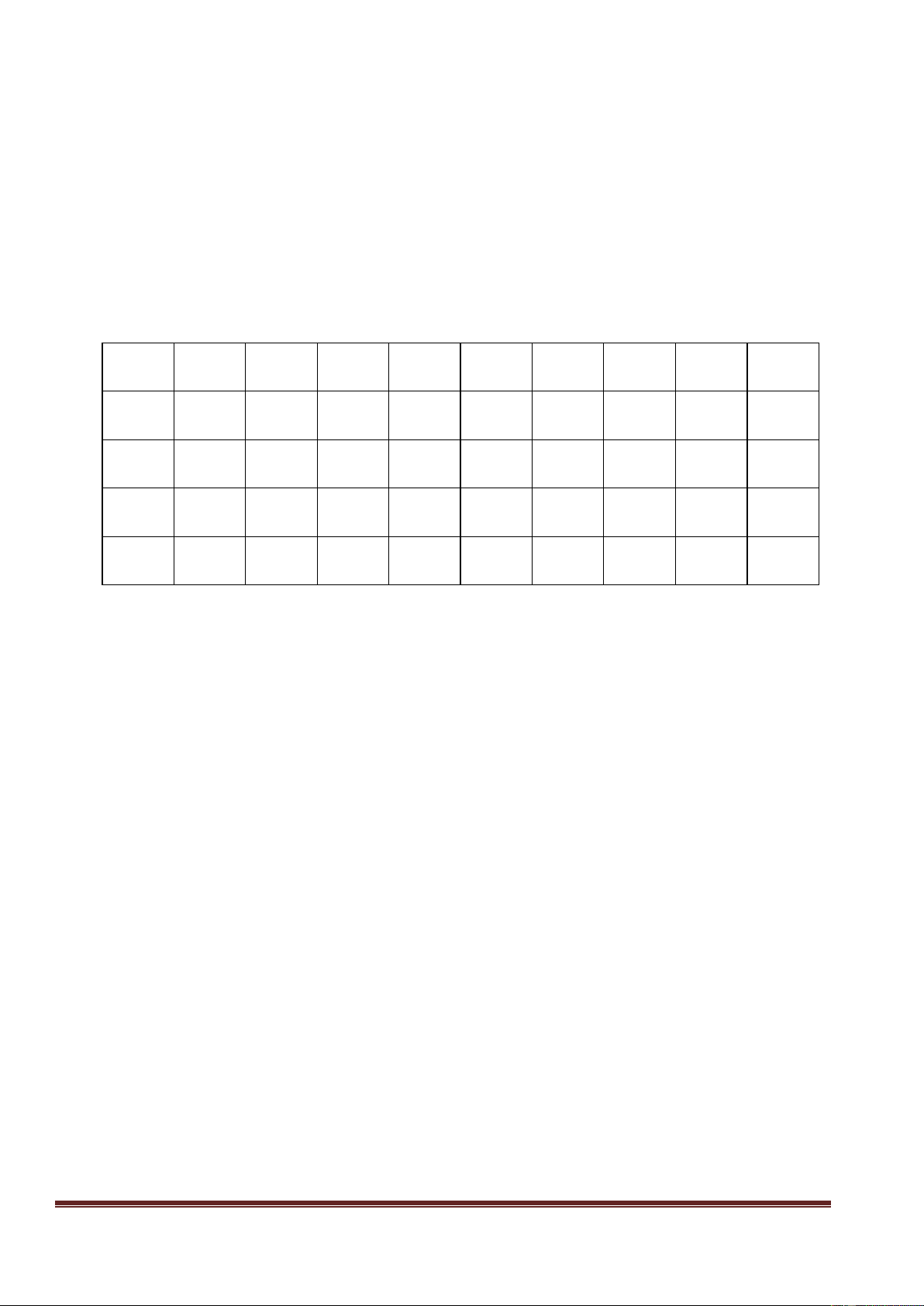
Page 128
ĐÁP ÁN
1-A
2-D
3-A
4-B
5-C
6-C
7-A
8-C
9-C
10-A
11-A
12-B
13-C
14-A
15-A
16-D
17-B
18-A
19-A
20-D
21-C
22-C
23-A
24-A
25-A
26-C
27-D
28-B
29-D
30-D
31-C
32-D
33-C
34-C
35-C
36-B
37-C
38-B
39-A
40-D
41-B
42-B
43-B
44-D
45-B
46-D
47-B
48-D
49-C
50-B
Question 1. A
HƯỚNG DẪN GIẢI CHI TIẾT
Kiến thức: Trọng âm từ có nhiều âm tiết
Giải thích:
valuable /ˈvæljuəbl/ variety /vəˈraɪəti/
environment /ɪnˈvaɪrənmənt/ impossible /ɪmˈpɒsəbl/
Trọng âm của câu A rơi vào âm thứ nhất, còn lại rơi vào âm thứ hai.
Chọn A
Question 2. D
Kiến thức: Trọng âm từ có hai âm tiết
Giải thích:
social /ˈsəʊʃl/ common /ˈkɒmən/
verbal /ˈvɜːbl/ polite /pəˈlaɪt/
Trọng âm của câu D rơi vào âm thứ hai, còn lại rơi vào âm thứ nhất.

Page 129
Chọn D
Question 3. A
Kiến thức: Đọc hiểu
Giải thích:
Cha mẹ có thể đưa ra trợ giúp tuyệt vời để phát triển ngôn ngữ của con mình bằng cách
A. đọc sách cho B. đáp lại
C. áp dụng D. thử nghiệm
chúng.
Thông tin: By adopting a few simple techniques, parents who read to their children can considerably
increase their children’s language development.
Tạm dịch: Bằng cách áp dụng một vài kỹ thuật đơn giản, những bậc cha mẹ mà đọc cho con cái họ nghe
có thể tăng đáng kể sự phát triển ngôn ngữ của con cái họ.
Chọn A
Question 4. B
Kiến thức: Đọc hiểu
Giải thích:
Từ "họ" trong đoạn thứ hai đề cập đến gì?
A. Những người tham gia B. Các bậc cha mẹ
C. Câu hỏi D. Trẻ em
Thông tin: In the experimental group, the parents were given a two-hour training session in which they
were taught to ask open-ended questions rather than yes-no questions.
Tạm dịch: Trong nhóm thử nghiệm, các bậc cha mẹ đã được tham gia một khóa đào tạo kéo dài hai giờ,
trong đó họ được dạy để hỏi những câu hỏi mở thay vì câu hỏi chỉ trả lời có hoặc không.
Chọn B
Question 5. C
Kiến thức: Đọc hiểu
Giải thích:
Trong suốt khóa đào tạo, cha mẹ trong nhóm thực nghiệm đã được dạy để _ .
A. nghiên cứu rất nhiều thí nghiệm
B. đưa ra câu trả lời đúng
C. hỏi các câu hỏi mở
D. sử dụng câu hỏi có-không
Thông tin: In the experimental group, the parents were given a two-hour training session in which they
were taught to ask open-ended questions rather than yes-no questions.
Tạm dịch: Trong nhóm thử nghiệm, các bậc cha mẹ đã được tham gia một khóa đào tạo kéo dài hai giờ,
trong đó họ được dạy để hỏi những câu hỏi mở thay vì câu hỏi chỉ trả lời có hoặc không.
Chọn C
Question 6. C
Kiến thức: Đọc hiểu
Giải thích:
Sự khác biệt chính giữa nhóm kiểm soát và một nhóm thử nghiệm trong nghiên cứu là gì?
A. Số lượng người tham gia.
B. Tuổi của trẻ em.
C. Khóa đào tạo mà cha mẹ nhận được.
D. Những cuốn sách đã được đọc.

Page 130
Thông tin: Half of the thirty children participants were in the experimental study; the other half acted as
the control group. In the experimental group, the parents were given a two-hour training session in which
they were taught to ask open-ended questions rather than yes-no questions.
Tạm dịch: Một nửa trong số ba mươi trẻ tham gia nghiên cứu thực nghiệm; nửa còn lại đóng vai trò là
nhóm kiểm soát. Trong nhóm thử nghiệm, các bậc cha mẹ đã được tham gia một khóa đào tạo kéo dài hai
giờ, trong đó họ được dạy để hỏi những câu hỏi mở thay vì câu hỏi chỉ trả lời có hoặc không.
Chọn C
Question 7. A
Kiến thức: Đọc hiểu
Giải thích:
Kết luận gì có thể được rút ra từ đoạn văn này?
A. Kỹ năng ngôn ngữ của trẻ em tăng lên khi chúng được yêu cầu phản ứng tích cực.
B. Trẻ em đọc tích cực luôn luôn hành động sớm hơn 6 tháng so với những đứa trẻ không (đọc).
C. Trẻ em 2 hoặc 3 tuổi có thể được dạy cách đọc tích cực.
D. Trẻ em càng đọc nhiều, chúng càng trở nên thông minh
Thông tin: If a parent encourages the child to actively respond to what the parent is reading, the child's
language skills increase.
Tạm dịch: Nếu cha mẹ khuyến khích trẻ phản ứng tích cực với những gì họ đang đọc, kỹ năng ngôn ngữ
của trẻ sẽ tăng.
Chọn A
Dịch bài đọc:
Bằng cách áp dụng một vài kỹ thuật đơn giản, những bậc cha mẹ mà đọc cho con cái họ nghe có thể tăng
đáng kể sự phát triển ngôn ngữ của con cái họ. Điều đó thật đáng ngạc nhiên, nhưng là sự thật. Cách cha
mẹ nói chuyện với con cái học tạo nên sự khác biệt lớn trong sự phát triển ngôn ngữ của trẻ. Nếu cha mẹ
khuyến khích trẻ phản ứng tích cực với những gì cha mẹ đang đọc, thì khả năng ngôn ngữ của trẻ sẽ tăng
lên.
Một nghiên cứu đã được thực hiện với các trẻ em hai hoặc ba tuổi và cha mẹ của chúng. Một nửa trong số
ba mươi trẻ tham gia nghiên cứu thực nghiệm; nửa còn lại đóng vai trò là nhóm kiểm soát. Trong nhóm
thử nghiệm, các bậc cha mẹ đã được tham gia một khóa đào tạo kéo dài hai giờ, trong đó họ được dạy để
hỏi những câu hỏi mở thay vì câu hỏi chỉ trả lời có hoặc không. Ví dụ, phụ huynh nên hỏi, “Chú chó đang
làm gì vậy?” thay vì, “Chú chó có chạy trốn phải không?”. Bố mẹ ở nhóm thực nghiệm cũng được hướng
dẫn cách mở rộng câu trả lời của con, cách đề xuất các khả năng thay thế và cách khen ngợi câu trả lời
đúng.
Khi bắt đầu nghiên cứu, trẻ em không khác nhau về mức độ phát triển ngôn ngữ, nhưng sau một tháng,
những đứa trẻ trong nhóm thử nghiệm đã tiến bộ hơn nhóm kiểm soát 5,5 tháng trong bài kiểm tra về diễn
đạt bằng lời nói và từ ngữ. Chín tháng sau, những đứa trẻ trong nhóm thử nghiệm vẫn cho thấy sự tiến bộ
6 tháng so với những đứa trẻ trong nhóm kiểm soát.
Question 8. C
Kiến thức: Từ vựng, từ trái nghĩa
Giải thích:
be up to your ears in something: có rất nhiều việc phải giải quyết
bored (adj): chán nản scared (adj): sợ hãi
free (adj): rảnh rỗi busy (adj): bận rộn
=> be up to your ears in something >< free
Tạm dịch: Mình xin lỗi mình không thể ra ngoài vào cuối tuần này – Mình đang bận ngập đầu ngập cổ.

Page 131
Chọn C

Page 132
Question 9. C
Kiến thức: Từ vựng, từ trái nghĩa
Giải thích:
cautious (adj): cẩn thận
factual (adj): thực tế unfriendly (adj): không thân thiện
careless (adj): cẩu thả ambitious (adj): tham vọng
=> cautious >< careless
Tạm dịch: Công nhân luôn được khuyến cáo nên thận trọng khi ra vào nơi này do một vụ hỏa hoạn gần
đây.
Chọn C
Question 10. A
Kiến thức: Từ vựng
Giải thích:
responsibility (n): trách nhiệm
possibility (n): khả năng việc gì đó có thể xảy ra hay không
probability (n): khả năng việc gì đó có thể xảy ra là cao hay thấp
ability (n): khả năng một người có thể làm được việc gì
take responsibility for something: chịu trách nhiệm cho việc gì
Tạm dịch: Mỗi chúng ta phải chịu trách nhiệm cho hành động của mình.
Chọn A
Question 11. A
Kiến thức: Câu bị động kép
Giải thích:
Chủ động: People/they + think/say/suppose/.....+ that + clause.
=> Bị động:
- Khi động từ ở mệnh đề phụ ở thì hiện tại đơn hoặc tương lai đơn:
S + am/is/are + thought/ said/supposed... + to + Vinf
- Khi động từ ở mệnh đề phụ ở thì quá khứ đơn hoặc hiện tại hoàn thành:
S + am/is/are + thought/ said/ supposed... + to + have + V.p.p
Tạm dịch: Chồng sắp cưới của cô ấy được cho là đã tốt nghiệp Đại học Harvard năm năm trước.
Chọn A
Question 12. B
Kiến thức: Từ vựng
Giải thích:
exploration (n): sự khám phá explanation (n): lời giải thích
expedition (n): cuộc thám hiểm expectation (n): sự mong chờ
Tạm dịch: Tôi không thể nghĩ ra bất kỳ lời giải thích nào cho sự vắng mặt của anh ấy.
Chọn B
Question 13. C
Kiến thức: Mạo từ
Giải thích:
a/an: dùng với các danh từ được nhắc đến lần đầu tiên, chưa xác định
some: một vài
the: dùng với danh từ xác định hoặc một phát minh cụ thể.
Tạm dịch: Các bà nội trợ thấy làm việc nhà trở dễ dàng hơn nhờ phát minh ra các thiết bị tiết kiệm sức

Page 133
lao động.

Page 134
Chọn C
Question 14. A
Kiến thức: Động từ khuyết thiếu
Giải thích:
should + have + V.p.p: nên làm gì nhưng đã không làm
may + have + V.p.p: đã có thể làm gì
need + have + V.p.p: cần phải làm gì
must + have + V.p.p: chắc hẳn đã làm gì
Tạm dịch: Người giám sát của tôi tức giận với tôi. Tôi đã không làm tất cả những công việc đáng ra tôi
nên làm từ tuần trước.
Chọn A
Question 15. A
Kiến thức: Từ vựng
Giải thích:
influence (v): ảnh hưởng aim (v): hướng vào, tập trung vào
take (v): lấy offer (v): đưa ra đề nghị
Tạm dịch: Một số bộ phim về bạo lực đã ảnh hưởng xấu đến trẻ em và thanh thiếu niên.
Chọn A
Question 16. D
Kiến thức: Từ vựng
Giải thích:
promise (to do something) (v): hứa
involve (doing something) (v): gồm, bao hàm cái gì đó quan trọng
allow (somebody to do something) (v): cho phép ai làm gì
tobe committed to doing something (v): cam kết làm việc gì
Tạm dịch: Mọi người không nên có con trừ khi họ cam kết trở thành cha mẹ có trách nhiệm.
Chọn D
Question 17. B
Kiến thức: Câu gián tiếp
Giải thích:
Khi câu trực tiếp ở dạng wh-question => Cấu trúc câu gián tiếp:
S + asked + O + wh-word + S + V (lùi thì)
Trong câu hỏi về số lượng “How many …?”, danh từ “students” phải được đặt sau từ để hỏi “how many”.
Chủ ngữ ở mệnh đề phụ là “there”, động từ ở mệnh đề phụ là “were”.
Tạm dịch: Cô Brown hỏi tôi rằng có bao nhiêu học sinh trong lớp tôi.
Chọn B
Question 18. A
Kiến thức: Giới từ
Giải thích:
under pressure: áp lực, căng thẳng out of: ra khỏi
above: ở vị trí cao hơn cái gì, ở phía trên upon = on: ở trên bề mặt
Tạm dịch: Với khối lượng công việc tăng lên rất nhiều, mọi người hiện đang chịu nhiều áp lực.
Chọn A
Question 19. A
Kiến thức: Từ vựng

Page 135
Giải thích:

Page 136
divide something (up) (into something): chia thành các phần
submit something (to somebody/something): nộp cái gì cho ai
enroll in something: đăng ký học một khóa học, một trường
học,… provide something: cung cấp
Tạm dịch: Vì có quá nhiều người tham gia hội thảo, diễn giả chính đã chia họ thành bốn nhóm nhỏ
hơn để thảo luận.
Chọn A
Question 22. C
Kiến thức: Sự hòa hợp giữa các thì
Giải thích:
Trong quá khứ, một sự việc đang diễn ra thì một sự việc khác xen vào:
- Sự việc đang diễn ra dùng thì quá khứ tiếp diễn: S + was/were + V.ing
- Sự việc xen vào dùng thì quá khứ đơn: S + V.ed (I suddenly heard …)
Tạm dịch: Tôi đang đi trên đường thì bất ngờ nghe thấy tiếng bước chân phía sau tôi.
Chọn C
Question 23. A
Kiến thức: Mệnh đề quan hệ
Giải thích:
Ở đây cần một đại từ quan hệ thay thế cho “the family”, đóng vai trò là tính từ sở hữu bổ ngữ cho danh
từ “houses” => dùng “whose”.
…..N (person, thing) + WHOSE + N + V ….
where: trạng từ quan hệ thay thế từ chỉ nơi
chốn
whom: thay thế cho danh từ chỉ người, đóng vai trò tân ngữ trong mệnh đề quan hệ
that: có thể thay thế cho vị trí của who, whom, which trong mệnh đề quan hệ quan hệ xác định
Tạm dịch: Các gia đình có nhà bị sóng thần cuốn trôi đã được tạm trú trong sân trường.
Chọn A
Question 24. A
Kiến thức: Phát âm “ou”

Page 137
Giải thích:
through /θruː/ trouble /ˈtrʌbl/
couple /ˈkʌpl/ double /ˈdʌbl/
Phần được gạch chân ở câu A phát âm là /u:/, còn lại phát âm là /ʌ/.
Chọn A
Question 25. A
Kiến thức: Phát âm “ed”
Giải thích:
Quy tắc phát âm “ed”:
- Phát âm là /ɪd/ với các động từ kết thúc bằng âm /t/ hoặc /d/.
- Phát âm là /t/ với các động từ kết thúc bằng âm vô thanh như là /k/, /p/, /s/, /f/, /tʃ/, /ʃ/.
- Phát âm là /d/ với các động từ kết thúc bằng các âm còn lại.
realized /ˈriːəlaɪzd/ watched /wɒtʃt/
worked /wɜːkt/ missed /mɪst/
Phần được gạch chân ở câu A phát âm là /d/, còn lại phát âm là /t/.
Chọn A
Question 26. C
Kiến thức: Từ vựng, từ đồng nghĩa
Giải thích:
bring up somebody: chăm sóc, nuôi dạy
cry for somebody/something: khóc vì die for something: chết vì cái gì
live with: sống với ai be in touch with: giữ liên lạc với
=> be brought up by = live with
Tạm dịch: Kể từ khi cha mẹ cô ấy qua đời, cô ấy đã được chú của mình nuôi dưỡng.
Chọn C
Question 27. D
Kiến thức: Từ vựng, từ đồng nghĩa
Giải thích:
native (n): người bản địa
migrant (n): người di cư tourist (n): khách du lịch
member (n): thành viên local (n): người dân địa phương
=> native = local
Tạm dịch: Người bản địa đã tức giận khi người nước ngoài đến đất nước của họ và chiếm lấy đất của họ.
Chọn D
Question 28. B
Kiến thức: Hội thoại giao tiếp
Giải thích:
John và Alice đang nói về việc đi xem phim.
John: “Mình đang tự hỏi rằng bạn có muốn đi xem phim tối nay không.”
Alice: “ Phim gì đang chiếu vậy?”

Page 138
A. Đúng là vậy B. Chắc chắc rồi, mình thích lắm
C. Không, cảm ơn bạn D. Không, mình không thích nó
Chọn B
Question 29. D
Kiến thức: Hội thoại giao tiếp
Giải thích:
Chiều nay Hoa sẽ về thăm quê cô ấy.
Mark: “Đừng quên gửi lời hỏi thăm sức khỏe của mình đến bố mẹ bạn nhé.”
Hoa: “ .”
A. Đó là niềm vinh hạnh của mình B. Không có gì
C. Ý hay đấy, cảm ơn nhé D. Cảm ơn bạn, mình sẽ
Chọn D
Question 30. D
Kiến thức: Từ vựng
Giải thích:
work (n): công việc event (n): sự kiện
accident (n): tai nạn problem (n): vấn đề
But the pollution (30) is as complicated as it is serious.
Tạm dịch: Nhưng ô nhiễm là một vấn đề phức tạp đúng như tính nghiêm trọng của nó.
Chọn D
Question 31. C
Kiến thức: Từ vựng
Giải thích:
However: Tuy nhiên As a result: Vì vậy
For example: Ví dụ như Therefore: Vì vậy
(31) , exhaust from automobiles causes a large percentage of air pollution. But the automobile
provides transportation for millions of people.
Tạm dịch: Ví dụ, khí thải từ ô tô gây ra một tỷ lệ lớn ô nhiễm không khí. Nhưng ô tô lại cung cấp vận
chuyển cho hàng triệu người.
Chọn C
Question 32. D
Kiến thức: Từ vựng, từ loại
Giải thích:
Sau động từ “give” cần một danh từ.
employ (v): thuê unemployment (n): sự thất nghiệp
unemployed (adj): thất nghiệp employment (n): việc làm
Factories discharge much of the material that pollutes the air and water but factories give (32)
employment
to a large number of people.
Tạm dịch: Các nhà máy thải ra nhiều chất thải gây ô nhiễm không khí và nước nhưng các nhà máy cũng
cung cấp việc làm cho một số lượng lớn người dân.
Chọn D
Question 33. C
Kiến thức: Từ vựng
Giải thích:

Page 139
continue (v): tiếp tục enjoy (v): thích
stop (v): dừng lại start (v): bắt đầu
Thus, to end or greatly reduce pollution immediately, people would have to (33) stop using many things
that benefit them.
Tạm dịch: Do đó, để chấm dứt hoặc giảm đáng kể ô nhiễm ngay lập tức, con người phải ngừng sử dụng
nhiều thứ mang lại lợi ích cho họ.
Chọn C
Question 34. C
Kiến thức: Mệnh đề quan hệ
Giải thích:

Page 140
Ở đây cần một đại từ quan hệ thay thế cho vật “laws”, đóng vai trò chủ ngữ trong mệnh đề quan hệ =>
dùng “which”.
Trong mệnh đề quan hệ xác định, có thể dùng “that” để thay thế cho “which”.
who: thay thế cho danh từ chỉ người, đóng vai trò chủ ngữ trong mệnh đề sở hữu
whom: thay thế cho danh từ chỉ người, đóng vai trò tân ngữ trong mệnh đề sở hữu
whose: chỉ sở hữu cho người và vật,
Governments can pass and enforce laws (34) which require businesses and traffic to stop, or to cut down
on certain polluting activities.
Tạm dịch: Chính phủ có thể thông qua và thực thi đạo luật yêu cầu việc kinh doanh và giao thông dừng
hoặc cắt giảm một số hoạt động gây ô nhiễm.
Chọn C
Dịch bài đọc:
Mọi người đều mong giảm thiểu ô nhiễm. Nhưng vấn đề ô nhiễm là phức tạp như đúng tính nghiêm trọng
của nó. Nó phức tạp bởi vì phần lớn ô nhiễm được gây ra bởi những thứ mang lại lợi ích con người.
Chẳng hạn, khí thải từ ô tô gây nên phần lớn lượng ô nhiễm không khí. Nhưng ô tô lại cung cấp việc đi lại
cho hàng triệu người. Các nhà máy thải ra phần lớn các chất làm ô nhiễm không khí, nhưng các nhà máy
lại tạo ra việc làm cho rất nhiều người.
Vì vậy, để dừng hoặc giảm thiểu đáng kể ô nhiễm ngay lập tức, mọi người cần phải dừng việc sử dụng
những thứ có lợi cho họ. Tất nhiên phần lớn mọi người đều không muốn làm như vậy. Nhưng ô nhiễm có
thể được giảm thiểu từ từ bằng nhiều cách. Các nhà khoa học và các kỹ sư có thể nghiên cúu để tìm ra
cách giảm thiểu lượng ô nhiễm mà các ô tô và nhà máy thải ra. Chính phủ cần thông qua và ban hành
những đạo luật yêu cầu các việc kinh doanh và giao thông chấm dứt hoặc cắt giảm những hoạt động gây ô
nhiễm nhất định.
Question 35. C
Kiến thức: Đảo ngữ
Giải thích:
- Not only + auxiliary + S + V + but + S + V + as well: không những … mà còn …
- As soon as: ngay khi
- No sooner + auxiliary + S + V + than + S + V
= Hardly + auxiliary + S + V + when + S + V
Tạm dịch: Đội bóng rổ biết họ đã thua trận đấu. Họ liền bắt đầu đổ lỗi cho nhau.
A. Không chỉ đội bóng rổ biết họ thua trận mà họ còn đổ lỗi cho nhau.
B. Ngay khi họ đổ lỗi cho nhau, đội bóng rổ biết rằng họ thua trận đấu.
C. Ngay khi đội bóng rổ biết họ thua trận thì họ bắt đầu đổ lỗi cho nhau.
D. Ngay khi đội bóng rổ bắt đầu đổ lỗi cho nhau thì họ biết họ thua trận đấu.
Câu A, B, D sai về nghĩa.
Chọn C
Question 36. B
Kiến thức: Mệnh đề nhượng bộ
Giải thích:
Though + S + V, clause: Mặc dù
Trong mệnh đề quan hệ không xác định, không dùng đại từ quan hệ “that” => Câu A sai
Tạm dịch: Crazianna là một quốc gia lớn. Thật không may, nó chưa bao giờ nhận được sự tôn trọng từ
các nước láng giềng.
B. Crazianna là một quốc gia lớn đến nỗi nó chưa bao giờ nhận được sự tôn trọng từ các nước láng giềng.

Page 141
C. Mặc dù Crazianna là một quốc gia lớn, nó chưa bao giờ nhận được sự tôn trọng từ các nước láng
giềng.
D. Crazianna chưa bao giờ nhận được sự tôn trọng từ các nước láng giềng vì nó là một quốc gia lớn.
Câu C, D sai về nghĩa.
Chọn B
Question 37. C
Kiến thức: Từ vựng
Giải thích:
either… or…: hoặc … hoặc …
Sửa: and => or
Tạm dịch: Để thu hút sự chú ý của ai đó, chúng ta có thể sử dụng các hình thức giao tiếp bằng lời nói
hoặc không bằng lời nói.
Chọn C
Question 38. B
Kiến thức: Sự hòa hợp giữa chủ ngữ và động từ
Giải thích:
assumption (n): giả định
Chủ ngữ chính của câu là “assumption”. Đây là danh từ không đếm được nên động từ theo sau phải chia ở
ngôi số ít.
Sửa: have been proved => has been proved
Tạm dịch: Giả định rằng hút thuốc có ảnh hưởng xấu đến sức khỏe của chúng ta đã được chứng minh.
Chọn B
Question 39. A
Kiến thức: Từ vựng, từ loại
Giải thích:
Ở đây sử dụng cấu trúc song hành để liệt kê các đặc điểm của “dogs” nên các từ được nối với nhau bằng
dấu phẩy, từ nối “and” phải có cấu trúc ngữ pháp giống nhau.
Danh từ “loyalty” phải được chuyển về dạng tính từ.
loyalty (n): lòng trung thành
loyal (adj): trung thành
Sửa: loyalty => loyal
Tạm dịch: Những con chó được huấn luyện để dẫn dắt người mù phải trung thành, thông minh và ngoan
ngoãn.
Chọn A
Question 40. D
Kiến thức: Câu gián tiếp
Giải thích:
admit doing something: thừa nhận đã làm việc gì
refuse to do something: từ chối làm việc gì
intend to do something: dự định làm việc gì
deny doing something/ having done something: phủ nhận đã làm việc gì
Tạm dịch: “Không, điều đó không đúng. Tôi không hề trộm tiền!” Jean nói.
A. Jean thừa nhận ăn cắp tiền. B. Jean từ chối ăn cắp tiền.
C. Jean không có ý định ăn cắp tiền. D. Jean phủ nhận đã ăn cắp tiền.
Chọn D

Page 142
Question 41. B

Page 143
Kiến thức: Từ vựng
Giải thích:
It is not until … that…: Mãi cho đến khi … thì …
only when + S + V: chỉ khi
tobe allowed to do something: được pháp làm gì
Tạm dịch: Chỉ đến khi một cô gái Việt Nam đủ 18 tuổi thì cô ấy mới được phép kết hôn một cách hợp
pháp.
A. Một cô gái Việt Nam không được phép kết hôn hợp pháp chỉ khi cô ấy 18 tuổi.
B. Một cô gái Việt Nam chỉ được phép kết hôn hợp pháp khi cô ấy 18 tuổi.
C. Sự chấp nhận về mặt pháp lý cho một cô gái Việt Nam kết hôn sẽ được cấp trong 18 năm.
D. Họ không bao giờ cho phép một cô gái Việt Nam kết hôn hợp pháp khi cô ấy 18 tuổi.
Câu A, C, D sai về nghĩa.
Chọn B
Question 42. B
Kiến thức: Chuyển đổi câu từ quá khứ sang hiện tại hoàn thành
Giải thích:
It is + time + since + S + last + V.ed + …
= S + have/has + not + V.p.p + since/for + …
Tạm dịch: Đã hơn hai mươi năm kể từ lần cuối tôi liên lạc với họ.
A. Tôi không thể ngừng liên lạc với họ trong hơn 20 năm.
B. Tôi đã không liên lạc với họ hơn 20 năm rồi.
C. Tôi đã từng liên lạc với họ trong hơn 20 năm.
D. Tôi đã liên lạc với họ hơn 20 năm liền.
Câu A, C, D sai về nghĩa.
Chọn B
Question 43. B
Kiến thức: Đọc hiểu
Giải thích:
Đoạn văn chủ yếu giải thích điều gì?
A. Các vì sao tạo ra năng lượng như thế nào
B. Thời điểm mà hầu hết khí heli trong vũ trụ được hình thành
C. Tại sao hydro lại dồi dào
D. Sự khác biệt giữa heli và hydro
Thông tin: The universe has not existed long enough for this figure to be significant greater.
Consequently, if the universe is somewhat more than 25 percent helium now, then it must have been
about 25 percent helium at a time near the beginning.
However, when the universe was less than one minute old, no helium could have existed. Calculations
indicate that before this time temperature were too high and particles of matter were moving around much
too rapidly. It was only after the one-minute point that helium could exist. By this time, the universe had
cooled so sufficiently that neutrons and protons could stick together. But the nuclear reactions that led to
the formations of helium went on for only relatively short time. By the time the universe was a few
minutes old, helium production had effectively ceased.
Tạm dịch: Vũ trụ đã không tồn tại đủ lâu để con số này là lớn hơn đáng kể. Do đó, nếu vũ trụ là có phần
hơn 25 % Heli bây giờ, thì nó phải có được khoảng 25% Heli tại một thời điểm gần lúc nó hình thành.
Tuy nhiên, khi vũ trụ hình thành chưa đầy một phút, Heli đã không thể tồn tại. Các tính toán cho thấy

Page 144
rằng trước khi nhiệt độ thời gian này là quá cao và các hạt của vật chất đã được di chuyển xung quanh

Page 145
nhiều quá nhanh. Chỉ sau mốc một phút Heli mới thể tồn tại. Đến thời điểm này, vũ trụ đã quá nguội đến
nỗi Nơtron và Proton có thể kết hợp vào nhau. Nhưng phản ứng hạt nhân dẫn đến sự hình thành của Heli
đã hoàn thiện trong một thời gian tương đối ngắn. Sau khi vũ trụ được hình thành vài phút, việc tạo ra
Heli đã không còn hiệu quả.
Chọn B
Question 44. D
Kiến thức: Đọc hiểu
Giải thích:
Theo đoạn văn, khí heli là
A. nguyên tố phổ biến nhất trong chuẩn tinh B. khó để phát hiện
C. nguyên tố lâu đời nhất trong vũ trụ D. nguyên tố phong phú thứ hai trong vũ trụ
Thông tin: The elements other than hydrogen and helium exist in such small quantities that it is accurate
to say that the universe is somewhat more than 25 percent helium by weight and somewhat less than 75
percent hydrogen.
Tạm dịch: Các yếu tố ngoài Hydro và Heli tồn tại với số lượng nhỏ đến nỗi chính xác khi nói rằng theo
trọng lượng, vũ trụ có phần hơn 25 phần trăm heli tính và phần nào ít hơn 75 phần trăm Hydro.
Chọn D
Question 45. B
Kiến thức: Đọc hiểu, từ vựng
Giải thích:
constituent (n): thành phần
cause (n): nguyên nhân component (n): thành phần
relative (n): họ hàng target (n): mục tiêu
=> constituent = component
Thông tin: Helium nuclei have also been found to be constituents of cosmic rays that fall on the earth
Tạm dịch: Hạt nhân helium cũng đã được tìm thấy là thành phần của các tia vũ trụ chiếu xuống Trái đất
Chọn B
Question 46. D
Kiến thức: Đọc hiểu
Giải thích:
Tại sao tác giả đề cập đến “các tia vũ trụ”?
A. Để giải thích sự phong phú của hydro trong vũ trụ
B. Để giải thích về việc vũ trụ bắt đầu như thế nào
C. Để lấy ví dụ về câu đố về thiên văn chưa giải quyết
D. Nó là một phần của danh sách những thứ có chứa khí heli
Thông tin: Helium nuclei have also been found to be constituents of cosmic rays that fall on the earth
Tạm dịch: Hạt nhân helium cũng đã được tìm thấy là thành phần của các tia vũ trụ chiếu xuống Trái đất
Chọn D
Question 47. B
Kiến thức: Đọc hiểu
Giải thích:
Từ "they" dùng để chỉ
A. hạt B. tia vũ trụ
C. thành phần D. bức xạ
Thông tin: cosmic rays are not really a form of radiation; they consist of rapidly moving particles of

Page 146
numerous different kinds

Page 147
Tạm dịch: tia vũ trụ không phải là thực sự là một dạng bức xạ, chúng gồm các hạt của nhiều loại khác
nhau di chuyển nhanh chóng
Chọn B
Question 48. D
Kiến thức: Đọc hiểu, từ vựng
Giải thích:
vary (v): thay đổi
include (v): bao gồm mean (v): có nghĩa là
stretch (v): căng ra change (v): thay đổi
=> vary = change
Thông tin: Its relative abundance never seems to vary much.
Tạm dịch: Sự phong phú tương đối của nó dường như không bao giờ thay đổi nhiều.
Chọn D
Question 49. C
Kiến thức: Đọc hiểu
Giải thích:
Việc tạo ra helium trong các ngôi sao
A. sản xuất hydro dưới dạng sản phẩm phụ
B. làm cho helium có nhiều ở các ngôi sao tồn tại đã lâu hơn nhiều so với sao mới được hình thành
C. tạo ra năng lượng
D. không thể đo được
Thông tin: Helium is created in stars. In fact, nuclear reactions that convert hydrogen to helium are
responsible for most of the energy that stars produce.
Tạm dịch: Helium được tạo ra trong các ngôi sao. Trong thực tế, phản ứng hạt nhân mà chuyển đổi
Hydro thành Heli đảm nhiệm hầu hết năng lượng mà các ngôi sao tạo ra.
Chọn C
Question 50. B
Kiến thức: Đọc hiểu
Giải thích:
Hầu hết helium trong vũ trụ được hình thành
A. trong phút đầu tiên của sự tồn tại của vũ trụ
B. trong một thời gian rất ngắn
C. trong không gian giữa các vì sao
D. trước phần lớn hydro
Thông tin: However, when the universe was less than one minute old, no helium could have existed.
Calculations indicate that before this time temperature were too high and particles of matter were moving
around much too rapidly. It was only after the one-minute point that helium could exist.
Tạm dịch: Tuy nhiên, khi vũ trụ hình thành chưa đầy một phút, Heli đã không thể tồn tại. Các tính toán
cho thấy rằng trước khi nhiệt độ thời gian này là quá cao và các hạt của vật chất đã được di chuyển xung
quanh nhiều quá nhanh. Chỉ sau mốc một phút Heli mới thể tồn tại.
Chọn B
Dịch bài đọc:
Các yếu tố ngoài Hydro và Heli tồn tại với số lượng nhỏ đến nỗi chính xác khi nói rằng theo trọng lượng,
vũ trụ có phần hơn 25 phần trăm heli tính và phần nào ít hơn 75 phần trăm Hydro.
Các nhà thiên văn đã đo sự dư thừa của Heli khắp thiên hà của chúng ta và các thiên hà khác. Heli đã

Page 148
được tìm thấy trong những ngôi sao tồn tại đã lâu, ở những ngôi sao tương đối mới, trong khí giữa các vì

Page 149
sao, và trong các đối tượng ở xa gọi là chuẩn tinh. Hạt nhân helium cũng đã được tìm thấy là thành phần
của các tia vũ trụ chiếu xuống Trái đất (tia vũ trụ không phải là thực sự là một dạng bức xạ, chúng gồm
các hạt của nhiều loại khác nhau di chuyển nhanh chóng). Nó dường như không làm khác biệt đi nhiều
nơi Heli được tìm thấy. Sự phong phú tương đối của nó dường như không bao giờ thay đổi nhiều. Ở một
số nơi, có thể có nhiều hơn một chút; ở những nơi khác, một chút ít, nhưng tỷ lệ Heli trên các hạt nhân
Hydro luôn luôn vẫn như nhau.
Helium được tạo ra trong các ngôi sao. Trong thực tế, phản ứng hạt nhân mà chuyển đổi Hydro thành
Heli đảm nhiệm hầu hết năng lượng mà các ngôi sao tạo ra. Tuy nhiên, lượng Heli có thể đã được sản
xuất theo cách này có thể được tính toán, và hóa ra là không có nhiều hơn một vài phần trăm. Vũ trụ đã
không tồn tại đủ lâu để con số này là lớn hơn đáng kể. Do đó, nếu vũ trụ là có phần hơn 25 % Heli bây
giờ, thì nó phải có được khoảng 25% Heli tại một thời điểm gần lúc nó hình thành.
Tuy nhiên, khi vũ trụ hình thành chưa đầy một phút, Heli đã không thể tồn tại. Các tính toán cho thấy
rằng trước khi nhiệt độ thời gian này là quá cao và các hạt của vật chất đã được di chuyển xung quanh
nhiều quá nhanh. Chỉ sau mốc một phút Heli mới thể tồn tại. Đến thời điểm này, vũ trụ đã quá nguội đến
nỗi Nơtron và Proton có thể kết hợp vào nhau. Nhưng phản ứng hạt nhân dẫn đến sự hình thành của Heli
đã hoàn thiện trong một thời gian tương đối ngắn. Sau khi vũ trụ được hình thành vài phút, việc tạo ra
Heli đã không còn hiệu quả.

Page 150
SỞ GD & ĐT HÀ NỘI ĐỀ THI THỬ THPT QUỐC GIA LẦN 2 NĂM 2019
THPT CHUYÊN SƯ PHẠM Môn thi: Tiếng Anh
Thời gian làm bài: 60 phút (không kể thời gian phát đề)
Mã đề 423
Họ, tên thí sinh: .............................................. Số báo danh: ..............................................
Exercise 1: Read the following passage and mark the letter A, B, C or D on your answer sheet to
indicate the correct word or phrase that best fits each of the numbered blanks.
(1) in technology have made a lot of changes to our everyday lifestyles, but one of the biggest
has got to be how we read books. Since the invention of the e-book, there has been a significant change to
our reading habits. Given the choice between taking a couple of heavy paperbacks on holiday or an e-
book device like a Kindle, most of us, including our parents and grandparents, would unsurprisingly opt
(2) the Kindle.
But what would our lives be like with no books at all? It’s a (3) _ question. Some educational
specialists are making predictions that in the future we won’t even see books in classrooms - everything
will be done online! (4) of the idea of getting rid of books say that there will always be a need
for paper-based versions of materials. However, to be realistic, we have to accept that there is a (5)
chance that in a decade’s time schools and classrooms will be book-free! What do you think of
that?
Question 1. A. Progression
B. Successes
C. Increases
D. Advances
Question 2. A. of
B. on
C. for
D. at
Question 3. A. special
B. naughty
C. funny
D. tricky
Question 4. A. Alternatives
B. Contestants
D. Opponents
D. Enemies
Question 5. A. remote
B. far
C. long
D. distant
Exercise 2: Mark the letter A, B, C or D on your answer sheet to indicate the most suitable response to
complete each of the following exchanges.
Question 6. Peter and Mike are in the middle of their conversation.
Peter: “If only I hadn’t said that to her.”
Mike: “ ”
A. No, you’ve don’t a good job! B. No worry, that’s nothing.
C. Ah, well, that’s life. D. Yes, you mustn’t have done that.
Question 7. Son: “Why don’t we buy a new car, Dad? This one is too old to go out with my friends.”
Dad: “ We don’t have much money.”
A. You’re right. B. I have to think it up.
C. It’s out of the question now. D. That’s a great idea.
Exercise 3: Mark the letter A, B, C or D on your answer sheet to indicate the word(s) whose underlined
part differs from the other three in pronunciation in each of the following questions.
Question 8. A. possession
B. dissolve
C. dessert
D. pessimistic
Question 9. A. penalty
B. expedition
C. incredible
D. determine
Exercise 4: Read the following passage and mark the letter A, B, C or D on your answer sheet to
indicate the correct answer to each of the following questions.
WHY DON’T YOU GET A PROPER JOB?
She wants to be a singer; you think she should go for a long-term career with job security and
eventually retire with a good pension. But a new report suggests that in fact she’s the practical one. Why
do parents make terrible careers advisers?

Page 151
Today’s 14 and 15-year-olds are ambitious. They are optimistic about their prospects, but their career
ideas are rather vague. Although 80% of them have no intention of following in their parents’ footsteps,
69% still turn to their parents for advice. They look at their working future in a different way to their
parents.
A job for life is not in their vocabulary; neither is a dead-end but secure job that is boring but pays
the bills. Almost half the boys surveyed expected that their hobbies would lead them into the right sort of
job, while most girls seemed determined to avoid traditionally female careers such as nursing.
In the past, this might have counted as bad news. Certainly when I was 15, my guidance counsellors were
horrified at my plans to become a writer. I’m glad I didn’t change my plans to suit them. Even so, their
faith in rigid career paths was well-founded. In those days, that was the way to get ahead.
But the world has changed. The global economy is not kind to yesterday’s diligent and dependable
worker. The future belongs to quick-thinking people who are resourceful, ambitious and can take the
initiative. This means that a 14-year-old who sees her working future as a kind of adventure, to be made
up as she goes along is not necessarily being unrealistic.
However, she has to have the training and guidance to help her develop the right skills for today’s
market; not the rigid preparation for a workplace that disappeared twenty years ago. Many young people
are very aware of the pitfalls of the flexible workplace; they understand that redundancy, downsizing
and freelancing are all part of modern working life, but no one is telling them how they might be able to
turn the new rules of the employment game to their advantage. This is what they need to know if they are
to make a life for themselves.
So what is to be done? A good first step would be to change the way in which schools prepare young
people for adult life. The education system is becoming less flexible and more obsessed with traditional
skills at just the time that the employment market is going in the opposite direction.
Accurate, up-to-date information on new jobs and qualifications can help guidance counsellors to help
their students. Young people need solid information on the sort of training they need to pursue the career
of their dreams. Also, a little bit of encouragement can go a long way. If nothing else, a bit of optimism
from an adult can serve as an antidote to the constant criticism of teenagers in the press.
What, then, can we as parents do to help them? The best thing is to forget all the advice that your parents
gave you, and step into your teenager’s shoes. Once you’ve done that, it’s easier to see how important it is
that they learn how to be independent, resourceful and resilient. Give them the courage to follow their
dreams -however odd they might sound right now. In a world that offers economic security to almost no
one, imagination is a terrible thing to waste.
Question 10. What is the writer’s attitude to the changing job market?
A. It is a challenge that must be faced. B. It had made too many people unemployed.
C. It is something that young people are afraid of. D. It has had a negative effect on education.
Question 11. How does the writer think the global economy has affected the employment market?
A. Workers have to be willing to change jobs. B. Workers are unlikely to receive a pension.
C. It has made workers less dependable. D. It has made work more adventurous.
Question 12. The writer uses the phrase “aware of the pitfalls” to show that young people .
A. feel that modern jobs are too flexible B. know about the problems of modern jobs
C. don’t think they get enough training D. accept that they will be made redundant
Question 13. What kind of employment would teenagers like to have?
A. A job similar to their parents. B. A job that gives them fulfillment.
C. A job that can also be a hobby. D. A job with economic security.
Question 14. The writer feels that most parents .

Page 152
A. give their children good career advice B. do not tend to be particularly ambitious

Page 153
C. have very traditional views about work D. have realistic goals for their children
Question 15. How can parents help their children?
A. By trying to think the way they do B. By learning to be courageous
C. By ignoring advice given by others D. By becoming more independent
Question 16. What does the writer believe about her guidance counsellors?
A. That they should have treated her better. B. That the advice they gave was wrong.
C. That they were in some ways right. D. That they had tried to ruin her career.
Question 17. What does the writer feel will happen if the education system does not change?
A. Young people will be discouraged from working.
B. Young people will receive mover criticism in the press.
C. Young people will be unable to fulfill their potential.
D. Young people will not be optimistic about their future.
Exercise 5: Mark the letter A, B, C or D on your answer sheet to indicate the word(s) CLOSEST in
meaning to the underlined word(s) in each of the following questions.
Question 18. Flats which are both comfortable and reasonably priced are few and far between in the
current context of economic crisis.
A. uncommon B. unusual C. non-standard D. non-existent
Question 19. Gerry didn’t go on the expedition – he made up that part of the story.
A. invented B. narrated C. unfolded D. recounted
Exercise 6: Read the following passage and mark the letter A, B, C or D on your answer sheet to
indicate the correct answer to each of the following questions.
It is not surprising that the birthplace of cola was the hot and humid American South. This region had
long specialized in creating delicious soft drinks. A druggist in Atlanta, Georgia named John Pemberton
created the most well-known drink brand in the world in the 1880s. However, it seems clear that he had
no idea how big it would become.
Like many American pharmacists of the day, Pemberton was opposed to the drinking of alcohol and
wanted to produce a stimulating soft drink. First, he made "the French Wine of Coca," made from the
coca leaf. Then he began to experiment with the cola nut. Eventually, he managed to make a combination
of the two that he thought was sweet, but not too sweet. Deciding that "the two C's would look well in
advertising," he named it Coca-Cola.
Pemberton's invention caught on fairly quickly. By 1905, "Coke" was being advertised all over the
country as "The Great Natural Temperance Drink." The drink enjoyed additional success since there was
a large and popular temperance movement in the US at that time. In the 1920s, alcohol was outlawed,
and sales of Coke rose significantly. However, they continued to rise even after the law was repeated.
Another reason for Coke's popularity was good business sense. A year after he invented it, Pemberton had
sold Coca-Cola to Asa Griggs Candler for only $283.26! Candler was a marketing genius, and by the time
he sold the Coca-Cola Company in1919, it was worth $25 million.
Question 20. Which of the following would be the best title for the reading?
A. The Invention and History of Coca-Cola
B. Cola is the World’s Most Popular Soft Drink
C. The Temperance Movement and Coke’s success
D. John Pemberton created Coca-Cola.
Question 21. In paragraph 3, the word “outlawed” is closest in meaning to .
A. made legal B. taken to court
C. made illegal D. allowed

Page 154
Question 22. All of the followings are true of Pemberton EXCEPT that .

Page 155
A. he made “French wine of Coca” from the coca leaf
B. he combined the coca leaf and cola nut to make “French wine”
C. he produced stimulating alcohol from coca leaves and cola nuts
D. he made “French wine of Coca” from the cola nut
Question 23. In paragraph 3, the word “caught on” is closest in meaning to .
A. became popular B. became successful
C. became important D. became legal
Question 24. Which of the following is responsible for Coke’s additional success?
A. The temperance movement B. Its attracting name
C. Pemberton’s good business sense D. Coca-Cola’s great taste
Exercise 7: Mark the letter A, B, C or D on your answer sheet to indicate the underlined part that
needs correction in each of the following questions.
Question 25. Physics and mental exercise has been found to be beneficial to our brains, but scientists
have now found it could also improve the learning ability of our children.
A. learning ability B. has been
C. it D. Physics
Question 26. Peacocks are among the most exotic birds in nature; its long tail feathers fan out to reveal
a profusion of vivid colors.
A. fan out B. its C. most exotic D. among
Question 27. It is the job interview that you should be prepared to mention a salary range.
A. salary range B. to mention
C. should be D. the job interview
Exercise 8: Mark the letter A, B, C or D on your answer sheet to indicate the sentences that combines
each pair of sentences in the following questions.
Question 28. He was overconfident. Therefore, he ruined our plan completely.
A. It was because his overconfidence that ruined our plan completely.
B. He was overconfident, which ruined our plan completely.
C. That he was overconfidence ruined our plan completely.
D. It was his overconfidence ruined our plan completely.
Question 29. It was a kind of accident. Nobody was really to blame for it.
A. It was a kind of accident, which nobody was really to blame for.
B. It was a kind of accident for whom was really to blame it.
C. It was a kind of accident for which nobody was really to blame it.
D. It was a kind of accident for which nobody was really to blame.
Question 30. The 2022 FIFA World Cup is an important competition in international football. Almost
everyone around the world is looking forward to it.
A. The 2022 FIFA World Cup is so important a competition in international football that almost
everyone around the world is looking forward to it.
B. The 2022 FIFA World Cup is too important a competition in international football that almost
everyone around the world to look forward to it.
C. So important is the 2022 FIFA World Cup competition in international football that almost
everyone around the world is looking forward to.
D. The 2022 FIFA World Cup is such important competition in international football that almost
everyone around the world is looking forward to it.
Exercise 9: Mark the letter A, B, C or D on your answer sheet to indicate the sentence that is closest in

Page 156
meaning to each of the following questions.

Page 157
Question 31. You should have persuaded him to change his mind.
A. You didn’t persuade him to change because of his mind.
B. It was essential to persuade him to change his mind but you didn’t.
C. You persuaded him to change his mind but he didn’t listen.
D. You should persuade him to change his mind.
Question 32. The likelihood of suffering a heart attack rises as one becomes increasingly obese.
A. Heart attacks are happening more and more often, and most of the sufferers are obese.
B. Obesity results in only a slight increase in the probability of having a heart attack.
C. The more obese one is, the higher the chances for a heart attack become.
D. Anyone who is obese is likely to experience a heart attack at any time.
Exercise 10: Mark the letter A, B, C or D on your answer sheet to indicate the word that differs from
the other three in the position of primary stress in each of the following questions.
Question 33. A. wilderness
B. commitment
C. compliment
D. optimism
Question 34. A. require
B. confide
C. swallow
D. eject
Exercise 11: Mark the letter A, B, C or D on your answer sheet to indicate the correct answer to each
of the following questions.
Question 39. “I think I can find the information on my own.” – “ any help, just call me.”
A. Should you need B. Had you needed
C. Were you to need D. In case of you need
Question 40. What will happen when the world _ oil?
A. makes off with B. runs out of C. loses out on D. goes through with
Question 41. I would suggest to your doctor before you diet.
A. you to speak B. that you speaking C. you speak D. to speak
Question 42. Mum was angry because I went out when I .
A. should have been studying B. needn’t have studied
C. must study D. didn’t need to study
Question 43. We had a(n) opportunity to train with the best coach.
A. unique B. once C. only D. lone
Question 44. If you are interested in applying for the vacancy, send in your .
A. mortgage B. paperback C. notice D. résumé

Page 158
Question 45. The plane left on time so we _ long.
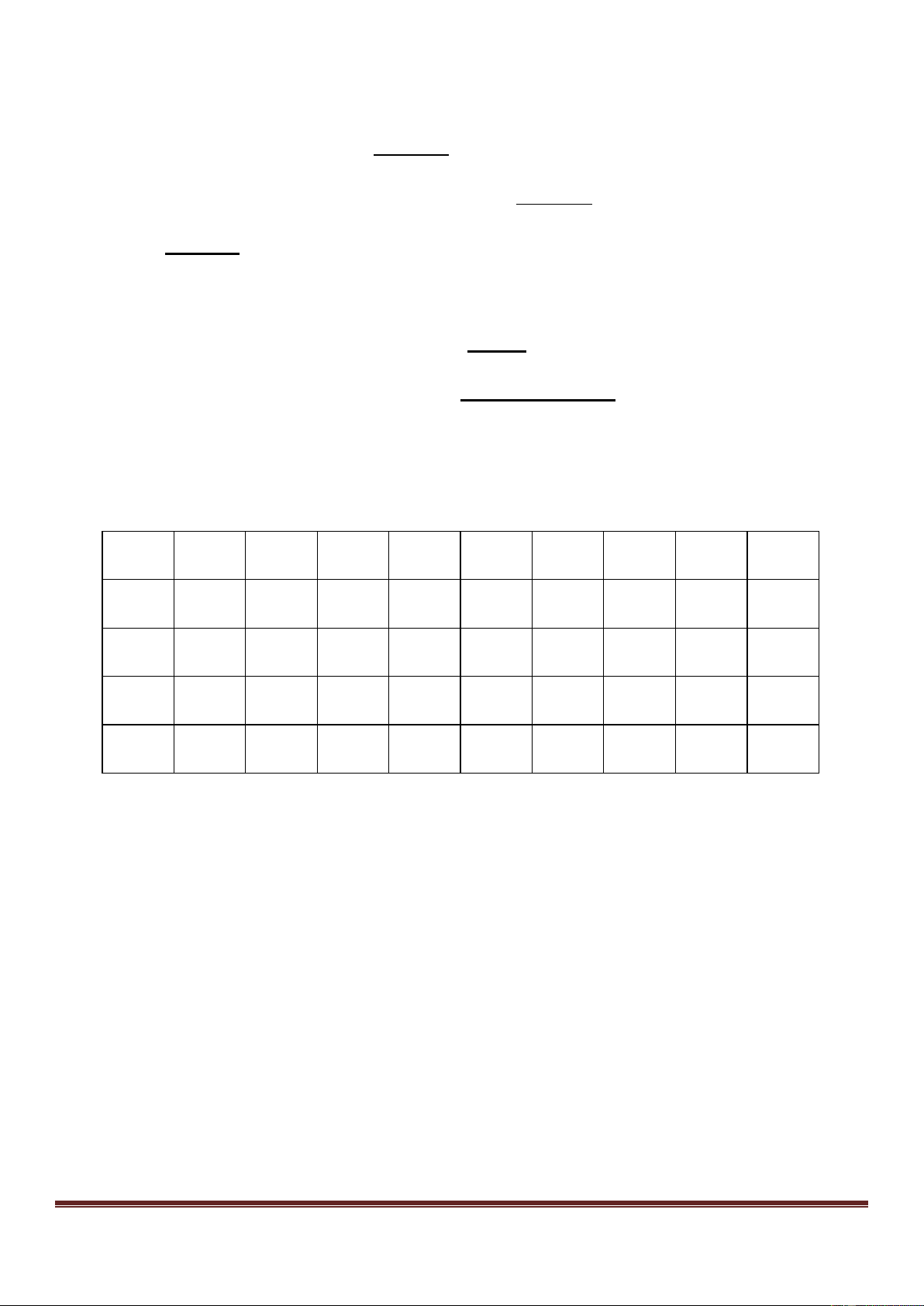
Page 159
A. didn’t need to wait B. needn’t have waited
C. mustn’t have waited D. shouldn’t have waited
Question 46. Susan will graduate in June she submits her dissertation on time.
A. otherwise B. unless C. supposing D. provided
Question 47. Jane is a sympathetic listener. She lent me a(n) when I lost my job.
A. eye B. ear C. mouth D. mind
Question 48. school fees may discourage many students from attending university.
A. Raising B. Improving C. Gaining D. Receiving
Exercise 12: Mark the letter A, B, C or D on your answer sheet to indicate the word(s) OPPOSITE in
meaning to the underlined word(s) in each of the following questions.
Question 49. They haven’t reached agreement on the official songs of the 27
th
Sea Games.
A. formal B. uncertified C. informal D. approved
Question 50. Sorry, I can’t come to your party. I am snowed under with work at the moment.
A. busy with B. fond of C. free from D. relaxed about
-------THE END-------
ĐÁP ÁN
1-D
2-C
3-D
4-C
5-A
6-B
7-C
8-D
9-D
10-A
11-D
12-B
13-B
14-B
15-A
16-C
17-C
18-A
19-A
20-A
21-C
22-C
23-A
24-A
25-D
26-B
27-D
28-B
29-D
30-A
31-B
32-C
33-B
34-C
35-C
36-C
37-A
38-D
39-A
40-B
41-C
42-A
43-A
44-D
45-A
46-D
47-B
48-A
49-B
50-C
Question 1. D
Kiến thức: Từ vựng
Giải thích:
HƯỚNG DẪN GIẢI CHI TIẾT
Động từ “have” được chia ở ngôi số nhiều nên cần một danh từ ở dạng số nhiều.
Progression (n): sự tiến bộ
Success (n): thành công
Increase (n): sự tăng thêm

Page 160
Advance (n): sự tiến bộ
(1) Advance in technology have made a lot of changes to our everyday lifestyles
Tạm dịch: Những tiến bộ trong công nghệ đã tạo ra rất nhiều thay đổi trong lối sống hàng ngày của
chúng ta
Question 2. C
Kiến thức: Từ vựng
Giải thích:
opt for/against something: lựa chọn cái gì
most of us, including our parents and grandparents, would unsurprisingly opt (2) for the Kindle.
Tạm dịch: hầu hết chúng ta, bao gồm cả cha mẹ và ông bà của chúng ta, sẽ không ngạc nhiên khi chọn
Kindle.
Question 3. D
Kiến thức: Từ vựng
Giải thích:
special (adj): đặc biệt
naughty (adj): nghịch ngợm
funny (adj): hài hước
tricky (adj): khó/ khôn lanh (con người)
It’s a (3) tricky question.
Tạm dịch: Đó là một câu hỏi khó.
Question 4. C
Kiến thức: Từ vựng
Giải thích:
Alternative (n): lựa chọn Contestant (n): thí sinh
Opponent (n): đối thủ, người phản đối Enemy (n): kẻ thù
(4) Opponent of the idea of getting rid of books say that there will always be a need for paper-based
versions of materials.
Tạm dịch: Những người phản đối ý tưởng loại bỏ sách nói rằng chúng ta sẽ luôn cần có các phiên bản tài
liệu giấy.
Question 5. A
Kiến thức: Từ vựng
Giải thích:
remote (adj): xa xôi/ không quá lớn, một chút
far (adj): (khoảng cách) xa
long (adj): dài
distant (adj): xa (về khoảng cách hoặc thời gian)
However, to be realistic, we have to accept that there is a (5) remote chance that in a decade’s time
schools and classrooms will be book-free!
Tạm dịch: Tuy nhiên, để thực tế, chúng ta phải chấp nhận rằng có một cơ hội nhỏ rằng trong một thập
kỷ, các trường học và lớp học thời gian sẽ không có sách!
Dịch bài đọc:
Những tiến bộ trong công nghệ đã tạo ra rất nhiều thay đổi trong lối sống hàng ngày của chúng ta, nhưng
một trong những điều lớn nhất phải kể đến là cách chúng ta đọc sách. Kể từ khi phát minh ra sách điện tử,
đã có một sự thay đổi đáng kể trong thói quen đọc sách của chúng ta. Được cho lựa chọn giữa việc mang
một vài cuốn sách bìa dày cộp hoặc một thiết bị sách điện tử như Kindle vào kỳ nghỉ, hầu hết chúng ta,
bao gồm cả cha mẹ và ông bà của chúng ta, sẽ không ngạc nhiên khi đều lựa chọn Kindle.
Nhưng cuộc sống của chúng ta sẽ ra sao nếu không có sách? Đó là một câu hỏi khó. Một số chuyên gia
giáo dục đang đưa ra dự đoán rằng trong tương lai chúng ta sẽ thậm chí không còn nhìn thấy những cuốn
sách trong lớp học - mọi thứ sẽ được thực hiện trực tuyến! Những người phản đối ý tưởng loại bỏ sách
nói rằng chúng ta sẽ luôn cần có các phiên bản tài liệu giấy. Tuy nhiên, thực lòng, chúng ta phải thừa
nhận rằng nghĩ gì về điều đó?

Page 161
Question 6. B
Kiến thức: Hội thoại giao tiếp

Page 162
Giải thích:
Peter và Mike đang nói chuyện với nhau.
Peter: “Giá như mình đã không nói điều đó với cô ấy.”
Mike: “ ”
A. Không, bạn đã làm rất tốt!
B. Đừng lo lắng, điều đó không là gì.
C. Ah, ừ, cuộc sống mà.
D. Ừ, chắc hẳn bạn đã không làm điều đó.
musn’t have V.p.p: (phỏng đoán trong quá khứ) chắc hẳn đã không làm gì
Question 7. C
Kiến thức: Hội thoại giao tiếp
Giải thích:
Con trai: “Tại sao chúng ta không mua chiếc ô tô mới hả bố? Chiếc xe này quá cũ để con đi ra ngoài chơi
với bạn bè.”
Bố: “ Chúng ta đâu có nhiều tiền.”
A. Con nói đúng.
B. Bố sẽ suy nghĩ.
C. Bây giờ điều đó là không thể.
D. Đó là một ý tưởng hay đấy.
out of the question: không thể
Question 8. D
Kiến thức: Phát âm “ss”
Giải thích:
possession /pəˈzeʃn/
dissolve /dɪˈzɒlv/
dessert /dɪˈzɜːt/
pessimistic /ˌpesɪˈmɪstɪk/
Phần được gạch chân ở câu D phát âm là /s/, còn lại phát âm là /z/.
Question 9. D
Kiến thức: Phát âm “e”
Giải thích:
penalty /ˈpenəlti/
expedition /ˌekspəˈdɪʃn/
incredible /ɪnˈkredəbl/
determine /dɪˈtɜːmɪn/
Phần được gạch chân ở câu D phát âm là /ɜː/, còn lại phát âm là /e/.
Question 10. A
Kiến thức: Đọc hiểu
Giải thích:
Thái độ của tác giả đối với việc thị trường việc làm đang thay đổi là gì?
A. Đó là một thách thức phải đối mặt.
B. Nó đã làm cho quá nhiều người thất nghiệp.
C. Đó là điều mà các bạn trẻ sợ.
D. Nó đã có tác động tiêu cực đến giáo dục.
Thông tin: But the world has changed. The global economy is not kind to yesterday’s diligent and
dependable worker. The future belongs to quick-thinking people who are resourceful, ambitious and can
take the initiative. …
Many young people are very aware of the pitfalls of the flexible workplace; they understand that
redundancy, downsizing and freelancing are all part of modern working life, but no one is telling them
how they might be able to turn the new rules of the employment game to their advantage.
Tạm dịch: Nhưng thế giới đã thay đổi. Nền kinh tế toàn cầu không tử tế với người lao động siêng năng
và đáng tin cậy của ngày hôm qua. Tương lai thuộc về những người tư duy nhanh, tháo vát, tham vọng và
chủ động…

Page 163
Nhiều bạn trẻ rất ý thức về những cạm bẫy của nơi làm việc linh hoạt; họ hiểu rằng sự dư thừa, cắt giảm
nhân sự và làm việc tự do đều là một phần của cuộc sống làm việc hiện đại, nhưng không ai nói cho họ
biết làm thế nào họ có thể biến các quy tắc mới của trò chơi tìm việc làm thành lợi thế của họ.
Question 11. D
Kiến thức: Đọc hiểu
Giải thích:
Tác giả nghĩ rằng nền kinh tế toàn cầu đã ảnh hưởng đến thị trường việc làm như thế nào?
A. Người lao động phải sẵn sàng thay đổi công việc.
B. Người lao động không có khả năng nhận lương hưu.
C. Nó đã làm cho người lao động ít tin cậy hơn.
D. Nó đã làm cho công việc mạo hiểm hơn.
Thông tin: Many young people are very aware of the pitfalls of the flexible workplace; they understand
that redundancy, downsizing and freelancing are all part of modern working life, but no one is telling
them how they might be able to turn the new rules of the employment game to their advantage.
Tạm dịch: Nhiều bạn trẻ rất ý thức về những cạm bẫy của nơi làm việc linh hoạt; họ hiểu rằng sự dư
thừa, cắt giảm nhân sự và làm việc tự do đều là một phần của cuộc sống làm việc hiện đại, nhưng không
ai nói cho họ biết làm thế nào họ có thể biến các quy tắc mới của trò chơi tìm việc làm thành lợi thế của
họ.
Question 12. B
Kiến thức: Đọc hiểu
Giải thích:
Tác giả sử dụng cụm từ “Nhận thức về những cạm bẫy”, để chỉ ra rằng những người trẻ tuổi .
A. cảm thấy rằng các công việc hiện đại quá linh hoạt
B. hiểu về các vấn đề của công việc hiện đại
C. không nghĩ rằng họ được đào tạo đầy đủ
D. chấp nhận rằng họ sẽ bị dư thừa
Thông tin: Many young people are very aware of the pitfalls of the flexible workplace; they understand
that redundancy, downsizing and freelancing are all part of modern working life, but no one is telling
them how they might be able to turn the new rules of the employment game to their advantage.
Tạm dịch: Nhiều bạn trẻ rất ý thức về những cạm bẫy của nơi làm việc linh hoạt; họ hiểu rằng sự dư
thừa, cắt giảm nhân sự và làm việc tự do đều là một phần của cuộc sống làm việc hiện đại, nhưng không
ai nói cho họ biết làm thế nào họ có thể biến các quy tắc mới của trò chơi tìm việc làm thành lợi thế của
họ.
Question 13. B
Kiến thức: Đọc hiểu
Giải thích:
Thanh thiếu niên muốn làm những loại công việc nào?
A. Một công việc tương tự như cha mẹ của họ.
B. Một công việc mang lại cho họ sự hài lòng và vui vẻ.
C. Một công việc đồng thời có thể là một sở thích.
D. Một công việc có sự ổn định kinh tế.
Thông tin: A job for life is not in their vocabulary; neither is a dead-end but secure job that is boring but
pays the bills. Almost half the boys surveyed expected that their hobbies would lead them into the right
sort of job, while most girls seemed determined to avoid traditionally female careers such as nursing.
Tạm dịch: Một công việc cho cuộc sống không nằm trong vốn từ vựng của họ; đó không phải là một
công việc cuối cùng nhưng ổn định và nhàm chán nhưng đủ để trả các hóa đơn. Gần một nửa các cậu bé
được khảo sát mong rằng sở thích của họ sẽ giúp họ chọn được loại công việc phù hợp, trong khi hầu hết
các cô gái dường như quyết tâm tránh các nghề nghiệp truyền thống của phụ nữ như điều dưỡng.
Question 14. B
Kiến thức: Đọc hiểu
Giải thích:

Page 164
Người viết cảm thấy rằng hầu hết các bậc cha mẹ .

Page 165
A. cho con cái họ lời khuyên tốt về nghề nghiệp
B. không có xu hướng đặc biệt tham vọng
C. có quan điểm rất truyền thống về công việc
D. có mục tiêu thực tế cho con cái của họ
Thông tin: Today’s 14 and 15-year-olds are ambitious. … They look at their working future in a different
way to their parents.
Tạm dịch: Ngày nay, những cô bé cậu bé 14 và 15 tuổi đầy tham vọng. ... Họ nhìn vào sự nghiệp tương
lai theo một cách khác với bố mẹ của mình.
Question 15. A
Kiến thức: Đọc hiểu
Giải thích:
Các bậc cha mẹ có thể giúp con cái của họ như thế nào?
A. Bằng cách cố gắng suy nghĩ theo cách của chúng.
B. Bằng cách học để trở nên can đảm hơn.
C. Bằng cách lơ đi lời khuyên được đưa ra bởi người khác.
D. Bằng cách trở nên độc lập hơn.
Thông tin: What, then, can we as parents do to help them? The best thing is to forget all the advice that
your parents gave you, and step into your teenager’s shoes.
Tạm dịch: Vậy thì, những người cha mẹ như chúng ta có thể làm gì để giúp đỡ họ? Điều tốt nhất là quên
đi tất cả những lời khuyên mà cha mẹ của bạn đã dành cho bạn, và đứng vào vị trí của con bạn.
Question 16. C
Kiến thức: Đọc hiểu
Giải thích:
Nhà văn tin điều gì về các cố vấn hướng dẫn của cô ấy?
A. Rằng họ nên đối xử với cô ấy tốt hơn.
B. Rằng lời khuyên họ đưa ra là sai.
C. Rằng họ cũng đúng theo cách nào đó.
D. Rằng họ đã cố hủy hoại sự nghiệp của cô.
Thông tin: Certainly when I was 15, my guidance counsellors were horrified at my plans to become a
writer. I’m glad I didn’t change my plans to suit them. Even so, their faith in rigid career paths was well-
founded. In those days, that was the way to get ahead.
Tạm dịch: Chắc chắn khi tôi 15 tuổi, các cố vấn hướng dẫn của tôi đã kinh hoàng trước kế hoạch trở
thành nhà văn của tôi. Tôi rất vui vì tôi đã không thay đổi kế hoạch để phù hợp với họ. Mặc dù vậy, niềm
tin của họ vào con đường sự nghiệp cứng nhắc là hoàn toàn có cơ sở. Trước đây, đó là cách để tiến bộ.
Question 17. C
Kiến thức: Đọc hiểu
Giải thích:
Tác giả cảm thấy điều gì sẽ xảy ra nếu hệ thống giáo dục không thay đổi?
A. Giới trẻ sẽ cảm thấy không hứng thú khi làm việc.
B. Giới trẻ sẽ nhận được những lời chỉ trích trên báo chí.
C. Giới trẻ sẽ không thể phát huy hết tiềm năng của họ.
D. Giới trẻ sẽ không lạc quan về tương lai của họ.
Thông tin: but no one is telling them how they might be able to turn the new rules of the employment
game to their advantage…So what is to be done? A good first step would be to change the way in which
schools prepare young people for adult life…
Accurate, up-to-date information on new jobs and qualifications can help guidance counsellors to help
their students. Young people need solid information on the sort of training they need to pursue the career
of their dreams.
Tạm dịch: nhưng không ai nói cho họ biết làm thế nào họ có thể biến các quy tắc mới của trò chơi tìm
việc làm thành lợi thế của họ…Vậy phải làm gì? Bước đầu tiên tốt là thay đổi cách các trường học chuẩn
bị cho những người trẻ tuổi bước vào cuộc sống trưởng thành…

Page 166
Thông tin chính xác, cập nhật về công việc và bằng cấp mới có thể giúp các cố vấn hướng dẫn giúp đỡ
học sinh của mình. Những người trẻ tuổi cần thông tin vững chắc về loại đào tạo họ cần để theo đuổi nghề
nghiệp họ mơ ước.
Dịch bài đọc:
TẠI SAO BẠN KHÔNG LỰA CHỌN MỘT CÔNG VIỆC PHÙ HỢP?
Cô ấy muốn trở thành một ca sĩ; bạn nghĩ rằng cô ấy nên lựa chọn một sự nghiệp lâu dài với sự ổn định
trong công việc và cuối cùng về hưu với mức lương hưu tốt. Nhưng một báo cáo mới đây cho thấy rằng
trên thực tế, cô ấy là người thực tế. Tại sao bố mẹ trở thành những vị cố vấn sự nghiệp tồi tệ?
Ngày nay, những cô bé cậu bé 14 và 15 tuổi đầy tham vọng. Họ lạc quan về triển vọng của mình, nhưng ý
tưởng về nghề nghiệp của họ khá mơ hồ. Mặc dù 80% trong số họ không có ý định đi theo sự nghiệp của
bố mẹ, nhưng 69% vẫn tìm đến bố mẹ để xin lời khuyên. Họ nhìn vào sự nghiệp tương lai theo một cách
khác với bố mẹ của mình.
Một công việc cho cuộc sống không nằm trong vốn từ vựng của họ; đó không phải là một công việc cuối
cùng nhưng ổn định và nhàm chán nhưng đủ để trả các hóa đơn. Gần một nửa các cậu bé được khảo sát
mong rằng sở thích của họ sẽ giúp họ chọn được loại công việc phù hợp, trong khi hầu hết các cô gái
dường như quyết tâm tránh các nghề nghiệp truyền thống của phụ nữ như điều dưỡng.
Trong quá khứ, điều này có thể được coi là tin xấu. Chắc chắn khi tôi 15 tuổi, các cố vấn hướng dẫn của
tôi đã kinh hoàng trước kế hoạch trở thành nhà văn của tôi. Tôi rất vui vì tôi đã không thay đổi kế hoạch
để phù hợp với họ. Mặc dù vậy, niềm tin của họ vào con đường sự nghiệp cứng nhắc là hoàn toàn có cơ
sở. Trước đây, đó là cách để tiến bộ.
Nhưng thế giới đã thay đổi. Nền kinh tế toàn cầu không tử tế với người lao động siêng năng và đáng tin
cậy của ngày hôm qua. Tương lai thuộc về những người tư duy nhanh, tháo vát, tham vọng và chủ động.
Điều này có nghĩa là một cô bé 14 tuổi coi sự nghiệp tương lai của mình là một loại phiêu lưu, được hình
thành nên khi em phát triển cùng hẳn là không thực tế.
Tuy nhiên, cô ấy phải được đào tạo và hướng dẫn để giúp phát triển các kỹ năng phù hợp cho thị trường
ngày nay; không phải là sự chuẩn bị cứng nhắc cho một nơi làm việc mà đã biến mất hai mươi năm trước.
Nhiều bạn trẻ rất ý thức về những cạm bẫy của nơi làm việc linh hoạt; họ hiểu rằng sự dư thừa, cắt giảm
nhân sự và làm việc tự do đều là một phần của cuộc sống làm việc hiện đại, nhưng không ai nói cho họ
biết làm thế nào họ có thể biến các quy tắc mới của trò chơi tìm việc làm thành lợi thế của họ. Đây là
những gì họ cần biết nếu họ muốn tạo ra một cuộc sống cho chính họ.
Vậy phải làm gì? Bước đầu tiên tốt là thay đổi cách các trường học chuẩn bị cho những người trẻ tuổi
bước vào cuộc sống trưởng thành. Hệ thống giáo dục đang trở nên kém linh hoạt và bị ám ảnh bởi các kỹ
năng truyền thống trong thời điểm thị trường việc làm đang đi theo hướng ngược lại.
Thông tin chính xác, cập nhật về công việc và bằng cấp mới có thể giúp các cố vấn hướng dẫn giúp đỡ
học sinh của mình. Những người trẻ tuổi cần thông tin vững chắc về loại đào tạo họ cần để theo đuổi nghề
nghiệp họ mơ ước. Ngoài ra, một chút khích lệ có thể duy trì. Nếu không có gì khác, một chút lạc quan từ
một người trưởng thành có thể đóng vai trò là liều thuốc trấn an cho những lời chỉ trích liên tục của thanh
thiếu niên trên báo chí.

Page 167
Vậy thì, những người cha mẹ như chúng ta có thể làm gì để giúp đỡ họ? Điều tốt nhất là quên đi tất cả
Question 20. A
Kiến thức: Đọc hiểu
Giải thích:
Điều nào sau đây sẽ là tiêu đề tốt nhất cho bài đọc?
A. Phát minh và lịch sử của Coca-Cola
B. Cola là nước giải khát phổ biến nhất thế giới
C. Phong trào phản đối đồ uống có cồn và thành công của Coke
D. John Pemberton đã tạo ra Coca-Cola.
Thông tin: It is not surprising that the birthplace of cola was the hot and humid American South. This
region had long specialized in creating delicious soft drinks. A druggist in Atlanta, Georgia named John
Pemberton created the most well-known drink brand in the world in the 1880s…
Candler was a marketing genius, and by the time he sold the Coca-Cola Company in1919, it was worth
$25 million…
Tạm dịch: Không có gì đáng ngạc nhiên khi quê hương của cola là miền Nam nước Mỹ nóng và ẩm. Khu
vực này từ lâu đã chuyên tạo ra những lon nước giải khát thơm ngon. Một người buôn bán ở Atlanta,
Georgia tên là John Pemberton đã tạo ra thương hiệu đồ uống nổi tiếng nhất thế giới vào những năm
1880…
Candler là một thiên tài tiếp thị, và vào thời điểm ông bán Công ty Coca-Cola vào năm 1919, nó trị giá 25
triệu đô la.
Question 21. C
Kiến thức: Đọc hiểu
Giải thích:
outlaw something = to make something illegal: khiến cái gì trở nên bất hợp pháp, cấm
made legal: làm cho hợp pháp
taken to court: bị đưa ra tòa
allowed: cho phép
Thông tin: In the 1920s, alcohol was outlawed, and sales of Coke rose significantly.
Tạm dịch: Trong những năm 1920, rượu đã bị cấm và doanh số của Coke tăng đáng kể.
Question 22. C
Kiến thức: Đọc hiểu
Giải thích:
Tất cả những điều sau đây đều đúng về Pemberton NGOẠI TRỪ .

Page 168
A. ông đã làm “Coca phiên bản Rượu vang Pháp” từ lá coca

Page 169
B. ông đã kết hợp lá coca và hạt cola để tạo ra “rượu vang Pháp”
C. ông đã sản xuất đồ uống có cồn kích thích từ lá coca và hạt cola
D. ông đã làm “Coca phiên bản Rượu vang Pháp” từ hạt cola
Thông tin: First, he made "the French Wine of Coca," made from the coca leaf. Then he began to
experiment with the cola nut. Eventually, he managed to make a combination of the two that he thought
was sweet, but not too sweet.
Tạm dịch: Đầu tiên, ông ấy làm " Coca phiên bản Rượu vang Pháp", được làm từ lá coca. Sau đó, ông ấy
bắt đầu thử nghiệm với hạt cola. Cuối cùng, ông ấy đã thành công tạo ra sự kết hợp của cả hai mà ông ấy
đã thấy ngọt, nhưng không quá ngọt.
Question 23. A
Kiến thức: Đọc hiểu
Giải thích:
catch on = to become popular or fashionable: trở nên phổ biến và hợp thời trang
became successful: trở nên thành công
became important: trở nên quan trọng
became legal: trở nên hợp pháp
Thông tin: Pemberton's invention caught on fairly quickly.
Tạm dịch: Phát minh của Pemberton nhanh chóng trở nên phổ biến.
Question 24. A
Kiến thức: Đọc hiểu
Giải thích:
Điều nào sau đây là lý do cho thành công hơn nữa của Coke?
A. Phong trào phản đối đồ uống có cồn
B. Cái tên đầy thu hút của nó
C. Tầm nhìn kinh doanh tốt của Pemberton
D. Hương vị tuyệt vời của Coca-Cola
Thông tin: The drink enjoyed additional success since there was a large and popular temperance
movement in the US at that time.
Tạm dịch: Đồ uống càng thành công hơn nhờ có một phong trào phản đối đồ uống có cồn lớn và phổ
biến ở Mỹ vào thời điểm đó.
Dịch bài đọc:
Không có gì đáng ngạc nhiên khi quê hương của cola là miền Nam nước Mỹ nóng và ẩm. Khu vực này từ
lâu đã chuyên tạo ra những lon nước giải khát thơm ngon. Một người buôn bán ở Atlanta, Georgia tên là
John Pemberton đã tạo ra thương hiệu đồ uống nổi tiếng nhất thế giới vào những năm 1880. Tuy nhiên,
có vẻ như rõ ràng rằng anh ta không biết nó sẽ trở nên khổng lồ như thế nào.
Giống như nhiều dược sĩ người Mỹ thời đó, Pemberton đã phản đối việc uống rượu và muốn sản xuất một
loại nước ngọt kích thích. Đầu tiên, ông ấy làm " Coca phiên bản Rượu vang Pháp", được làm từ lá coca.
Sau đó, ông ấy bắt đầu thử nghiệm với hạt cola. Cuối cùng, ông ấy đã thành công tạo ra sự kết hợp của cả
hai mà ông ấy đã thấy ngọt, nhưng không quá ngọt. Quyết định rằng "hai chữ C sẽ có vẻ hợp khi quảng
cáo", ông đặt tên cho nó là Coca-Cola.
Phát minh của Pemberton nhanh chóng trở nên phổ biến. Đến năm 1905, "Coke" đã được quảng cáo trên
toàn quốc như là "Thức uống không cồn tuyệt vời đến từ thiên nhiên". Đồ uống càng thành công hơn nhờ
có một phong trào phản đối đồ uống có cồn lớn và phổ biến ở Mỹ vào thời điểm đó. Trong những năm
1920, rượu đã bị cấm và doanh số của Coke tăng đáng kể. Tuy nhiên, chúng vẫn tiếp tục tăng ngay cả sau
khi luật được thiết lập lại.
Một lý do khác cho sự nổi tiếng của Coke là tầm nhìn kinh doanh tốt. Một năm sau khi ông phát minh ra
nó, Pemberton đã bán Coca-Cola cho Asa Griggs Candler chỉ với $283,26! Candler là một thiên tài tiếp
thị, và vào thời điểm ông bán Công ty Coca-Cola vào năm 1919, nó trị giá 25 triệu đô la.
Question 25. D
Kiến thức: Từ vựng, từ loại
Giải thích:

Page 170
Ở đây trước danh từ “exercise” cần một tính từ.
Physics (n): môn vật lý

Page 171
Physical (adj): thuộc về vật chất/ cơ thể
Sửa: Physics => Physical
Tạm dịch: Tập thể dục thể chất và tinh thần đã được nhận thấy là có lợi cho bộ não của chúng ta, nhưng
các nhà khoa học còn thấy rằng nó cũng có thể cải thiện khả năng học tập của con cái của chúng ta.
Question 26. B
Kiến thức: Tính từ sở hữu
Giải thích:
Ở đây cần tính từ sở hữu cho danh từ “Peacocks” (danh từ ở dạng số nhiều) => dùng “their”.
Sửa: its => their
Tạm dịch: Con công là một trong những loài chim kỳ lạ nhất trong tự nhiên; lông đuôi dài của chúng
quạt ra để lộ những màu sắc sống động.
Question 27. D
Kiến thức: Mạo từ
Giải thích:
Ở đây danh từ “job interview” lần đầu tiên được nhắc đến => chưa xác định => dùng mạo từ “a”.
Sửa: the => a
Tạm dịch: Bạn nên chuẩn bị cuộc phỏng vấn xin việc để đề cập đến một mức lương.
Question 28. B
Kiến thức: Mệnh đề quan hệ
Giải thích:
Đại từ quan hệ “which” có thể thay thế cho cả mệnh đề đứng trước nó, làm chủ ngữ trong mệnh đề quan
hệ:
S + V, which + V + …
overconfident (adj): quá tự tin
overconfidence (n): sự quá tự tin
A. because + S + V = because of + N/Ving: bởi vì => Câu A sai.
C. Câu C sai do dùng danh từ “confidence”.
D. Cấu trúc câu chẻ: It + is + N + that + V + … => Câu D sai.
Tạm dịch: Anh ta quá tự tin, điều đó đã phá hỏng hoàn toàn kế hoạch của chúng tôi.
Question 29. D
Kiến thức: Mệnh đề quan hệ
Giải thích:
Ở đây cần một đại từ quan hệ thay thế cho “accident”, đóng vai trò tân ngữ trong mệnh đề quan hệ =>
dùng “which”.
A. Dùng “which” để thay thế cho cả mệnh đề đứng trước nó => Câu A sai.
B. “whom” thay thế cho danh từ chỉ người => Câu B sai.
C. Dùng “which” thay thế cho “accident”, đóng vai trò tân ngữ trong mệnh đề quan hệ, nhưng vẫn dùng
tân ngữ “it” => Câu C sai.
Tạm dịch: Đó chỉ là một loại tai nạn mà thực sự không nên đổ lỗi cho ai.
Question 30. A
Kiến thức: Cấu trúc “too, so, such”
Giải thích:
Cấu trúc với “so”: S + be + so + adj + that + S + V + …: quá … đến nỗi
Đảo ngữ với “so”: So + adj + be + N + clause
B. Cấu trúc với “too”: S + be + too + adj (for somebody) + to V => Câu A sai.
C. Câu C sai do thiếu tân ngữ “it” ở mệnh đề “that”.
D. Cấu trúc với “such”: S + V + such + (a/an) + adj + noun + that + S + V => Câu D sai do thiếu mạo từ
“an”.
Tạm dịch: FIFA World Cup 2022 là một cuộc thi đấu quan trọng trong bóng đá quốc tế đến nỗi hầu như
tất cả mọi người trên thế giới đều mong chờ nó.
Question 31. B

Page 172
Kiến thức: Từ vựng
Giải thích:

Page 173
should + have + V.p.p: nên làm gì nhưng đã không làm
Cấu trúc với tính từ: It + be + adj + to + V
essential (v): cần thiết
Tạm dịch: Bạn đã nên thuyết phục anh ấy thay đổi suy nghĩ của mình.
A. Bạn đã không thuyết phục anh ấy thay đổi vì tâm trí của anh ấy.
B. Điều cần thiết là phải thuyết phục anh ấy thay đổi ý định nhưng bạn đã không làm.
C. Bạn đã thuyết phục anh ấy thay đổi ý định nhưng anh ấy đã không lắng nghe.
D. Bạn nên thuyết phục anh ấy thay đổi ý định.
Câu A, C, D sai về nghĩa.
Question 32. C
Kiến thức: Cấu trúc so sánh kép
Giải thích:
Cấu trúc: The + comparative + S + V, the + comparative + S + V
- Dạng so sánh hơn của tính từ/ trạng từ ngắn: short adj/adv + er
- Dạng so sánh hơn của tính từ/ trạng từ dài: more + long adj/adv
Tạm dịch: Khả năng bị đau tim tăng lên khi một người ngày càng béo phì.
A. Các cơn đau tim đang xảy ra ngày càng thường xuyên hơn và hầu hết những người mắc bệnh đều bị
béo phì.
B. Béo phì dẫn đến sự tăng nhẹ xác suất bị đau tim.
C. Một người ngày càng béo phì thì khả năng bị đau tim càng cao.
D. Bất cứ ai bị béo phì đều có khả năng bị đau tim bất cứ lúc nào.
Câu A, B, D sai về nghĩa.
Question 33. B
Kiến thức: Trọng âm từ có 3,4 âm tiết
Giải thích:
wilderness /ˈwɪldənəs/ commitment /kəˈmɪtmənt/
compliment /ˈkɒmplɪmənt/ optimism /ˈɒptɪmɪzəm/
Trọng âm của câu B rơi vào âm thứ hai, còn lại rơi vào âm thứ nhất.
Question 34. B
Kiến thức: Trọng âm từ có hai âm tiết
Giải thích:
require /rɪˈkwaɪə(r)/ confide /kənˈfaɪd/
swallow /ˈswɒləʊ/ eject /iˈdʒekt/
Trọng âm của câu C rơi vào âm thứ nhất, còn lại rơi vào âm thứ hai.
Question 35. C
Kiến thức: Động từ giác quan
Giải thích:
see somebody/something doing something: thấy ai đó làm gì (thấy một phần của hành động)
see somebody/something do something: thấy ai đó làm gì (thấy toàn bộ hành động)
Tạm dịch: Nhân chứng nói rằng cô ấy đã nhìn thấy một người đàn ông cao lớn rời khỏi hiện trường vụ
án.
Question 36. C
Kiến thức: Từ vựng
Giải thích:
either: một trong hai, cái nào cũng được
any: bất kỳ ai/ cái nào
neither: cả hai đều không
none: không một ai/ cái nào trong một nhóm
Một trận đấu quần vợt gồm hai vận động viên thi đấu => dùng “neither”.
Tạm dịch: Cả hai tay vợt đều chơi không tốt trong trận chung kết.
Question 37. A
Kiến thức: Thì quá khứ hoàn thành
Giải thích:

Page 174
Thì quá khứ hoàn thành diễn tả hành động đã xảy ra và đã hoàn tất trước một thời điểm trong quá khứ,
hoặc trước một hành động khác cũng đã kết thúc trong quá khứ.
Dấu hiệu:
- It was an amazing victory
- it was only the second time
Cấu trúc: S + had + V.p.p
Tạm dịch: Đó là một chiến thắng tuyệt vời vì đây chỉ mới là lần thứ hai cô ấy tham gia một cuộc thi
marathon.
Question 38. D
Kiến thức: Từ vựng
Giải thích:
fringe (n): đường viền
limit (n): giới hạn
verge (n): bờ vực
the cutting edge (of something): giai đoạn mới nhất, tiên tiến nhất trong sự phát triển của một cái gì đó
Tạm dịch: Công ty của tôi đang rất thành công bởi đây là giai đoạn tiên tiến nhất của công nghệ máy
tính.
Question 39. A
Kiến thức: Câu điều kiện loại 1
Giải thích:
Cấu trúc: If + S + V(s,es), S + will + V
Đảo ngữ: Should + S + Vo, S + will + V
Ở mệnh đề chính có thể sử dụng câu mệnh lệnh: Do/ Don’t do something …
Tạm dịch: “Tôi nghĩ tôi có thể tự mình tìm thông tin.” – “Nếu bạn cần sự giúp đỡ, hãy gọi cho tôi.”
Question 40. B
Kiến thức: Từ vựng
Giải thích:
make off with: ăn cắp
run out of: hết
lose out on: không lấy được thứ mà bạn muốn
go through with: làm những việc cần thiết để hoàn thành một quá trình
Tạm dịch: Điều gì sẽ xảy ra khi thế giới hết sạch dầu mỏ?
Question 41. C
Kiến thức: Thức giả định
Giải thích: Cấu trúc: S + suggest (that) + S + Vo + … : đề nghị ai đó làm gì
Tạm dịch: Tôi sẽ đề nghị bạn nói chuyện với bác sĩ trước khi bạn ăn kiêng.
Question 42. A
Kiến thức: Động từ khuyết thiếu
Giải thích:
should + have + V.p.p: nên làm gì nhưng đã không làm
should + have + been + V.ing: nên đang gì nhưng đã không làm (nhấn mạnh tính tiếp diễn)
needn’t + have + V.p.p: đã không cần phải làm gì
must + Vo: phải làm gì
need + to V: cần làm gì
Tạm dịch: Mẹ tôi đã rất tức giận vì tôi ra ngoài khi đáng lẽ ra tôi nên đang học bài.
Question 43. A
Kiến thức: Từ vựng
Giải thích:
unique (adj): duy nhất/ đặc biệt
once (adv): một lần
only (adj): duy nhất

Page 175
lone (adj): cô đơn
Tạm dịch: Chúng tôi đã có một cơ hội đặc biệt để tập luyện với huấn luyện viên tốt nhất.

Page 176
Question 44. D
Kiến thức: Từ vựng
Giải thích:
mortgage (n): văn tự thế chấp
paperback (n): sách bìa mềm
notice (n): thông báo
résumé (n): hồ sơ cá nhân
Tạm dịch: Nếu bạn muốn ứng tuyển cho vị trí tuyển dụng, hãy gửi hồ sơ cho chúng tôi.
Question 45. A
Kiến thức: Động từ khuyết thiếu
Giải thích:
need + to V: cần làm gì
needn’t + have + V.p.p: đã không cần phải làm gì
musn’t + have + V.p.p: chắc hẳn đã không làm gì
shouldn’t + have + V.p.p: không nên làm gì nhưng đã làm
Tạm dịch: Máy bay khởi hành đúng giờ nên chúng tôi không cần phải chờ lâu.
Question 46. D
Kiến thức: Liên từ
Giải thích:
otherwise: nếu không
unless: trừ phi
supposing: giả sử
provided = if: nếu
Tạm dịch: Susan sẽ tốt nghiệp vào tháng 6 nếu cô ấy nộp luận án đúng hạn.
Question 47. B
Kiến thức: Thành ngữ
Giải thích:
eye (n): mắt
ear (n): tai
mouth (n): miệng
mind (n): tâm trí
lend an ear (to somebody/something): lắng nghe một cách kiên nhẫn và thông cảm với ai đó
Tạm dịch: Jane là một người biết lắng nghe và thông cảm. Cô ấy luôn kiên nhẫn lắng nghe khi tôi mất
công việc của mình.
Question 48. A
Kiến thức: Từ vựng
Giải thích:
raise (v): nâng, tang
improve (v): cải thiện
gain (v): đạt được, kiếm được
receive (n): nhận được

Page 177
Tạm dịch: Xin lỗi, tôi không thể đến bữa tiệc của bạn được. Tôi đang bận lắm.

Page 178
SỞ GD & ĐT NGHỆ AN ĐỀ THI THỬ THPT QUỐC GIA LẦN 1 NĂM 2019
THPT CHUYÊN VINH Môn thi: Tiếng Anh
Thời gian làm bài: 60 phút (không kể thời gian phát đề)
Mã đề 457
Họ, tên thí sinh: .............................................. Số báo danh: ..............................................
Mark the letter A, B, C or D on your answer sheet to indicate the most suitable response to each of the
following exchanges.
Question 1: Mike: “ ” - Phương: “Thanks, I will.”
A. Thank you for your help. B. Wish you a happy journey.
C. Give my best wishes to your parents. D. You got the first prize. Congratulation!
Question 2: Sylvia: “Do you mind if I use your dictionary?”
Trang: “Of course not. _
.”
A. I have a dictionary
B. It’s over there
C. Don’t do that
D. I’m sorry I can’t
Mark the letter A, B, C or D on your answer sheet to indicate the word(s) OPPOSITE in meaning to
the underlined part(s) in each of the following questions.
Question 3: After many months of grueling work and painful injuries to her shoulder and back, Susan
realized that her dream of swimming the English Channel was unattainable.
A. impossible B. realistic C. confused D. unachievable
Question 4: Head Coach Park Hang-Seo along with his football team has achieved unprecedented
results so far.
A. enormous B. outstanding C. phenomenal D. commonplace
Mark the letter A, B, C or D on your answer sheet to indicate the word(s) CLOSEST in meaning to the
underlined word(s) in each of the following questions.
Question 5: I find it difficult to remain neutral while he is concerned about the matter.
A. objective B. positive C. negative D. middle
Question 6: A lot of superstitious practice in a country can be a major impediment to its economic
development.
A. obstacle B. assistance C. impetus D. encouragement
Read the following passage and mark the letter A, B, C or D on your answer sheet to indicate the best
option for each of the blanks.
SETTLING IN OUR UNIVERSITY
The university campus is like one big village where thousands of students live, work and relax
surrounded by rolling green fields. It is the centre of the student (7) in all its variety. While it is
basically a place for young people, there are a (8) of family flats and children are never far
away. People come to live here from all over the world, so members of different cultures and speakers of
different languages live next door to each other. One house has had special structural (9) to
make it suitable for students with disabilities. Most first year students live on campus. It's the easiest way
to meet people when you first arrive and there’s always somebody to (10) . It’s a busy, lively
place, but because the campus is in the middle of parkland, you can (11) _ off and be alone if you
want to.
Question 7: A. society
B. company
C. community
D. connection
Question 8: A. block
B. quantity
C. pile
D. number
Question 9: A. changes
B. adjustments
C. exchanges
D. alterations

Page 179
Question 10: A. get round to
B. drop in on
C. face up to
D. go in for

Page 180
Question 11: A. limp B. crawl C. wander D. march
Mark the letter A, B, C or D on your answer sheet to indicate the sentence that best combines each pair
of sentences in the following questions.
Question 12: You may be very intelligent. You should be careful about what you are going to do.
A. No matter why intelligent you may be, you should be careful about what you are going to do.
B. No matter what intelligent you may be, you should be careful about what you are going to do.
C. No matter how intelligent you may be, you should be careful about what you are going to do.
D. No matter whatever intelligent you may be, you should be careful about what you are going to do.
Question 13: My sister didn’t leave the house key. As a result, I can’t be cooking lunch now.
A. If my sister have left the house key, I could have been cooking lunch now.
B. If my sister had left the house key, I could have been cooking lunch now.
C. If my sister had left the house key, I could be cooking lunch now.
D. If my sister left the house key, I could be cooking lunch now.
Read the following passage and mark the letter A, B, C or D on your answer sheet to indicate the
correct answer to each of the question.
Mountaineers have noted that as they climb, for example, up to the 12,633-foot Humphreys Peak in the
San Francisco Peaks in Arizona, plant life changes radically. Starting among the cacti of the Sonoran
Desert, one climbs into a pine forest at 7,000 feet and a treeless alpine tundra at the summit. It may
seem that plants at a given altitude are associated in what can be called “communities” – groupings of
interacting species. The idea is that over time, plants that require particular climate and soil conditions
come to live in the same places, and hence are frequently to be found together. Scientists who study the
history of plant life are known as paleobotanists, or paleobots for short. They build up a picture of how
groups of plants have responded to climate changes and how ecosystems develop. But are these
associations, which are real in the present, permanent?
A great natural experiment took place on this planet between 25,000 and 10,000 years ago, when small
changes in the earth’s orbit and axis of rotation caused great sheets of ice to spread from the poles. These
glaciers covered much of North America and Europe to depths of up to two miles, and then, as the climate
warmed, they retreated. During this retreat, they left behind newly uncovered land for living things
colonize, and as those living things moved in they laid down a record we can read now. As the ice
retreated and plants started to grow near a lake, they would release pollen. Some would fall into the lake,
sink to the bottom, and be incorporated into the sediment. By drilling into the lake bottom it is possible to
read the record of successive plant life around the lake. The fossil record seems clear; there is little or no
evidence that entire groups of plants moved north together. Things that lived together in the past don’t
live together now, and things that live together now didn’t live together in the past. Each individual
organism moved at its own pace. The fossil record seems to be telling us that we should be thinking about
preserving species by giving them room to maneuver – to respond to environmental changes.
Question 14: What is the second paragraph mainly about?
A. Plant migration after the ice age.
B. The effects of the ice age on plants.
C. The need to develop a new approach to environmental issues.
D. Communities of plants live at different altitudes.
Question 15: The word “radically” in paragraph 1 is closest in meaning to .
A. quickly B. variably C. dramatically D. demonstrably
Question 16: The author mentions “cacti” and “a treeless alpine tundra” in paragraph 1 to illustrate
.

Page 181
A. changes in climate B. the effects of the ice age

Page 182
C. plant immigration D. communities of plants
Question 17: The word “which” in last sentence of paragraph 1 refers to .
A. the developments of ecosystems B. plant life changes
C. the current theories of ecosystem D. the responses of plants to climate changes
Question 18: The word “successive” in paragraph 2 is closest in meaning to .
A. consecutive B. accumulative C. extinct D. following
Question 22: But for two minor mistakes, I would have got full marks for the test.
A. Had I made two minor mistakes, I would have got full marks for the test.
B. If I didn’t make these two minor mistakes, I would have got full mark for the test.
C. If the mistakes hadn’t been minor, I could have got full marks for the test.
D. I would have got full marks for the test if there hadn’t been these two minor mistakes.
Question 23: Many people are afraid of sharks, but they rarely attack people.
A. Sharks rarely attack people because many people are afraid of them.
B. Rarely attacked by sharks, many people are, therefore, afraid of them.
C. Many people are afraid of sharks because they are dangerous.
D. Although sharks rarely attack people, many people are afraid of them.
Mark the letter A, B, C or D on your answer sheet to show the underlined part that needs correction in
each of the following questions.
Question 24: Though artist Tatun was totally blind in one eye and had only slight vision in another, he
became an internationally renowned jazz musician.
A. Though B. only slight C. another D. internationally
Question 25: The abilities to work hard, follow directions, and thinking independently are some of the
criteria for success in the work place.
A. to work B. thinking C. are D. for success
Question 26: Photographs from a satellite are frequently used to generate the information is needed to
produce a map.
A. are B. used C. generate D. is needed
Read the following passage and mark the letter A, B, C or D on your answer sheet to indicate the
correct answer to each of the questions.

Page 183
Considered the most influential architect of his time, Frank Lloyd Wright (1867-1959) was born in the
small rural community of Richland Center, Wisconsin. He entered the University of Wisconsin at the age

Page 184
of 15 as a special student, studying engineering because the school had no course in architecture. At the
age of 20 he then went to work as a draftsman in Chicago in order to learn the traditional, classical
language of architecture. After marrying into a wealthy business family at the age of 21, Wright set up
house in an exclusive neighborhood in Chicago, and after a few years of working for a number of
architectural firms, set up his own architectural office.
For twenty years he brought up a family of six children upstairs, and ran a thriving architectural
practice of twelve or so draftsmen downstairs. Here, in an idyllic American suburb, with giant oaks,
sprawling lawns, and no fences, Wright built some sixty rambling homes by the year 1900. He became
the leader of a style known as the “Prairie” school - houses with low-pitched roofs and extended lines that
blended into the landscape and typified his style of “organic architecture”.
By the age of forty-one, in 1908, Wright had achieved extraordinary social and professional success.
He gave countless lectures at major universities, and started his Taliesin Fellowship – a visionary social
workshop in itself. In 1938 he appeared on the cover of Time magazine, and later, on a two cent stamp.
The most spectacular buildings of his mature period were based on forms borrowed from nature, and the
intentions were clearly romantic, poetic, and intensely personal. Examples of these buildings are Tokyo’s
Imperial Hotel (1915-22: demolished 1968), and New York City’s Guggenheim Museum (completed
1959). He continued working until his death in 1959, at the age of 92, although in his later years, he spent
as much time giving interviews and being a celebrity, as he did in designing buildings. Wright can be
considered an essentially idiosyncratic architect whose influence was immense but whose pupils were
few.
Question 27: With which of the following subject is the passage mainly concerned?
A. The development of modern architecture in America.
B. The contributions of the “Prairie” School to modern architecture.
C. The life and achievements of a famous architect.
D. The influence of the style of “organic architecture” in America.
Question 28: Frank Lioyd Wright first worked as a draftsman .
A. because he lived above his shop and employed draftsman for twenty years.
B. to learn the language of architecture
C. because that is what he studied at the University of Wisconsin
D. because that is the work of new employees in architectural firms
Question 29: The word “some” in paragraph 2 is closest in meaning to .
A. exactly B. over C. nearly D. around
Question 30: According to the passage, an idyllic American suburb is .
A. based on forms borrowed from nature B. blended into the landscape
C. giant oaks, sprawling lawns, and no fences D. houses with low-pitched reefs and extended lines
Question 31: The word “itself” in paragraph 3 refers to .
A. social workshop B. He
C. Taliesin Fellowship D. major universities
Question 32: The word “idiosyncratic” in last sentence is closest in meaning to .
A. idiotic B. idealistic C. individualistic D. independent
Question 33: Which of the following can be inferred from the passage?
A. The Taliesin Fellowship was a grant of money.
B. Many of Wright’s architectural ideas have not been taken up by others.
C. Wright used his wife’s money to set up his own architectural office in an exclusive neighborhood.
D. Some of Wright’s most notable buildings have been demolished because they were not popular.

Page 185
Question 34: All of the following about Frank Lioyd Wright are true EXCEPT .

Page 186
A. he became the leader of a style known as “organic architecture”
B. he died at the age of 92
C. he commenced university studies at the age of 15
D. some of his most spectacular buildings were not in American
Mark the letter A, B, C or D on your answer sheet to indicate the word whose underlined part is not
pronounced differently from that of the rest in each of the following questions.
Question 35: A. informs
B. mistakes
C. combines
D. complains
Question 36: A. toothache
B. church
C. chemistry
D. stomach
Mark the letter A, B, C or D on your answer sheet to indicate the word that differs from the rest in the
position of the main stress in each of the following questions.
Question 37: A. controller B. popularity C. embarrassing D. convenient
Question 38: A. exceeding B. existence C. example D. carefully
Mark the letter A, B, C or D on your answer sheet to indicate the correct answer to each of the
questions.
Question 39: Only when you become a parent what true responsibility is.
A. don’t you understand B. will you understand
C. you understand D. you will understand
Question 40: We regret to inform you that Ms. Markowitz’s workshop on public speaking
postponed until next week.
A. has been B. were C. would be D. being
Question 41: I don’t think students who volunteer in high school will continue to volunteer throughout
their lives, ?
A. don’t they B. will they C. do they D. won’t they
Question 42: Children are told to be for the whole week and promised to be rewarded at
weekends.
A. obedient B. obedience C. disobedient D. obey
Question 43: , one tin will last for at least six weeks.
A. Using economical B. Used economically
C. Used economical D. Using economically
Question 44: The audience, , enjoyed the performance.
A. they themselves were students B. most of whom were students
C. most of them were students D. they were mostly students
Question 45: It is the organizer’s request that .
A. everyone arrive here in time B. everyone shall arrive here in time
C. everyone must arrive here in time D. everyone arrives here in time
Question 46: The party wasn’t very , so almost all his friends left early.
A. interested B. boring C. bored D. interesting
Question 47: The people awaiting their delayed flight had to spend the night on the cold floor.
A. slept B. having slept C. to sleep D. sleeping
Question 48: I never take much on holiday with me, just clothes and a couple of books.
A. a little B. few C. a few D. little
Question 49: The more you talk about the matter, .
A. the worse the situation seems B. the worse seem the situation
C. the situation seems worse C. the situation seems the worse
Question 50: Where is the commonest form of colour – blindness.

Page 187
A. red and green are not easily distinguished
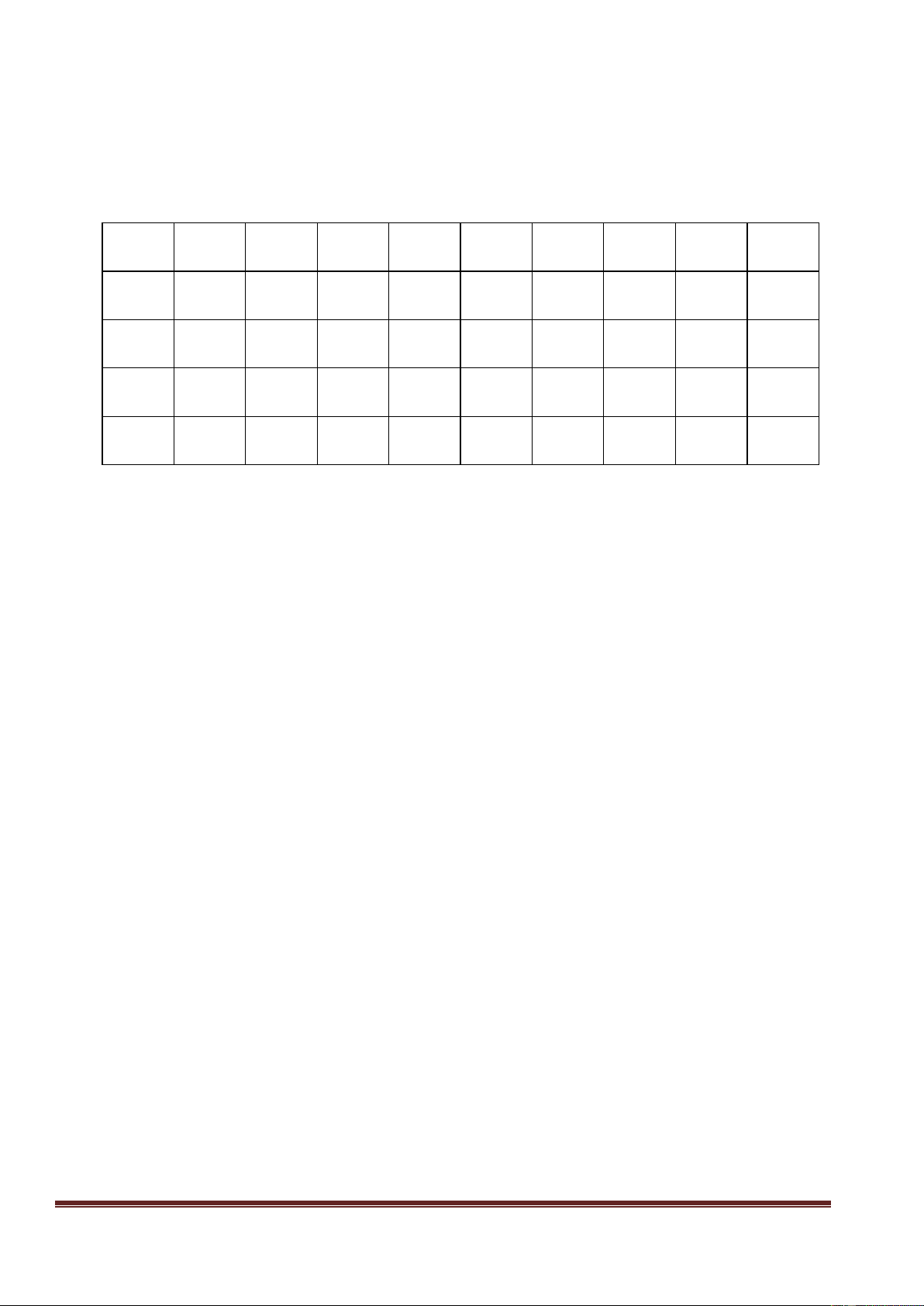
Page 188
B. they are not easily distinguished red and green
C. are the red and green not easily distinguished
D. are not easily distinguished red and green
-------THE END-------
ĐÁP ÁN
1-C
2-B
3-B
4-D
5-A
6-A
7-C
8-D
9-D
10-B
11-C
12-C
13-C
14-C
15-C
16-D
17-D
18-A
19-D
20-C
21-D
22-D
23-D
24-C
25-B
26-D
27-C
28-B
29-D
30-C
31-C
32-C
33-B
34-A
35-B
36-B
37-B
38-D
39-B
40-A
41-B
42-A
43-B
44-B
45-A
46-D
47-D
48-C
49-A
50-A
Question 1. C
Kiến thức: Hội thoại giao tiếp
Giải thích:
Mike: “ ”
HƯỚNG DẪN GIẢI CHI TIẾT
Phương: “Cảm ơn bạn, mình sẽ làm.”
A. Cảm ơn vì sự giúp đỡ của bạn.
B. Chúc bạn có một chuyến đi vui vẻ.
C. Gửi lời chúc sức khỏe của mình đến bố mẹ bạn nhé.
D. Bạn đã đạt giải nhất. Chúc mừng bạn.
Question 2. B
Kiến thức: Hội thoại giao tiếp
Giải thích:
Sylvia: “Bạn có phiền không nếu mình dùng từ điển của bạn?”
Trang: “Tất nhiên là không hề. .”
A. Mình có từ điển
B. Nó ở bên kia
C. Đừng làm thế
D. Xin lỗi mình không thể
Question 3. B

Page 189
Kiến thức: Từ vựng, từ trái nghĩa
Giải thích:
unattainable (adj): không thể đạt được
impossible (adj): không thể
realistic (adj): có thể đạt được
confused (adj): bối rối, lúng túng
unachievable (adj): không thể thực hiện được
=> unattainable >< realistic
Tạm dịch: Sau nhiều tháng làm việc mệt mỏi và bị thương ở vai và lưng, Susan nhận ra rằng giấc mơ bơi
ở eo biển Anh của mình là không thể đạt được.
Question 4. D
Kiến thức: Từ vựng, từ trái nghĩa
Giải thích:
unprecedented (adj): không có tiền lệ, chưa từng xảy ra
enormous (adj): to lớn, khổng lồ
outstanding (adj): nổi bật, đáng chú ý
phenomenal (adj): kỳ lạ, phi thường
commonplace (adj): bình thường
=> unprecedented >< commonplace
Tạm dịch: Huấn luyện viên trưởng Park Hang-Seo cùng với đội bóng đá của mình đã đạt được kết quả
chưa từng có từ trước đến nay.
Question 5. A
Kiến thức: Từ đồng nghĩa
Giải thích:
neutral (adj): trung lập
objective (adj): khách quan
positive (adj): tích cực
negative (adj): tiêu cực
middle (adj): ở giữa
=> neutral = objective
Tạm dịch: Tôi thấy khó mà giữ được vị thế trung lập trong khi anh ấy quan tâm đến vấn đề này.
Question 6. A
Kiến thức: Từ từ đồng nghĩa
Giải thích:
impediment (n): trở ngại
obstacle (n): trở ngại
assistance (n): hỗ trợ
impetus (n): sự thúc đẩy
encouragement (n): sự khuyến khích
=> impediment = obstacle
Tạm dịch: Quá nhiều thói mê tín dị đoan ở một quốc gia có thể là một trở ngại lớn cho sự phát triển kinh
tế của nó.
Question 7. C
Kiến thức: Từ vựng
Giải thích:

Page 190
society (n): xã hội

Page 191
company (n): công ty/ một nhóm người
community (n): cộng đồng
connection (n): sự kết nối
It is the centre of the student (7) community in all its variety.
Tạm dịch: Đây là trung tâm của cộng đồng sinh viên đa dạng.
Question 8. D
Kiến thức: Từ vựng
Giải thích:
block (n): khối
quantity (n): số lượng
pile (n): chồng, đống
a number of: một số
While it is basically a place for young people, there are a (8) number of family flats and children are
never far away.
Tạm dịch: Mặc dù về cơ bản nó là một nơi dành cho những người trẻ tuổi, có một số căn hộ gia đình và
trẻ em không muốn sống xa nhau.
Question 9. D
Kiến thức: Từ vựng
Giải thích:
change (n): sự thay đổi (việc một cái gì đó trở nên khác đi)
adjustment (n): sự điều chỉnh (sự thay đổi nhỏ để làm cho đúng)
exchange (n): sự trao đổi
alteration (n): sự thay đổi (làm cho cái gì đó khác đi)
One house has had special structural (9) alteration to make it suitable for students with disabilities.
Tạm dịch: Một ngôi nhà đã có những thay đổi cấu trúc đặc biệt để làm cho nó phù hợp với học sinh
khuyết tật.
Question 10. B
Kiến thức: Cụm động từ
Giải thích:
get round to: tìm thời gian để làm gì
drop in on: ghé thăm
face up to: đối mặt
go in for: tham gia một cuộc thi
It's the easiest way to meet people when you first arrive and there’s always somebody to (10) drop in on.
Tạm dịch: Đó là cách dễ nhất để gặp gỡ mọi người khi bạn mới đến và luôn có ai đó ghé thăm.
Question 11. C
Kiến thức: Từ vựng
Giải thích:
limp (v): đi khập khiễng
crawl (v): bò, trườn
wander (v): đi lang thang
march (v): bước đều
It’s a busy, lively place, but because the campus is in the middle of parkland, you can (11) wander off
and be alone if you want to.
Tạm dịch: Nó là một nơi bận rộn, sôi động, nhưng vì khuôn viên nằm giữa công viên, bạn có thể đi lang

Page 192
thang và ở một mình nếu muốn.

Page 193
Dịch bài đọc:
Ở TẠI TRƯỜNG ĐẠI HỌC CỦA CHÚNG TÔI
Khuôn viên trường đại học giống như một ngôi làng lớn, nơi hàng ngàn sinh viên sống, làm việc và thư
giãn được bao quanh bởi những cánh đồng xanh. Đây là trung tâm của cộng đồng sinh viên đa dạng. Mặc
dù cơ bản nó là một nơi dành cho những người trẻ tuổi, có một số căn hộ gia đình và trẻ em không muốn
sống xa nhau. Mọi người đến sống ở đây từ khắp nơi trên thế giới, vì vậy các thành viên của các nền văn
hóa và người nói ngôn ngữ khác nhau sống cạnh nhau. Một ngôi nhà đã có những thay đổi cấu trúc đặc
biệt để làm cho nó phù hợp với học sinh khuyết tật. Hầu hết sinh viên năm thứ nhất sống trong khuôn
viên trường. Đó là cách dễ nhất để gặp gỡ mọi người khi bạn mới đến và luôn có ai đó ghé thăm. Nó là
một nơi bận rộn, sôi động, nhưng vì khuôn viên nằm giữa công viên, bạn có thể đi lang thang và ở một
mình nếu muốn.
Question 12. C
Kiến thức: Mệnh đề nhượng bộ
Giải thích: Cấu trúc: No matter + how + adj + S + V: mặc dù …
Tạm dịch: Cho dù bạn có thể thông minh đến mức nào, bạn nên cẩn thận về những gì bạn sẽ làm.
Question 13. C
Kiến thức: Câu điều kiện hỗn hợp
Giải thích:
Dấu hiệu: now (bây giờ)
Ở đây phải dùng câu điều kiện hỗn hợp, diễn tả giả thiết trái ngược với quá khứ, nhưng kết quả thì trái
ngược với hiện tại.
Cấu trúc: If + S + had + V.p.p, S + would/ could + Vo
Mệnh đề kết quả nhấn mạnh tính tiếp diễn: S + could + be + V.ing
Tạm dịch: Nếu chị tôi để lại chìa khóa nhà, tôi đã có thể nấu bữa trưa ngay bây giờ.
Question 14. C
Kiến thức: Đọc hiểu
Giải thích:
Đoạn thứ hai chủ yếu nói về điều gì?
A. Sự di cư thực vật sau kỷ băng hà.
B. Ảnh hưởng của kỷ băng hà đối với thực vật.
C. Sự cần thiết phải phát triển một cách tiếp cận mới cho các vấn đề môi trường.
D. Cộng đồng thực vật sống ở các độ cao khác nhau.
Thông tin: Each individual organism moved at its own pace. The fossil record seems to be telling us that
we should be thinking about preserving species by giving them room to maneuver – to respond to
environmental changes.
Tạm dịch: Mỗi sinh vật riêng lẻ di chuyển theo tốc độ riêng của nó. Mẫu hóa thạch dường như đang nói
với chúng ta rằng chúng ta nên suy nghĩ về việc bảo tồn các loài bằng cách cho chúng cơ hội để vận động
- để thích ứng với những thay đổi môi trường.
Question 15. C
Kiến thức: Đọc hiểu, từ vựng
Giải thích:
radically (adv): triệt để, hoàn toàn
quickly (adv): nhanh
variably (adv): thay đổi
dramatically (adv): đột ngột và ở mức độ rất lớn

Page 194
demonstrably (adv): rõ ràng, minh bạch

Page 195
Thông tin: Mountaineers have noted that as they climb, for example, up to the 12,633-foot Humphreys
Peak in the San Francisco Peaks in Arizona, plant life changes radically.
Tạm dịch: Những người leo núi đã chú ý rằng khi họ leo núi, ví dụ, lên đến đỉnh Humphreys cao 12,633
feet ở Đỉnh San Francisco ở Arizona, đời sống thực vật thay đổi hoàn toàn.
Question 16. D
Kiến thức: Đọc hiểu
Giải thích:
Tác giả đã đề cập đến “xương rồng” và một “một lãnh nguyên núi cao” trong đoạn 1 để minh họa cho
.
A. thay đổi khí hậu
B. ảnh hưởng của kỷ băng hà
C. sự di cư của thực vật
D. quần xã thực vật
Thông tin: Starting among the cacti of the Sonoran Desert, one climbs into a pine forest at 7,000 feet and
a treeless alpine tundra at the summit. It may seem that plants at a given altitude are associated in what
can be called “communities” – groupings of interacting species.
Tạm dịch: Bắt đầu giữa những cây xương rồng của sa mạc Sonoran, một người leo lên một khu rừng
thông ở độ cao 7,000 feet và một lãnh nguyên núi cao vô tận ở đỉnh núi. Dường như các loài thực vật ở độ
cao nhất định có liên quan đến những gì có thể được gọi là “quần xã” - nhóm các loài tương tác.
Question 17. D
Kiến thức: Đọc hiểu
Giải thích:
Từ “which” ở câu cuối của đoạn 1 nhắc đến điều gì .
A. sự phát triển của hệ sinh thái
B. sự thay đổi đời sống thực vật
C. các lý thuyết hiện đại về hệ sinh thái
D. phản ứng của thực vật với biến đổi khí hậu
Thông tin: They build up a picture of how groups of plants have responded to climate changes and how
ecosystems develop. But are these associations, which are real in the present, permanent?
Tạm dịch: Họ phác họa nên một bức tranh về cách các nhóm thực vật đã ứng phó với biến đổi khí hậu và
cách các hệ sinh thái phát triển. Nhưng những mối quan hệ đang xảy ra trên thực tế này có kéo dài mãi
mãi?
Question 18. A
Kiến thức: Đọc hiểu
Giải thích:
successive = consecutive (adj): liên tục, kế tiếp
accumulative (adj): chất đống, chồng chất
extinct (adj): tuyệt chủng
following (adj): tiếp sau đó về thời gian
Thông tin: By drilling into the lake bottom it is possible to read the record of successive plant life around
the lake.
Tạm dịch: Bằng cách khoan vào đáy hồ, có thể đọc được hồ sơ về đời sống thực vật kế tiếp quanh hồ.
Question 19. D
Kiến thức: Đọc hiểu
Giải thích:

Page 196
Đoạn văn nói rằng bằng cách khoan vào đáy hồ, có thể tìm thấy hóa thạch liên tiếp của .

Page 197
A. đời sống thực vật
B. trầm tích
D. băng
D. phấn hoa
Thông tin: As the ice retreated and plants started to grow near a lake, they would release pollen. Some
would fall into the lake, sink to the bottom, and be incorporated into the sediment. By drilling into the
lake bottom it is possible to read the record of successive plant life around the lake.
Tạm dịch: Khi băng tan và thực vật bắt đầu mọc gần hồ, chúng sẽ tỏa ra phấn hoa. Một số sẽ rơi xuống
hồ, chìm xuống đáy và tạo thành trầm tích. Bằng cách khoan vào đáy hồ, người ta có thể đọc được sự
phát triển của đời sống thực vật kế tiếp quanh hồ.
Question 20. C
Kiến thức: Đọc hiểu
Giải thích:
Điều gì có thể được suy ra từ đoạn văn?
A. Các kiểu di cư của thực vật phụ thuộc vào sự thay đổi của khí hậu.
B. Các quần thể thực vật hiện nay tương tự như trong quá khứ.
C. Phương pháp bảo tồn hiện đại nên xem xét các mô hình di cư của thực vật.
D. Một kỷ băng hà khác có khả năng xảy ra vào một lúc nào đó.
Thông tin: Each individual organism moved at its own pace. The fossil record seems to be telling us that
we should be thinking about preserving species by giving them room to maneuver – to respond to
environmental changes.
Tạm dịch: Mỗi sinh vật riêng lẻ di chuyển theo tốc độ riêng của nó. Mẫu hóa thạch dường như đang nói
với chúng ta rằng chúng ta nên suy nghĩ về việc bảo tồn các loài bằng cách cho chúng cơ hội để vận động
- để thích ứng với những thay đổi môi trường.
Dịch bài đọc:
Những người leo núi đã chú ý rằng khi họ leo núi, ví dụ, lên đến đỉnh Humphreys cao 12,633 feet ở Đỉnh
San Francisco ở Arizona, đời sống thực vật thay đổi hoàn toàn. Bắt đầu giữa những cây xương rồng của
sa mạc Sonoran, một người leo lên một khu rừng thông ở độ cao 7,000 feet và một lãnh nguyên núi cao
vô tận ở đỉnh núi. Dường như các loài thực vật ở độ cao nhất định có liên quan đến những gì có thể được
gọi là “quần xã” - nhóm các loài tương tác. Ý tưởng là theo thời gian, các loài thực vật đòi hỏi điều kiện
khí hậu và đất đai đặc biệt đến sống ở cùng một nơi, và do đó thường được tìm thấy cùng nhau. Các nhà
khoa học nghiên cứu về lịch sử của đời sống thực vật được gọi là các nhà cổ sinh vật học (paleobotanists),
hay viết tắt là “paleobots”. Họ phác họa nên một bức tranh về cách các nhóm thực vật đã ứng phó với
biến đổi khí hậu và cách các hệ sinh thái phát triển. Nhưng những mối quan hệ đang xảy ra trên thực tế
này có kéo dài mãi mãi?
Một thí nghiệm tự nhiên tuyệt vời đã diễn ra trên hành tinh này từ giữa 25,000 đến 10,000 năm trước, khi
những thay đổi nhỏ trong quỹ đạo và trục quay của Trái đất khiến những tảng băng lớn lan ra từ các cực.
Những dòng sông băng bao phủ phần lớn Bắc Mỹ và châu Âu tới độ sâu lên đến hai dặm, và sau đó, khi
khí hậu ấm lên, chúng tan ra. Trong suốt quá trình tan chảy, chúng đã bỏ lại vùng đất mới chưa được
khám phá để sinh vật sống, và khi những sinh vật đó chuyển đến chúng đã lập một kỷ lục chúng ta có thể
đọc ngay bây giờ. Khi băng tan và thực vật bắt đầu mọc gần hồ, chúng sẽ tỏa ra phấn hoa. Một số sẽ rơi
xuống hồ, chìm xuống đáy và tạo thành trầm tích. Bằng cách khoan vào đáy hồ, người ta có thể đọc được
sự phát triển của đời sống thực vật kế tiếp quanh hồ. Mẫu hóa thạch có vẻ rõ ràng; có rất ít hoặc không có
bằng chứng cho thấy toàn bộ các nhóm thực vật di chuyển về phía bắc cùng nhau. Những thứ sống cùng
nhau trong quá khứ hiện đang không sống cùng nhau và những thứ sống cùng nhau bây giờ đã không

Page 198
sống cùng nhau trong quá khứ. Mỗi sinh vật riêng lẻ di chuyển theo tốc độ riêng của nó. Mẫu hóa thạch

Page 199
dường như đang nói với chúng ta rằng chúng ta nên suy nghĩ về việc bảo tồn các loài bằng cách cho
chúng cơ hội để vận động - để thích ứng với những thay đổi môi trường.
Tạm dịch: Nếu không có hai sai lầm nhỏ, tôi đã đạt điểm tối đa ở bài kiểm tra này.
A. Nếu tôi mắc hai lỗi nhỏ, tôi đã đạt điểm tối đa ở bài kiểm tra này.
C. Nếu những sai lầm đó không nhỏ, tôi đã đạt điểm tối đa ở bài kiểm tra này.
D. Tôi đã đạt điểm tối đa ở bài kiểm tra này nếu không có hai lỗi nhỏ này.
Câu A, C sai về nghĩa.
Question 23. D
Kiến thức: Mệnh đề nhượng bộ
Giải thích: Although + S + V: Mặc dù
Tạm dịch: Nhiều người sợ cá mập, nhưng chúng hiếm khi tấn công con người.
A. Cá mập hiếm khi tấn công người vì nhiều người sợ chúng.
B. Hiếm khi bị cá mập tấn công, do đó, nhiều người sợ chúng.
C. Nhiều người sợ cá mập vì chúng nguy hiểm.
D. Mặc dù cá mập hiếm khi tấn công người, nhưng nhiều người sợ chúng.
Câu A, B, C sai về nghĩa.
Question 24. C
Kiến thức: Từ vựng
Giải thích:
another (đại từ): cái khác (chưa xác định)
the other (đại từ): cái còn lại (đã xác định)
Ngữ cảnh ở đây đang nhắc đến đôi mắt (eye) => phải dùng “the other” (bên mắt còn lại).
Sửa: another => the other
Tạm dịch: Mặc dù nghệ sĩ Tatun bị mù hoàn toàn ở một mắt và chỉ có thể nhìn mờ mờ ở mắt còn lại, ông
ấy đã trở thành một nhạc sĩ nhạc jazz nổi tiếng quốc tế.
Question 25. B
Kiến thức: Cấu trúc song song
Giải thích:
Ở đây đang liệt kê ra các loại “abilities” => các thành phần được nối với nhau bằng dấu phẩy, từ nối
“and” phải có cấu trúc như nhau.

Page 200
=> Các động từ “work, follow, think” phải cùng được dùng ở dạng “to V”

Page 201
Sửa: thinking => to think
Tạm dịch: Khả năng làm việc chăm chỉ, làm theo chỉ dẫn và suy nghĩ độc lập là một số tiêu chí để thành
công ở nơi làm việc.
Question 26. D
Kiến thức: Mệnh đề quan hệ
Giải thích:
Ở đây mệnh đề chính trong câu là “Photographs from a satellite are frequently used to generate the
information”.
Để giải thích cho “information” cần sử dụng đến mệnh đề quan hệ.
Cần một đại từ quan hệ thay thế cho vật “information”, đóng vai trò chủ ngữ trong mệnh đề quan hệ =>
dùng “which”. Ngoài ra, có thể rút gọn bằng cách lược bỏ mệnh đề quan hệ và động từ “tobe” dùng cụm
V.ing nếu chủ động, V.p.p nếu bị động.
Sửa: is needed => which is needed/ needed
Tạm dịch: Hình ảnh từ một vệ tinh thường được sử dụng để tạo ra thông tin cần thiết để vẽ bản đồ.
Question 27. C
Kiến thức: Đọc hiểu
Giải thích:
Đoạn văn chủ yếu liên quan đến chủ đề nào?
A. Sự phát triển của kiến trúc hiện đại ở Mỹ.
B. Những đóng góp của trường phái “Prairie” đối với kiến trúc hiện đại.
C. Cuộc đời và thành tựu của một kiến trúc sư nổi tiếng.
D. Ảnh hưởng của phong cách “kiến trúc hữu cơ” ở Mỹ.
Thông tin: Considered the most influential architect of his time, Frank Lloyd Wright (1867-1959) was
born in the small rural community of Richland Center, Wisconsin. (Câu đầu tiên)
Wright can be considered an essentially idiosyncratic architect whose influence was immense but whose
pupils were few. (Câu cuối cùng)
Tạm dịch: Được coi là kiến trúc sư có ảnh hưởng nhất trong thời đại của mình, Frank Lloyd Wright
(1867- 1959) sinh ra tại một vùng nông thôn nhỏ ở Trung tâm Richland, Wisconsin.
Wright có thể được coi là một kiến trúc sư cực kỳ khác biệt, có tầm ảnh hưởng lớn nhưng không có nhiều
học sinh.
Question 28. B
Kiến thức: Đọc hiểu
Giải thích:
Frank Lioyd Wright đầu tiên làm việc như một người thợ thiết kế .
A. bởi vì ông ấy đã sống ở trên cửa hàng của mình và thuê các người thợ thiết kế trong hai mươi năm.
B. để học ngôn ngữ kiến trúc
C. bởi vì đó là những gì ông ấy đã học tại Đại học Wisconsin
D. bởi vì đó là công việc của nhân viên mới trong các công ty kiến trúc
Thông tin: At the age of 20 he then went to work as a draftsman in Chicago in order to learn the
traditional, classical language of architecture.
Tạm dịch: Năm 20 tuổi, ông áy đi làm thợ thiết kế ở Chicago để học ngôn ngữ kiến trúc cổ điển truyền
thống.
Question 29. D
Kiến thức: Đọc hiểu
Giải thích:

Page 202
some = approximately (adv): xấp xỉ (dùng trước các con số)

Page 203
exactly (adv): chính xác over (adv): hơn
nearly (adv): gần around = approximately (adv): xấp xỉ
=> some = around
Thông tin: Here, in an idyllic American suburb, with giant oaks, sprawling lawns, and no fences, Wright
built some sixty rambling homes by the year 1900.
Tạm dịch: Ở đây, trong một vùng ngoại ô bình dị của Mỹ, với những cây sồi khổng lồ, những bãi cỏ trải
dài và không có hàng rào, Wright đã xây dựng khoảng sáu mươi ngôi nhà rầm rộ vào năm 1900.
Question 30. C
Kiến thức: Đọc hiểu
Giải thích:
Theo đoạn văn, một vùng ngoại ô bình dị của Mỹ là .
A. dựa trên các hình dáng mượn từ thiên nhiên
B. hòa quyện vào cảnh quan
C. những cây sồi khổng lồ, những bãi cỏ trải dài và không có hàng rào
D. những ngôi nhà có mái thấp và những đường kéo dài
Thông tin: Here, in an idyllic American suburb, with giant oaks, sprawling lawns, and no fences, Wright
built some sixty rambling homes by the year 1900.
Tạm dịch: Ở đây, trong một vùng ngoại ô bình dị của Mỹ, với những cây sồi khổng lồ, những bãi cỏ trải
dài và không có hàng rào, Wright đã xây dựng khoảng sáu mươi ngôi nhà rầm rộ vào năm 1900.
Question 31. C
Kiến thức: Đọc hiểu
Giải thích:
Từ “bản thân nó” ở đoạn 3 nói đến .
A. hội thảo xã hội
B. Anh ấy
C. Học bổng Taliesin
D. các trường đại học lớn
Thông tin: He gave countless lectures at major universities, and started his Taliesin Fellowship – a
visionary social workshop in itself.
Tạm dịch: Ông đã giảng dạy vô số bài giảng tại các trường đại học lớn, và thành lâp Học bổng Taliesin –
bản chất là một hội thảo xã hội có tầm nhìn.
Question 32. C
Kiến thức: Đọc hiểu
Giải thích:
idiosyncratic (adj): có phong cách riêng, khác biệt
idiotic (adj): ngu ngốc, khờ dại idealistic (adj): duy tâm
individualistic (adj): có dấu ấn cá nhân, khác biệt independent (adj): độc lập
=> individualistic = idiosyncratic
Thông tin: Wright can be considered an essentially idiosyncratic architect whose influence was
immense but whose pupils were few.
Tạm dịch: Wright có thể được coi là một kiến trúc sư cực kỳ khác biệt, có tầm ảnh hưởng lớn nhưng
không có nhiều học sinh.
Question 33. B
Kiến thức: Đọc hiểu
Giải thích:

Page 204
Điều nào sau đây có thể được suy ra từ đoạn văn?

Page 205
A. Học bổng Taliesin là một khoản tiền.
B. Nhiều ý tưởng kiến trúc của Wright không được tiếp tục bởi những người khác.
C. Wright đã dùng tiền của vợ mình để thành lập văn phòng kiến trúc của riêng mình trong một khu phố
độc quyền.
D. Một số tòa nhà đáng chú ý nhất của Wright đã bị phá hủy vì chúng không phổ biến.
Thông tin: Wright can be considered an essentially idiosyncratic architect whose influence was
immense but whose pupils were few.
Tạm dịch: Wright có thể được coi là một kiến trúc sư cực kỳ khác biệt, có tầm ảnh hưởng lớn nhưng
không có nhiều học sinh.
Wright không có nhiều học sinh => nhiều ý tưởng kiến trúc của ông không được tiếp tục bởi những người
khác.
Question 34. A
Kiến thức: Đọc hiểu
Giải thích:
Tất cả những điều sau đây về Frank Lioyd Wright đều đúng NGOẠI TRỪ .
A. ông trở thành người tiên phong của một phong cách được gọi là kiến trúc hữu cơ
B. ông qua đời ở tuổi 92
C. ông bắt đầu học đại học năm 15 tuổi
D. một số tòa nhà ngoạn mục nhất của ông không ở Mỹ
Thông tin: He became the leader of a style known as the “Prairie” school - houses with low-pitched roofs
and extended lines that blended into the landscape and typified his style of “organic architecture”.
Tạm dịch: Ông trở thành người tiên phong của một phong cách được gọi là trường phái “Prairie” - những
ngôi nhà có mái thấp và những đường kéo dài hòa quyện vào cảnh quan và tiêu biểu cho phong cách kiến
trúc hữu cơ của ông ấy.
Dịch bài đọc:
Được coi là kiến trúc sư có ảnh hưởng nhất trong thời đại của mình, Frank Lloyd Wright (1867- 1959)
sinh ra tại một vùng nông thôn nhỏ ở Trung tâm Richland, Wisconsin. Ông vào Đại học Wisconsin năm
15 tuổi với tư cách là một sinh viên đặc biệt, học ngành kỹ sư vì trường không có ngành học về kiến trúc.
Năm 20 tuổi, ông áy đi làm thợ thiết kế ở Chicago để học ngôn ngữ kiến trúc cổ điển truyền thống. Sau
khi kết hôn với một gia đình kinh doanh giàu có ở tuổi 21, Wright đã xây dựng nhà tại một khu phố độc
quyền ở Chicago, và sau vài năm làm việc cho một số công ty kiến trúc, ông đã thành lập văn phòng kiến
trúc của riêng mình.
Trong hai mươi năm, ông đã nuôi dưỡng một gia đình gồm sáu đứa trẻ ở tầng trên, và điều hành một công
ty kiến trúc phát đạt với mười hai người thợ thiết kế ở tầng dưới. Ở đây, trong một vùng ngoại ô bình dị
của Mỹ, với những cây sồi khổng lồ, những bãi cỏ trải dài và không có hàng rào, Wright đã xây dựng
khoảng sáu mươi ngôi nhà rầm rộ vào năm 1900. Ông trở thành người tiên phong của một phong cách
được gọi là trường phái “Prairie” - những ngôi nhà có mái thấp và những đường kéo dài hòa quyện vào
cảnh quan và tiêu biểu cho phong cách kiến trúc hữu cơ của ông ấy.
Ở tuổi bốn mươi mốt, vào năm 1908, Wright đã đạt được thành công phi thường về mặt xã hội và nghề
nghiệp. Ông đã giảng dạy vô số bài giảng tại các trường đại học lớn, và thành lâp cộng đồng Taliesin –
bản chất là một hội thảo xã hội có tầm nhìn. Năm 1938, ông xuất hiện trên trang bìa của tạp chí Time, và
sau đó, trên một con tem hai xu. Các tòa nhà ngoạn mục nhất trong thời kỳ trưởng thành của ông dựa trên
các hình dáng mượn từ thiên nhiên, và các ý định rõ ràng là lãng mạn, thơ mộng và mang đậm dấu ấn cá
nhân. Ví dụ về các tòa nhà này là Khách sạn Hoàng gia ở Tokyo (1915-22: bị phá hủy năm 1968) và Bảo
tàng Guggenheim ở thành phố New York (hoàn thành năm 1959). Ông tiếp tục làm việc cho đến khi qua

Page 206
đời vào năm 1959, ở tuổi 92, mặc dù trong những năm cuối đời, ông dành nhiều thời gian cho các cuộc

Page 207
phỏng vấn và trở thành người nổi tiếng, như ông đã làm trong việc thiết kế các tòa nhà. Wright có thể
được coi là một kiến trúc sư cực kỳ khác biệt, có tầm ảnh hưởng lớn nhưng không có nhiều học sinh.
Question 35. B
Kiến thức: Phát âm “s”
Giải thích:
Quy tắc phát âm “s,es”:
- Phát âm là /s/ khi từ có tận cùng bằng các phụ âm vô thanh: /θ/, /p/, /k/, /f/, /t/.
- Phát âm là /iz/ khi từ có tận cùng là các âm: /s/, /z/, /ʃ/, /tʃ/, /ʒ/, /dʒ/. Thường có tận cùng là các chữ cái
sh, ce, s, ss, z, ge, ch, x…
- Phát âm là /z/ khi các từ có tận cùng là nguyên âm và các phụ âm hữu thanh còn lại.
informs /ɪnˈfɔːmz/ mistakes /mɪˈsteɪks/
combines /kəmˈbaɪnz/ complains /kəmˈpleɪnz/
Phần được gạch chân ở câu B phát âm là /s/, còn lại phát âm là /z/.
Question 36. B
Kiến thức: Phát âm “ch”
Giải thích:
toothache /ˈtuːθeɪk/ church /tʃɜːtʃ/
chemistry /ˈkemɪstri/ stomach /ˈstʌmək/
Phần được gạch chân ở câu B phát âm là /tʃ/, còn lại phát âm là /k/.
Question 37. B
Kiến thức: Trọng âm từ có 3,4,5 âm tiết
Giải thích:
controller /kənˈtrəʊlə(r)/ popularity /ˌpɒpjuˈlærəti/
embarrassing /ɪmˈbærəsɪŋ/ convenient /kənˈviːniənt/
Trọng âm của câu B rơi vào âm thứ ba, còn lại rơi vào âm thứ hai.
Question 38. D
Kiến thức: Trọng âm từ có 3 âm tiết
Giải thích:
exceeding /ɪkˈsiːd/ existence /ɪɡˈzɪstəns/
example /ɪɡˈzɑːmpl/ carefully /ˈkeəfəli/
Trọng âm của câu D rơi vào âm thứ nhất, còn lại rơi vào âm thứ hai.
Question 39. B
Kiến thức: Đảo ngữ “Only when”
Giải thích: Cấu trúc: Only when + clause + trợ động từ + S + V…
Tạm dịch: Chỉ khi bạn trở thành cha mẹ, bạn mới hiểu trách nhiệm thực sự là gì.
Question 40. A
Kiến thức: Thì hiện tại hoàn thành
Giải thích:
Hành động đã hoàn thành cho tới thời điểm hiện tại mà không đề cập tới nó xảy ra khi nào. => Dùng thì
hiện tại hoàn thành.
Cấu trúc: S + have/has + V.p.p
Bị động: S + have/has + been + V.p.p
Tạm dịch: Chúng tôi rất tiếc phải thông báo cho bạn rằng hội thảo của cô Markowitz về việc diễn thuyết
trước công chúng đã bị hoãn lại cho đến tuần sau.
Question 41. B
Kiến thức: Câu hỏi đuôi

Page 208
Giải thích:
Câu giới thiệu có hai mệnh đề:
- Trường hợp 1: Chủ ngữ là “I”: I + think/believe… + S + V => Lấy mệnh đề thứ hai làm câu hỏi đuôi
- Trường hợp 2: Chủ ngữ không phải là “I” => dùng mệnh đề đầu tiên làm câu hỏi đuôi
Ở đây, chủ ngữ của câu giới thiệu là “I” => dùng mệnh đề “students who volunteer in high school will
continue to volunteer throughout their lives” làm câu hỏi đuôi.
- Đại từ: danh từ “students” => dùng “they”
- Câu giới thiệu phủ định “don’t think” => câu hỏi đuôi khẳng định => dùng “won’t”
Tạm dịch: Tôi không nghĩ rằng học sinh tình nguyện ở trường trung học sẽ tiếp tục làm tình nguyện
trong suốt cuộc đời của họ, phải không?
Question 42. A
Kiến thức: Từ vựng, từ loại
Giải thích:
Sau động từ “be” cần một tính từ.
obedient (adj): ngoan ngoãn
obedience (n): sự vâng lơ i
disobedient (adj): không vâng lời, ngỗ nghịch
obey (v): tuân theo, vâng lời
Tạm dịch: Trẻ em được dặn là phải ngoan ngoãn trong cả tuần và được hứa sẽ được thưởng vào cuối
tuần.
Question 43. B
Kiến thức: Rút gọn mệnh đề
Giải thích:
Khi hai mệnh đề cùng chủ ngữ, có thể rút gọn bớt một chủ ngữ và dùng cụm V.ing nếu chủ động, cụm
V.p.p nếu bị động.
Ngữ cảnh ở đây là “(một tin) được sử dụng một cách tiết kiệm” => dùng V.p.p
Sau động từ “used” cần một trạng từ.
economical (adj): tiết kiệm
economically (adv): tiết kiệm
Tạm dịch: Được sử dụng một cách tiết kiệm, một tin sẽ kéo dài ít nhất sáu tuần.
Question 44. B
Kiến thức: Mệnh đề quan hệ
Giải thích:
Ở đây mệnh đề chính là “(The audience) enjoyed the performance”. Để giải thích thêm cho “The
audience” cần dùng đến mệnh đề quan hệ.
Câu B dùng đại từ “whom” thay thế cho “The audience”, đóng vai trò tân ngữ đứng sau giới từ “of” =>
đúng ngữ pháp.
Các câu A, C, D sai về ngữ pháp
Tạm dịch: Khán giả, hầu hết là sinh viên, rất thích buổi biểu diễn.
Question 45. A
Kiến thức: Câu giả định dùng với danh từ
Giải thích:
Với một số danh từ như “recommendation, request,…” ta có thể dùng công thức giả định như sau:
It + be + noun + that + S + Vo + …
Tạm dịch: Ban tổ chức yêu cầu mọi người đều đến đây đúng giờ.

Page 209
Question 46. D

Page 210
Kiến thức: Từ vựng
Giải thích:
Tính từ có đuôi “ing” dùng để miêu tả đặc điểm, bản chất của người/ vật, còn tính từ đuôi “ed” dùng để
miêu tả cảm xúc của con người bị sự vật tác động lên.
interested (in something) (adj): quan tâm, thích thú
interesting (adj): hấp dẫn, thú vị
bored (adj): chán nản
boring (adj): nhàm chán, gây chán nản
Tạm dịch: Bữa tiệc không thú vị cho lắm, vì vậy hầu như tất cả bạn bè của anh ấy đều rời đi sớm.
Question 47. D
Kiến thức: Từ vựng
Giải thích: spend something on something/on doing something: dành tiền, thời gian,… để làm gì
Tạm dịch: Những người chờ chuyến bay của họ bị trì hoãn đã phải ngủ qua đêm trên sàn nhà lạnh lẽo.

Page 211
SỞ GD & ĐT VĨNH PHÚC ĐỀ THI THỬ THPT QUỐC GIA LẦN 3 NĂM 2019
THPT CHUYÊN Môn thi: Tiếng Anh
Thời gian làm bài: 60 phút (không kể thời gian phát đề)
Mã đề 641
Họ, tên thí sinh: .............................................. Số báo danh: ..............................................
Mark the letter A, B, C or D on your answer sheet to indicate the word that differs from the rest in the
pronunciation of the underlined part in each of the following questions.
Question 1: A. punctual B. rubbish C. frustrate D. furious
Question 2: A. rough B. laugh C. cough D. plough
Mark the letter A, B, C or D on your answer sheet to indicate the word that differs from the other three
in the position of the primary stress in each of the following questions.
Question 3: A. mailbox
B. manner
C. mature
D. summer
Question 4: A. generous
B. genuine
C. kangaroo
D. fortunate
Mark the letter A, B, C or D on your answer sheet to indicate the word(s) CLOSEST in meaning to
thee underlined part(s) in each of the following questions.
Question 5: I’ll not stand for your bad attitude any longer.
A. care B. like C. tolerate D. mean
Question 6: “You’ve eaten all the chocolate cake?” – “What of it?”
A. What does it matter? B. What’s happened to it?
C. Where is the rest? D. You mean I’ve eaten all of it?
Mark the letter A, B, C or D on your answer sheet to indicate the word(s) OPPOSITE in meaning to
the underlined part(s) in each of the following questions.
Question 7: On the spur of the moment, she decided to enter the race that she had come to watch.
A. Without previous thought B. For only a short time
C. After careful thought D. At the earliest possible moment
Question 8: Most of the guests at the dinner party chose to dress elegantly, but one man wore jeans and a
T-shirt; he was later identified as a high school teacher.
A. gracefully B. decently C. gaudily D. unsophisticatedly
Mark the letter A, B, C or D on your answer sheet to show the underlined part that needs correction.
Question 9: Without speaking other word, I stared at the ridges of sand in the moonlight.
A. stared at B. in C. without D. other
Question 10: Not until the late Middle Ages glass became a major construction material.
A. major B. the late C. Not D. glass became
Question 11: The best defense against tsunamis are early warning that allows people to seek higher
grounD.
A. ground B. against C. are D. seek
Mark the letter A, B, C or D on your answer sheet to indicate the correct answer to each of the
following questions.
Question 12: We were lucky to be able to finish the project ahead _ schedule.
A. by B. before C. of D. for
Question 13: I don’t feel like buying a in a poke; we’d better check the content.
A. ox B. pig C. buffalo D. cattle
Question 14: I don’t know what it to be as popular with girls as my brother is.
A. uses B. takes C. demands D. expects

Page 212
Question 15: I caught of a lion lying under the tree, and my heart jumpeD.
A. look B. sight C. scene D. view
Question 16: I was most of his efforts to help me during the crisis.
A. appreciative B. appreciable C. appreciation D. appreciate
Question 17: The phone constantly since Jack won the first prize this morning.
A. had been ringing B. has been ringing C. had rung D. rang
Question 18: My neighbour is
film.
photographer; Let’s ask him for advice about color
A. a – the B. the – an C. a – Ø D. the – the
Question 19: TV advertising in the late afternoon tends to young children.
A. aim B. point C. focus D. target
Question 20: Compressed air the power to drive pneumatic tools.
A. providing B. to provide C. which provides D. provides
Question 21: I asked Angela to run the office while I’m gone I know I can depend on her.
A. since B. unless C. although D. therefore
Question 22: Why don’t you just say you _ calling him a fool and make things up?
A. pity B. mercy C. sorry D. regret
Question 23: Most folk songs are ballads have simple words and tell simple stories.
A. what B. that C. although D. when
Question 24: Most of the in this workshop do not work very seriously or productively.
A. eager beavers B. old hand C. rank and file D. tooth and nail
Question 25: Amber is a hard, yellowish brown from the resin of pine-trees that lived millions
of years ago.
A. substance formed B. forming a substance
C. substance has formed D. to form a substance
Mark the letter A, B, C or D on your answer sheet to indicate the sentence that is closest in meaning to
each of the following questions.
Question 26: Arguing with the boss has considerably reduced his chances of promotion.
A. His promotion was certain until he had a dispute with the boss.
B. He would definitely have been promoted by now if had hadn’t quarreled with the boss.
C. He argued with the boss about why he wasn’t considered for promotion.
D. The likelihood of his being promoted has significantly decreased because of his argument with the
boss.
Question 27: Astronomy greatly interests him.
A. He finds astronomy very interested.
B. He is very interesting in astronomy.
C. He takes a keen interest in astronomy.
D. Astronomy is the subject he enjoys the most.
Question 28: She reminded her daughter of the table manners.
A. She wanted her daughter to remember all meal time.
B. She wanted her daughter to be more polite while eating.
C. She wanted her daughter to leave the dinner table.
D. She wanted her daughter to eat a little more slowly.
Mark the letter A, B, C or D on your answer sheet to indicate the sentence that best combines the pair
of sentences given in each of the following questions.

Page 213
Question 29: His academic record at high school was poor. He failed to apply to that prestigious
university.
A. His academic record at high school was poor as a result of his failure to apply to that prestigious
university.
B. Failing to apply to that prestigious university, his academic record at high was poor.
C. His academic record at high school was poor because he didn’t apply to that prestigious
university.
D. His academic record at high school was poor; as a result, he failed to apply to that prestigious
university.
Question 30: They are my two sister. They aren’t teachers like me.
A. They are my two sisters, neither of whom are teachers like me.
B. They are my two sister, who neither are teachers like me.
C. Unlike me, neither of my two sisters are not teachers.
D. They are my two sisters, both of those are teachers like me.
Mark the letter A, B, C or D on your answer sheet to indicate the most suitable response to each of the
following exchanges.
Question 31: Kathy and Kim are friends. They have just finished lunch in a restaurant.
Kathy: “The food is great. I’ll get the bill.”
Jim: “ ”
A. Yes, speak to you soon. B. Don’t mention it.
C. It’s nothing. D. No, this is on me.
Question 32: Laura: “Remember to phone me when you arrive at the airport.”
Annie: “ .”
A. I don’t B. I do C. I will D. I remember
Read the following passage and mark the letter A, B, C or D on your answer sheet to indicate the
correct word for each of the numbered blanks.
THE LIFE OF COUNTRY VET
Don Strange, who works as a vet in northern England, leads a busy life. As well as having to treat
pets which are unwell, he often visits farms where problems of (33) kinds await him. He has lost
(34) of the number of times he has been called out at midnight to give advice to a farmer with
sick sheep or cows.
Recently, a television company chose Don as the subject of a documentary program it was making about
the life of a country vet. The program showed the difficult situations Don faces every day such as helping
a cow to give birth or winning the trust of an aggressive dog (35) _ needs an injection. Not all of
Don’s patients are domestic animals, (36) , and in the program people saw him helping an owl
which had a damaged wing. It also showed Don holding a meeting with villagers concerned about the
damage a new road might do to their (37) environment.
Question 33: A. various
B. variety
C. variation
D. varied
Question 34: A. count
B. score
C. memory
D. patience
Question 35: A. whose
B. which
C. of which
D. who
Question 36: A. yet
B. however
C. although
D. therefore
Question 37: A. nearby
B. area
C. local
D. close
Read the following passage and mart the letter A, B, C or D on your answer sheet to indicate the
correct answer to each of the questions.

Page 214
The time when human crossed the Arctic land bridge from Siberia to Alaska seems remote to us
today, but actually represents a late stage in the prehistory of humans, an era when polished stone
implements and bows and arrows were already being used and dogs had already been domesticated.
When these early migrants arrived in North America, they found the woods and plains dominated by
three types of American mammoths. These elephants were distinguished from today’s elephants mainly
by their thick, shaggy coats and their huge, upward-curving tusks. They had arrived on the continent
hundreds of thousands of years before their followers. The woolly mammoth in the North, the Columbian
mammoth in middle North America, and the imperial mammoth of the South, together with their distant
cousins the mastodons, dominated the land. Here, as in the Old World, there is evidence that humans
hunted these elephants, as shown by numerous spear points found with mammoth remains.
Then, at the end of the Ice Age, when the last glaciers had retreated, there was a relatively sudden and
widespread extinction of elephants. In the New World, both mammoths and mastodons disappeared. In
the Old World, only Indian and African elephants survived.
Why did the huge, seemingly successful mammoths disappear? Were humans connected with their
extinction? Perhaps, but at that time, although they were cunning hunters, humans were still widely
settled and not very numerous. It is difficult to see how they could have prevailed over the mammoth to
such an extent.
Question 38: With which of the following is the passage primarily concerned?
A. Techniques used to hunt mammoths
B. The relationship between man and mammoth in the New World
C. The prehistory of humans
D. Migration from Siberia to Alaska
Question 45: Which of the following types of elephants does the author discuss in the most detail in the
passage?
A. The mammoth B. The African elephant
C. The mastodon D. The Indian elephant
Read the following passage and mart the letter A, B, C or D on your answer sheet to indicate the
correct answer to each of the questions.
What is meant by the term economic resources? In general, these are all the natural, man-made, and
human resources that go into the production of goods and services. This obviously covers a lot of ground:

Page 215
factories and farms, tools and machines, transportation and communication facilities, all types of natural

Page 216
resources, and labor. Economic resources can be broken down into two general categories: proper
resources-land and capital- and human resources- labor and entrepreneurial skills.
What do economists mean by land? Much more than the non-economist. Land refers to all
natural resources that are usable in the production process: arable land, forests, mineral and oil
deposits, and so on. What about capital? Capital goods are all the man-made aids to producing,
storing, transporting, and distributing goods and services. Capital goods differ from consumer goods
in that the latter satisfy wants directly, while the former do so indirectly by facilitating the
production of consumer goods. It should be noted that capital as defined here does not refer to
money. Money, as such, produces nothing.
The term labor refers to the physical and mental talents of humans used to produce goods or
services (with the exception of a certain set of human talents, entrepreneurial skills, which will
be considered separately because of their special significance). Thus the services of a factory
worker or an office worker, a ballet dancer or an astronaut all fall under the general heading of
labor.
Question 46: What is the author's main purpose in writing this passage?
A. To explain the concept of labor.
B. To criticize certain uses of capital.
C. To contrast capital goods and consumer goods.
D. To define economic resources.
Question 47: The phrase “the latter” refers to .
A. non-economists B. consumer goods C. capital goods D. economist
Question 48: When non-economists use the term "land", its definition .
A. is much more restrictive than when economists use it
B. is much more general than when economists use it
C. includes all types of natural resources
D. changes from place to place
Question 49: Which of the following could be considered a capital good as defined in the passage?
A. A railroad B. A coal deposit C. Human skills D. Money
Question 50: The word “arable” is closer in meaning to .
A. dry B. open C. developed D. fertile
------- THE END -------

Page 217
ĐÁP ÁN
1-D
2-D
3-C
4-B
5-C
6-A
7-C
8-C
9-D
10-D
11-C
12-C
13-B
14-B
15-B
16-A
17-B
18-C
19-D
20-D
21-A
22-D
23-B
24-C
25-A
26-D
27-C
28-B
29-D
30-A
31-D
32-C
33-A
34-A
35-B
36-B
37-C
38-B
39-A
40-B
41-D
42-A
43-A
44-A
45-A
46-D
47-B
48-A
49-A
50-D
Question 1. D
Kiến thức: Phát âm “u”
Giải thích:
HƯỚNG DẪN GIẢI CHI TIẾT
punctual /ˈpʌŋktʃuəl/ rubbish /ˈrʌbɪʃ/
frustrate /frʌˈstreɪt/ furious /ˈfjʊəriəs/
Phần được gạch chân ở câu D phát âm là /jʊə/, còn lại phát âm là /ʌ/.
Question 2. D
Kiến thức: Phát âm “gh”
Giải thích:
rough /rʌf/ laugh /lɑːf/
cough /kɒf/ plough /plaʊ/
Phần được gạch chân ở câu D là âm câm, còn lại phát âm là /f/.
Question 3. C
Kiến thức: Trọng âm của từ có hai âm tiết
Giải thích:
mailbox /ˈmeɪlbɒks/ manner /ˈmænə(r)/
mature /məˈtʃʊə(r)/ summer /ˈsʌmə(r)/
Trọng âm của câu C rơi vào âm thứ hai, còn lại rơi vào âm thứ nhất.
Question 4. C
Kiến thức: Trọng âm của từ có ba âm tiết
Giải thích:
generous /ˈdʒenərəs/ genuine /ˈdʒenjuɪn/
kangaroo /ˌkæŋɡəˈruː/ fortunate /ˈfɔːtʃənət/
Trọng âm của câu C rơi vào âm thứ ba, còn lại rơi vào âm thứ nhất.

Page 218
Question 5. C
Kiến thức: Từ vựng, từ đồng nghĩa
Giải thích:
stand for: chấp nhận
care (v): quan tâm like (v): thích
tolerate (v): khoan dung, chấp nhận, chịu đựng mean (v): nghĩa là, có nghĩa là
=> stand for = tolerate
Tạm dịch: Tôi sẽ không chịu đựng thái độ tồi tệ của bạn nữa.
Question 6. A
Kiến thức: Từ vựng, từ đồng nghĩa
Giải thích:
What of it?: được dùng để nói một cách thô lỗ rằng bạn không ý điều gì đó là quan trọng
A. Có vấn đề gì sao?
B. Điều gì đã xảy ra với nó?
C. Phần còn lại ở đâu?
D. Ý bạn là mình ăn tất cả?
=> What of it? = What does it matter?
Tạm dịch: “Bạn đã ăn hết bánh sô cô la rồi à?” – “Có vấn đề gì sao?”
Question 7. C
Kiến thức: Từ vựng, từ trái nghĩa
Giải thích:
on the spur of the moment = suddenly: đột nhiên, không lên kế hoạch trước đó
A. Không suy nghĩ gì trước đó
B. Chỉ trong một thời gian ngắn
C. Sau khi suy nghĩ cẩn thận
D. Vào thời điểm sớm nhất có thể
=> on the spur of the moment >< after careful thought
Tạm dịch: Đột nhiên, cô ấy quyết định tham gia cuộc đua mà mình đã đến xem.
Question 8. C
Kiến thức: Từ vựng, từ trái nghĩa
Giải thích:
elegantly (adv): thanh lịch, tao nhã
gracefully (adv): duyên dáng, yêu kiều
decently (adv): đứng đắn, đoan trang
gaudily (adv): phô trương, loè loẹt
Không dùng “unsophisticatedly”.
=> elegantly >< gaudily
Tạm dịch: Hầu hết các vị khách trong bữa tiệc tối đều chọn cách ăn mặc thanh lịch, nhưng có một người
đàn ông mặc quần jean và áo phông; sau đó ông ấy được xác định là một giáo viên trung học.
Question 9. D
Kiến thức: Từ vựng
Giải thích:
other + Danh từ không đếm được/ Danh từ ở dạng số nhiều: (những người hoặc vật) khác
another + Danh từ ở dạng số ít: một cái khác
Ở đây danh từ “word” là danh từ đếm được ở dạng số ít => dùng “another”.

Page 219
Sửa: other => another

Page 220
Tạm dịch: Không nói thêm lời nào, tôi nhìn chằm chằm vào những dải cát dưới ánh trăng.
Question 10. D
Kiến thức: Cấu trúc “Not until”
Giải thích:
Cấu trúc: Not until + adv of time + auxiliary verb + S + V: Mãi đến khi …
Sửa: glass became => did glass become
Tạm dịch: Mãi đến cuối thời Trung cổ, kính mới trở thành vật liệu xây dựng chủ yếu.
Question 11. C
Kiến thức: Sự hòa hợp giữa chủ ngữ và động từ
Giải thích:
Cụm chủ ngữ của câu: The best defense against tsunamis
Trong đó, chủ ngữ chính là “defense” => danh từ đếm được số ít => dùng động từ tobe “is”.
Sửa: are => is
Tạm dịch: Cách phòng chống sóng thần là cảnh báo sớm cho phép mọi người tìm kiếm chỗ đất cao hơn.
Question 12. C
Kiến thức: Giới từ
Giải thích: ahead of something/somebody = earlier than somebody/something: sớm hơn ai/ cái gì
Tạm dịch: Chúng tôi đã may mắn có thể hoàn thành dự án trước thời hạn.
Question 13. B
Kiến thức: Thành ngữ
Giải thích: (buy) a pig in a poke: mua một cái gì mà không suy nghĩ kỹ, mua vô tội vạ
Tạm dịch: Tôi không muốn mua vô tội vạ; chúng ta nên kiểm tra lại nội dung.
Question 14. B
Kiến thức: Thành ngữ
Giải thích:
use (v): sử dụng
demand (v): đòi hỏi, yêu cầu
expect (v): mong chờ
have (got) what it takes: để có những phẩm chất, khả năng, v.v ... cần thiết để thành công
Tạm dịch: Tôi không biết những điều gì cần để được nhiều cô gái yêu mến như anh trai của tôi.
Question 15. B
Kiến thức: Thành ngữ
Giải thích:
catch sight of someone/something: nhìn thấy, bắt gặp
look (n): cái nhìn
scene (n): hiện trường/ cảnh trong phim
view (n): toàn cảnh khi nhìn từ một phía
Tạm dịch: Tôi bắt gặp một con sư tử nằm dưới gốc cây và trái tim tôi nhảy lên.
Question 16. A
Kiến thức: Từ vựng, từ loại
Giải thích:
most (adv): cực kỳ. Sau “most” cần một tính từ.
appreciative (of something) (adj): biết ơn, cảm kích
appreciable (adj): đáng trân trọng
appreciation (of/for something) (n): sự cảm kích

Page 221
appreciate (v): cảm kích, biết ơn

Page 222
Tạm dịch: Tôi vô cùng biết ơn những nỗ lực của anh ấy để giúp tôi trong cuộc khủng hoảng.
Question 17. B
Kiến thức: Thì hiện tại hoàn thành tiếp diễn
Giải thích:
Thì hiện tại hoàn thành tiếp diễn diễn tả hành động bắt đầu ở quá khứ và còn đang tiếp tục ở hiện tại
(nhấn mạnh tính liên tục của hành động).
Dấu hiệu:
- since + S + V.ed (since Jack won the first prize this morning)
- constantly (adv): liên tục
Cấu trúc: S + have/has + been + V.p.p
Tạm dịch: Điện thoại đã đổ chuông liên tục kể từ khi Jack giành giải nhất sáng nay.
Question 18. C
Kiến thức: Mạo từ
Giải thích:
photographer (n): nhiếp ảnh gia => danh từ đếm được số ít, được nhắc tới lần đầu tiên => Dùng mạo từ
không xác định “a”.
advice (n): lời khuyên => danh từ không đếm được, chưa xác định => Không dùng mạo từ.
Tạm dịch: Hàng xóm của tôi là một nhiếp ảnh gia; chúng ta hãy xin chú ấy lời khuyên về phim màu.
Question 19. D
Kiến thức: Từ vựng
Giải thích:
aim (at something) (v): đặt mục tiêu, lên kế hoạch để đạt được điều gì
point (at/to/towards somebody/something) (v): chỉ tay vào ai/ cái gì
focus (on/upon somebody/something) (v): tập trung vào ai/ cái gì
target (somebody) (v): nhắm mục tiêu vào ai (cố gắng để có ảnh hưởng lên một nhóm người nhất định)
Tạm dịch: Quảng cáo truyền hình vào cuối buổi chiều có xu hướng nhắm vào đối tượng trẻ nhỏ.
Question 20. D
Kiến thức: Cấu trúc câu
Giải thích:
Cấu trúc câu ở thì hiện tại đơn: S + V(s,es)
Chủ ngữ của câu: “Compressed air” (Khí nén) là danh từ không đếm được => động từ theo sau chia theo
ngôi số ít.
Tạm dịch: Khí nén cung cấp năng lượng để lái các công cụ khí nén.
Question 21. A
Kiến thức: Liên từ
Giải thích:
since: bởi vì
unless: trừ phi
although: mặc dù
therefore: do đó
Tạm dịch: Tôi yêu cầu Angela điều hành văn phòng trong khi tôi đi vắng vì tôi biết tôi có thể tin tưởng
vào cô ấy.
Question 22. D
Kiến thức: Từ vựng, từ loại
Giải thích:

Page 223
Sau đại từ “you” cần một động từ thường.

Page 224
pity (somebody doing something) (v): tiếc cho ai
mercy (n): lòng từ bi
sorry (for something/doing something) (adj): rất tiếc về điều gì
regret (doing something) (v): hối hận vì đã làm gì
Tạm dịch: Tại sao bạn không nói rằng bạn hối hận khi gọi anh ta là kẻ ngốc và làm mọi thứ trở nên tồi
tệ?
Question 23. B
Kiến thức: Mệnh đề quan hệ
Giải thích:
Ở đây cần một đại từ quan hệ thay thế cho danh từ chỉ vật (ballads), đóng vai trò chủ ngữ trong mệnh đề
quan hệ. => Chọn “which”.
… N(thing) + which + S + V …
Trong mệnh đề quan hệ xác định, có thể dùng “that” để thay thế cho “which”.
what: không được dùng làm đại từ quan hệ
although + S + V: mặc dù
when: làm trạng từ quan hệ thay thế cho trạng từ chỉ thời gian
Tạm dịch: Hầu hết các bài hát dân gian là những bản ballad có những ngôn từ đơn giản và kể lại những
câu chuyện đơn giản.
Question 24. C
Kiến thức: Thành ngữ
Giải thích:
eager beaver (n): người làm việc nhiệt tình, chăm chỉ
old hand (n): người có nhiều kinh nghiệm và kỹ năng trong một hoạt động cụ thể
rank and file (n): nhân viên bình thường trong tổ chức
fight tooth and nail: cố gắng để đạt được điều mình muốn
Tạm dịch: Hầu hết các nhân viên trong xưởng này làm việc không nghiêm túc hoặc không hiệu quả.
Question 25. A
Kiến thức: Mệnh đề quan hệ
Giải thích:
Sau cụm mạo từ và tính từ “a hard, yellowish brown” cần một danh từ.
substance (n): vật chất
Mệnh đề quan hệ rút gọn: Có thể rút gọn mệnh đề quan hệ bằng cách lược bỏ đại từ quan hệ, động từ
“tobe” (nếu có) và:
- Dùng V.ing nếu ở dạng chủ động
- Dùng V.p.p nếu ở dạng bị động
Ngữ cảnh trong câu : vật chất được hình thành từ… => dùng dạng V.p.p
Tạm dịch: Hổ phách là một chất cứng, màu nâu vàng được hình thành từ nhựa cây thông sống cách đây
hàng triệu năm.
Question 26. D
Kiến thức: Mệnh đề nguyên nhân-kết quả
Giải thích:
reduce = decrease (v): giảm considerably = significantly (adv): đáng kể
likelihood (n): khả năng xảy ra because of + N/ V.ing: bởi vì
Tạm dịch: Tranh cãi với ông chủ đã làm giảm đáng kể cơ hội thăng tiến của anh ấy.
A. Sự thăng tiến của anh ấy là chắc chắn cho đến khi anh ấy có tranh chấp với ông chủ.

Page 225
B. Anh ấy chắc chắn đã được thăng chức ngay bây giờ nếu đã từng cãi nhau với ông chủ.

Page 226
C. Anh ấy đã tranh luận với ông chủ về lý do tại sao anh ấy không được xem xét để thăng chức.
D. Khả năng anh ta được thăng chức đã giảm đáng kể vì sự tranh cãi của anh ta với ông chủ.
Kiến thức: Từ vựng
Giải thích:
remind somebody of something: nhắc nhở ai về điều gì
table manners (n): cách cư xử phù hợp trên bàn ăn
want somebody to do something: muốn ai làm gì
Tạm dịch: Cô ấy nhắc nhở con gái về cách cư xử phù hợp trên bàn ăn.
A. Cô ấy muốn con gái mình nhớ tất cả thời gian cho bữa ăn.
B. Cô ấy muốn con gái mình lịch sự hơn trong khi ăn.
C. Cô ấy muốn con gái mình rời khỏi bàn ăn tối.
D. Cô ấy muốn con gái mình ăn chậm hơn một chút.
Câu A, C, D sai về nghĩa.
Question 29. D
Kiến thức: Từ vựng
Giải thích:
as a result of something: do, bởi vì cái gì
as a result, S + V + …: do đó
because + S + V: bởi vì
Rút gọn mệnh đề: Khi hai mệnh đề cùng chủ ngữ, ta có thể lược bỏ một chủ ngữ, đồng thời chuyển động
từ thành V.ing nếu chủ động hoặc V.p.p nếu bị động.
=> Câu B sai khi rút gọn hai mệnh đề không cùng một chủ ngữ.
Tạm dịch: Thành tích học tập của anh ấy ở trường trung học rất kém. Anh ấy đã thất bại khi nộp đơn vào
trường đại học danh tiếng đó.
A. Thành tích học tập của anh ấy ở trường trung học rất kém do anh ấy không nộp đơn vào trường đại học
danh tiếng đó.
C. Thành tích học tập của anh ấy ở trường trung học rất kém vì anh ấy đã nộp đơn vào trường đại học
danh tiếng đó.
D. Thành tích học tập của anh ấy ở trường trung học rất kém; kết quả là anh thất bại khi nộp đơn vào
trường đại học danh tiếng đó.

Page 227
Câu A, C sai về nghĩa.

Page 228
Question 30. A
Kiến thức: Từ vựng
Giải thích:
neither of: cả hai đều không
Ở đây cần một đại từ quan hệ chỉ người (my two sisters), đóng vai trò tân ngữ (đứng sau “neither of”)
trong mệnh đề quan hệ.
Câu B sai vì dùng “neither” sai cách.
Câu C sai ngữ pháp, vì “neither” đã mang nghĩa phủ định nên động từ theo sau phải dùng ở thể khẳng
định.
Câu D sai về không có đại từ quan hệ “those”.
Tạm dịch: Họ là hai chị gái của tôi, cả hai người đều không làm giáo viên giống tôi.
Question 31. D
Kiến thức: Hội thoại giao tiếp
Giải thích:
Kathy và Kim là bạn bè. Họ vừa ăn trưa xong trong một nhà hàng.
Kathy: “Thức ăn thật là ngon. Mình sẽ đi lấy hóa đơn.”
Jim: “ ”
A. Ừ, nói chuyện với bạn sau nhé.
B. Đừng đề cập tới nó.
C. Không có gì cả.
D. Không, cứ để mình làm việc đó đi.
Question 32. C
Kiến thức: Hội thoại giao tiếp
Giải thích:
Để đáp lại các câu mệnh lệnh “Do/ Don’t + …”, có thể dùng các cách diễn đạt sau: I will/ I won’t.
Tạm dịch: Laura: “Nhớ gọi điện cho mình khi bạn đến sân bay nhé.”
Annie: “Mình sẽ.”
Question 33. A
Kiến thức: Từ vựng, từ loại
Giải thích:
Trước danh từ “kinds” cần một tính từ.
various (adj): đa dạng
variety (n): sự đa dạng
variation (n): sự biến đổi, sự thay đổi
vary (v): thay đổi, biến đổi
he often visits farms where problems of (33) kinds await him.
Tạm dịch: anh ta thường đến thăm các trang trại nơi các con vật khác nhau đang chờ đợi anh ta.
Question 34. A
Kiến thức: Từ vựng, thành ngữ
Giải thích:
lose count (of something): quên tất cả những gì trước đó bạn đã đếm được
score (n): điểm
memory (n): trí nhớ
patience (n): sự kiên nhẫn
He has lost (34) _ of the number of times he has been called out at midnight to give advice to a

Page 229
farmer with sick sheep or cows.

Page 230
Tạm dịch: Anh ấy không thể nhớ được hết những lần mình được gọi vào lúc nửa đêm để đưa ra lời
khuyên cho một người nông dân về chú cừu hoặc bò bị bệnh.
Question 35. B
Kiến thức: Mệnh đề quan hệ
Giải thích:
Ở đây cần một đại từ quan hệ thay thế cho vật (dog), đóng vai trò chủ ngữ trong mệnh đề quan hệ =>
chọn “which”.
… N(thing) + which + V + …
Không cần giới từ “of” đứng trước “which”.
who: đại từ quan hệ thay thế cho người, đóng vai trò chủ ngữ trong mệnh đề quan hệ.
whose: thay thế cho tính từ sở hữu.
winning the trust of an aggressive dog (35) needs an injection.
Tạm dịch: chiếm được lòng tin của một chú chó hung dữ cần được tiêm.
Question 36. B
Kiến thức: Mệnh đề quan hệ
Giải thích:
yet: nhưng however: tuy nhiên
although: mặc dù
therefore: do đó
The program showed the difficult situations Don faces every day such as helping a cow to give birth or
winning the trust of an aggressive dog (35) needs an injection. Not all of Don’s patients are
domestic animals, (36) , and in the program people saw him helping an owl which had a
damaged wing.
Tạm dịch: Chương trình đã cho thấy những tình huống khó khăn mà Don phải đối mặt hàng ngày như
giúp một con bò sinh con hoặc chiếm được lòng tin của một con chó hung dữ cần tiêm. Tuy nhiên, không
phải tất cả bệnh nhân Don, đều là động vật nuôi trong nhà, và trong chương trình, mọi người thấy anh ta
giúp một con cú có cánh bị thương.
Question 37. C
Kiến thức: Từ vựng, từ loại
Giải thích:
Giữa tính từ sở hữu “their” và danh từ “environment” cần một tính từ.
nearby (adj): gần
area (n): vùng
local (adj): địa phương
close (adj): gần
It also showed Don holding a meeting with villagers concerned about the damage a new road might do to
their (37) environment.
Tạm dịch: Nó cũng cho thấy Don tổ chức một cuộc họp với những người dân lo ngại về thiệt hại mà một
con đường mới có thể gây ra cho môi trường địa phương của họ.
Dịch bài đọc:
CUỘC SỐNG CỦA MỘT BÁC SỸ THÚ Y VÙNG NÔNG THÔN
Don Strange, một làm bác sĩ thú y ở miền bắc nước Anh, có một cuộc sống bận rộn. Ngoài việc phải chữa
trị cho các vật nuôi không khỏe, anh thường đến thăm các trang trại nơi có nhiều loài vật khác nhau đang
chờ đợi mình. Anh ấy không thể nhớ nổi số lần mình được gọi vào lúc nửa đêm để đưa ra lời khuyên cho
một người nông dân về những chú cừu hoặc bò bị bệnh.

Page 231
Gần đây, một công ty truyền hình đã chọn Don làm chủ đề của một chương trình phim tài liệu mà nó
đang thực hiện về cuộc sống của một bác sĩ thú y ở nông thôn. Chương trình cho thấy những tình huống
khó khăn mà Don phải đối mặt hàng ngày như giúp một con bò sinh con hoặc chiếm được lòng tin của
một con chó hung dữ cần được tiêm. Tuy nhiên, không phải tất cả bệnh nhân Don, đều là động vật nuôi
trong nhà, và trong chương trình, mọi người thấy anh ta giúp một con cú có cánh bị thương. Nó cũng cho
thấy Don tổ chức một cuộc họp với những người dân lo ngại về thiệt hại mà một con đường mới có thể
gây ra cho môi trường địa phương của họ.
Question 38. B
Kiến thức: Đọc hiểu
Giải thích:
Bài viết liên quan đến điều nào sau đây?
A. Kỹ thuật dùng để săn voi ma mút
B. Mối quan hệ giữa người và voi ma mút ở Thế giới mới
C. Tiền sử của con người
D. Di cư từ Siberia đến Alaska
Thông tin: When these early migrants arrived in North America, they found woods and plains dominated
by three types of American mammoths.
Tạm dịch: Khi những người di cư đến Bắc Mỹ (Thế giới Mới) họ tìm thấy rừng và những khu đất đai
rộng lớn thống trị bởi 3 loại voi ma mút Mỹ.
Question 39. A
Kiến thức: Đọc hiểu
Giải thích:
Loài voi ma mút hoàng gia thống trị vùng nào?
A. ở Nam Mỹ
B. ở phần trung tâm của Bắc Mỹ
C. ở phía nam của Bắc Mỹ
D. ở Alaska
Thông tin: The woolly mammoth in the North, the Columbian mammoth in middle North America, and
the imperial mammoth of the South
Tạm dịch: Loài voi ma mút lông dài ở miền Bắc, voi ma mút Columbia ở miền trung Bắc Mỹ và voi ma
mút hoàng gia ở miền Nam
Question 40. B
Kiến thức: Đọc hiểu
Giải thích:
Cụm từ “these early migrants” ở đoạn 2 ám chỉ _ .
A. những con voi răng mấu
B. con người
C. những con voi ma mút
D. những con chó
Thông tin: When these early migrants arrived in North America, they found the woods and plains
dominated by three types of American mammoths.
Tạm dịch: Khi những người di cư sớm này đến Bắc Mỹ, họ đã tìm thấy những khu rừng và đồng bằng bị
thống trị bởi ba loại voi ma mút Mỹ.
Question 41. D
thức: Đọc hiểu

Page 232
Giải thích:

Page 233
Có thể suy ra rằng khi con người đến Thế giới mới, họ .
A. chưa bao giờ nhìn thấy voi ma mút trước đây
B. sớm học cách sử dụng chó để săn voi ma mút
C. mang voi ma mút theo họ từ Thế giới cũ
D. trước đây đã săn voi ma mút ở Siberia
Thông tin: When these early migrants arrived in North America, they found woods and plains dominated
by three types of American mammoths…Here, as in the Old World, there is evidence that humans hunted
these elephants, as shown by numerous spear points found with mammoth remains.
Tạm dịch: Khi những người di cư đến Bắc Mỹ (Thế giới Mới) họ tìm thấy rừng và những khu đất đai
rộng lớn thống trị bởi 3 loại voi ma mút Mỹ…Ở đây, như ở Thế giới cũ, có bằng chứng cho thấy con
người đã săn bắt những con voi này, như thể hiện qua nhiều dấu vết của giáo được tìm thấy cùng với hóa
thạch của voi ma mút.
Question 42. A
Kiến thức: Đọc hiểu
Giải thích:
Điều nào dưới đây là KHÔNG đúng về con người thời tiền sử ở thời điểm tuyệt chủng của voi ma mút?
A. Họ tập trung ở một khu vực nhỏ.
B. Họ là những thợ săn lành nghề.
C. Họ tương đối ít về số lượng.
D. Họ biết cách sử dụng cung tên.
Thông tin: Perhaps, but at that time, although they were cunning hunters, humans were still widely
settled and not very numerous.
Tạm dịch: Có thể, nhưng vào thời điểm đó, mặc dù là những thợ săn xảo quyệt, con người vẫn định cư
rải rác và không đông lắm.
Question 43. A
dụng và chó đã được thuần hóa.
Question 45. A
Kiến thức: Đọc hiểu
Giải thích:
Những loại voi nào sau đây mà tác giả thảo luận chi tiết nhất trong đoạn văn?

Page 234
A. Loài voi ma mút

Page 235
B. Loài voi châu Phi
C. Loài voi răng mấu
D. Loài voi Ấn Độ
Thông tin: When these early migrants arrived in North America, they found the woods and plains
dominated by three types of American mammoths. These elephants were distinguished from today’s
elephants mainly by their thick, shaggy coats and their huge, upward-curving tusks.
Tạm dịch: Khi những người di cư sớm này đến Bắc Mỹ, họ đã tìm thấy những khu rừng và đồng bằng bị
thống trị bởi ba loại voi ma mút Mỹ. Những con voi này được phân biệt với voi ngày nay chủ yếu bởi bộ
lông dày, xù xì và những chiếc ngà to, cong của chúng.
Dịch bài đọc:
Thời đại khi con người đi qua cây cầu trên đất Bắc Cực từ Siberia đến Alaska có vẻ xa vời đối với chúng
ta ngày nay, nhưng nó thực sự là giai đoạn cuối của thời tiền sử của con người, thời đại mà những công
cụ mài bằng đá và cung tên được sử dụng và chó đã được thuần hóa.
Khi những người di cư sớm này đến Bắc Mỹ, họ đã tìm thấy những khu rừng và đồng bằng bị thống trị
bởi ba loại voi ma mút Mỹ. Những con voi này được phân biệt với voi ngày nay chủ yếu bởi bộ lông dày,
xù xì và những chiếc ngà to, cong của chúng. Chúng đã đến lục địa này hàng trăm ngàn năm trước những
người đến sau chúng. Loài voi ma mút lông dài ở miền Bắc, voi ma mút Columbia ở miền trung Bắc Mỹ
và voi ma mút hoàng gia ở miền Nam, cùng với anh em họ xa của chúng là những con voi răng mấu,
thống trị vùng đất. Ở đây, như ở Thế giới cũ, có bằng chứng cho thấy con người đã săn bắt những con voi
này, như thể hiện qua nhiều dấu vết của giáo được tìm thấy cùng với hóa thạch của voi ma mút.
Sau đó, vào cuối kỷ băng hà, khi những dòng sông băng cuối cùng đã tan chảy, loài voi đã trải qua một sự
tuyệt chủng tương đối bất ngờ và lan rộng. Ở Thế giới mới, cả voi ma mút và voi răng mấu đều biến mất.
Ở Thế giới cũ, chỉ có voi Ấn Độ và châu Phi sống sót.
Tại sao những con voi ma mút khổng lồ, dường như thành công biến mất? Có phải con người liên quan
đến sự tuyệt chủng của chúng? Có thể, nhưng vào thời điểm đó, mặc dù là những thợ săn xảo quyệt, con
người vẫn định cư rải rác và không đông lắm. Thật khó để thấy làm thế nào họ có thể chiếm ưu thế hơn
voi ma mút đến mức như vậy.
Question 46. D
Kiến thức: Đọc hiểu
Giải thích:
Mục đích chính của tác giả khi viết đoạn văn này là gì?
A. Để giải thích khái niệm lao động.
B. Để phê bình việc sử dụng các loại vốn nhất định.
C. Để làm tương phản tư liệu sản xuất và hàng tiêu dùng.
D. Để định nghĩa về các nguồn lực kinh tế.
Thông tin: What is meant by the term economic resources?
Tạm dịch: Thuật ngữ nguồn lực kinh tế có nghĩa là gì?
Question 47. B
Kiến thức: Đọc hiểu
Giải thích:
Cụm từ “cái sau” đề cập đến .
A. những người không học về kinh tế
B. hàng tiêu dùng
C. tư liệu sản xuất
D. nhà kinh tế học

Page 236
Thông tin: Capital goods differ from consumer goods in that the latter satisfy wants directly, while the
former do so indirectly by facilitating the production of consumer goods.
Tạm dịch: Tư liệu sản xuất khác với hàng tiêu dùng ở chỗ cái sau thỏa mãn các mong muốn một cách
trực tiếp, trong khi cái trước làm gián tiếp bằng cách tạo điều kiện cho việc sản xuất hàng tiêu dùng.
Question 48. A
Kiến thức: Đọc hiểu
Giải thích:
Khi những người không phải là nhà kinh tế học sử dụng thuật ngữ "đất", định nghĩa của nó .
A. hạn chế hơn nhiều so với khi các nhà kinh tế sử dụng nó
B. chung chung hơn nhiều so với khi các nhà kinh tế sử dụng nó
C. bao gồm tất cả các loại tài nguyên thiên nhiên
D. thay đổi từ nơi này sang nơi khác
Thông tin: What do economists mean by land? Much more than the non-economist.
Tạm dịch: Đất đai có ý nghĩa như thế nào đối với các nhà kinh tế học? Nhiều hơn những người không
học về kinh tế.
Question 49. A
Kiến thức: Đọc hiểu
Giải thích:
Điều nào sau đây có thể được coi là một loại tư liệu sản xuất theo định nghĩa trong đoạn văn?
A. Đường sắt
B. Một mỏ than
C. Kỹ năng của con người
D. Tiền
Thông tin: Capital goods are all the man-made aids to producing, storing, transporting, and distributing
goods and services… It should be noted that capital as defined here does not refer to money.
Tạm dịch: Tư liệu sản xuất là tất cả các công cụ hỗ trợ nhân tạo để sản xuất, lưu trữ, vận chuyển và phân
phối hàng hóa và dịch vụ… Cần lưu ý rằng vốn như được định nghĩa ở đây không đề cập đến tiền.
Đường sắt => cơ sở vật chất hỗ trợ vận chuyển, phân phối hàng hóa và dịch vụ => là tư liệu sản xuất.
Question 50. D
Kiến thức: Đọc hiểu, từ vựng
Giải thích:
arable (adj): liên quan đến trồng trọt
dry (adj): khô cằn
open (adj): mở
developed (adj): phát triển (về kinh tế)
fertile (adj): màu mỡ, phì nhiêu
=> arable = fertile
Thông tin: Land refers to all natural resources that are usable in the production process: arable land,
forests, mineral and oil deposits, and so on.
Tạm dịch: Đất là tất cả các tài nguyên thiên nhiên có thể sử dụng được trong quá trình sản xuất: đất trồng
trọt, rừng, khoáng sản và dầu mỏ, v.v.
Dịch bài đọc:
Thuật ngữ nguồn lực kinh tế có nghĩa là gì? Nói chung, đây là tất cả các nguồn lực tự nhiên, nhân tạo và
nhân lực đi vào sản xuất hàng hóa và dịch vụ. Điều này rõ ràng bao gồm rất nhiều nền tảng: nhà máy và
trang trại, công cụ và máy móc, phương tiện vận chuyển và liên lạc, tất cả các loại tài nguyên thiên nhiên

Page 237
và lao động. Nguồn lực kinh tế có thể được chia thành hai loại chung: tài nguyên phù hợp - đất đai và vốn
- và nguồn nhân lực - lao động và kỹ năng kinh doanh.
Đất đai có ý nghĩa như thế nào đối với các nhà kinh tế học? Nhiều hơn những người không học về kinh
tế. Đất là tất cả các tài nguyên thiên nhiên có thể sử dụng được trong quá trình sản xuất: đất trồng trọt,
rừng, khoáng sản và dầu mỏ, v.v. Còn vốn thì sao? Tư liệu sản xuất là tất cả các công cụ hỗ trợ nhân tạo
để sản xuất, lưu trữ, vận chuyển và phân phối hàng hóa và dịch vụ. Tư liệu sản xuất khác với hàng tiêu
dùng ở chỗ cái sau thỏa mãn các mong muốn một cách trực tiếp, trong khi cái trước làm gián tiếp bằng
cách tạo điều kiện cho việc sản xuất hàng tiêu dùng. Cần lưu ý rằng vốn như được định nghĩa ở đây
không đề cập đến tiền. Tiền, như vậy, không tạo ra cái gì cả.
Thuật ngữ lao động dùng để chỉ khả năng về thể chất và tinh thần của con người được sử dụng để sản
xuất hàng hóa hoặc dịch vụ (ngoại trừ các tài năng, kỹ năng kinh doanh nhất định của con người, sẽ được
xem xét riêng vì ý nghĩa đặc biệt của chúng). Do đó, các dịch vụ của một công nhân nhà máy hoặc một
nhân viên văn phòng, một vũ công ba lê hoặc một phi hành gia đều thuộc nhóm lao động chung

Page 238
ĐẠI HỌC QUỐC GIA HÀ NỘI ĐỀ THI THỬ THPT QUỐC GIA LẦN 1
ĐẠI HỌC NGOẠI NGỮ Môn thi: Tiếng Anh
Thời gian làm bài: 60 phút (không kể thời gian phát đề)
Mã đề 789
Họ, tên thí sinh: .............................................. Số báo danh: ..............................................
Mark the letter A, B, C, or D on your answer sheet to indicate the word whose underlined part differs
from the other three in pronunciation in each of the following questions.
Question 1: A. bread B. dream C. cream D. clean
Question 2: A. dislikes B. exchanges C. completes D. escapes
Mark the letter A, B, C, or D on your answer sheet to indicate the word that differs from the rest in the
position of the primary stress in each of the following questions.
Question 3: A. company B. instrument C. business D. adventure
Question 4: A. suffer B. differ C. prefer D. offer
Mark the letter A, B, C, or D on your answer sheet to indicate the correct answer to each of the
following questions.
Question 5: She hasn‟t read any technological books or articles on the subject for a long time. She‟s
afraid that she may be with recent developments.
A. out of touch B. out of condition C. out of reach D. out of the question
Question 6: Before a long journey, people normally take their cars to service stations to .
A. keep the oil refill B. make the oil refilled
C. have the oil refill D. get the oil refilled
Question 7: The online game “Dumb ways to die” quickly with young people after being released in
2013.
A. took on B. caught up C. caught on D. took up
Question 8: No one on the plane was alive in the accident last night, ?
A. wasn‟t he B. weren‟t they C. were they D. was he
Question 9: “ Have you seen Jack? He‟s the man wearing a bow tie.”
A. woolen lovely red B. lovely red woolen C. lovely woolen red D. red lovely woolen
Question 10: The more you practice speaking in public, .
A. the more you become confident B. the more you become confidently
C. the greater confidence you become D. the more confident you become
Question 11: He looks for any excuse he can to blow off his to do housework.
A. commitment B. obligation C. assignment D. responsibility
Question 12: “You the report yesterday as the director won‟t need it until next week.”
A. should have finished B. needn‟t have finished
C. could have finished D. mustn‟t have finished
Question 13: It is hardly possible to the right decision all the time.
A. do B. arrive C. make D. take
Question 14: Not until he did he realize that he was adopted by his parents.
A. has grown up B. grew up C. grows up D. had grown up
Question 15: Peter: “ Have you ever been to a live concert?”
Mary: “ No, I haven‟t. But I‟d very much like to, .”
A. yet B. although C. though D. moreover
Question 16: They have planted a row of trees a natural protection from the sun‟s ray.
A. that form B. formed C. that is formed D. forming
Question 17: Of all the world‟s major oceans, Arctic Ocean is the shallowest.
A. an B. the C. a D. Ø
Question 18: as the representative at the conference, she felt extremely proud of herself.
A. Be chosen B. Having been chosen
C. On choosing D. Having chosen

Page 239
Mark the letter A, B, C, or D on your answer sheet to indicate the most suitable response to complete
each of the following exchanges.
Question 19: Alex is talking to his teammate, Tim, about aquatic sports.
Alex: “ Do you think windsurfing is a dangerous sport?”
Tim: “ “
A. You‟re right. There‟s no doubt about it. B. No, I don‟t think so. It‟s perfectly safe.
C. You can say that again but it‟s still true. D. I see what you mean but that‟s a good idea.
Question 20: The teacher is talking to Laura about her presentation in class today.
Teacher: “ Your speech this morning was beyond my expectation.”
Laura: “ “
A. Thanks. Without your help, I couldn‟t have. B. Are you kidding me? It‟s terrible.
C. It‟s OK. It was the least I could do. D. That‟s alright. I‟m glad I could help.
Mark the letter A, B, C, or D on your answer sheet to indicate the word(s) OPPOSITE in meaning to
the underlined word(s) in each of the following questions.
Question 21: His book is said to provide accurate information about life in the desert.
A. man-made B. valueless C. correct D. false
Question 22: She wasn‟t close to her mum. She was thought to confide all her secrets to her best friend
only.
A. explore B. deny C. hide D. discuss
Mark the letter A, B, C, or D on your answer sheet to indicate the sentence that is closest in meaning to
each of the following questions.
Question 23: “Why don‟t you talk to her face-to-face?” asked Bill.
A. Bill suggested that I should talk to her face-to-face.
B. Bill advised that I could talk to her face-to-face.
C. Bill asked me why I hadn‟t talked to her face-to-face.
D. Bill wondered why I don‟t talk to her face-to-face.
Question 24: People believed that Jane failed the test because of her laziness.
A. It is believed that Jane failed the test because of her laziness.
B. Jane was believed to fail the test on account of her laziness.
C. Jane is believed to fail the test owing to her laziness.
D. It was believed that Jane had failed the test due to laziness.
Question 25: The problem was so complicated that the students couldn‟t understand it.
A. It was such complicated problem that the students couldn‟t understand.
B. The problem wasn‟t simple enough for the students to understand it.
C. The problem was too complicated for the students to understand.
D. It was so complicated problems that the students couldn‟t understand.
Read the passage and mark the letter A, B, C, or D on your answer sheet to indicate the correct answer
to each of the questions from 26 to 30.
Mandatory volunteering made many members of Maryland high school class of 1997 rumble with
indignation. They didn‟t like a new requirement that made them take part in the school‟s community
service program.
Future seniors, however, probably won't be as resistant now that the program has been broken in.
Some, like John Maloney, already have completed their required hours of approved community service.
The Bowie High School sophomore earned his hours in eighth grade by volunteering two nights a week at
the Larkin-Chase Nursing and Restorative Center in Bowie. He played shuffleboard, cards, and other
games with the senior citizens. He also helped plan parties for them and visited their rooms to keep them
company. That experience inspired him to continue volunteering in the community.
John, 15, is not finished volunteering. Once a week he videotapes animals at the Prince George County
animal shelter in Forestville. His footage is shown on the Bowie public access television channel in hopes
of finding homes for the animals."Volunteering is better than just sitting around," says John, "and I like
animals; I don't want to see them put to sleep. "
He's not the only volunteer in his family. His sister, Melissa, an eighth grader, has completed her

Page 240
hours also volunteering at Larkin-Chase. "It is a good idea to have kids go out into the community, but it's
frustrating to have to write essays about the work," she said. "It makes you feel like you're doing it for the
requirement and not for yourself."
The high school's service learning office, run by Beth Ansley, provides information on
organizations seeking volunteers so that students will have an easier time fulfilling their hours. "It's
ridiculous that people are opposing the requirements," said Amy Rouse, who this summer has
worked at the Ronald McDonald House and has helped to rebuild a church in Clinton. "So many
people won't do the service unless it's mandatory," Rouse said, "but once they start doing it, they'll
really like it and hopefully it will become a part of their lives - like it has become a part of mine."
Question 26: What is the main idea of the passage?
A. Advantages of madatory volunteering programs for students
B. An obligatory volunteer program at high school in Maryland
C. Students of 1997‟s attitutes towards obligatory volunteering
D. Volunteering at a variety of organizations in Maryland in USA
Question 27: What is the word “footage” in paragraph 3 closest in meaning to?
A. video B. animal C. volunteer D. footwear
Question 28: What does the word “It” in paragraph 4 refer to?
A. doing obligatory volunteer work B. writing essays on their volunteer work
C. helping out the community D. completing a mandatory requirement
Question 29: Which of the following can be inferred from the passage about Melissa?
A. She volunteers to help out at Larkin-Chase because it makes her feel good.
B. She no longer volunteers at Larkin-Chase as she hates writing essays.
C. She helps out at Larkin-Chase because it is a requirement of her course.
D. She doesn‟t like to volunteer there unless she is forced to do so by the school.
Question 30: Which of the following is NOT mentioned in the passage?
A. Students can work for a variety of different organizations.
B. Students are required to perform community service jobs.
C. Many high school students enjoy their volunteer work.
D. Students with difficulties can choose not to volunteer.
Read the following passage and mark the letter A, B, C, or D on your answer sheet to indicate
the correct word or phrase that best fits each of the numbered blanks from 31 to 35.
The fictitious androids written about in the mid-1900s are becoming a reality with advances in
the field of robotics. Japan and Korea have been pioneers in this field. They regularly compete to be the
first. The focus on most reseachers is in (31) life-like, attractive female androids. A Japanese
research group led by Hiroshi Ishiguro created ther world‟s first female android, which is called Actroid
in 2003. The early model was limited so upgrades were made and the dramatic entertainment model
was released in 2006. Actroids are covered with a silicone skin and have built-in sensors making
them (32)
of reacting to humans, and they can also mimic many human behaviors. (33) ,
they can be programmed to speak in any language. The Korean android, EveR-2, released in
2006, was designed by a team from Kitech. They claim that she is more life-like than Actroids, and
she can mimic
emtions. She can also speak and move her lips to match her (34) . Future models are
expected to have higher mobility and even be proficient in dancing. Research teams have also
created male androids. One in particular is the Germinoid HI-I.
Regardless of the competition, it‟s clear that this technology will one day present us (35)
th
e dilemma of determining human from machine.
Question 31: A. creating
B. forming
C. improving
D. shaping
Question 32: A. able
B. possible
C. probable
D. capable
Question 33: A. Therefore
B. However
C. Additionally
D. Otherwise

Page 241
Question 34: A. spoken
B. speech
C. speak
D. speeches
Question 35: A. for
B. with
C. towards
D. into
Mark the letter A, B, C, or D on your answer sheet to indicate the word(s) CLOSEST in meaning to
the underlined word(s) in each of the following questions.
Question 36: I think we should tell Peter that the location of the picnic has been changed. Let‟s put
him in the picture.
A. show him B. take his photo C. explain to him D. inform him
Question 37: She couldn‟t believe when he told her his age. He looked so young but he was a good ten
years older than her.
A. not quite B. no more than C. not less than D. no way
Mark the letter A, B, C, or D on your answer sheet to indicate the sentence that best combines each
pair of sentences in the following questions.
Question 38: Greenpeace has realized the seriousness of environmental pollution. It urges the
government worldwide to take action soon.
A. Having realized the seriousness of environmental pollution, Greenpeace urges the government
worldwide to take action soon.
B. Greenpeace has realized the seriousness of environmental pollution so that it urges the government
worldwide to take action soon.
C. Greenpeace has realized the seriousness of environmental pollution whereas it urges the
government worldwide to take action soon.
D. Realized the seriousness of environmental pollution, or else Greenpeace urges the government
worldwide to take action soon.
to indicate the correct answer to each of the questions from 43 to 50.
Less than a year ago marketing director, David Smith, 33 was behaving like a secet agent. He used to
secretly taped all his conversations, he refused to sign his name and he would ask his secretary to check
all his emails. Anything he wrote was photocopied and kept as “evidence”. But David isn‟t mad, or even
mildly eccertric. He suffers from „resposibility OCD‟, one of more common form of obsessive
compulsive disorder, or OCD, as it is usually known.
OCD is now recognized as the second most prevalent mental-health problem, after depression – and
the number of reported cases is soaring. Experts estimate that 2% - 3% of the population suffer from the
full-blown syndrome, with as many as one in five suffering from a milder form.
OCD sufferers are tortured by obsessional thoughts, such as worrying that their hands are contaminated
by germs. The terrible anxiety is only relieved by performing a particular set of behaviours.
Unfortunately, any sense of relief is short-lived, which is why the behaviour must be repeated again and
again. OCD sufferers know their behavior is irrational, yet feel powerless to stop.
Common treatments are either antidepressants or behavioral therapy with a psychologist, but only 60% of

Page 242
patients show some improvement. However, a new treatment from America is bringing fresh hope to
sufferers.
One of the OCD gurus and neuropsychiatrists, Jeffrey Schwartz, has designed the Four Steps
program which employs meditation teachniques with the aim of teaching sufferers to manage their
symptoms by themselves. “The goal is to learn to override false brain messages”, explains Schwartz.
There are different theories about what causes the disorder. Most experts recognize a genetic element that
can be triggered by a stressful event. Schwartz believes that the OCD „worry circuit‟ is a direct result of

Page 243
faulty brain chemistry. „When someone experiences an OCD thought, one part of the brain knows quite
clearly that the hand are not dirty‟, explains Schwartz „Some part of the brain is standing apart from the
symptoms, reflecting on the sheer bizarreness of it all. The objective is to harness this impartial spectator
so that patients can use this healthy part of their brain to resist the compulsions.‟
David Smith is delighted with the results of Schwartz‟s treatment. „ Now I can sign cheques without
a problem‟, he says brightly. „And I don‟t photocopy them either. OCD used to feel like a huge stigma,
but I don‟t feel handicapped by it any more. You just deal with it.‟
Question 43: Which could be the best title for the passage?
A. A day in the life of an OCD sufferer B. Good news for OCD sufferers
C. The misery of living with OCD D. Living with new OCD patients
Question 44: What is the word “mildly” in paragraph 1 closest in meaning to?
A. relatively B. comparatively C. slightly D. absolutely
Question 45: What do experts say about OCD?
A. The treatment doesn‟t seem to be working.
B. It has become more common than depression.
C. A third of population suffers from it.
D. There are more cases now than ever before.
Question 46: Why do OCD sufferers repeatedly perform the same action?
A. to decrease their anxiety B. to clear their problems off their mind
C. to keep their hands clean D. to be relieved from their thoughts
Question 47: What does the word „their’ in paragraph 5 refers?
A. sufferers B. steps C. techniques D. neuropsychiatrists
Question 48: What does the word „override’ in paragraph 5 closest in meaning to?
A. overact B. stop C. stimulate D. correct
Question 49: Jeffrey Schwartz believes that OCD is caused by .
A. a genetic imbalance B. a malfunction of the brain
C. a stressful event D. a biochemical malfunction
Question 50: The healthy part of an OCD sufferer‟s brain .
A. needs to be protect in order to treat OCD
B. is tricked into believing that there is no problem
C. recognizes that the person‟s behaviors is strange
D. cannot resist the person‟s new obsessions
------------- THE END ------------
Thí sinh không được sử dụng tài liệu. Cán bộ coi thi không giải thích gì thêm.
ĐÁP ÁN
1-A
2-B
3-D
4-C
5-A
6-D
7-C
8-C
9-B
10-D
11-D
12-B
13-C
14-B
15-C
16-D
17-B
18-B
19-B
20-A
21-D
22-C
23-A
24-B
25-C
26-B
27-A
28-B
29-A
30-D
31-A
32-D
33-C
34-B
35-B
36-D
37-C
38-A
39-A
40-A
41-C
42-C
43-B
44-C
45-D
46-D
47-A
48-B
49-B
50-C

Page 244
Question 1. A
Kiến thức: Phát âm “-ea”
Giải thích:
HƯỚNG DẪN GIẢI CHI TIẾT
bread /bred/ dream /dri:m/
cream /kri:m/ clean /kli:n/
Phần gạch chân câu A được phát âm là /e/ còn lại là /i:/
Question 2. B
Kiến thức: Phát âm “-es”
Giải thích:
Phát âm là /s/ khi từ có tận cùng bằng các phụ âm vô thanh: /θ/, /p/, /k/, /f/, /t/.
Phát âm là /iz/ khi từ có tận cùng là các âm: /s/, /z/, /ʃ/, /tʃ/, /ʒ/, /dʒ/.
Phát âm là /z/ khi các từ có tận cùng là nguyên âm và các phụ âm hữu thanh còn lại.
dislikes /dis'laiks/ exchanges /iks't∫eindʒiz/
completes /kəm'pli:ts/ escapes /i'skeips/
Phần gạch chân câu B được phát âm là /iz/ còn lại là /s/
Question 3. D
Kiến thức: Trọng âm của từ có 3 âm tiết
Giải thích:
company /'kʌmpəni/ instrument /ˈɪnstrəmənt/
business /'biznis/ adventure /əd'vent∫ə/
Câu D trọng âm rơi vào âm tiết thứ 2, còn lại là thứ nhất
Question 4. C
Kiến thức: Trọng âm của từ có 2 âm tiết
Giải thích:
suffer /'sʌfə[r]/ differ /'difə[r]/
prefer /pri'fə:[r]/ offer /'ɒfə[r]/
Câu C trọng âm rơi vào âm tiết thứ 2, còn lại là thứ nhất
Question 5. A
Kiến thức: Cụm từ
Giải thích:
out of touch with sth: không có thông tin, không có tin tức về cái gì
out of condition: không vừa
out of reach: ngoài tầm với
out of the question: không thể, không khả thi
Tạm dịch: Cô đã không đọc bất kỳ cuốn sách công nghệ hoặc bài viết về chủ đề này trong một thời gian
dài. Cô ấy sợ rằng cô ấy có thể không có thông tin về những phát triển gần đây.
Question 6. D
Kiến thức: Cấu trúc Have/Get sth done

Page 245
Giải thích: Ta có cấu trúc Have/Get sth done (v): có cái gì được làm (bởi ai đó, bản thân mình không
làm)
Tạm dịch: Trước một hành trình dài, mọi người thường đưa xe đến các trạm dịch vụ để nạp dầu.
Question 7. C
Kiến thức: Cụm từ
Giải thích: Ta có cụm “catch on with sb” (v): thịnh hành, phổ biến
Tạm dịch: Trò chơi trực tuyến “Dumb ways to die” nhanh chóng phổ biến với giới trẻ sau khi được phát
hành năm 2013.
Question 8. C
Kiến thức: Câu hỏi đuôi
Giải thích:
Chủ ngữ là “No one” thì ở câu hỏi đuôi ta dùng đại từ “they”. Vế trước là câu phủ định, nên câu hỏi đuôi
sẽ là khẳng định, do đó đáp án phù hợp là “were they”
Tạm dịch: Không ai trên máy bay còn sống trong vụ tai nạn đêm qua, phải không?
Question 9. B
Kiến thức: Vị trí của tính từ trước danh từ
Giải thích:
Vị trí của tính từ trước danh từ: Opinion (quan điểm) – lovely + Color (màu sắc) – red + Material (chất
liệu) – woolen + Noun (danh từ)
Tạm dịch: “Bạn đã thấy Jack chưa? Anh ấy là người đàn ông đeo một chiếc nơ len màu đỏ đáng yêu.”
Question 10. D
Kiến thức: Cấu trúc so sánh càng…càng…
Giải thích:
Cấu trúc so sánh càng…càng…: The + dạng so sánh hơn của tính/trạng từ + S + be/V, the + dạng so sánh
hơn của tính/trạng từ + S + be/V
Tạm dịch: Bạn càng luyện nói trước công chúng, bạn càng trở nên tự tin
Question 11. D
Kiến thức: Từ vựng
Giải thích:
commitment (n): lời cam kết
obligation (n): nghĩa vụ
assignment (n): nhiệm vụ được giao
responsibility (n): trách nhiệm
Ta có cụm thường gặp “blow off the responsibility”: rũ bỏ trách nhiệm
Tạm dịch: Anh ta tìm mọi lý do có thể để rũ bỏ trách nhiệm phải làm việc nhà.
Question 12. B
Kiến thức: Modal verb
Giải thích:
should have done sth: lẽ ra nên làm gì
needn‟t have done sth: lẽ ra không cần làm gì
could have done sth: có thể đã làm gì
mustn‟t have done sth: chắc đã không làm gì
Tạm dịch: Bạn lẽ ra không cần phải hoàn thành báo cáo ngày hôm qua vì đạo diễn sẽ không cần đến nó
cho đến tuần sau.
Question 13. C

Page 246
Kiến thức: Cụm từ
Giải thích: Ta có cụm “to make decision” (v): ra quyết định
Tạm dịch: Hầu như không thể đưa ra quyết định đúng đắn mọi lúc.
Question 14. B
Kiến thức: Thì trong tiếng Anh, đảo ngữ với Not until
Giải thích:
Đảo ngữ với Not until: Not until + mệnh đề bình thường + mệnh đề đảo ngữ
Ta dùng thì quá khứ đơn mệnh đề đầu tiên này, diễn tả một việc đã xảy ra và kết thúc ở quá khứ
Tạm dịch: Mãi đến khi lớn lên, anh mới nhận ra mình được bố mẹ nhận nuôi.
Question 15. C
Kiến thức: Liên từ
Giải thích:
yet (adv, liên từ): chưa, cho đến bây giờ (đứng cuối câu, hoặc giữa hai vế nếu có chức năng làm liên từ)
although + mệnh đề: mặc dù
though: mặc dù (có thể đứng cuối câu, hoặc cũng có thể dùng như Although)
moreover: thêm vào đó (đứng đầu câu)
Tạm dịch:
Peter: “Bạn đã bao giờ đến một buổi hòa nhạc trực tiếp chưa?”
Mary: “Chưa, tôi chưa từng. Nhưng dù vậy tôi rất thích được đến.”
Question 16. D
Kiến thức: Hiện tại phân từ
Giải thích:
Ta dùng hiện tại phân từ tạo mệnh đề quan hệ rút gọn với dạng chủ động. Ở đây “forming” được hiểu là
“which/that forms”
Tạm dịch: Họ đã trồng một hàng cây tạo thành sự bảo vệ tự nhiên khỏi tia nắng mặt trời.
Question 17. B
Kiến thức: Mạo từ
Giải thích: Ta dùng mạo từ “the” trước tên sông núi, đại dương…
Tạm dịch: Trong số tất cả các đại dương lớn trên thế giới, Bắc Băng Dương là nơi nông nhất.
Question 18. B
Kiến thức: Mệnh đề cùng chủ ngữ
Giải thích: Ở đây có hai mệnh đề cùng chủ ngữ, mệnh đề đầu tiên khuyết chủ ngữ, và theo nghĩa, mệnh
đề đầu tiên ở dạng bị động. Do đó đáp án “Having been chosen” là phù hợp nhất
Tạm dịch: Được chọn làm đại diện tại hội nghị, cô cảm thấy vô cùng tự hào về bản thân.
Question 19. B
Kiến thức: Văn hoá giao tiếp
Tạm dịch:
Alex đang nói chuyện với đồng đội của mình, Tim, về các môn thể thao dưới nước.
Alex: “Bạn có nghĩ rằng lướt ván là một môn thể thao nguy hiểm không?”
Tim: “ ."
A. Bạn nói đúng. Không có nghi ngờ gì về điều đó.
B. Không, tôi không nghĩ như vậy. Nó rất an toàn.
C. Bạn có thể nói điều đó một lần nữa nhưng nó vẫn đúng.
D. Tôi hiểu ý của bạn nhưng đó là một ý tưởng hay.
Question 20. A

Page 247
Kiến thức: Văn hoá giao tiếp
Tạm dịch:
Giáo viên đang nói chuyện với Laura về bài thuyết trình của cô ấy trong lớp hôm nay.
Giáo viên: “Bài phát biểu của em sáng nay đã vượt qua mong đợi của cô.”
Laura: “ .”
A. Cảm ơn cô. Nếu không có sự giúp đỡ của cô, em không thể làm được.
B. Cô đang đùa sao? Nó rất tệ.
C. Không sao. Đó là điều tối thiểu em có thể làm.
D. Không sao cả. Em rất vui vì em có thể giúp.
Question 21. D
Kiến thức: Từ vựng, từ trái nghĩa
Giải thích:
accurate (a): chính xác, đúng đắn
man-made (a): nhân tạo valueless (a): vô giá trị
correct (a): chính xác false (a): sai, sai lầm
=> accurate >< false
Tạm dịch: Cuốn sách của ông được cho là cung cấp thông tin chính xác về cuộc sống trên sa mạc.
Question 22. C
Kiến thức: Từ vựng, từ trái nghĩa
Giải thích:
confide (v): giãi bày, thổ lộ
explore (v): thám hiểm deny (v): phủ nhận
hide (v): che giấu discuss (v): thảo luận
=> confide >< hide
Tạm dịch: Cô không gần gũi với mẹ mình. Cô được cho là chỉ tâm sự tất cả những bí mật của mình với
người bạn thân nhất.
Question 25. C
Kiến thức: Mệnh đề chỉ kết quả
Giải thích:
S + V/be + so + adv/adj + that + S + V +…
S + V/be + too + adv/adj + (for O) + to V + …
Các đáp án sai:
A. Thiếu mạo từ “a”
B. Thừa tân ngữ “it”
D. Chia số nhiều ở “problems”
Tạm dịch:
Vấn đề phức tạp đến nỗi học sinh không thể hiểu được.
=> Vấn đề quá phức tạp để học sinh có thể hiểu.
Question 26. B
Kiến thức: Đọc hiểu
Giải thích:
Ý chính của đoạn văn là gì?
A. Ưu điểm của các chương trình tình nguyện dành cho học sinh
B. Một chương trình tình nguyện bắt buộc tại trường trung học ở Maryland
C. Thái độ của học sinh năm 1997 đối với tình nguyện bắt buộc
D. Tình nguyện tại một loạt các tổ chức ở Maryland ở Hoa Kỳ

Page 248
Question 27. A
Kiến thức: Đọc hiểu
Giải thích:
Từ “footage” trong đoạn 3 có nghĩa gần nhất với?
A. video B. động vật C. tình nguyện D. giày dép
footage = video: cảnh quay, video
Question 28. B
Kiến thức: Đọc hiểu
Giải thích:
Từ "It" trong đoạn 4 nói về điều gì?
A. làm công việc tình nguyện bắt buộc
B. viết tiểu luận về công việc tình nguyện của họ
C. giúp đỡ cộng đồng
D. hoàn thành một yêu cầu bắt buộc
“It” đề cập đến “writing essays on their volunteer work” ở câu trước đó: "It is a good idea to have kids go
out into the community, but it's frustrating to have to write essays about the work," she said. "It
makes you feel like you're doing it for the requirement and not for yourself."
Tạm dịch: "Đó là một ý tưởng hay để đưa trẻ em ra ngoài cộng đồng, nhưng thật bực khi phải viết các
bài tiểu luận về công việc," cô nói. "Nó làm cho bạn cảm thấy như bạn đang làm điều đó vì yêu cầu chứ
không phải cho chính mình."
Question 29. A
Kiến thức: Đọc hiểu
Giải thích:
Điều nào sau đây có thể được suy ra từ đoạn văn về Melissa?
A. Cô ấy tình nguyện giúp đỡ tại Larkin-Chase vì điều đó khiến cô ấy cảm thấy tốt.
B. Cô ấy không còn tình nguyện tại Larkin-Chase vì cô ấy ghét viết tiểu luận.
C. Cô ấy giúp đỡ tại Larkin-Chase vì đó là một yêu cầu của khóa học của cô ấy.
D. Cô ấy không thích làm tình nguyện ở đó trừ khi cô ấy bị nhà trường buộc phải làm như vậy.
Thông tin: "It is a good idea to have kids go out into the community, but it's frustrating to have to write
essays about the work," she said. "It makes you feel like you're doing it for the requirement and not for
yourself."
Tạm dịch: "Đó là một ý tưởng hay để đưa trẻ em ra ngoài cộng đồng, nhưng thật bực khi phải viết các
bài tiểu luận về công việc," cô nói. "Nó làm cho bạn cảm thấy như bạn đang làm điều đó vì yêu cầu chứ
không phải cho chính mình."
Question 30. D
Kiến thức: Đọc hiểu
Giải thích:

Page 249
Điều nào sau đây KHÔNG được đề cập trong đoạn văn?
A. Học sinh có thể làm việc cho nhiều tổ chức khác nhau.
B. Học sinh được yêu cầu thực hiện các công việc phục vụ cộng đồng.
C. Nhiều học sinh trung học thích công việc tình nguyện của họ.
D. Học sinh gặp khó khăn có thể chọn không tình nguyện.
Thông tin:
- Some, like John Maloney, already have completed their required hours of approved community service.
The Bowie High School sophomore earned his hours in eighth grade by volunteering two nights a week at
the Larkin-Chase Nursing and Restorative Center in Bowie. […] John, 15, is not finished volunteering.
Once a week he videotapes animals at the Prince George County animal shelter in Forestville. [..]
- Mandatory volunteering made many members of Maryland high school class of 1997 rumble with
indignation.
- "Volunteering is better than just sitting around," says John, "and I like animals; I don't want to see them
put to sleep." […] "It is a good idea to have kids go out into the community, but it's frustrating to have to
write essays about the work," she said
Tạm dịch:
- Một số người, như John Maloney, đã hoàn thành số giờ yêu cầu dịch vụ cộng đồng được phê duyệt. Học
sinh năm hai trường trung học Bowie có được nhiều giờ ở lớp tám bằng cách tình nguyện hai đêm một
tuần tại Trung tâm Điều dưỡng và Phục hồi Larkin-Chase ở Bowie. […]John, 15 tuổi, chưa kết thúc tình
nguyện. Mỗi tuần một lần cậu quay video động vật tại khu bảo tồn động vật quận Prince George ở
Forestville.
- Tình nguyện bắt buộc khiến nhiều thành viên của lớp trung học Maryland năm 1997 ầm ầm phẫn nộ.
- "Tình nguyện tốt hơn là chỉ ngồi một chỗ", John nói, "và tôi thích động vật; Tôi không muốn thấy chúng
chết." […] Đó là một ý tưởng hay để đưa trẻ em ra ngoài cộng đồng, nhưng thật bực khi phải viết các bài
tiểu luận về công việc," cô nói
Chỉ có đáp án D không được đề cập
Dịch bài đọc:
Tình nguyện bắt buộc khiến nhiều thành viên của lớp trung học Maryland năm 1997 ầm ầm phẫn nộ. Họ
không thích yêu cầu bắt họ tham gia vào chương trình dịch vụ cộng đồng của trường học.
Tuy nhiên, học sinh trung học trong tương lai có lẽ sẽ không thể kháng cự khi chương trình đã được huấn
luyện. Một số người, như John Maloney, đã hoàn thành số giờ yêu cầu dịch vụ cộng đồng được phê
duyệt. Học sinh năm hai trường trung học Bowie có được nhiều giờ ở lớp tám bằng cách tình nguyện hai
đêm một tuần tại Trung tâm Điều dưỡng và Phục hồi Larkin-Chase ở Bowie. Cậu ấy chơi shuffleboard,
chơi bài và các trò chơi khác với các học sinh trung học. Cậu ấy cũng giúp lập kế hoạch cho các bữa tiệc
và đến thăm phòng của họ để giữ họ tiếp tục hợp tác. Trải nghiệm đó đã truyền cảm hứng cho cậu tiếp tục
tình nguyện trong cộng đồng.
John, 15 tuổi, chưa kết thúc tình nguyện. Mỗi tuần một lần cậu quay video động vật tại khu bảo tồn động
vật quận Prince George ở Forestville. Cảnh quay của cậu được chiếu trên kênh truyền hình công cộng
Bowie với hy vọng tìm được nhà cho động vật. "Tình nguyện tốt hơn là chỉ ngồi một chỗ", John nói, "và
tôi thích động vật; Tôi không muốn thấy chúng chết." Cậu ấy không phải là tình nguyện viên duy nhất
trong gia đình. Em gái của cậu, Melissa, một học sinh lớp tám, đã hoàn thành những giờ làm việc tình
nguyện tại Larkin- Chase. "Đó là một ý tưởng hay để đưa trẻ em ra ngoài cộng đồng, nhưng thật bực khi
phải viết các bài tiểu luận về công việc," cô nói. "Nó làm cho bạn cảm thấy như bạn đang làm điều đó vì
yêu cầu chứ không phải cho chính mình."
Văn phòng học tập của trường trung học, do Beth Ansley điều hành, cung cấp thông tin về các tổ chức
tìm kiếm tình nguyện viên để học sinh có thời gian hoàn thành dễ dàng hơn. "Thật nực cười khi mọi
người phản đối các yêu cầu", Amy Rouse, người mùa hè này đã làm việc tại Ronald McDonald House và
đã giúp xây dựng lại một nhà thờ ở Clinton. "Rất nhiều người sẽ không làm dịch vụ trừ khi bắt buộc",
Rouse nói, "nhưng một khi họ bắt đầu thực hiện, họ sẽ thực sự thích nó và hy vọng nó sẽ trở thành một
phần trong cuộc sống của họ - giống như nó đã trở thành một phần của cuộc sống của tôi."

Page 250
Question 31. A
Kiến thức: Từ vựng
Giải thích:
create (v): tạo ra form (v): hình thành
improve (v): nâng cao, cải thiện shape (v): tạo hình
They regularly compete to be the first. The focus on most reseachers is in (31) life-like, attractive
female androids.
Tạm dịch: Họ thường xuyên cạnh tranh để trở thành người đầu tiên. Trọng tâm của hầu hết các nhà
nghiên cứu là trong việc tạo ra các android nữ hấp dẫn, giống thật.
Question 32. D
Kiến thức: Cụm từ
Giải thích:
Ta có cụm “to be capable of doing sth”: có khả năng làm gì
Actroids are covered with a silicone skin and have built-in sensors making them (32) of reacting to
humans, and they can also mimic many human behaviors.
Tạm dịch: Actroid được bọc bằng da silicon và có cảm biến tích hợp làm cho chúng có khả năng phản
ứng với con người, và chúng cũng có thể bắt chước nhiều hành vi của con người.
Question 33. C
Kiến thức: Liên từ
Giải thích:
Therefore: do đó However: tuy nhiên
Additionally: ngoài ra Otherwise: mặt khác, nếu không thì
(33) , they can be programmed to speak in any language. The Korean android, EveR-2, released in 2006,
was designed by a team from Kitech.
Tạm dịch: Ngoài ra, chúng có thể được lập trình để nói bằng bất kỳ ngôn ngữ nào. Android Hàn Quốc,
EveR-2, phát hành năm 2006, được thiết kế bởi một nhóm từ Kitech.
Question 34. B
Kiến thức: Từ vựng, từ loại
Giải thích:
Vị trí này ta cần một danh từ, vì phía trước có tính từ sở hữu “her”
speech (n): sự nói, cách nói
They claim that she is more life-like than Actroids, and she can mimic emtions. She can also speak and
move her lips to match her (34) .
Tạm dịch: Họ cho rằng cô ấy giống thật hơn Actroid và cô ấy có thể bắt chước các giả lập. Cô ấy cũng
có thể nói và di chuyển đôi môi của mình để phù hợp với cách nói của mình.
Question 35. B
Kiến thức: Cụm từ
Giải thích:
Ta có cụm “present sb with sth” (v): đưa ra cho ai cái gì
Regardless of the competition, it‟s clear that this technology will one day present us (35) the
dilemma of determining human from machine.
Tạm dịch: Bất kể đối thủ cạnh tranh là gì, nó rõ ràng rằng một ngày nào đó công nghệ này sẽ đưa ra cho
chúng ta vấn đề nan giải trong việc xác định con người từ máy móc.
Dịch bài đọc:
Những android hư cấu được viết về vào giữa những năm 1900 đang trở thành hiện thực với những tiến bộ
trong lĩnh vực robot. Nhật Bản và Hàn Quốc đã đi tiên phong trong lĩnh vực này. Họ thường xuyên cạnh
tranh để trở thành người đầu tiên. Trọng tâm của hầu hết các nhà nghiên cứu là trong việc tạo ra các

Page 251
android nữ hấp dẫn, giống thật. Một nhóm nghiên cứu Nhật Bản do Hiroshi Ishiguro dẫn đầu đã tạo ra
android nữ đầu tiên của thế giới, được gọi là Actroid vào năm 2003. Mô hình ban đầu bị hạn chế nên đã
nâng cấp và mô hình giải trí ấn tượng được phát hành vào năm 2006. Actroid được bọc bằng da silicon và
có cảm biến tích hợp làm cho chúng có khả năng phản ứng với con người, và chúng cũng có thể bắt
chước nhiều hành vi của con người. Ngoài ra, chúng có thể được lập trình để nói bằng bất kỳ ngôn ngữ
nào. Android Hàn Quốc, EveR-2, phát hành năm 2006, được thiết kế bởi một nhóm từ Kitech. Họ cho
rằng cô ấy giống thật hơn Actroid và cô ấy có thể bắt chước các giả lập. Cô ấy cũng có thể nói và di
chuyển đôi môi của mình để phù hợp với cách nói của mình. Những mẫu trong tương lai dự kiến sẽ có
tính cơ động cao hơn và thậm chí thành thạo nhảy múa. Các nhóm nghiên cứu cũng đã tạo ra các android
nam. Một trong số đó là Germinoid HI-I. Bất kể đối thủ cạnh tranh là gì, nó rõ ràng rằng một ngày nào đó
công nghệ này sẽ đưa ra cho chúng ta vấn đề nan giải trong việc xác định con người từ máy móc.
Question 36. D
Kiến thức: Từ vựng, từ đồng nghĩa
Giải thích:
put sb in the picture (v): bảo, nói với ai về thông tin gì
show (v): thể hiện take one‟s photo (v): chụp ảnh ai
explain (v): giải thích inform (v): thông báo, thông tin
=> put sb in the picture = inform sb
Tạm dịch: Tôi nghĩ chúng ta nên nói với Peter rằng địa điểm của buổi dã ngoại đã được thay đổi. Hãy
thông báo cho anh ấy.
Question 37. C
Kiến thức: Từ vựng, từ đồng nghĩa
Giải thích:
good (a): không ít hơn, ít nhất
not quite: không hẳn no more than: không nhiều hơn
not less than: không ít hơn no way: không thể
=> good = not less than
Tạm dịch: Cô không thể tin khi anh nói với cô tuổi của anh. Anh trông rất trẻ nhưng anh hơn cô ít nhất
mười tuổi.
Question 38. A
Kiến thức: Liên từ
Tạm dịch:
Greenpeace đã nhận ra sự nghiêm trọng của ô nhiễm môi trường. Nó kêu gọi chính phủ trên toàn thế giới
sớm hành động.
A. Nhận thấy sự nghiêm trọng của ô nhiễm môi trường, Greenpeace kêu gọi chính phủ trên toàn thế giới
sớm hành động.
B. Greenpeace đã nhận ra mức độ nghiêm trọng của ô nhiễm môi trường để thúc giục chính phủ trên toàn
thế giới sớm hành động.
C. Greenpeace đã nhận ra sự nghiêm trọng của ô nhiễm môi trường trong khi nó thúc giục chính phủ trên
toàn thế giới sớm hành động.
D. Nhận ra mức độ nghiêm trọng của ô nhiễm môi trường, nếu không, Greenpeace kêu gọi chính phủ trên
toàn thế giới sớm hành động.
Question 39. A
Kiến thức: Câu điều kiện
Tạm dịch:
Không có nhiều học sinh đạt điểm cao ngày hôm nay. Bài kiểm tra khó.
A. Nếu bài kiểm tra hôm nay dễ, nhiều học sinh sẽ đạt điểm cao.
B. Không phải tất cả học sinh sẽ đạt điểm cao với bài kiểm tra dễ như vậy.

Page 252
C. Trừ khi các bài kiểm tra dễ, không học sinh nào có thể đạt điểm cao.
D. Bài kiểm tra rất khó, nhưng tất cả học sinh sẽ đạt điểm cao.
Question 40. A
Kiến thức: Câu nhấn mạnh
Giải thích:
the job interview => in the job interview
Ở đây nhấn mạnh vào một thời điểm (trong cuộc phỏng vấn), do đó ta phải dùng thêm giới từ “in”
Tạm dịch: Trong cuộc phỏng vấn xin việc, bạn nên chuẩn bị đề cập đến một mức lương
Question 41. C
Kiến thức: Từ vựng
Giải thích:
pollution => pollutant
pollution (n): sự ô nhiễm
pollutant (n): chất gây ô nhiễm
Tạm dịch: Các nhà máy nằm trên bờ biển đã thải chất ô nhiễm chưa được xử lý trực tiếp vào đại dương.
Question 42. C
Kiến thức: Hoà hợp chủ ngữ và động từ
Giải thích:
are based => is based
Chủ ngữ trong câu là số ít (choice), nên ta dùng to be là “is”
Tạm dịch: Sự lựa chọn họ tên của cha mẹ cho con cái dựa trên tên của họ hàng hoặc tổ tiên của họ.
Question 43. B
Kiến thức: Đọc hiểu
Giải thích:
Đó có thể là tiêu đề tốt nhất cho đoạn văn?
A. Một ngày trong cuộc đời của một người bị OCD B. Tin vui cho những người bị OCD
C. Nỗi khổ của việc sống chung với OCD D. Sống với bệnh nhân OCD mới
Bài văn nói về tin vui cho những người bị OCD, khi có phương pháp giúp cải thiện tình trạng này.
Question 44. C
Kiến thức: Đọc hiểu
Giải thích:
Từ “mildly” trong đoạn 1 có nghĩa gì gần nhất?
A. tương đối B. tương đối C. hơi D. hoàn toàn
mildly = slightly (adv): hơi, nhẹ
Question 45. D
Kiến thức: Đọc hiểu
Giải thích:
Các chuyên gia nói gì về OCD?
A. Việc điều trị dường như không có tác dụng.
B. Nó đã trở nên phổ biến hơn trầm cảm.
C. Một phần ba dân số bị nó.
D. Có nhiều trường hợp mắc bệnh hiện nay hơn bao giờ hết.
Thông tin: OCD is now recognized as the second most prevalent mental-health problem, after depression
– and the number of reported cases is soaring.
Tạm dịch: OCD hiện được công nhận là vấn đề sức khỏe tâm thần phổ biến thứ hai, sau trầm cảm - và số
trường hợp được báo cáo đang tăng vọt.

Page 253
Question 46. D
Kiến thức: Đọc hiểu
Giải thích:
Tại sao những người bị OCD liên tục thực hiện hành động tương tự?
A. để giảm lo lắng của họ
B. để xóa vấn đề của họ ra khỏi tâm trí của họ
C. để giữ cho bàn tay của họ sạch sẽ
D. để được giải tỏa khỏi suy nghĩ của họ
Thông tin: The terrible anxiety is only relieved by performing a particular set of behaviours.
Tạm dịch: Sự lo lắng khủng khiếp chỉ được giải tỏa bằng cách thực hiện một tập hợp các hành vi cụ thể.
Question 47. A
Kiến thức: Đọc hiểu
Giải thích:
Từ “their” trong đoạn 5 nói về điều gì?
A. những người mắc bệnh
B. các bước
C. kỹ thuật
D. bác sĩ phẫu thuật thần kinh
“their” đề cập đến “sufferers”: One of the OCD gurus and neuropsychiatrists, Jeffrey Schwartz, has
designed the Four Steps program which employs meditation teachniques with the aim of teaching
sufferers to manage their symptoms by themselves.
Tạm dịch: Một trong những bậc thầy về thần kinh và bác sĩ phẫu thuật thần kinh OCD, Jeffrey Schwartz,
đã thiết kế chương trình Bốn bước sử dụng các giáo lý thiền với mục đích dạy cho những người mắc bệnh
tự kiểm soát các triệu chứng của họ.
Question 48. B
Kiến thức: Đọc hiểu
Giải thích:
Từ “override” ở đoạn 5 có nghĩa gì gần nhất?
A. cường điệu B. dừng lại C. kích thích D. đúng
override = stop (v): dừng lại
Question 49. B
Kiến thức: Đọc hiểu
Giải thích:
Jeffrey Schwartz tin rằng OCD là do
A. mất cân bằng di truyền B. một sự cố của não
C. một sự kiện căng thẳng D. một trục trặc sinh hóa
Thông tin: Schwartz believes that the OCD „worry circuit‟ is a direct result of faulty brain chemistry.
Tạm dịch: Schwartz tin rằng "mạch lo lắng" của OCD là kết quả trực tiếp của hóa học não bị lỗi.
Question 50. C
Kiến thức: Đọc hiểu
Giải thích:
Phần khỏe mạnh của một bộ não bị OCD
A. cần được bảo vệ để điều trị OCD
B. bị lừa để tin rằng không có vấn đề gì
C. nhận ra rằng hành vi của người đó khác lạ
D. không thể cưỡng lại nỗi ám ảnh mới của người đó
Thông tin: „When someone experiences an OCD thought, one part of the brain knows quite clearly that
the hand are not dirty‟, explains Schwartz. „Some part of the brain is standing apart from the symptoms,

Page 254
reflecting on the sheer bizarreness of it all.
Tạm dịch: "Khi ai đó trải qua một suy nghĩ OCD, một phần của bộ não biết khá rõ rằng bàn tay không hề
bẩn", Schwartz giải thích. "Một phần của bộ não đang đứng ngoài các triệu chứng, phản ánh tất cả sự kỳ
quái của nó.
Dịch bài đọc:
Chưa đầy một năm trước, giám đốc tiếp thị, David Smith, 33 tuổi đã cư xử như một đặc vụ bí mật. Anh
ấy đã bí mật ghi âm tất cả các cuộc trò chuyện của mình, anh ấy từ chối ký tên của mình và anh ấy sẽ yêu
cầu thư ký của mình kiểm tra tất cả các email của anh ấy. Bất cứ điều gì anh ta viết đều được sao chụp và
lưu giữ làm bằng chứng. Nhưng David không điên, hay thậm chí là lập dị nhẹ. Anh ta mắc chứng "chịu
trách nhiệm OCD", một trong những dạng rối loạn ám ảnh cưỡng chế phổ biến hơn, hay được gọi là
OCD, như thường được biết đến.
OCD hiện được công nhận là vấn đề sức khỏe tâm thần phổ biến thứ hai, sau trầm cảm - và số trường hợp
được báo cáo đang tăng vọt. Các chuyên gia ước tính rằng 2% - 3% dân số mắc phải hội chứng toàn thân,
có đến 1/5 người mắc một dạng nhẹ hơn.
Những người bị OCD bị tra tấn bởi những suy nghĩ ám ảnh, như lo lắng rằng bàn tay của họ bị nhiễm vi
trùng. Sự lo lắng khủng khiếp chỉ được giải tỏa bằng cách thực hiện một tập hợp các hành vi cụ thể. Thật
không may, bất kỳ cảm giác nhẹ nhõm nào cũng ngắn ngủi, đó là lý do tại sao hành vi phải được lặp đi
lặp lại nhiều lần. Những người mắc OCD biết hành vi của họ là phi lý, nhưng cảm thấy bất lực để dừng
lại.
Các phương pháp điều trị phổ biến là thuốc chống trầm cảm hoặc liệu pháp hành vi với một nhà tâm lý
học, nhưng chỉ 60% bệnh nhân cho thấy chút cải thiện. Tuy nhiên, một phương pháp điều trị mới từ Mỹ
đang mang lại hy vọng mới cho những người mắc bệnh.
Một trong những bậc thầy về thần kinh và bác sĩ phẫu thuật thần kinh OCD, Jeffrey Schwartz, đã thiết kế
chương trình Bốn bước sử dụng các giáo lý thiền với mục đích dạy cho những người mắc bệnh tự kiểm
soát các triệu chứng của họ. Schwartz giải thích "Mục tiêu là học cách dừng các thông điệp não sai lại."
Có những lý thuyết khác nhau về những gì gây ra rối loạn. Hầu hết các chuyên gia nhận ra một yếu tố di
truyền có thể được gây ra bởi một sự kiện căng thẳng. Schwartz tin rằng "mạch lo lắng" của OCD là kết
quả trực tiếp của hóa học não bị lỗi. "Khi ai đó trải qua một suy nghĩ OCD, một phần của bộ não biết khá
rõ rằng bàn tay không hề bẩn", Schwartz giải thích. "Một phần của bộ não đang đứng ngoài các triệu
chứng, phản ánh tất cả sự kỳ quái của nó. Mục tiêu là khai thác "khán giả" vô tư này để bệnh nhân có thể
sử dụng phần não khỏe mạnh này để chống lại sự ép buộc."
David Smith rất vui mừng với kết quả điều trị của Schwartz. "Bây giờ tôi có thể ký séc mà không gặp vấn
đề gì", anh ấy nói rành rọt. "Và tôi cũng không sao chép chúng. OCD từng cảm thấy như một sự kỳ thị
lớn, nhưng tôi không còn cảm thấy bất lợi bởi nó nữa. Bạn chỉ cần đối phó với nó."
SỞ GD & ĐT HƯNG YÊN ĐỀ THI THỬ THPT QUỐC GIA LẦN 2
THPT CHUYÊN Môn thi: Tiếng Anh
Thời gian làm bài: 60 phút (không kể thời gian phát đề)
Mã đề 207
Họ, tên thí sinh: .............................................. Số báo danh: ..............................................
Mark the letter A, B, C, or D on your answer sheet to indicate the word that differs from the other three
in the position of primary stress in each of the following questions
Question 1. A. emergency B. corruption C. fashionable D. detergent
Question 2. A. executive B. opposite C. customer D. supervisor
Read the following passage and mark the letter A, B, C, or D on your answer sheet to indicate the
correct answer to each of the questions
The development of genetically modified (GM) plants and animals had led to a huge global
controversy. Opponents say that GM “Franken foods” are a threat to our well-being, and proponents say
that the risks are minimal. There is one aspect of the war over GM that is often overlooked. Anyone who
wears a cotton shirt these days is using a GM crop. Cotton is the only major non-food GM crop at present,
but others are coming.

Page 255
GM cotton plants that is not food has not stopped the most passionate GM opponents from objecting.
If GM cotton is grown in a field next to fields of non-GM cotton, they argue, then how to keep genes
from being transferred from field to field. This danger, however, is not as compelling to the public as
possible health hazards in food, so there is no great fury over GM cotton.
GM cotton seeds produce higher yields, and they do without the need for pesticides. Planting of GM
cotton has increased five fold since 1997; three-quarter of cotton in America, and over half in China, is
now GM. Farmers like it because it increases their profits.
Other options for non-food GM include new variety of flowers with different colors or scents,
tougher grasses for lawns, and plants designed to soak up pollutants from the soil. The paper industry
provides another example of potential for GM to help produce better and cheaper products. Paper is made
from pulp, and pulp is generally made from trees. Researchers in New Zealand and Chile have been
working on insect-resistant pines, and a Japanese firm has combined carrot genes with tree genes to make
them grow better in poor soil.
Another interesting case is that of tobacco. It is not food crop, but it is consumed, and GM tobacco
plants with both more and less nicotine have been created. The tobacco plant, however, is an ideal target
for GM, since its genetics are very well understood and it produces a lot of leaves. The value of the drugs
that could be produced by GM tobacco is so high, many farmers could switch from growing tobacco for
drugs produced in bulk by GM tobacco.
Question 3. Which of the following is TRUE, according to the passage?
A. There are several major non-food GM products at present.
B. GM cotton has no significant advantage over controversial cotton.
C. There have been no objection to GM cotton.
D. GM cotton is less controversial than other GM products.
Question 4. The word “compelling” in paragraph 2 is closest in meaning to
A. dangerous B. obvious C. interesting D. annoying
Question 5. It can be inferred from the passage that GM tobacco .
A. can have lower or higher levels of nicotine.
B. produces drugs that are very expensive.
C. makes cigarettes harmless to smokers.
D. is already in the market.
Question 6. According to the passage, why are researchers developing GM trees?
A. To improve or make paper less expensive. B. To find a way to make paper without pulp.
C. To produce more fruit. D. To replace trees cut down for paper.
Question 7. Why does the author mention a cotton shirt in paragraph 1?
A. To show that cotton is one of the most popular materials for clothing
B. To show that the risk of GM products are minimal.
C. To give an example of a common GM product that is not a food.
D. To give an example of a controversy surrounding GM products.
Question 8. Which options for non-food GM is NOT mentioned in the passage?
A. grass B. rubber C. tobacco D. flowers
Question 9. What is the topic of the paragraph?
A. The hazards of GM products. B. Controversial GM products.
C. Non-food GM products. D. GM cotton and tobacco.
Question 10. The word “that” in paragraph 1 refers to .
A. aspect B. GM C. war D. risk
Mark the letter A, B, C or D on your answer sheet to indicate the sentence that is closest in meaning to
each of the following questions.
Question 11. Susan will be ready any minute, and then we must leave.
A. We must leave as soon as Susan will be ready.
B. We must leave the moment Susan must be ready
C. We must leave as soon as Susan is ready.
D. We will leave any minute when Susan will be ready.

Page 256
Question 12. “Please, let my child go!” she begged the kidnapper.
A. She begged the kidnapper to let her child to go.
B. She pleaded with the kidnapper to release her child.
C. She solemnly ordered the kidnapper to set her child free.
D. She pleaded the kidnapper to let her child go.
Question 13. I expect you were fully satisfied with the results by the end of the display.
A. You were fully satisfied when the display came to an end.
B. By the end of the display you must have been quite happy.
C. You must be completely satisfied with the results by the end of the display.
D. By the end of the display you must have been fully satisfied.
Mark the letter A, B, C, or D on your answer sheet to indicate the sentence that best combines each
pair of sentences in the following questions.
Question 14. You have to finish this work. You don't want to do it though.
A. Although you have to finish this work, you should want to do it.
B. As you don't feel like doing this work, you have to finish it.
C. You have to finish this work, however much you don't feel like doing it.
D. Unless you want to do it, you don't have to finish this work.
Question 15. She fell over in the last minutes. She didn't win the race.
A. If she didn't fall over in the last minutes, she would win the race.
B. She didn't win the race even though she fell over in the last minutes
C. Not having won the race, she fell over in the last minutes
D. She could have won the race if she hadn't fallen over in the last minutes.
Read the following passage and mark the letter A, B, C, or D on your answer sheet to indicate the
correct word or phrase that best fits each of the numbered blanks
The United States and China have (16) a deal that allows the Chinese telecommunications
giant ZTE to stay in business in exchange for paying an additional $1 billion in fines and agreeing to let
US regulators monitor its operations. The fine comes (17) Donald Trump stepped in to save the
company after US regulators barred it from doing business in the US, an effective death blow for the
company.
In addition to the fine, a compliance team chosen by the US will be embedded at ZTE and the
Chinese company must change its board and executive team. “ZTE is essentially on (18) ,” said
Amanda DeBusk, chair of the international trade and government regulation practice at Dechert LLP and
a former commerce official. “It’s unprecedented to have US agents as monitors … It’s (19) a
good precedent for this situation. ZTE is a repeat offender.”
The news did little to appease critics. Senator Mark Warner, vice-chairman of the Senate select
committee on intelligence, said: “It is the unanimous conclusion of our nation’s intelligence community

Page 257
that ZTE poses a significant threat to our national security. These concerns aren’t new; back in 2012, the
House permanent select committee on intelligence released a report (20)
counterintelligence concerns associated with ZTE equipment.
the serious
Question 16. A. reached
B. solved
C. passed
D. come
Question 17. A. after
B. while
C. before
D. by the time
Question 18. A. test
B. trial
C. experiment
D. probation
Question 19. A. relatively
B. certainly
C. frantically
D. cautiously
Question 20. A. by
B. in
C. on
D. with
Mark the letter A, B, C, or D on your answer sheet to indicate the word(s) OPPOSITE in meaning to
the underlined word(s) in each of the following questions.
Question 21. I could only propose a partial solution to the crisis in the company.
A. halfway B. half C. whole D. effective
Question 22. Viking sailors landed in North America just under a thousand years ago.
A. upwards of B. only just C. just on D. not quite
Mark the letter A, B, C, or D on your answer sheet to indicate the word(s) CLOSEST in meaning to the
underlined word(s) in each of the following questions.
Question 23. Did she get the better of you in the argument?
A. gain a disadvantage over B. try to be better than
C. try to beat D. gain an advantage over
Question 24. I think Mr. John is on the level because he always tells the truth and never tries to deceive
others.
A. honest B. dishonest C. talented D. intelligent
Mark the letter A, B, C, or D on your answer sheet to indicate the correct answer to each of the
following questions.
Question 25. The head teacher has asked me to take the new boy under my and look after him.
A. sleeves B. arm C. wing D. cloak
Question 26. Make sure you mix the ingredients well, you might get lumps in your cake.
A. supposing B. otherwise C. provided D. unless
Question 27. More than 80 people came to the exhibition, many of children had pictures on the
walls.
A. whose B. whom C. who D. which
Question 28. You'll have to a better idea than that if you want to win.
A. come in for B. come up with C. bring out D. get down to
Question 29. I demand to know how this vase , and no one is leaving till I find out.
A. got broken B. was breaking C. has broken D. is broke
Question 30. The boy has a collection of .
A. old valuable Australian postage stamp B. old Australian valuable postage stamp
C. valuable Australian old postage stamp D. valuable old Australian postage stamp
Question 31. You may find doing this job very . Try it!
A. relaxing B. relaxed C. relax D. relaxation
Question 32. Turn off this machine, please. The harsh sound really _ me crazy.
A. bothers B. drives C. worries D. takes

Page 258
A. be notified B. being notified C. be it notified D. were notified
Question 38. Jessica was born in Australia, but she has spent of her life there.
A. very little B. only a few C. a few D. a little
Read the following passage and mark the letter A, B, C, or D on your answer sheet to indicate
the correct answer to each of the questions
If the salinity of ocean waters is analyzed, it is found to vary only slightly from place to
place. Nevertheless, some of these small changes are important. There are three basic processes
that cause a change in oceanic salinity. One of these is the subtraction of water from the ocean by
means of evaporation-conversion of liquid water to water vapor. In this manner, the salinity is
increased, since the salt behind. If this is carried to the extreme, of course, white crystals of salt
would be left behind.
The opposite of evaporation is precipitation, such as rain, by which water is added to the ocean.
Here the ocean is being diluted so that the salinity is decreased. This may occur in areas of high
rainfall or in coastal regions where rivers flow into the ocean. Thus salinity may be increased by
the subtraction of water by evaporation, or decreased by the addition of fresh water by precipitation
or runoff.
Normally, in tropical regions where the sun is very strong, the ocean salinity is somewhat higher
than it is in other parts of the world where there is not as much evaporation. Similarly, in coastal
regions where rivers dilute the sea, salinity is somewhat lower than in other oceanic areas.
A third process by which salinity may be altered is associated with the formation and melting of
sea ice. When seawater is frozen, the dissolved materials are left behind. In this manner, seawater
directly beneath freshly formed sea ice has a higher salinity than it did before the ice appeared. Of
course, when this ice melts, it will tend to decrease the salinity of the surrounding water.
In the Weddell Sea, off Antarctica, the densest water in the ocean is formed as a result of this
freezing process, which increases the salinity of cold water. This heavy water sinks and is found
in the deeper portions of the oceans of the world.
Question 39. The word “it” in paragraph 4 refers to .
A. sea ice B. manner C. seawater D. salinity
Question 40. Which of the following is NOT a result of the formation of ocean ice?
A. The surrounding water sinks B. Water salinity decreases
C.The salt remains in the water D. The water becomes denser
Question 41. What does the passage mainly discuss?
A. The salinity of ocean water B. The many forms of ocean life
C. The elements of salt D. The bodies of water of the world
Question 42. Why does the author mention the Weddell Sea?
A. To show that this body of water has salinity variations
B. To compare Antarctic waters with Arctic waters
C. To point out the location of deep waters
D. To give an example of cold-water salinity
Question 43. According to the passage, the ocean generally has more salt in .
A. coastal areas B. rainy areas C. turbulent areas D. tropical areas
Mark the letter A, B, C, or D on your answer sheet to indicate the underlined part that needs correction
in each of the following questions.
Question 44. A deficient (A) of folic acid is rarely found (B) in humans because (C) the vitamin is
contained in (D) a wide variety of foods.
Question 45. An internationally famous ballerina,(A) Maria Tallchief demonstrated (B) that the (C)
quality of ballet in North America could equal those (D) of the ballet in Europe.
Question 46. The gopher digs (A) with the big strong claws of its (B) two front foot (C) and with its
overhanging (D) front teeth.
Mark the letter A, B, C, or D on your answer sheet to indicate the most suitable response to complete
each of the following exchanges.

Page 259
Question 47. Jimmy asked Lily about her friend.
Jimmy: “Would you mind telling me where Tom works?” Lily said “ .”
A. No, of course not. B. Yes, I would
C. Never mind. D. Well, he works in a hospital.
Question 48. Jack talked to his friend at cafe.
Jack: “Why don't you wear trainers to work?”. His friend replied “ _.”
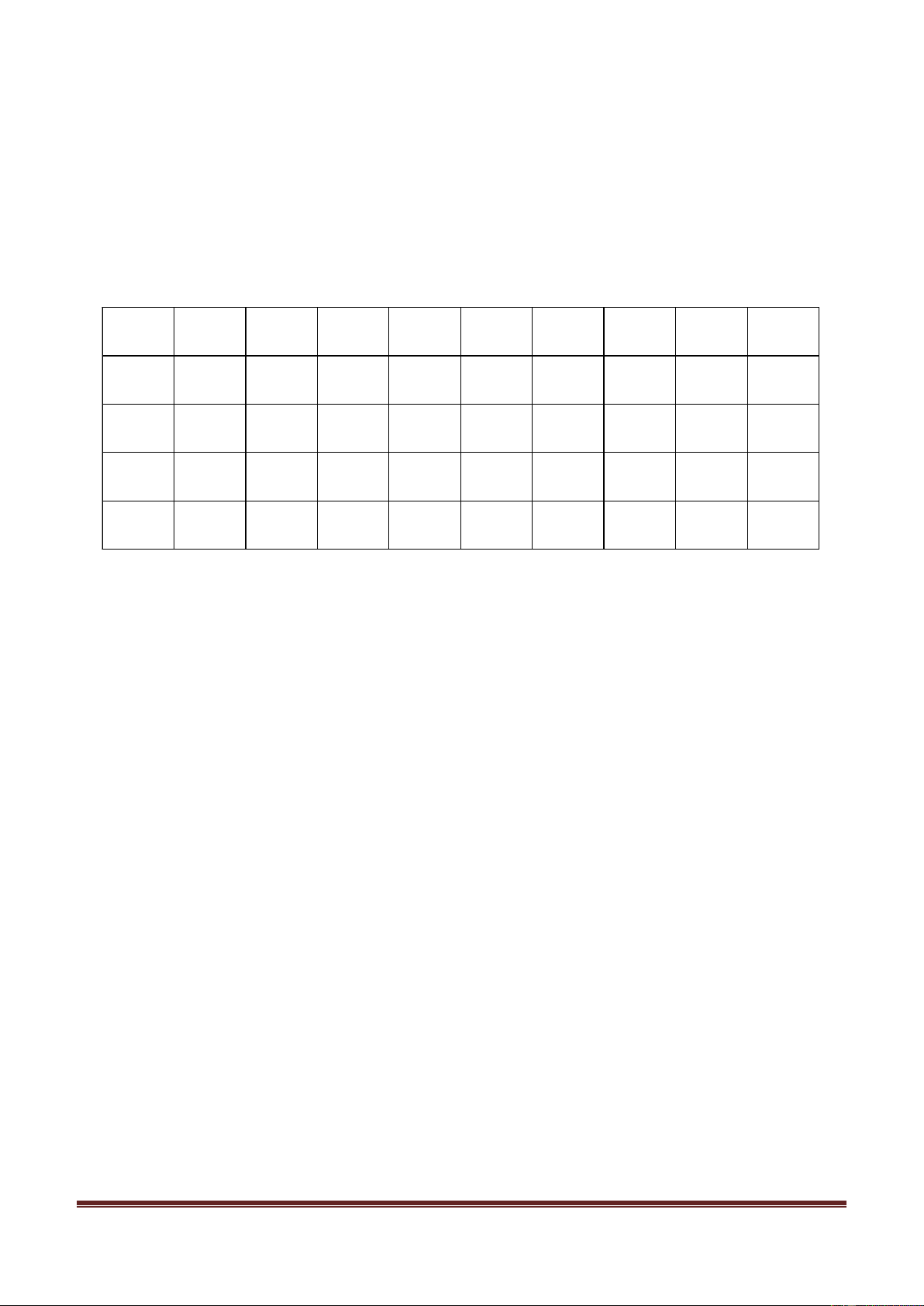
Page 260
A. We aren't allowed to. B. My boss makes me not to.
C. We aren't let wear. D. My boss doesn't want to.
Mark the letter A, B, C, or D on your answer sheet to indicate the word whose underlined part
differs from the other three in pronunciation in each of the following questions.
Question 49. A. compile B. facile C. facsimile D. textile
Question 50. A. couple B. trouble C. enough D. thousand
-----THE
END-----
ĐÁP ÁN
HƯỚNG DẪN GIẢI CHI TIẾT
Question 1. C
Kiến thức: Trọng âm của từ có 3 âm tiết trở lên
Giải thích:
emergency
/iˈmɜːdʒənsi/
corruption /kə'rʌp∫n/
fashionable /'fæ∫nəbl/
detergent /di'tɜ:dʒənt/
Câu C trọng âm rơi vào âm tiết thứ nhất, còn lại là thứ 2
Question 2. A
Kiến thức: Trọng âm của từ có 3 âm tiết trở lên
Giải thích:
executive
/ig'zekjətiv/
opposite /'ɒpəzit/
customer
/'kʌstəmə[r]/
supervisor
/'sju:pəvaizə/
Câu A trọng âm rơi vào âm tiết thứ 2, còn lại là thứ nhất
Question 3. A
Kiến thức: Đọc hiểu
Giải thích:
Điều nào sau đây là ĐÚNG, theo đoạn văn?
A. Hiện tại có một số sản phẩm GM phi thực phẩm chính.
B. Bông GM không có lợi thế đáng kể so với bông gây tranh cãi.
C. Không có sự phản đối đối với bông GM.
D. Bông GM ít gây tranh cãi hơn các sản phẩm GM khác.
Thông tin: Cotton is the only major non-food GM crop at present, but others are coming.
Tạm dịch: Bông là cây trồng biến đổi gen phi thực phẩm chính duy nhất hiện nay, nhưng
những loại khác cũng sắp đến.
1-C
2-A
3-A
4-C
5-A
6-A
7-C
8-B
9-C
10-A
11-C
12-B
13-D
14-C
15-A
16-A
17-A
18-D
19-B
20-C
21-C
22-A
23-C
24-A
25-C
26-B
27-A
28-B
29-A
30-D
31-A
32-B
33-C
34-A
35-A
36-A
37-A
38-A
39-C
40-B
41-A
42-D
43-D
44-A
45-D
46-C
47-D
48-A
49-C
50-D

Page 261
Question 4. C
Kiến thức: Đọc hiểu
Giải thích:
Từ “compelling” trong đoạn 2 có nghĩa gần nhất với
A. nguy hiểm B. rõ ràng C. thú vị D. gây phiền
nhiễu compelling = interesting: hấp dẫn, thú vị
Question 5. A
Kiến thức: Đọc hiểu
Giải thích:
Có thể suy ra từ đoạn thuốc lá GM
A. có thể có nồng độ nicotine thấp hơn hoặc cao hơn.
B. sản xuất thuốc rất đắt tiền.
C. làm cho thuốc lá vô hại với người hút thuốc.
D. đã có mặt trên thị trường.
Thông tin: It is not food crop, but it is consumed, and GM tobacco plants with both more
and less nicotine have been created.
Tạm dịch: Nó không phải là cây lương thực, nhưng nó được tiêu thụ, và cây thuốc lá GM với
nồng độ nicotine thấp hoặc cao hơn đã được tạo ra.
Question 6. A
Question 10.
A Kiến thức:
Đọc hiểu Giải
thích:
Từ “that” trong đoạn 1 nói đến
A. khía cạnh B. GM C. chiến tranh D. rủi ro
“that” đề cập đến “aspect”: There is one aspect of the war over GM that is often overlooked.
Dịch bài đọc:
Sự phát triển của thực vật và động vật biến đổi gen (GM) đã dẫn đến một cuộc tranh cãi toàn cầu.
Những người phản đối nói rằng Thực phẩm biến đổi gen GM "Thực phẩm Franken" là một mối
đe dọa đối với sức khỏe của chúng ta và những người đề xuất nói rằng những rủi ro là rất nhỏ.
Có một khía cạnh của cuộc chiến về GM thường bị bỏ qua. Bất cứ ai mặc áo cotton ngày nay đều
sử dụng cây trồng GM. Bông là cây trồng biến đổi gen phi thực phẩm chính duy nhất hiện nay,
nhưng những loại khác cũng sắp đến.
Cây bông GM không phải là thực phẩm đã không ngăn các đối thủ đam mê GM nhất khỏi việc
phản đối. Nếu bông GM được trồng trên một cánh đồng bên cạnh cánh đồng của bông không biến
đổi gen, họ lập luận, thì làm thế nào để giữ cho gen không bị chuyển từ cánh đồng này sang cánh
đồng khác. Tuy nhiên, mối nguy hiểm này không hấp dẫn đối với công chúng vì các mối nguy
hiểm sức khỏe có thể có trong thực phẩm, do đó không có sự ác liệt lớn đối với bông GM.
Hạt bông GM tạo ra năng suất cao hơn, và chúng lớn không cần thuốc trừ sâu. Trồng bông GM
đã tăng gấp năm lần kể từ năm 1997; ba phần tư bông ở Mỹ và hơn một nửa ở Trung Quốc, giờ là
GM. Nông dân thích nó vì nó làm tăng lợi nhuận của họ.
Các lựa chọn khác cho GM không phải thực phẩm bao gồm nhiều loại hoa mới với màu sắc
hoặc mùi hương khác nhau, cỏ cứng hơn cho thảm cỏ và các nhà máy được thiết kế để hấp thụ các
chất ô nhiễm từ đất. Ngành công nghiệp giấy cung cấp một ví dụ khác về tiềm năng cho GM để
giúp sản xuất các sản phẩm tốt hơn và rẻ hơn. Giấy được làm từ bột giấy, và bột giấy thường
được làm từ cây. Các nhà nghiên cứu ở New Zealand và Chile đã nghiên cứu về cây thông chống
côn trùng và một công ty Nhật Bản đã kết hợp gen cà rốt với gen cây để làm cho chúng phát triển
tốt hơn trong đất kém màu mỡ.

Page 262
Một trường hợp thú vị khác là thuốc lá. Nó không phải là cây lương thực, nhưng nó được tiêu thụ,
và cây thuốc lá GM với nồng độ nicotine thấp hoặc cao hơn đã được tạo ra. Tuy nhiên, cây thuốc
lá là một mục tiêu lý tưởng cho GM, vì di truyền của nó được hiểu rất rõ và nó tạo ra rất nhiều lá.
Giá trị của các loại thuốc có thể được sản xuất bởi thuốc lá GM rất cao, nhiều nông dân có thể
chuyển từ trồng thuốc lá làm thành thuốc lá sang trồng để làm thuốc. Vì chi phí y tế đang tăng lên,
người tiêu dùng cũng sẽ rất vui khi sử dụng thuốc được sản xuất với số lượng lớn bởi thuốc lá GM.
Question 11. C
Kiến thức: Liên từ
Tạm dịch:
Susan sẽ sẵn sàng bất cứ lúc nào, và sau đó chúng tôi phải rời đi.
A. Chúng tôi phải rời đi ngay khi Susan sẽ sẵn sàng.
B. Chúng ta phải rời khỏi thời điểm Susan phải sẵn sàng
C. Chúng ta phải rời đi ngay khi Susan sẵn sàng.
D. Chúng tôi sẽ rời đi bất cứ lúc nào khi Susan sẽ sẵn sàng.
Question 12. B
Kiến thức: Reported speech
Tạm dịch:
“Làm ơn, hãy để con tôi đi!”, Cô năn nỉ kẻ bắt cóc.
A. Cô năn nỉ kẻ bắt cóc để đứa con của mình đi. (Ở câu này sai câu trúc, ta có cấu trúc “let sb do
sth”: để ai làm gì
B. Cô nài nỉ kẻ bắt cóc thả con mình ra.
C. Cô long trọng ra lệnh cho kẻ bắt cóc giải thoát cho con mình.
D. Cô cầu xin kẻ bắt cóc để đứa con của mình đi. (Ở câu này sai câu trúc, ta có cấu trúc “plead with
sb to do sth”: cầu xin, nài nỉ ai làm gì)
Question 13. D
Kiến thức: Modal verb
Tạm dịch:
Tôi nghĩ bạn hoàn toàn hài lòng với kết quả vào cuối màn trình diễn.
A. Bạn đã hoàn toàn hài lòng khi màn trình diễn kết thúc.
B. Đến cuối màn trình diễn, bạn chắc hẳn đã rất vui.
C. Bạn phải hoàn toàn hài lòng với kết quả vào cuối màn trình diễn.
D. Đến cuối màn trình diễn, bạn hẳn đã phải hoàn toàn hài lòng.
Question 14.
C Kiến thức:
Liên từ Tạm
dịch:
Bạn phải hoàn thành công việc này. Dù bạn không muốn làm điều đó.
A. Mặc dù bạn phải hoàn thành công việc này, bạn nên muốn làm nó.
B. Khi bạn không cảm thấy thích làm công việc này, bạn phải hoàn thành nó.
C. Bạn phải hoàn thành công việc này, dù bạn không thích làm việc đó đến đâu đi nữa.
D. Trừ khi bạn muốn làm điều đó, bạn không phải hoàn thành công việc này.
Question 15. A
Kiến thức: Câu điều kiện
Tạm dịch:
Cô đã ngã trong những phút cuối cùng. Cô ấy đã không chiến thắng cuộc đua.
A. Nếu cô ấy không ngã trong những phút cuối, cô ấy sẽ thắng cuộc đua. (Câu này dùng câu

Page 263
điều kiện loại 2, không phù hợp với hoàn cảnh của câu)
B. Cô ấy đã không chiến thắng cuộc đua mặc dù cô ấy đã ngã trong những phút cuối
C. Không giành chiến thắng trong cuộc đua, cô ấy đã ngã trong những phút cuối
D. Cô ấy có thể đã chiến thắng cuộc đua nếu cô ấy không ngã trong những phút cuối.
Question 16.
A Kiến thức:
Từ vựng Giải
thích:
reach (v): đạt tới, đạt được, với tới solve (v): giải
quyết pass (v): vượt qua, cho qua come (v): đến, tới
The United States and China have (16) a deal that allows the Chinese telecommunications
giant ZTE to stay in business in exchange for paying an additional $1 billion in fines and
agreeing to let US regulators monitor its operations.
Tạm dịch: Hoa Kỳ và Trung Quốc đã đạt được thỏa thuận cho phép hãng khổng lồ viễn thông
Trung Quốc ZTE ở lại kinh doanh để đổi lấy việc trả thêm 1 tỷ đô la tiền phạt và đồng ý để các nhà
quản lý Hoa Kỳ giám sát hoạt động của mình.
Question 17. A
Kiến thức: Giới từ, trạng từ
Giải thích:
after (prep): sau, sau khi while: trong khi
before (prep): trước, trước khi by the time: trước thời điểm…
The fine comes (17) Donald Trump stepped in to save the company after US regulators
barred it from doing business in the US, an effective death blow for the company.
Tạm dịch: Khoản tiền phạt này được đưa ra sau khi Donald Trump bước vào để cứu công ty sau
khi các nhà quản lý Hoa Kỳ cấm công ty này kinh doanh tại Mỹ, một đòn chí tử hiệu quả cho công
ty.
Question 18.
D Kiến thức:
Từ vựng Giải
thích:
test (n): bài kiểm tra trial (n): sự thử
experiment (n): thí nghiệm probation (n): sự thử thách
In addition to the fine, a compliance team chosen by the US will be embedded at ZTE and the
Chinese company must change its board and executive team. “ZTE is essentially on (18) ,”
said Amanda DeBusk
Tạm dịch: Ngoài tiền phạt, một nhóm tuân thủ do Mỹ chọn sẽ được gài vào ZTE và công ty Trung
Quốc phải thay đổi hội đồng quản trị và nhóm điều hành. Amanda DeBusk nói “ZTE về cơ bản
đang bị thử thách”
Question 19.
B Kiến thức:
Từ vựng Giải
thích:
relatively (adv): một cách tương đối certainly (adv): một cách chắc chắn
frantically (adv): một cách cuống cuồng cautiously (adv): một cách thận
trọng
“It’s unprecedented to have US agents as monitors … It’s (19) a good precedent
for this situation. ZTE is a repeat offender.”

Page 264
Tạm dịch: “Nó không có tiền lệ để các đặc vụ Hoa Kỳ làm giám sát. Nó chắc chắn là tiền lệ tốt
cho tình huống này. ZTE là một kẻ phạm tội lặp lại.”
Question 20.
C Kiến
thức: Giới từ
Giải thích:
by (prep): bằng, trước in (prep):
trong on (prep): trên, về with
(prep): với
a report on….: một báo cáo về…
These concerns aren’t new; back in 2012, the House permanent select committee on intelligence
released a report (20) the serious counterintelligence concerns associated with ZTE
equipment.
Tạm dịch: Những mối quan tâm này không có gì mới; trở lại năm 2012, ủy ban tình báo thường
trực của Hạ viện đã công bố một báo cáo về những lo ngại phản gián nghiêm trọng liên quan đến
thiết bị ZTE.
Dịch bài đọc:
Hoa Kỳ và Trung Quốc đã đạt được thỏa thuận cho phép hãng khổng lồ viễn thông Trung Quốc
ZTE ở lại kinh doanh để đổi lấy việc trả thêm 1 tỷ đô la tiền phạt và đồng ý để các nhà quản lý
Hoa Kỳ giám sát
hoạt động của mình. Khoản tiền phạt này được đưa ra sau khi Donald Trump bước vào để cứu công
ty sau khi các nhà quản lý Hoa Kỳ cấm công ty này kinh doanh tại Mỹ, một đòn chí tử hiệu quả cho
công ty.
hội đồng quản trị và nhóm điều hành. Amanda DeBusk, chủ tịch của tập quán thương mại quốc tế
và thực hành quy định của chính phủ tại Dechert LLP và một cựu quan chức thương mại, nói
“ZTE về cơ bản đang bị thử thách”. “Nó không có tiền lệ để các đặc vụ Hoa Kỳ làm giám sát. Nó
chắc chắn là tiền lệ tốt cho tình huống này. ZTE là một kẻ phạm tội lặp lại.”
Các tin tức đã không làm giảm bớt phê bình mấy. Thượng nghị sĩ Mark Warner, phó chủ tịch ủy
ban tình báo của Thượng viện về tình báo, nói: Đây là kết luận nhất trí của cộng đồng tình báo quốc
gia của chúng ta rằng ZTE đặt ra một mối đe dọa đáng kể cho an ninh quốc gia của chúng ta.
Những mối quan tâm này không có gì mới; trở lại năm 2012, ủy ban tình báo thường trực của Hạ
viện đã công bố một báo cáo về những lo ngại phản gián nghiêm trọng liên quan đến thiết bị ZTE.
Question 21. C
Kiến thức: Từ vựng, từ trái nghĩa
Giải thích:
partial (a): một phần
halfway (a): nửa đường half (n):
nửa whole (a): toàn bộ effective
(a): hiệu quả
=> partial >< whole
Tạm dịch: Tôi chỉ có thể đề xuất một giải pháp một phần cho cuộc khủng hoảng trong công ty.
Question 22.
A Kiến thức:
Từ vựng Giải
thích:
just under: dưới, ít hơn
upwards of: trên, nhiều hơn only just: chỉ, chỉ

Page 265
mới just on: chỉ trên, trên not quite: không
hẳn
=> just under >< upwards of
Tạm dịch: Các thủy thủ Viking đã hạ cánh ở Bắc Mỹ chỉ dưới một ngàn năm trước.
Question 23. C
Kiến thức: Từ vựng, từ đồng nghĩa
Giải thích:
get the better of: thắng, đánh bại
gain a disadvantage over: đạt được một bất lợi
hơn try to be better than: cố gắng để tốt hơn
try to beat: cố gắng đánh bại
gain an advantage over: đạt được lợi thế hơn
=> get the better of = try to beat
Tạm dịch: Có phải cô ấy đã đánh bại bạn trong cuộc tranh luận?
Question 24. A
Kiến thức: Từ vựng, từ đồng nghĩa
Giải thích:
on the level (a): thật thà, thẳng thắn
honest (a): thật thà dishonest (a): không thật
thà talented (a): tài năng intelligent (a): thông
minh
=> on the level = honest
Tạm dịch: Tôi nghĩ rằng ông John trung thực vì ông luôn nói sự thật và không bao giờ cố gắng
lừa dối người khác.
Question 25.
C Kiến thức:
Cụm từ
Giải thích: Ta có cụm “take sb under your wing” (v): bảo vệ, chăm sóc ai
Tạm dịch: Giáo viên chủ nhiệm đã yêu cầu tôi bảo vệ cậu bé mới và chăm sóc cậu ấy.
Question 26.
B Kiến thức:
Liên từ Giải
thích:
supposing: giả sử otherwise: nếu
không thì provided: với điều kiện
unless: trừ khi
Tạm dịch: Hãy chắc chắn rằng bạn trộn các thành phần thật tốt, nếu không bánh của bạn có thể
bị vón cục
Question 27. A
Kiến thức: Mệnh đề quan hệ
Giải thích:
“whose” chỉ quan hệ sở hữu, sau whose là danh từ
“whom” thay thế cho danh từ chỉ người đóng vai trò là tân
ngữ “who” thay thế cho danh từ chỉ người đóng vai trò là
chủ ngữ “which” thay thế cho danh từ chỉ vật
Tạm dịch: Hơn 80 người đã đến triển lãm, nhiều con cái của họ có hình ảnh được treo trên tường.

Page 266
Question 28. B
Kiến thức: Phrasal verb
Giải thích:
come in for (v): lôi cuốn cái gì; nhận lĩnh cái gì
come up with (v): tìm ra (một giải pháp, một câu trả
lời) bring out (v): làm cho lộ ra, chế tạo, xuất bản
get down to (v): chú tâm vào
Tạm dịch: Bạn sẽ phải đưa ra một ý tưởng tốt hơn thế nếu bạn muốn giành chiến thắng.
Question 29. A
Kiến thức: Thì trong tiếng Anh
Giải thích:
Trong câu sử dụng thì quá khứ đơn diễn tả một hành động đã xảy ra và kết thúc ở quá
khứ Cấu trúc thì quá khứ đơn câu khẳng định với động từ: S + Ved +…
Tạm dịch: Tôi yêu cầu phải biết chiếc bình này bị vỡ như thế nào và không ai rời đi cho đến khi
tôi phát hiện ra.
Question 30. D
Kiến thức: Vị trí của tính từ trước danh từ
Giải thích:
Vị trí của tính từ trước danh từ: Value (giá trị) – valuable + Age (niên đại, tuổi tác) – old + Origin
(xuất xứ) – Australian + Noun (danh từ) - postage stamp
Tạm dịch: Cậu bé có một bộ sưu tập tem bưu chính cũ có giá trị của Úc
Question 31. A
Kiến thức: Từ vựng, từ loại
Giải thích:
relaxing (a): thoải mái, dễ chịu relaxed (a): thoải mái, dễ
chịu relax (v): thư giãn relaxation (n): sự thư giãn, thoải
mái
Vị trí này ta cần một tính từ. Sự khác nhau giữa tính từ đuôi –ing và –ed: Tính từ đuôi –ing thể
hiện bản chất, đặc điểm của sự vật, sự việc; còn tính từ -ed chỉ tâm trạng con người.
Tạm dịch: Bạn có thể thấy làm công việc này rất thư giãn. Thử xem!
Question 32.
B Kiến thức:
Cụm từ
Giải thích: Ta có cụm “to drive sb crazy” (v): làm ai phát cáu, phát điên
Tạm dịch: Tắt máy này đi. Âm thanh thô thực sự làm tôi phát điên.
Question 33. C
Kiến thức: Mệnh đề cùng chủ ngữ
Giải thích: Ở đây hai mệnh đề cùng chủ ngữ, về nghĩa mệnh đề đầu tiên là thể bị động, ta dùng
động từ quá khứ phân từ ở đầu câu (PP)
Tạm dịch: Bị thương bởi một chiếc xe hơi đi ngang qua, con chó không bao giờ đi lại đúng cách
được nữa.
Question 34.
A Kiến thức:
Từ vựng Giải
thích:

Page 267
summit (n): hội nghị thượng
đỉnh climax (n): cực điểm, tột
đỉnh gathering (n): sự tụ tập;
cuộc họp mặt appointment (n):
sự hẹn gặp
Tạm dịch: Nhà Trắng mới đây đã tuyên bố rằng Tổng thống Donald Trump và nhà lãnh đạo tối
cao của Triều Tiên Kim Jong-un sẽ tổ chức hội nghị thượng đỉnh thứ hai vào gần cuối tháng tới.
Question 35. A
Kiến thức: Modal verb
Giải thích:
should have done sth: lẽ ra nên làm gì must do sth: phải làm
gì should do sth: nên làm gì must have done sth: chắc hẳn
đã làm gì
Tạm dịch: May đã sơn phòng màu đen. Nó trông tối và thê lương. Cô ấy lẽ ra nên chọn màu khác.
Question 36.
A Kiến thức:
Cụm từ
Giải thích: Ta có cụm “in one’s teens”: thời thanh thiếu niên (13-19 tuổi)
Tạm dịch: Nghĩ mà xem! Tháng tới bạn sẽ ở tuổi thiếu niên và dường như ngày hôm qua bạn vẫn
là một em bé.
Question 37. A
Kiến thức: Câu giả định
Giải thích:
Ta có cấu trúc câu giả định với tính từ: It + be + adj + that + S (should) + Vinf +
… Về nghĩa ở đây là dạng bị động, do đó ta dùng “be notified”
Tạm dịch: Điều rất quan trọng là chúng tôi phải được thông báo ngay khi có bất kỳ thay đổi nào
về tình trạng của bệnh nhân.
Question 38.
A Kiến thức:
Định từ Giải
thích:
Ở đây ta có thể hiểu là Jessica dành rất ít thời gian của đời mình để sống ở Úc, với danh từ thời
gian –
danh từ không đếm được, ta dùng “little/a little”
Trong câu này, về nghĩa thì “very little” phù
hợp hơn
Tạm dịch: Jessica được sinh ra ở Úc, nhưng cô đã dành rất ít thời gian của cuộc đời mình ở đó.
Question 39.
C Kiến thức:
Đọc hiểu
Giải thích:
Từ “it” trong đoạn 4 đề cập đến
A. Băng biển B. Cách thức C. Nước biển D. Độ mặn
“it” đề cập đến “seawater”: In this manner, seawater directly beneath freshly formed sea ice has a
higher salinity than it did before the ice appeared.

Page 268
Question 40.
B Kiến thức:
Đọc hiểu Giải
thích:
Điều nào sau đây KHÔNG phải là kết quả của sự hình thành băng đại dương?
A. Các bồn nước xung quanh B. Độ mặn của nước giảm
C. Muối vẫn còn trong nước D. Nước trở nên đặc hơn
Thông tin: When seawater is frozen, the dissolved materials are left behind. In this manner,
seawater directly beneath freshly formed sea ice has a higher salinity than it did before the ice
appeared.
Tạm dịch: Khi nước biển bị đóng băng, các vật liệu hòa tan bị bỏ lại. Theo cách này, nước biển
trực tiếp bên dưới băng biển mới hình thành có độ mặn cao hơn so với trước khi băng xuất hiện.
Question 41.
A Kiến thức:
Đọc hiểu Giải
thích:
Đoạn văn chủ yếu thảo luận gì?
A. Độ mặn của nước biển B. Nhiều dạng sống của đại dương
C. Các nguyên tố của muối D. Các cơ quan nước trên thế giới
Bài văn thảo luận về độ mặn của nước biển và những nhân tố ảnh hưởng đến độ mặn của nước biển
Question 42.
D Kiến thức:
Đọc hiểu Giải
thích:
Tại sao tác giả đề cập đến biển Weddell?
A. Để chỉ ra rằng vùng nước này có các biến đổi độ mặn
B. Để so sánh vùng biển Nam Cực với vùng biển Bắc Cực
C. Để chỉ ra vị trí của vùng nước sâu
D. Để đưa ra một ví dụ về độ mặn của nước lạnh
Thông tin: In the Weddell Sea, off Antarctica, the densest water in the ocean is formed as a result
of this freezing process, which increases the salinity of cold water.
Tạm dịch: Ở biển Weddell, ngoài khơi Nam Cực, nước dày đặc nhất trong đại dương được hình
thành là kết quả của quá trình đóng băng này, làm tăng độ mặn của nước lạnh.
Question 43.
D Kiến thức:
Đọc hiểu Giải
thích:
Theo đoạn văn, đại dương thường có nhiều muối trong
A. vùng ven biển B. vùng mưa C. vùng hỗn loạn D. vùng nhiệt đới
Thông tin: Normally, in tropical regions where the sun is very strong, the ocean salinity is
somewhat higher than it is in other parts of the world where there is not as much evaporation.
Tạm dịch: Thông thường, ở các vùng nhiệt đới nơi mặt trời rất mạnh, độ mặn của đại dương có
phần cao hơn so với các khu vực khác trên thế giới, nơi không có nhiều sự bốc hơi.
Dịch bài đọc:
Nếu độ mặn của nước biển được phân tích, nó được tìm ra rằng nó chỉ thay đổi một chút từ nơi
này sang nơi khác. Tuy nhiên, một số thay đổi nhỏ này rất quan trọng. Có ba quá trình cơ bản gây
ra sự thay đổi độ mặn của đại dương. Một trong số đó là phép trừ nước từ đại dương bằng phương
pháp bay hơi - chuyển

Page 269
đổi nước lỏng thành hơi nước. Theo cách này, độ mặn được tăng lên, vì muối sót lại. Nếu điều này
được thực hiện đến cùng cực, tất nhiên, các tinh thể muối trắng sẽ bị để lại.
Đối lập với sự bốc hơi là kết nước, chẳng hạn như mưa, qua đó nước được thêm vào đại dương. Ở
đây đại dương đang bị pha loãng để độ mặn giảm. Điều này có thể xảy ra ở những khu vực có
lượng mưa lớn hoặc ở những vùng ven biển nơi sông chảy vào đại dương. Do đó, độ mặn có thể
được tăng lên bằng cách trừ nước bằng cách bay hơi, hoặc giảm khi bổ sung nước ngọt bằng lượng
mưa hoặc dòng chảy.
Thông thường, ở các vùng nhiệt đới nơi mặt trời rất mạnh, độ mặn của đại dương có phần cao hơn
so với các khu vực khác trên thế giới, nơi không có nhiều sự bốc hơi. Tương tự, ở các vùng ven
biển nơi các con sông làm loãng biển, độ mặn có phần thấp hơn so với các khu vực đại dương khác.
Một quá trình thứ ba mà độ mặn có thể bị thay đổi có liên quan đến sự hình thành và tan chảy của
băng biển. Khi nước biển bị đóng băng, các vật liệu hòa tan bị bỏ lại. Theo cách này, nước biển
trực tiếp bên dưới băng biển mới hình thành có độ mặn cao hơn so với trước khi băng xuất hiện.
Tất nhiên, khi băng này tan ra, nó sẽ có xu hướng làm giảm độ mặn của nước xung quanh.
Ở biển Weddell, ngoài khơi Nam Cực, nước dày đặc nhất trong đại dương được hình thành là kết
quả của quá trình đóng băng này, làm tăng độ mặn của nước lạnh. Nước nặng này chìm xuống và
được tìm thấy ở những nơi sâu hơn của các đại dương trên thế giới.
Question 44. A
Kiến thức: Từ vựng, từ loại
Giải thích:
Sửa: deficient => deficiency
Vị trí này ta cần một danh từ, vì phía trước có mạo từ “a” và phía sau có giới từ “of”
deficient (a): thiếu hụt
deficiency (n): sự thiếu hụt
Tạm dịch: Sự thiếu hụt axit folic hiếm khi được tìm thấy ở người vì vitamin có trong nhiều
loại thực phẩm.
Question 45.
D Kiến thức:
Từ vựng Giải
thích:
Sửa: those => that
Ở đây ta đề cập đến “the quality” – danh từ không đếm được, cho nên không thể dùng those, ta sửa
thành “that”
Tạm dịch: Một nữ diễn viên ballet nổi tiếng quốc tế, Maria Tallchief đã chứng minh rằng chất
lượng của múa ba lê ở Bắc Mỹ có thể ngang bằng với chất lượng của múa ba lê ở châu Âu.
Question 46.
C Kiến thức:
Từ vựng Giải
thích:
Sửa: foot => feet
Phía trước có lượng từ là “two”, do đó ở đây ta dùng danh từ số nhiều. Số nhiều của “foot” là “feet”.
Tạm dịch: Con chuột nang đào với móng vuốt to khỏe ở hai bàn chân trước và với răng cửa nhô ra.
Question 47. D
Kiến thức: Văn hoá giao tiếp
Tạm dịch:
Jimmy hỏi Lily về bạn của cô ấy.
Jimmy: “Bạn có phiền nói cho tôi biết Tom làm việc ở đâu không?” – Lily: “ .”
A. Không, tất nhiên là không. B. Có, tôi sẽ

Page 270
C. Đừng bận tâm. D. Ừm, anh ấy làm việc trong một bệnh viện.
Question 48. A
Kiến thức: Văn hoá giao tiếp
Tạm dịch:
Jack đã nói chuyện với bạn của mình tại quán cà phê.
Jack: “Tại sao bạn không mặc đồ tập đi làm?” Bạn của anh ấy đã trả lời “ .”
A. Chúng tôi không được phép.
B. Sai ngữ pháp, “make sb do sth”: bắt, khiến ai làm gì
C. Sai ngữ pháp, “to be let to do sth”: được cho phép làm gì
D. Ông chủ của tôi không muốn.
Question 49. C
Kiến thức: Phát âm “-ile”
Giải thích:
compile /kəmˈpail/ facile /'fæsail/ facsimile
/fækˈsɪməli/ textile /'tekstail/
Phần gạch chân câu C được phát âm là /əli/ còn lại là /ail/
Question 50. D
Kiến thức: Phát âm “-ou”
Giải thích:
couple /'kʌpl/ trouble /'trʌbl/ enough
/i'nʌf/ thousand /'θɑʊznd/
Phần gạch chân câu D được phát âm là /ɑʊ/ còn lại là /ʌ/
SỞ GD & ĐT HÒA BÌNH ĐỀ THI THỬ THPT QUỐC GIA LẦN 1
THPT CHUYÊN HOÀNG VĂN THỤ Môn thi: Tiếng Anh
Thời gian làm bài: 60 phút (không kể thời gian phát đề)
Mã đề 122
Họ, tên thí sinh: .............................................. Số báo danh: ..............................................
Exercise 1: Mark the letter A, B, C or D on your answer sheet to indicate the sentence that is
CLOSEST in meaning to each of the following sentences.
Question 1. "Stop smoking or you'll be ill," the doctor told me.
A. The doctor advised me to give up smoking to avoid illness.
B. The doctor suggested smoking to treat illness.
C. I was warned against smoking a lot of cigarettes.
D. I was ordered not to smoke to recover from illness.
Question 2. If we can solve this problem soon, it will be better for all concerned.
A. It would be better for all concerned if we can solve this problem soon.
B. The sooner we solve this problem, the better it will be for all concerned.
C. If we could solve this problem soon, it would be better for all concerned.
D. If all concerned are better, we can solve this problem soon.
Question 3. He survived the operation thanks to the skillful surgeon.
A. He wouldn't have survived the operation without the skillful surgeon.
B. Though the surgeon was skillful, he couldn't survive the operation.
C. He survived because he was a skillful surgeon.
D. There was no skillful surgeon, so he died.
Exercise 2: Mark the letter A, B, C or D on your answer sheet to indicate the word(s) CLOSET in
meaning to the underlined word(s) in each of the following questions.

Page 271
Question 4. They have been forced to live in marginal environments, such as deserts and arctic
wastelands.
A. suburban B. forgotten C. abandoned D. disadvantaged
Question 5. Only during the nineteenth century did silent reading become commonplace.
A. attracting attention B. widely used C. for everybody's use D. most preferable
Exercise 3: Mark the letter A, B, C or D on your answer sheet to indicate the underlined part the
needs correction in each of the following questions.
Question 6. They asked us whether we thought that the statistics had presented fairly and
accurately.
А. whether B. thought C. had presented D. fairly
Question 7. Sam found it hard to concentrate on his work because the noise.
А. it B. concentrate C. work D. because
Question 8. Ms Phuong hardly never misses an opportunity to play in the tennis tournaments.
A. hardly never B. an C. to play D. in
Exercise 4: Mark the letter A, B, C or D on your answer sheet to indicate the sentence that best
combines each pair of sentences in the following questions.
Question 9. We didn't want to spend a lot of money. We stayed in a cheap hotel.
A. Rather than spending a lot of money, we stayed in a cheap hotel.
B. In spite of spending a lot of money, we stayed in a cheap hotel.
C. We didn't stay in a cheap hotel as we had a lot of money to spend.
D. We stayed in a cheap hotel, but we had to spend a lot of money.
Question 10. I left the office. There was a power cut just then.
A. I left the office after there was a power cut.
B. Hardly I had left the office when there was a power cut.
C. No sooner had I left the office than there was a power cut.

Page 272
D. I left the office long before there was a power cut.
Exercise 5: Read the following passage and mark the letter A, B, C or D on your answer sheet to
indicate the correct word or phrase that best fits each of the numbered blanks
A YEAR WITH OVERSEAS VOLUNTEERS
I was with Overseas Volunteers (OV) for a year after leaving university, and I was sent to an
isolated village in Chad, about 500 kilometers from the capital N'Djamena. Coming from a rich
country, I got quite a shock, as conditions were much harder than I had expected. But after a few
days I got used to (11) there. The people were always very friendly and helpful, and I soon
began to appreciate how beautiful the countryside was.
One of my jobs was to supply the village (12) water. The well was a long walk away,
and the women used to spend a long time every day (13) heavy pots backwards and
forwards. So I contacted the organization and arranged to have some pipes delivered. (14)_
these pipes were not really perfect, they still made a great difference to the villagers.
All in all, I think my time with OV was a good experience. Although it was not paid, it was
well worth doing and I would recommend it to anyone (15) was considering working for a
charity.
Question 11. A. live B. living C. lively D. lived
Question 12. A. on B. for C. with D. from
Question 13. A. holding B. drinking C. wearing D. carrying
Question 14. A. Because B. When C. Although D. If
Question 15. A. when B. which C. who D. where
Exercise 6: Mark the letter A, B, C or D on your answer sheet to indicate the word that differs
from the other three in the position of primary stress in each of the following questions.
Question 16.
A. popular
B. reduction
C. romantic
D. financial
Question 17.
A. cover
B. balance
C. invent
D. ancient
Exercise 7: Mark the letter A, B, C or D on your answer sheet to indicate the correct answer to
each of the following questions.
Question 18. We in silence when he suddenly me to help him.
A. walked - was asking B. were walking - asked
C. were walking - was asking D. walked - asked
Question 19. Xoan singing is a vocal art of villages in the ancestral land of Phu Tho. It has been
for generations and the oral tradition is still very much alive today.
A. handed down B. landed on C. passed by D. taken over
Question 20. Any pupil caught was made to stand at the front of the class.
A. misbehaved B. misbehave C. misbehavior D. misbehaving
Question 21. There is in my bedroom.
A. an old square wooden table B. a square wooden old table
C. an old wooden square table D. a wooden old square table
Question 22. If I were in charge, I things differently.
A. had done B. would do C. would have done D. will do
Question 23. The latest heritage at risk register revealed that 5,831 listed buildings, monuments,
archaeological sites, and landscapes in England are at of being lost.
A. edge B. risk C. ease D. danger
Question 24. Next year, I have to decide which area of medicine I want to in.
A. focus B. hand C. specialise D. come
Question 25. Is it acceptable to touch person on shoulder in a conversation?
A. a – the B. the – a C. the – the D. a - a
Question 26. he had no money for a bus, he had to walk all the way home.
A. As B. Thus C. For D. So
Question 27. The Complex of Hue Monuments was the first site in Viet Nam as a World
Heritage Site by UNESCO.
A. recognised B. to be recognised C. recognising D. to recognise

Page 273
Question 28. We need actions and interventions of the local authorities to prevent national
parks from being destroyed by pollution.
A. timely B. excitedly C. reckless D. threateningly
Question 29. After a six-year relation, Martha and Billy have decided to .
A. break the bank B. tie the knot
C. turn the page D. make ends meet
Question 30. Being helpful is good, but don't allow others to advantage of your
generosity.
A. get B. take C. use D. make
Question 31. Peter lost the race because he _ petrol on the last lap.
A. put out of B. got out of C. made out of D. ran out of
Exercise 8: Read the following passage and mark the letter A, B, C or D on your answer sheet to
indicate the correct answer to each of the questions
It is estimated that over 99 percent of all species that have existed have become extinct. What
causes extinction? When a species is no longer adapted to a changed environment, it may perish.
The exact causes of a species' death vary from situation to situation. Rapid ecological change may
render an environment hostile to a species. For example, temperatures may change and a species
may not be able to adapt. Food resources may be affected by environmental changes, which will
then cause problems for a species requiring these resources. Other species may become better
adapted to an environment, resulting in competition and, ultimately, in the death of a species.
The fossil record reveals that extinction has occurred throughout the history of Earth. Recent
analyses have also revealed that on some occasions, many species became extinct at the same time-
a mass extinction. One of the best-known examples of mass extinction occurred 65 mmion years
ago with the demise of dinosaurs and many other forms of life. Perhaps the largest mass extinction
was the one that occurred 225 million years ago, when approximately 95 percent of all species died.
Mass extinction can be caused by a relatively rapid change in the environment and can be
worsened by the close interrelationship of many species. If, for example, something were to happen
to destroy much of the plankton in the oceans, then the oxygen content of Earth would drop,
affecting even organisms not living in the oceans. Such a change would probably lead to a mass
extinction.
One interesting, and controversial, finding is that extinctions during the past 250 million years
have tended to be more intensive every 26 million years. This periodic extinction might be due to
intersection of the Earth's orbit with a cloud of comets, but this theory is purely speculative. Some
researchers have also speculated that extinction may often be random. That is, certain species may
be eliminated and others may survive for no particular reason. A species' survival may have nothing
to do with its ability or inability to adapt. If so, some of evolutionary history may reflect a sequence
of essentially random events.
Question 32. Which of the following is NOT mentioned in paragraph 1 as resulting from rapid
ecological change?
A. Availability of food sources B. Temperature changes
C. Introduction of new species D. Competition among species
Question 33. According to paragraph 2, evidence from fossil fuels suggests that .
A. extinction of species has occurred from time to time throughout Earth's history
B. dinosaurs became extinct much earlier than scientists originally believed
C. extinction on Earth have generally been massive
D. there has been only one mass extinction in Earth's history
Question 34. The word "ultimately" in paragraph 1 is closest in meaning to
A. exceptionally B. dramatically C. unfortunately D. eventually
Question 35. In paragraph 3, the author makes which of the following statements about a species
survival?
A. It reflects the interrelationship of many species.
B. It is associated with astronomical conditions.

Page 274
C. It doesn't vary greatly from species to species.
D. It may depend on chance events.
Question 36. The word "demise" in paragraph 2 is closest in meaning to .
A. recovery B. survival C. death D. change
Question 37. According to the passage, it is believed that the largest extinction of a species
occourred
.
A. 26 million years ago B. 250 million years ago
C. 225 million years ago D. 65 million years ago
Ouestion 38. What does the author say in paragraph 1 regarding most species in Earth's history?
A. They have been able to adapt to ecological changes.
B. They have caused rapid changes in the environment.
C. They have remained basically unchanged from their original forms.
D. They are no longer in existence.
Question 39. Which of the following can be inferred from the theory of periodic extinction
mentioned in paragraph 3?
A. The theory is no longer seriously considered
B. Many scientists could be expected to disagree with it
C. Most scientists believe the theory to be accurate
D. Evidence to support the theory has recently been found
Exercise 9: Read the following passage and mark the letter A, B, C or D on your answer sheet to
indicate the correct answer to each of the questions
In the twentieth - century, people depend on unlimited energy to power their everyday lives. A
wide range of energy-run devices and modern conveniences are taken for granted, and although it
may seem that we will never be in danger of living without those conveniences, the fact is that
many supplies of energy are dwindling rapidly. Scientists are constantly searching for new sources
of power to keep modern society running. Whether future populations will continue to enjoy the
benefits of abundant energy will depend on the success of this search.
Coal, oil, and natural gas supply modern civilization with most of its power. However, not only
are supplies of these fuels limited, but they are a major source of pollution. If the energy demands
of the future are to be met without seriously harming the environment, existing alternative energy
sources must be improved or further explored and developed. These include nuclear, water, solar,
wind, and geothermal power, as well as energy from new, nonpolluting types of fuels. Each of these
alternatives, however, has advantages and disadvantages.
Nuclear power plants efficiently produce large amounts of electricity without polluting the
atmosphere; however, they are costly to build and maintain, and they pose the daunting problem of
what to do with nuclear waste. Hydroelectric power is inexpensive and environmentally safe, but
impractical for communities located far from moving water. Harnessing energy from tides and
waves has similar drawbacks. Solar power holds great promise for the future but methods of
collecting and concentrating sunlight are as yet inefficient, as are methods of harnessing wind
power.
Every source of energy has its disadvantages. One way to minimize them is to use less energy.
Conservation efforts coupled with renewable energy resources, such as a combination of solar,
water, wind, and geothermal energy and alternative fuels, such as alcohol and hydrogen, will ensure
supplies of clean, affordable energy for humanity's future.
Question 40. The word "dwindling" in the first paragraph is closest in meaning to
A. diminishing B. changing C. increasing D. limiting
Question 41. Which of the following can be inferred from the passage?
A. Our present energy sources must be eliminated and replaced with alternative sources.
B. Demands for energy in the future are likely to decrease.
C. The search for alternative energy sources is not over.
D. Alternative sources of energy on this planet are very limited.
Question 42. It can be inferred from the passage that .

Page 275
A. Many alternative energy sources are environmentally hazardous
B. solar and wind power are not promising for the future
C. most alternative energy sources have proven to be impractical
D. nuclear power solves one problem while creating others
Exercise 10: Mark the letter A, B, C or D on your answer sheet to indicate the most suitable
response complete each of the following exchanges.
Question 45. Jenny: "Wow! What a nice coat you are wearing!"
Peter: “ ”
A. Thanks. My mother bought it for me. B. Certainly. Do you like it, too?
C. I like you to say that. D. Yes, of course. It's expensive.
Question 46. Stranger: “Excuse me! Can you show me the way to Main Street, please?”
Man: “ ”
A. Continue. B. It's easy to do it.
C. Um, I am sorry I have no idea. D. Am I going right?
Exercise 11: Mark the letter A, B, C or D on your answer sheet to indicate the word(s)
OPPOSITE in meaning to the underlined word(s) in each of the following questions.
Question 47. Though built almost five hundred years ago, the church remained practically intact.
A. in perfection B. in completion C. in chaos D. in ruins
Question 48. After a long time working incessantly, all my efforts ended in failure.
A. breakdown B. loss C. success D. collapse
Exercise 12: Mark the letter A, B, C or D on your answer sheet to indicate the word whose
underlined part differs from the other three in pronunciation in each of the following questions.
Question 49. A. asked
B. danced
C. cashed
D. studied
Question 50. A. chapter
B. chemistry
C. bachelor
D. teacher
------THE END------
ĐÁP ÁN
1-A
2-B
3-A
4-D
5-B
6-C
7-D
8-A
9-A
10-C
11-B
12-C
13-D
14-C
15-C
16-A
17-C
18-B
19-A
20-D
21-A
22-B
23-B
24-C
25-A
26-A
27-B
28-A
29-B
30-B

Page 276
31-D
32-C
33-A
34-D
35-D
36-C
37-C
38-D
39-B
40-A
41-C
42-D
43-A
44-A
45-A
46-C
47-D
48-C
49-D
50-B
Question 1. A
Kiến thức: Câu tường thuật
Giải thích:
HƯỚNG DẪN GIẢI CHI TIẾT
"Ngừng hút thuốc hoặc anh sẽ bị bệnh", bác sĩ nói với tôi.
A. Bác sĩ khuyên tôi nên bỏ hút thuốc để tránh bệnh tật.
B. Bác sĩ đề nghị hút thuốc để điều trị bệnh.
C. Tôi đã được cảnh báo không hút nhiều thuốc lá.
D. Tôi được lệnh không hút thuốc để khỏi bệnh.
Câu B, C, D không phù hợp về nghĩa.
Question 2. B
Kiến thức: Câu điều kiện, so sánh kép
Giải thích:
Câu điều kiện loại 1: If S + V(s/es), S + will + V
Câu điều kiện loại 2: If S + Ved/ V2, S + would + V
Câu so sánh kép: The + so sánh hơn + S + V, the + so sánh hơn + S + V (càng... càng...)
Tạm dịch: Nếu chúng ta có thể giải quyết vấn đề này sớm, nó sẽ tốt hơn cho tất cả những người
liên quan. (câu điều kiện loại 1)
A. Câu điều kiện hỗn hợp loại 2 và loại 1 => sai ngữ pháp
B. Chúng tôi giải quyết vấn đề này càng sớm thì càng tốt cho tất cả những người liên quan. => đúng
C. Câu điều kiện loại 2 => sai ngữ pháp
D. Nếu tất cả các mối quan tâm là tốt hơn, chúng ta có thể giải quyết vấn đề này sớm. => sai nghĩa
Question 3. A
Kiến thức: Câu diều kiện
Giải thích:
Câu diều kiện loại 3 diễn tả điều giả định ngược lại với quá khứ:
If + S + had (not) Ved/ V3, S + would have Ved/ V3
= Without + noun phrase, S + would have Ved/ V3
Tạm dịch: Anh sống sót sau ca phẫu thuật nhờ bác sĩ phẫu thuật khéo léo. => ngữ cảnh ở quá khứ
=> câu điều kiện loại 3
A. Anh ấy sẽ không sống sót sau ca phẫu thuật nếu không có bác sĩ phẫu thuật khéo léo.
B. Mặc dù bác sĩ phẫu thuật khéo léo, anh ta không thể sống sót sau ca phẫu thuật.
C. Anh ấy sống sót vì anh ấy là một bác sĩ phẫu thuật khéo léo.
D. Không có bác sĩ phẫu thuật khéo léo, nên đã chết.

Page 277
Câu B, C, D không phù hợp về nghĩa.
Question 4. D
Kiến thức: Từ đồng nghĩa
Giải thích:
marginal (adj): khó trồng trọt, khó sinh lợi
A. suburban (adj): ngoại ô B. forgotten (adj): bị lãng quên
C. abandoned (adj): bị bỏ hoang D. disadvantaged (adj): bất lợi
=> marginal = disadvantaged
Tạm dịch: Họ đã bị buộc phải sống trong môi trường khắc nghiệt, như sa mạc và bãi rác Bắc cực.
Question 5. B
Kiến thức: Từ đồng nghĩa
Giải thích:
commonplace (adj): phổ biến
A. attracting attention: thu hút sự chú ý
B. widely used: được sử dụng rộng rãi
C. for everybody's use: cho sự sử dụng của mọi người
D. most preferable: thích hợp nhất
=> commonplace = widely used
Tạm dịch: Chỉ trong thế kỷ XIX, việc đọc thầm đã trở nên phổ biến.
Question 6. C
Kiến thức: Câu bị động
Giải thích:
Xét về nghĩa câu mang nghĩa bị động.
Cấu trúc bị động thì quá khứ hoàn thành: S + had been Ved/ V3
Sửa: had presented => had been presented
Tạm dịch: Họ hỏi chúng tôi rằng liệu chúng tôi nghĩ rằng các số liệu thống kê đã được trình bày
một cách công bằng và chính xác chưa.
Question 7. D
Kiến thức: Mệnh đề chỉ lý do
Giải thích:
Because + S + V = Because of + N: do, bởi vì
“the noise” (tiếng ồn) là danh từ.
Sửa: because => because of
Tạm dịch: Sam thấy thật khó để tập trung vào công việc vì tiếng ồn.
Question 8.A
Kiến thức: Trạng từ
Giải thích:
2 trạng từ “hardly” (hầu như không) và “never” (không bao giờ) đều mang nghĩa phủ định nên
không đứng cạnh nhau.
Sửa: hardly never => hardly ever
Tạm dịch: Cô Phương hầu như không bỏ lỡ cơ hội nào để chơi trong các giải đấu quần vợt.
Question 9. A
Kiến thức: Câu đồng nghĩa
Giải thích:
Chúng tôi không muốn chi nhiều tiền. Chúng tôi ở trong một khách sạn giá rẻ.
A. Thay vì chi nhiều tiền, chúng tôi ở trong một khách sạn rẻ tiền.

Page 278
B. Mặc dù chi rất nhiều tiền, chúng tôi vẫn ở trong một khách sạn giá rẻ.
C. Chúng tôi đã không ở trong một khách sạn giá rẻ vì chúng tôi có rất nhiều tiền để chi tiêu.
D. Chúng tôi ở trong một khách sạn rẻ tiền, nhưng chúng tôi đã phải chi rất nhiều tiền.
Câu B, C, D không phù hợp về nghĩa.
Question 10. C
Kiến thức: Thì quá khứ hoàn thành & quá khứ đơn
Giải thích: Cấu trúc: No sooner + had + S + P2 + than + S + Ved/ V2 (Ngay khi... thì...)
Tạm dịch: Tôi rời văn phòng. Có một sự cố cắt điện ngay sau đó.
A. Tôi rời văn phòng sau khi bị cắt điện.
B. Hầu như tôi đã rời khỏi văn phòng khi bị cắt điện.
C. Ngay khi tôi rời khỏi văn phòng thì mất điện.
D. Tôi rời văn phòng rất lâu trước khi bị cắt điện.
Câu A, B, D không phù hợp về nghĩa.
Question 11. B
Kiến thức: Cấu trúc “get used to + V_ing”
Giải thích:
get used to + V_ing: quen với việc gì
But after a few days I got used to (11) living there.
Tạm dịch: Nhưng sau vài ngày tôi đã sớm quen với việc sống ở đó.
Question 12. C
Kiến thức: Giới từ
Giải thích:
supply sb with sth: cung cấp cho ai cái gì
One of my jobs was to supply the village (12) with water.
Tạm dịch: Một trong những công việc của tôi là cung cấp nước cho làng.
Question 13. D
Kiến thức: Từ vựng
Giải thích:
A. holding (v): giữ B. drinking (v): uống
C. wearing (v): mặc D. carrying (v): khiêng, khuân vác
The well was a long walk away, and the women used to spend a long time every day (13) carrying
heavy pots backwards and forwards.
Tạm dịch: Một trong những công việc của tôi là cung cấp nước cho làng. Đi đến giếng để lấy nước
là một chặng đường dài, và những người phụ nữ thường dành một khoảng thời gian dài mỗi ngày để
mang những chiếc bình nặng ngược và xuôi.
Question 14. C
Kiến thức: Liên từ
Giải thích:
A. Because: bởi vì B. When: khi
C. Although: mặc dù D. If: nếu
(14) Although these pipes were not really perfect, they still made a great difference to the villagers.
Tạm dịch: Mặc dù các đường ống không thực sự hoàn hảo, chúng vẫn tạo ra sự khác biệt lớn cho
dân làng.
Question 15. C
Kiến thức: Đại từ quan hệ
Giải thích:

Page 279
when ( = on/ in/ at which): thay cho danh từ chỉ thời gian; when + S + V
which: thay cho danh từ chỉ vật trước nó; đóng vai trò chủ ngữ hoặc tân ngữ trong mệnh đề quan hệ
who: thay cho danh từ chỉ người trước nó; đóng vai trò chủ ngữ hoặc tân ngữ trong mệnh đề quan
hệ
where ( = on/ in/ at which): thay cho danh từ chỉ địa điểm; where + S + V
anyone: bất cứ ai => đại từ bất định chỉ người
Although it was not paid, it was well worth doing and I would recommend it to anyone (15) who
was considering working for a charity.
Tạm dịch: Mặc dù nó không được trả lương, nhưng nó cũng đáng để làm và tôi sẽ giới thiệu nó cho
bất cứ ai đang xem xét làm việc cho một tổ chức từ thiện.
Dịch bài đọc:
Tôi đã ở với Tình nguyện viên nước ngoài (OV) trong một năm sau khi rời trường đại học, và tôi
được gửi đến một ngôi làng biệt lập ở Chad, cách thủ đô N'Djamena khoảng 500 km. Đến từ một
quốc gia giàu có, tôi đã khá sốc vì điều kiện khó khăn hơn nhiều so với tôi dự kiến. Nhưng sau vài
ngày tôi đã sớm quen với việc sống ở đó. Mọi người luôn rất thân thiện và hữu ích, và chẳng mấy
chốc tôi bắt đầu yêu quý vùng nông thôn xinh đẹp này.
Một trong những công việc của tôi là cung cấp nước cho làng. Đi đến giếng để lấy nước là một
chặng đường dài, và những người phụ nữ thường dành một khoảng thời gian dài mỗi ngày để mang
những chiếc bình nặng ngược và xuôi. Vì vậy, tôi đã liên hệ với tổ chức và sắp xếp để có một số
đường ống được giao. Mặc dù các đường ống không thực sự hoàn hảo, chúng vẫn tạo ra sự khác
biệt lớn cho dân làng.
Nói chung, tôi nghĩ rằng thời gian của tôi với OV là một trải nghiệm tốt. Mặc dù nó không được trả
lương, nhưng nó cũng đáng để làm và tôi sẽ giới thiệu nó cho bất cứ ai đang xem xét làm việc cho
một tổ chức từ thiện.
Question 16. A
Kiến thức: Trọng âm từ có 3 âm tiết
Giải thích:
popular /ˈpɒpjələ(r)/ reduction /rɪˈdʌkʃn/
romantic /rəʊˈmæntɪk/ financial /faɪˈnænʃl/
Câu A có trọng âm rơi vào âm tiết thứ 1, còn lại rơi vào âm tiết thứ 2.
Question 17. C
Kiến thức: Trọng âm từ có 2 âm tiết
Giải thích:
cover /ˈkʌvə(r)/ balance /ˈbæləns/
invent /ɪnˈvent/ ancient /ˈeɪnʃənt/
Câu C có trọng âm rơi vào âm tiết thứ 2, còn lại rơi vào âm tiết thứ 1.
Question 18. B
Kiến thức: Thì quá khứ đơn, thì quá khứ tiếp diễn
Giải thích:
Thì quá khứ tiếp diễn dùng để diễn tả một hành động đang xảy ra thì một hành động khác xen vào,
hành động đang xảy ra chia thì quá khứ tiếp diễn, hành động xen vào chia thì quá khứ đơn.
Cấu trúc: S + was/ were V-ing when S + Ved/ V2
Tạm dịch: Chúng tôi đang đi trong im lặng khi anh ấy đột nhiên nhờ tôi giúp đỡ.
Question 19. A
Kiến thức: Phrasal verb
Giải thích:
A. handed down: lưu truyền B. landed on: hạ cánh

Page 280
C. passed by: thông qua D. taken over: tiếp quản
Tạm dịch: Hát Xoan là một nghệ thuật thanh nhạc của những ngôi làng ở vùng đất tổ tiên của Phú
Thọ. Nó đã được lưu truyền qua nhiều thế hệ và truyền thống truyền miệng vẫn còn tồn tại đến ngày
nay
Question 20. D
Kiến thức: Dạng của động từ
Giải thích: catch sb + Ving: bắt quả tang ai đang làm gì
Tạm dịch: Bất kì học sinh nào bị bắt cư xử không đúng đắn sẽ bị đứng trước lớp.
Question 21. A
Kiến thức: Trật tự tính từ
Giải thích:
Trật tự 8 loại tính từ:
1. Opinion and general description (Ý kiến hoặc miêu tả chung) Ví dụ: nice, awesome, lovely
2. Dimension / Size / Weight (Kích cỡ, cân nặng)Ví dụ: big, small, heavy
3. Age (Tuổi, niên kỷ)Ví dụ: old, new, young, ancient .
4. Shape (Hình dạng) Ví dụ: round, square, oval .
5. Color (Màu sắc)Ví dụ: green, red, blue, black
6. Country of origin (Xuất xứ) Ví dụ: Swiss, Italian, English.
7. Material (Chất liệu) Ví dụ: woolly, cotton, plastic .
8. Purpose and power (Công dụng) Ví dụ: walking (socks), tennis (racquet), electric (iron)
old (cũ) – age => square (hình vuông) – shape => wooden (bằng gỗ) – material
Tạm dịch: Có một chiếc bàn gỗ cũ hình vuông trong phòng của tôi.
Question 22. B
Kiến thức: Câu điều kiện loại 2
Giải thích:
Câu điều kiện loại II còn được gọi là câu điều kiện không có thực ở hiện tại, diễn tả một điều kiện
không thể xảy ra ở hiện, điều kiện chỉ là một giả thiết, một ước muốn trái ngược với thực trạng hiện
tại.
Cấu trúc: If + S + Ved/ V2, S + would + V (nguyên mẫu)
Tạm dịch: Nếu tôi chịu trách nhiệm việc này, tôi sẽ làm khác.
Question 23. B

Page 281
Question 25. A
Kiến thức: Mạo từ
Giải thích:
Mạo từ không xách định "a" và "an" dùng chỉ những sự vật, hiện tượng không xác định, người nghe
không biết.
Mạo từ xác định "the" chỉ sự việc cả người nói và người nghe đều biết.
“person” (một người nào đó không xác định) => “a”
“shoulder” (vai của người đó) => “the”
Tạm dịch: Chạm vào vai một người nào đó khi đang nói chuyện có được chấp nhận không?
Question 26. A
Kiến thức: Liên từ
Giải thích:
As = Because = Since + S + V: vì
So = Thus: vì vậy
For + danh từ: bởi vì; cho
Tạm dịch: Vì anh ấy không có tiền đi bus, anh ấy đã đi bộ về nhà.
Question 27. B
Kiến thức: Rút gọn mệnh đề quan hệ
Giải thích:
Khi danh từ đứng trước có các từ bổ nghĩa như :ONLY,LAST,số thứ tự như: FIRST,SECOND…ta
rút gọn mệnh đề quan hệ bằng “to V”
Câu đầy đủ: The Complex of Hue Monuments was the first site in Viet Nam that is recognised as a
World Heritage Site by UNESCO.
Câu rút gọn: The Complex of Hue Monuments was the first site in Viet Nam to be recognised as a
World Heritage Site by UNESCO.
Tạm dịch: Khu phức hợp di tích Huế là địa điểm đầu tiên tại Việt Nam được UNESCO công nhận
là di sản thế giới.
Question 28. A
Kiến thức: Từ vựng
Giải thích:
A. timely (adj): kịp thời
B. excitedly (adv): một cách hào hứng
C. reckless (adj): liều lĩnh, táo bạo
D. threateningly (adv): một cách đe dọa
Trước danh từ “actions and interventions” (các hành động và sự can thiệp) cần 1 tính từ.
Tạm dịch: Chúng tôi cần các hành động và sự can thiệp kịp thời của chính quyền địa phương để
ngăn chặn các công viên quốc gia khỏi bị phá hủy do ô nhiễm.
Question 29. B
Kiến thức: Thành ngữ
Giải thích:
A. break the bank: chi tiêu/tiêu xài hết sạch tiền
B. tie the knot: kết hôn
C. turn the page: chuyển sang giai đoạn mới của cuộc đời
D. make ends meet: iếm đủ tiền để sống, không mắc nợ, hay là cân đối được số thu và số chi
Tạm dịch: Sau mối quan hệ sáu năm, Martha và Billy đã quyết định kết hôn.
Question 30. B
Kiến thức: Cụm từ

Page 282
Giải thích:
take advantage of: tận dụng
make use of: lợi dụng
Tạm dịch: Có ích thì tốt, nhưng đừng để người khác lợi dụng sự hào phóng của bạn.
Question 31. D
Kiến thức: Phrasal verb
Giải thích:
A. put out of: đưa ra khỏi B. got out of: bỏ ra khỏi
C. made out of: làm từ D. ran out of: hết
Tạm dịch: Peter thua cuộc đua vì anh ấy hết xăng ở vòng đua cuối cùng.
Question 32. C
Kiến thức: Đọc hiểu
Giải thích:
Điều nào sau đây KHÔNG được đề cập trong đoạn 1 do kết quả của sự thay đổi sinh thái nhanh
chóng?
A. Nguồn thức ăn sẵn có B. Thay đổi nhiệt độ
C. Giới thiệu loài mới D. Cạnh tranh giữa các loài
Thông tin: For example, temperatures may change and a species may not be adapt. Food resources
may be affected by environmental changes, which will then cause problems for a species requiring
these resources. Other species may become better adapted to an environment, resulting in
competition and, ….
Tạm dịch: Ví dụ như, nhiệt độ thay đổi và sinh vật không thích ứng được. Nguồn thức ăn có thể bị
ảnh hưởng bởi sự thay đổi môi trường, điều đó sẽ gây ra những vấn đề cho nhu cầu thức ăn của loài.
Những loài khác có thể thích ứng tốt hơn,với môi trường, dẫn đến sự cạnh tranh …
Question 33. A
Kiến thức: Đọc hiểu
Giải thích:
Theo đoạn 2, bằng chứng từ nhiên liệu hóa thạch cho thấy rằng .
A. sự tuyệt chủng của loài đã xảy ra theo thời gian trong suốt lịch sử Trái đất
B. khủng long đã tuyệt chủng sớm hơn nhiều so với các nhà khoa học tin rằng ban đầu
C. sự tuyệt chủng trên Trái đất nói chung là rất lớn
D. chỉ có một sự tuyệt chủng hàng loạt trong lịch sử Trái đất
Thông tin: The fossil record reveals that extinction has occurred throughout the history of Earth.
Tạm dịch: Các mẫu hóa thạch cho thấy rằng sự tuyệt chủng đã xảy ra trong suốt lịch sự của trái
đất.
Question 34. D
Kiến thức: Đọc hiểu
Giải thích:
Từ "ultimatly" (cuối cùng ) trong đoạn 1 có nghĩa gần nhất với
A. exceptionally: đặc biệt B. dramatically: kịch tính
C. unfortunately: không may D. eventually: cuối cùng
=> ultimatly = eventually
Question 35. D
Kiến thức: Đọc hiểu
Giải thích:
Trong đoạn 3, tác gải đã khẳng định gì về sự sống của một loài?
A. Nó phản ánh mối tương quan của nhiều loài.

Page 283
B. Nó gắn liền với điều kiện thiên văn.
C. Nó không khác nhau nhiều từ loài này sang loài khác.
D. Nó có thể phụ thuộc vào các sự kiện ngẫu nhiên.
Thông tin: A species’ survival may have nothing to do with its ability or inability to adapt. If so,
some of revolutionary history may reflect a sequence of essentially random events.
Tạm dịch: Sự sống của một loài sẽ không phụ thuộc vào khả năng có thể thích ứng được hay không
của chúng. Do đó, một vài sự tiến hóa lịch sử có thể chính là sự phản ánh các sự kiện có bản chất
ngẫu nhiên diễn ra liên tiếp.
Question 36. C
Kiến thức: Đọc hiểu
Giải thích:
Từ “demise” (sự chết) có nghĩa gần với .
A. recovery: sự phục hồi B. survival: sự sống sót
C. death: sự tuyệt chủng, cái chế D. change: sự thay đổi
=> demise = death
Question 37. C
Kiến thức: Đọc hiểu
Giải thích:
Theo đoạn văn, người ta tin rằng sự tuyệt chủng lớn nhất của một loài đã xảy ra .
A. 26 triệu năm trước B. 250 triệu năm trước
C. 225 triệu năm trước D. 65 triệu năm trước
Thông tin: Perhaps the largest mass extinction was the one that occurred 225 million years ago,
when approximately 95 percent of all species died.
Tạm dịch: Có lẽ sự tuyệt chủng hàng loạt lớn nhất là xảy ra cách đây 225 triệu năm, khi mà gần
như 95 phần trăm các loài sinh vật đã chết.
Question 38. D
Kiến thức: Đọc hiểu
Giải thích:
Ở đoạn 1, tác giả đã nói gì liên quan đến sinh vật trong lịch sử Trái đất ?
A. Họ đã có thể thích nghi với những thay đổi sinh thái.
B. Chúng đã gây ra những thay đổi nhanh chóng trong môi trường.
C. Về cơ bản chúng vẫn không thay đổi so với dạng ban đầu của chúng.
D. Chúng không còn tồn tại.
Thông tin: It is estimated that over 99 percent of all species that ever existed have become extinct.
Tạm dịch: Ước tính được rằng, có khoảng hơn 99 phần trăm các loài sinh vật đang tồn tại có nguy
cơ tuyệt chủng.
Question 39. B
Kiến thức: Đọc hiểu
Giải thích:
Điều nào sau đây có thể được suy ra từ lý thuyết tuyệt chủng định kỳ được đề cập trong đoạn 3?
A. Lý thuyết không còn được xem xét nghiêm túc
B. Nhiều nhà khoa học có thể sẽ không đồng ý với nó
C. Hầu hết các nhà khoa học tin rằng lý thuyết này là chính xác
D. Bằng chứng để hỗ trợ lý thuyết gần đây đã được tìm thấy
Thông tin: The periodic extinction might be due to intersection of the earth’s orbit with a cloud of
comets, but this theory is purely speculative. Some researchers have also speculated that extinction
may often be random…

Page 284
Tạm dịch: Sự tuyệt chủng tuần hoàn này có thể do sự giao nhau của quĩ đạo trái đất với một đám
mây của sao chổi, nhưng lý thuyết này hoàn toàn chỉ là suy đoán. Một số nhà nghiên cứu cũng suy
đoán rằng sự tuyệt chủng này có thể xảy ra một cách ngẫu nhiên.
Dịch bài đọc:
Ước tính được rằng, có khoảng hơn 99 phần trăm các loài sinh vật đang tồn tại có nguy cơ
tuyệt chủng. Vậy cái gì gây ra sự tuyệt chủng ấy ? Khi một loài không còn thích nghi được với sự
biến đổi của môi trường, nó có thể sẽ chết. Nguyên nhân chính xác cho cái chết của chúng là do sự
biến đổi từ môi trường này sang môi trường khác. Hệ sinh thái thay đổi nhanh chóng có thể khiến
cho môi trường chống lại loài sinh vật. Ví dụ như, nhiệt độ thay đổi và sinh vật không thích ứng
được. Nguồn thức ăn có thể bị ảnh hưởng bởi sự thay đổi môi trường, điều đó sẽ gây ra những vấn
đề cho nhu cầu thức ăn của loài. Những loài khác có thể thích ứng tốt hơn,với môi trường, dẫn đến
sự cạnh tranh, và cuối cùng, gây ra cái chết của cả một loài sinh vật..
Các mẫu hóa thạch cho thấy rằng sự tuyệt chủng đã xảy ra trong suốt lịch sự của trái đất.
Những nghiên cứu gần đây cũng tiết lộ rằng trong một số trường hợp, nhiều loài đã tuyệt chủng
cùng một lúc- sự tuyệt chủng hàng loạt. Một minh chứng rõ nhất được biết đến cho sự tuyệt chủng
hàng loạt đã xảy ra cách đây 65 triệu năm với sự diệt vong của loài khủng long và nhiều loài khác.
Có lẽ sự tuyệt chủng hàng loạt lớn nhất là xảy ra cách đây 225 triệu năm, khi mà gần như 95 phần
trăm các loài sinh vật đã chết. Những sự tuyệt chủng hàng loạt có thể gây ra bởi sự thay đổi tương
đối nhanh chóng của môi trường và có thể tồi tệ hơn bởi mối liên hệ mật thiết giữa các loài. Ví dụ
như, nếu xảy ra sự tiêu diệt hầu hết các loài sinh vật nhỏ dưới đại dương, thì hàm lượng oxy sẽ
giảm, thậm chí tác động làm các loài sinh vật sẽ không sống dưới đại dương nữa. Sự thay đổi như
thế hầu như chắc chắn sẽ dẫn đến tuyệt chủng hàng loạt. .
Một phát hiện thú vị và gây ra tranh cãi đã chỉ ra rằng sự tuyệt chủng trong suốt 250 triệu năm
qua có xu hướng gia tăng 26 triệu mỗi năm. Sự tuyệt chủng tuần hoàn này có thể do sự giao nhau
của quĩ đạo trái đất với một đám mây của sao chổi, nhưng lý thuyết này hoàn toàn chỉ là suy đoán.
Một số nhà nghiên cứu cũng suy đoán rằng sự tuyệt chủng này có thể xảy ra một cách ngẫu nhiên.
Điều đó có nghĩa là, một số loài có thể bị loại bỏ và những loài khác có thể vẫn tồn tại mà không có
một nguyên do rõ ràng nào cả. Sự sống của một loài sẽ không phụ thuộc vào khả năng có thể thích
ứng được hay không của chúng. Do đó, một vài sự tiến hóa lịch sử có thể chính là sự phản ánh các
sự kiện có bản chất ngẫu nhiên diễn ra liên tiếp.
Question 40. A
Kiến thức: Đọc hiểu
Giải thích:
Từ "dwindling" (suy giảm) trong đoạn đầu tiên có nghĩa gần nhất với
A. diminishing: giảm dần B. changing: thay đổi
C. increasing: tăng D. limiting: hạn chế
=> dwindling = diminishing
Question 41. C
Kiến thức: Đọc hiểu
Giải thích:
Điều nào sau đây có thể được suy ra từ đoạn văn?
A. Các nguồn năng lượng hiện tại của chúng ta phải được loại bỏ và thay thế bằng các nguồn thay
thế.
B. Nhu cầu năng lượng trong tương lai có khả năng giảm.
C. Việc tìm kiếm các nguồn năng lượng thay thế chưa kết thúc.
D. Các nguồn năng lượng thay thế trên hành tinh này rất hạn chế.
Thông tin: Scientists are constantly searching for new sources of power to keep modern society
running.

Page 285
Tạm dịch: Các nhà khoa học không ngừng tìm kiếm các nguồn năng lượng mới để duy trì xã hội
hiện đại.
Question 42. D
Kiến thức: Đọc hiểu
Giải thích:
Nó có thể được suy ra từ đoạn văn rằng .
A. Nhiều nguồn năng lượng thay thế là nguy hiểm cho môi trường
B. năng lượng mặt trời và năng lượng gió không hứa hẹn cho tương lai
C. hầu hết các nguồn năng lượng thay thế đã được chứng minh là không thực tế
D. năng lượng hạt nhân giải quyết một vấn đề trong khi tạo ra những vấn đề khác
Thông tin: Nuclear power plants efficiently produce large amounts of electricity without polluting
the atmosphere; however, they are costly to build and maintain, and they pose the daunting problem
of what to do with nuclear waste.
Tạm dịch: Các nhà máy điện hạt nhân sản xuất một cách hiệu quả lượng điện lớn mà không gây ô
nhiễm bầu khí quyển; tuy nhiên, chúng rất tốn kém để xây dựng và bảo trì, và chúng đặt ra vấn đề
nan giải là phải làm gì với chất thải hạt nhân.
Question 43. A
Kiến thức: Đọc hiểu
Giải thích:
Đoạn văn gợi ý rằng .
A. mọi người sử dụng năng lượng mà không suy nghĩ nhiều về nguồn gốc của nó
B. xã hội hiện đại đòi hỏi một lượng năng lượng tối thiểu để duy trì hoạt động
C. việc tìm kiếm các nguồn năng lượng chủ yếu là một vấn đề cho tương lai
D. các nhà khoa học tin rằng chúng ta sẽ không bao giờ phải đi nếu không có những tiện nghi hiện
đại
Thông tin: A wide range of energy-run devices and modern conveniences are taken for granted …
Tạm dịch: Một loạt các thiết bị chạy năng lượng và tiện nghi hiện đại được coi là điều hiển nhiên
…
Question 44. A
Kiến thức: Đọc hiểu
Giải thích:
Từ đoạn văn, có thể suy ra rằng để giải quyết các vấn đề năng lượng của chúng ta .
A. sự kết hợp của bảo tồn và phát minh sẽ là cần thiết
B. chúng tôi sẽ phải ngừng sử dụng nhiều tiện ích hiện đại của chúng tôi
C. các nhà khoa học sẽ phải tìm cách tăng nguồn cung than, dầu và khí đốt của chúng ta
D. các nhà khoa học sẽ phải tìm một nguồn năng lượng không gây ô nhiễm chính
Thông tin: Conservation efforts coupled with renewable energy resources, such as a combination
of solar, water, wind, and geothermal energy and alternative fuels, such as alcohol and hydrogen,
will ensure supplies of clean, affordable energy for humanity's future.
Tạm dịch: Những nỗ lực bảo tồn cùng với các nguồn năng lượng tái tạo, như sự kết hợp của năng
lượng mặt trời, nước, gió và địa nhiệt và nhiên liệu thay thế, như rượu và hydro, sẽ đảm bảo cung
cấp năng lượng sạch, giá cả phải chăng cho tương lai của nhân loại.
Dịch bài đọc:
Trong thế kỷ XX, con người phụ thuộc vào năng lượng vô hạn để cung cấp năng lượng cho cuộc
sống hàng ngày của họ. Một loạt các thiết bị chạy năng lượng và tiện nghi hiện đại được coi là điều
hiển nhiên, và mặc dù có vẻ như chúng ta sẽ không bao giờ gặp nguy hiểm khi sống nếu không có
những tiện ích đó, thực tế là nhiều nguồn cung cấp năng lượng đang cạn kiệt nhanh chóng. Các nhà
khoa học không ngừng tìm kiếm các nguồn năng lượng mới để duy trì xã hội hiện đại. Việc dân số

Page 286
trong tương lai có tiếp tục được hưởng những lợi ích của năng lượng dồi dào hay không sẽ phụ
thuộc vào sự thành công của tìm kiếm này.
Than, dầu, và khí đốt tự nhiên cung cấp hầu hết năng lượng của nó cho nền văn minh hiện đại. Tuy
nhiên, không chỉ nguồn cung cấp các loại nhiên liệu này bị hạn chế mà chúng còn là nguồn gây ô
nhiễm chính. Nếu nhu cầu năng lượng trong tương lai được đáp ứng mà không gây hại nghiêm
trọng đến môi trường, các nguồn năng lượng thay thế hiện tại phải được cải thiện hoặc tiếp tục
khám phá và phát triển. Chúng bao gồm hạt nhân, nước, năng lượng mặt trời, gió và năng lượng địa
nhiệt, cũng như năng lượng từ các loại nhiên liệu mới, không gây ô nhiễm. Tuy nhiên, mỗi phương
án đều có ưu điểm và nhược điểm.
Các nhà máy điện hạt nhân sản xuất một cách hiệu quả lượng điện lớn mà không gây ô nhiễm bầu
khí quyển; tuy nhiên, chúng rất tốn kém để xây dựng và bảo trì, và chúng đặt ra vấn đề nan giải là
phải làm gì với chất thải hạt nhân. Thủy điện là không tốn kém và an toàn với môi trường, nhưng
không thực tế đối với các cộng đồng ở xa nước di chuyển. Khai thác năng lượng từ thủy triều và
sóng có nhược điểm tương tự. Năng lượng mặt trời hứa hẹn rất lớn cho tương lai nhưng các phương
pháp thu thập và tập trung ánh sáng mặt trời vẫn chưa hiệu quả, cũng như các phương pháp khai
thác năng lượng gió.
Mỗi nguồn năng lượng đều có nhược điểm của nó. Một cách để giảm thiểu chúng là sử dụng ít năng
lượng hơn. Những nỗ lực bảo tồn cùng với các nguồn năng lượng tái tạo, như sự kết hợp của năng
lượng mặt trời, nước, gió và địa nhiệt và nhiên liệu thay thế, như rượu và hydro, sẽ đảm bảo cung
cấp năng lượng sạch, giá cả phải chăng cho tương lai của nhân loại.
Question 45. A
Kiến thức: Ngôn ngữ giao tiếp
Giải thích:
Jenny: "Wow! Chiếc áo bạn đang mặc thật đẹp!"
Peter: “ ”
A. Cảm ơn. Mẹ tôi đã mua nó cho tôi.
B. Chắc chắn. Bạn cũng thích nó chứ?
C. Tôi thích bạn nói như vậy.
D. Ừ, tất nhiên rồi. Nó đắt mà.
Câu B, C, D không hợp về nghĩa.
Question 46.C
Kiến thức: Ngôn ngữ giao tiếp
Giải thích:
Người lạ: “Xin lỗi! Bạn có thể chỉ cho tôi đường đến Main Street được không?”
Người đàn ông: " "
A. Tiếp tục đi.
B. Thật dễ dàng để làm điều đó.
C. Ừm, tôi xin lỗi tôi không biết lối đi.
D. Tôi đi đúng không?
Câu A, B, D không phù hợp về nghĩa.
Question 47. D
Kiến thức: Từ trái nghĩa
Giải thích:
intact (adj): nguyên vẹn
A. in perfection: hoàn hảo
B. in completion: toàn vẹn
C. in chaos: hỗn loạn
D. in ruins: bị phá hủy hoàn toàn
=> intact >< in ruins

Page 287
Tạm dịch: Mặc dù được xây dựng gần năm trăm năm trước, nhà thờ vẫn còn nguyên vẹn.
Question 48. C
Kiến thức: Từ trái nghĩa
Giải thích:
failure (n): thất bại
A. breakdown (n): đổ vỡ
B. loss (n): mất mát
C. success (n): sự thành công
D. collapse (n): sự sụp đổ
=> failure >< success
Tạm dịch: Sau một thời gian dài làm việc không ngừng, mọi nỗ lực của tôi đều kết thúc trong thất
bại.
Question 49. D
Kiến thức: Cách phát âm đuôi “ed”
Giải thích:
Đuôi /ed/ được phát âm là /t/: Khi động từ có phát âm kết thúc là /s/, /f/, /p/, /ʃ/, /tʃ/, /k/ và những
động từ có từ phát âm cuối là “s”. E.g: washed, touched, fixed.
Đuôi /ed/ được phát âm là /id/: Khi động từ có phát âm kết thúc là /t/ hay /d/. E.g: wanted, needed.
Đuôi /ed/ được phát âm là /d/ với những trường hợp còn lại.
asked /ɑːskt/ danced /dɑːnst/
cashed /kæʃt/ studied /ˈstʌdid/
Phần gạch chân của đáp án D được phát âm là /d/, còn lại phát âm là /t/.
Question 50. B
Kiến thức: Cách phát âm “ch”
Giải thích:
chapter /ˈtʃæptə(r)/ chemistry /ˈkemɪstri/
bachelor /ˈbætʃələ(r)/ teacher /ˈtiːtʃə(r)/
Phần gạch chân của đáp án B được phát âm là /k/, còn lại phát âm là /tʃ/.

Page 288
HỘI 8 TRƯỜNG CHUYÊN ĐỀ THI THỬ THPT QUỐC GIA LẦN 1
LẦN THI CHUNG THỨ NHẤT Môn thi: Tiếng Anh
Thời gian làm bài: 60 phút (không kể thời gian phát đề)
Mã đề 628
Họ, tên thí sinh: .............................................. Số báo danh: ..............................................
Mark the letter A, B, C, or D on your answer sheet to indicate the correct answer to each of
the following questions from 1 to 14.
Question 1. In some families, younger people seem more to save money than their
parents.
A. supposed B. objected C. suspected D. inclined
Question 2. Politicians blame the media if they don't win the election. They're so
predictable.
A. variety B. various C. invariably D. variable
Question 3. When the first child was born, they _ for three years.
A. have been married B. had been married
C. will been married D. will have been married
Question 4. For holistic development schools should families as partners in their children's
education.
A. draft В. recruit C. engage D. enlist
Question 5. , I decided to stop trading with them.
A. Being the biggest dealer
B. Though being the biggest dealer
C. Despite of the fact that they were the biggest dealer
D. Even though they were the biggest dealer
Question 6. Only in the last few years to use home computers.
A. people have begun B. when people began
C. have begun people D. have people begun
Question 7. It is the recommendation of many counselors that their survival is attributed to
their true love.
A. that Katniss convince the Mayor B. that Katniss convinces the Capitol
C. the Capitol is convinced D. that Katniss must convince the Capitol
Question 8. The authorities actions to stop illegal purchase of wild animals and their
associated products effectively. However, they didn't do so.
A. should have taken B. needed have taken
C. must have taken D. had to take
Question 9. in large quantities in the Middle East, oil became known as black gold because
of the large profit it brought.
A. Discovered B. Discovering
C. Which was discovered D. That when discovered
Question 10. If a machine stops moving or working normally, you can say that it has .
A. cut off B. seized up C. gone off D. wiped out
Question 11. Last night, nothing to watch on TV, we went out.
A. having had B. being C. there having D. there being
Question 12. that he had no choice but to leave early.
A. He found himself in so embarrassing a situation
B. In such a situation he did find himself
C. In such a situation he found himself
D. He found himself in a situation where
Question 13. I refuse to believe a word of it, it's a cock-and- story.

Page 289
A. bull B. hen C. duck D. goose

Page 290
Question 14. Paul is a very character , he is never relaxed with strangers.
A. self-conscious B. self-directed C. self-satisfied D. self-confident
Mark the letter A, B, C, or D on your answer sheet to indicate the word whose underlined
part differs from the other three in pronunciation in each of the following questions from 15
to 16.
Question 15. A. biomass B. barrister
C. asthma
D. drama
Question 16. A. well-established B. worshiped
C. poached
D. self-directed
Mark the letter A, B, C, or D on your answer sheet to indicate the word(s) CLOSEST in
meaning to the underlined word(s) in each of the following questions from 17 to 18.
Question 17. S. Mayo Hospital in New Orleans was so named in recognition of Dr Mayo's
outstanding humanitarianism.
A. charitable B. remarkable C. exhaustive D. widespread
Question 18. I had to pay through the nose to get my car repaired at a service station in the middle
of the desert.
A. cost a lot of money B. pay too much for something
C. spend less money than usual D. make a lot of money
Read the following passage and mark the letter A, B, C, or D on your answer sheet to indicate
the correct word or phrase that best fits each of the numbered blanks from 19 to 23.
Culture Clash
In Africa a famous food company tried to sell its baby food by advertising it with the picture of
a baby on the label. They did not know that this particular country used labels only to
(19) a picture of the food inside. When Pepsico used the slogan "Come alive with Pepsi'
in Taiwan, they had no idea that it would be translated into Chinese as 'Pepsi (20) your
ancestors back from the dead’.
Misunderstandings such as these about language or about culture are sometimes comical but
can also cause genuine hurt or anger. Business styles (21) widely in different countries
and what is normal in one culture can be completely unacceptable in another.
Socialising in different countries can be tricky. In Arabic countries, for example, people do not
discuss business (22) meals. Giving gifts is another potential problem: in the UK most
people take presents to a dinner party, but in many countries this is not polite because it (23)
you think the host is poor.
Question 19. A. express B. display C. record D. show
Question 20. A. leads B. returns C. brings D. takes
Question 21. A. exchange B. vary C. differentiate D. disagree
Question 22. A. over B. in C. through D. about
Question 23. A. recommends B. indicates C. suggests D. proposes
Mark the letter A, B, C, or Don your answer sheet to indicate the underlined part that needs
correction in each of the following questions from 24 to 26.
Question 24. Upon reaching the destination, a number of personnel is expected to change their
reservations and proceed to Hawaii.
A. reaching B. proceed to C. is D. to change
Question 25. They had discussion about training not only the new employees but also giving them
some challenges.
A. giving B. training not only C. some challenges D. about
Question 26. If you have some sufficient knowledge of English, you can make yourself understand
almost everywhere.
A. understand B. some C. almost D. of
Read the following passage and mark the letter A, B, C, or D on your answer sheet to indicate
the correct answer to each of the questions from 27 to 31.
The Progressive Movement
The progressive movement was a powerful and broad-based movement of reform that had
lasting effects on the American political system in the first two decades of the twentieth century. It

Page 291
arose in reaction to the domination of the social and political system by business interests and
rampant corruption throughout the political party system during the period following the end of the
Civil War in 1865. Progressivism emerged as a force during the presidency of Theodore Roosevelt,
from 1901 to 1909, and reached its height in the presidential campaign of 1912. By the time the
United States entered World War I in 1917, progressivism as a force had faded from the political
scene.
The progressive movement was focused on instigating, or initiating change in three different
areas. One area that was of major interest to the progressive movement was the imposition of
legal and government control over big business, which had usurped an extraordinary amount
of power in the era of the wealthy industrial barons such as Rockefeller and Carnegie. A
second area of interest to the progressive movement was the improvement of the social system in
order to rid society of the poverty, slum housing, and exploitation of immigrant and child labor that
were a part of the era. A final area of interest was the cleaning up of the political system to move
political decisions back into the realm of direct democratic control and away from the corrupt
backroom deals that plagued the world of politics.
Progressivism was a grassroots movement that first gained force at the local level. In cities such
as Cincinnati and Cleveland, effective urban reform movements took hold, and city officials were
appointed or elected to run their respective cities along nonpartisan lines and out from under the
control of political parties and bosses. The progressive movement then worked its way from the
local level to the state level and then on to the national level. In the state of Wisconsin, for example,
"Fighting Bob" La Follette led the drive for change, first in his role as governor of the state (1901-
1906) and later as the U.S. senator representing the state (1906-1925). Under his leadership,
numerous reforms were instituted: state regulation of the railroads increased, policies directed at
improving the lives of workers -- such as workers' compensation and unemployment insurance -
- were instituted, and in the political arena, selection of party candidates was determined by direct
democratic vote rather than through backroom political wrangling.
Question 31. The author mentions “workers' compensation and unemployment insurance” in
paragraph 3 in order to .
A. prove that workers in Wisconsin were needier than workers in other states
B. indicate areas that were the focus of party candidates
C. provide examples of reforms intended to help the working class
D. demonstrate the need for direct democratic vote
Mark the letter A, B, C, or D on your answer sheet to indicate the word(s) OPPOSITE in
meaning to the underlined word(s) in each of the following questions from 32 to 33.
Question 32. Biologists long regarded it as an example of adaptation by natural selection, but for

Page 292
physicists it bordered on the miracle.

Page 293
A. flexibility B. agility C. adjustment D. inflexibility
Question 33. The distinction between schooling and education implied by this remark is important.
A. implicit B. explicit C. odd D. obscure
Mark the letter A, B, C, or D on your answer sheet to indicate the sentence that is closet
meaning to each of the following questions from 34 to 36.
Question 34. As long as you stay calm, you have nothing to fear from the interview.
A. You have remained calm for a long time in spite of your fear of the interview.
B. Even if you are afraid of the interview, it is important not to let it show.
C. Interviews are only intimidating for people who are not extremely calm.
D. Provided you do not get nervous, the interview won't go badly for you.
Question 35. Despite his early retirement, he found no peace in life.
A. He found no peace in life because he retired early.
B. Early as he retired, he found no peace in life.
C. His early retirement has brought him peace in life.
D. Athough he retired early, but he found no peace in life.
Question 36. My impression of him was that he was a very capable person.
A. He struck me when I was impressed by his capability.
B. It struck me as an impression that he was a very capable person.
C. He struck me as being a very capable person.
D. I struck him with the impression that he was very capable.
Read the following passage and mark the letter A, B, C, or D on your answer sheet to indicate
the correct answer to each of the questions from 37 to 44.
Life Writings
The diary and the letter were the most extensively practiced forms of life writings in
eighteenth-century America. From the numerous examples of these two types of writing from the
period, a portrait of daily life of the period can be gleaned.
Many of the diaries that were kept during this period were life diaries by authors interested in
maintaining day-to-day records of reflective self-examination, but some of the most compelling
were situational diaries; those prompted by and limited to lengthy descriptions of personal
reflections about a particular event. Three of the many situational journals of this period are those
written by Sarah Kemble Knight, William Burd II, and Dr. Alexander Hamilton. Sarah Kemble
Knight's diary of her five-month trip at the end of 1704 and the beginning of 1705 from Boston to
New Haven to New York and back again to Boston was published more than a century later as The
Journal of Madam Knight. Though this diary does include an account of the hardship that she
encountered along the way, it is principally composed of humorous descriptions of and commentary
on the hospitality that she was offered and the manners of those that she encountered. William Burd
II kept two diaries to describe his experiences on a 1729 surveying expedition to settle a border
dispute between Virginia and North Carolina. One of the diaries, History of the Dividing Line
between Virginia and North Carolina, was published in 1842, while its companion, Secret Diary,
was published in 1929. In these diaries, Burd used a humorous and satirical approach to describe
not just the day-to-day events of the trip but also the characteristics which set his beloved Virginia
culture apart from the (in his opinion) decidedly less praiseworthy culture of those non-Virginians
that he encountered in his trip. Dr. Alexander Hamilton's Itinerarium (1744) describes a four-month
voyage of discovery undertaken by Hamilton through the mid-Atlantic and New England colonies;
in the diary that he kept of this trip. Hamilton provides considerable commentary on the social
customs of various areas, comparing the customs and culture of the better homes of the American
colonies with those of the great salons of Europe.
Letter-writing also held a place of importance in eighteenth-century America (indeed, the
ability to produce cultured letters was considered a form of art), and many letters extant from that
period provide insights into the culture, mores, and styles of written communication of that era.
Many of the letter writers employed devices in common usage in European models of the time,
demonstrating that letter writers felt a sense of cohesiveness with the cultured classes of

Page 294
Europe: John and Abigail Adams signed the names Lysander and Constantia to their early
letters, while Thomas Jefferson created an elaborate dialogue between his head and his heart
to discuss the nature of friendship in a 1786 letter to Maria Cosway. The variety of purposes
that these letters served provides additional insight into the priorities of the society of the time. The
letters were used to cement love matches and friendships, as the previously mentioned letters did;
they were the primary method for relaying news among family and friends who were scattered
across various geographic locations; they were often used as a means of carrying out business in
this era before more rapid long-distance communication; they were often used used as a way of
sharing professional, social, or political ideas among leaders in various fields who perhaps had no
other way to get together and exchange ideas.
Question 37. The word “gleaned” in paragraph 1 could best be replaced by .
A. left out B. pulled up C. taken back D. put together
Question 38. What is stated in the passage about the works by Knight, Burd, and Hamilton?
A. Each gave details about business ventures
B. Each provided insight into the culture
C. Each was published soon after it was written
D. Each described visits to nice homes
Question 39. Which of the following is NOT listed in paragraph 3 as a purpose served by
eighteenth century letters?
A. Conducting business B. Maintaining relationships
C. Discussing various ideas D. Developing newspapers
Question 40. The phrase “extant from” in paragraph 3 is closest in meaning to .
A. created during B. written about C. existing from D. prepared since
Question 41. The word “companion” in paragraph 2 could best be replaced by .
A. associated product B. faithful pet
C. longtime friend D. respected colleague
Question 42. The phrase in parentheses (in his opinion) is included in paragraph 2 in order to
indicate .
A. that Burd had not actually made the trip
B. that the author might not share Burd's opinion
C. that the non-Virginians shared the opinion of the Virginians
D. that Burd had little knowledge of the culture of Virginia
Question 43. Which of the sentences below expresses the essential information in the highlighted
sentence in paragraph 3?
A. Examples from the time show that American letter writers were interested in following the
style of letters that was fashionable in Europe
B. European letter writers were greatly influenced by Americans such as John and Abigail
Adams and Thomas Jefferson
C. The use of letter-writing devices by some American authors was criticized by cultured
Europeans.
D. The devices used in letter writing from the period made the writing appear more cultivated
and cohesive.
Question 44. What can be inferred from the passage about situational diaries?
A. They were limited to reflective self-examination
B. They were not ongoing journals of the details of daily life
C. Very few of them still exist
D. They were the only type of eighteenth-century diary
Mark the letter A, B, C, or D on your answer sheet to indicate the sentence that best combines
each pair of sentences in the following questions from 45 to 46.
Question 45. We spend about one-third of our lives sleeping. We know relatively little about sleep.
A. We know relatively little about sleep; as a result, we spend about one-third of our lives
sleeping.

Page 295
B. We spend about one-third of our lives sleeping so that we know relatively little about sleep.
C. Despite spending about one-third of our lives sleeping, we know relatively little about sleep.
D. We shall know more about sleep if we spend more than one-third of our lives sleeping.
Question 46. His academic record at high school was poor. He failed to apply to that prestigious
institution.
A. The academic record at high school was poor because he didn't apply to that prestigious
institution.
B. His academic record at high school was poor as a result of his failure to apply to that
pression institution.
C. His academic record at high school was poor; as a result, he failed to apply to that
prestigious
D. Failing to apply to that prestigious institution, his academic record at high school was poor.
Mark the letter A, B, C, or D on your answer sheet to indicate the option that best completes
each of the following exchanges from 47 to 48.
Question 47. Kien: "Do you feel like going out for a drink this evening?" Trung: “ ”
A. That would be great.
B. No, I don't. I am busy.
C. Yes. I like very much.
D. Thank you very much for your kind invitation.
Question 48. Chau and Phuong bumped into each other after their graduation three years ago.
Chau: "Hi! Phuong. How have you been?” Phuong: “ ”|
A. I've been to Beijing recently. B. Badly. And how are you?
C. Oh, I've done a lot of things D. Oh, pretty good. And you?
Mark the letter A, B, C, or D on your answer sheet to indicate the word that differs from the
other three in the position of primary stress in each of the following questions from 49 to 50.
Question 49. A. distinguished B. anonymous C. diagnose D. achievement
Question 50. A. centralise B. candidate C. applicant D. motivation
---------HẾT---------
ĐÁP ÁN
1-D
2-C
3-B
4-C
5-D
6-D
7-A
8-A
9-A
10-B
11-D
12-A
13-A
14-A
15-D
16-D
17-B
18-B
19-D
20-C
21-B
22-B
23-B
24-C
25-B
26-A
27-A
28-C
29-A
30-C
31-C
32-D
33-B
34-D
35-B
36-B
37-D
38-B
39-D
40-C
41-A
42-B
43-D
44-B
45-C
46-C
47-A
48-D
49-C
50-D

Page 296
Question 1. D
Kiến thức: Từ vựng
Giải thích:
HƯỚNG DẪN GIẢI CHI TIẾT
A. supposed (adj): được tin là B. objected (adj): phản đối
C. suspected (adj): nghi ngờ D. inclined (adj): thiên về
Tạm dịch: Trong một số gia đình, những người trẻ tuổi dường như có xu hướng tiết kiệm tiền hơn
cha mẹ của họ.
Chọn D
Question 2. C
Kiến thức: Từ loại
Giải thích:
A. variety (n): sự đa dạng B. various (adj): khác nhau
C. invariably (adv): bất biến D.variable (adj): luôn thay đổi
Trước động từ thường “blame” và sau chủ ngữ ta dùng trạng từ để bổ nghĩa cho động từ.
Tạm dịch: Các chính trị gia luôn đổ lỗi cho giới truyền thông nếu họ không thắng trong cuộc bầu
cử. Họ rất dễ đoán.
Chọn C
Question 3. B
Kiến thức: Thì quá khứ hoàn thành
Giải thích:
Thì quá khứ hoàn thành dùng để diễn tả một hành động xảy ra trước một hành động khác và cả hai
hành động này đều đã xảy ra trong quá khứ. Hành động nào xảy ra trước thì dùng thì quá khứ hoàn
thành. Hành động xảy ra sau thì dùng thì quá khứ đơn.
Công thức: When + S + Ved/ V2, S + had Ved/ V3
Tạm dịch: Khi đứa con đầu lòng ra đời thì họ đã kết hôn được 3 năm.
Chọn B
Question 4. C
Kiến thức: Từ vựng
Giải thích:
A. draft (v): chọn, định người В. recruit (v): tuyển dụng
C. engage (v): tham gia, thu hút D. enlist (v): chiêu mộ
Tạm dịch: Đối với các trường phát triển toàn diện nên thu hút các gia đình làm đối tác trong giáo
dục trẻ em của họ.
Chọn C
Question 5. D
Kiến thức: Mệnh đề nhượng bộ
Giải thích: Even though + S + V, ... = Though + S + V, ....= Despite the fact that + S + V: Mặc dù
Tạm dịch: Mặc dù họ là đại lý lớn nhất, tôi đã quyết định ngừng giao dịch với họ.
Chọn D
Question 6. D
Kiến thức: Đảo ngữ với “only”
Giải thích: Only in + adv of time/ place + trợ động từ + chủ ngữ + động từ chính: chỉ thời gian/ địa
điểm
Tạm dịch: Chỉ vài năm trở lại đây mọi người mới bắt đầu dùng máy tính ở nhà.
Chọn D
Question 7. A
Kiến thức: Thức giả định
Giải thích: Cấu trúc: It is the recommendation that S + (should) + V(nguyên thể): người ta khuyên
rằng ....
Tạm dịch: Nhiều cố vấn khuyên rằng Katniss nên thuyết phục Thị trưởng rằng sự sống sót của họ

Page 297
là nhờ tình yêu đích thực của họ.

Page 298
Chọn A
Question 8. A
Kiến thức: Động từ khuyết thiếu
Giải thích:
A. should have Ved/ V3: đáng lẽ ra nên
B. needed have Ved/ V3: đáng lẽ ra cần
C. must have Ved/ V3: chắc hẳn đã
D. had to Vo: có nghĩa vụ phải
Tạm dịch: Chính quyền đáng ra nên có hành động để ngăn chặn việc mua bất hợp pháp động vật
hoang dã và các sản phẩm liên quan của họ một cách hiệu quả. Tuy nhiên, họ đã không làm như
vậy.
Chọn A
Question 9. A
Kiến thức: Rút gọn mệnh đề quan hệ
Giải thích:
Dùng cụm Phân từ hai (Ved/ V3) để rút gọn cho các mệnh đề bị động.
Câu đầy đủ: Oil was discovered in large quantities in the Middle East, oil became known as black
gold because of the large profit it brought.
Câu rút gọn: Discovered in large quantities in the Middle East, oil became known as black gold
because of the large profit it brought.
Tạm dịch: Được phát hiện với số lượng lớn ở Trung Đông, dầu được gọi là vàng đen vì lợi nhuận
lớn mà nó mang lại.
Chọn A
Question 10. B
Kiến thức: Phrasal verb
Giải thích:
A. cut off: cắt giảm B. seized up: trục trặc
C. gone off: biến mất D. wiped out: xóa sổ
Tạm dịch: Nếu một cỗ máy dừng di chuyển hoặc hoạt động một cách bình thường, bạn có thể nói
nó bị trục trặc.
Chọn B
Question 11. D
Kiến thức: Câu độc lập
Giải thích:
Câu độc lập là loại câu ở dạng rút gọn tạo cụm danh từ.
Với cấu trúc này thường thì 2 vế phải khác chủ ngữ và có dấu phẩy ngăn cách
Cấu trúc: Danh từ (đại từ + phân từ hiện tại ( S + Ving : dùng trong câu chủ động )
Ex: There was no proof, the police let him go.
=> There being no proof, the police let him go.
Tạm dịch: Tối qua, vì không có gì để xem trên tivi, chúng tôi đã ra ngoài.
Chọn D
Question 12. A
Kiến thức: Mệnh đề kết quả
Giải thích: Cấu trúc: S + V + so + adj + a/ an + noun (đếm được số ít) + that + S + V
Tạm dịch: Anh ấy thấy mình đang trong tình huống xáu hổ xử đến nỗi mà anh ấy không còn lựa
chọn nào khác ngoài rời đi.
Chọn A
Question 13. A
Kiến thức: Thành ngữ
Giải thích: A cock-and-bull story: chuyện bịa đặt
Tạm dịch: Tôi từ chối tin một lời, nó là chuyện bịa đặt.
Chọn A

Page 299
Question 14. A
Kiến thức: Từ vựng
Giải thích:
A. self-conscious (adj): e ngại B. self-directed (adj): tự quyết
C. self-satisfied (adj): tự mãn D. self-confident (adj): tự tin
Tạm dịch: Paul là người rất e ngại, anh ấy không bao giờ thoải mái với người lạ.
Chọn A
Question 15. D
Kiến thức: Cách phát âm “-a”
Giải thích:
biomass /ˈbaɪəʊmæs/ barrister /ˈbærɪstə(r)/
asthma /ˈæsmə/ drama /ˈdrɑːmə/
Phần gạch chân của đáp án D được phát âm là /ɑː/, còn lại phát âm là /æ/.
Chọn D
Question 16. D
Kiến thức: Cách phát âm “-ed”
Giải thích:
Đuôi /ed/ được phát âm là /t/: Khi động từ có phát âm kết thúc là /s/, /f/, /p/, /ʃ/, /tʃ/, /k/ và những
động từ có từ phát âm cuối là “s”. E.g: washed, picked, ...
Đuôi /ed/ được phát âm là /id/: Khi động từ có phát âm kết thúc là /t/ hay /d/. E.g: needed, wanted,
…
Đuôi /ed/ được phát âm là /d/ với những trường hợp còn lại.
well-established /ˌwel ɪˈstæblɪʃt/ worshiped /ˈwɜːʃɪpt/
poached /pəʊtʃt/ self-directed / ˌself dəˈrɛktid/
Phần gạch chân của đáp án D được phát âm là /id/, còn lại phát âm là /t/.
Chọn D
Question 17. B
Kiến thức: Từ đồng nghĩa
Giải thích:
outstanding (adj): nổi trội
charitable (adj): từ thiện remarkable (adj): đáng chú ý
exhaustive (adj): toàn diện widespread (adj): lan rộng
=> outstanding = remarkable
Tạm dịch: Bệnh viện S. Mayo ở New Orleans được đặt tên như vậy để công nhận chủ nghĩa nhân
đạo xuất sắc của bác sĩ Mayo.
Chọn B
Question 18. B
Kiến thức: Từ đồng nghĩa
Giải thích:
pay through the nose: trả một cái giá đắt cắt cổ
A. cost a lot of money: tốn rất nhiều tiền
B. pay too much for something: trả quá nhiều tiền cho cái gì
C. spend less money than usual: trả ít tiền hơn bình thường
D. make a lot of money: kiếm rất nhiều tiền
=> pay through the nose = pay too much for something
Tạm dịch: Tôi đã phải trả quá nhiều tiền để sửa xe tại một trạm dịch vụ giữa sa mạc.
Chọn B
Question 19. D
Kiến thức: Từ vựng
Giải thích:
A. express (v): diễn tả, bày tỏ B. display (v): trưng bày
C. record (v): ghi lại D. show (v): biểu lộ

Page 300
They did not know that this particular country used labels only to (19) show a picture of the food
inside.
Tạm dịch: Họ không biết rằng quốc gia đặc biệt này chỉ sử dụng nhãn để hiển thị hình ảnh của thực
phẩm bên trong.
Chọn D
Tạm dịch: Phong cách kinh doanh rất khác nhau ở các quốc gia khác nhau và những gì bình thường
trong một nền văn hóa có thể hoàn toàn không được chấp nhận ở một nền văn hóa khác.
Chọn B
Question 22. B
Kiến thức: Giới từ
Giải thích:
A. over: hơn B. in: trong
C. through: xuyên qua D. about: về
In Arabic countries, for example, people do not discuss business (22) in meals.
Tạm dịch: Ví dụ, ở các nước Ả Rập, mọi người không thảo luận về kinh doanh trong các bữa ăn.
Chọn B
Question 23. B
Kiến thức: Từ vựng
Giải thích:
A. recommends: đề nghị B. indicates: biểu thị
C. suggests: gợi ý D. proposes: đề xuất
Giving gifts is another potential problem: in the UK most people take presents to a dinner party, but
in many countries this is not polite because it (23) indicates you think the host is poor.
Tạm dịch: Tặng quà là một vấn đề tiềm năng khác: ở Anh, hầu hết mọi người đều tặng quà cho một
bữa tiệc tối, nhưng ở nhiều quốc gia, điều này không lịch sự vì điều đó cho thấy bạn nghĩ rằng chủ
nhà nghèo.
Chọn B
Dịch bài đọc:
Ở Châu Phi, một công ty thực phẩm nổi tiếng đã cố gắng bán thức ăn trẻ em của mình bằng cách
quảng cáo nó với hình ảnh của một em bé trên nhãn. Họ không biết rằng quốc gia đặc biệt này chỉ
sử dụng nhãn để hiển thị hình ảnh của thực phẩm bên trong. Khi Pepsico sử dụng khẩu hiệu "Hãy
sống với Pepsi" ở Đài Loan, họ không biết rằng nó sẽ được dịch sang tiếng Trung Quốc vì “Pepsi
đưa tổ tiên của bạn trở về từ thế cõi chết”.
Những hiểu lầm như những điều này về ngôn ngữ hoặc về văn hóa đôi khi thật khôi hài nhưng cũng
có thể gây ra tổn thương hoặc sự tức giận thực sự. Phong cách kinh doanh rất khác nhau ở các quốc

Page 301
gia khác nhau và những gì bình thường trong một nền văn hóa có thể hoàn toàn không được chấp
nhận ở một nền văn hóa khác.
Xã hội ở các quốc gia khác nhau có thể là khó khăn. Ví dụ, ở các nước Ả Rập, mọi người không
thảo luận về kinh doanh trong các bữa ăn. Tặng quà là một vấn đề tiềm năng khác: ở Anh, hầu hết
mọi người đều tặng quà cho một bữa tiệc tối, nhưng ở nhiều quốc gia, điều này không lịch sự vì
điều đó cho thấy bạn nghĩ rằng chủ nhà nghèo.
Question 24. C
Kiến thức: Sự hòa hợp giữa chủ ngữ - động từ
Giải thích:
“a number of + N” có chức năng là danh từ số nhiều => động từ của nó phải chia theo dạng số
nhiều.
Sửa: is => are
Tạm dịch: Khi đến nơi, một số nhân viên dự kiến sẽ thay đổi sự đặt chỗ và tiến tới Hawaii.
Chọn C
Question 25. B
Kiến thức: Cấu trúc “not only … but also”
Giải thích:
Cấu trúc:
[Chủ ngữ] + [động từ] + not only +[cụm giới từ (prepositional phrase)] + but also + [cụm giới từ]
Ex: They are not only good at mathematics but also at science.
Sửa: training not only => not only training
Tạm dịch: Họ đã có một cuộc thảo luận về việc không chỉ đào tạo nhân viên mới mà còn cho họ
một số thách thức.
Chọn B
Question 26. A
Kiến thức: Từ loại
Giải thích:
make oneself adj: khiến ai đó như thế nào
Sửa: understand (v): hiểu => understood (adj): được hiểu
Tạm dịch: Nếu bạn có đủ kiến thức về tiếng Anh, khi bạn đi đến đâu người ta cũng có thể hiểu
được bạn.
Chọn A
Question 27. A
Kiến thức: Đọc hiểu
Giải thích:
Có thể suy ra từ đoạn văn rằng phong trào tiến bộ đã ảnh hưởng mạnh mẽ đến hệ thống chính trị
Hoa Kỳ trong .
A. một thập kỷ hoặc hai B. một năm
C. nửa thế kỷ D. năm năm
Thông tin: The progressive movement was a powerful and broad-based movement of reform that
had lasting effects on the American political system in the first two decades of the twentieth
century.
Tạm dịch: Phong trào tiến bộ là một phong trào cải cách mạnh mẽ và rộng khắp, có tác dụng lâu
dài đối với hệ thống chính trị Mỹ trong hai thập kỷ đầu của thế kỷ XX.
Chọn A
Question 28. C
Kiến thức: Đọc hiểu
Giải thích:
Câu nào dưới đây thể hiện thông tin cần thiết trong câu được tô đậm trong đoạn 2?
A. Phong trào tiến bộ xuất hiện do kết quả của sự kiểm soát của pháp luật và chính phủ.
B. Doanh nghiệp lớn đã sử dụng phong trào tiến bộ trong nỗ lực giành lấy ảnh hưởng đối với chính
phủ.

Page 302
C. Phong trào tiến bộ tìm cách giảm sức mạnh của các nhà công nghiệp khổng lồ.
D. Thành công của những ông trùm công nghiệp giàu có phát triển từ phong trào tiến bộ.
Thông tin: One area that was of major interest to the progressive movement was the imposition of
legal and government control over big business, which had usurped an extraordinary amount of
power in the era of the wealthy industrial barons such as Rockefeller and Carnegie.
Tạm dịch: Một lĩnh vực được quan tâm lớn đối với phong trào tiến bộ là áp đặt sự kiểm soát của
pháp luật và chính phủ đối với doanh nghiệp lớn, đã chiếm đoạt một quyền lực phi thường trong kỷ
nguyên của những ông trùm công nghiệp giàu có như Rockefeller và Carnegie.
Chọn C
Question 29. A
Kiến thức: Đọc hiểu
Giải thích:
Từ “rampant” (cuồng bạo, không bị kiềm chế) ở đoạn 1 đồng nghĩa với .
A. widespread: lan rộng B. insubstantial: không phổ biến
C. nonexistent: không tồn tại D. potential: tiềm năng
=> rampant = widespread
Thông tin: It arose in reaction to the domination of the social and political system by business
interests and rampant corruption throughout the political party system during the period following
the end of the Civil War in 1865.
Tạm dịch: . Nó phản ứng trước sự thống trị của hệ thống chính trị xã hội bởi lợi ích kinh doanh và
tham nhũng tràn lan trong toàn bộ hệ thống đảng chính trị trong thời kỳ sau khi kết thúc Nội chiến
năm 1865.
Chọn A
Question 30. C
Kiến thức: Đọc hiểu
Giải thích:
Từ “instigating” (gây loạn, xúi giục) trong đoạn 2 có nghĩa gần với .
A. ending: kết thúc B. understanding: hiểu biết
C. causing: gây ra D. improving: cải thiện
=> instigating = causing
Thông tin: The progressive movement was focused on instigating, or initiating, change in three
different areas.
Tạm dịch: Phong trào tiến bộ đã tập trung vào việc xúi giục, hoặc khởi xướng sự thay đổi trong ba
lĩnh vực khác nhau.
Chọn C
Question 31. C
Kiến thức: Đọc hiểu
Giải thích:
Tác giả đề cập đến bồi thường thất nghiệp và bảo hiểm thất nghiệp của người lao động trong đoạn 3
để .
A. chứng minh rằng công nhân ở Wisconsin cần hơn công nhân ở các tiểu bang khác
B. chỉ ra các khu vực là trọng tâm của các ứng cử viên của đảng
C. cung cấp các ví dụ về cải cách nhằm giúp đỡ giai cấp công nhân
D. thể hiện sự cần thiết phải bỏ phiếu dân chủ trực tiếp
Thông tin: Under his leadership, numerous reforms were instituted: state regulation of the railroads
increased, policies directed at improving the lives of workers
Tạm dịch: Dưới sự lãnh đạo của ông, nhiều cải cách đã được thiết lập: quy định của nhà nước về
đường sắt tăng lên, các chính sách hướng đến cải thiện cuộc sống của người lao động
Chọn C
Dịch bài đọc:
Phong trào tiến bộ

Page 303
Phong trào tiến bộ là một phong trào cải cách mạnh mẽ và rộng khắp, có tác dụng lâu dài đối với hệ
thống chính trị Mỹ trong hai thập kỷ đầu của thế kỷ XX. Nó phản ứng trước sự thống trị của hệ
thống chính trị xã hội bởi lợi ích kinh doanh và tham nhũng tràn lan trong toàn bộ hệ thống đảng
chính trị trong thời kỳ sau khi kết thúc Nội chiến năm 1865. Chủ nghĩa tiến bộ nổi lên như một lực
lượng trong nhiệm kỳ tổng thống của Theodore Roosevelt, từ năm 1901 đến năm 1909, và đạt đến
đỉnh cao trong chiến dịch tranh cử tổng thống năm 1912. Vào thời điểm Hoa Kỳ bước vào Thế
chiến I năm 1917, chủ nghĩa tiến bộ như một thế lực đã phai mờ khỏi bối cảnh chính trị.
Phong trào tiến bộ đã tập trung vào việc xúi giục, hoặc khởi xướng, thay đổi trong ba lĩnh vực khác
nhau. Một lĩnh vực được quan tâm lớn đối với phong trào tiến bộ là áp đặt sự kiểm soát của pháp
luật và chính phủ đối với doanh nghiệp lớn, đã chiếm đoạt một quyền lực phi thường trong kỷ
nguyên của những ông trùm công nghiệp giàu có như Rockefeller và Carnegie. Một lĩnh vực quan
tâm thứ hai đối với phong trào tiến bộ là cải thiện hệ thống xã hội để thoát khỏi xã hội nghèo đói,
nhà ổ chuột và bóc lột lao động nhập cư và trẻ em là một phần của thời đại. Một lĩnh vực quan tâm
cuối cùng là làm sạch hệ thống chính trị để đưa các quyết định chính trị trở lại địa hạt của sự kiểm
soát dân chủ trực tiếp và tránh xa các thỏa thuận hậu trường tham nhũng đang hoành hành thế giới
chính trị.
Chủ nghĩa tiến bộ là một phong trào ở cơ sở, lần đầu tiên có được lực lượng ở cấp địa phương. Ở
các thành phố như Cincinnati và Cleveland, các phong trào cải cách đô thị hiệu quả đã được tổ
chức, và các quan chức thành phố được chỉ định hoặc bầu để điều hành các thành phố tương ứng
của họ dọc theo đường lối phi đảng phái và thoát khỏi sự kiểm soát của các đảng phái và ông chủ
chính trị. Phong trào tiến bộ sau đó hoạt động từ cấp địa phương đến cấp tiểu bang và sau đó đến
cấp quốc gia. Ví dụ, tại bang Wisconsin, "Fighting Bob" La Follette đã dẫn dắt nỗ lực thay đổi, đầu
tiên là vai trò là thống đốc bang (1901-1906) và sau đó là thượng nghị sĩ Hoa Kỳ đại diện cho bang
(1906-1925). Dưới sự lãnh đạo của ông, nhiều cải cách đã được thiết lập: quy định của nhà nước về
đường sắt tăng lên, các chính sách hướng đến cải thiện cuộc sống của người lao động - chẳng hạn
như bồi thường và bảo hiểm thất nghiệp của người lao động - đã được thiết lập, và trong lĩnh vực
chính trị, việc lựa chọn các ứng cử viên của đảng được xác định bằng bỏ phiếu dân chủ trực tiếp
thay vì thông qua tranh luận chính trị.
odd (adj): dư, lẻ obscure (adj): tối nghĩa
=> implied >< explicit
Tạm dịch: Sự khác biệt giữa học tập và giáo dục ngụ ý bởi nhận xét này là quan trọng.
Chọn B
Question 34. D
Kiến thức: Câu đồng nghĩa
Giải thích:

Page 304
Miễn là bạn giữ bình tĩnh, bạn không có gì phải sợ cuộc phỏng vấn.

Page 305
A. Bạn đã giữ bình tĩnh trong một thời gian dài mặc dù bạn sợ cuộc phỏng vấn.
B. Ngay cả khi bạn sợ cuộc phỏng vấn, điều quan trọng là không để nó hiển thị.
C. Các cuộc phỏng vấn chỉ đáng sợ đối với những người không cực kỳ bình tĩnh.
D. Miễn là bạn không cảm thấy lo lắng, cuộc phỏng vấn sẽ không tệ đâu.
Câu A, B, C không phù hợp về nghĩa.
Chọn D
Question 35. B
Kiến thức: Câu đồng nghĩa
Giải thích:
Mặc dù đã nghỉ hưu sớm nhưng ông không tìm thấy sự bình yên trong cuộc sống.
A.Ông ấy không tìm thấy sự bình yên trong cuộc sống vì ông ấy đã nghỉ hưu sớm.
B. Nghỉ hưu sớm như vậy, ông không tìm thấy sự bình yên trong cuộc sống.
C. Nghỉ hưu sớm đã mang lại cho ông ấy sự bình yên trong cuộc sống.
D. sai ngữ pháp: đã dùng “Although” thì không được dùng “but”
Câu A, C không phù hợp về nghĩa.
Chọn B
Question 36. B
Kiến thức: Câu đồng nghĩa
Giải thích:
Ấn tượng của tôi về anh ấy là anh ấy là một người rất có năng lực.
A. Anh ấy đánh tôi khi tôi bị ấn tượng bởi khả năng của anh ấy.
B. Tôi ấn tượng rằng anh ấy là một người rất có năng lực.
C. Anh ấy đánh tôi là một người rất có năng lực.
D. Tôi đánh anh ta với ấn tượng rằng anh ta rất có khả năng.
Cấu trúc: It strikes me as sth ( cho ai đó một ấn tượng đặc biệt)
Câu A, C, D không phù hợp về nghĩa.
Chọn B
Question 37. D
Kiến thức: Đọc hiểu
Giải thích:
Từ “gleaned” (lượm lặt) ở đoạn 1 có thể được thay thế bởi .
A. left out: bỏ ra ngoài B. pulled up: kéo lên
C. taken back: lấy lại D. put together: ghép lại
=> gleaned = put together
Thông tin: From the numerous examples of these two types of writing from the period, a portrait of
daily life of the period can be gleaned.
Tạm dịch: Từ rất nhiều ví dụ về hai loại văn bản này từ thời kỳ, một bức chân dung về cuộc sống
hàng ngày của thời kỳ có thể được lượm lặt.
Chọn D
Question 38. B
Kiến thức: Đọc hiểu
Giải thích:
Điều gì được nêu trong đoạn văn về các tác phẩm của Knight, Burd và Hamilton?
A. Mỗi tác phẩm đưa ra chi tiết về các dự án kinh doanh
B. Mỗi tác phẩm cung cấp cái nhìn sâu sắc về văn hóa
C. Mỗi tác phẩm được xuất bản ngay sau khi nó được viết
D. Mỗi tác phẩm miêu tả các chuyến thăm đến những ngôi nhà đẹp
Thông tin: Letter-writing also held a place of importance in eighteenth-century America (indeed,
the ability to produce cultured letters was considered a form of art), and many letters extant from
that period provide insights into the culture, mores, and styles of written communication of that era

Page 306
Tạm dịch: Viết thư cũng có một vị trí quan trọng ở Mỹ thế kỷ thứ mười tám (thực sự, khả năng tạo
ra các chữ cái được coi là một hình thức nghệ thuật), và nhiều chữ cái xuất hiện từ thời kỳ đó cung
cấp cái nhìn sâu sắc về văn hóa, văn hóa và phong cách viết truyền thông của thời đại đó.
Chọn B
Question 39. D
Kiến thức: Đọc hiểu
Giải thích:
Điều nào sau đây KHÔNG được liệt kê trong đoạn 3 như một mục đích được phục vụ bởi các bức
thư của thế kỷ thứ mười tám?
A. Tiến hành kinh doanh B. Duy trì các mối quan hệ
C. Thảo luận về các ý tưởng khác nhau D. Phát triển báo chí
Thông tin: The letters were used to cement love matches and friendships, as the previously
mentioned letters did; they were the primary method for relaying news among family and friends
who were scattered across various geographic locations; they were often used as a means of
carrying out business in this era before more rapid long-distance communication; they were often
used used as a way of sharing professional, or political ideas among leaders in various fields who
perhaps had no other way to get together and exchange ideas.
Tạm dịch: Các bức thư đã được sử dụng để gắn kết tình yêu và tình bạn, như các bức thư đã đề cập
trước đó đã làm; chúng là phương pháp chính để chuyển tiếp tin tức giữa gia đình và bạn bè, những
người sống rải rác trên các địa điểm khác nhau; chúng thường được sử dụng như một phương tiện
để thực hiện kinh doanh trong thời đại này trước khi liên lạc đường dài nhanh hơn; chúng thường
được sử dụng như một cách chia sẻ các ý tưởng chuyên môn, xã hội hoặc chính trị giữa các nhà
lãnh đạo trong các lĩnh vực khác nhau, những người có lẽ không có cách nào khác để gặp gỡ và trao
đổi ý tưởng.
Chọn D
Question 40. C
Kiến thức: Đọc hiểu
Giải thích:
Cụm từ “extant from” (còn sót lại từ) trong đoạn 3 có nghĩa gần nhất với _ .
A. created during: được tạo ra trong suốt B. written about: viết về
C. existing from: tồn tại từ D. prepared since: chuẩn bị từ khi
=> extant from = existing from
Thông tin: Letter-writing also held a place of importance in eighteenth-century America (indeed,
the ability to produce cultured letters was considered a form of art), and many letters extant from
that period provide insights into the culture, mores, and styles of written communication of that era.
Tạm dịch: Viết thư cũng có một vị trí quan trọng ở Mỹ thế kỷ thứ mười tám (thực sự, khả năng tạo
ra các chữ cái được coi là một hình thức nghệ thuật), và nhiều bức thư xuất hiện từ thời kỳ đó cung
cấp cái nhìn sâu sắc về văn hóa, văn hóa và phong cách viết truyền thông của thời đại đó.
Chọn C
Question 41. A
Kiến thức: Đọc hiểu
Giải thích:
Từ “companion” (đi cùng) trong đoạn 2 có thể được thay thế bằng từ _ .
A. sản phẩm đi kèm B. thú cưng trung thành
C. bạn lâu năm D. đồng nghiệp đáng kính
=> companion = longtime friend
Thông tin: One of the diaries, History of the Dividing Line berween Virginia and North Carolina,
was published in 1842, while its companion, Secret Diary, was published in 1929.
Tạm dịch: Một trong những cuốn nhật ký, “Lịch sử của Đường phân chia giữa Virginia và North
Carolina”, được xuất bản năm 1842, trong khi cuốn đi kèm của nó, “Nhật ký bí mật”, được xuất bản
năm 1929.
Chọn A

Page 307
Question 42. B
Kiến thức: Đọc hiểu
Giải thích:
Cụm từ trong ngoặc đơn (theo ý kiến của anh ấy) trong đoạn 2 để chỉ .
A. rằng Burd đã không thực sự thực hiện chuyến đi
B. rằng tác giả có thể không chia sẻ ý kiến của Burd
C. rằng những người không phải là người Virgin đã chia sẻ ý kiến của người Virgin
D. rằng Burd có ít kiến thức về văn hóa Virginia
Thông tin: In these diaries, Burd used a humorous and satirical approach to describe not just the
day-to-day events of the trip but also the characteristics which set his beloved Virginia culture apart
from the (in his opinion) decidedly less praiseworthy culture of those non-Virginians that he
encountered in his trip.
Tạm dịch: Trong những cuốn nhật ký này, Burd đã sử dụng một cách tiếp cận hài hước và châm
biếm để mô tả không chỉ ngày các sự kiện trong ngày của chuyến đi nhưng cũng là đặc điểm khiến
văn hóa Virginia yêu quý của anh khác biệt với văn hóa (theo ý kiến của anh) quyết định ít đáng
khen ngợi về những người không phải là Trinh nữ mà anh gặp trong chuyến đi.
Chọn B
Question 43. D
Kiến thức: Đọc hiểu
Giải thích:
Câu nào dưới đây thể hiện thông tin cần thiết trong câu được tô đậm trong đoạn 3?
A. Ví dụ từ thời gian cho thấy các nhà văn thư người Mỹ quan tâm đến việc theo phong cách của
các bức thư hợp thời ở châu Âu.
B. Những người viết thư châu Âu chịu ảnh hưởng rất lớn từ người Mỹ như John và Abigail Adams
và Thomas Jefferson.
C. Việc sử dụng các thiết bị viết thư của một số tác giả người Mỹ đã bị chỉ trích bởi những người
châu Âu có văn hóa.
D. Các thiết bị được sử dụng trong viết thư từ thời kỳ làm cho văn bản có vẻ trau dồi và gắn kết
hơn.
Thông tin: Many of the letter writers employed devices in common usage in European models of
the time, demonstrating that letter writers felt a sense of cohesiveness with the cultured classes of
Europe: John and Abigail Adams signed the names Lysander and Constantia to their early letters,
while Thomas Jefferson created an elaborate dialogue between his head and his heart to discuss the
nature of friendship in a 1786 letter to Maria Cosway.
Tạm dịch: Nhiều người viết thư đã sử dụng các thiết bị được sử dụng phổ biến trong các mô hình
châu Âu thời đó, chứng tỏ rằng những người viết thư cảm thấy có sự gắn kết với các lớp văn hóa ở
châu Âu: John và Abigail Adams đã ký tên Lysander và Constantia cho các bức thư đầu của họ,
trong khi Thomas Jefferson đã tạo ra một cuộc đối thoại công phu giữa đầu và trái tim của mình để
thảo luận về bản chất của tình bạn trong một bức thư năm 1786 gửi Maria Cosway.
Chọn D
Question 44. B
Kiến thức: Đọc hiểu
Giải thích:
Điều gì có thể được suy ra từ đoạn văn về nhật ký tình huống?
A. Chúng bị giới hạn trong việc tự kiểm tra phản xạ
B. Chúng không phải là những tạp chí liên tục về các chi tiết của cuộc sống hàng ngày
C. Rất ít trong số chúng còn tồn tại
D. Chúng là loại nhật ký duy nhất của thế kỷ thứ mười tám
Thông tin: Many of the diaries that were kept during this period were life diaries by authors
interested in maintaining day-to-day records of reflective self-examination, but some of the most
compelling were situational diaries; those prompted by and limited to lengthy descriptions of
personal reflections about a particular event.

Page 308
Tạm dịch: Nhiều cuốn nhật ký được lưu giữ trong giai đoạn này là nhật ký cuộc sống của các tác
giả quan tâm đến việc duy trì hồ sơ hàng ngày về tự kiểm tra phản xạ, nhưng một số trong những
cuốn nhật ký hấp dẫn nhất là nhật ký tình huống; những người được nhắc nhở và giới hạn trong các
mô tả dài về những phản ánh cá nhân về một sự kiện cụ thể.
Chọn B
Dịch bài đọc:
Viết về cuộc sống
Nhật ký và bức thư là những hình thức thực hành rộng rãi nhất của các tác phẩm cuộc sống ở Mỹ
thế kỷ thứ mười tám. Từ rất nhiều ví dụ về hai loại văn bản này từ thời kỳ, một bức chân dung về
cuộc sống hàng ngày của thời kỳ có thể được lượm lặt.
Nhiều cuốn nhật ký được lưu giữ trong giai đoạn này là nhật ký cuộc sống của các tác giả quan tâm
đến việc duy trì hồ sơ hàng ngày về tự kiểm tra phản xạ, nhưng một số trong những cuốn nhật ký
hấp dẫn nhất là nhật ký tình huống; những người được nhắc nhở và giới hạn trong các mô tả dài về
những phản ánh cá nhân về một sự kiện cụ thể. Ba trong số nhiều tạp chí tình huống của thời kỳ này
là những tạp chí được viết bởi Sarah Kemble Knight, William Burd II và Tiến sĩ Alexander
Hamilton. Nhật ký của Sarah Kemble Knight về chuyến đi năm tháng của cô vào cuối năm 1704 và
đầu năm 1705 từ Boston đến New Haven đến New York và trở lại Boston được xuất bản hơn một
thế kỷ sau đó là Tạp chí Madam Knight. Mặc dù cuốn nhật ký này bao gồm một tài khoản về những
khó khăn mà cô gặp phải trên đường đi, nhưng nó chủ yếu bao gồm các mô tả và bình luận hài hước
về lòng hiếu khách mà cô được cung cấp và cách cư xử của những người mà cô gặp phải. William
Burd II giữ hai cuốn nhật ký để mô tả kinh nghiệm của mình trong chuyến thám hiểm khảo sát năm
1729 để giải quyết tranh chấp biên giới giữa Virginia và Bắc Carolina. Một trong những cuốn nhật
ký, “Lịch sử của Đường phân chia giữa Virginia và North Carolina”, được xuất bản năm 1842,
trong khi cuốn đi kèm của nó, “Nhật ký bí mật”, được xuất bản năm 1929. Trong những cuốn nhật
ký này, Burd đã sử dụng một cách tiếp cận hài hước và châm biếm để mô tả không chỉ ngày các sự
kiện trong ngày của chuyến đi nhưng cũng là đặc điểm khiến văn hóa Virginia yêu quý của anh
khác biệt với văn hóa (theo ý kiến của anh) quyết định ít đáng khen ngợi về những người không
phải là Trinh nữ mà anh gặp trong chuyến đi. Itinerarium của Tiến sĩ Alexander Hamilton (1744)
mô tả hành trình khám phá kéo dài bốn tháng do Hamilton thực hiện thông qua các thuộc địa giữa
Đại Tây Dương và New England; trong cuốn nhật ký mà anh giữ trong chuyến đi này. Hamilton
cung cấp bình luận đáng kể về phong tục xã hội của các khu vực khác nhau, so sánh phong tục và
văn hóa của những ngôi nhà tốt hơn của các thuộc địa Mỹ với những thẩm mỹ viện lớn của châu
Âu.
Viết thư cũng có một vị trí quan trọng ở Mỹ thế kỷ thứ mười tám (thực sự, khả năng tạo ra các chữ
cái được coi là một hình thức nghệ thuật), và nhiều bức thư xuất hiện từ thời kỳ đó cung cấp cái
nhìn sâu sắc về văn hóa, văn hóa và phong cách viết truyền thông của thời đại đó. Nhiều người viết
thư đã sử dụng các thiết bị được sử dụng phổ biến trong các mô hình châu Âu thời đó, chứng tỏ
rằng những người viết thư cảm thấy có sự gắn kết với các lớp văn hóa ở châu Âu: John và Abigail
Adams đã ký tên Lysander và Constantia cho các chữ cái đầu của họ, trong khi Thomas Jefferson
đã tạo ra một cuộc đối thoại công phu giữa đầu và trái tim của mình để thảo luận về bản chất của
tình bạn trong một bức thư năm 1786 gửi Maria Cosway. Sự đa dạng của các mục đích mà những lá
thư này phục vụ cung cấp cái nhìn sâu sắc bổ sung về các ưu tiên của xã hội thời đó. Các bức thư đã
được sử dụng để gắn kết tình yêu và tình bạn, như các bức thư đã đề cập trước đó đã làm; chúng là
phương pháp chính để chuyển tiếp tin tức giữa gia đình và bạn bè, những người sống rải rác trên
các địa điểm khác nhau; chúng thường được sử dụng như một phương tiện để thực hiện kinh doanh
trong thời đại này trước khi liên lạc đường dài nhanh hơn; chúng thường được sử dụng như một
cách chia sẻ các ý tưởng chuyên môn, xã hội hoặc chính trị giữa các nhà lãnh đạo trong các lĩnh vực
khác nhau, những người có lẽ không có cách nào khác để gặp gỡ và trao đổi ý tưởng.
Question 45. C
Kiến thức: Câu đồng nghĩa
Giải thích:
Chúng ta dành khoảng một phần ba cuộc đời để ngủ. Chúng ta biết tương đối ít về giấc ngủ.

Page 309
A. Chúng ta biết tương đối ít về giấc ngủ; kết quả là chúng ta dành khoảng một phần ba cuộc đời để
ngủ.
B. Chúng ta dành khoảng một phần ba cuộc đời để ngủ để chúng ta biết tương đối ít về giấc ngủ.
C. Mặc dù dành khoảng một phần ba cuộc đời để ngủ, chúng ta biết khá ít về giấc ngủ.
D. Chúng ta sẽ biết nhiều hơn về giấc ngủ nếu chúng ta dành hơn một phần ba cuộc đời để ngủ.
Câu A, B, D không phù hợp về nghĩa.
Chọn C
Question 46. C
Kiến thức: Câu đồng nghĩa
Giải thích:
Thành tích học tập của anh ấy ở trường trung học rất kém. Anh thất bại khi nộp đơn vào tổ chức uy
tín đó.
A. Thành tích học tập ở trường trung học rất kém vì anh ấy không nộp đơn vào tổ chức danh tiếng
đó.
B. Thành tích học tập của anh ấy ở trường trung học rất kém do anh ấy không nộp đơn vào cơ sở
giáo dục đó.
C. Thành tích học tập của anh ấy ở trường trung học rất kém; kết quả là anh ta đã không nộp đơn
vào danh tiếng đó
D. Không nộp đơn vào tổ chức danh tiếng đó, thành tích học tập của anh ấy ở trường trung học rất
kém.
Câu A, B, D không phù hợp về nghĩa.
Chọn C
Question 47. A
Kiến thức: Ngôn ngữ giao tiếp
Giải thích:
Kiên: "Bạn có cảm thấy muốn đi uống nước tối nay không?" - Trung: “ ”
A. Điều đó sẽ rất tuyệt. B. Không, tôi không. Tôi đang bận.
C. Có. Tôi rất thích. D. Cảm ơn bạn rất nhiều vì lời mời tốt bụng của bạn.
Câu B, C, D không phù hợp.
Chọn A
Question 48. D
Kiến thức: Ngôn ngữ giao tiếp
Giải thích: Châu và Phương tình cờ gặp nhau sau khi tốt nghiệp ba năm trước.
Châu: "Chào! Phương. Bạn có khỏe không?” - Phương: “ ”
A. Tôi đã đến Bắc Kinh gần đây. B. Tệ. Còn bạn thì sao.
C. Ồ, tôi đã làm rất nhiều thứ. D. Ồ, khá tốt. Còn bạn?
Câu A, B, C không phù hợp.
Chọn D
Question 49. C
Kiến thức: Trọng âm từ có 3, 4 âm tiết
Giải thích: distinguished /dɪˈstɪŋɡwɪʃt/ anonymous /əˈnɒnɪməs/
diagnose /ˈdaɪəɡnəʊz/ achievement /əˈtʃiːvmənt/
Câu C có trọng âm rơi vào âm tiết thứ 1, còn lại rơi vào âm tiết thứ 2.
Chọn C
Question 50. D
Kiến thức: Trọng âm từ có 3, 4 âm tiết
Giải thích: centralise /ˈsentrəlaɪz/ candidate /ˈkændɪdət/
applicant /ˈæplɪkənt/ motivation /ˌməʊtɪˈveɪʃn/
Câu D có trọng âm rơi vào âm tiết thứ 3, còn lại rơi vào âm tiết thứ 1.

Page 310
SỞ GD & ĐT QUẢNG NAM ĐỀ THI THỬ THPT QUỐC GIA LẦN 1
CHUYÊN LÊ THÁNH TÔNG Môn thi: Tiếng Anh
Thời gian làm bài: 60 phút (không kể thời gian phát đề)
Mã đề 303
Họ, tên thí sinh: ..............................................
Số báo danh: ..............................................
Read the following passage and mark the letter A, B, C, or D on your answer sheet to indicate the
correct word or phrase that best fits each of the numbered blanks from 1 to 5.
Drone racing is an exciting new sport, that has become popular faster than (1) other
sport before it. Pilots steer small and lightweight, but high-powered drones along courses with
obstacles. They fly through gates and around flags at speeds of over a hundred miles an hour.
They control the drones using VR-like headgear. Every drone has a camera (2) to it so that
spectators can also view flights either on a big screen or with special headgear.
The races take place either outdoors - in big stadiums, or indoors in old warehouses and sports
arenas. (3) are short because the battery time of drones is limited.
(4) drone racing started only a few years ago there are already international competitions
that take place all over the world. In professional leagues, drone pilots compete for thousands of
dollars. In March, the World Drone Prix was staged in Dubai. A 16-year old British teenager not
only one the race but also received a prize money of 250 000 dollars.
Television and other media have become aware of drone racing. ESPN, an Amercian sports
channel, will be broadcasting international drone races starting this August. Races are also recorded
and uploaded to YouTube and other video platforms (5) they can be viewed over and over
again.
Question 1: A. no
B. none
C. neither
D. not
Question 2: A. linked
B. attached
C. taken
D. connected
Question 3: A. Competitors
B. Competitions
C. Compete
D. Competitiveness
Question 4: A. However
B. Moreover
C. Although
D. Because
Question 5: A. where
B. that
C. if
D. as
Mark the letter A, B, C, or D on your answer sheet to indicate the correct answer to each of the
following questions.
Question 6: On being told about her sack, .
A. her boss felt sorry for Mary B. Mary was shocked
C. Mary's face turned pale D. her boss changed his attitude
Question 7: Now, don't tell anyone else what I have just told you. Remember it is .
A. confidential B. confident C. confidence D. confidant
Question 8: He bought three shirts; one for him and for his children.
A. others B. the other C. another D. the others
Question 9: Let me please my memory before I get down to answering the questions.
A. resume B. ease C. awake D. refresh
Question 10: This is the most difficult job I've ever had to do.
A. by heart B. by chance C. by far D. by myself
Question 11:
communication.
non-verbal language is important aspect of interpersonal
A. The - a B. ø – an C. A - the D. The - ø

Page 311
Question 12: Solar energy is not widely used it is friendly to the environment

Page 312
A. since B. although C. despite D. because
Question 13: The sign warns people the dangers of swimming in this river.
A. about B. against C. to D. from
Question 14: They always kept on good with their next-door neighbors for the children's
sake.
A. terms B. friendship C. relationship D. words
Question 15: her fiction describes women in unhappy marriage.
A. Many of B. A large number of C. Much of D. A few of
Question 16: Jane would never forget the first prize in such a prestigious competition.
A. to have awarded B. to be awarded
C. having awarded D. being awarded
Question 17: Drinking too much alcohol is said to harm to our health
A. do B. make C. lead D. take
Question 18: I'm said to be my brother is.
A. nowhere like so ambitious as B. nothing near as ambitious as
C. nothing as ambitious as D. nowhere near as ambitious as
Question 19: I feel terrible, I didn't sleep last night.
A. a jot B. a wink C. an inch D. an eye
Mark the letter A, B, C, or Don your answer sheet to indicate the word whose underlined part
differs from the other three in pronunciation in each of the following questions.
Question 20: A. half
B. calm
C. chalk
D. culture
Question 21: A. decorate
B. passionate
C. undergraduate
D. temperate
Mark the letter A, B, C, or D on your answer sheet to indicate the word that differs from the other
three in the position of primary stress in each of the following questions.
Question 22: A. conceal B. contain
C. conserve
D. conquer
Question 23: A. technology B. environment
C. superstition
D. predominance
Mark the letter A, B, C, or D on your answer sheet to indicate the the word(s) CLOSEST in
meaning to the underlined word(s) in each of the following questions.
Question 24: He didn't bat an eye when he realized he failed the exam again.
A. didn't want to see B. didn't show surprise
C. wasn't happy D. didn't care
Question 25: Mary has finally managed to get round her strict parents to let her go on a three-day
excursion with her classmates.
A. persuade B. offer C. support D. permit
Mark the letter A, B, C, or D on your answer sheet to indicate the word(s) OPPOSITE in
meaning to the underlined word(s) in each of the following questions.
Question 26: I could only propose a partial solution to the crisis in the company
A. half B. halfway C. effective D. complete
Question 27: Sorry, I can't come to your party. I am snowed under with work at the moment.
A. busy with B. relaxed about C. free from D. fond of
Mark the letter A, B, C, or D on your answer sheet to indicate the option that best completes each
of the following exchanges.
Question 28: Susan accidentally stepped on Denise's foot.
- Susan: “Oops! I'm sorry, Denise.”
- Denise: “ .”

Page 313
A. You shouldn't do that. B. It's alright

Page 314
C. You're welcome. D. It's nonsense
Question 29: Hana and Jennifer are talking about the book they have read.
- Hana: “The book is really interesting and educational.”
- Jennifer: “ .”
A. I'd love to B. Don't mention it
C. It's nice of you to say so. D. I can't agree more.
Read the following passage and mark the letter A, B, C, or D on your answer sheet to indicate the
correct answer to each of the questions from 30 to 34.
In addition to providing energy, fats have several other functions in the body. The fat soluble
vitamins, A, D, E and K, are dissolved in fats, as their name implies. Good sources of these
vitamins have high oil or fat content, and the vitamins are stored in the body's fatty tissues. In the
diet, fats cause food to remain longer in the stomach, this increasing the feeling of fullness for some
time after a meal is eaten. Fats add variety, taste, and texture to foods, which accounts for the
popularity of fried foods. Fatty deposits in the body have an insulating and protective value. The
curves of the human female body are due mostly to strategically located fat deposits.
Whether a certain amount of fat in the diet is essential to human health is not definitely known.
When rats are fed a fat-free diet, their growth eventually ceases, their skin becomes inflamed and
scaly, and their reproductive systems are damaged. Two fatty acids, linoleic and arachidonic acids,
prevent these abnormalities and hence are called essential fatty acids. They also are required by a
number of other animals but their roles in human beings are debatable. Most nutritionists consider
linoleic fatty acid an essential nutrient for humans.
Question 30: This passage probably appeared in which of the following?
A. A diet book B. A book on basic nutrition
C. A cookbook D. A popular women's magazine
Question 31: The phrase “stored in” in line 3 is closest in meaning to
A. manufactured in B. attached to C. measured by D. accumulated
Question 32: The author states that fats serve all the following body functions EXCEPT to
A. promote a feeling of fullness B. insulate and protect the body
C. provide energy D. control weight gain
Question 33: Linoleic fatty acid is mentioned in the passage as
A. an essential nutrient for humans B. more useful than arachidonic acid
C. preventing weight gain in rats D. a nutrient found in most food
Question 34: The phrase “these abnormalities” in line 10 and 11 refers to
A. a condition caused by fried food
B. strategically located fat deposits
C. curves on the human female body
D. cessation of growth, bad skin, and damaged reproductive systems
Read the following passage and mark the letter A, B, C, or D on your answer sheet to indicate the
correct answer to each of the questions from 35 to 42.
A newborn baby can see, hear and feel. By the age of five, a child can talk, ride a bike and
invent imaginary friends. How does this development happen? We don't understand the way
language, thinking and planning develop very well. Now scientists are using new technology to
‘see’ into children's brains. And they are discovering new information about the way a baby's brain
develops.
A study in 2010 showed that the experiences a child has in their first few years affect the

Page 315
development of the brain. It showed that children who received more attention often had higher IQs.

Page 316
The brain of a newborn baby has nearly a hundred billion neurons. This is the same number as an
adult's brain. As they grow, a baby receives information through the senses of sight, hearing, smell,
taste and touch. This information creates connections between different parts of the brain. At the
age of three, there are a hundred trillion connections.
One experiment looked at images of babies' brains while they were listening to different
sounds. The sounds were in different sequences. For example, one sequence was mu-ba-ba. This is
the pattern „A-B-B‟. Another sequence was mu-ba-ge. This is the pattern „A-B-C‟. The images
showed that the part of the brain responsible for speech was more active during „A-B-B‟ patterns.
This shows that babies can tell the difference between different patterns. This experiment is
interesting because sequences of words are important to grammar and meaning. Compare two
sentences with the same words in a different order: „John killed the bear‟ is very different from
„The bear killed John.‟ So babies are starting to learn grammatical rules from the beginning of life.
Researchers also know that babies need to hear a lot of language in order to understand grammar
rules. But there is a big difference between listening to television, audio books or the internet, and
interacting with people. One study compared two groups of nine-month-old American babies. One
group watched videos of Mandarin Chinese sounds. In the other group, people spoke the same
sounds to the babies. The test results showed that the second group could recognise different
sounds, however the first group learned nothing. The scientist, Patricia Kuhl, said this result was
very surprising. It suggests that social experience is essential to successful brain development in
babies.
Question 35: The purpose of the article is to
A. explain new studies into the development of babies' brains.
B. describe how a new-born baby's brain works.
C. compare the brains of adults and children.
D. prove that nowadays babies are more intelligent than in the past.
Question 36: According to the first paragraph
A. most aspects of child development are understood quite well.
B. some five-year-olds have imaginary friends.
C. children use technology more these days.
D. technology has been used in children's brain surgery.
Question 37: Which statement is supported by the second paragraph?
A. Adult brains have more neurons than new-born babies' brains.
B. Babies and three-year-olds have the same number of neurons.
C. Early experiences have an effect on brain development
D. The connections between parts of the brain stay the same as a child grows up.
Question 38: According to the second paragraph, which of the following can affect IQ?
A. being with adults a lot B. connecting with other babies
C. paying attention to a baby D. having access to information as early as possible
Question 39: It can be inferred from the passage that
A. A pattern like „A-B-C‟ is easier to understand.
B. Babies' brains cannot recognise different sound patterns.
C. It's not known which area of a baby's brain processes speech.
D. Children can actually learn grammatical rules in their very early age.
Question 40: According to the article, which statement is true?
A. Experiments focusing on language have given researchers new information.

Page 317
B. Children who hear different languages develop differently.

Page 318
C. The development of language is the easiest thing to study in babies.
D. Babies are able to understand grammar rules of a language only in specific period.
Question 41: What did the study described in the last paragraph do?
A. compared the effects of different languages
B. divided babies into two groups with different treatment
C. investigated if babies can learn Chinese
D. taught babies foreign languages through listening to videos.
Question 42: What is the main conclusion from the study described in the last paragraph?
A. Babies can understand television at the age of nine months.
B. Social interaction has a big influence on the brain.
C. Watching videos is a good way to develop a child's brain.
D. Mandarin Chinese is not too hard to be learned for American babies.
Mark the letter A, B, C, or D on your answer sheet to indicate the sentence that is closest in
meaning to each of the following questions.
Mark the letter A, B, C, or D on your answer sheer to indicate the sentence that best combines
each pair of sentences in the following questions.
Question 46: She gave in her notice. She planned to start her new job in January
A. She gave in her notice, plan to start her new job in January
B. She gave in her notice with a view to starting her new job in January
C. Her notice was given in with an aim to start her new job in January
D. Her notice was given in order for her to start her new job in January
Question 47: The plan may be ingenious. It will never work in practice.
A. Ingenious as it may be, the plan will never work in practice.
B. Ingenious as may the plan, it will never work in practice.
C. The plan may be too ingenious to work in practice.
D. The plan is as impractical as it is ingenious.
Mark the letter A, B, C, or D on your answer sheet to indicate the underlined part that needs
correction in each of the following questions.
Question 48: A football match begins with the ball kicking forwards from a spot in the centre of the
field.

Page 319
A. begins B. with C. kicking forwards D. in the centre
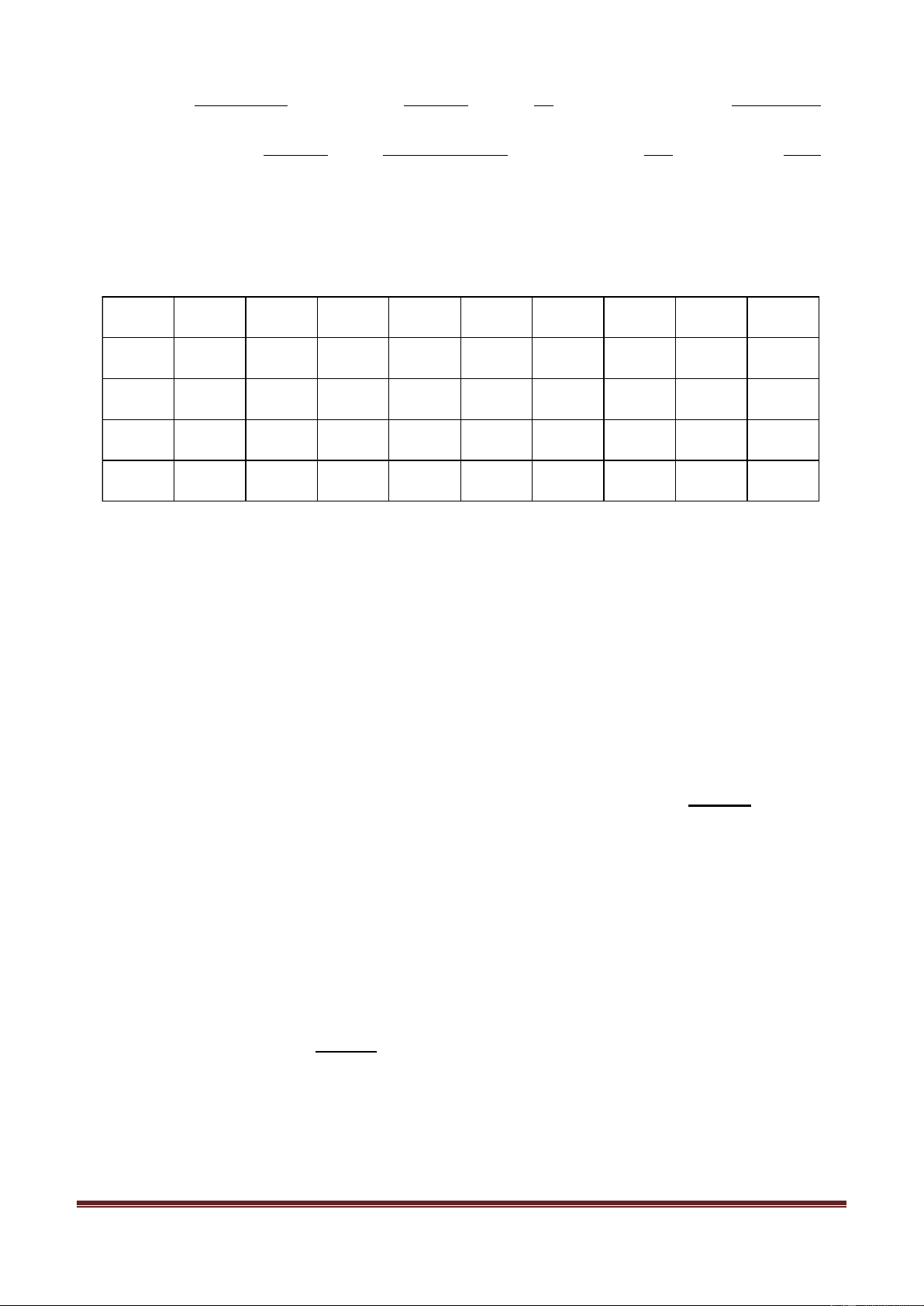
Page 320
Question 49: Information on the Romans can find not only in these books but also on the Internet.
A
B C
D
Question 50: Students suppose to read all the questions carefully and find out the answers to them.
A B
C
D
-----THE END-----
ĐÁP ÁN
Question 1. A
Kiến thức: Từ vựng
Giải thích:
HƯỚNG DẪN GIẢI CHI TIẾT
Đầu tiên loại từ “neither”, vì neither mang nghĩa “cả hai đều không”, và phía sau phải có “nor”
Phân biệt các từ “no – not – none”:
Từ “no” đứng trước danh từ; Từ “not” thường đi sau một động từ to be; Từ “none” dùng như một
đại từ, nếu đi sau là danh từ thì phải thêm “of”
Drone racing is an exciting new sport, that has become popular faster than (1) other sport
before it.
Tạm dịch: Đua xe không người lái là một môn thể thao mới thú vị, đã trở nên phổ biến nhanh hơn
so với không môn thể thao nào trước đó.
Question 2. B
Kiến thức: Từ vựng
Giải thích:
link (v): nối, liên kết attach (v): gắn với, kèm theo
take (v): mang, lấy connect (v): liên kết, nối
Every drone has a camera (2) to it so that spectators can also view flights either on a big
screen or with special headgear.
Tạm dịch: Mỗi máy bay không người lái đều có gắn camera để khán giả cũng có thể xem các
chuyến bay trên màn hình lớn hoặc với mũ đội đầu đặc biệt.
1-A
2-B
3-B
4-C
5-A
6-B
7-A
8-D
9-D
10-C
11-B
12-B
13-A
14-A
15-C
16-D
17-A
18-D
19-B
20-D
21-A
22-D
23-C
24-B
25-A
26-D
27-C
28-B
29-D
30-B
31-D
32-D
33-A
34-D
35-A
36-B
37-C
38-C
39-D
40-A
41-B
42-B
43-A
44-D
45-A
46-B
47-A
48-C
49-B
50-A

Page 321
Question 3. B
Kiến thức: Từ vựng, từ loại
Giải thích:
Competitor (n): người cạnh tranh, đối thủ
Competition (n): cuộc tranh tài, cuộc thi đấu
Compete (v): cạnh tranh
Competitiveness (n): tính cạnh tranh, tính đua tranh
The races take place either outdoors - in big stadiums, or indoors in old warehouses and sports
arenas. (3) are short because the battery time of drones is limited.
Tạm dịch: Các cuộc đua diễn ra ngoài trời - trong các sân vận động lớn, hoặc trong nhà trong các
nhà kho cũ và các đấu trường thể thao. Các cuộc thi rất ngắn vì thời gian sử dụng pin của máy bay
không người lái bị hạn chế.
Question 4. C
Kiến thức: Liên từ
Giải thích:
However: tuy nhiên Moreover: thêm vào đó
Although: mặc dù Because: bởi vì
(4) drone racing started only a few years ago there are already international competitions
that take place all over the world.
Tạm dịch: Mặc dù đua máy bay không người lái chỉ bắt đầu từ vài năm trước, đã có những cuộc thi
quốc tế diễn ra trên toàn thế giới.
Question 5. A
Kiến thức: Mệnh đề quan hệ
Giải thích:
Trong câu này ta dùng mệnh đề quan hệ “where” thay thế cho một địa điểm, nơi chốn
Races are also recorded and uploaded to YouTube and other video platforms (5) they can be
viewed over and over again.
Tạm dịch: Các cuộc đua cũng được ghi lại và tải lên YouTube và các nền tảng video khác, nơi
chúng có thể được xem đi xem lại nhiều lần.
Dịch bài đọc:
Đua xe không người lái là một môn thể thao mới thú vị, đã trở nên phổ biến nhanh hơn so với
không môn thể thao nào trước đó. Phi công điều khiển máy bay không người lái nhỏ và nhẹ, nhưng
mạnh mẽ cùng với các khóa học với chướng ngại vật. Họ bay qua cửa và xung quanh lá cờ ở tốc độ
hơn một trăm dặm một giờ.
Họ điều khiển máy bay không người lái bằng cách sử dụng mũ giống như VR. Mỗi máy bay không
người lái đều có gắn camera để khán giả cũng có thể xem các chuyến bay trên màn hình lớn hoặc
với mũ đội đầu đặc biệt.
Các cuộc đua diễn ra ngoài trời - trong các sân vận động lớn, hoặc trong nhà trong các nhà kho cũ
và các đấu trường thể thao. Các cuộc thi rất ngắn vì thời gian sử dụng pin của máy bay không người
lái bị hạn chế.
Mặc dù đua máy bay không người lái chỉ bắt đầu từ vài năm trước, đã có những cuộc thi quốc tế

Page 322
diễn ra trên toàn thế giới. Trong các giải đấu chuyên nghiệp, các phi công máy bay không người lái

Page 323
cạnh tranh giành hàng ngàn đô la. Vào tháng 3, World Drone Prix đã được tổ chức tại Dubai. Một
thiếu niên 16 tuổi người Anh không chỉ tham gia một cuộc đua mà còn nhận được số tiền thưởng
250 000 đô la.
Truyền hình và các phương tiện truyền thông khác đã biết về đua xe không người lái. ESPN, một
kênh thể thao của Mỹ, sẽ phát sóng các cuộc đua máy bay không người lái quốc tế bắt đầu từ tháng
8 này. Các cuộc đua cũng được ghi lại và tải lên YouTube và các nền tảng video khác, nơi chúng có
thể được xem đi xem lại nhiều lần.
Question 6. B
Kiến thức: Mệnh đề đồng chủ ngữ
Giải thích: Ở đây hai vế câu đều đồng chủ ngữ, và xét về nghĩa (được nói về việc bị sa thải), thì
chủ ngữ phù hợp là Mary
Tạm dịch: Khi được cho biết về việc cô bị sa thải, Mary đã bị sốc.
Question 7. A
Kiến thức: Từ vựng, từ loại
Giải thích:
confidential (a): kín, mật
confident (a): tự tin
confidence (n): sự tự tin
confidant (n): bạn tâm tình
Vị trí này ta cần một tính từ, vì phía trước có “to be” và diễn tả bản chất tính chất của sự vật sự việc.
Về nghĩa, tính từ “confidential” phù hợp hơn
Tạm dịch: Bây giờ, đừng nói với ai khác những gì tôi vừa nói với bạn. Hãy nhớ nó là bí mật
Question 8. D
Kiến thức: others = other + danh từ, mang nghĩa: những cái khác
Giải thích:
the other + danh từ đếm được số ít, mang nghĩa: cái còn lại, người còn lại
another: một cái khác, một người khác
the others = the other + danh từ đếm được số nhiều. Nghĩa: những cái còn lại, những người còn lại
Tạm dịch: Anh mua ba cái áo; Một cái cho anh và những cái khác cho con của anh.
Question 9. D
Kiến thức: Cụm từ
Giải thích: Ta có cụm “refresh one‟s memory” (v): nhớ lại
dịch: Làm ơn hãy để tôi nhớ lại trước khi trả lời những câu hỏi
Question 10. C
Kiến thức: Từ vựng
Giải thích:
by heart: thuộc lòng
by chance: tình cờ
by far: cho đến nay
by myself: tự mình

Page 324
Tạm dịch: Đây là công việc khó khăn nhất tôi từng phải làm.

Page 325
Question 11. B
Kiến thức: Mạo từ
Giải thích:
“non-verbal language” là một tập rộng lớn, duy nhất, không dùng mạo từ
Trước “aspect” ta dùng mạo từ không xác định, đây là danh từ chung bổ nghĩa cho chủ ngữ
Tạm dịch: Ngôn ngữ phi ngôn ngữ là một khía cạnh quan trọng của giao tiếp giữa các cá nhân.
Question 12. B
Kiến thức: Liên từ
Giải thích:
since: kể từ, bởi vì although + mệnh đề: mặc dù, dù cho
despite + danh từ/cụm danh từ: mặc dù, dù cho because: bởi vì, do
Tạm dịch: Năng lượng mặt trời không được sử dụng rộng rãi mặc dù nó thân thiện với môi trường
Question 13. A
Kiến thức: Cụm từ
Giải thích: Ta có cụm “to warn sb about sth” (v): cảnh báo ai về cái gì
Tạm dịch: Biển báo này cảnh báo với mọi người về sự nguy hiểm của dòng sông này.
Question 14. A
Kiến thức: Cụm từ
Giải thích: Ta có cụm “to be on good terms with”: quan hệ tốt với…
Tạm dịch: Họ luôn giữ mối quan hệ tốt với những người hàng xóm bên cạnh vì lợi ích của trẻ nhỏ.
Question 15. C
Kiến thức: Từ vựng
Giải thích:
fiction” là danh từ không đếm được, do đó ở đây ta chỉ có thể dùng “Much of”. “Many of”, “A large
number of”, “A few of” đều dùng với danh từ đếm được.
Tạm dịch: Phần lớn tiểu thuyết của cô mô tả phụ nữ trong hôn nhân không hạnh phúc.
Question 16. D
Kiến thức: Cấu trúc với forget, dạng bị động
Giải thích:
forget + V-ing: nhớ đã làm gì
forget + to V: nhớ phải làm gì
Về nghĩa câu này ta dùng forget + V-ing. Đáp án A, B loại
Đồng thời về nghĩa ở đây ta dùng dạng bị động (được trao tặng), do đó đáp án C loại
Tạm dịch: Jane sẽ không bao giờ quên việc được nhận giải nhất trong một cuộc thi danh giá như
vậy.
Question 17. A
Kiến thức: Cụm từ
Giải thích: Ta có cụm “do good/harm to…” (v): có lợi/có hại cho…

Page 326
Tạm dịch: Uống quá nhiều rượu được cho là có hại cho sức khỏe của chúng ta

Page 327
Question 18. D
Kiến thức: Cụm từ, so sánh bằng
Giải thích:
Ta có cấu trúc so sánh bằng: as + adj/adv + as
Ta có cụm “nowhere near”: chắc chắn không, còn lâu mới…
Tạm dịch: Tôi được cho là không tham vọng như anh trai tôi
Question 19. B
Kiến thức: Cụm từ
Giải thích: Ta có cấu trúc "not get/ have a wink of sleep" hoặc "not sleep a wink": không ngủ được
tý nào, không chợp mắt được tý nào.
Tạm dịch: Tôi cảm thấy thật khủng khiếp, tôi đã không ngủ được tý nào đêm hôm qua.
Question 20. D
Kiến thức: Phát âm “-l”
Giải thích:
half /hɑ:f/ calm /kɑ:m/
chalk /t∫ɔ:k/ culture /'kʌlt∫ə[r]/
Phần gạch chân câu D được phát âm là /l/ còn lại là âm câm
Question 21. A
Kiến thức: Phát âm “-ate”
Giải thích:
decorate /ˈdekəreɪt/ passionate /ˈpæʃənət/
undergraduate /ˌʌndəˈɡrædʒuət/ temperate /ˈtempərət/
Phần gạch chân câu A được phát âm là /ei/ còn lại là /ə/
Question 22. D
Kiến thức: Trọng âm của từ có 2 âm tiết
Giải thích:
conceal /kən'si:l/ contain /kən'tein/
conserve /kən'sɜ:v/ conquer /'kɒŋkə[r]/
Tạm dịch: Câu D trọng âm rơi vào âm tiết thứ nhất, còn lại là thứ 2
Question 23. C
Kiến thức: Trọng âm của từ có 3 âm tiết trở lên
Giải thích:
technology /tek'nɒlədʒi/ environment /in'vaiərənmənt/
superstition /,su:pə'sti∫n/ predominance /pri'dɒminəns/
Câu C trọng âm rơi vào âm tiết thứ 3, còn lại là thứ 2
Question 24. B
Kiến thức: Từ vựng, từ đồng nghĩa
Giải thích:

Page 328
didn't bat an eye: tỉnh bơ, không hề chớp mắt, điềm nhiên
didn't want to see: không muốn thấy didn't show surprise: không tỏ ra ngạc nhiên
wasn't happy: không vui didn't care: không quan tâm
=> didn't bat an eye = didn't show surprise
Tạm dịch: Anh tỉnh bơ khi nhận ra mình đã trượt kỳ thi một lần nữa.
Question 25. A
Kiến thức: Từ vựng, từ đồng nghĩa
Giải thích:
get round (v): thuyết phục
persuade (v): thuyết phục offer (v): đề nghị
support (v): cổ vũ permit (v): cho phép
=> get round = persuade
Tạm dịch: Mary cuối cùng đã thuyết phục được cha mẹ nghiêm khắc của mình để cho cô ấy đi du
ngoạn ba ngày với các bạn cùng lớp.
Question 26. D
Kiến thức: Từ vựng, từ trái nghĩa
Giải thích:
partial (a): một phần
half: một nửa
halfway: nửa đường
effective (a): hiệu quả
complete (a): hoàn toàn, hoàn thành
=> partial >< complete
Tạm dịch: Tôi chỉ có thể đề xuất một giải pháp một phần cho cuộc khủng hoảng trong công ty
Question 27. C
Kiến thức: Từ vựng, từ trái nghĩa
Giải thích:
be snowed under (with sth): có quá nhiều việc phải làm
busy with: bận rộn với
relaxed about: thư giãn về
free from: thoải mái, tự do
fond of: thích thú
=> be snowed under (with sth) >< free from
Tạm dịch: Xin lỗi, mình không thể đến bữa tiệc của bạn được. Hiện tại mình có quá nhiều việc
phải làm.
Question 28. B
Kiến thức: Văn hoá giao tiếp
Tạm dịch:
Susan vô tình giẫm lên chân của Denise.
- Susan: “Ối! Tôi xin lỗi, Denise.”
- Denise: “ .”

Page 329
A. Bạn không nên làm điều đó. B. Không sao đâu

Page 330
C. Không có gì. (Đáp lại lời cảm ơn) D. Nó thật vô nghĩa
Question 29. D
Kiến thức: Văn hoá giao tiếp
Tạm dịch:
- Hana: “Cuốn sách này thực sự thú vị và đầy tính giáo dục.”
- Jennifer: “ .”
A. Tôi rất muốn B. Đừng đề cập đến nó
C. Thật tốt khi bạn nói như vậy. D. Tôi không thể đồng ý hơn. (=Tôi hoàn toàn đồng ý)
Question 32. D
Kiến thức: Đọc hiểu
Giải thích:
Tác giả nói rằng chất béo phục vụ tất cả các chức năng cơ thể sau NGOẠI TRỪ
A. thúc đẩy cảm giác no B. cách nhiệt và bảo vệ cơ thể
C. cung cấp năng lượng D. kiểm soát tăng cân
Thông tin:
- In the diet, fats cause food to remain longer in the stomach, this increasing the feeling of fullness
for some time after a meal is eaten.
- Fatty deposits in the body have an insulating and protective value.
- In addition to providing energy, fats have several other functions in the body.
Tạm dịch:
- Trong chế độ ăn kiêng, chất béo gây ra việc thức ăn giữ lâu trong dạ dày do đó tăng cảm giác no
trong một thời gian dài sau khi ăn.
- Mỡ trong cơ thể có thể cách nhiệt và bảo vệ.
- Ngoài việc cung cấp năng lượng, chất béo còn có một số chức năng khác trong cơ thể.
Chỉ có đáp án D không được nhắc đến
Question 33. A
Kiến thức: Đọc hiểu

Page 331
Giải thích:

Page 332
Axit béo linoleic được đề cập trong đoạn văn như
A. một chất dinh dưỡng thiết yếu cho con người
B. hữu ích hơn axit arachidonic
C. ngăn ngừa tăng cân ở chuột
D. một chất dinh dưỡng có trong hầu hết các loại thực phẩm
Thông tin: Two fatty acids, linoleic and arachidonic acids, prevent these abnormalities and hence
are called essential fatty acids. […] Most nutritionists consider linoleic fatty acid an essential
nutrient for humans.
Tạm dịch: Hai axit béo, linoleic và axit arachidonic, ngăn chặn những bất thường và do đó được
gọi là những axit béo thiết yếu. […] Hầu hết các chuyên gia dinh dưỡng xem xét axit béo linoleic là
một chất dinh dưỡng cần thiết cho con người.
Question 34. D
Kiến thức: Đọc hiểu
Giải thích:
Cụm từ “these abnormalities” trong dòng 10 và 11 đề cập đến
A. một tình trạng gây ra bởi thực phẩm chiên
B. chất béo nằm ở vị trí chiến lược
C. đường cong trên cơ thể con người
D. chấm dứt tăng trưởng, da xấu đi và hệ thống sinh sản bị hư hại
“these abnormalities” nhắc đến những điều ở câu trước đó: When rats are fed a fat-free diet, their
growth eventually ceases, their skin becomes inflamed and scaly, and their reproductive
systems are damaged. Two fatty acids, linoleic and arachidonic acids, prevent these
abnormalities and hence are called essential fatty acids.
Tạm dịch: Khi những con chuột được ăn chất béo quá độ thì tăng trưởng của chúng sẽ chấm dứt,
da của chúng bị viêm và có vảy, hệ sinh sản bị phá hủy. Hai axit béo, linoleic và axit arachidonic,
ngăn chặn những bất thường và do đó được gọi là những axit béo thiết yếu.
Dịch bài đọc:
Ngoài việc cung cấp năng lượng, chất béo còn có một số chức năng khác trong cơ thể. Các vitamin
A,D, E và K được hòa tan trong chất béo như tên của nó. Nguồn cung cấp các vitamin có dầu cao
hoặc hàm lượng chất béo, và các vitamin được lưu trữ trong các mô mỡ của cơ thể. Trong chế độ ăn
kiêng, chất béo gây ra việc thức ăn giữ lâu trong dạ dày do đó tăng cảm giác no trong một thời gian
dài sau khi ăn. Chất béo cho thêm nhiều hương vị và cùng với thức ăn, chiếm phần lớn trong các
loại thực phẩm chiên. Mỡ trong cơ thể có thể cách nhiệt và bảo vệ. Các đường cong của phụ nữ chủ
yếu là do sự phân bổ một cách đầy chiến lược của chất béo.
Dù vậy có một lượng chất béo nhất định trong chế độ ăn kiêng là cần thiết đối với sức khỏe con
người thì không phải chắc chắn đều được biết đến. Khi những con chuột được ăn chất béo quá độ
thì tăng trưởng của chúng sẽ chấm dứt, da của chúng bị viêm và có vảy, hệ sinh sản bị phá hủy. Hai
axit béo, linoleic và axit arachidonic, ngăn chặn những bất thường và do đó được gọi là những axit
béo thiết yếu. Chúng cũng được đòi hỏi phải có bởi một số loại động vật khác nhưng vai trò của
chúng trong loài người đang gây tranh cãi. Hầu hết các chuyên gia dinh dưỡng xem xét axit béo
linoleic là một chất dinh dưỡng cần thiết cho con người.
Question 35. A

Page 333
Kiến thức: Đọc hiểu

Page 334
Giải thích:
Mục đích của bài viết là để
A. giải thích các nghiên cứu mới về sự phát triển bộ não của trẻ sơ sinh.
B. mô tả cách thức hoạt động của bộ não của em bé mới sinh.
C. so sánh bộ não của người lớn và trẻ em.
D. chứng minh rằng ngày nay trẻ sơ sinh thông minh hơn xưa.
Question 36. B
Kiến thức: Đọc hiểu
Giải thích:
Theo đoạn đầu tiên
A. hầu hết các khía cạnh của sự phát triển của trẻ em được hiểu khá rõ.
B. một số trẻ năm tuổi có những người bạn tưởng tượng.
C. trẻ em sử dụng công nghệ nhiều hơn ngày nay.
D. công nghệ đã được sử dụng trong phẫu thuật não trẻ em.
Thông tin: By the age of five, a child can talk, ride a bike and invent imaginary friends.
Tạm dịch: Đến năm tuổi, một đứa trẻ có thể nói chuyện, đi xe đạp và nghĩ ra những người bạn
tưởng tượng.
Question 37. C
Kiến thức: Đọc hiểu
Giải thích:
Phát biểu nào được hỗ trợ bởi đoạn thứ hai?
A. Não người trưởng thành có nhiều tế bào thần kinh hơn não của trẻ sơ sinh.
B. Trẻ sơ sinh và trẻ ba tuổi có cùng số lượng tế bào thần kinh.
C. Trải nghiệm ban đầu có ảnh hưởng đến sự phát triển não bộ
D. Các kết nối giữa các phần của não vẫn giống nhau khi một đứa trẻ lớn lên.
Thông tin: A study in 2010 showed that the experiences a child has in their first few years affect
the development of the brain.
Tạm dịch: Một nghiên cứu vào năm 2010 cho thấy những trải nghiệm của một đứa trẻ trong vài
năm đầu tiên ảnh hưởng đến sự phát triển của não.
Question 38. C
Kiến thức: Đọc hiểu
Giải thích:
Theo đoạn thứ hai, điều nào sau đây có thể ảnh hưởng đến IQ?
A. ở với người lớn nhiều B. kết nối với các em bé khác
C. chú ý đến em bé D. tiếp cận thông tin càng sớm càng tốt
Thông tin: It showed that children who received more attention often had higher IQs.
Tạm dịch: Nó cho thấy rằng những đứa trẻ nhận được nhiều sự chú ý hơn thường có IQ cao hơn.
Question 39. D
Kiến thức: Đọc hiểu
Giải thích:
Nó có thể được suy ra từ đoạn văn rằng

Page 335
A. Một mô hình như „A-B-C‟ dễ hiểu hơn.

Page 336
B. Bộ não của trẻ sơ sinh không thể nhận ra các mẫu âm thanh khác nhau.
C. Không biết vùng não nào của bé xử lý lời nói.
D. Trẻ thực sự có thể học các quy tắc ngữ pháp khi còn rất nhỏ.
Thông tin: So babies are starting to learn grammatical rules from the beginning of life.
Tạm dịch: Vì vậy, các bé bắt đầu học các quy tắc ngữ pháp từ đầu đời.
Question 40. A
Kiến thức: Đọc hiểu
Giải thích:
Theo bài văn, phát biểu nào là đúng?
A. Các thí nghiệm tập trung vào ngôn ngữ đã cung cấp cho các nhà nghiên cứu thông tin mới.
B. Trẻ nghe các ngôn ngữ khác nhau phát triển khác nhau.
C. Sự phát triển của ngôn ngữ là điều dễ học nhất ở trẻ sơ sinh.
D. Trẻ chỉ có thể hiểu các quy tắc ngữ pháp của một ngôn ngữ trong giai đoạn cụ thể.
Thông tin: Researchers also know that babies need to hear a lot of language in order to understand
grammar rules. But there is a big difference between listening to television, audio books or the
internet, and interacting with people.
Tạm dịch: Các nhà nghiên cứu cũng biết rằng các bé cần nghe nhiều ngôn ngữ để hiểu các quy tắc
ngữ pháp. Nhưng có một sự khác biệt lớn giữa nghe tivi, sách âm thanh hoặc internet và tương tác
với mọi người.
Question 41. B
Kiến thức: Đọc hiểu
Giải thích:
Nghiên cứu được mô tả trong đoạn cuối làm gì?
A. so sánh tác dụng của các ngôn ngữ khác nhau
B. chia em bé thành hai nhóm với cách điều trị khác nhau
C. điều tra liệu em bé có thể học tiếng Trung Quốc
D. dạy bé ngoại ngữ thông qua nghe video.
Thông tin: One study compared two groups of nine-month-old American babies. One group
watched videos of Mandarin Chinese sounds. In the other group, people spoke the same sounds to
the babies.
Tạm dịch: Một nghiên cứu đã so sánh hai nhóm trẻ sơ sinh Mỹ 9 tháng tuổi. Một nhóm đã xem
video về âm thanh tiếng Trung Quốc. Trong nhóm khác, mọi người nói những âm thanh tương tự
với các em bé.
Question 42. B
Kiến thức: Đọc hiểu
Giải thích:
Kết luận chính từ nghiên cứu được mô tả trong đoạn cuối là gì?
A. Trẻ có thể hiểu được TV ở độ tuổi chín tháng.
B. Tương tác xã hội có ảnh hưởng lớn đến não.
C. Xem video là một cách tốt để phát triển trí não của trẻ.
D. Tiếng Trung phổ thông không quá khó để học đối với trẻ sơ sinh Mỹ.
Thông tin: It suggests that social experience is essential to successful brain development in babies.

Page 337
Tạm dịch: Nó cho thấy kinh nghiệm xã hội là điều cần thiết để phát triển trí não thành công ở trẻ sơ
sinh.
Dịch bài đọc:
Một em bé sơ sinh có thể nhìn, nghe và cảm nhận. Đến năm tuổi, một đứa trẻ có thể nói chuyện, đi
xe đạp và nghĩ ra những người bạn tưởng tượng. Làm thế nào phát triển này xảy ra? Chúng ta
không quá hiểu cách ngôn ngữ, suy nghĩ và lập kế hoạch phát triển. Bây giờ các nhà khoa học đang
sử dụng công nghệ mới để 'nhìn' vào bộ não của trẻ em. Và họ đang khám phá thông tin mới về
cách phát triển não bộ của em bé.
Một nghiên cứu vào năm 2010 cho thấy những trải nghiệm của một đứa trẻ trong vài năm đầu tiên
ảnh hưởng đến sự phát triển của não. Nó cho thấy rằng những đứa trẻ nhận được nhiều sự chú ý hơn
thường có IQ cao hơn. Bộ não của một đứa trẻ sơ sinh có gần một trăm tỷ tế bào thần kinh. Đây là
con số tương tự như bộ não của người trưởng thành. Khi chúng lớn lên, một em bé nhận được thông
tin thông qua các giác quan của thị giác, thính giác, khứu giác, vị giác và xúc giác. Thông tin này
tạo ra các kết nối giữa các phần khác nhau của não. Ở tuổi lên ba, có hàng trăm nghìn tỷ kết nối.
Một thí nghiệm đã xem hình ảnh về bộ não của trẻ sơ sinh trong khi chúng đang lắng nghe những
âm thanh khác nhau. Các âm thanh là trong các chuỗi khác nhau. Ví dụ, một chuỗi là mu-ba-ba.
Đây là mẫu 'A-B-B'. Một trình tự khác là mu-ba-ge. Đây là mẫu 'A-B-C'. Các hình ảnh cho thấy
phần não chịu trách nhiệm về lời nói hoạt động nhiều hơn trong các mẫu 'A-B-B'. Điều này cho
thấy các bé có thể cho biết sự khác biệt giữa các mẫu khác nhau. Thí nghiệm này rất thú vị vì các
chuỗi từ rất quan trọng đối với ngữ pháp và ý nghĩa. So sánh hai câu với cùng một từ theo một thứ
tự khác nhau: J'ohn giết gấu' r rất khác với 'Con gấu giết John'. Vì vậy, các bé bắt đầu học các quy
tắc ngữ pháp từ đầu đời.
Các nhà nghiên cứu cũng biết rằng các bé cần nghe nhiều ngôn ngữ để hiểu các quy tắc ngữ pháp.
Nhưng có một sự khác biệt lớn giữa nghe tivi, sách âm thanh hoặc internet và tương tác với mọi
người. Một nghiên cứu đã so sánh hai nhóm trẻ sơ sinh Mỹ 9 tháng tuổi. Một nhóm đã xem video
về âm thanh tiếng Trung Quốc. Trong nhóm khác, mọi người nói những âm thanh tương tự với các
em bé. Kết quả kiểm tra cho thấy nhóm thứ hai có thể nhận ra các âm thanh khác nhau, tuy nhiên
nhóm thứ nhất không học được gì. Nhà khoa học, Patricia Kuhl, cho biết kết quả này rất đáng ngạc
nhiên. Nó cho thấy kinh nghiệm xã hội là điều cần thiết để phát triển trí não thành công ở trẻ sơ
sinh.
Question 43. A
Kiến thức: Modal verb, cấu trúc với It‟s time
Tạm dịch:
Bạn phải ra quyết định bây giờ.
A. Đã đến lúc bạn phải quyết định. B. Ra quyết định là cần thiết.
C. Bạn lẽ ra đã nên ra quyết định. D. Có thể ra quyết định.
Câu B, C, D không phù hợp về nghĩa.
Question 44. D
Kiến thức: Reported speech
Tạm dịch:
“Không, không, bạn thực sự phải ở lại lâu hơn một chút!” Các chàng trai nói.
A. Các chàng trai từ chối tôi ở lại lâu hơn một chút

Page 338
B. Các chàng trai từ chối để tôi ở lại lâu hơn một chút.

Page 339
C. Các chàng trai không đồng ý để ở lại lâu hơn một chút.
D. Các chàng trai khăng khăng tôi ở lại lâu hơn một chút.
Câu A, B, C không phù hợp về nghĩa.
Question 45. A
Kiến thức: Modal verb
Giải thích: Should have done sth: lẽ ra nên làm gì (nhưng đã không làm)
Tạm dịch:
Bạn lẽ ra nên thuyết phục anh ấy thay đổi suy nghĩ của mình.
A. Điều cần thiết là thuyết phục anh ấy thay đổi suy nghĩ nhưng bạn đã không làm
B. Bạn đã không thuyết phục anh ấy thay đổi vì tâm trí của anh ấy.
C. Bạn nên thuyết phục anh ấy thay đổi ý định.
D. Bạn đã thuyết phục anh ấy thay đổi ý định nhưng anh ấy đã không lắng nghe.
Câu B, C, D không phù hợp về nghĩa.
Question 46. B
Kiến thức: Liên từ
Tạm dịch:
Cô đã nộp đơn thôi việc. Cô dự định bắt đầu công việc mới vào tháng 1.
A. Cô đã nộp đơn thôi việc, dự định bắt đầu công việc mới vào tháng 1.
B. Cô đã nộp đơn thôi việc với mục đích bắt đầu công việc mới vào tháng 1.
C. Đơn thôi việc của cô đã được nộp với mục đích bắt đầu công việc mới vào tháng 1.
D. Đơn thôi việc của cô đã được nộp để cô ấy bắt đầu công việc mới vào tháng 1.
Câu A, C, D không phù hợp về nghĩa.
Question 47. A
Kiến thức: Đảo ngữ với tính từ
Giải thích: Ta có cấu trúc đảo ngữ với tính từ ở đầu câu: Adj + as/though + S + be, S + V +…
Tạm dịch: Kế hoạch có thể khéo léo. Nó sẽ không bao giờ hoạt động trong thực tế.
=> Dù có thể khéo léo, kế hoạch sẽ không bao giờ hoạt động trong thực tế.
Question 48. C
Kiến thức: Quá khứ phân từ
Giải thích:
Sửa: kicking forwards => kicked forwards
Ta dùng quá khứ phân từ tạo mệnh đề quan hệ rút gọn với dạng bị động. Ở đây “kicked” được hiểu
là “which is kicked”
Tạm dịch: Một trận đấu bóng đá bắt đầu với quả bóng được đá về phía trước từ một vị trí ở giữa
sân.
Question 49. B
Kiến thức: Dạng bị động
Giải thích:
Sửa: can find => can be found
Chủ ngữ trong câu là vật, cho nên ta dùng bị động. Cấu trúc bị động với động từ khuyết thiếu:

Page 340
modal verb + be + PP

Page 341
Tạm dịch: Thông tin về người La Mã không chỉ có thể được tìm thấy trong sách mà còn cả trên
Internet.
Question 50. A
Kiến thức: Cụm từ
Giải thích:
Sửa: suppose => are supposed
Ta có cụm “to be supposed to do sth”: có nghĩa vụ, phải làm gì
Tạm dịch: Học sinh phải đọc tất cả các câu hỏi một cách cẩn thận và tìm ra câu trả lời cho chúng.

Page 342
SỞ GD & ĐT HÀ NỘI ĐỀ THI THỬ THPT QUỐC GIA LẦN 1
ĐẠI HỌC SƯ PHẠM HN Môn thi: Tiếng Anh
Thời gian làm bài: 60 phút (không kể thời gian phát đề)
Mã đề 441
Họ, tên thí sinh: .............................................. Số báo danh: ..............................................
Mark the letter A, B, C, or D on your answer sheer to indicate the underlined part that needs
correction in each of the following questions.
Question 1: It is necessary and required that dental technicians and others who work with X-rays
limit their exposure to these highly penetrating rays.
A. and required B. and others C. highly D. their
Question 2: In a survey of suburban homeowners, a lawn-mower was rated one of the most
important equipments.
A. a lawn mower B. equipments C. In a survey D. the
Question 3: Walking reduces depression and anxiety, lessens stress, self-esteem is raised, and
increases energy.
A. self-esteem is raised B. Walking C. lessens stress D. depression
Mark the letter A, B, C, or D on your answer sheet to indicate the word that differs from the other
three in the position of primary stress in each of the following questions.
Question 4: A. enthusiasm
B. punctuality
C. anniversary
D. intercultural
Question 5: A. treasure
B. appoint
C. advance
D. diverse
Mark the letter A, B, C, or D on your answer sheet to indicate the sentence that best combines
each pair of sentences in the following questions.
Question 6: We haven't received any reply to our letter. It is such an insult.
A. We see it an insult to have received no reply to our letter.
B. We haven't received any reply to our letter yet because it is insulting.
C. We have been insulted by the reply to our letter.
D. We don't find it insulting for not receiving any reply to our letter.
Question 7: Pete had acquired the money through hard work. He was reluctant to give it away.
A. Having acquired the money through hard work, Pete was reluctant to give it away.
B. Although Pete had acquired the money through hard work, he was reluctant to give it away.
C. Having worked hard to earn the money, it couldn't be given away by Pete.
D. Pete had acquired the money through hard work so that he was reluctant to give it away.
Mark the letter A, B, C, or D on your answer sheet to indicate the word(s) OPPOSITE in
meaning to the underlined word(s) in each of the following questions.
Question 8: In 2018 there was a craze for Bitcoin mining in Vietnam due to the belief that it would
bring impressive profits.
A. inclination B. fever C. sorrow D. indifference
Question 9: If Jeff Bezos and his wife split their assets equally. MacKenzie could become the
richest woman in the world overnight.
A. uniformly B. fifty-fifty C. unevenly D. symmetrically
Read the following passage and mark the letter A, B, C, or D on your answer sheer to indicate
the correct answer to each of the questions from 10 to 14.
In the past, technology and progress was very slow. People “invented” farming 12,000 years

Page 343
ago but it took 8,000 years for the idea to go around the world. Then, about 3,500 years ago, people

Page 344
called “potters” used round wheels to turn and make plates. But it took hundreds of years before
some clever person thought, if we join two wheels together and make them bigger, we can use them
to move things
In the last few centuries, things have begun to move faster. Take a 20th-century invention like
the aeroplane, for example. The first acroplane flight on 17 December 1903 only lasted 12 seconds,
and the plane only went 37 metres. It can't have been very exciting to watch, but that flight changed
the world. Sixteen years later, the first plane flew across the Atlantic, and only fifty years after that,
men walked on the moon. Technology is now changing our world faster and faster. So what will the
future bring?
One of the first changes will be the materials we use. Scientists have just invented an amazing
new material called graphene, and soon we will use it to do lots of things. With graphene batteries
in your mobile, it will take a few seconds to charge your phone or download a thousand gigabytes
of information! Today, we make most products in factories, but in the future, scientists will invent
living materials. Then we won't make things like cars and furniture in factories - we will grow
them!
Thirty years ago, people couldn't have imagined social media like Twitter and Facebook. Now
we can't llve without them. But this is only the start. Right now, scientists are putting microchips in
some disabled people's brains, to help them see, hear and communicate better. In the future, we may
all use these technologies. We won't need smartphones to use social media or search the internet
because the internet will be in our heads!
More people will go into space in the future, too. Space tourism has already begun, and a
hundred years from now, there may be many hotels in space. One day, we may get most of our
energy from space too. In 1941, the writer Isaac Asimov wrote about a solar power station in space.
People laughed at his idea then, but we should have listened to him. Today, many people are trying
to develop a space solar power station. After all, the sun always shines above the clouds!
Question 10: The writer says that in the past
A. people didn't invent many things B. people didn't want to use wheels
C. most inventions were to do with farming D. it took time for new ideas to change things
Question 11: Why does the writer use the example of the aeroplane?
A. To explain why transport changed in the 20th century.
B. Because he thinks It's the most important invention in history.
C. To explain how space travel started.
D. To show how an invention developed quickly.
Question 12: What does the writer say about the future of communication?
A. We can't know what the most popular social media will be.
B. Microchips will become faster.
C. We won't use the internet as much.
D. We won't need devices like smartphones.
Question 13: What does the writer say about space solar power?
A. It's an old idea, but people are only starting to develop it now.
B. It's a science fiction idea, and nobody really thinks it will work.
C. It's much easier to build a solar power station in space than on Earth.
D. People tried it in 1941, but they didn't succeed.
Question 14: The best title for the article would be
A. Man in space B. Will computers rule the world?

Page 345
C. More and more inventions D. Progress now and then

Page 346
Read the following passage and mark the letter A, B, C or D on your answer sheet to indicate the
correct answer to each of the questions from 15 to 22.
[1] Advertising helps people recognize a particular brand, persuades them to try it, and tries to
keep them loyal to it. Brand loyalty is perhaps the most important goal of consumer advertising.
Whether they produce cars, canned foods or cosmetics, manufacturers want their customers to make
repeated purchases. [2] The quality of the product will encourage this, of course, but so, too, will
affect advertising.
Advertising relies on the techniques of market research to identify potential users of a product.
[3] Are they homemakers or professional people? Are they young or old? Are they city dwellers or
country dwellers? Such questions have a bearing on where and when ads should be placed. By
studying readership breakdowns for newspapers and magazines as well as television ratings and
other statistics, an advertising agency can decide on the best way of reaching potential buyers.
Detailed research and marketing expertise are essential today when advertising budgets can run into
thousands of millions of dollars. [4]
Advertising is a fast-paced, high-pressure industry. There is a constant need for creative ideas
that will establish a personality for a product in the public's mind. Current developments in
advertising increase the need for talented workers.
In the past, the majority of advertising was aimed at the traditional white family - breadwinner
father, non-working mother, and two children. Research now reveals that only about 6 percent of
American households fit this stereotype. Instead, society is fragmented into many groups, with
working mothers, single people and older people on the rise. To be most successful, advertising
must identify a particular segment and aim its message toward that group.
Advertising is also making use of new technologies. Computer graphics are used to grab the
attention of consumers and to help them see products in a new light. The use of computer graphics
in a commercial for canned goods, for instance, gave a new image to the tin can.
Question 15: What does the passage mainly discuss?
A. How to develop a successful advertising plan.
B. New techniques and technologies of market research
C. The central role of advertising in selling products.
D. The history of advertising in the United States.
Question 16: The word “this” in the first paragraph refers to
A. repeatedly buying the same brand B. the most important goal
C. the quality of the product D. effective advertising
Question 17: It can be inferred from the second paragraph that advertisers must
A. aim their message at homemakers and professional people
B. know about the people who will buy the product
C. place several ads in newspapers and magazines
D. encourage people to try new products
Question 18: According to paragraph 2, market research includes
A. searching for talented workers
B. hiring researchers with background in many fields
C. studying television ratings
D. determining the price of a product
Question 19: The author implies that the advertising industry requires
A. a college-educated workforce B. government regulation

Page 347
C. innovative thinking D. millions of dollars

Page 348
Question 20: According to the passage, most advertising used to be directed at
A. working mothers with children B. older adults
C. unmarried people D. two-parent families with children
Question 21: The word “fragmented” in the fourth paragraph is closet in meaning to
A. divided B. moved C. forced D. collated
Question 22: The following sentence can be added to the passage.
Advertising is an essential part of the marketing process that can be tremendously influential
in selling products.
Where would it best fit in the passage?
A. [1] B. [2] C. [3] D. [4]
Mark the letter A, B, C, or D on your answer sheer to indicate the correct answer to each of the
following questions.
Question 23: We on the beach now if we hadn't missed the plane.
A. will lie B. could be lying C. will be lying D. might have lain
Question 24: My older brother is extremely fond of astronomy, he seems to a lot of
pleasure from observing the stars.
A. possess B. seize C. reach D. derive
Question 25: More out-of-school activities are expected to be incorporated in the new school
proposed by Ministry of Education and Training.
A. curriculum B. handout C. agenda D. schedule
Question 26: It turned out that I have bought Frank a present after all.
A. oughtn't B. mustn't C. needn't D. mightn't
Question 27: , Stan Lee, passed away at the age of 95 due to heart and respiratory failure.
A. Who is the Marvel Comics icon B. Marvel Comics icon
C. The Marvel Comics icon is D. That Marvel Comics icon
Question 28: Most teenagers go through a rebellious for a few years but they soon grow
out of it.
A. duration B. stint C. phase D. span
Question 29: I've just been offered a new job! Things are .
A. clearing up B. making up C. looking up D. turning up
Question 30: The children had to in the principal's office after they took part in a fight.
A. hit the right notes B. beat around the bush
C. play second fiddle D. face the music
Question 31: I didn't like the town at first, but I grew it eventually.
A. loving B. to be loved C. to love D. to be loving
Question 32: The narrow streets were lined with shops.
A. bright-lit B. brightly-lit C. brightly-lightning D. bright-litting
Question 33: According to psychologists, children raised with high of fear in unpredictable
or violent environments experience negative emotions for extended periods of time.
A. grades B. numbers C. quantities D. levels
Question 34: Reports are coming in of a major oil spill in Mediterranean.
A. an B. ø C. the D. a
Question 35: In Hawaii it is to greet visitors to the country with a special garland of
flowers.
A. unaccustomed B. accustomed C. customary D. customized

Page 349
Question 36: Alan for hours but he just doesn't answer his mobile. I hope nothing's wrong.

Page 350
A. I call B. I've been calling C. I'm calling D. I've called
Mark the letter A, B, C, or D on your answer sheer to indicate the sentence that best completes
each of the following exchanges.
Question 37: Two friends Nic and Mat are talking about a sports match.
Nic: “G'day mate. Did you catch the game last night?”
Matt: “ .”
A. I heard you do taekwondo. B. Yes, you're getting a bit closer.
C. You must be right after all. D. No, who played?
Question 38: Charlott is feeling umwell and has to see the doctor, Ben.
Ben: “Do you have a temperature?”
Charlotte: “ .”
A. Yes I think so. It's been a bit high. B. I have a sore back.
C. What seems to be the problem? D. I need a prescription, please.
Mark the letter A, B, C, or D on your answer sheet to indicate the word whose underlined part
differs from the other three in pronunciation in each of the following questions.
Question 39: A. chocolate
B. champagne
C. challenge
D. cheerful
Question 40: A. flora
B. trophy
C. glory
D. orally
Mark the letter A, B, C, or D on your answer sheer to indicate the word(s) CLOSEST in meaning
to the underlined word(s) in each of the following questions.
Question 41: Researchers have found that people are sleeping almost two fewer hours a night than
they were in the 1960s, and our health is deteriorating as a result.
A. improving B. degrading C. purifying D. elevating
Question 42: It was the book "Brief History of Time" that rocketed the physicist Stephen Hawking
to stardom.
A. reputation B. unimportance C. obscurity D. universe
Mark the letter A, B, C, or D on your answer sheel to indicate the sentence that is closest in
meaning to each of the following questions.
Question 43: Realizing the environmental impact of the fashion industry, some bloggers, vloggers
and influencers are now entering the “no-buy” movement.
A. It is a new trend that some bloggers, vloggers and influencers now refuse to buy new stuff
regardless of the environmental impact of the fashion industry.
B. Instead of using the things they have already owned, some bloggers , vloggers and
influencers make a commitment to buy new stuff because of the environmental impact of the
fashion industry.
C. With the fashion industry's environmental impact under consideration, there's a move to
avoid new stuff among some bloggers, vloggers and influencers.
D. Some bloggers, vloggers and influencers, taking fashion industry's environmental impact
into account, now deny buying new products.
Question 44: Right after Vietnam national football team won the AFF Cup 2018, thousands of fans
flocked to the streets to celebrate.
A. No sooner had thousands of fans flocked to the streets to celebrate than Vietnam national
football team won the AFF Cup 2018.
B. Only after thousands of fans flocked to the streets to celebrate did Vietnam national football
team win the AFF Cup 2018.
C. Hardly had Vietnam national football team won the AFF Cup 2018 than thousands of fans

Page 351
flocked to the streets to celebrate.

Page 352
D. Scarcely had Vietnam national football team won the AFF Cup 2018 when thousands of
fans flocked to the streets to celebrate.
Question 45: “What a silly thing to say!”, Martha said.
A. Martha threatened that it was a silly thing to say.
B. Martha exclaimed that it was a silly thing to say.
C. Martha suggested that it was a silly thing to say.
D. Martha offered that it was a silly thing to say.
Read the following passage and mark the letter A, B, C, or D on your answer sheet to indicate the
correct word or phrase that best fits each of the numbered blanks from 46 to 50.
MENTORING
Many adults in America and increasing numbers elsewhere take part in mentoring schemes. A
mentor is an adult who provides support and friendship to a young person. There are numerous
different (46) of mentoring: passing on skills, sharing experiences, offering guidance.
Sometimes the most helpful thing to do is just listen. Mentoring is open to anybody - no particular
(47) experience is required, just a desire to make a difference to the life of a young person
who needs help. This may seem a difficult thing at first, but many people find they have a real talent
for it.
The support of a mentor can play an important part in a child's development and can often
make up (48) a lack of guidance in a young person's life. It can also improve young people's
attitudes towards society and build up their confidence in dealing with life's challenges. For the
mentor, it can be incredibly rewarding to know that they have had a significant influence on a child
and helped to give the best possible (49) in life. Indeed, it is not only adults who are capable
of taking on this role. There is now an increasing (50) for teenagers to mentor young
children, for example by helping them with reading or other school work.
Question 46: A. times
B. approach
C. ways
D. supplies
Question 47: A. difficult
B. trained
C. skilled
D. professional
Question 48: A. with
B. for
C. over
D. to
Question 49: A. difficulty
B. chance
C. availability
D. risk
Question 50: A. wish
B. want
C. demand
D. lack
-----THE END-----

Page 353
ĐÁP ÁN

Page 354
1-C
2-B
3-A
4-A
5-A
6-A
7-B
8-D
9-C
10-D
11-D
12-D
13-A
14-D
15-B
16-A
17-B
18-C
19-C
20-D
21-A
22-A
23-B
24-D
25-A
26-C
27-B
28-D
29-C
30-D
31-C
32-B
33-D
34-C
35-C
36-B
37-D
38-A
39-B
40-B
41-B
42-A
43-D
44-D
45-B
46-C
47-D
48-D
49-B
50-C
MA TRẬN
+ Mức độ đề thi: Khá khó
ĐÁNH GIÁ
+ Nhận xét đề thi: Nhìn chung đề thi này kiến thức chủ yếu lớp 12 với mức độ câu hỏi có tính
phân loại tốt nên có thể phân loại được học sinh khá, giỏi. Điểm chú ý của đề này phần từ vựng khá
phong phú cả trong sách giáo khoa và ngoài sách giáo khoa, khó và lạ nên có nhiều câu phân loại
cao.Đề này có thể dành cho học sinh rèn luyện để lấy điểm 8, 9 trong kì thi trung học phổ thông
quốc gia.Cấu trúc đề thi sát với cấu trúc đề minh họa 2019. Đề này khó hơn với đề minh họa của bộ
giáo dục.

Page 355
Question 1. C
Kiến thức: Từ vựng, từ loại
Giải thích:
Sửa: highly => high
HƯỚNG DẪN GIẢI CHI TIẾT
Trong câu này ta phân biệt giữa hai trạng từ:
- high (adv): cao, ở mức cao
- highly (adv): vô cùng, rất, cực kỳ
Về nghĩa ta sử dụng “high” hợp lý hơn
Tạm dịch: Điều cần thiết và bắt buộc là các kỹ thuật viên nha khoa và những người khác làm việc
với tia X hạn chế tiếp xúc với các tia xuyên thấu cao này.
Question 2. B
Kiến thức: Từ vựng
Giải thích:
Sửa: equipments => equipment hoặc pieces of equipment
Danh từ “equipment” là danh từ không đếm được, do đó ta không thể dùng “s” được. Ngoài ra còn
một cách sửa lỗi khác, chính là thêm một danh từ đếm được số nhiều khác ở trước (pieces)
Tạm dịch: Trong một cuộc khảo sát của các chủ nhà ở ngoại ô, một máy cắt cỏ được đánh giá là
một trong những thiết bị quan trọng nhất.
Question 3. A
Kiến thức: Chủ động bị động
Giải thích:
Sửa: self-esteem is raised => raises self-esteem
Trong câu này đang sử dụng dạng chủ động, các vế còn lại đều sử dụng dạng “động từ + danh từ”,
cho nên ở phần này không thể tự dưng đổi thành bị động.
Tạm dịch: Đi bộ làm giảm trầm cảm và lo lắng, giảm căng thẳng, tăng lòng tự trọng và tăng năng
lượng.
Question 4. A
Kiến thức: Trọng âm của từ có 3 âm tiết trở lên
Giải thích:
enthusiasm /in'θju:ziæzəm/ punctuality /,pʌŋkt∫ʊ'æləti/
anniversary /,æni'vɜ:səri/ intercultural /ˌɪntəˈkʌltʃərəl/
Câu A trọng âm rơi vào âm tiết thứ 2, còn lại là thứ 3
Question 5. A
Kiến thức: Trọng âm của từ có 2 âm tiết
Giải thích:
treasure /'treʒə[r]/ appoint /ə'pɔint/
advance /əd'vɑ:ns/ diverse /dai'vɜ:s/
Câu A trọng âm rơi vào âm tiết thứ nhất, còn lại là thứ 2

Page 356
Question 6. A
Kiến thức: Liên từ
Tạm dịch:
Chúng tôi đã không nhận được bất kỳ trả lời nào cho thư của chúng tôi. Đó là một sự xúc phạm.
A. Chúng tôi thấy đó là một sự xúc phạm khi không nhận được trả lời cho thư của chúng tôi.
B. Chúng tôi chưa nhận được bất kỳ thư trả lời nào vì nó xúc phạm.
C. Chúng tôi đã bị xúc phạm bởi việc trả lời cho thư của chúng tôi.
D. Chúng tôi không thấy xúc phạm vì không nhận được bất kỳ trả lời nào cho thư của chúng tôi.
Câu B, C, D không phù hợp về nghĩa.
Question 7. B
Kiến thức: Liên từ
Tạm dịch:
Pete đã có được tiền nhờ làm việc chăm chỉ. Anh đã miễn cưỡng cho đi.
A. Có được tiền nhờ làm việc chăm chỉ, Pete đã miễn cưỡng cho đi.
B. Dù Pete có được tiền nhờ làm việc chăm chỉ, anh đã miễn cưỡng cho đi.
C. Đã làm việc chăm chỉ để kiếm tiền, Pete không thể cho đi.
D. Pete đã có được tiền nhờ làm việc chăm chỉ nên anh đã miễn cưỡng cho đi.
Câu A, C, D không phù hợp về nghĩa.
Question 8. D
Kiến thức: Từ vựng, từ trái nghĩa
Giải thích:
craze (n): mốt, cơn sốt
inclination (n): xu hướng fever (n): cơn cảm sốt
sorrow (n): sự buồn rầu, sự buồn phiền indifference (n): sự thờ ơ, sự lãnh đạm
=> craze >< indifference
Tạm dịch: Năm 2018 đã có một cơn sốt khai thác Bitcoin tại Việt Nam do niềm tin rằng nó sẽ
mang lại lợi nhuận ấn tượng.
Question 9. C
Kiến thức: Từ vựng, từ trái nghĩa
Giải thích:
equally (adv): một cách đều nhau, như nhau
uniformly (adv): đều, giống nhau, đồng dạng fifty-fifty (a, adv): chia đôi; ngang nhau
unevenly (adv): một cách không đều symmetrically (adv): một cách đối xứng
=> equally >< unevenly
Tạm dịch: Nếu Jeff Bezos và vợ chia tài sản của họ như nhau. MacKenzie có thể trở thành người
phụ nữ giàu nhất thế giới chỉ sau một đêm.
Question 10. D
Kiến thức: Đọc hiểu
Giải thích:
Nhà văn nói rằng trong quá khứ

Page 357
A. mọi người đã không phát minh ra nhiều thứ

Page 358
B. mọi người không muốn sử dụng bánh xe
C. hầu hết các phát minh là để làm nông nghiệp
D. phải mất thời gian để những ý tưởng mới thay đổi mọi thứ
Thông tin: In the past, technology and progress was very slow. People “invented” farming 12,000
years ago but it took 8,000 years for the idea to go around the world.
Tạm dịch: Trong quá khứ, công nghệ và tiến bộ rất chậm. Người dân "đã phát minh" ra canh tác
cách đây 12.000 năm nhưng phải mất 8.000 năm để ý tưởng đi khắp thế giới.
Question 13. A
Kiến thức: Đọc hiểu
Giải thích:
Nhà văn nói gì về năng lượng mặt trời trong không gian?
A. Đó là một ý tưởng cũ, nhưng mọi người chỉ bắt đầu phát triển nó lúc này.
B. Đó là một ý tưởng khoa học viễn tưởng và không ai thực sự nghĩ rằng nó sẽ hoạt động.
C. Việc xây dựng một trạm năng lượng mặt trời trong không gian dễ dàng hơn nhiều so với trên
Trái đất.
D. Mọi người đã thử nó vào năm 1941, nhưng họ đã không thành công.
Thông tin: In 1941, the writer Isaac Asimov wrote about a solar power station in space. People
laughed at his idea then, but we should have listened to him. Today, many people are trying to
develop a space solar power station.
Tạm dịch: Năm 1941, nhà văn Isaac Asimov đã viết về một trạm năng lượng mặt trời trong không
gian. Mọi người cười nhạo ý tưởng của ông, nhưng chúng ta lẽ ra nên lắng nghe ông. Ngày nay,
nhiều người đang cố gắng phát triển một trạm năng lượng mặt trời trong không gian.
Question 14. D
Kiến thức: Đọc hiểu
Giải thích:
Tiêu đề tốt nhất cho bài viết sẽ là
A. Con người trong không gian B. Máy tính sẽ thống trị thế giới?

Page 359
C. Ngày càng nhiều phát minh D. Tiến bộ bây giờ và sau đó

Page 360
Bài viết nói về các tiến bộ ở quá khứ, hiện tại đồng thời dự đoán về tương lai
Dịch bài đọc:
Trong quá khứ, công nghệ và tiến bộ rất chậm. Người dân "đã phát minh" ra canh tác cách đây
12.000 năm nhưng phải mất 8.000 năm để ý tưởng đi khắp thế giới. Sau đó, khoảng 3.500 năm
trước, người ta đã gọi "những người thợ gốm" sử dụng bánh xe tròn để quay và chế tạo những chiếc
đĩa. Nhưng phải mất hàng trăm năm trước khi một người thông minh nghĩ rằng, nếu chúng ta kết
hợp hai bánh xe lại với nhau và làm cho chúng lớn hơn, chúng ta có thể sử dụng chúng để di chuyển
mọi thứ
Trong vài thế kỷ qua, mọi thứ đã bắt đầu tiến bước nhanh hơn. Lấy một phát minh của thế kỷ 20
như máy bay chẳng hạn. Chuyến bay đầu tiên vào ngày 17 tháng 12 năm 1903 chỉ kéo dài 12 giây
và máy bay chỉ đi được 37 mét. Nó không thể rất thú vị khi xem, nhưng chuyến bay đó đã thay đổi
thế giới. Mười sáu năm sau, chiếc máy bay đầu tiên bay qua Đại Tây Dương, và chỉ năm mươi năm
sau đó, con người đi trên mặt trăng. Công nghệ hiện đang thay đổi thế giới của chúng ta ngày càng
nhanh hơn. Vậy tương lai sẽ mang lại điều gì?
Một trong những thay đổi đầu tiên sẽ là các vật liệu chúng ta sử dụng. Các nhà khoa học vừa phát
minh ra một vật liệu mới tuyệt vời có tên là graphene, và chúng ta sẽ sớm sử dụng nó để làm rất
nhiều thứ. Với pin graphene trong điện thoại di động của bạn, sẽ mất vài giây để sạc điện thoại hoặc
tải xuống hàng ngàn GB thông tin! Ngày nay, chúng ta tạo ra hầu hết các sản phẩm trong các nhà
máy, nhưng trong tương lai, các nhà khoa học sẽ phát minh ra vật liệu sống. Sau đó, chúng ta sẽ
không làm những thứ như xe hơi và đồ nội thất trong các nhà máy - chúng ta sẽ trồng chúng!
Ba mươi năm trước, mọi người không thể tưởng tượng ra các phương tiện truyền thông xã hội như
Twitter và Facebook. Bây giờ chúng ta không thể thiếu chúng. Nhưng đây mới chỉ là khởi đầu.
Ngay bây giờ, các nhà khoa học đang đưa vi mạch vào bộ não của một số người khuyết tật, để giúp
họ nhìn, nghe và giao tiếp tốt hơn. Trong tương lai, tất cả chúng ta có thể sử dụng các công nghệ
này. Chúng ta sẽ không cần điện thoại thông minh để sử dụng phương tiện truyền thông xã hội hoặc
tìm kiếm internet vì internet sẽ ở trong đầu chúng ta!
Nhiều người cũng sẽ đi vào vũ trụ trong tương lai. Du lịch vũ trụ đã bắt đầu, và một trăm năm nữa,
có thể có nhiều khách sạn trong vũ trụ. Một ngày nào đó, chúng ta cũng có thể nhận được phần lớn
năng lượng từ vũ trụ. Năm 1941, nhà văn Isaac Asimov đã viết về một trạm năng lượng mặt trời
trong không gian. Mọi người cười nhạo ý tưởng của ông, nhưng chúng ta lẽ ra nên lắng nghe ông.
Ngày nay, nhiều người đang cố gắng phát triển một trạm năng lượng mặt trời trong không gian. Rốt
cuộc, mặt trời luôn tỏa sáng trên những đám mây!
Question 15. B
Kiến thức: Đọc hiểu
Giải thích:
Đoạn văn chủ yếu thảo luận gì?
A. Làm thế nào để phát triển một kế hoạch quảng cáo thành công.
B. Kỹ thuật và công nghệ mới của nghiên cứu thị trường
C. Vai trò trung tâm của quảng cáo trong việc bán sản phẩm.
D. Lịch sử quảng cáo tại Hoa Kỳ.
Thông tin: Advertising helps people recognize a particular brand, persuades them to try it, and tries
to keep them loyal to it
Tạm dịch: Quảng cáo giúp mọi người nhận ra một thương hiệu cụ thể, thuyết phục họ thử nó và cố

Page 361
gắng giữ họ trung thành với nó

Page 362
Các đáp án còn lại chỉ là ý chính của từng đoạn trong bài.
Question 16. A
Kiến thức: Đọc hiểu
Giải thích:
Từ “this” trong đoạn đầu tiên đề cập đến
A. liên tục mua cùng một thương hiệu B. mục tiêu quan trọng nhất
C. chất lượng sản phẩm D. quảng cáo hiệu quả
Whether they produce cars, canned foods or cosmetics, manufacturers want their customers to
make repeated purchases. The quality of the product will encourage this, of course, but so, too,
will affect advertising
Tạm dịch: Cho dù họ sản xuất ô tô, thực phẩm đóng hộp hay mĩ phẩm, thì nhà sản xuất vẫn muốn
khách hàng mua hàng lại lần nữa. Chất lượng của sản phẩm tất nhiên sẽ khuyến khích điều này,
nhưng sẽ tác động tới tới quảng cáo
Question 17. B
Kiến thức: Đọc hiểu
Giải thích:
Có thể suy ra từ đoạn thứ hai rằng các nhà quảng cáo phải
A. nhắm thông điệp của họ vào người nội trợ và những người chuyên nghiệp
B. biết về những người sẽ mua sản phẩm
C. đặt một số quảng cáo trên báo và tạp chí
D. khuyến khích mọi người dùng thử sản phẩm mới
Thông tin: Advertising relies on the techniques of market research to identify potential users of a
product. Are they homemakers or professional people? Are they young or old? Are they city
dwellers or country dwellers?
Tạm dịch: Quảng cáo dựa vào các kỹ thuật nghiên cứu thị trường để xác định những người dùng
tiềm năng của một sản phẩm. Họ là những người nội trợ hay những người chuyên nghiệp? Họ trẻ
hay già? Họ là những người sống ở thành phố hay những người sống ở vùng quê?
Question 18. C
Kiến thức: Đọc hiểu
Giải thích:
Theo đoạn 2, nghiên cứu thị trường bao gồm
A. tìm kiếm công nhân tài năng
B. thuê các nhà nghiên cứu có nền tảng trong nhiều lĩnh vực
C. nghiên cứu xếp hạng truyền hình
D. xác định giá của sản phẩm
Thông tin: By studying readership breakdowns for newspapers and magazines as well as television
ratings and other statistics, an advertising agency can decide on the best way of reaching potential
buyers
Tạm dịch: Bằng cách nghiên cứu thống kê các độc giả của những tờ báo hoặc tạp chí cũng như là
các xếp hạng trên truyền hình và những số liệu thống kê khác, một cơ quan quảng các có thể đi đến
quyết định sáng suốt nhất trong việc tiếp cận những khách hàng tiềm năng

Page 363
Question 19. C

Page 364
Kiến thức: Đọc hiểu
Giải thích:
Tác giả ngụ ý rằng ngành quảng cáo yêu cầu
A. một lực lượng lao động có trình độ đại học B. quy định của chính phủ
C. tư duy đổi mới D. hàng triệu đô la
Thông tin: Advertising is a fast-paced, high-pressure industry. There is a constant need for creative
ideas that will establish a personality for a product in the public's mind
Tạm dịch: Quảng cáo là ngành công nghiệp tốc độ nhanh và áp lực cao. Luôn có nhu cầu về các ý
tưởng sáng tạo để thiết lập nên một đặc điểm tiêu biểu cho một sản phẩm trong lòng công chúng
Question 20. D
Kiến thức: Đọc hiểu
Giải thích:
Theo đoạn văn, hầu hết các quảng cáo từng hướng tới
A. bà mẹ làm việc có con B. người lớn tuổi
C. người chưa lập gia đình D. gia đình hai bố mẹ có con cái
Thông tin: In the past, the majority of advertising was aimed at the traditional white family -
breadwinner father, non- working mother, and two children
Tạm dịch: Trong quá khứ, phần lớn quảng cáo nhắm vào những gia đình truyền thống- có người
cha là trụ cột trong gia đình, người mẹ nội trợ và 2 đứa con
Question 21. A
Kiến thức: Đọc hiểu
Giải thích:
Từ “fragmented” trong đoạn thứ tư có nghĩa là
A. phân chia B. di chuyển C. ép buộc D. đối chiếu
fragmented = divided: phân chia, chia nhỏ
Question 22. A
Kiến thức: Đọc hiểu
Giải thích:
Câu văn phù hợp ở vị trí [1] nhất, vì câu sau [1] nói rõ hơn về tác dụng của quảng cáo trong việc
bán hàng
Advertising is an essential part of the marketing process that can be tremendously influential in
selling products. Advertising helps people recognize a particular brand, persuades them to try it, and
tries to keep them loyal to it.
Tạm dịch: Quảng cáo là một phần thiết yếu của quá trình tiếp thị có thể có ảnh hưởng rất lớn trong
việc bán sản phẩm. Quảng cáo giúp mọi người nhận ra được một thương hiệu cụ thể, thuyết phục họ
thử nó và cố gắng giữ họ trung thành với nó.
Dịch bài đọc:
Quảng cáo giúp mọi người nhận ra được một thương hiệu cụ thể, thuyết phục họ thử nó và cố gắng
giữ họ trung thành với nó. Sự trung thành với thương hiệu có lẽ là mục tiêu quan trọng nhất của
quảng cáo tiêu dùng. Cho dù họ sản xuất ô tô, thực phẩm đóng hộp hay mĩ phẩm, thì nhà sản xuất
vẫn muốn khách hàng mua hàng lại lần nữa. Chất lượng của sản phẩm tất nhiên sẽ khuyến khích

Page 365
điều này, nhưng sẽ tác động tới quảng cáo.

Page 366
Quảng cáo dựa vào các kỹ thuật nghiên cứu thị trường để xác định những người dùng tiềm năng của
một sản phẩm. Họ là những người nội trợ hay những người chuyên nghiệp? Họ trẻ hay già? Họ là
những người sống ở thành phố hay những người sống ở vùng quê?. Những câu hỏi như vậy có ảnh
hưởng đến vị trí và thời điểm nên đặt quảng cáo. Bằng cách nghiên cứu thống kê các độc giả của
những tờ báo hoặc tạp chí cũng như là các xếp hạng trên truyền hình và những số liệu thống kê
khác, một cơ quan quảng các có thể đi đến quyết định sáng suốt nhất trong việc tiếp cận những
khách hàng tiềm năng. Nghiên cứu chi tiết và tiếp thị chuyên môn là rất cần thiết trong ngày nay khi
mà ngân sách cho quảng cáo có thể rơi vào hàng triệu đô la.
Quảng cáo là ngành công nghiệp tốc độ nhanh và áp lực cao. Luôn có nhu cầu về các ý tưởng sáng
tạo để thiết lập nên một đặc điểm tiêu biểu cho một sản phẩm trong lòng công chúng. Sự phát triển
hiện của quảng cáo làm gia tăng nhu cầu về những nhân viên có tài năng.
Trong quá khứ, phần lớn quảng cáo nhắm vào những gia đình truyền thống- có người cha là trụ cột
trong gia đình, người mẹ nội trợ và 2 đứa con. Các nghiên cứu cho thấy chỉ có khoảng 6 phần trăm
các hộ gia đình Mỹ là phù hợp với khuôn mẫu này. Thay vào đó, xã hội được phân ra thành nhiều
nhóm, với những bà mẹ đi làm, người độc thân và người cao tuổi đang gia tăng. Để thành công
nhất, quảng cáo phải xác định được một phân khúc cụ thể và nhắm mục đích thông điệp của nó tới
nhóm đó.
Quảng cáo cũng đang tận dụng các công nghệ mới. Đồ họa máy tính được sử dụng để thu hút sự
chú ý của người tiêu dùng và giúp họ hiểu được sản phẩm theo một cách khác. Việc sử dụng đồ họa
máy tính trong thương mại cho những loại thực phẩm đóng hộp, ví dụ như, đưa ra hình ảnh bao bì
mới cho chiếc hộp thiếc.
Question 23. B
Kiến thức: Câu điều kiện
Giải thích:
Ta dùng câu điều kiện hỗn hợp (giữa loại 2 và loại 3) để diễn tả một hành động trong quá khứ ảnh
hưởng đến hiện tại
Cấu trúc: If + mệnh đề quá khứ hoàn thành, S + would/could + V +…
Tạm dịch: Bây giờ chúng ta có thể nằm trên bãi biển nếu chúng ta không lỡ máy bay.
Question 24. D
Kiến thức: Từ vựng
Giải thích:
possess (v): có, chiếm hữu, ám ảnh seize (v): nắm lấy, chộp lấy
reach (v): với tới derive (v): thu được, có được
Tạm dịch: Anh trai tôi cực kỳ thích thiên văn học, anh ấy dường như có được rất nhiều niềm vui từ
việc quan sát các vì sao.
Question 25. A
Kiến thức: Từ vựng
Giải thích:
curriculum (n): chương trình giảng dạy handout (n): bản thông cáo
agenda (n): chương trình nghị sự schedule (n): chương trình, thời gian biểu
Tạm dịch: Nhiều hoạt động ngoài trường dự kiến sẽ được đưa vào chương trình giảng dạy mới do
Bộ Giáo dục và Đào tạo đề xuất.

Page 367
Question 26. C
.
Question 28. D
Kiến thức: Từ vựng
Giải thích:
duration (n): thời gian stint (n): phần việc
phase (n): kỳ, tuần trăng span (n): khoảng thời gian
Tạm dịch: Hầu hết thanh thiếu niên trải qua một giai đoạn nổi loạn trong một vài năm nhưng họ
sớm lớn lên khỏi nó.
Question 29. C
Kiến thức: Phrasal verb
Giải thích:
clear up (v): trở nên quang đãng, trở nên đẹp trời; dọn dẹp
make up (v): dựng lên, tạo lên
look up (v): trở nên tốt hơn, được cải thiện (công việc…)
turn up (v): xuất hiện
Tạm dịch: Tôi vừa được mời làm một công việc mới! Mọi thứ đang trở nên tốt hơn.
Question 30. D
Kiến thức: Cụm từ
Giải thích:
hit the right note (v): làm việc một cách đúng đắn, hợp lí
beat around the bush (v): nói vòng vo
play second fiddle (v): đóng vai phụ, ở thế yếu hơn
face the music (v): lãnh trách nhiệm, phê bình, hoặc hình phạt
Tạm dịch: Những đứa trẻ phải chịu hình phạt trong văn phòng hiệu trưởng sau khi chúng tham gia
vào một cuộc đánh nhau.

Page 368
Question 31. C
Kiến thức: Cụm từ
Giải thích: Ta có cụm “to grow to do sth” (v): dần bắt đầu làm cái gì
Tạm dịch: Ban đầu tôi không thích thị trấn này, nhưng cuối cùng tôi cũng thích nó.
Question 32. B
Kiến thức: Từ vựng
Giải thích:
Ta có “trạng từ-quá khứ phân từ” tạo thành một tính từ
brightly-lit (a): sáng rực
Tạm dịch: Những con đường hẹp được xếp nối bằng những cửa hàng rực rỡ.
Question 33. D
Kiến thức: Từ vựng
Giải thích:
grade (n): cấp, bậc number (n): số lượng
quantity (n): số lượng level (n): mức
Tạm dịch: Theo các nhà tâm lý học, trẻ em lớn lên với mức độ sợ hãi cao trong môi trường không
thể đoán trước hoặc bạo lực trải qua những cảm xúc tiêu cực trong thời gian dài.
Question 34. C
Kiến thức: Mạo từ
Giải thích: Ta dùng mạo từ “the” trước danh từ chỉ tên sông, biển
Tạm dịch: Các báo cáo đang đến từ một sự cố tràn dầu lớn ở Địa Trung Hải.
Question 35. C
Kiến thức: Từ vựng
Giải thích:
unaccustomed (a): bất thường, không bình thường
accustomed (a): thường lệ, quen thuộc; accustomed to sth/doing sth: quen với cái gì/làm gì
customary (a): theo thường lệ
customized (customize, customized, customized) (v): tuỳ chỉnh
Tạm dịch: Ở Hawaii, người ta thường chào đón du khách đến đất nước này bằng một vòng hoa đặc
biệt.
Question 36. B
Kiến thức: Thì trong tiếng Anh
Giải thích:
Ta dùng thì hiện tại hoàn thành tiếp diễn diễn tả một hành động bắt đầu trong quá khứ và kéo dài
đến hiện tại, nhấn mạnh vào tính liên tục của hành động.
Cấu trúc: S + have/has + been + V-ing +…
Tạm dịch: Tôi đã gọi cho Alan hàng giờ nhưng anh ấy không trả lời điện thoại. Tôi hy vọng không
có gì xảy ra.
Question 37. D

Page 369
Kiến thức: Văn hoá giao tiếp

Page 370
Tạm dịch:
Hai người bạn Nic và Mat đang nói về một trận đấu thể thao.
Nic: “Ngày tốt lành. Bạn có xem trận đấu tối qua không?”
Matt: “ ”.
A. Tôi nghe nói bạn tập taekwondo. B. Có, bạn đang tiến gần hơn một chút.
C. Bạn phải đúng sau tất cả. D. Không, ai đã chơi vậy?
Question 38. A
Kiến thức: Văn hoá giao tiếp
Tạm dịch:
Charlott đang cảm thấy không khoẻ và phải gặp bác sĩ, Ben.
Ben: “Bạn có bị sốt không?”
Charlotte: “ ”.
A. Có, tôi nghĩ vậy. Sốt hơi cao. B. Tôi bị đau lưng.
C. Điều gì có vẻ là vấn đề? D. Tôi cần một đơn thuốc.
Question 39. B
Kiến thức: Phát âm “-ch”
Giải thích:
chocolate /'t∫ɒklət/ champagne /∫æm'pein/
challenge /'t∫ælindʒ/ cheerful /'t∫jəfl/
Phần gạch chân câu B được phát âm là /∫/ còn lại là /t∫/
Question 40. B
Kiến thức: Phát âm “-o”
Giải thích:
flora /'flɔ:rə/ trophy /'trəʊfi/
glory /'glɔ:ri/ orally /'ɔ:rəli/
Phần gạch chân câu B được phát âm là /əʊ/ còn lại là /ɔ:/
Question 41. B
Kiến thức: Từ vựng, từ đồng nghĩa
Giải thích:
deteriorate (v): hư hỏng, làm xấu đi
improve (v): cải thiện, nâng cao degrade (v): xuống cấp, xấu đi, giảm giá trị
purify (v): lọc sạch; làm trong elevate (v): nâng lên, nâng cao
=> deteriorate = degrade
Tạm dịch: Các nhà nghiên cứu đã phát hiện ra rằng mọi người đang ngủ ít hơn gần hai tiếng mỗi
đêm so với những năm 1960 và kết quả là sức khỏe của chúng ta đang xấu đi.
Question 42. A
Kiến thức: Từ vựng, từ đồng nghĩa
Giải thích:
stardom (n): minh tinh, người nổi tiếng
reputation (n): nổi tiếng unimportance (n): tính chất không quan trọng

Page 371
obscurity (n): sự tối tăm, tình trạng ít ai biết đến universe (n): vũ trụ
=> stardom = reputation
Tạm dịch: Cuốn sách "Lược sử thời gian" chính là cuốn đã khiến nhà vật lý Stephen Hawking trở
thành ngôi sao nổi tiếng.
Question 43. D
Kiến thức: Liên từ
Tạm dịch:
Nhận thấy tác động môi trường của ngành công nghiệp thời trang, một số blogger, vlogger và
những người có ảnh hưởng hiện đang tham gia vào phong trào "không mua".
A. Đây là một xu hướng mới khi một số blogger, vlogger và những người có ảnh hưởng hiện nay từ
chối mua đồ mới bất kể tác động môi trường của ngành thời trang.
B. Thay vì sử dụng những thứ họ đã có, một số blogger, vlogger và người có ảnh hưởng cam kết
mua đồ mới vì tác động môi trường của ngành thời trang.
C. Với tác động môi trường của ngành công nghiệp thời trang đang được xem xét, có một động thái
tránh những thứ mới giữa một số blogger, vlogger và những người có ảnh hưởng.
D. Một số blogger, vlogger và người có ảnh hưởng, tính đến tác động môi trường của ngành thời
trang, hiện từ chối mua sản phẩm mới.
Câu A, B, C không phù hợp về nghĩa
Question 44. D
Kiến thức: Đảo ngữ với Hardly/Scarcely… when
Giải thích:
Ta có cấu trúc đảo ngữ với Hardly/Scarcely… when: Hardly/Scarcely + had + S + PP + when + S +
Ved
Các đáp án sai:
A. Không đúng về nghĩa (Ngay sau khi hàng ngàn người hâm mộ đổ ra đường để ăn mừng thì đội
tuyển bóng đá quốc gia Việt Nam vô địch AFF Cup 2018)
B. Không đúng về nghĩa (Chỉ sau khi hàng ngàn người hâm mộ đổ ra đường để ăn mừng, đội tuyển
bóng đá quốc gia Việt Nam đã vô địch AFF Cup 2018.)
C. Dùng sai từ, “than” => “when”
Tạm dịch: Ngay sau khi đội tuyển bóng đá quốc gia Việt Nam vô địch AFF Cup 2018, hàng ngàn
người hâm mộ đã đổ ra đường để ăn mừng.
Question 45. B
Kiến thức: Reported speech
Tạm dịch:
“Thật là một điều ngớ ngẩn để nói!”, Martha nói.
A. Martha đe dọa rằng đó là một điều ngớ ngẩn để nói.
B. Martha đã thốt lên rằng đó là một điều ngớ ngẩn để nói.
C. Martha gợi ý rằng đó là một điều ngớ ngẩn để nói.
D. Martha đề nghị rằng đó là một điều ngớ ngẩn để nói.
Câu A, C, D không phù hợp về nghĩa
Question 46. C

Page 372
Kiến thức: Từ vựng

Page 373
Giải thích:
time (n): thời gian, thời kì approach (n): sự đến gần, sự lại gần
way (n): cách, phương pháp supply (n): sự cung cấp
There are numerous different (46) of mentoring: passing on skills, sharing experiences,
offering guidance.
Question 47. D
Kiến thức: Từ vựng
Giải thích:
difficult (a): khó, khó khăn trained (a): lành nghề, được huấn luyện
skilled (a): đòi hỏi kỹ năng professional (a): chuyên nghiệp, chuyên môn
Mentoring is open to anybody - no particular (47) experience is required, just a desire to
make a difference to the life of a young person who needs help.
Tạm dịch: Cố vấn là dành cho bất kỳ ai - không yêu cầu kinh nghiệm chuyên môn cụ thể, chỉ mong
muốn tạo sự khác biệt cho cuộc sống của một người trẻ tuổi cần sự giúp đỡ.
Question 48. D
Kiến thức: Phrasal verb
Giải thích:
Ta có cụm “to make up to” (v): bù vào, lấp vào…
The support of a mentor can play an important part in a child's development and can often make up
(48) a lack of guidance in a young person's life.
Tạm dịch: Sự hỗ trợ của một người cố vấn có thể đóng một phần quan trọng trong sự phát triển của
trẻ và thường có thể bù đắp vào sự thiếu hướng dẫn trong cuộc sống của một người trẻ.
Question 49. B
Kiến thức: Từ vựng
Giải thích:
difficulty (n): sự khó khăn chance (n): cơ hội
availability (n): khả năng có thể risk (n): điều rủi ro
For the mentor, it can be incredibly rewarding to know that they have had a significant influence on
a child and helped to give the best possible (49) _ in life.
Tạm dịch: Đối với người cố vấn, có thể rất bổ ích khi biết rằng họ đã có ảnh hưởng đáng kể đến
một đứa trẻ và giúp chúng có cơ hội tốt nhất có thể trong cuộc sống.
Question 50. C
Kiến thức: Từ vựng
Giải thích:
wish (n): mong ước want (n,v): muốn, sự mong muốn
demand (n): nhu cầu lack (n): sự thiếu thốn
There is now an increasing (50) for teenagers to mentor young children, for example by
helping them with reading or other school work.
Tạm dịch: Hiện nay có nhu cầu ngày càng tăng đối với thanh thiếu niên để cố vấn cho trẻ nhỏ, ví
dụ bằng cách giúp chúng đọc sách hoặc các việc khác ở trường.

Page 374
Dịch bài đọc:

Page 375
Nhiều người lớn ở Mỹ và số lượng ngày càng tăng ở nơi khác tham gia vào các chương trình cố
vấn. Một người cố vấn là một người trưởng thành cung cấp hỗ trợ và tình bạn cho một người trẻ
tuổi. Có rất nhiều cách khác nhau để cố vấn: truyền lại các kỹ năng, chia sẻ kinh nghiệm, đưa ra
hướng dẫn. Đôi khi điều hữu ích nhất chỉ là lắng nghe. Cố vấn là dành cho bất kỳ ai - không yêu
cầu kinh nghiệm chuyên môn cụ thể, chỉ mong muốn tạo sự khác biệt cho cuộc sống của một người
trẻ tuổi cần sự giúp đỡ. Điều này có vẻ là một điều khó khăn lúc đầu, nhưng nhiều người thấy họ có
một tài năng thực sự cho nó.
Sự hỗ trợ của một người cố vấn có thể đóng một phần quan trọng trong sự phát triển của trẻ và
thường có thể bù đắp vào sự thiếu hướng dẫn trong cuộc sống của một người trẻ. Nó cũng có thể cải
thiện thái độ của người trẻ đối với xã hội và xây dựng sự tự tin của họ trong việc đối phó với các
thách thức của cuộc sống. Đối với người cố vấn, có thể rất bổ ích khi biết rằng họ đã có ảnh hưởng
đáng kể đến một đứa trẻ và giúp chúng có cơ hội tốt nhất có thể trong cuộc sống. Thật vậy, không
chỉ người lớn mới có khả năng đảm nhận vai trò này. Hiện nay có nhu cầu ngày càng tăng đối với
thanh thiếu niên để cố vấn cho trẻ nhỏ, ví dụ bằng cách giúp chúng đọc sách hoặc các việc khác ở
trường

Page 376
TRƯỜNG THPT CHUYÊN KHTN ĐỀ THI THỬ THPT QUỐC GIA LẦN 1
ĐỀ THI THỰC HÀNH LẦN 1 NĂM HỌC 2018 – 2019
Môn: Tiếng Anh
Thời gian làm bài: 60 phút (không kể thời gian giao đề)
Mark the letter A, B, C or D on your answer sheet to indicate the word whose underlined part
differs from the other three in pronunciation in each of the following questions.
Question 1: A. talked
B. missed
C. learned
D. watched
Question 2: A. gosh
B. most
C. frost
D. cost
Mark the letter A, B, C or D on your answer sheet to indicate the word that differs from the other
three in the position of primary stress in each of the following questions.
Question 3: A. supply
B. consist
C. happen
D. delay
Question 4: A. comfortable
B. necessary
C. memorable
D. unattractive
Mark the letter A, B, C or D on your answer sheet to indicate the correct answer to each of the
following questions.
Question 5: My brother hopes to travel around the world next summer.
A. a B. an C. the D. ø (no article)
Question 6: If he improved his IT skills, he a job.
A. will easily get B. would easily get C. will easily have got D. would easily have got
Question 7: While I at the bus stop, three buses went by in the opposite direction.
A. was waiting B. waited C. had waited D. were waiting
Question 8: It was the first time I had visitors I had moved to London.
A. since B. as C. for D. because
Question 9: They advised me visiting the troubled south of the country.
A. about B. away C. against D. along
Question 10: The work that the students do the year will count towards their final degrees.
A. during B. for C. by D. in
Question 11: Over the past 30 years, the average robot price by half in real terms, and even
further relative to labor costs.
A. is fallen B. has fallen C. were fallen D. have fallen
Question 12: Janet admitted the car without insurance.
A. to be driving B. being driven C. to have driven D. having driven
Question 13: He should have his visa before it expires if he does not want to be deported.
A. extend B. extending C. extended D. extension
Question 14: The process of Jackson from a talented teenager into a franchise player
began in training camp.
A. exchanging B. transforming C. altering D. converting
Question 15: The Supreme Court decision the way for further legislation on civil rights.
A. made B. took C. gave D. paved
Question 16: These suggest that there is not direct link between unemployment and crime.
A. readings B. discoveries C. findings D. outputs
Question 17: The situation has become worse, and it is now impossible to handle.
A. progressively B. continuously C. frequently D. constantly
Question 18: When someone is down on their , friends are not easy to find.
A. mood B. luck C. fortune D. merit

Page 377
Mark the letter A, B, C or D on your answer sheet to indicate the word(s) CLOSEST in meaning
to the underlined word(s) in each of the following questions.
Question 19: Congo's presidential election is hoped to enable the country's first peaceful,
democratic transfer of power since independence from Belgium in 1960.
A. transplant B. removal C. conversion D. shifting
Question 20: We are having a surprise party for Susan next Saturday, so don't give the secret away
by saying anything to her.
A. ask anyone to come B. tell her the secret
C. go to the party D. find out the secret
Mark the letter A, B, C or D on your answer sheet to indicate the word(s) OPPOSITE in meaning
to the underlined word(s) in each of the following questions.
Question 21: Telomeres are the tiny caps on the ends of chromosomes that protect our DNA from
damage during cell division.
A. guard B. shape C. attack D. save
Question 22: If you say bad things about the person who give a job you bite the hand that feeds
you.
A. be unfriendly B. be ungrateful C. be thankful D. be devoted
Mark the letter A, B, C or D on your answer sheet to indicate the most suitable response to
complete each of the following exchanges.
Question 23: Jane and Janet are talking about their favorite sports.
Jane: “Are you interested in scuba diving?” - Janet: “ .”
A. Very. Undersea life is being strongly contaminated.
B. Very. Undersea life is fascinating.
C. Not any. Undersea life is too expensive.
D. Well, things are much different, now.
Question 24: Mary is talking to her professor in his office.
- Professor: “Congratulations on your award.”
- Mary: “ .”
A. I like it that you understand. B. I do appreciate your supervision.
C. I can't agree more with yours. D. I feel so sorry for you, professor.
Read the following passage and mark the letter A, B, C, or D on your answer sheet to indicate the
correct word or phrase that best fits each of the numbered blanks from 25 to 29.
It is true that digital manufacturing does cut out the middle-man. More and more routine, repetitive
assembly tasks will be taken (25) by machines. But as certain jobs disappear, new ones open
up in other parts of the factory. Germany in many ways exemplifies this trend. Today, German
manufacturers (26) _ three times more robots than U.S. companies, but they also still employ
more humans. Relative to the size of our economies, German's manufacturing workforce is twice
the size of America's.
From its very beginning, the fourth Industrial revolution has never presented manufacturers with an
either-or choice - robots or humans. It has always been about combining the talents of (27) .
(28) , it is the convergence of artificial and human intelligence that will enable manufacturers
to achieve a new era of speed, flexibility, efficiency and connectivity in the 21st century. Machines
have the ability to assemble things faster than any human ever could, but humans possess the
analytics, domain expertise and valuable knowledge (29) to solve problems and optimize
factory floor production.
(Adapted from: http://time.com/4940374/joe-kaeser-siemens-robots-jobs/)
Question 25:
A. in
B. away
C. off
D. over
Question 26:
A. deploy
B. deform
C. decrease
D. develop
Question 27:
A. ones
B. they
C. both
D. two
Question 28:
A. Alternatively
B. Ultimately
C. Correspondingly
D. Consequently
Question 29:
A. required
B. gained
C. acquired
D. obtained

Page 378
Read the following passage and mark the letter A, B, C, or D on your answer sheet to indicate the
correct answer to each of the questions from 30 to 34.
Bitcoins are a form of virtual currency. In other words, they are a type of money that does not exist
in the actual world. However, they can be used to purchase actual products and services from real
companies.
The bitcoin system was created in 2009 by an enigmatic person named Satoshi Nakamoto. In fact,
no one is sure if Satoshi Nakamoto is an actual person or a group of people. Bitcoins are designed to
serve as an alternative to national currencies, such as dollars and euros, They can be used to pay for
things instead of cash or credit cards. When bitcoins are transferred from a buyer to a seller, the
transaction is recorded in a public database.
Governments are concerned that bitcoins can easily be stolen by hackers. It has dawned on them
that they might be used for illegal purposes. For example, stolen goods could be purchased without
the government's knowledge. Although more and more companies are beginning to accept bitcoins,
the percentage of purchases made using bitcoins is minuscule compared to other online payment
methods, such as credit cards. Instead, many bitcoin owners simply keep them as an investment
since more valuable in the future.
This may or may not be a wise approach. Currently, the value of bitcoins is fluctuating wildly,
especially when compared to highly stable national currencies, Bitcoin Investors are gambling on
the hope that as this high-tech money becomes more widely accepted, its value will soar.
(Adapted from: https://www.digitalcommerce360.com/)
Question 30: What is the passage mainly about?
A. A new kind of currency in the virtual world
B. A way of doing business in the virtual world
C. An alternative to bitcoins created by Nakamoto
D. The future of bitcoins in the real world.
Question 31: The word “they” in paragraph 1 refers to
A. dollars B. euros C. things D. bitcoins
Question 32: The word “minuscule” is closest in meaning to
A. considerable B. small C. minimal D. increasing
Question 33: Why are bitcoins of great concern to governments?
A. Because the value of bitcoins is fluctuating wildly.
B. Because bitcoins will eventually replace national currencies.
C. Because bitcoins may be used in illegal transactions.
D. Because most of bitcoin owners are hackers.
Question 34: Which of the following is defined in the passage?
A. Bitcoins B. Transactions C. Credit cards D. Public Database
Read the following passage and mark the letter A, B, C or D on your answer sheet to indicate the
correct answer to each of the questions from 35 to 42.
A mansion is a very large home. McDonald's is the name of a fast food hamburger chain. What
do you get when you put the two together? You get McMansion, the recently created name for a
type of large suburban, two storied home that originated in the United States. Many people love
McMansions for their low price, abundant space and impressive styling, but the news is not all
good. In fact, McMansions may now be a threatened species.
McMansion became very popular in the United States during the 1990s, and this popularity
continued for almost 20 years. During those years the economy was relatively strong, and banks
were willing to lend large sums of money to people who wanted to buy a home. The result was an
increase in the average home size. In 1988, the average new American home was 170 square
meters, but by 2008 this had risen to 244 square meters, a 44% increase.
To offset the greater costs of these large homes, land developers built many homes that all used a
similar basic design and identical construction methods. Framing and interior fittings were

Page 379
constructed in factories, instead of on site, and the materials used were often of a lower quality.
Finally, the sections of land used for each house were much smaller than before.
The result was suburban developments full of huge homes, often over 280 square meters in
floor area, that all looked similar to each other. Their standardization and lowest possible-cost
construction reminded people of McDonald's hamburgers, hence the term McMansion. For many
people a McMansion was their dream home, but that dream is now rapidly turning sour.
There are two main problems with McMansions. One problem is that their huge size means that
they cost a lot to heat or cool. Energy is becoming more expensive, so owners are faced with huge
bills if they try to heat or cool their home. The other problem is that McMansion owners are often in
a lot of debt. They borrowed a lot of money to pay for their impressive home, but during the 2000s,
with struggling economy and high unemployment, they couldn't afford to repay their loan.
McMansion are still popular in some area, but no one is sure how long it will last. Will energy
become even more expensive and force owners to downsize? Will the economy grow and banks
become more willing to end again? Will the drop-in house prices allow larger, less affluent families
to afford a McMansion? These questions are weighing heavily on the future of one of the most
popular housing styles of the late 20th century.
(Source: Reading planet)
Question 35: In paragraph 1, the writer introduces the concept of McMansion by .
A. comparing hamburgers and houses
B. introducing various types of homes in the United States
C. discussing the advantages and disadvantages of McMansions
D. explaining how McMansions were named
Question 36: The phrase “turning sour” in paragraph 4 refers to the fact that .
A. the large and lowest possible-cost McMansion became unaffordable for many owners
B. land developers built homes using a similar basic design and identical construction methods
C. the materials used to construct framing and interior fittings were often of a low quality
D. suburban areas were full of huge homes that all looked similar to each other
Question 37: According to the passage, which of the following is a major problem with
McMansions?
A. Their impressive designs make them dream homes for many people.
B. The large size of McMansions asks their owners for huge energy bilis.
C. The identical look of the McMansions everywhere makes them no longer popular.
D. The identical look of the McMansions reminds people of McDonald's hamburgers.
Question 38: Which of the following statements is true about McMansions according to the
passage?
A. They don't have much interior space for furniture and other home activities
B. They were one of the most popular housing styles of the late 20th century.
C. Their owners are all very rich and able to afford McMansions, mostly bankers.
D. They all just look very different to each other if looked from the above.
Question 39: Which of the following statements is NOT true about McMansions?
A. They share the same large size and impressive designs.
B. The strong economy made them less popular even among the wealthy.
C. The materials used were often of a lower quality, hence lower cost.
D. The sections of land used for each house were much smaller than before.
Question 40: What can be inferred from this sentence in paragraph 1: “McMansions may now be
a threatened species”?
A. Some threatened species are living in McMansions.
B. It's dangerous to live in McMansions.
C. McMansions may be destroyed soon.
D. People will not build McMansions anymore.
Question 41: The word “it” in the last paragraph refers to .

Page 380
A. the popularity of McMansions in some areas
B. the fact that few people can afford a McMansion
C. the struggling economy and high unemployment
D. the dream of owning an impressive McMansion
Question 42: Why does the writer ask questions in paragraph 6?
A. to discuss the rise and fall of energy prices for America houses
B. to emphasize the importance of McMansions in American culture
C. to make readers think about the future of McMansions
D. to explain why McMansions are still popular these days
Mark the letter A, B, C or D on your answer sheet to indicate the underlined part that needs
correction in each of the following questions.
Question 43: The poor old man never was able to explain what was going on to his family.
A B
C
D
Question 44:
“Hollywood's Eve” fills in many of the gaps in our knowledges of Babitz's life and work.
A B
C
D
Question 45: It was in 1896 in Athens, Greece where the first modern Olympics were held.
A B
C
D
Mark the letter A, B, C or D on your answer sheet to indicate the sentence that is closest in
meaning to each of the following questions.
Question 46: No other student in his class is as successful as Pat.
A. Pat succeeded in beating all other students in his class.
B. Pat is the most successful student in his class.
C. His class is less successful than Pat is.
D. The more successful his class is, the more success Pat gets.
Question 47: “I really don't think that he'll attend the meeting tomorrow.”
A. I did tell you that he would attend the meeting the next day.
B. I will never forget his attendance at the meeting tomorrow.
C. I doubt that he will attend the meeting tomorrow.
D. I don't agree to his attendance at the meeting.
Question 48: The teacher had only just came in the room when the fire alarm rang.
A. While the teacher was coming in the room, she heard the fire alarm ring.
B. As soon as the fire alarm had rung, the teacher came in the room.
C. Before the teacher came in the room, the fire alarm rang
D. Hardly had the teacher come in the room when the fire alarm rang.
Mark the letter A, B, C or D on your answer sheet to indicate the sentence that best combines
each pair of sentences in the following questions.
Question 49: Dad's car is very old. He can't afford to buy a new one.
A. Dad's car is very old, but he can't afford to buy a new one.
B. Dad's car is very old, so he can't afford to buy a new one.
C. Dad can't afford to buy a new one just as his car is very old.
D. Dad's car is very old, though he can't afford to buy a new one.
Question 50: William Clark was not granted the rank of captain. Captain Lewis more or less
ignored this and treated Clark as his equal in authority and rank.
A. William Clark was not granted the rank of captain because Captain Lewis more or less
ignored this and treated Clark as his equal in authority and rank.
B. William Clark was not granted the rank of captain, thus Captain Lewis more or less ignored
this and treated Clark as his equal in authority and rank.
C. Although William Clark was not granted the rank of captain, Captain Lewis more or less
Ignored this and treated Clark as his equal in authority and rank.
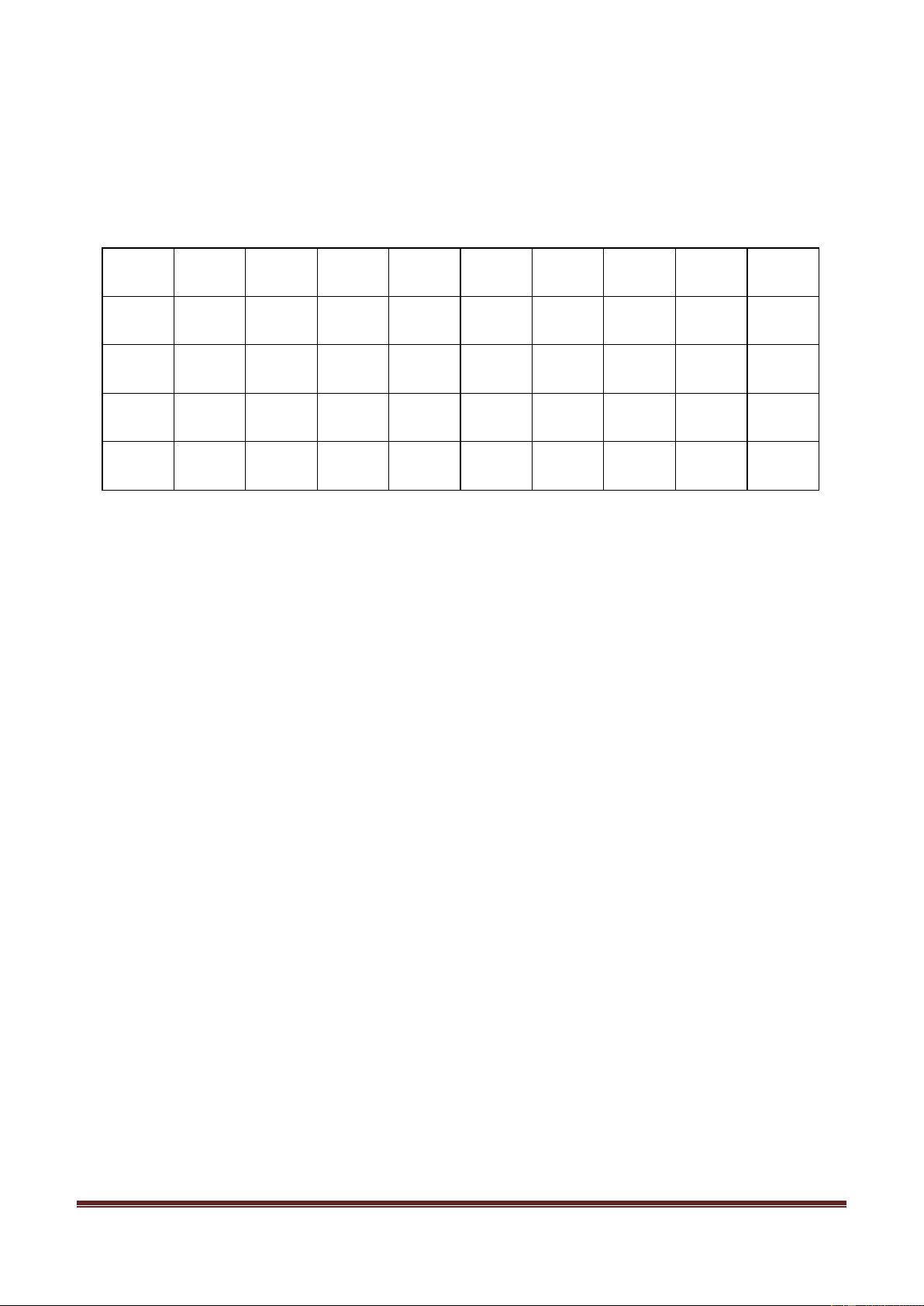
Page 381
D. As William Clark was not granted the rank of captain, Captain Lewis more or less ignored
this and treated Clark as his equal in authority and rank.
-----HẾT-----
ĐÁP ÁN
1-C
2-B
3-C
4-D
5-D
6-B
7-A
8-A
9-C
10-A
11-B
12-D
13-C
14-B
15-D
16-C
17-A
18-B
19-D
20-B
21-C
22-C
23-B
24-B
25-D
26-A
27-C
28-B
29-A
30-A
31-D
32-B
33-C
34-A
35-D
36-A
37-B
38-B
39-B
40-C
41-A
42-C
43-B
44-C
45-C
46-B
47-C
48-D
49-A
50-C
MA TRẬN

Page 382
+ Mức độ đề thi: Trung bình
ĐÁNH GIÁ
+ Nhận xét đề thi: Nhìn chung đề thi sử dụng kiến thức và từ vựng của lớp 12 với mức độ câu hỏi
phân loại từ dễ đến khó nên có thể phân loại được học sinh trung bình, khá và giỏi. Cấu trúc đề theo
cấu trúc đề minh họa năm 2019 nên có 13 câu đọc hiểu và 6 câu từ vựng. Phần bài đọc lượng từ
vựng tương đối nhiều nên có thể dùng để phân loại học sinh khá tốt. Đề này tương đương với đề
minh họa của bộ giáo dục 2019
HƯỚNG DẪN GIẢI CHI TIẾT
Question 1. C
Kiến thức: Phát âm “-ed”
Giải thích:
Đuôi “-ed” được phát âm là:
- /id/ khi âm trước nó tận cùng là /t/ và /d/
- /t/ khi âm trước nó tận cùng là /ʃ/, /tʃ/, /s/, /p/, /f/, /k/
- /d/ khi âm trước nó tận cùng là các nguyên âm và phụ âm còn lại.
talked /tɔ:kt/ missed /mist/
learned /'lɜ:nid/ (a) hoặc /lɜ:nd/ (v) watched /wɒt∫t/
Phần gạch chân câu C được phát âm là /d/ hoặc /id/ tuỳ thuộc vào tính từ hay động từ, còn lại là /t/
Question 2. B
Kiến thức: Phát âm “-o”
Giải thích:
gosh /gɒ∫/ most /məʊst/
frost /frɒst/ cost /kɒst/
Phần gạch chân câu B được phát âm là /əʊ/ còn lại là /ɒ/
Question 3. C
Kiến thức: Trọng âm của từ có 2 âm tiết
Giải thích:
supply /sə'plai/ consist /kən'sist/
happen /'hæpən/ delay /di'lei/
Câu C trọng âm rơi vào âm tiết thứ nhất, còn lại là thứ 2
Question 4. D
Kiến thức: Trọng âm của từ có 3 âm tiết trở lên
Giải thích:
comfortable /'kʌmftəbl/ necessary /'nesəsəri/
memorable /'memərəbl/ unattractive /ʌnə'træktiv/
Câu D trọng âm rơi vào âm tiết thứ 3, còn lại là thứ nhất
Question 5. D
Kiến thức: Mạo từ
Giải thích: Trước trạng từ chỉ thời gian “next + thời điểm” ta không dùng mạo từ
Tạm dịch: Anh tôi hy vọng sẽ đi du lịch vòng quanh thế giới vào mùa hè tới.
Question 6. B

Page 383
Kiến thức: Câu điều kiện
Giải thích:
Ta dùng câu điều kiện loại 2 diễn tả một hành động không có thật ở hiện tại.
Cấu trúc câu điều kiện loại 2: If + S + Ved/ V2, S + would/could… + V + …
Tạm dịch: Nếu anh cải thiện kỹ năng công nghệ thông tin của mình, anh ấy hẳn sẽ dễ dàng kiếm
được một công việc.
Question 7. A
Kiến thức: Thì trong tiếng Anh, hoà hợp chủ ngữ và động từ
Giải thích:
Ta dùng thì quá khứ đơn và quá khứ tiếp diễn diễn tả một hành động đang xảy ra trong quá khứ thì
có một hành động khác xen vào.
Cấu trúc: While + S + was/ were V-ing (hành động đang diễn ra), S + Ved/ V2 (hành động xen vào)
Tạm dịch: Trong khi tôi đang đợi ở trạm xe buýt thì ba chiếc xe buýt đi qua theo hướng ngược lại.
Question 8. A
Kiến thức: Liên từ
Giải thích:
since: kể từ khi as: như là, bởi vì
for: cho because: bởi vì, do
Tạm dịch: Đây là lần đầu tiên tôi có khách kể từ khi tôi chuyển đến London.
Question 9. C
Kiến thức: Giới từ
Giải thích: Ta có cấu trúc “advise sb against doing sth” = “advise sb not to do sth”: khuyên ai
không làm gì
Tạm dịch: Họ khuyên tôi không nên đến thăm miền nam gặp khó khăn.
Question 10. A
Kiến thức: Giới từ
Giải thích:
during: trong lúc, trong suốt for: cho
by: bằng, trước in: trong
during the year: trong suốt cả năm
Tạm dịch: Công việc mà các sinh viên làm trong năm sẽ được tính vào bằng cấp cuối cùng của họ.
Question 11. B
Kiến thức: Thì trong tiếng Anh, hoà hợp chủ ngữ và động từ
Giải thích:
Ta dùng thì hiện tại hoàn thành diễn tả hành động bắt đầu trong quá khứ và kéo dài đến hiện tại.
Cấu trúc thì hiện tại hoàn thành: S + have/has + PP +…
Chủ ngữ trong câu là danh từ không đếm được “price” nên ta dùng trợ động từ “has”
Tạm dịch: Trong 30 năm qua, giá robot trung bình đã giảm một nửa theo giá trị thực và thậm chí
còn liên quan nhiều hơn đến chi phí lao động.
Question 12. D
Kiến thức: Dạng của động từ, câu chủ động bị động
Giải thích:
Ta có cụm “admit doing sth”: thừa nhận làm cái gì
Chủ ngữ trong câu là người, và về nghĩa thì câu này là câu chủ động, cho nên đáp án B loại
Tạm dịch: Janet thừa nhận đã lái xe mà không có bảo hiểm.

Page 384
Question 13. C
Kiến thức: Cấu trúc nhờ vả/ truyền khiến
Giải thích: Ta có cấu trúc “have sth done”: có cái gì được làm (bởi ai đó, không phải tự mình thực
hiện)
Tạm dịch: Anh ta nên gia hạn visa trước khi hết hạn nếu anh ta không muốn bị trục xuất.
Question 14. B
Kiến thức: Từ vựng
Giải thích:
exchange (v): trao đổi transform (v): biến đổi
alter (v): thay đổi convert (v): chuyển đổi
Tạm dịch: Quá trình biến Jackson từ một thiếu niên tài năng thành một người hay nhân nhượng bắt
đầu trong trại huấn luyện.
Question 15. D
Kiến thức: Cụm động từ/ thành ngữ
Giải thích: Ta có cụm “pave the way for”: mở đường cho…
Tạm dịch: Phán quyết của Tòa án Tối cao đã mở đường cho luật pháp về quyền dân sự.
Question 16. C
Kiến thức: Từ vựng
Giải thích:
reading (n): sách báo để đọc, dị bản discovery (n): sự tìm ra, khám phá ra
finding (n): điều khám phá ra output (n): đầu ra; lượng ra
Tạm dịch: Những phát hiện này cho thấy không có mối liên hệ trực tiếp giữa thất nghiệp và tội
phạm.
Chọn C
Question 17. A
Kiến thức: Từ vựng
Giải thích:
progressively (adv): tăng dần, tuần tự, từng bước continuously (adv): một cách liên tục
frequently (adv): một cách thường xuyên constantly (adv): một cách liên tục
Tạm dịch: Tình hình đã trở nên tồi tệ dần dần, và bây giờ không thể xử lý được.
Question 18. B
Kiến thức: Thành ngữ
Giải thích: Ta có cụm “to be down on one’s luck”: ở trong tình trạng tồi tệ
Tạm dịch: Khi ai đó ở tình trạng tồi tệ, không dễ để tìm thấy bạn bè.
Question 19. D
Kiến thức: Từ đồng nghĩa
Giải thích:
transfer (n): sự chuyển
transplant (n): sự ghép removal (n): sự dời đi,
conversion (n): sự đổi, sự chuyển đổi shifting (n): sự chuyển
=> transfer = shifting
Tạm dịch: Cuộc bầu cử tổng thống của Congo được hy vọng sẽ cho phép chuyển giao quyền lực
dân chủ, hòa bình đầu tiên kể từ khi giành độc lập từ Bỉ năm 1960.

Page 385
Question 20. B
Kiến thức: Từ đồng nghĩa
Giải thích:
give the secret away: tiết lộ bí mật
ask anyone to come: yêu cầu ai đó đến tell her the secret: nói ra bí mật
go to the party: đi tới bữa tiệc find out the secret: tìm ra bí mật
=> give the secret away = tell her the secret
Tạm dịch: Chúng ta sẽ có một bữa tiệc bất ngờ cho Susan vào thứ bảy tới, vì vậy đừng tiết lộ bí
mật bằng cách nói bất cứ điều gì với cô ấy.
Question 21. C
Kiến thức: Từ trái nghĩa
Giải thích:
protect (v): bảo vệ
guard (v): bảo vệ shape (n): hình dạng
attack (v): tấn công save (v): cứu, lưu trữ
=> protect >< attack
Tạm dịch: Telomere là những cái mũ nhỏ ở đầu nhiễm sắc thể bảo vệ DNA của chúng ta khỏi bị hư
hại trong quá trình phân chia tế bào.
Question 22. C
Kiến thức: Từ vựng, từ trái nghĩa
Giải thích:
bite the hand that feeds you: làm hại ai đó đã từng giúp đỡ bạn
be unfriendly: không thân thiện be ungrateful: vô ơn
be thankful: biết ơn be devoted: tận tụy
=> bite the hand that feeds you >< be thankful
Tạm dịch: Nếu bạn nói những điều không hay về người đã cho bạn công việc thì bạn thật vô ơn.
Question 23. B
Kiến thức: Văn hoá giao tiếp
Tạm dịch:
Jane và Janet đang nói về những môn thể thao yêu thích của họ.
Jane: "Có phải bạn thích lặn không?" - Janet: “ .”
A. Rất thích. Cuộc sống dưới đáy biển đang bị ô nhiễm mạnh mẽ.
B. Rất thích. Cuộc sống dưới đáy biển thật hấp dẫn.
C. Không. Cuộc sống dưới đáy biển quá đắt đỏ.
D. Ừm, bây giờ mọi thứ đã khác đi nhiều.
Question 24. B
Kiến thức: Văn hoá giao tiếp
Tạm dịch:
Mary đang nói chuyện với giáo sư của mình trong văn phòng của ông.
- Giáo sư: Chúc mừng giải thưởng của em.
- Mary: .
A. Em rất vui khi thầy hiểu.
B. Em biết ơn sự giám sát của thầy.
C. Em hoàn toàn đồng ý với thầy.
D. Em cảm thấy rất tiếc cho thầy, giáo sư.

Page 386
Question 25. D
Kiến thức: Cụm động từ
Giải thích:
take in (v): đưa vào, dẫn vào take away (v): mang đi
take off (v): cởi ra take over (v): nắm quyền kiểm soát
More and more routine, repetitive assembly tasks will be taken (25) over by machines.
Tạm dịch: Ngày càng thường xuyên hơn, các nhiệm vụ lắp ráp lặp đi lặp lại sẽ được đảm nhận bởi
các máy móc.
Question 26. A
Kiến thức: Từ vựng
Giải thích:
deploy (v): triển khai deform (v): làm biến dạng; làm méo mó
decrease (v): làm giảm develop (v): phát triển
Today, German manufacturers (26) deploy three times more robots than U.S. companies, but they
also still employ more humans.
Tạm dịch: Ngày nay, các nhà sản xuất Đức triển khai robot nhiều gấp ba lần so với các công ty
Hoa Kỳ, nhưng họ vẫn sử dụng nhiều người hơn.
Máy móc có khả năng lắp ráp mọi thứ nhanh hơn bất kỳ người nào, nhưng con người sở hữu các
phân tích, chuyên môn về lĩnh vực và kiến thức quý giá cần thiết để giải quyết các vấn đề và tối ưu
hóa sản xuất sàn của nhà máy.
Question 30. A
Kiến thức: Đọc hiểu
Giải thích:
Ý chính của bài là gì?
A. Một loại tiền tệ mới trong thế giới ảo B. Một cách kinh doanh trong thế giới ảo
C. Một thay thế cho bitcoin được tạo bởi Nakamoto D. Tương lai của bitcoin trong thế giới thực.
Bài đọc nói về Bitcoin, một loại tiền ảo
Question 31. D
Kiến thức: Đọc hiểu
Giải thích:

Page 387
Từ họ “they” trong đoạn 1 đề cập đến
A. đô la B. euro C. các thứ D. bitcoin
“they” đề cập đến bitcoin: Bitcoins are a form of virtual currency. In other words, they are a type of
money that does not exist in the actual world. However, they can be used to purchase actual
products and services from real companies.
Tạm dịch: Bitcoin là một dạng tiền ảo. Nói cách khác, chúng là một loại tiền không tồn tại trong
thế giới thực. Tuy nhiên, chúng có thể được sử dụng để mua các sản phẩm và dịch vụ thực tế từ các
công ty thật.
Question 32. B
Kiến thức: Đọc hiểu
Giải thích:
Từ “minuscule” có nghĩa gần nhất với
A. đáng kể B. nhỏ C. tối thiểu D. tăng
minuscule” = “small”: nhỏ
Thông tin: Although more and more companies are beginning to accept bitcoins, the percentage of
purchases made using bitcoins is minuscule compared to other online payment methods, such as
credit cards.
Tạm dịch: Mặc dù ngày càng có nhiều công ty bắt đầu chấp nhận bitcoin, nhưng tỷ lệ mua hàng
được thực hiện bằng bitcoin là rất nhỏ so với các phương thức thanh toán trực tuyến khác, chẳng
hạn như thẻ tín dụng.
Question 33. C
Kiến thức: Đọc hiểu
Giải thích:
Tại sao bitcoin là mối quan tâm lớn đối với chính phủ?
A. Vì giá trị của bitcoin đang dao động mạnh.
B. Vì bitcoin cuối cùng sẽ thay thế tiền tệ quốc gia.
C. Vì bitcoin có thể được sử dụng trong các giao dịch bất hợp pháp.
D. Bởi vì hầu hết chủ sở hữu bitcoin là tin tặc.
Thông tin: Governments are concerned that bitcoins can easily be stolen by hackers. It has dawned
on them that they might be used for illegal purposes. For example, stolen goods could be purchased
without the government's knowledge.
Tạm dịch: Chính phủ lo ngại rằng bitcoin có thể dễ dàng bị đánh cắp bởi tin tặc. Họ nhận ra rằng
chúng có thể được sử dụng cho mục đích bất hợp pháp. Ví dụ, hàng hóa bị đánh cắp có thể được
mua mà chính phủ không biết.
Question 34. A
Kiến thức: Đọc hiểu
Giải thích:
Điều nào sau đây được định nghĩa trong đoạn văn?
A. Bitcoin B. Giao dịch C. Thẻ tín dụng D. Cơ sở dữ liệu công cộng
Thông tin: Bitcoins are a form of virtual currency. In other words, they are a type of money that
does not exist in the actual world.
Tạm dịch: Bitcoin là một dạng tiền ảo. Nói cách khác, chúng là một loại tiền không tồn tại trong
thế giới thực.
Chọn A
Dịch bài đọc:
Bitcoin là một dạng tiền ảo. Nói cách khác, chúng là một loại tiền không tồn tại trong thế giới thực.
Tuy nhiên, chúng có thể được sử dụng để mua các sản phẩm và dịch vụ thực tế từ các công ty thật.

Page 388
Hệ thống bitcoin được tạo ra vào năm 2009 bởi một người bí ẩn tên Satoshi Nakamoto. Trên thực
tế, không ai chắc chắn Satoshi Nakamoto là một người thật hay một nhóm người. Bitcoin được thiết
kế để phục vụ thay thế cho các loại tiền tệ quốc gia, chẳng hạn như đô la và euro. Chúng có thể
được sử dụng để thanh toán trực tuyến thay cho tiền mặt hoặc thẻ tín dụng. Khi bitcoin được chuyển
từ người mua sang người bán, giao dịch được ghi lại trong cơ sở dữ liệu công khai.
Chính phủ lo ngại rằng bitcoin có thể dễ dàng bị đánh cắp bởi tin tặc. Họ nhận ra rằng chúng có thể
được sử dụng cho mục đích bất hợp pháp. Ví dụ, hàng hóa bị đánh cắp có thể được mua mà chính
phủ không biết. Mặc dù ngày càng có nhiều công ty bắt đầu chấp nhận bitcoin, nhưng tỷ lệ mua
hàng được thực hiện bằng bitcoin là rất nhỏ so với các phương thức thanh toán trực tuyến khác,
chẳng hạn như thẻ tín dụng. Thay vào đó, nhiều chủ sở hữu bitcoin chỉ đơn giản giữ chúng như một
khoản đầu tư vì có giá trị hơn trong tương lai.
Điều này có thể hoặc không thể là một cách tiếp cận khôn ngoan. Hiện tại, giá trị của bitcoin đang
biến động mạnh mẽ, đặc biệt khi so sánh với các loại tiền tệ quốc gia có tính ổn định cao, các nhà
đầu tư Bitcoin đang đánh bạc với hy vọng rằng khi loại tiền công nghệ cao này được chấp nhận
rộng rãi hơn, giá trị của nó sẽ tăng cao.
Question 35. D
Kiến thức: Đọc hiểu
Giải thích:
Trong đoạn 1, người viết giới thiệu khái niệm McMansion bằng cách
A. so sánh hamburger và nhà
B. giới thiệu nhiều loại nhà ở Hoa Kỳ
C. thảo luận về những ưu điểm và nhược điểm của McMansion
D. giải thích cách McMansion được đặt tên
Thông tin: A mansion is a very large home. McDonald's is the name of a fast food hamburger
chain. What do you get when you put the two together? You get McMansion…
Tạm dịch: Một khu chung cư là một ngôi nhà rất lớn. McDonald là tên của một chuỗi hamburger
thức ăn nhanh. Bạn nhận được gì khi kết hợp cả hai? Bạn có được McMansion…
Question 36. A
Kiến thức: Đọc hiểu
Giải thích:
Cụm từ “turning sour” trong đoạn 4 đề cập đến thực tế là
A. McMansion lớn và chi phí thấp nhất có thể trở nên không phù hợp với nhiều chủ sở hữu
B. nhà phát triển đất xây nhà bằng cách sử dụng một thiết kế cơ bản tương tự và phương pháp xây
dựng giống hệt nhau
C. các vật liệu được sử dụng để xây dựng khung và phụ kiện nội thất thường có chất lượng thấp
D. khu vực ngoại thành có rất nhiều ngôi nhà to lớn trông giống nhau
Thông tin: There are two main problems with McMansions. One problem is that their huge size
means that they cost a lot to heat or cool. […] The other problem is that McMansion owners are
often in a lot of debt.
Tạm dịch: Có hai vấn đề chính với McMansion. Một vấn đề là kích thước khổng lồ của chúng có
nghĩa là chúng tốn rất nhiều chi phí để sưởi ấm hoặc làm mát. […] Vấn đề khác là chủ sở hữu
McMansion thường mắc nợ rất nhiều.
Question 37. B
Kiến thức: Đọc hiểu
Giải thích:
Theo đoạn văn, điều nào sau đây là một vấn đề lớn với McMansion?
A. Thiết kế ấn tượng của chúng khiến chúng trở thành ngôi nhà mơ ước của nhiều người.

Page 389
B. Kích thước lớn của McMansion yêu cầu chủ sở hữu thanh toán các hóa đơn năng lượng khổng
lồ.
C. Vẻ ngoài giống hệt của McMansion ở khắp mọi nơi khiến chúng không còn phổ biến.
D. Vẻ ngoài giống hệt của McMansion khiến người ta liên tưởng đến hamburger của McDonald.
Thông tin: One problem is that their huge size means that they cost a lot to heat or cool. Energy is
becoming more expensive, so owners are faced with huge bills if they try to heat or cool their home.
Tạm dịch: Một vấn đề là kích thước khổng lồ của chúng có nghĩa là chúng tốn rất nhiều chi phí để
sưởi ấm hoặc làm mát. Năng lượng đang trở nên đắt đỏ hơn, vì vậy chủ sở hữu phải đối mặt với các
hóa đơn khổng lồ nếu họ cố gắng sưởi ấm hoặc làm mát ngôi nhà của họ.
Question 38. B
Kiến thức: Đọc hiểu
Giải thích:
Khẳng định nào sau đây là đúng về McMansions theo đoạn văn?
A. Chúng không có nhiều không gian nội thất cho đồ nội thất và các hoạt động gia đình khác
B. Chúng là một trong những kiểu nhà ở phổ biến nhất vào cuối thế kỷ 20.
C. Chủ sở hữu của chúng đều rất giàu có và có khả năng chi trả cho McMansions, chủ yếu là nhân
viên ngân hàng.
D. Tất cả chúng chỉ trông khác nhau nếu nhìn từ phía trên.
Thông tin: These questions are weighing heavily on the future of one of the most popular housing
styles of the late 20th century.
Tạm dịch: Những câu hỏi này đang cân nhắc rất nhiều về tương lai của một trong những phong
cách nhà ở phổ biến nhất vào cuối thế kỷ 20.
Question 39. B
Kiến thức: Đọc hiểu
Giải thích:
Khẳng định nào sau đây KHÔNG đúng về McMansion?
A. Chúng có chung kích thước lớn và thiết kế ấn tượng.
B. Nền kinh tế mạnh mẽ khiến chúng trở nên ít phổ biến hơn ngay cả giữa những người giàu có.
C. Các vật liệu được sử dụng thường có chất lượng thấp hơn, do đó chi phí thấp hơn.
D. Các phần đất được sử dụng cho mỗi ngôi nhà nhỏ hơn nhiều so với trước đây.
Thông tin:
- McMansion became very popular in the United States during the 1990s, and this popularity
continued for almost 20 years.
- McMansion are still popular in some area, but no one is sure how long it will last.
Tạm dịch: McMansion trở nên rất phổ biến ở Hoa Kỳ trong những năm 1990, và sự phổ biến này
tiếp tục trong gần 20 năm.
McMansion vẫn còn phổ biến ở một số khu vực, nhưng không ai chắc chắn nó sẽ kéo dài bao lâu.
Question 40. C
Kiến thức: Đọc hiểu
Giải thích:
Điều gì có thể được suy ra từ câu này trong đoạn 1: “Hiện tại McMansion có thể bị đe dọa”?
A. Một số loài bị đe dọa đang sống ở McMansion.
B. Thật nguy hiểm khi sống ở McMansion.
C. McMansion có thể bị phá hủy sớm.
D. Mọi người sẽ không xây dựng McMansion nữa.

Page 390
Thông tin cho câu này ở xuyên suốt những đoạn sau đó, McMansion dù có nhiều ưu điểm nhưng
ngày càng bộc lộ nhiều khuyết điểm, hiện giờ McMansion vẫn còn phổ biến, nhưng không chắc nó
sẽ kéo dài bao lâu.
Question 41. A
Kiến thức: Đọc hiểu
Giải thích:
Từ “nó” ở đoạn cuối cùng đề cập đến
A. sự phổ biến của McMansion ở một số khu vực B. thực tế là ít người có thể mua McMansion
C. nền kinh tế đang gặp khó khăn và thất nghiệp cao D. ước mơ sở hữu một McMansion ấn tượng
Từ “it” đề cập đến sự phổ biến của McMansion ở một số khu vực: McMansion are still popular in
some area, but no one is sure how long it will last.
Tạm dịch: McMansion vẫn còn phổ biến ở một số khu vực, nhưng không ai chắc chắn nó sẽ kéo
dài bao lâu.
Question 42. C
Kiến thức: Đọc hiểu
Giải thích:
Tại sao người viết đặt câu hỏi trong đoạn 6?
A. để thảo luận về sự tăng giảm của giá năng lượng đối với nhà ở Mỹ
B. để nhấn mạnh tầm quan trọng của McMansion trong văn hóa Mỹ
C. để khiến độc giả suy nghĩ về tương lai của McMansion
D. để giải thích tại sao McMansion vẫn còn phổ biến ngày nay
Thông tin: These questions are weighing heavily on the future of one of the most popular housing
styles of the late 20th century.
Tạm dịch: Những câu hỏi này đang cân nhắc rất nhiều về tương lai của một trong những phong
cách nhà ở phổ biến nhất vào cuối thế kỷ 20.
Dịch bài đọc:
Một khu chung cư là một ngôi nhà rất lớn. McDonald là tên của một chuỗi hamburger thức ăn
nhanh. Bạn nhận được gì khi kết hợp cả hai? Bạn có được McMansion, tên được tạo gần đây cho
một loại ngoại ô lớn, hai ngôi nhà có nguồn gốc từ Hoa Kỳ. Nhiều người yêu thích McMansions vì
giá thấp, không gian phong phú và kiểu dáng ấn tượng, nhưng không phải tất cả đều tốt. Trên thực
tế, McMansions hiện có thể bị đe dọa.
McMansion trở nên rất phổ biến ở Hoa Kỳ trong những năm 1990, và sự phổ biến này tiếp tục trong
gần 20 năm. Trong những năm đó nền kinh tế tương đối mạnh, và các ngân hàng sẵn sàng cho vay
một số tiền lớn cho những người muốn mua nhà. Kết quả là sự gia tăng kích thước nhà trung bình.
Năm 1988, ngôi nhà mới của người Mỹ trung bình là 170 mét vuông, nhưng đến năm 2008, con số
này đã tăng lên tới 244 mét vuông, tăng 44%.
Để bù đắp chi phí lớn hơn cho những ngôi nhà lớn này, các nhà phát triển đất đã xây dựng nhiều
ngôi nhà mà tất cả đều sử dụng một thiết kế cơ bản tương tự và phương pháp xây dựng giống hệt
nhau. Khung và phụ kiện nội thất được xây dựng trong các nhà máy, thay vì tại chỗ, và các vật liệu
được sử dụng thường có chất lượng thấp hơn. Cuối cùng, các phần đất được sử dụng cho mỗi ngôi
nhà nhỏ hơn nhiều so với trước đây.
Kết quả là sự phát triển ở ngoại ô đầy những ngôi nhà khổng lồ, thường có diện tích sàn hơn 280
mét vuông, tất cả đều trông giống nhau. Tiêu chuẩn hóa và xây dựng với chi phí thấp nhất có thể
khiến người ta nhớ đến hamburger của McDonald, do đó, có thuật ngữ McMansion. Đối với nhiều
người, McMansion là ngôi nhà mơ ước của họ, nhưng giấc mơ đó giờ đang nhanh chóng trở nên tồi
tệ.
Có hai vấn đề chính với McMansion. Một vấn đề là kích thước khổng lồ của chúng có nghĩa là
chúng tốn rất nhiều chi phí để sưởi ấm hoặc làm mát. Năng lượng đang trở nên đắt đỏ hơn, vì vậy
chủ sở hữu phải đối mặt với các hóa đơn khổng lồ nếu họ cố gắng sưởi ấm hoặc làm mát ngôi nhà

Page 391
của họ. Vấn đề khác là chủ sở hữu McMansion thường mắc nợ rất nhiều. Họ đã vay rất nhiều tiền
để trả cho ngôi nhà ấn tượng của mình, nhưng trong những năm 2000, với nền kinh tế khó khăn và
tỷ lệ thất nghiệp cao, họ không đủ khả năng trả nợ.
McMansion vẫn còn phổ biến ở một số khu vực, nhưng không ai chắc chắn nó sẽ kéo dài bao lâu.
Năng lượng sẽ trở nên đắt hơn và buộc các chủ sở hữu phải giảm quy mô? Nền kinh tế sẽ phát triển
và các ngân hàng trở nên sẵn sàng hơn để kết thúc một lần nữa? Giá nhà giảm sẽ cho phép các gia
đình lớn, ít giàu hơn có thể mua McMansion? Những câu hỏi này đang cân nhắc rất nhiều về tương
lai của một trong những phong cách nhà ở phổ biến nhất vào cuối thế kỷ 20.
Question 43. B
Kiến thức: Vị trí của trạng ngữ trong câu
Giải thích:
never was => was never
Trạng ngữ chỉ tần suất đứng sau động từ to be (còn đối với động từ thường, trạng từ chỉ tần suất
đứng trước động từ)
Tạm dịch: Ông lão tội nghiệp không bao giờ có thể giải thích những gì đang xảy ra với gia đình
mình.
Question 44. C
Kiến thức: Danh từ đếm được, không đếm được
Giải thích:
knowledges of => knowledge of
“knowledge” là danh từ không đếm được, do đó không thể thêm “s” ở đằng sau
Tạm dịch: “Đêm giao thừa của Hollywood” lấp đầy những lỗ hổng trong kiến thức của chúng ta về
cuộc sống và công việc của Babitz.
Question 45. C
Kiến thức: Câu chẻ (câu nhấn mạnh)
Giải thích:
where => that
Cấu trúc câu chẻ: It is/ was + cụm từ được nhấn mạnh + that + S + V
Tạm dịch: Đó là vào năm 1896 tại Athens, Hy Lạp khi Thế vận hội hiện đại đầu tiên được tổ chức.
Question 46. B
Kiến thức: So sánh nhất
Tạm dịch:
Không có học sinh nào khác trong lớp thành công như Pat.
A. Pat đã thành công trong việc đánh bại tất cả các học sinh khác trong lớp. => sai nghĩa
B. Pat là học sinh thành công nhất trong lớp. => đúng
C. Lớp của cậu ấy kém thành công hơn Pat. => sai nghĩa
D. Lớp của cậu ấy càng thành công, Pat càng thành công. => sai nghĩa
Question 47. C
Kiến thức: Câu tường thuật
Tạm dịch:
"Tôi thực sự không nghĩ rằng anh ấy sẽ tham dự cuộc họp vào ngày mai."
A. Tôi đã nói với bạn rằng anh ấy sẽ tham dự cuộc họp vào ngày hôm sau. => sai nghĩa
B. Tôi sẽ không bao giờ quên sự tham dự của anh ấy vào cuộc họp ngày mai. => sai nghĩa
C. Tôi nghi ngờ việc anh ấy sẽ tham dự cuộc họp vào ngày mai. => đúng
D. Tôi không đồng ý sự tham dự cuộc họp của anh ấy. => sai nghĩa

Page 392
Question 48. D
Kiến thức: Đảo ngữ với hardly...when
Giải thích:
Hardly…when diễn đạt một điều gì khác diễn ra ngay lập tức sau khi diễn ra một điều gì đó.
Cấu trúc: Hardly + had+ S + PP + when + S + Ved/ V2.
Tạm dịch: Giáo viên vừa mới vào phòng thì chuông báo cháy reo.
A. Trong khi giáo viên đang vào trong phòng, cô ấy nghe thấy tiếng chuông báo cháy. => sai nghĩa
B. Ngay khi chuông báo cháy kêu, giáo viên vào phòng.=> sai nghĩa
C. Trước khi giáo viên vào phòng, chuông báo cháy reo. => sai nghĩa
D. Giáo viên vừa vào phòng thì chuông báo cháy reo. => đúng
Question 49. A
Kiến thức: Liên từ
Tạm dịch:
Xe của bố rất cũ. Ông không đủ khả năng để mua một cái mới.
A. Xe của bố rất cũ, nhưng ông không đủ tiền để mua một chiếc mới.=> đúng
B. Xe của bố rất cũ, vì vậy ông không đủ tiền để mua một chiếc mới. => sai nghĩa
C. Bố không đủ tiền để mua một chiếc mới vì chiếc xe của ông rất cũ. => sai nghĩa
D. Xe của bố rất cũ, mặc dù ông không đủ tiền để mua một chiếc mới. => sai nghĩa
Question 50. C
Kiến thức: Liên từ
Tạm dịch:
William Clark không được ban cấp bậc đội trưởng. Đội trưởng Lewis ít nhiều đã bỏ qua điều này và
coi Clark là người bình đẳng về quyền lực và cấp bậc.
A. William Clark không được ban cấp bậc đội trưởng vì đội trưởng Lewis ít nhiều đã bỏ qua điều
này và coi Clark là người bình đẳng về thẩm quyền và cấp bậc. => sai nghĩa
B. William Clark không được ban cấp bậc đội trưởng, do đó, đội trưởng Lewis ít nhiều đã bỏ qua
điều này và coi Clark là người bình đẳng về quyền lực và cấp bậc. => sai nghĩa
C. Mặc dù William Clark không được ban cấp bậc đội trưởng, đội trưởng Lewis ít nhiều đã bỏ qua
điều này và coi Clark là người bình đẳng về quyền lực và cấp bậc.=> đúng
D. Vì William Clark không được ban cấp bậc đội trưởng, đội trưởng Lewis ít nhiều đã bỏ qua điều
này và coi Clark là người bình đẳng về thẩm quyền và cấp bậc. => sai nghĩa

Page 393
SỞ GD & ĐT HẢI PHÒNG ĐỀ THI THỬ THPT QUỐC GIA LẦN 1
THPT CHUYÊN TRẦN PHÚ NĂM HỌC 2018 – 2019
Môn: Tiếng Anh
Thời gian làm bài: 60 phút (không kể thời gian giao đề)
Mark the letter A, B, C, or D on your answer sheet to indicate the word whose underlined part
differs from the other three in pronunciation in each of the following questions.
Question 1: A. handicapped B. advantaged
C. organized
D. compromised
Question 2: A. leisure B. pleasure
C. failure
D. measure
Mark the letter A, B, C, or D on your answer sheet to indicate the word that differs from the other
three in the position of primary stress in each of the following questions.
Question 3: A. broaden
B. persuade
C. reduce D. explain
Question 4: A. rectangular
B. confidential
C. conservative D. political
Mark the letter A, B, C, or D on your answer sheet to indicate the correct answer to each of the
following questions.
Question 5: Richard Byrd was first person in history to fly over North Pole.
A. the – a B. the – Ø C. the – the D. Ø - Ø
Question 6: The President a speech, but in the end he his mind.
A. delivered – had changed B. was delivering - changed
C. would deliver – had changed D. was going to deliver - changed
Question 7: you happen to visit him, give him my best wishes.
A. Could B. Would C. Might D. Should
Question 8: The new supermarket is so much cheaper than the one in John Street. , they do
free home deliveries.
A. Moreover B. Consequently C. Nevertheless D. Instead
Question 9: Jimmy, dressed in jeans and a black leather jacket, arrived at the party his
motorbike.
A. by B. on C. in D. through
Question 10: We decided not to travel, the terrible weather forecast.
A. having heard B. to have heard C. having been heard D. to have been heard
Question 11: , she managed to hide her feelings.
A. However jealous she felt B. if she would feel jealous
C. Despite of her being jealous D. In case she felt jealous
Question 12: The manager regrets that a lot of people will be made redundant by the
company next year.
A. announcing B. having announced C. to announced D. to have announced
Question 13: During the presentation, each can possible three questions to the guest
speaker.
A. attendance B. attentive C. attendee D. attend
Question 14: Today, some students tend to the importance of soft skills as they solely
focus on academic subjects at school.
A. overlook B. urge C. emphasize D. implement

Page 394
Question 15: In some countries, many old-aged parents like to live in a nursing home. They want to
independent lives.
A. give B. take C. keep D. lead
Question 16: The widened will help keep traffic flowing during rush hours.
A. entryway B. runway C. freeway D. pathway
Question 17: As John enjoyed doing research, he never could imagine himself pursuing
other careers.
A. thoroughly B. totally C. extremely D. utterly
Question 18: Everyone will tell you that becoming a parent is challenging, but you never really
know what that means until you learn about it the way.
A. long B. direct C. full D. hard
Mark the letter A, B, C, or D on your answer sheet to indicate the word(s) CLOSEST in meaning
to the underlined word(s) in each of the following questions.
Question 19: Tim is thinking of leaving his present job because his manager is always getting at
him.
A. hitting B. disturbing C. defending D. criticizing
Question 20: You can use a microwave or cook this kind of food in a conventional oven.
A. unique B. modern C. traditional D. extraordinary
Mark the letter A, B, C, or D on your answer sheet to indicate the word(s) OPPOSITE in
meaning to the underlined word(s) in each of the following questions.
Question 21: Contrary to their expectations, there was widespread apathy among voters on that
issue.
A. interest B. obedience C. resistance D. opposition
Question 22: Doctors and nurses of this hospital have worked round the clock to help those
injured in the recent earthquake.
A. permanently B. interruptedly C. continuously D. accurately
Mark the letter A, B, C, or D on your answer sheet to indicate the most suitable response to
complete each of the following exchanges.
Question 23: Anne is seeing Mary off at the airport.
Anne: “Don’t fail to look after yourself, Mary!”
Marry: “ ”
A. Of course, you are an adult. B. Oh, I knew about that.
C. The same to you. D. Thanks, I will.
Question 24: Frank is inviting William to go to the waterpark.
Frank: “What about going to the waterpark?”
William: “ ”
A. That’s good idea. B. That’s right.
C. Of course! D. Right! Go ahead.
Read the following passage and mark the letter A, B, C, or D on your answer sheet to indicate the
correct word or phrase that best fits each of the numbered blanks from 25 to 29.
WOMEN TAKING THE HUSBAND’S NAME
Many women in Western society, aware of the power of names to influence identity, are aware that
choosing how to identify themselves after marriage can be a significant decision. They may follow
the tradition of taking their husband's last name, hyphenate their (25) name and their
husband's, or keep their birth name. One fascinating survey reveals that a woman's choice is (26)

Page 395
to reveal a great deal about herself and her relationship with her husband. Women who
take their husband's name place the most importance (27) relationships. On the other hand,
women who keep their birth names put their personal concerns ahead of relationships and social
expectations. Female forms of address influence others' perceptions as well. Research (28) _
in the late 1980s showed that women who choose the title Ms. give the impression of being more
achievement oriented, socially self-confident, and dynamic but less interpersonally warm than
counterparts (29) prefer the more traditional forms Miss or Mrs.
Question 25: A. own
B. private
C. personal
D. individual
Question 26: A. like
B. alike
C. likely
D. unlikely
Question 27: A. by
B. on
C. in
D. with
Question 28: A. conduct
B. conducts
C. conducting
D. conducted
Question 29: A. who
B. what
C. which
D. whom
Read the following passage and mark the letter A, B, C, or D on your answer sheet to indicate the
correct answer to each of the questions from 30 to 34.
A tropical cyclone is a violent low pressure storm that usually occurs over warm oceans of over
80°F or 27°C. It winds counterclockwise in the Northern Hemisphere and clockwise in the Southern
Hemisphere as it is described for the term, cyclone itself. This powerful storm is fueled by the heat
energy that is released when water vapor condenses at high altitudes, the heat ultimately derived
from the Sun.
The center of a tropical cyclone, called the eye, is relatively calm and warm. This eye, which is
roughly 20 to 30 miles wide, is clear, mainly because of subsiding air within it. The ring of clouds
around the eye is the eyewall, where clouds reach highest and precipitation is heaviest. The strong
wind, gusting up to 360 kilometers per hour, occurs when a tropical cyclone’s eyewall passes over
land.
There are various names for a tropical cyclone depending on its location and strength. In Asia,
a tropical cyclone is named according to its strength. The strongest is a typhoon; its winds move at
more than 117 kilometers per hour. In India, it is called a cyclone. Over the North Atlantic and in
the South Pacific, they call it a hurricane.
On average, there are about 100 tropical cyclones worldwide each year. A tropical cyclone
peaks in late summer when the difference between temperature in the air and sea surface is the
greatest. However, it has its own seasonal patterns. May is the least active month, while September
is the most active.
The destruction associated with a tropical cyclone results not only from the force of the wind,
but also from the storm surge and the waves it generates. It is born and sustained over large bodies
of warm water, and loses its strength over inland regions that are comparatively safe from receiving
strong winds. Although the tract of a tropical cyclone is very erratic, the Weather Service can still
issue timely warnings to the public if a tropical cyclone is approaching densely populated areas. If
people ever experience a cyclone, they would know how strong it could be.
Question 30: What is the main idea of the passage?
A. The tropical cyclone is the most powerful force on the earth.
B. The tropical cyclone can cause flooding and damage to structures.
C. A tropical cyclone forms over the oceans and has great power.
D. The tropical cyclone is called by different names around the world.
Question 31: According to paragraph 2, which of the following is true about the eyewall?
A. The eyewall is formed in cold weather.

Page 396
B. When the eyewall passes overhead, the wind weakens.
C. The temperature is highest around the eye.
D. The eyewall is a cloud band that surrounds the eye.
Question 32: What can be inferred about typhoons, cyclones and hurricanes?
A. Typhoons, cyclones and hurricanes form together above the oceans.
B. A typhoon is stronger than both the cyclone and the hurricane.
C. Typhoons, cyclones and hurricanes are all most powerful over a humid ocean.
D. Although tropical cyclones have different names, they are basically the same.
Question 33: The word “it” in paragraph 5 refers to .
A. a tropical cyclone B. the wind C. torrential rain D. the storm surge
Question 34: The word “erratic” in paragraph 5 is closest in meaning to _ .
A. complicated B. unpredictable C. disastrous D. explosive
Read the following passage and mark the letter A, B, C, or D on your answer sheet to indicate the
correct answer to each of the questions from 35 to 42.
As the twentieth century began, the importance of formal education in the United States
increased. The frontier had mostly disappeared and by 1910 most Americans lived in towns and
cities. Industrialization and the bureaucratization of economic life combined with a new emphasis
upon credentials and expertise to make schooling increasingly important for economic and social
mobility. Increasingly, too, schools were viewed as the most important means of integrating
immigrants into American society.
The arrival of a great wave of southern and eastern European immigrants at the turn of the
century coincided with and contributed to an enormous expansion of formal schooling. By 1920
schooling to age fourteen or beyond was compulsory in most states, and the school year was greatly
lengthened. Kindergartens, vacation schools, extracurricular activities, and vocational education and
counseling extended the influence of public schools over the lives of students, many of whom in the
larger industrial cities were the children of immigrants. Classes for adult immigrants were
sponsored by public schools, corporations, unions, churches, settlement houses, and other agencies.
Reformers early in the twentieth century suggested that education programs should suit the needs of
specific populations. Immigrant women were once such population. Schools tried to educate young
women so they could occupy productive places in the urban industrial economy, and one place
many educators considered appropriate for women was the home.
Although looking after the house and family was familiar to immigrant women, American
education gave homemaking a new definition. In preindustrial economies, homemaking had meant
the production as well as the consumption of goods, and it commonly included income-producing
activities both inside and outside the home, in the highly industrialized early-twentieth-century
United States, however, overproduction rather than scarcity was becoming a problem. Thus, the
ideal American homemaker was viewed as a consumer rather than a producer. Schools trained
women to be consumer homemakers cooking, shopping, decorating, and caring for children
"efficiently" in their own homes, or if economic necessity demanded, as employees in the homes of
others. Subsequent reforms have made these notions seem quite out-of-date.
Question 35: It can be inferred from paragraph 1 that one important factor in the increasing
importance of education in the United States was .
A. the growing number of schools in frontier communities
B. an increase in the number of trained teachers
C. the expanding economic problems of schools

Page 397
D. the increased urbanization of the entire country
Question 36: The word “means” in paragraph 1 is closest in meaning to .
A. advantages B. probability C. method D. qualifications
Question 37: The phrase "coincided with" in paragraph 2 is closest in meaning to .
A. was influenced by B. happened at the same time as
C. began to grow rapidly D. ensured the success of
Question 38: According to the passage, one important change in United States education by the
1920's was that .
A. most places required children to attend school
B. the amount of time spent on formal education was limited
C. new regulations were imposed on nontraditional education
D. adults and children studied in the same classes
Question 39: Vacation schools and extracurricular activities are mentioned in paragraph 2 to
illustrate .
A. alternatives to formal education provided by public schools
B. the importance of educational changes
C. activities that competed to attract new immigrants to their programs
D. the increased impact of public schools on students
Question 40: According to the passage, early-twentieth century education reformers believed that
.
A. different groups needed different kinds of education
B. special programs should be set up in frontier communities to modernize them
C. corporations and other organizations damaged educational progress
D. more women should be involved in education and industry
Question 41: The word “it” in paragraph 4 refers to .
A. consumption B. production C. homemaking D. education
Question 42: All of the following statements are true EXCEPT .
A. immigrants played a part in changing American education system in the 20th century
B. many foreign people found it easier to settle down in American thanks to schools
C. prior to the 20th century, public education had never had any influence on students’ lives
D. among the changes in American education system last century, one centred on women.
Mark the letter A, B, C, or D on your answer sheet to indicate the underlined part that needs
correction in each of the following questions.
Question 43: Ninety-seven percent of the world’s water are salt water found in the oceans.
A. percent B. world’s C. are D. found
Question 44: Fred Astaire is said to have been the most popular dancer of his time, but he was
also a talented actor, a singer, and choreographer.
A. is said B. to have been C. of his time D. a singer
Question 45: Jane’s friends insist that she will stay at their house when she visits Toronto next
weekend.
A. will stay B. at C. visits D. next weekend
Mark the letter A, B, C, or D on your answer sheet to indicate the sentence that is closest in
meaning to each of the following questions.
Question 46: “What a novel idea for the farewell party you’ve got,” said Nam to the monitor.
A. Nam thought over the novel idea for the farewell party.

Page 398
B. Nam came up with the novel idea for the farewell party.
C. Nam said that it was a novel idea of his classmates for the farewell party.
D. Nam exclaimed with admiration at the novel idea for the farewell party of the monitor.
Question 47: It is believed that the thief broke into the house through the bedroom window.
A. The thief is believed that he broke into the house through the bedroom.
B. The thief is believed to have broken into the house through the bedroom window.
C. The thief was believed to break into the house through the bedroom window.
D. The thief was believed to have broken into the house through the bedroom window.
Question 48: To let Harold join our new project was silly as he knows little about our company.
A. Harold couldn’t have joined our new project with such poor knowledge about our company.
B. Harold must have known so little about our company that he wasn’t let to join our new
project.
C. We shouldn’t have allowed Harold to join our new project as he doesn’t know much about
our company.
D. We would have joined the new project with Harold provided that he knew much about our
company.
Mark the letter A, B, C, or D on your answer sheet to indicate the sentence that best combines
each pair of sentences in the following questions.
Question 49: The taxi driver ignored the stop sign. Then, he crashed his vehicle.
A. If the taxi driver ignored the stop sign, he crashed his vehicle.
B. Unless the taxi driver paid attention to the stop sign, he would have crashed his vehicle.
C. The taxi driver would not have crashed his vehicle if he had taken notice of the stop sign.
D. The taxi driver didn’t ignore the stop sign, or he would not have crashed his vehicle.
Question 50: She is so attractive. Many boys run after her.
A. So attractive is she many boys that run after her.
B. So attractive is she that many boys run after her.
C. So attractive she is that many boys run after her.
D. So that attractive she is many boys that run after her.
...............THE END.................
ĐÁP ÁN
1-A
2-C
3-A
4-B
5-C
6-D
7-D
8-A
9-B
10-A
11-A
12-C
13-C
14-A
15-D
16-C
17-A
18-D
19-D
20-C
21-A
22-B
23-D
24-A
25-A
26-C
27-B
28-D
29-A
30-C
31-D
32-D
33-D
34-B
35-D
36-C
37-B
38-A
39-D
40-A
41-C
42-C
43-C
44-D
45-A
46-D
47-B
48-C
49-C
50-B

Page 399
MA TRẬN
+ Mức độ đề thi: Trung bình
ĐÁNH GIÁ
+ Nhận xét đề thi: Nhìn chung đề thi sử dụng kiến thức và từ vựng của lớp 12 với mức độ câu hỏi
phân loại từ dễ đến khó nên có thể phân loại được học sinh trung bình, khá và giỏi. Lượng từ vựng
phong phú nhưng không quá khó và lạ. Bài đọc hiểu có thể dùng để phân loại học sinh được. Cấu
trúc đề theo cấu trúc đề minh họa năm 2019 nên có 13 câu đọc hiểu và 6 câu từ vựng. Đề này tương
đương với đề minh họa của bộ giáo dục 2019
Question 1. A
Kiến thức: Phát âm “-ed”
Giải thích:
Quy tắc phát âm “-ed”:
HƯỚNG DẪN GIẢI CHI TIẾT
- Phát âm là /ɪd/ với các động từ kết thúc bằng âm /t/ hoặc /d/.
- Phát âm là /t/ với các động từ kết thúc bằng âm vô thanh như là /k/, /p/, /s/, /f/, /tʃ/, /ʃ/.
- Phát âm là /d/ với các động từ kết thúc bằng các âm còn lại.
handicapped /ˈhændikæpt/ advantaged /ədˈvɑːntɪdʒd/
organized /ˈɔːɡənaɪzd/ compromised /ˈkɒmprəmaɪzd/
Phần được gạch chân ở câu A phát âm là /t/, còn lại là /d/.

Page 400
Question 2. C
Kiến thức: Phát âm “-ure”
Giải thích:
leisure /ˈleʒə(r)/ pleasure /ˈpleʒə(r)/
failure /ˈfeɪljə(r)/ measure /ˈmeʒə(r)/
Phần được gạch chân ở câu C phát âm là /jə(r)/, còn lại là /ə(r)/.
Question 3. A
Kiến thức: Trọng âm từ có hai âm tiết
Giải thích:
broaden /ˈbrɔːdn/ persuade /pəˈsweɪd/
reduce /rɪˈdjuːs/ explain /ɪkˈspleɪn/
Trọng âm của câu A rơi vào âm thứ nhất, còn lại là âm thứ hai.
- Thì quá khứ đơn diễn tả sự việc xảy ra trong quá khứ.
Cấu trúc: S + V.ed + O => changed
Tạm dịch: Tổng thống dự định sẽ có bài phát biểu, nhưng cuối cùng ông ấy đã thay đổi quyết định.
Question 7. D
Kiến thức: Câu điều kiện loại 1
Giải thích:
Câu điều kiện loại 1: If + S + V(e,es), V/ don’t V + …
Đảo ngữ: Should + S + Vo, V/ don’t V + …
Tạm dịch: Nếu bạn tình cờ đến thăm anh ấy, hãy gửi anh ấy những lời chúc tốt đẹp nhất của tôi.
Question 8. A
Kiến thức: Liên từ
Giải thích:
Moreover: hơn nữa Consequently: do đó

Page 401
Nevertheless: mặc dù như vậy Instead: thay vào đó
Tạm dịch: Siêu thị mới rẻ hơn rất nhiều so với siêu thị ở phố John. Hơn nữa, họ giao hàng tận nhà
miễn phí.
Question 9. B
Kiến thức: Giới từ
Giải thích:
by + phương tiện giao thông: (đi) bằng cái gì
on + phương tiện giao thông: dùng khi chỉ các phương tiện đi lại công cộng hoặc cá nhân trừ xe hơi
và taxi.
in + phương tiện giao thông: dùng khi chỉ một chiếc xe hơi hay taxi
through: xuyên qua
“motorbike” (xe máy) là phương tiện cá nhân => dùng “on”.
Tạm dịch: Jimmy, người mặc quần jean và áo khoác da màu đen, đến bữa tiệc bằng xe máy.
Question 10. A
Kiến thức: Phân từ hoàn thành
Giải thích:
Phân từ hoàn thành được sử dụng để diễn tả hành động đã hoàn thành trước một hành động khác
xảy ra trong quá khứ.
Hành động “hear” diễn ra trước hành động “decided” => having heard
Tạm dịch: Nghe dự báo thời tiết xấu, chúng tôi quyết định không đi du lịch.
Question 11. A
Kiến thức: Mệnh đề nhượng bộ
Giải thích:
However + adj + S + V: mặc dù
Despite + V.ing/N: mặc dù
If + clause: nếu
In case + clause: phòng khi
Tạm dịch: Dù có ghen tị như thế nào, cô ấy vẫn cố để che giấu cảm xúc của mình.
Question 12. C
Kiến thức: Từ vựng
Giải thích:
(to) regret + V.ing/having V.p.p: hối hận vì đã làm gì
(to) regret + to V: tiếc phải làm gì
Tạm dịch: Người quản lý rất tiếc phải thông báo rằng rất nhiều người sẽ bị công ty sa thải vào năm
tới.
Question 13. C
Kiến thức: Từ vựng, từ loại
Giải thích:
attendance (n): sự có mặt attentive (adj): chú ý

Page 402
attendee (n): người tham gia attend (v): tham gia
Tạm dịch: Trong buổi thuyết trình, mỗi người tham dự có thể đặt ba câu hỏi cho diễn giả.
Question 14. A
Kiến thức: Từ vựng
Giải thích:
overlook (v): không chú ý, bỏ qua urge (v): thúc giục
emphasize (v): nhấn mạnh implement (v): thực hiện
Tạm dịch: Ngày nay, một số sinh viên có xu hướng bỏ qua tầm quan trọng của các kỹ năng mềm
khi họ chỉ tập trung vào các môn học ở trường.
Question 15. D
Kiến thức: Từ vựng
Giải thích:
(to) give: cho (to) take: nhận
(to) keep: giữ (to) lead something: có một lối sống nhất định
Tạm dịch: Ở một số nước, nhiều cha mẹ cao tuổi thích sống trong viện dưỡng lão. Họ muốn sống
một cuộc sống độc lập.
Question 16. C
Kiến thức: Từ vựng
Giải thích:
entryway (n): cửa vào runway (n): đường băng
freeway (n): đường cao tốc pathway (n): đường mòn, đường nhỏ
Tạm dịch: Đường cao tốc được mở rộng sẽ giúp cho giao thông lưu thông trong giờ cao điểm.
Question 17. A
Kiến thức: Từ vựng
Giải thích:
thoroughly (adv): rất nhiều, hoàn toàn totally (adv): hoàn toàn
extremely (adv): cực kỳ utterly (adv): hoàn toàn
Với động từ “enjoy” dùng trạng từ “thoroughly”.
Tạm dịch: Bởi John hoàn toàn thích nghiên cứu, anh không bao giờ có thể tưởng tượng mình theo
đuổi sự nghiệp khác.
Question 18. D
Kiến thức: Từ vựng
Giải thích:
long (adj): dài direct (adj): trực tiếp
full (adj): đầy hard (adj): khó khăn
Tạm dịch: Mọi người sẽ nói với bạn rằng trở thành cha mẹ là một thử thách, nhưng bạn không bao
giờ thực sự biết điều đó có nghĩa là gì cho đến khi bạn tìm hiểu về nó một cách khó khăn.

Page 403
Question 19. D
Kiến thức: Từ đồng nghĩa
Giải thích:
get at somebody: phê bình ai
hit (v): đánh disturb (v): làm phiền
defend (v): bảo vệ criticize (v): phê bình
=> getting at = criticizing
Tạm dịch: Tim đang nghĩ đến việc nghỉ công việc hiện tại của mình bởi vì người quản lý của anh
ấy luôn phê bình anh ấy.
Question 20. C
Kiến thức: Từ đồng nghĩa
Giải thích:
conventional (adj): theo truyền thống, tập quán
unique (adj): độc đáo modern (adj): hiện đại
traditional (adj): theo truyền thống, tập quán extraordinary (adj): phi thường
=> conventional = traditional
Tạm dịch: Bạn có thể sử dụng lò vi sóng hoặc nấu loại thực phẩm này bằng lò nướng truyền thống.
Question 21. A
Kiến thức: Từ trái nghĩa
Giải thích:
apathy (n): sự thờ ơ
interest (n): sự quan tâm obedience (n): sự nghe lời
resistance (n): sự kháng cự opposition (n): sự phản đối
=> apathy >< interest
Tạm dịch: Trái với mong đợi của họ, đã có sự thờ ơ lan rộng giữa các cử tri về vấn đề đó.
Question 22. B
Kiến thức: Từ trái nghĩa
Giải thích:
round-the-clock (adj): kéo cài cả ngày lẫn đêm
permanently (adj): mãi mãi interruptedly (adj): gián đoạn
continuously (adj): liên tục accurately (adj): chính xác
=> round-the-clock >< interruptedly
Tạm dịch: Các bác sĩ và y tá của bệnh viện này đã làm việc suốt ngày đêm để giúp đỡ những người
bị thương trong trận động đất gần đây.
Question 23. D
Kiến thức: Hội thoại giao tiếp
Giải thích:
Anne đang tiễn Mary tại sân bay.
Anne: “Phải tự chăm sóc bản thân mình đấy nhé, Marry!”
Marry: “ ”
A. Tất nhiên, bạn là một người trưởng thành. B. Ồ, mình biết về điều đó.

Page 404
C. Bạn cũng thế nhé. D. Cảm ơn, mình sẽ.
Question 24. A
Kiến thức: Hội thoại giao tiếp
Giải thích:
Frank đang mời William đến công viên nước.
Frank: “Hay là mình đến công viên nước nhé?”
William: “ ”
A. Ý hay đấy! B. Đúng rồi.
C. Dĩ nhiên D. Đúng! Cứ làm đi.
Question 25. A
Kiến thức: Từ vựng
Giải thích:
own (adj): nhấn mạnh cái gì thuộc về ai private (adj): riêng tư
personal (adj): cá nhân individual (adj): riêng lẻ
hyphenate their (25) own name and their husband's
Tạm dịch: gạch nối tên của riêng họ và của chồng họ
Question 26. C
Kiến thức: Từ vựng, từ loại
Giải thích:
Sau động từ tobe “is” cần một tính từ.
like (adj): giống nhau alike (adj): giống nhau (không đứng trước danh từ)
likely + to V (adj): có khả năng unlikely + to V(adj): không chắc sẽ xảy ra
One fascinating survey reveals that a woman's choice is (26) likely to reveal a great deal about
herself
Tạm dịch: Một khảo sát thú vị cho thấy sự lựa chọn của một người phụ nữ có khả năng tiết lộ rất
nhiều về bản thân cô ấy
Question 27. B
Kiến thức: Từ vựng
Giải thích:
place something on something/doing something: thể hiện thái độ đối với cái gì
Women who take their husband's name place the most importance (27) on relationships.
Tạm dịch: Phụ nữ lấy tên chồng coi trọng các mối quan hệ nhất.
Question 28. D
Kiến thức: Rút gọn mệnh đề quan hệ
Giải thích:
Rút gọn mệnh đề quan hệ bằng cách: lược bỏ đại từ quan hệ, “tobe” nếu có:
- Dùng cụm V.ing nếu chủ động
- Dùng cụm V.p.p nếu bị động
Ngữ cảnh ở đây phải dùng thể bị động => “conducted”.

Page 405
Research (28) conducted in the late 1980s showed that
Tạm dịch: Nghiên cứu được thực hiện vào cuối những năm 1980 cho thấy
Question 29. A
Kiến thức: Từ vựng
Giải thích:
counterpart (n): bên tương ứng, đối tác
Ở đây cần một đại từ quan hệ thay thế cho danh từ chỉ người, đóng vai trò chủ ngữ trong mệnh đề
quan hệ => chọn “who”.
counterparts (29) who prefer the more traditional forms Miss or Mrs.
Tạm dịch: những người thích các hình thức truyền thống như Miss và Mrs.
Dịch bài đọc:
PHỤ NỮ LẤY TÊN CỦA CHỒNG
Trong xã hội phương Tây, nhiều phụ nữ nhận thức được sức mạnh của những cái tên ảnh hưởng đến
danh tính, biết được rằng việc chọn cách chọn cách nhận diện bản thân sau khi kết hôn có thể là một
quyết định quan trọng. Họ có thể theo truyền thống lấy họ của chồng, gạch nối tên của chính họ và
của chồng hoặc giữ tên khai sinh của họ. Một cuộc khảo sát thú vị cho thấy sự lựa chọn của một
người phụ nữ có khả năng tiết lộ rất nhiều về bản thân và mối quan hệ của cô ấy với chồng. Phụ nữ
lấy tên chồng coi trọng các mối quan hệ nhất. Mặt khác, những người phụ nữ giữ tên khai sinh của
họ đặt mối quan tâm cá nhân của họ lên trước các mối quan hệ và kỳ vọng xã hội. Hình thức địa chỉ
nữ cũng ảnh hưởng đến nhận thức của người khác. Nghiên cứu được thực hiện vào cuối những năm
1980 cho thấy những phụ nữ chọn danh hiệu Ms. cho cảm giác là người có định hướng thành tích
hơn, tự tin về xã hội và năng động nhưng ít ấm áp hơn so với những người thích các hình thức
truyền thống hơn như Miss và Mrs.
Question 30. C
Kiến thức: Đọc hiểu
Giải thích:
Ý chính của đoạn văn là gì?
A. Bão nhiệt đới là mạnh nhất trên trái đất.
B. Bão nhiệt đới có thể gây ra lũ lụt và phá hủy các công trình.
C. Một cơn bão nhiệt đới hình thành trên các đại dương và có sức mạnh rất lớn.
D. Bão nhiệt đới được gọi bằng nhiều tên khác nhau trên khắp thế giới.
Thông tin: A tropical cyclone is a violent low pressure storm that usually occurs over warm oceans
of over 80°F or 27°C. (câu đầu tiên ở đoạn 1)
The destruction associated with a tropical cyclone results not only from the force of the wind, but
also from the storm surge and the waves it generates. (câu đầu tiên ở đoạn cuối)
Tạm dịch: Bão nhiệt đới là một cơn bão áp suất thấp dữ dội thường xảy ra trên các đại dương ấm
hơn 80°F hoặc 27°C.
Sự tàn phá liên quan đến một cơn bão nhiệt đới không chỉ đến từ sức mạnh của gió mà còn từ cơn
bão và sóng do nó tạo ra.
Question 31. D

Page 406
Kiến thức: Đọc hiểu
Giải thích:
Theo đoạn 2, điều nào dưới đây là đúng về thành mắt bão?
A. Thành mắt bão hình thành trong thời tiết lạnh. B. Khi thành mắt vượt qua đầu, gió yếu dần.
C. Nhiệt độ cao nhất khi ở xung quanh mắt. D. Thành mắt bão là một rặng mây bao quanh mắt bão.
Thông tin: The ring of clouds around the eye is the eyewall, where clouds reach highest and
precipitation is heaviest.
Tạm dịch: Vòng tròn của các đám mây xung quanh mắt bão là thành mắt bão, nơi các đám mây đạt
đến mức cao nhất và lượng mưa lớn nhất.
Question 32. D
Kiến thức: Đọc hiểu
Giải thích:
Điều gì có thể suy ra được về các loại bão “typhoons, cyclones and hurricanes”?
A. “Typhoons, cyclones and hurricanes” hình thành cùng nhau trên các đại dương.
B. “Typhoons” mạnh hơn “cyclones” và hurricanes”.
C. “Typhoons, cyclones and hurricanes” là mạnh nhất ở các đại dương ẩm.
D. Mặc dù bão nhiệt đới có nhiều cái tên khác nhau, chúng cơ bản là tương tự nhau.
Thông tin: There are various names for a tropical cyclone depending on its location and strength.
Tạm dịch: Bão nhiệt đới có nhiều tên gọi khác nhau tùy thuộc vào nơi diễn ra và sức mạnh của nó.
Question 34. B
Kiến thức: Đọc hiểu, từ vựng
Giải thích:
erratic (adj): thất thường
complicated (adj): phức tạp unpredictable (adj): không thể đoán trước
disastrous (adj): tai hại explosive (adj): bùng nổ
=> erratic = unpredictable
Thông tin: Although the tract of a tropical cyclone is very erratic, the Weather Service can still
issue timely warnings to the public if a tropical cyclone is approaching densely populated areas.

Page 407
Tạm dịch: Mặc dù đường đi của một cơn bão nhiệt đới rất thất thường, Dịch vụ thời tiết vẫn có thể
đưa ra cảnh báo kịp thời cho công chúng nếu một cơn bão nhiệt đới đang đến gần các khu vực đông
dân cư.
Dịch bài đọc:
Bão nhiệt đới là một cơn bão áp suất thấp dữ dội thường xảy ra trên các đại dương ấm hơn 80°F
hoặc 27°C. Nó di chuyển ngược chiều kim đồng hồ ở Bắc bán cầu và theo chiều kim đồng hồ ở
Nam bán cầu như được mô tả cho thuật ngữ, hình tròn. Cơn bão mạnh mẽ này được thúc đẩy bởi
năng lượng nhiệt được giải phóng khi hơi nước ngưng tụ ở độ cao lớn, cuối cùng nhiệt lượng có
nguồn gốc từ Mặt trời.
Trung tâm của một cơn bão nhiệt đới, được gọi là mắt, tương đối yên tĩnh và ấm áp. Mắt bão, rộng
khoảng từ 20 đến 30 dặm, rõ ràng, chủ yếu là do sự giảm áp suất không khí bên trong nó. Vòng tròn
của các đám mây xung quanh mắt là thành mắt bão, nơi các đám mây đạt đến mức cao nhất và
lượng mưa lớn nhất. Cơn gió mạnh, vận tốc tới 360 km mỗi giờ, xảy ra khi một cơn bão nhiệt đới
nhiệt đới băng qua đất liền.
Có nhiều tên gọi khác nhau của một cơn bão nhiệt đới tùy thuộc vào vị trí và sức mạnh của nó. Ở
châu Á, một cơn bão nhiệt đới được đặt tên theo sức mạnh của nó. Mạnh nhất là bão; sức gió của nó
di chuyển với vận tốc hơn 117 km mỗi giờ. Ở Ấn Độ, nó được gọi là lốc xoáy. Trên Bắc Đại Tây
Dương và ở Nam Thái Bình Dương, chúng gọi đó là một cơn bão.
Trung bình, có khoảng 100 cơn bão nhiệt đới trên toàn thế giới mỗi năm. Một cơn bão nhiệt đới đạt
cực đại vào cuối mùa hè khi chênh lệch giữa nhiệt độ trong không khí và mặt nước biển là lớn nhất.
Tuy nhiên, nó có đặc điểm theo mùa riêng của nó. Tháng 5 là tháng ít hoạt động nhất, trong khi
tháng 9 là tháng hoạt động nhiều nhất.
Sự tàn phá của một cơn bão nhiệt đới không chỉ bắt nguồn sức mạnh của gió mà còn từ cơn bão và
sóng do nó tạo ra. Nó được sinh ra và duy trì trên những vùng nước ấm lớn và tan đi khi vào đất
liền, nơi tương đối an toàn khi có gió mạnh. Mặc dù đường đi của một cơn bão nhiệt đới rất thất
thường, Dịch vụ thời vẫn có thể đưa ra cảnh báo kịp thời cho công chúng nếu một cơn bão nhiệt đới
đang đến gần các khu vực đông dân cư. Nếu mọi người từng trải qua một cơn bão, họ sẽ biết nó có
thể mạnh đến mức nào.
Question 35. D
Kiến thức: Đọc hiểu
Giải thích:
Có thể suy ra từ đoạn 1 rằng một nhân tố quan trọng giúp nâng cao tầm quan trọng của giáo dục ở
Mỹ là .
A. số lượng các trường học tăng lên ở vùng miền biên giới
B. số lượng các giáo viên tăng lên
C. sự mở rộng vấn đề kinh tế tại trường học
D. quá trình đô thị hóa tăng lên ở toàn bộ đất nước
Thông tin: Industrialization and the bureaucratization of economic life combined with a new
emphasis upon credentials and expertise to make schooling increasingly important for economic
and social mobility.
Tạm dịch: Công nghiệp hóa và quan liêu hóa đời sống kinh tế kết hợp với sự quan trọng mới về
khả năng và chuyên môn để làm cho giáo dục ngày càng trở nên quan trọng đối với sự vận động của
kinh tế và xã hội.

Page 408
Question 36. C
Kiến thức: Đọc hiểu, từ vựng
Giải thích:
mean (n): cách thức
advantage (n): lợi ích probability (n): khả năng
method (n): cách thức qualification (n): phẩm chất
=> means = method
Thông tin: Increasingly, too, schools were viewed as the most important means of integrating
immigrants into American society.
Tạm dịch: Ngày càng nhiều, các trường học được xem là phương tiện quan trọng nhất để hòa nhập
người nhập cư vào xã hội Mỹ.
Question 37. B
Kiến thức: Đọc hiểu, từ vựng
Giải thích:
coincided with: trùng hợp
was influenced by: bị ảnh thưởng bởi happened at the same time as: xảy ra đồng thời
began to grow rapidly: bắt đầu tăng nhanh ensured the success of: đảm bảo sự thành công của
=> coincided with = happened at the same time as
Thông tin: The arrival of a great wave of southern and eastern European immigrants at the turn of
the century coincided with and contributed to an enormous expansion of formal schooling.
Tạm dịch: Sự xuất hiện của làn sóng mạnh mẽ của người di cư ở phía nam và đông Âu vào đầu thế
kỷ trùng hợp và góp phần vào một sự bùng nổ của của giáo dục chính quy.
Question 38. A
Kiến thức: Đọc hiểu
Giải thích:
Theo đoạn văn, một sự thay đổi quan trọng trong giáo dục Hoa Kỳ vào năm 1920 là .
A. hầu hết các nơi đều yêu cầu trẻ em đi học
B. lượng thời gian dành cho giáo dục chính quy bị giới hạn
C. những quy định mới được đặt ra cho giáo dục phi truyền thống
D. người lớn và trẻ em học cùng một lớp
Thông tin: By 1920 schooling to age fourteen or beyond was compulsory in most states, and the
school year was greatly lengthened.
Tạm dịch: Đến năm 1920, việc học đến mười bốn tuổi trở lên là bắt buộc ở hầu hết các tiểu bang,
và năm học đã kéo dài rất nhiều.
Question 39. D
Kiến thức: Đọc hiểu
Giải thích:
Trường học theo kỳ nghỉ và các hoạt động ngoại khóa được đề cập ở đoạn 2 để minh họa cho
.
A. các lựa chọn thay thế cho giáo dục chính quy bởi các trường công lập
B. sự quan trọng của thay đổi giáo dục
C. các hoạt động cạnh tranh để thu hút người di cư tham gia vào các chương trình đó

Page 409
D. tầm ảnh hưởng của các trường công lập lên trẻ em đã tăng lên
Thông tin: Kindergartens, vacation schools, extracurricular activities, and vocational education and
counseling extended the influence of public schools over the lives of students, many of whom in the
larger industrial cities were the children of immigrants.
Tạm dịch: Trường mẫu giáo, trường học theo kỳ nghỉ, hoạt động ngoại khóa, giáo dục và tư vấn
dạy nghề đã mở rộng ảnh hưởng của các trường công lập đối với cuộc sống của học sinh, nhiều
người trong số đó ở các thành phố công nghiệp lớn là con của người nhập cư.
Question 40. A
Kiến thức: Đọc hiểu
Giải thích:
Theo đoạn văn, những nhà cải cách giáo dục vào đầu thế kỷ hai mươi tin rằng .
A. các nhóm người khác nhau cần loại giáo dục khác nhau
B. các chương trình đặc biệt nên được thiết lập ở vùng biên giới để hiện đại hóa họ
C. các công ty và các tổ chức khác làm hỏng tiến trình giáo dục
D. nhiều phụ nữ nên tham gia vào giáo dục và công nghiệp
Thông tin: Reformers early in the twentieth century suggested that education programs should suit
the needs of specific populations.
Tạm dịch: Các nhà cải cách đầu thế kỷ hai mươi đề nghị rằng chương trình giáo dục phải phù hợp
với nhu cầu của nhóm dân số cụ thể.
Question 41. C
Kiến thức: Đọc hiểu
Giải thích:
Từ “it” ở đoạn 4 đề cập đến .
A. sự tiêu thụ B. sự sản xuất C. nội trợ D. giáo dục
Thông tin: In preindustrial economies, homemaking had meant the production as well as the
consumption of goods, and it commonly included income-producing activities both inside and
outside the home
Tạm dịch: Ở các nền kinh tế tiền công nghiệp, nội trợ có nghĩa là vừa sản xuất vừa tiêu thụ hàng
hóa, và nó thường bao gồm các hoạt động sản xuất thu nhập cả trong và ngoài nhà
Question 42. C
Kiến thức: Đọc hiểu
Giải thích:
Tất cả những điều dưới đây đều đúng NGOẠI TRỪ .
A. người di cư góp phần trong việc thay đổi hệ thống giáo dục Hoa Kỳ vào thế kỷ XX
B. nhiều người nước ngoài thấy rằng thật dễ để định cư ở Hoa Kỳ nhờ có trường học
C. trước thế kỷ XX, giáo dục công chưa bao giờ có ảnh hưởng lên cuộc sống của học sinh
D. trong số những sự thay đổi trong hệ thống giáo dục Hoa Kỳ vào thế kỷ trước, có một thay đổi tập
trung vào phụ nữ
Thông tin: Kindergartens, vacation schools, extracurricular activities, and vocational education and
counseling extended the influence of public schools over the lives of students
Tạm dịch: Trường mẫu giáo, trường học theo kỳ nghỉ, hoạt động ngoại khóa, giáo dục và tư vấn
dạy nghề đã mở rộng ảnh hưởng của các trường công lập đối với cuộc sống của học sinh

Page 410
Dịch bài đọc:
Khi thế kỷ XX bắt đầu, tầm quan trọng của giáo dục chính quy ở Hoa Kỳ tăng lên. Biên giới
hầu như đã biến mất và đến năm 1910, hầu hết người Mỹ sống ở các thị trấn và thành phố. Công
nghiệp hóa và quan liêu hóa đời sống kinh tế kết hợp với sự quan trọng mới về khả năng và chuyên
môn để làm cho giáo dục ngày càng trở nên quan trọng đối với sự vận động của kinh tế và xã hội.
Ngày càng nhiều, các trường học được xem là phương tiện quan trọng nhất để hòa nhập người nhập
cư vào xã hội Mỹ.
Sự xuất hiện của một làn sóng lớn những người nhập cư ở phía nam và đông châu Âu vào đầu
thế kỷ trùng hợp và góp phần vào một sự bùng nổ của của giáo dục chính quy. Đến năm 1920, việc
học đến mười bốn tuổi trở lên là bắt buộc ở hầu hết các tiểu bang, và năm học đã kéo dài rất nhiều.
Trường mẫu giáo, trường học theo kỳ nghỉ, hoạt động ngoại khóa, giáo dục và tư vấn dạy nghề đã
mở rộng ảnh hưởng của các trường công lập đối với cuộc sống của học sinh, nhiều người trong số
đó ở các thành phố công nghiệp lớn là con của người nhập cư. Các lớp học cho người nhập cư
trưởng thành được tài trợ bởi các trường công lập, công ty, đoàn thể, nhà thờ, nhà định cư và các cơ
quan khác.
Các nhà cải cách đầu thế kỷ XX cho rằng các chương trình giáo dục phải phù hợp với nhu cầu
của dân số cụ thể. Phụ nữ nhập cư đã từng là dân số như vậy. Các trường học đã cố gắng giáo dục
phụ nữ trẻ để họ có thể tìm được chỗ đứng ở nơi sản xuất trong nền kinh tế công nghiệp đô thị, và
một nơi mà nhiều nhà giáo dục cho là phù hợp với phụ nữ là nhà.
Mặc dù chăm sóc ngôi nhà và gia đình đã quen thuộc với phụ nữ nhập cư, giáo dục Mỹ đã đưa
ra một định nghĩa mới. Trong các nền kinh tế tiền công nghiệp, nội trợ có nghĩa là sản xuất cũng
như tiêu thụ hàng hóa, và nó thường bao gồm các hoạt động tạo thu nhập cả trong và ngoài nhà, tuy
nhiên, ở Hoa Kỳ đầu thế kỷ công nghiệp hai mươi, sản xuất quá mức thay vì khan hiếm đã trở thành
một vấn đề. Do đó, người nội trợ lý tưởng của Mỹ được xem như một người tiêu dùng hơn là một
nhà sản xuất. Các trường đào tạo phụ nữ trở thành người nội trợ tiêu dùng nấu ăn, mua sắm, trang
trí và chăm sóc trẻ em "một cách hiệu quả" tại nhà riêng của họ, hoặc nếu nhu cầu kinh tế cần thiết,
là nhân viên trong nhà của người khác. Những cải cách sau đó đã khiến những quan niệm này có vẻ
khá lỗi thời.
Question 43. C
Kiến thức: Sự hòa hợp giữa chủ ngữ và động từ
Giải thích:
Phần trăm/phân số + of + danh từ không đếm được + V (số ít)
Phần trăm, phân số + of + danh từ đếm được số nhiều + V (số nhiều)
are => is
Tạm dịch: Chín mươi bảy phần trăm nước trên thế giới là nước mặn ở các đại dương.
Question 44. D
Kiến thức: Mạo từ
Giải thích:
Khi các danh từ liên tiếp được liệt kê để bổ nghĩa cho một người/ vật thì chỉ dùng mạo từ cho danh
từ đầu tiên.
a singer => singer
Tạm dịch: Fred Astaire được coi là vũ công nổi tiếng nhất thời bấy giờ, nhưng anh còn là một diễn
viên, ca sĩ và biên đạo múa tài năng.

Page 411
Question 45. A
Kiến thức: Cấu trúc “insist that …”
Giải thích:
Cấu trúc: S + insist + that + S + Vo + …: khăng khăng về điều gì
will stay => stay
Tạm dịch: Các bạn của Jane khăng khăng rằng cô ấy ở nhà của họ khi cô ấy đến Toronto vào cuối
tuần tới.
Question 46. D
Kiến thức: Câu cảm thán
Giải thích:
Nam nói với lớp trưởng: “Ý tưởng dành cho bữa tiệc chia tay của bạn thật tuyệt vời!”
A. Nam cân nhắc kỹ về ý tưởng mới lạ cho bữa tiệc chia tay.
B. Nam nảy ra ý tưởng mới lạ cho bữa tiệc chia tay.
C. Nam nói rằng đó là một ý tưởng mới lạ của các bạn cùng lớp cho bữa tiệc chia tay.
D. Nam thốt lên với sự ngưỡng mộ trước ý tưởng mới lạ cho bữa tiệc chia tay của lớp trưởng.
Câu A, B, C sai về nghĩa.
Question 47. B
Kiến thức: Câu bị động kép
Giải thích:
Cấu trúc câu bị động kép ở hiện tại:
It + is + believed/ thought/ … + that + S + V
= S + am/is/are + thought/ said/supposed... + to + Vinf
hoặc S + am/is/are + thought/ said/ supposed... + to + have + V.p.p (khi động từ trong mệnh đề
chính ở thì quá khứ đơn hoặc hiện tại hoàn thành)
Câu A sai về cấu trúc, câu C, D sai về thì (dùng thì quá khứ đơn).
Question 48. C
Kiến thức: Từ vựng, câu phỏng đoán
Giải thích:
couldn’t have V.p.p: có lẽ đã không thể làm gì
must have V.p.p: chắc hẳn đã làm gì
shouldn’t have V.p.p: không nên làm gì những đã làm
Tạm dịch: Để Harold tham gia dự án mới của chúng tôi thật ngớ ngẩn vì anh ấy biết rất ít về công
ty của chúng tôi.
A. Harold có lẽ đã không thể tham gia dự án của chúng tôi với kiến thức quá ít về công ty của
chúng tôi.
B. Harold chắc hẳn đã biết rất ít về công ty của chúng tôi đến nỗi anh ấy đã không được cho phép
tham gia dự án mới của chúng tôi.
C. Chúng tôi đã không nên cho phép Harold tham gia dự án mới của chúng tôi vì anh ấy không biết
nhiều về công ty của chúng tôi.
D. Chúng tôi đã tham gia dự án mới với Harold với điều kiện anh ấy biết nhiều về công ty của
chúng tôi.

Page 412
Câu A, B, D sai về nghĩa.
Question 49. C
Kiến thức: Câu điều kiện
Giải thích:
Tài xế taxi đã lờ đi biển báo dừng lại. Sau đó, anh ấy bị đâm xe.
=> Sự việc đã xảy ra trong quá khứ => dùng câu điều kiện loại 3 để giả định sự việc không có thật
trong quá khứ.
Cấu trúc: If + S + had + V.p.p, S + would + have + V.p.p
Câu A, B, D sai về ngữ pháp.
Tạm dịch: Tài xế taxi sẽ không đâm xe nếu anh ta đã chú ý đến biển báo dừng.
Question 50. B
Kiến thức: Câu đảo ngữ với “so”
Giải thích:
Cấu trúc: So + adj + tobe + N + that + S + V
Câu A, C, D sai về cấu trúc.
Tạm dịch: Cô ấy hấp dẫn đến nỗi nhiều chàng trai chạy theo cô ấy.

Page 413
TRƯỜNG THPT CHUYÊN BẮC NINH
TỔ TIẾNG ANH
(Đề thi có 08 trang)
ĐỀ THI THỬ THPT QUỐC GIA LẦN 3
NĂM HỌC 2018 - 2019
Môn: Tiếng Anh
Thời gian làm bài: 60 phút (không kể thời gian giao đề)
Mark the letter A, B, C, or D on your answer sheet to indicate the sentence that best combines
each pair of sentences in the following questions from 1 to 2.
Question 1: Why did Danny decide to enter the marathon? Danny’s totally unfit.
A. Why did Danny, whose total unfit, decide to enter the marathon?
B. Why did Danny decide to enter the marathon, who’s totally unfit?
C. Why did Danny, who’s totally unfit, decide to enter the marathon?
D. Why did Danny decide to enter the marathon who’s totally unfit?
Question 2: His academic record at high school was poor. He failed to apply to that prestigious
university.
A. His academic record at high school was poor as a result of his failure to apply to that
prestigious university.
B. Failing to apply to that prestigious university, his academic record at high school was poor.
C. His academic record at high school was poor because he didn’t apply to that prestigious
university.
D. His academic record at high school was poor, as a result, he failed to apply to that prestigious
university.
Mark the letter A, B, C, or D on your answer sheet to indicate the underlined part that needs
correction in each of the following questions.
Question 3: To turn on the light, I was surprised at what I was.
A. To turn on B. was C. at D. what
Question 4: She worked hard so everything would be ready in time.
A. be B. in C. so D. worked
Question 5: The detailed study of fossils, rather like a crime investigation, it involves the piecing
together of many diverse fragments of evidence.
A. the piecing B. it C. detailed study D. of many diverse

Page 414
Mark the letter A, B, C, or D on your answer sheet to indicate the word(s) OPPOSITE in
meaning to theunderlined word(s)in each of the following questions.
Question 6: You’re 25 years old, but you still haven’t cut the apron strings.
A. become independent B. bought a new house
C. relied on others D. started doing well
Question 7: The speaker was asked to condense his presentation in order to allow his audiences
have time to ask questions.
A. cut short B. talk briefly C. make longer D. give details
Mark the letter A, B, C, or D on your answer sheet to indicate the correct answer to each of the
following questions from 8 to 19.
Question 8: That sounds like a good offer. I it if I you.
A. would accept – were B. accepted – would be
C. accept – will be D. will accept - were
Question 9: The smell of the sea
him
to his childhood
A. brought … back B. took … back C. reminded … of D. called … off
Question 10: The babysitter has told Billy’s parents about his
acting act as soon as they leave home.
A. meditation - seeking B. focus – seeking
behavior and how he starts
C. concentration - seeking D. attention - seeking
Question 11: I didn’t hear you come in last night. You very quiet.
A. should have been B. could have C. must have been D. must be
Question 12: I wouldn’t like to be a senior manager. You have to a lot of responsibility.
A. suggest B. carry C. convey D. bear
Question 13: If you have something important
whispering to each other.
, you’d better say it aloud rather than
A. saying B. to say C. to saying D. say
Question 14: It is claimed that new nuclear power plants to be safer than the current ones
are soon built.
A. to design B. designing C. designed D. are designed

Page 415
Question 15: Project-based learning provides wonderful opportunities for students to develop their
.
A. creativity B. create C. creative D. creatively
Question 16: I’ve never really enjoyed going to the ballet or the opera; they’re not really my
.
A. sweets and candy B. biscuit C. piece of cake D. cup of tea
Question 17: of the financial crisis, all they could do was hold on and hop that things
would improve.
A. On the top B. At the height C. In the end D. At the bottom
Question 18: When he _ us to go in, we _ outside the exam room for over half and
hour.
A. let – are standing B. let – have stood
C. let – had been standing D. let – have been standing
Question 19: Modern skyscrapers have got a steel skeleton of beams and columns that forms a
three-dimensional grid, ?
A. do they B. do it C. does it D. haven’t they
Mark the letter A, B, C, or D on your answer sheet to indicate the word whose underlined part
differs from the other three in pronunciation in each of the following questions from 20 to 21.
Question 20: A. leaves
B. coughs
C. hires
D. brings
Question 21: A. beat
B. cleanse
C. please
D. treat
Read the following passage and mark the letter A, B, C, or D on your answer sheet to indicate the
correct answer to each of the questions from 22 to 28.
The Internet started out as a limited network called the ARPANET (Advanced Research Projects
Agency Network). It was a network of computers that allowed communication even if computer
became non-functioning. It was the academic and scientific community that adopted Internet, using
a protocol called TCP/IP. TCP/IP allows a number of different network computers to be connected
together. This is called the Internet. The Internet allows the creation the World Wide Web or the
Web for short. The Web consists of Internet sites that allow data to be shared by others. Aside from
making the Web possible, the Internet also makes e-mail, chat rom and file-sharing and telephoning
possible. It even allows people to watch media and play games.
The Web can be read in a browser. A browser is simply a software program that uses HTTP
(Hyper Text Transfer Protocol) data transmission. This will allow you to view Web pages. HTTP
let you browser read the text, graphics, animation, video and music that are on the Web page. It also
enables you to click on a link on the page using the mouse. The links on a Web page that guide you

Page 416
to go from one Web page to another are called hyperlinks. A Web page usually contains many
hyperlinks so that you can “browse” the Internet. It is much like reading a book. You can go from
page to page and get new information. One example of a browser is Internet Explorer. In the
address box of your browser, you can type in an address called a URL for “uniform resource
locator”.
To be able to use the Internet, you must have a computer with an Internet connection and
software that lets you view that Web pages. Internet connection is called a dial-up connection. It
needs the use of your telephone to connect your computer to an Internet service. A faster type of
connection is called broadband. This requires a cable or some other equipment. If you turn on the
computer with a broadband connection, it connects you the Internet at a time.
Adapted from http://fr.wikipedia.org/wiki/ARPANET
Question 22: What is the main idea of the passage?
A. The Internet Explorer can be used to browse the Web
B. The most popular Internet programs are e-mail, chatting and games.
C. Equipment is needed to allow a computer to connect to the Internet.
D. The Internet is an invention that makes sending and receiving data possible
Question 23: The word “adopted” in paragraph 1 is closet in meaning to _ .
A. changed B. approved C. fostered D. chose
Question 24: According to paragraph 1, which of the following is true of the Web?
A. It consists of sites on which information can be enjoyed by others.
B. It allows data to be shared but not for media or games.
C. It makes the receiving and sending of e-mail possible.
D. It is limited to a certain number of computers connected to the Internet.
Question 25: The word “It” in paragraph 1 refer to .
A. data B. the Internet C. media D. Web
Question 26: All of the following are true of the Web page EXCEPT .
A. each Web page has its own Internet site
B. the Web cannot be read without software
C. every Web page has a uniform resource locater
D. Web pages contain hyperlinks that bring you to other pages

Page 417
Question 27: Why does the author mention a book in paragraph 2?
A. to note a reason why the World Wide Web was created
B. to compare browsing to turning the pages of a book
C. to suggest that reading a book is better than browsing the Web
D. to provide an example of information that can be viewed on the Web
Question 28: What can be inferred about broadband connections in paragraph 3?
A. They do not require an Internet service provider.
B. They are the faster type of connection available.
C. They are more convenient than dial-up connections.
D. They require more equipment than dial-up connections.
Mark the letter A, B, C, or D on your answersheet to indicate the word that differsfrom the other
threeinthepositionofprimarystressineachofthefollowingquestions from 29 to 30.
Question 29: A. character
B. guitarist
C. astronaut
D. bachelor
Question 30: A. surgeon
B. conquest
C. profit
D. canal
Mark the letter A, B, C, or D on your answersheet to indicate the word(s)CLOSEST in meaning
to theunderlined word(s) in each of the following questions.
Question 31: “What I’ve got to say to you now is strictly off the record and most certainly not for
publication,” said the government staff to the reporter.
A. beside the point B. not popular C. not recorded D. not yet official
Question 32: Think about the interviewer’s comments because they may help you prepare better
when you are called for the next job interview.
A. compliments B. criticism C. remarks D. character
Read the following passage and mark the letter A, B, C, or D on your answer sheet to indicate the
correct answer to each of the questions from 33 to 40.
Early peoples had no need of engineering works to supply their water. Hunters and nomads
camped near natural sources of fresh water, and populations were so sparse that pollution of the
water supply was not a serious problem. After community life developed and agricultural villages
became urban centers, the problem of supplying water became important for inhabitants of a city, as
well as for irrigation of the farms surrounding the city. Irrigation works were known in prehistoric
times, and before 2000 BC the rulers of Babylonia and Egypt constructed systems of dams and
canals to impound the flood waters of the Euphrates and Nile rivers, controlling floods and
providing irrigation water throughout the dry season. Such irrigation canals also supplied water for

Page 418
domestic purposes. The first people to consider the sanitation of their water supply were the ancient
Romans, who constructed a vast system of aqueducts to bring the clean waters of the Apennine
Mountains into the city and built basins and filters along these mains to ensure the clarity of the
water. The construction of such extensive water-supply systems declined when the Roman Empire
disintegrated, and for several centuries local springs and wells formed the main source of domestic
and industrial water.
The invention of the force pump in England in the middle of the 16th century greatly extended
the possibilities of development of water-supply systems. In London, the first pumping waterworks
was completed in 1562; it pumped river water to a reservoir about 37 m above the level of the River
Thames and from the reservoir the water was distributed by gravity, through lead pipes, to buildings
in the vicinity. Increased per-capita demand has coincided with water shortages in many countries.
Southeast England, for example, receives only 14 per cent of Britain's rainfall, has30 per cent of its
population, and has experienced declining winter rainfall since the 1980s.
In recent years a great deal of interest has been shown in the conversion of seawater to fresh
water to provide drinking water for very dry areas, such as the Middle East. Several different
processes, including distillation, electrodialysis, reverse osmosis, and direct-freeze evaporation,
have been developed for this purpose. Some of these processes have been used in large facilities in
the United States. Although these processes are successful, the cost of treating seawater is much
higher than that for treating fresh water.
From A. Briggs’ article on culture, Microsoft® Student 2008
Question 33: The word “disintegrated” in paragraph 1 is closet in meaning to .
A. emerged B. failed C. distorted D. thrived
Question 34: What does the passage mainly discuss?
A. the water pumping system B. the fresh water shortage
C. the results of water shortages D. the development of water supply
Question 35: According to the passage, which of the following can be inferred about London’s
water supply in the middle of the 16th century?
A. It was facilitated since the advent of the force pump.
B. It contributed to the River Thames’ flow considerably.
C. It was conducted through canals.
D. It circulated throughout the buildings.
Question 36: Which of the following is NOT mentioned as a process of conversing seawater to
freshwater?
A. purification method B. dissolving chemicals

Page 419
C. water evaporation D. streaming and cooling
Question 37: The word “impound” in paragraph 1 is closet in meaning to .
A. supply B. irrigate C. provide D. drain
Question 38: Early peoples didn’t need water supply engineering works because .
A. they had good ways to irrigate their farms
B. their community life had already developed
C. there was almost no dry season in prehistoric times
D. natural sources of fresh water nearby were always available
Question 39: The word “that” in the last paragraph refers to .
A. the cost B. treating seawater C. the United State D. this purpose
Question 40: Clean water supply was first taken into consideration by .
A. the US people B. the English people C. the ancient Romans D. the Egyptians
Mark the letter A, B, C, or D on your answer sheet to indicate the sentence that best completes
each of the following exchanges from 41 to 42.
Question 41: Harry is talking to Judy over the phone.
Harry: “Thank you for helping me prepare for my birthday party, Judy.”
Judy: “ .”
A. It’s my pleasure B. Of course not
C. Never mention me D. That’s out of this world
Question 42: Thang was asking Huong, his classmate, for her opinion about the novel he had lent
her. Select the most suitable response to fill the blank.
Thang: “What do you think about the novel?” - Huong: “ ”
A. I can’t agree with you more. B. Yes, let’s.
C. The best I’ve ever read! D. I wish I could
Read the following passage and mark the letter A, B, C, or D on your answer sheet to indicate the
correct word or phrase that best fits each of the numbered blanks from 43 to 47.

Page 420
THE GENERATION GAP
People talk about the generation gap as a kind of division between young people and their
parents. It is something which is generally a problem when children enter their teenage years, and
results (43) complaints on both side. Parents, for example, can often be heard to say that
young people are (44) and disobedient and in addition tend to be irresponsible when
spending because they don’t appreciate the (45)
complain that their parents don’t understand them.
of money. Adolescents, on the other hand,
What has gone wrong? One explanation lies in (46) society has changed. In the past,
children would typically continue the way of life of their parents. In today’s world, parents are very
(47) for their children because they want them to achieve more than they did. The problem
is that the children often don’t agree with their parents’ plans. Teenagers also reach maturity at an
earlier age than they used to and want their independence sooner. The resulting conflict is painful to
both sides.
Adapted form Mastering Use of English
Question 43: A. in
B. on
C. to
D. of
Question 44: A. disrespectful
B. disrespected
C. disrespectable
D. disrespecting
Question 45: A. worth
B. value
C. cost
D. amount
Question 46: A. what
B. how
C. why
D. that
Question 47: A. ambitious
B. required
C. expectant
D. demanding
Mark the letter A, B, C, or D on your answer sheet to indicate the sentence that is closest in
meaning to each of the following questions from 48 to 50.
Question 48: The room is too small for us to play music in.
A. We could play music if the room were smaller.
B. The room is so small that we can play music in.
C. The room is not large enough for us to play music in.
D. The room is not small enough for us to play music in.
Question 49: No matter how hard Fred tried to start the motorbike, he didn’t succeed
A. Fred tried very hard to start the motorbike, and succeeded
B. However hard Fred tried he couldn’t start the motorbike.
C. It’s hard for Fred to start the motorbike as he never succeeded
D. Fred tried hard to start the motorbike, and with success.

Page 421
Question 50: Martin will no longer be able to attend the university now that the tuition fees have
increased so much
A. After the raise in the tuition fees, they become unaffordable for Martin, who will now have to
leave the university.
B. The university should never have made the tuition fees so expensive, as now Martin will have
to drop out.
C. With the tuition fees being so high after the recent increase, Martin is thinking of quitting the
university.
D. It will be difficult for Martin to continue attending the university with these costly tuition
fees.
................THE END................
ĐÁP ÁN
1-C
2-D
3-A
4-C
5-B
6-C
7-C
8-A
9-B
10-D
11-C
12-D
13-B
14-C
15-A
16-D
17-B
18-C
19-D
20-B
21-B
22-D
23-B
24-A
25-B
26-A
27-B
28-C
29-B
30-D
31-D
32-C
33-B
34-D
35-A
36-B
37-D
38-D
39-A
40-C
41-A
42-C
43-A
44-A
45-B
46-B
47-A
48-C
49-B
50-A
MA TRẬN

Page 422
+ Mức độ đề thi: Khá khó
ĐÁNH GIÁ
+ Nhận xét đề thi: Nhìn chung đề này kiến thức chủ yếu lớp 12 với mức độ câu hỏi khá khó nên có
thể phân loại được học sinh trung bình, khá và giỏi. Điểm chú ý của đề này là từ vựng lạ và khó,
học sinh ít gặp trong chương trình lớp 12 (cũ). Trong phần đọc hiểu, học sinh vừa phải gặp những
từ vựng khó và phải suy luận nhiều nên có thể phân loại được học sinh giỏi. Cấu trúc đề còn theo
cấu trúc đề minh họa năm 2018 nên có 15 câu đọc hiểu. Đề này khó hơn đề minh họa của bộ giáo
dục 2019
HƯỚNG DẪN GIẢI CHI TIẾT
Question 1: C
Kiến thức: Mệnh đề quan hệ
Giải thích:
- “who”: thay thế cho danh từ chỉ người, làm chủ ngữ trong mệnh đề quan hệ.
Cấu trúc: ….. N (person) + WHO + V + O
- “whose”: chỉ sở hữu cho danh từ chỉ người hoặc vật

Page 423
Cấu trúc: …..N (person, thing) + WHOSE + N + V ….
- “Danny” là tên của người => dùng đại từ quan hệ “who”.
Câu A sai vì dùng “whose”. Câu B, D sai về cấu trúc.
Tạm dịch: Tại sao Danny, người mà hoàn toàn không phù hợp, quyết định tham gia cuộc đua
marathon?
Question 2: D
Kiến thức: Từ vựng
Giải thích:
as a result of + N: bởi vì
as a result + clause: do đó
Tạm dịch: Thành tích học tập của anh ấy ở trường trung học rất kém. Anh ấy đã trượt vòng nộp
đơn vào trường đại học danh tiếng đó.
A. Thành tích học tập của anh ấy ở trường trung học rất kém do anh ấy đã trượt vòng nộp đơn vào
trường đại học danh tiếng đó.
B. Trượt vòng nộp đơn vào trường đại học danh tiếng đó, thành tích học tập của anh ấy ở trường
trung học rất kém.
C. Thành tích học tập của anh ấy ở trường trung học rất kém vì anh ấy đã không trượt vòng nộp đơn
vào trường đại học danh tiếng đó.
D. Thành tích học tập của anh ấy ở trường trung học rất kém, do đó, anh ấy đã trượt vòng nộp đơn
vào trường đại học danh tiếng đó.
Question 3: A
Kiến thức: Rút gọn mệnh đề
Giải thích: “to V” mở đầu câu dùng để chỉ mục đích => Không hợp nghĩa.
Rút gọn mệnh đề: Khi hai mệnh đề cùng chủ ngữ, có thể lược bỏ một chủ ngữ và dùng:
- V.ing nếu chủ động
- V.p.p nếu bị động Ngữ cảnh ở đây dùng thể chủ động => dùng V.ing.
To turn on => Turning on
Tạm dịch: Bật đèn lên, tôi ngạc nhiên về hình dáng của mình.
Question 4: C

Page 424
Kiến thức: Cách dùng “so that”
Giải thích:
so: liên kết 2 mệnh đề, mệnh đề bắt đầu bằng “so” nêu lên kết quả của mệnh đề trước.
so that: chỉ lý do, mục đích để giải thích cho mệnh đề đằng trước.
so => so that
Tạm dịch: Cô ấy làm việc chăm chỉ để mọi thứ sẽ sẵn sàng kịp thời.
Question 5: B
Kiến thức: Cấu trúc câu
Giải thích:
Cấu trúc câu: S + V + O
Chủ ngữ của câu là: The detailed study of fossils
Động từ của câu là: involves
=> Câu thừa chủ ngữ “it”.
it => Ø
Tạm dịch: Các nghiên cứu chi tiết về hóa thạch, giống như một cuộc điều tra tội phạm, liên quan
đến việc chắp ghép nhiều mảnh bằng chứng khác nhau.
Question 6: C
Kiến thức: Từ vựng, từ trái nghĩa
Giải thích:
cut the apron strings: độc lập become independent: độc lập
bought a new house: mua nhà mới
relied on others: phụ thuộc, dựa dẫm vào người khác
started doing well: bắt đầu làm tốt
=> cut the apron strings >< relied on others
Tạm dịch: Bạn đã 25 tuổi rồi, nhưng bạn vẫn chưa sống độc lập được.
Question 7: C
Kiến thức: Từ vựng, từ trái nghĩa

Page 425
Giải thích:
condense (v): nói cô đọng; viết súc tích cut short: cắt ngắn talk briefly: nói ngắn gọn
make longer: làm dài hơn give details: đưa ra những chi tiết
=> condense >< make longer
Tạm dịch: Diễn giả được yêu cầu nói súc tích bài thuyết trình của mình để cho phép khán giả của
mình có thời gian đặt câu hỏi.
Question 8: A
Kiến thức: Câu điều kiện loại 2
Giải thích: Câu điều kiện loại 2 diễn tả giả định không có thật ở hiện tại.
Cấu trúc: If + S + were/ V.ed, S + would + Vo
Tạm dịch: Nghe có vẻ là một đề nghị tốt. Tôi sẽ chấp nhận nó nếu tôi là bạn.
Question 9: B
Kiến thức: Cụm động từ
Giải thích: bring something back: khiến ai nhớ lại điều gì
take somebody back (to…): khiến ai nhớ lại điều gì
remind somebody of somebody/something: khiến ai nhớ lại điều gì
call off: hủy bỏ
Tạm dịch: Mùi biển đưa anh trở về tuổi thơ.
Question 10: D
Kiến thức: Từ vựng
Giải thích:
meditation (n): sự suy ngẫm concentration (n): sự tập trung
focus (n): trọng điểm
attention (n): sự chú ý seek (v): tìm kiếm
Attention Seeking Behavior: Hành vi tìm kiếm sự chú ý
Tạm dịch: Người giữ trẻ đã nói với cha mẹ Billy, về hành vi tìm kiếm sự chú ý của cậu bé và cách
cậu bắt đầu hành động ngay khi họ rời khỏi nhà.
Question 11: C

Page 426
Kiến thức: Cấu trúc phỏng đoán
Giải thích:
should have V.p.p: nên làm gì nhưng đã không làm
could have V.p.p: lẽ ra đã có thể (trên thực tế là không)
must have V.p.p: chắc hẳn đã (phỏng đoán trong quá khứ)
must be: chắc hẳn là (phỏng đoán ở hiện tại)
Ngữ cảnh trong câu dùng cấu trúc phỏng đoán ở quá khứ (last night).
Tạm dịch: Tôi đã không nghe thấy bạn đến trong đêm qua. Bạn chắc hẳn đã rất im lặng. Chọn C
Question 12: D
Kiến thức: Từ vựng
Giải thích: s
uggest (v): đề nghị
carry (v): mang
convey (v): truyền đạt
bear (v): mang bear responsibility: chịu trách nhiệm
Tạm dịch: Tôi không muốn làm người quản lý cấp cao. Bạn phải chịu rất nhiều trách nhiệm.
Question 13: B
Kiến thức: Từ vựng
Giải thích: have something … + to V: có cái gì để làm
Tạm dịch: Nếu bạn có điều gì đó quan trọng để nói, bạn nên nói to hơn là nói thầm với nhau.
Question 14: C
Kiến thức: Mệnh đề quan hệ rút gọn
Giải thích: Rút gọn mệnh đề quan hệ: lược bỏ đại từ quan hệ, động từ tobe (nếu có) và dùng:
- Cụm Ving nếu chủ động
- Cụm V.p.p nếu bị động
Câu gốc: It is claimed that new nuclear power plants which are designed to be safer than the
current ones are soon built.
Câu rút gọn: It is claimed that new nuclear power plants designed to be safer than the current ones
are soon built.

Page 427
Tạm dịch: Người ta tuyên bố rằng các nhà máy điện hạt nhân mới được thiết kế để an toàn hơn so
với các nhà máy hiện tại sẽ sớm được xây dựng.
Question 15: A
Kiến thức: Từ vựng, từ loại
Giải thích: Sau tính từ sở hữu “their” cần một danh từ.
creativity (n): sự sáng tạo create (v): tạo ra
creative (adj): sáng tạo creatively (adv): sáng tạo
Tạm dịch: Học tập qua dự án cung cấp cơ hội tuyệt vời cho sinh viên để phát triển sự sáng tạo của
họ.
Question 16: D
Kiến thức: Thành ngữ
Giải thích:
sweet = candy: kẹo b iscuit (n): bánh quy
piece of cake: miếng bánh not somebody’s cup of tea: không phải thứ mà ai đó thích
Tạm dịch: Tôi không bao giờ thực sự thích đi xem ba-lê hoặc opera; Chúng không phải là thứ tôi
yêu thích.
Question 17: B
Kiến thức: Từ vựng
Giải thích:
on top of something/somebody: phía trên ai, cái gì
at the height of something: ở đỉnh điểm của cái gì
in the end: sau tất cả at the bottom: ở phía dưới cùng
Tạm dịch: Ở đỉnh điểm của cuộc khủng hoảng tài chính, tất cả những gì họ có thể làm là giữ vững
và hy vọng rằng mọi thứ sẽ được cải thiện.
Question 18: C
Kiến thức: Thì quá khứ hoàn thành tiếp diễn
Giải thích: let (v): cho phép ai làm gì (let (V1)– let (V2) – let (V3))
Mệnh đề thứ nhất dùng thì quá khứ đơn.

Page 428
Mệnh đề thứ hai: “for over half and hour”
=> dùng thì quá khứ hoàn thành tiếp diễn để diễn đạt một hành động đang xảy ra trước một hành
động trong quá khứ (nhấn mạng tính tiếp diễn)
Tạm dịch: Khi anh ấy cho chúng tôi đi vào, chúng tôi đã đứng ngoài phòng thi hơn nửa tiếng.
Question 19: D
Kiến thức: Câu hỏi đuôi
Giải thích:
Chủ ngữ chính trong câu: Modern skyscrapers => dùng đại từ “they”
Động từ chính trong câu: have got => dùng trợ động từ + not: “haven’t”
Tạm dịch: Các tòa nhà chọc trời hiện đại đã có một bộ xương thép gồm các dầm và cột tạo thành
một mạng lưới ba chiều đúng không?
Question 20: B
Kiến thức: Phát âm đuôi “e,es”
Giải thích: Quy tắc phát âm đuôi “e,es”:
- Phát âm là /s/ khi từ có tận cùng bằng các phụ âm vô thanh: /θ/, /p/, /k/, /f/, /t/.
- Phát âm là /ɪz/ từ có tận cùng là các âm: /s/, /z/, /ʃ/, /tʃ/, /ʒ/, /dʒ/ (Thường có tận cùng là các chữ cái
sh, ce, s, ss, z, ge, ch, x…)
- Phát âm là /z/ khi từ có tận cùng là các âm còn lại. leaves /liːvz/ coughs /kɒfs/ hires /ˈhaɪə(r)z/
brings /brɪŋz/
Phần được gạch chân ở câu B phát âm là /s/, còn lại phát âm là /z/.
Question 21: B
Kiến thức: Phát âm “-ea”
Giải thích: beat /biːt/ cleanse /klenz/ please /pliːz/ treat /triːt/
Phần được gạch chân ở câu B phát âm là /e/, còn lại phát âm là /iː/.
Question 22: D
Kiến thức: Đọc hiểu
Giải thích: Ý chính của đoạn văn là gì?
A. Internet Explorer có thể được sử dụng để duyệt Web.

Page 429
B. Các chương trình Internet phổ biến nhất là e-mail, trò chuyện và trò chơi.
C. Cần có thiết bị để cho phép máy tính kết nối Internet.
D. Internet là một phát minh giúp gửi và nhận dữ liệu.
Thông tin: The Internet started out as a limited network called the ARPANET (Advanced Research
Projects Agency Network). It was a network of computers that allowed communication even if
computer became non-functioning.
Tạm dịch: Internet bắt đầu như một mạng giới hạn gọi là ARPANET (Mạng lưới cơ quan với các
đề án nghiên cứu tân tiến). Đó là một mạng lưới các máy tính cho phép liên lạc ngay cả khi máy
tính không hoạt động.
Question 23: B
Kiến thức: Đọc hiểu
Giải thích:
adopt (v): chấp nhận change (v): thay đổi
approve (v): đồng ý foster (v): khuyến khích choose (v): lựa chọn
=> adopted = approved
Thông tin: It was the academic and scientific community that adopted Internet, using a protocol
called TCP/IP.
Tạm dịch: Chính cộng đồng học thuật và khoa học đã sử dụng Internet, sử dụng giao thức gọi là
TCP/IP.
Question 24: A
Kiến thức: Đọc hiểu
Giải thích: Theo đoạn 1, điều nào sau đây là đúng khi nói về Web?
A. Nó bao gồm các trang web mà thông tin có thể được hưởng bởi những người khác.
B. Nó cho phép dữ liệu được chia sẻ nhưng không có phương tiện truyền thông hoặc trò chơi.
C. Nó cho phép việc nhận và gửi e-mail.
D. Nó bị giới hạn ở một số lượng máy tính nhất định được kết nối với Internet.
Thông tin: The Web consists of Internet sites that allow data to be shared by others. Aside from
making the Web possible, the Internet also makes e-mail, chat rom and file-sharing and telephoning
possible. It even allows people to watch media and play games.

Page 430
Tạm dịch: Web bao gồm các trang Internet cho phép dữ liệu được chia sẻ bởi những người khác.
Bên cạnh tạo ra Web, Internet cũng giúp tạo ra e-mail, chat rom và chia sẻ tệp và điện thoại. Nó
thậm chí còn cho phép mọi người xem phương tiện truyền thông và chơi trò chơi.
Question 25: B
Kiến thức: Đọc hiểu
Giải thích: Từ “it” ở đoạn 1 chỉ .
A. dữ liệu B. Internet C. phương tiện truyền thông D. Mạng
Thông tin: Aside from making the Web possible, the Internet also makes e-mail, chat rom and file-
sharing and telephoning possible. It even allows people to watch media and play games.
Tạm dịch: Bên cạnh tạo ra Web, Internet cũng giúp tạo ra e-mail, chat rom và chia sẻ tệp và điện
thoại. Nó thậm chí còn cho phép mọi người xem phương tiện truyền thông và chơi trò chơi.
Question 26: A
Kiến thức: Đọc hiểu
Giải thích: Tất cả những điều dưới đây đều đúng khi nói về trang Web ngoại trừ .
A. mỗi trang web có Internet của riêng nó
B. Web không thể đọc được khi không có phần mềm
C. mọi trang web có một trình định vị tài nguyên thống nhất
D. Các trang web chứa các siêu liên kết đưa bạn đến các trang khác
Thông tin: A Web page usually contains many hyperlinks so that you can “browse” the Internet. It
is much like reading a book. You can go from page to page and get new information.
Tạm dịch: Một trang web thường chứa nhiều siêu liên kết để bạn có thể duyệt qua Internet. Nó
giống như đọc một cuốn sách. Bạn có thể đi từ trang này sang trang khác và nhận thông tin mới.
Question 27: B
Kiến thức: Đọc hiểu
Giải thích: Tại sao tác giả đề cập đến một cuốn sách trong đoạn 2?
A. để lưu ý một lý do tại sao World Wide Web được tạo ra
B. để so sánh trình duyệt với việc lật các trang của một cuốn sách
C. để gợi ý rằng đọc một cuốn sách tốt hơn là duyệt Web
D. để cung cấp một ví dụ về thông tin có thể được xem trên Web

Page 431
Thông tin: The Internet started out as a limited network called the ARPANET (Advanced Research
Projects Agency Network). It was a network of computers that allowed communication even if
computer became non-functioning.
Tạm dịch: Internet bắt đầu như một mạng giới hạn gọi là ARPANET (Mạng lưới cơ quan với các
đề án nghiên cứu tân tiến). Đó là một mạng lưới các máy tính cho phép liên lạc ngay cả khi máy
tính không hoạt động.
Question 28: C
Kiến thức: Đọc hiểu
Giải thích: Điều gì có thể được suy luận về các kết nối băng thông rộng trong đoạn 3?
A. Họ không yêu cầu nhà cung cấp dịch vụ Internet.
B. Chúng là loại kết nối nhanh hơn các kết nối có sẵn.
C. Chúng thuận tiện hơn kết nối quay số.
D. Chúng đòi hỏi nhiều thiết bị hơn kết nối quay số.
Thông tin: A faster type of connection is called broadband. This requires a cable or some other
equipment. If you turn on the computer with a broadband connection, it connects you the Internet at
a time.
Tạm dịch: Một loại kết nối nhanh hơn được gọi là băng thông rộng. Điều này đòi hỏi phải dùng
một dây cáp hoặc một số thiết bị khác. Nếu bạn bật máy tính có kết nối băng thông rộng, nó sẽ kết
nối Internet của bạn tại một thời điểm.
Dịch bài đọc:
Internet bắt đầu như một mạng giới hạn gọi là ARPANET (Mạng lưới cơ quan với các đề án
nghiên cứu tân tiến). Đó là một mạng lưới các máy tính cho phép liên lạc ngay cả khi máy tính
không hoạt động. Chính cộng đồng học thuật và khoa học đã sử dụng Internet, sử dụng giao thức
gọi là TCP/IP. TCP/IP cho phép một số máy tính dùng mạng khác nhau được kết nối với nhau. Đây
được gọi là Internet. Internet cho phép tạo ra World Wide Web (mạng lưới toàn cầu) hoặc Web.
Web bao gồm các trang Internet cho phép dữ liệu được chia sẻ bởi những người khác. Bên cạnh tạo
ra Web, Internet cũng giúp tạo ra e-mail, chat rom và chia sẻ tệp và điện thoại. Nó thậm chí còn cho
phép mọi người xem phương tiện truyền thông và chơi trò chơi.
Web có thể được xem trong trình duyệt. Trình duyệt chỉ đơn giản là một chương trình phần mềm
sử dụng truyền dữ liệu HTTP (Hyper Text Transfer Protocol). Điều này sẽ cho phép bạn xem các
trang web. HTTP cho phép trình duyệt của bạn đọc văn bản, đồ họa, hoạt hình, video và âm nhạc
trên trang Web. Nó cũng cho phép bạn nhấp vào một liên kết trên trang bằng chuột. Các liên kết
trên một trang Web hướng dẫn bạn đi từ trang này sang trang khác được gọi là siêu liên kết. Một
trang web thường chứa nhiều siêu liên kết để bạn có thể duyệt qua Internet. Nó giống như đọc một
cuốn sách. Bạn có thể đi từ trang này sang trang khác và nhận thông tin mới. Một ví dụ về trình

Page 432
duyệt là Internet Explorer. Trong hộp địa chỉ của trình duyệt của bạn, bạn có thể nhập một địa chỉ
được gọi là URL cho công cụ định vị tài nguyên thống nhất của Google.
Để có thể sử dụng Internet, bạn phải có một máy tính có kết nối Internet và phần mềm cho phép
bạn xem các trang Web đó. Kết nối Internet được gọi là kết nối quay số. Nó cần sử dụng điện thoại
của bạn để kết nối máy tính của bạn với một dịch vụ Internet. Một loại kết nối nhanh hơn được gọi
là băng thông rộng. Điều này đòi hỏi phải dùng một dây cáp hoặc một số thiết bị khác. Nếu bạn bật
máy tính có kết nối băng thông rộng, nó sẽ kết nối Internet của bạn tại một thời điểm.
Question 29: B
Kiến thức: Trọng âm từ có 3 âm tiết
Giải thích:
character /ˈkærəktə(r)/ guitarist /ɡɪˈtɑːrɪst/
astronaut /ˈæstrənɔːt/ bachelor /ˈbætʃələ(r)/
Trọng âm của câu B rơi vào âm thứ hai, còn lại là âm thứ nhất.
Question 30: D
Kiến thức: Trọng âm từ có 2 âm tiết
Giải thích:
surgeon /ˈsɜːdʒən/ conquest /ˈkɒŋkwest/
profit /ˈprɒfɪt/ canal /kəˈnæl/
Trọng âm của câu D rơi vào âm thứ hai, còn lại là âm thứ nhất.
Question 31: D
Kiến thức: Từ vựng, từ đồng nghĩa
Giải thích: off the record: chưa chính thức
beside the point: bên cạnh vấn đề chính
not popular: không phổ biến
not recorded: không được ghi lại
not yet official: chưa chính thức
=> off the record = not yet official
Tạm dịch: “Những gì tôi có thể nói với bạn bây giờ là hoàn toàn chưa chính thức và hầu như chắc
chắn không được công bố,” các nhân viên chính phủ nói với phóng viên.

Page 433
Question 32: C
Kiến thức: Từ vựng, từ đồng nghĩa
Giải thích:
comment (n): bình luận
criticism (n): sự chỉ trích
=> comment = remark
compliment (n): lời khen
remark (n): nhận xét
character (n): tính cách
Tạm dịch: Hãy suy nghĩ về những nhận xét của người phỏng vấn vì chúng có thể giúp bạn chuẩn bị
tốt hơn khi bạn được gọi cho cuộc phỏng vấn việc làm tiếp theo.
Question 33: B
Kiến thức: Đọc hiểu
Giải thích:
disintergrate (v): sụp đổ
emerge (v): xuất hiện
fail (v): thất bại
distort (v): thay đổi hình dáng thrive (v): phát triển mạnh
=> disintergrated = failed
Thông tin: The construction of such extensive water-supply systems declined when the Roman
Empire disintegrated, and for several centuries local springs and wells formed the main source of
domestic and industrial water.
Tạm dịch: Việc xây dựng các hệ thống cung cấp nước rộng lớn như vậy đã suy tàn khi mà Đế chế
La Mã sụp đổ, và trong nhiều thế kỷ, nguồn nước chủ yếu là được lấy từ các suối và giếng để phục
vụ mục đích dân sinh và công nghiệp
Question 34: D
Kiến thức: Đọc hiểu
Giải thích: Đoạn văn chủ yếu thảo luận về điều gì?
A. hệ thống bơm nước B. tình trạng thiếu nước ngọt
C. hậu quả của tình trạng thiếu nước D. sự phát triển của hệ thống cấp nước
Thông tin: Early peoples had no need of engineering works to supply their water. The invention of
the force pump in England in the middle of the 16th century greatly extended the possibilities of
development of water-supply systems.

Page 434
Tạm dịch: Loài người thuở sơ khai không cần đến các công trình với mục đích cung cấp nước.
Việc phát minh ra máy bơm ở Anh vào giữa thế kỷ 16 đã mở rộng đáng kể tiềm năng phát triển các
hệ thống cấp nước.
Question 35: A
Kiến thức: Đọc hiểu
Giải thích: Theo đoạn văn, điều nào sau đây có thể được suy ra về việc cung cấp nước Luân Đôn
vào giữa thế kỷ 16?
A. Nó trở nên thuận tiện kể từ khi máy bơm lực ra đời.
B. Nó đã đóng góp đáng kể vào dòng chảy sông Thames.
C. Nó được tiến hành thông qua các kênh đào.
D. Nó lưu thông khắp các tòa nhà.
Thông tin: The invention of the force pump in England in the middle of the 16th century greatly
extended the possibilities of development of water-supply systems.
Tạm dịch: Việc phát minh ra máy bơm ở Anh vào giữa thế kỷ 16 đã mở rộng đáng kể tiềm năng
phát triển các hệ thống cấp nước.
Question 36: B
Kiến thức: Đọc hiểu
Giải thích: Điều nào sau đây KHÔNG được đề cập như là một quá trình chuyển nước biển thành
nước ngọt?
A. phương pháp thanh lọc B. hóa chất hòa tan
C. bay hơi nước D. Bốc hơi và làm lạnh
Thông tin: Several different processes, including distillation, electrodialysis, reverse osmosis, and
directfreeze evaporation, have been developed for this purpose.
Tạm dịch: Trong đó có một vài quá trình bao gồm trưng cất, thẩm tách bằng điện, thẩm thấu
ngược, bốc hơi đã được phát triển để phục vụ cho mục đích này.
Question 37: D
Kiến thức: Đọc hiểu
Giải thích:
impound (v): thoát s upply (v): cung cấp
irrigate (v): tưới (đất, ruộng) provide (v): cung cấp

Page 435
drain (v): thoát nước
=> impound = drain
Question 38: D
Kiến thức: Đọc hiểu
Giải thích: Loài người thuở sơ khai không cần đến các công trình với mục đích cung cấp nước vì
.
A. họ đã có những cách tốt để tưới cho nông trại của họ
B. cuộc sống cộng đồng của họ đã phát triển
C. hầu như không có mùa khô ở thời tiền sử
D. nguồn nước ngọt tự nhiên gần đó luôn có sẵn
Thông tin: Hunters and nomads camped near natural sources of fresh water, and populations were
so sparse that pollution of the water supply was not a serious problem.
Tạm dịch: Thợ săn và du mục thường cắm trại ở gần các nguồn nước sạch tự nhiên và dân cư thì
quá thưa thớt để việc cung cấp nước trở thành 1 vấn đề cấp thiết.
Question 39: A
Kiến thức: Đọc hiểu
Giải thích: Từ “that” ở đoạn cuối chỉ .
A. chi phí B. xử lý nước biển C. Mỹ D. mục đích
Thông tin: Although these processes are successful, the cost of treating seawater is much higher
than that for treating fresh water.
Tạm dịch: Nhưng mặc dù có thành công đi chăng nữa thì chi phí cho việc xử lí nước biển vẫn cao
hơn rất nhiều so với chi phí xử lí nước sạch.
Question 40: C
Kiến thức: Đọc hiểu
Giải thích: Việc cung cấp nước sạch lần đầu tiên được đưa ra cân nhắc bởi .
A. người dân Hoa Kỳ B. người Anh
C. người La Mã cổ đại D. người Ai Cập
Thông tin: The first people to consider the sanitation of their water supply were the ancient
Romans

Page 436
Tạm dịch: Người đầu tiên cân nhắc tới việc đảm bảo vệ sinh cho việc cung cấp nước chính là
những người La Mã cổ
Dịch bài đọc:
Loài người thuở sơ khai không cần đến các công trình với mục đích cung cấp nước. Thợ săn và
du mục thường cắm trại ở gần các nguồn nước sạch tự nhiên và dân cư thì quá thưa thớt để việc
cung cấp nước trở thành 1 vấn đề cấp thiết. Sau khi cuộc sống cộng đồng phát triển và các ngôi làng
nông nghiệp trở thành các trung tâm đô thị thì vấn đề cung cấp nước đã trở nên quan trọng đối với
các cư dân thành thị cũng như là việc tưới tiêu cho các nông trại ở xung quanh thành phố. Công
việc tưới tiêu đã được biết tới từ thời tiền sử và trước năm 2000 trước Công nguyên, nhà thống trị
đế chế Babylon và Ai Cập đã cho xây dựng các hệ thống đập và kênh rạch để ngăn nước lũ từ sông
Euphrates và sông Nile, qua đó kiểm soát lũ lụt và cung cấp nước phục vụ cho công cuộc tưới tiêu
vào mùa khô. Nước từ các kênh rạch đồng thời cũng được cung cấp để phục vụ cho mục đích dân
sinh. Người đầu tiên cân nhắc tới việc đảm bảo vệ sinh cho việc cung cấp nước chính là những
người La Mã cổ, họ đã cho xây dựng 1 hệ thống thủy điện cỡ lớn để dẫn nước sạch từ dãy Apennine
xuống các thành phố và cho xây dựng thêm các lưu vực và bộ lọc chạy dọc theo các ống dẫn để
đảm bảo độ sạch của nước. Việc xây dựng các hệ thống cung cấp nước rộng lớn như vậy đã suy tàn
khi mà Đế chế La Mã sụp đổ, và trong nhiều thế kỷ, nguồn nước chủ yếu là được lấy từ các suối và
giếng để phục vụ mục đích dân sinh và công nghiệp.
Việc phát minh ra máy bơm ở Anh vào giữa thế kỷ 16 đã mở rộng đáng kể tiềm năng phát triển
các hệ thống cấp nước. Ở London, máy bơm nước đầu tiên được hoàn thành vào năm 1562, nó bơm
nước sông Thames vào hồ chứa cao hơn khoảng 37 m so với mực nước sông và từ hồ chứa đó, nước
được phân bổ đi bằng cách hút, rồi đi qua các đường ống dẫn đến các tòa nhà trong những vùng lân
cận.
Nhu cầu của số bình quân đầu người tăng cao khiến cho sự thiếu hụt nước xảy ra trên phạm vi
nhiều quốc gia. Khu vực phía Đông Nam nước Anh là 1 ví dụ, trong khi chỉ nhận được 14% trên
tổng lượng mưa nước Anh nhưng lại chứa tới 30% tổng số dân trên toàn quốc, và có lượng mưa
mùa đông bị giảm đi từ những năm 1830. Trong những năm gần đây, có rất nhiều sự quan tâm dành
cho công cuộc biến nước biển thành nước sạch để phục vụ cho các vùng hạn hán, chẳng hạn như
Trung Đông. Trong đó có một vài quá trình bao gồm trưng cất, thẩm tách bằng điện, thẩm thấu
ngược, bốc hơi đã được phát triển để phục vụ cho mục đích này. Một số quá trình này đã được sử
dụng trong các cơ sở lớn ở Hoa Kỳ. Nhưng mặc dù có thành công đi chăng nữa thì chi phí cho việc
xử lí nước biển vẫn cao hơn rất nhiều so với chi phí xử lí nước sạch.
Question 41: A
Kiến thức: Hội thoại giao tiếp
Giải thích: Harry đang nói chuyện với Judy qua điện thoại.
Harry: “Cảm ơn bạn đã giúp mình chuẩn bị cho bữa tiệc sinh nhật, Judy.”
A. Đó là niềm vui của mình B. Tất nhiên là không

Page 437
C. Đừng bao giờ nhắc đến tôi D. Thật tuyệt vời
Question 42: C
Kiến thức: Hội thoại giao tiếp
Giải thích: Thắng đang hỏi Hương, bạn cùng lớp của anh ấy, cho ý kiến về cuốn tiểu thuyết mà anh
ấy đã cho cô mượn. Chọn câu trả lời phù hợp nhất để điền vào chỗ trống.
Thắng: “Bạn thấy cuốn tiểu thuyết thế nào?”
A. Mình hoàn toàn đồng ý với bạn. B. Ừ, cứ thế đi
C. Cuốn sách hay nhất mình từng đọc! D. Tôi ước tôi có thể.
Question 43: A
Kiến thức: Từ vựng
Giải thích: to result in something: gây ra điều gì It is something which is generally a problem when
children enter their teenage years, and results (43) complaints on both side.
Tạm dịch: Nhìn chung đó là một vấn đề khi trẻ em bước vào độ tuổi thiếu niên, và gây nên than
phiền ở cả hai phía.
Question 44: A
Kiến thức: Từ vựng
Giải thích:
disrespectful (adj): bất kính (dùng để nói về hành động, thái độ)
disrespected (adj): thiếu tôn trọng
disrespect (v): cư xử thiếu tôn trọng
Không có từ “disrespectable”. Parents, for example, can often be heard to say that young people are
(44) and disobedient
Tạm dịch: Ví dụ, các bậc phụ huynh hay nói người trẻ tuổi bất kính và không vâng lời
Question 45: B
Kiến thức: Từ vựng
Giải thích:
worth (n): một khoản tiền value (n): giá trị
cost (n): chi phí amount (n): số tiền

Page 438
because they don’t appreciate the (45) of money.
Tạm dịch: vì họ không trân trọng giá trị đồng tiền.
Question 46: B
Kiến thức: Từ vựng
Giải thích:
what + clause: cái gì
how + clause: như thế nào
why + clause: tại sao that + clause
One explanation lies in (46) society has changed.
Tạm dịch: Một lời giải thích nằm ở việc xã hội thay đổi như thế nào.
Question 47: A
Kiến thức: Từ vựng
Giải thích:
ambitious (adj): tham vọng required (adj): cần thiết
expectant (adj): mong đợi demanding (adj): đòi hỏi khắt khe
In today’s world, parents are very (47) for their children because they want them to achieve
more than they did.
Tạm dịch: Trong thế giới hiện tại, cha mẹ tham vọng nhiều về con cái của họ vì họ muốn con mình
đạt được nhiều hơn những gì mình đã làm được.
Dịch bài đọc:
Khoảng cách thế hệ
Mọi người hay nói về khoảng cách thế hệ như một sự chia rẽ những người trẻ và cha mẹ họ.
Nhìn chung đó là một vấn đề khi trẻ em bước vào độ tuổi thiếu niên, và gây nên than phiền ở cả hai
phía. Ví dụ, các bậc phụ huynh hay nói người trẻ tuổi bất kính và không vâng lời, ngoài ra còn tiêu
xài vô trách nhiệm vì họ không trân trọng giá trị đồng tiền. Thanh thiếu niên, mặt khác, phàn nàn
rằng cha mẹ không hiểu họ.
Vấn đề thực chất là gì? Một lời giải thích nằm ở cách mà xã hội thay đổi. Trong quá khứ, con cái
thường chỉ sống theo lối sống của cha mẹ mình. Trong thế giới hiện tại, cha mẹ tham vọng nhiều về
con cái của họ vì họ muốn con mình đạt được nhiều hơn những gì mình đã làm được. Vấn đề là con
cái không đồng tình với những dự định của cha mẹ. Các thiếu niên cũng trưởng thành ở độ tuổi nhỏ
hơn và muốn được tự lập sớm hơn. Mâu thuẫn xảy ra khiến cả hai bên đều chịu buồn phiền.

Page 439
Question 48: C
Kiến thức: Cấu trúc câu với “enough”
Giải thích: Cấu trúc: S + tobe + adj + enough + (for O) + to Vo
Tạm dịch: Căn phòng quá nhỏ để chúng tôi chơi nhạc.
A. Chúng tôi có thể chơi nhạc nếu căn phòng nhỏ hơn.
B. Căn phòng nhỏ đến mức chúng ta có thể chơi nhạc.
C. Phòng không đủ rộng để chúng tôi chơi nhạc.
D. Căn phòng không đủ nhỏ để chúng tôi chơi nhạc.
Question 49: B
Kiến thức: Cấu trúc nhượng bộ
Giải thích: No matter + how + adj + S + V = However + adj + S + V: cho dù
Tạm dịch: Dù Fred có cố gắng khởi động xe máy đến đâu, anh cũng không thành công.
A. Fred đã rất cố gắng để khởi động xe máy, và đã thành công.
B. Dù Fred có cố gắng khởi động xe máy đến đâu, anh ấy không thể khởi động xe máy.
C. Thật khó để Fred khởi động xe máy vì anh ấy chưa bao giờ thành công.
D. Fred đã cố gắng hết sức để khởi động xe máy, và với thành công.
Question 50: A
Kiến thức: Từ vựng
Giải thích:
no longer: không còn nữa
unaffordable (adj): quá đắt đến nỗi không thể trả được
Tạm dịch: Hiện nay Martin sẽ không còn có thể theo học các trường đại học vì học phí đã tăng rất
nhiều.
A. Sau khi tăng học phí, chúng trở quá đắt đỏ đến nỗi không thể chi trả đối với Martin, người sẽ
phải rời trường đại học.
B. Trường đại học không bao giờ nên tăng học phí quá đắt, vì bây giờ Martin sẽ phải bỏ học.
C. Với mức học phí rất cao sau lần tăng gần đây, Martin đang nghĩ đến việc rời trường đại học.

Page 440
D. Sẽ rất khó để Martin tiếp tục theo học tại trường đại học với những khoản học phí đắt đỏ này.
Câu B, C, D sai về nghĩa.

Page 441

Page 442

Page 443

Page 444

Page 445
THPT CHUYÊN BẮC NINH ĐỀ THI ĐỊNH KÌ LẦN 2 NĂM HỌC 2018-2019
Môn thi: Tiếng Anh 12
Thời gian làm bài: 60 phút
Mã đề 101
Mark the letter A, B, C or D on your answer sheet to indicate the sentence that best completes
each of the following exchanges from 1 to 2.
Question 1: Ensoleill and Sunny are talking about Ted’s accident last week.
Ensoleill: “A motor bike knocked Ted down”. Sunny: “ ”
A. How terrific! B. What it is now?
C. Poor Ted! D. What a motor bike!
Question 2: Mary and her friend, Ensoleill, are in a coffee shop.
Mary: “Would you like Matcha ice–cream or Caramen with jam?”
Ensoleill: “
”.
A. It doesn’t matter.
C. Yes, I’d love two.
B. I like eating them all.
D. Neither is fine. They are good.
Read the following passage and mark the letter A, B, C or D on your answer sheet to indicate the
correct answer to each of the questions from 3 to 9.
Most people can remember a phone number for up to thirty seconds. When this short amount
of time elapses, however, the numbers are erased from the memory. How did the information get
there in the first place? Information that makes its way to the short term memory (STM) does so via
the sensory storage area. The brain has a filter which only allows stimuli that is of immediate
interest to pass on to the STM, also known as the working memory.
There is much debate about the capacity and duration of the short term memory. The most
accepted theory comes from George A. Miller, a cognitive psychologist who suggested that humans
can remember approximately seven chunks of information. A chunk is defined as a meaningful unit
of information, such as a word or name rather than just a letter or number. Modern theorists suggest
that one can increase the capacity of the short term memory by chunking, or classifying similar
information together. By organizing information, one can optimize the STM, and improve the
chances of a memory being passed on to long term storage.
When making a conscious effort to memorize something, such as information for an exam,
many people engage in "rote rehearsal". By repeating something over and over again, one is able to
keep a memory alive. Unfortunately, this type of memory maintenance only succeeds if there are no
interruptions. As soon as a person stops rehearsing the information, it has the tendency to disappear.

Page 446
When a pen and paper are not handy, people often attempt to remember a phone number by
repeating it aloud. If the doorbell rings or the dog barks to come in before a person has the
opportunity to make a phone call, he will likely forget the number instantly. Therefore, rote
rehearsal is not an efficient way to pass information from the short term to long term memory. A
better way is to practice "elaborate rehearsal". This involves assigning semantic meaning to a piece
of information so that it can be filed along with other pre-existing long term memories.
Encoding information semantically also makes it more retrievable. Retrieving information can
be done by recognition or recall. Humans can easily recall memories that are stored in the long term
memory and used often; however, if a memory seems to be forgotten, it may eventually be retrieved
by prompting. The more cues a person is given (such as pictures), the more likely a memory can be
retrieved. This is why multiple choice tests are often used for subjects that require a lot of
memorization.
Question 3: According to the passage, how do memories get transferred to the STM?
A. They revert from the long term memory.
B. They get chunked when they enter the brain.
C. They enter via the nervous system.
D. They are filtered from the sensory storage area.
Question 4: The word “elapses” in paragraph 1 is closest in meaning to .
A. passes B. appears C. continues D. wastes
Question 5: All of the following are mentioned as places in which memories are stored
EXCEPT .
A. maintenance area B. long term memory
C. sensory storage area D. STM
Question 6: Why does the author mention a dog's bark?
A. To give an example of a type of memory
B. To compare another sound that is loud like a doorbell
C. To prove that dogs have better memories than humans
D. To provide a type of interruption
Question 7: The word “This” in paragraph 3 most probably refers to .
A. information B. long-term memory
C. a better way D. elaborate rehearsal
Question 8: The word “cues” in paragraph 4 is closest in meaning to .
A. hints B. recognition C. relaxation D. fun
Question 9: Which of the following is NOT supported by the passage?

Page 447
A. A memory is kept alive through constant repetition.
B. Multiple choice exams are the most difficult.
C. The working memory is the same as the short term memory.
D. Cues help people to recognize information.
Mark the letter A, B, C or D on your answer sheet to indicate the correct answer to each of the
following questions from 10 to 21.
Question 10: More tourists would come to this country if it a better climate.
A. would have B. had C. had had D. has
Question 11: Children shouldn’t be allowed _ time computer games.
A. waste - to play B. to waste - playing
C. wasting – playing D. to waste - to playing
Question 12: When I my suitcase back, I found that somebody to open it.
A. had got - tried B. got – tried C. got - had tried D. get - try
Question 13: I don’t think Jill would be a good teacher. She’s got little patience, ?
A. hasn't she B. does she C. doesn't she D. has she
Question 14: It turned out that we to the airport as the plane was delayed by several hours.
A. mustn't have rushed B. can't have rushed
C. needn't have rushed D. shouldn't have rushed
Question 15: Credit in this semester requires approximately three hours of classroom work.
A. given B. giving C. gave D. give
Question 16: After we each had been assigned an installment part of the object, we came back to
our
section.
A. respectful B. respectively C. respect D. respective
Question 17: My friends have just moved to a new flat in the residential area on the of Paris.
A. side B. outskirts C. suburbs D. outside
Question 18: I could tell he was nervous because he was in his chair.
A. harassing B. fidgeting C. fumbling D. flustering
Question 19: “She seems for the job.” – “Yes. Everyone thinks she’s perfectly suited for it.”
A. ready-made B. custom-made C. tailor-made D. home-made
Question 20: Sara bought in a lot of business last month; she should ask for a pay rise while she’s
still on a .
A. roam B. roll C. rush D. run
Question 21: I can’t walk in these high-heeled boots. I keep .
A. falling over B. falling back C. falling off D. falling out

Page 448
Mark the letter A, B, C or D on your answer sheet to indicate the sentence that best combines
each pair of sentences in the following questions from 22 to 23.
Question 22: I am tired of staying up late last night studying. I am also worried about today’s test.
A. I am not only tired of staying up late last night studying but also worried about today’s test.
B. Tired from staying up late last night studying, today’s test also makes us worried.
C. Not only am I tired of staying up late last night studying, but I am also worried about
today’s test.
D. Because I am worried about today’s test, I stayed up late last night studying.
Question 23: They are my two sisters. They aren’t teachers like me.
A. They are my two sisters both of whose are teachers like me.
B. They are my two sisters, neither of whom are teachers like me.
C. Like me, neither of my two sisters aren’t teachers.
D. They are my two sisters who neither are teachers like me.
Mark the letter A, B, C or D on your answer sheet to indicate the word(s) OPPOSITE in meaning
to the underlined word(s) in each of the following questions from 24 to 25.
Question 24: Several chapters of Joan Steer’s book describe illegitimate gambling activities in
California in the 1970s.
A. lawful B. unusual C. prosperous D. prohibited
Question 25: We run a very tight ship here, and we expect all our employees to be at their desks
by eight o’clock and take good care of their own business.
A. have a good voyage B. organize things inefficiently
C. run faster than others D. manage an inflexible system
Mark the letter A, B, C or D on your answer sheet to indicate the word whose underlined part
differs from the other three in pronunciation in each of the following questions from 26 to 27.
Mark the letter A, B, C or D on your answer sheet to indicate the word that differs from the other
three in the position of primary stress in each of the following questions from 28 to 29.
Question 28: A. legal B. superb C. naive D. ideal
Question 29: A. deficiency B. variation C. equality D. intelligence
Read the following passage and mark the letter A, B, C or D on your answer sheet to indicate the
correct answer to each of the questions from 30 to 37.
The Arts and Crafts Movement in the United States was responsible for sweeping changes in
attitudes toward the decorative arts, then considered the minor or household arts. Its focus on
Question 26: A. sought
B. drought
C. bought
D. fought
Question 27: A. clothes
B. oranges
C. resources
D. reaches

Page 449
decorative arts helped to induce United States museums and private collectors to begin collecting
furniture, glass, ceramics, metalwork, and textiles in the late nineteenth and early twentieth
centuries. The fact that artisans, who were looked on as mechanics or skilled workers in the
eighteenth century, are frequently considered artists today is directly attributable to the Arts and
Crafts Movement of the nineteenth century. The importance now placed on attractive and
harmonious home decoration can also be traced to this period, when Victorian interior arrangements
were revised to admit greater light and more freely flowing spaces.
The Arts and Crafts Movement reacts against mechanized processes that threatened
handcrafts and resulted in cheapened, monotonous merchandise. Founded in the late nineteenth
century by British social critics John Ruskin and William Morris, the movement revered craft as a
form of art. In a rapidly industrializing society, most Victorians agreed that art was an essential
moral ingredient in the home environment, and in many middle- and working-class homes craft was
the only form of art. Ruskin and his followers criticized not only the degradation of artisans reduced
to machine operators, but also the impending loss of daily contact with handcrafted objects,
fashioned with pride, integrity, and attention to beauty.
In the United States as well as in Great Britain, reformers extolled the virtues of handcrafted
objects: simple, straightforward design; solid materials of good quality; and sound, enduring
construction techniques. These criteria were interpreted in a variety of styles, ranging from rational
and geometric to romantic or naturalistic. Whether abstract, stylized, or realistically treated, the
consistent theme in virtually all Arts and Crafts design is nature.
The Arts and Crafts Movement was much more than a particular style; it was a philosophy of
domestic life. Proponents believed that if simple design, high-quality materials, and honest
construction were realized in the home and its appointments, then the occupants would enjoy moral
and therapeutic effects. For both artisan and consumer, the Arts and Crafts doctrine was seen as a
magical force against the undesirable effects of industrialization.
Question 30: The passage primarily focuses on nineteenth century arts and crafts in terms of which
of the following?
A. Their naturalistic themes. B. Their importance in museum collections.
C. Their British origin. D. Their role in an industrialized society.
Question 31: According to the passage, before the nineteenth century, artisans were thought to be
.
A. defenders of moral standards B. creators of cheap merchandise
C. skilled workers D. talented artists

Page 450
Question 32: It can be inferred from the passage that the Arts and Crafts Movement would have
considered all of the following to be artists EXCEPT .
A. creators of textile designs
B. people who produce handmade glass objects
C. operators of machines that automatically cut legs, for furniture
D. metalworkers who create unique pieces of jewelry
Question 33: The word “revered” in the second paragraph is closest in meaning to…..
A. respected B. described C. dubbed D. created
Question 34: According to paragraph 2, the handcrafted objects in the homes of middle and
working-class families usually were .
A. made by members of the family B. the least expensive objects in their homes
C. regarded as being morally uplifting D. thought to symbolize progress
Question 35: The word “extolled” in the third paragraph is closest in meaning to .
A. exposed B. praised C. believed D. accepted
Question 36: According to the passage, which of the following changes occured at the same time as
the Arts and Crafts Movement?
A. The creation of brighter and more airy spaces inside homes.
B. The rejection of art that depicted nature in a realistic manner.
C. A decline of interest in art museum collections.
D. An increase in the buying of imported art objects.
Question 37: The word “it” in the last paragraph refers to .
A. the Arts and Crafts design B. nature
C. the Arts and Crafts Movement D. a particular style
Read the following passage and mark the letter A, B, C or D on your answer sheet to indicate the
correct word or phrase that best fits each of the numbered blanks from 38 to 42.
The popular image of student life is of young people with few responsibilities enjoying
themselves and (38) very little work. This is often not true. Many older people now study at
college or university, sometimes (39) a part-time basis while having a job and looking after a
family. These students are often highly motivated and work very hard.
Younger students are often thought to be lazy and careless about money (40) this
situation is changing. In Britain reduced government support for higher education means that
students can no longer rely on having their expenses paid for them. Formerly, students received a
grant towards their living expenses. Now most can only get a loan (41) _ has to be paid back.

Page 451
Since 1999 they have paid over £1,000 towards tuition fees and this amount will increase up to a
maximum of £3,000. In the US students already have to pay for tuition and room and board.
Many get a financial aid package which may include grants, scholarships and loans. The fear
of having large debts places (42) pressure on students and many take part-time jobs during
the term and work full-time in the vacations.
Question 42: A. considerable B. generous C. magnificent D. considerate
Mark the letter A, B, C or D on your answer sheet to indicate the word(s) CLOSEST in meaning
to the underlined word(s) in each of the following questions from 43 to 44.
Question 43: Many parents may fail to recognize and respond to their children's needs until
frustration explodes into difficult or uncooperative behaviour.
A. stays under pressure B. remains at an unchanged level
C. suddenly becomes uncontrollable D. slowly reaches the boiling point
Question 44: The giraffe is conspicuous in the grasslands because of its long neck.
A. evident B. noticeable C. stunning D. interesting
Mark the letter A, B, C or D on your answer sheet to indicate the underlined part that needs
correction in each of the following questions from 45 to 47.
Question 45: The plant leaf has vascular tissues just as the stem and the root does.
A. does B. just as C. stem D. leaf
Question 46: When a pearl is cut in half and examined under a microscope, but its layers can be
seen.
A. a microscope B. be seen C. but its D. is cut
Question 47: The 1983 Nobel Prize in Medicine was awarded to Barbara McClintock for her
experiments with maize and her discoveries regardless the nature of DNA.
A. experiments with B. regardless C. discoveries D. was awarded
Mark the letter A, B, C or D on your answer sheet to indicate the sentence that is closest in
meaning to each of the following questions from 48 to 50.
Question 48: A child is influenced as much by his schooling as by his parents.
A. A child’s parents have greater influence on him than his schooling.
B. Schooling doesn’t influence a child as much as his parents do.
C. A child can influence his parents as much as his schooling.
Question 38: A. carrying
B. producing
C. making
D. doing
Question 39: A. with
Question 40: A. and
B. for
B. or
C. at
C. so
D. on
D. but
Question 41: A. what
B. whether
C. which
D. who

Page 452
D. A child’s schooling influences him as much as his parents do.
Question 49: After the members of the committee had had lunch, they discussed the problem.
A. Having been served lunch, a discussion of the problem was made by the members of the
committee.
B. Having been served lunch, the problem was discussed by the members of the committee.
C. Having been served lunch, the committee members discussed the problem.
D. Having been served lunch, it was discussed by the committee members of the problem.
Question 50: She had to buy a new battery for her mobile phone because the charge was unable to
last for more than two hours.
A. The new battery she bought for her mobile phone would not hold a charge for longer than
two hours
B. Because she charged her new mobile phone battery for only two hours, the charge did not
last very long.
C. She had to charge a new battery for her mobile phone because the old one lasted for a little
over two hours.
D. Her mobile phone couldn't hold a charge for more than two hours, so she had to buy a new
battery.
----------- THE END ----------
ĐÁP ÁN
1-C
2-A
3-D
4-A
5-A
6-D
7-D
8-A
9-B
10-B
11-B
12-C
13-D
14-C
15-A
16-D
17-B
18-B
19-C
20-B
21-A
22-C
23-B
24-A
25-B
26-B
27-A
28-A
29-B
30-D
31-C
32-C
33-A
34-C
35-B
36-A
37-C
38-D
39-D
40-D
41-C
42-A
43-C
44-B
45-A
46-C
47-B
48-D
49-C
50-D
Question 1: C
HƯỚNG DẪN GIẢI CHI TIẾT

Page 453
Tạm dịch:
Ensoleill và Sunny đang nói chuyện về tai nạn của Ted tuần trước.
Ensoleill: “Một cái xe máy đã đâm Ted à?”
Sunny: “ ”
A. Thật tuyệt.
B. Bây giờ nó là cái gì rồi?
C. Khổ thân Ted!
D. Trời, cái xe máy này!
Question 2: A
Tạm dịch:
Mary và bạn cô ấy, Ensoleill, đang ở trong một quán cafe.
Mary: “Cậu muốn ăn kem trà xanh hay caramen và mứt?”
Ensoleill: “ ”
A. Sao cũng được, không quan trọng đâu.
B. Mình thích ăn tất cả.
C. Ừ, mình thích hai cái đó.
D. Cái nào cũng được. Đều ngon cả mà.
Question 3: D
Theo đoạn văn, kí ức được chuyển sang STM như thế nào?
A. Nó chuyển từ kí ức dài hạn.
B. Nó di chuyển thành tảng lớn khi vào não.
C. Nó không bao giờ đi qua hệ thần kinh.
D. Nó được lọc từ vùng lưu trữ giác quan.
Dẫn chứng: “Information that makes its way to the short term memory (STM) does so via the
sensory storage area.”
Tạm dịch: “Thông tin di chuyển tới vùng kí ức ngắn hạn (STM) phải đi qua vùng lưu trữ giác quan.
Question 4: A

Page 454
Từ “elapses” trong đoạn 1 gần nghĩa nhất với từ nào?
A. passes (v): qua
B. appears (v): xuất hiện
C. continues (v): tiếp tục
D. wastes (v): tốn
Question 5: A
Tất cả những thứ được liệt kê dưới đây đều là nơi lưu trữ thông tin, ngoại trừ:
A. vùng bảo trì
B. vùng kí ức dài hạn
C. vùng lưu trữ giác quan
D. STM
Dẫn chứng: “memory maintenance” được nhắc đến ở đoạn văn thứ 3. “This type of memory
maintenace” muốn nói đến việc “rote rehearsal”, chỉ là một hình thức bảo trì trí nhớ, không phải nơi
lưu trữ thông tin.
Question 6: D
Tại sao tác giả lại nhắc đến tiếng chó sủa?
A. Để đưa ra ví dụ về một dạng kí ức.
B. Đưa ra một loại âm thanh to như tiếng chuông lửa.
C. Để chứng minh rằng chó có trí nhớ tốt hơn con người.
D. Để cung cấp một loại gián đoạn.
Dẫn chứng: “If a doorbell rings or the dog barks to come in before a person has the opportunity to
make a phone call, he will likely forget the number instantly.”
Tạm dịch: “Nếu chuông cửa kêu hay một con chó sủa đòi vào nhà trước khi con người có điều kiện
để thực hiện một cuộc gọi, rất cả thể anh ta sẽ quên đi số điện thoại ngay lập tức.”
Question 7: D
Từ “this” trong đoạn 3 có thể nói đến điều gì?
A. thông tin
B. kí ức dài hạn
C. một cách tốt hơn

Page 455
D. tập dượt kĩ càng
Dẫn chứng: “A better way is to practice “elaborate rehearsal”. This involves…”
Tạm dịch: “Một cách tốt hơn là hãy luyện tập “tập dượt kĩ càng”. Việc này bao gồm…”
Question 8: A
Từ “cues” ở đoạn 4 gần nghĩa với từ nào nhất?
A. hints (n): gợi ý
B. recognition (n): sự nhận ra
C. relaxation (n): sự nghỉ ngơi
D. fun (n): sự vui vẻ
Question 9: B
Điều nào sau đây không được bài viết ủng hộ?
A. Một kí ức được giữ sống mãi qua quá trình lặp lại liên tiếp.
B. Thi trắc nghiệm là hình thức thi khó nhất.
C. Kí ức làm việc cũng giống như kí ức ngắn hạn.
D. Gợi ý giúp con người nhận ra thông tin.
Giải thích: Bài viết chỉ nhắc đến bài thi trắc nghiệm ở câu cuối: “This is why multiple choice tests
are often used for subjects that require a lot of memorization.” (Đây là lí do vì sao dạng thi trắc
nghiệm được áp dụng với những môn học đòi hỏi sự ghi nhớ.). Nhưng bài viết không chỉ ra rằng thi
trắc nghiệm là hình thức thi khó nhất.
Question 10: B
Cấu trúc câu điều kiện loại 2 (diễn tả điều không thể xảy ra ở hiện tại): If + S + V-ed/V2, S + would
(not) + V0.
Tạm dịch: Đáng lẽ ra đã có nhiều du khách đến thăm đất nước này hơn nếu khí hậu của nó ổn hơn.
Question 11: B
be allowed to do something: được cho phép làm gì
waste time doing something: tốn thời gian làm gì
Tạm dịch: Trẻ con không nên được cho phép tốn nhiều thời gian chơi điện tử.
Question 12: C
Giải thích ngữ pháp:

Page 456
Vế 1: quá khứ đơn. Vế 2: quá khứ hoàn thành. -> diễn tả một sự việc đã xảy ra trước một sự việc
(quá khứ hoàn thành: had (not) + V-ed/V3) trước sự việc nào đó (quá khứ đơn: V-ed/V2) trong quá
khứ.
Tạm dịch: Khi tôi thấy vali của mình, ai đó đã cố mở nó ra rồi.
Question 13: D
Câu hỏi đuôi thì hiện tại hoàn thành: S + has (not) + V-ed/V3, has (not) + S?
Tạm dịch: Mình không nghĩ Jill sẽ là một giáo viên tốt. Cô ấy không kiên nhẫn lắm, phải không?
Question 20: B
A. roam (v): đi dạo chơi
B. roll (v): cuộn vòng
C. rush (v): vội vã
D. run (v): chạy
Tạm dịch: Sara ôm đồm một đống việc tháng trước, cô ấy đáng lẽ nên đề nghị tăng lương khi mà cô
ấy vẫn đang bận bịu thế này.
Question 21: A
Tạm dịch: Mình không thể đi đôi bốt cao gót này được. Mình cứ bị ngã thôi.
Question 22: C
Tạm dịch:
“Mình mệt vì đã thức muộn để làm bài tối qua. Mình cũng lo lắng cho bài kiểm tra hôm nay nữa.”

Page 457
C. Mình không chỉ mệt vì thức muộn làm bài tối qua mà còn lo lắng cho bài kiểm tra hôm nay nữa.
Question 23: B
Tạm dịch:
“Họ là hai chị của mình. Họ không phải giáo viên như mình.”
B. Họ là hai chị của mình, nhưng chẳng ai là giáo viên như mình cả.
Question 24: A
A. lawful (adj): mang tính luật pháp >< illegitimate (adj): không hợp pháp
B. unusual (adj): bất thường
C. prosperous (adj): thịnh vượng
D. prohibited (adj): bị cấm
Tạm dịch: Một vài chương trong cuốn sách của Joan Steer diễn tả những hành vi đánh bạc trái phép
ở California vào những năm 1970.
Question 25: B
A. có một chuyến đi tuyệt vời
B. sắp xếp không hiệu quả >< run a very tight ship: làm việc quy củ
C. chạy nhanh hơn mọi người khác
D. quản lí một hệ thống hiệu quả
Tạm dịch: Chúng tôi làm việc rất quy củ ở đây, và chúng ta hi vọng rằng mọi nhân viên đều phải ở
bàn làm việc vào lúc 8 giờ và chăm chút tốt cho phần việc của mình.
Question 26: B
A. sought /sɔːt/
B. drought /draʊt/
C. bought /bɔːt/
D. fought /fɔːt/
Ở đáp án B, phần gạch chân được phát âm là /aʊ/. Các đáp án khác là /ɔː/.
Question 27: A
A. clothes /klɒθ/
B. oranges /'ɒrindʒ/

Page 458
C. resources /ri'sɔːs/
D. reaches /ri:tʃ/
Qu y tắ c phát âm đuôi s/e s:
- Phát âm là /s/ khi tân cùng là p, k, t, f
- Phát âm là /iz/ khi tận cùng là s, ss, ch, sh, x, z, o, ge, ce
- Phát âm là /z/ khi tận cùng là những âm còn lại.
Ở đáp án A từ được gạch chân phát âm là z, còn lại là iz.
Question 28: A
A. legal /'li:gl/
B. superb /su:'pɜ:b/
C. naive /nai'i:v/
D. ideal /ai'diəl/
Ở đáp án A trọng âm rơi vào âm tiết thứ nhất. Các đáp án còn lại rơi vào âm tiết thứ hai.
Question 29: B
A. deficiency /di'fiʃnsi/
B. variation /veəri'eiʃn/
C. equality /i:'kwɔliti/
D. intelligence /in'teligʒens/
Ở đáp án B trọng âm rơi vào âm tiết thứ 3. Các đáp án còn lại trọng âm rơi vào âm tiết thứ 2.
Question 30: C
Đoạn văn chủ yếu tập trung vào nghệ thuật và thủ công ở thế kỉ 19 nhưng ở phương diện nào dưới
đây?
A. Những chủ đề thiên nhiên.
B. Sự quan trọng của chúng trong các bộ sưu tập ở bảo tàng.
C. Nguồn gốc Anh quốc của chúng.
D. Vai trò của chúng trong một xã hội công nghiệp hoá.
Question 31: C
Theo đoạn văn, trước thế kỉ 19, những người thợ thủ công được coi là:

Page 459
A. những người ủng hộ các tiêu chuẩn đạo đức.
B. những ngừoi sáng tạo ra hàng hoá giá rẻ.
C. thợ lành nghề
D. nghệ sĩ tài năng
Dẫn chứng: “The fact that artisans, who were looked on as machanics or skilled workers…”
Tạm dịch: Sự thật rằng thợ thủ công, những người được coi là thợ máy hay thợ lành nghề…
Question 32: C
Từ đoạn trích có thể suy ra rằng những thay đổi trong nghệ thuật và thủ công có để đều được coi là
nghệ sĩ ngoại trừ:
A. những người sáng tạo thiết kế trên vải vóc.
B. những người sản xuất vật thuỷ tinh bằng tay.
C. những người điều hành máy tự động cắt tay cho đồ đạc.
D. thợ kim loại sản xuất những trang sức độc đáo.
Dẫn chứng: “The Arts and Crafts Movement reacts against mechanized processes that threatened
handcrafts and resulted in cheapened, monotonous merchandise.”
Tạm dịch: “Những thay đổi về nghệ thuật và thủ công phản đối quá trình máy móc hoá đã đe doạ đồ
thủ công và dẫn đến những hàng hoá rẻ mạt, một màu.”
Question 33: A
Từ “revered” ở đoạn hai gần nghĩa với từ nào nhất?
A. respected: được tôn trọng
B. described: được miêu tả
C. dubbed : gán biệt danh
D. created: được tạo ra
Question 34: C
Theo đoạn 2, những vật thủ công trong nhà của những gia đình lao động tầm trung thường:
A. được làm bởi các thành viên trong gia đình.
B. ít đắt nhất trong các đồ vật trong nhà họ.
C. được coi là đồ vật mang lại tinh thần tốt.
D. được cho là biểu tượng hoá quá trình.

Page 460
Dẫn chứng: “Most Victorians agreed that art was an essential moral ingredient in the home
environment, and in many middle and working-class homes craft was the only form of art.”
Tạm dịch: “Hầu hết những người Victoria đều đồng tình rằng đồ nghệ thuật là một món đồ tinh thần
không thể thiếu với không khí gia đình, và ở những gia đình lao động tầm trung, đồ thủ công là
những đồ mang tính nghệ thuật duy nhất.
Question 35: B
Từ “extolled” ở đoạn 3 gần nghĩa với từ nào nhất?
A. exposed: bị vạch trần
B. praised: khen ngợi
C. believed: tin rằng
D. accepted: được đồng ý
Question 36: A
Theo đoạn văn, những thay đổi nào dưới đây xảy ra cùng lúc với sự thay đổi về nghệ thuật và thủ
công?
A. Sự sáng tạo về không gian sáng và nhiều không khí hơn trong nhà cửa.
B. Sự chối bỏ rằng nghệ thuật phác hoạ thiên nhiên một cách chân thực hơn.
C. Sự hứng thú giảm đi với các bộ sưu tập ở bảo tàng.
D. Sự tăng hứng thú với việc mua các món đồ nghệ thuật.
Dẫn chứng: “The Arts and Crafts Movement was much more than a particular style, it was a
philosophy of domestic life.”
Tạm dịch: Những thay đổi về nghệ thuật và thủ công còn hơn cả một thể loại nhất định, nó là lí
luận về cuộc sống thường nhật.
Question 37: C
Từ “it” ở đoạn cuối muốn nói đến?
A. thiết kế nghệ thuật và thủ công
B. thiên nhiên
C. sự thay đổi về nghệ thuật và thủ công
D. một thể loại cụ thể
Dẫn chứng: “The Arts and Crafts Movement was much more than a particular style; it was a
philosophy of domestic life.”

Page 461
Tạm dịch: Những thay đổi về nghệ thuật và thủ công còn hơn cả một thể loại nhất định, nó là lí
luận về cuộc sống gia đình.
Question 38: D
A. carrying (v): mang
B. producig (v): sản xuất
C. making (v): làm
D. doing (v): làm
Tạm dịch: Hình ảnh phổ biến của cuộc sống đại học là những người trẻ tuổi với ít trách nhiệm đang
hưởng thụ bản thân họ và làm rất ít công việc.
Question 39: D
A. with: với
B. for: cho
C. at: ở
D. on: trên
Tạm dịch: Nhiều người lớn tuổi đang học cao đẳng hoặc đại học, đôi khi ở dạng bán thời gian khi
đã có việc làm rồi và đang muốn lập gia đình.
Question 40: D
A. and: và
B. or: hoặc
C. so: nên
D. but: nhưng
Tạm dịch: Những người trẻ tuổi thường được cho là lười và không để tâm đến tiền bạc nên tình
trạng này đang thay đổi.
Question 41: C
A. what: cái gì
B. whether: cho dù
C. which: cái nào
D. who: ai
Tạm dịch: Giờ ai cũng có thể vay tiền nhưng số tiền ấy phải được trả lại.

Page 462
Question 42: A
A. considerable (adj): đáng kể
B. generous (adj): hào phóng
C. magnificent (adj): tráng lệ
D. considerate (adj): chu đáo, quan tâm
Tạm dịch: Nỗi sợ về khoản nợ gây ra một áp lực lớn với sinh viên và nhiều người trong số họ đang
làm việc bán thời gian và đủ thời gian cả khi đang được nghỉ.
Question 43: C
A. chịu áp lực
B. giữ nguyên ở một trình độ không đổi
C. đột nhiên trở nên không kiểm sát được
D. từ từ đến điểm sôi
Tạm dịch: Nhiều bậc cha mẹ không thể nhận thấy và phản hồi lại những nhu cầu của con trẻ cho tới
khi sự buồn bực bùng nổ và trở thành hành vi không hợp tác.
Question 44: B
A. evident (adj): dễ thấy
B. noticeable (adj): nổi bật
C. stunning (adj): lộng lẫy
D. interesting (adj): thú vị
Tạm dịch: Con hươu cao cổ nổi bật trên thảm cỏ vì cái cổ dài của nó.
Question 45: A
A. does -> do
Tạm dịch: Lá cũng có những vi mạch giống như thân và rễ.
Question 46: C
C. but its -> its
Tạm dịch: Khi một viên ngọc bị cắt đôi và nhìn dưới kính hiển vi, ta có thể thấy những lớp của nó.
Question 47: B
B. regardless -> regardless of

Page 463
Tạm dịch: Giải Nôben Y học năm 1983 được trao cho Barbara McClintock vì những thí nghiệm với
cây ngô và phát minh của bà ấy bất chấp bản tính của DNA.
Question 48: D
Tạm dịch:
“Một đứa trẻ bị ảnh hưởng bởi trường học nhiều như cách chúng bị ảnh hưởng bởi bố mẹ.”
D. Trường học ảnh hưởng đến đứa trẻ như cha mẹ.
Question 49: C
Tạm dịch:
“Sau khi các thành viên của hội đồng dùng bữa trưa, họ bàn luận về vấn đề.”
C. Các thành viên của hội đồng bàn luận về vấn đề sau khi dùng bữa trưa.
Question 50: D
Tạm dịch:
“Cô ấy nói rằng phải mua pin mới cho điện thoại vì sạc còn không trụ nổi quá hai giờ.”
D. Điện thoại của cô ấy hết pin trong chỉ hơn hai tiếng, nên cô ấy phải mua pin mới.
Bấm Tải xuống để xem toàn bộ.


